IBM EServer I5 And ISeries System Handbook 1552 Sg247486
User Manual: 1552
Open the PDF directly: View PDF ![]() .
.
Page Count: 442 [warning: Documents this large are best viewed by clicking the View PDF Link!]
- Front cover
- Contents
- Notices
- Preface
- Chapter 1. The System i5® arrives
- Chapter 2. System i5 architecture: Fundamental strength of the IBM System i5
- Chapter 3. Workload, capacity, and performance
- Chapter 4. System i5 direction
- Chapter 5. Today’s System i5 summary
- Chapter 6. IBM System i5 Model 520+
- Chapter 7. System i5 Model 550+
- Chapter 8. System i5 Model 570+
- Chapter 9. eServer i5 Model 595
- Chapter 10. Towers, racks, mirroring packages, high-speed link, and i5/OS on p5
- PCI and PCI-X expansion towers
- Racks
- #0551 iSeries Rack
- #0553 iSeries 2.0m Rack
- #0554 iSeries 11U Rack
- #0555 iSeries 25U Rack
- #0599 Rack Filler Kit
- #6586 Modem Tray for 19-Inch Rack
- #7198 Adjustable Depth Rack Rails
- #7841 Ruggedize Rack Kit
- #7937 595 Bolt-Down (Low Raised Floor)
- #7738 595 Bolt-Down (High-Raised Floor)
- #7939 595 Bolt-Down (Non-raised floor)
- EIA units in a rack
- Mirror disk controller packages
- HSL fabric
- IBM i5/OS on eServer p5
- 1519-100, 1519-200 Integrated xSeries Adapter for iSeries (direct attach)
- Chapter 11. System i5 I/O adapters and controllers
- PCI card placement rules
- AIX and Linux Direct Attach features overview
- System unit hardware (PCI)
- #0299 MES Conversion Analysis for #5580/#5581 MES
- #2742 Two-Line WAN IOA
- #2744 PCI 100 Mbps Token Ring IOA
- #2757 PCI-X Ultra RAID Disk Controller
- #2772 and #2773 PCI Dual WAN/Modem IOA
- #2780 PCI-X Ultra RAID Disk Controller
- #2787 PCI-X Fibre Channel Disk Controller
- #2793/#2794/#9793/#9794 PCI Dual WAN/Modem IOA
- #2805 and #2806 PCI Quad Modem IOA
- #2849 10/100 Mbps Ethernet Adapter
- #4745 PCI 2-line WAN IOA
- #4746 PCI Twinaxial IOA
- #4801 PCI Cryptographic Coprocessor
- #4805 PCI Cryptographic Accelerator
- #4806 PCI-X Crypto Coprocessor
- #4811/#4812/#4813/#9812/#9813 PCI-X Integrated xSeries Server
- #5580 #2780 Controller with Auxiliary Write Cache
- #5581 #2757 Controller with Auxiliary Write Cache
- #5700 PCI 1 Gbps Ethernet IOA
- #5701 PCI 1 Gbps Ethernet UTP IOA
- #5702/#5712 PCI-X Tape/DASD Controller
- #5703 PCI-X RAID Disk Unit Controller
- #5704 PCI-X Fibre Channel Tape Controller
- #5705/#5715 PCI-X Tape/DASD Controller
- #5706 PCI-X 1Gbps Ethernet-TX IOA
- #5707 1 Gbps Ethernet Adapter (Fiber)
- #5709 RAID Enabler Card
- #5719 10 Gbps Ethernet Adapter (long)
- #5726 RAID Enabler Card
- #5727 Integrated Cache 40MB
- #5728 Integrated Cache 40MB
- #5736 PCI-X Disk/Tape Controller with IOP
- #5737 PCI-X Disk Controller 90MB with IOP
- #5740 1Gbps BaseT Ethernet(4-Port)
- #5760 PCI-X Fibre Channel Disk Controller
- #5761 PCI-X Fibre Channel Tape Controller
- #5775 PCI-X Disk/Tape Controller No IOP
- #5776 PCI-X Disk Controller 90MB No IOP
- #6800 PCI 1Gbps Ethernet IOA
- #6801 PCI 1Gbps Ethernet UTP IOA
- #6803 PCI WAN for ECS
- #6804 PCI WAN for ECS (CIM)
- #9493/#9494 Base PCI WAN for ECS (CIM)
- Chapter 12. Upgrades to IBM System i5 and i5/OS V5R4
- Chapter 13. Internal storage
- Chapter 14. External storage and SAN
- External storage tape
- IBM TotalStorage 358x Ultrium Solutions with LTO Technology
- IBM TotalStorage Enterprise Tape System 3590
- IBM TotalStorage 3592 Tape Drive Model J1A
- IBM TotalStorage 3494 Enterprise Tape Library
- IBM 7206 Model VX2 80 GB External VXA-2 Tape Device
- IBM 7207 Model 122 4 GB External SLR5 QIC Tape Drive
- IBM 7207 Model 330 30 GB External SLR60 Tape Drive
- IBM 7212 Model 102 TotalStorage Storage Device Enclosure
- VXA, QIC, 8mm tape and DVD-RAM specifications summary
- External tape storage automated library specifications
- Magnetic media controller transfer rates
- External DVD-RAM storage
- External optical storage
- External disk storage devices
- Storage area network components
- External storage tape
- Chapter 15. I/O devices and other components
- Chapter 16. i5/OS: Architecture
- Chapter 17. i5/OS (5722-SS1): Operating system licensed products
- New with i5/OS V5R4
- i5/OS overview
- National language and multilingual support (5722-NLV)
- Options and licensed programs offered with i5/OS
- Programs within i5/OS
- i5/OS V5R4 options
- System/36 environment (5722-SS1 Option 5)
- System/38 environment (5722-SS1 Option 6)
- Host servers (5722-SS1 Option 12)
- System Openness Includes (5722-SS1 Option 13)
- Media and Storage Extensions (5722-SS1 Option 18)
- Object Connect for iSeries (5722-SS1 Option 22)
- OptiConnect for iSeries (5722-SS1 Option 23)
- OS/400 - NetWare Enhanced Integration (5722-SS1 Option 25)
- OS/400 - DB2 Symmetric Multiprocessing (5722-SS1 Option 26)
- OS/400 - DB2 Multisystem (5722-SS1 Option 27)
- Integrated Server Support (5722-SS1 Option 29)
- OS/400 - Domain Name System (5722-SS1 Option 31)
- OS/400 Portable Application Solutions Environment (5722-SS1 Option 33)
- Digital Certificate Manager (5722-SS1 Option 35)
- IBM Print Services Facility (5722-SS1 Options 36, 37, 38)
- OS/400 High Availability Switchable Resources (5722-SS1 Option 41)
- OS/400 High Availability Journal Performance (5722-SS1 Option 42)
- Chapter 18. Software terms
- Chapter 19. IBM licensed programs: Database accessories
- Chapter 20. System i5 PCI and PCI-X I/O processors
- Chapter 21. Lotus products for System i5
- Chapter 22. IBM Application Development Licensed Program Products
- Chapter 23. IBM Networking and communications licensed program products
- Chapter 24. IBM eServer iSeries Access products
- Chapter 25. IBM System management services and licensed programs
- Chapter 26. Web collaboration and WebSphere
- Chapter 27. IBM licensed programs: Printing and document handling products
- IBM AFP Font Collection for Workstations and OS/400 V2.1.1 (5648-B45)
- IBM Dictionary and Linguistics Tools for AS/400 (5769-DL1)
- IBM Business Graphics Utility for AS/400 (5722-DS1)
- IBM Infoprint Fonts for Multiplatforms V1.1 (5648-E77)
- IBM Advanced Function Printing Fonts for AS/400 (5769-FNT)
- IBM Advanced Function Printing DBCS Fonts for AS/400 (5769-FN1)
- Chapter 28. AS/400, AS/400e, and iSeries model summary
- Appendix A. Referenced lists
- Related publications
- Index
- Back cover

ibm.com/redbooks
IBM System i5 Handbook
IBM i5/OS Version 5 Release 4 January 2006 DRAFT
Dick Bresenham
Glen McClymont
Susan Powers
Gerd Reinhardt
Jerry Watson
The essential sales guide to IBMs
integrated business system
Featuring models 520, 550, 570
and 595, plus i5/OS V5R4
The companion volume to the
i5 System Builder
Front cover

i5 Handbook
IBM i5/OS Version 5 Release 4 January 2006
International Technical Support Organization
new form number

© Copyright International Business Machines Corporation 1997 - 2006. All rights reserved.
Note to U.S. Government Users Restricted Rights -- Use, duplication or disclosure restricted by GSA ADP
Schedule Contract with IBM Corp.
1st edition (January 2006)
This edition applies to IBM i5/OS Version 5 Release 4 (product number 5722-SS1).
Note: Before using this information and the product it supports, read the information in
“Notices” on page xiii.
© Copyright IBM Corp. 1997 - 2006. All rights reserved. iii
Contents
Notices . . . . . . . . . . . . . . . . . . . . . . . . . . . . . . . . . . . . . . . . . . . . . . . . . . . . . . xiii
Trademarks . . . . . . . . . . . . . . . . . . . . . . . . . . . . . . . . . . . . . . . . . . . . . . . . . . . xiv
Preface . . . . . . . . . . . . . . . . . . . . . . . . . . . . . . . . . . . . . . . . . . . . . . . . . . . . . xvii
The team that wrote this redbook. . . . . . . . . . . . . . . . . . . . . . . . . . . . . . . . . . xviii
Become a published author . . . . . . . . . . . . . . . . . . . . . . . . . . . . . . . . . . . . . . . xx
Comments welcome. . . . . . . . . . . . . . . . . . . . . . . . . . . . . . . . . . . . . . . . . . . . . xx
Chapter 1. The System i5® arrives . . . . . . . . . . . . . . . . . . . . . . . . . . . . . . . . 3
Simplicity in an on demand world. . . . . . . . . . . . . . . . . . . . . . . . . . . . . . . . . . . . 4
Chapter 2. System i5 architecture: Fundamental strength of the IBM System
i5 . . . . . . . . . . . . . . . . . . . . . . . . . . . . . . . . . . . . . . . . . . . . . . . . . . . 7
System i5 architecture . . . . . . . . . . . . . . . . . . . . . . . . . . . . . . . . . . . . . . . . . . . . 8
Single-level storage. . . . . . . . . . . . . . . . . . . . . . . . . . . . . . . . . . . . . . . . . . . . 8
Technology Independent Machine Interface . . . . . . . . . . . . . . . . . . . . . . . . . 8
POWER Hypervisor . . . . . . . . . . . . . . . . . . . . . . . . . . . . . . . . . . . . . . . . . . . 9
Hierarchy of microprocessors . . . . . . . . . . . . . . . . . . . . . . . . . . . . . . . . . . . 10
Microprocessor excellence . . . . . . . . . . . . . . . . . . . . . . . . . . . . . . . . . . . . . 13
Simultaneous multithreading explained . . . . . . . . . . . . . . . . . . . . . . . . . . . . . . 15
High-speed links . . . . . . . . . . . . . . . . . . . . . . . . . . . . . . . . . . . . . . . . . . . . . 18
System i5 integration with the Windows Server . . . . . . . . . . . . . . . . . . . . . 18
Reliable, managed availability. . . . . . . . . . . . . . . . . . . . . . . . . . . . . . . . . . . 19
Clustering with switchable DASD and IASP . . . . . . . . . . . . . . . . . . . . . . . . 20
Cross-site mirroring . . . . . . . . . . . . . . . . . . . . . . . . . . . . . . . . . . . . . . . . . . . 21
Virtualization technology . . . . . . . . . . . . . . . . . . . . . . . . . . . . . . . . . . . . . . . . . 22
Virtualization Engine . . . . . . . . . . . . . . . . . . . . . . . . . . . . . . . . . . . . . . . . . . 22
Dynamic logical partitioning . . . . . . . . . . . . . . . . . . . . . . . . . . . . . . . . . . . . 22
Virtual Ethernet . . . . . . . . . . . . . . . . . . . . . . . . . . . . . . . . . . . . . . . . . . . . . . 23
AIX 5L for System i5. . . . . . . . . . . . . . . . . . . . . . . . . . . . . . . . . . . . . . . . . . . . . 24
Linux for System i5. . . . . . . . . . . . . . . . . . . . . . . . . . . . . . . . . . . . . . . . . . . . . . 25
Summary . . . . . . . . . . . . . . . . . . . . . . . . . . . . . . . . . . . . . . . . . . . . . . . . . . . . . 26
Chapter 3. Workload, capacity, and performance . . . . . . . . . . . . . . . . . . . 27
Commercial processing workload . . . . . . . . . . . . . . . . . . . . . . . . . . . . . . . . . . 28
5250 CPW. . . . . . . . . . . . . . . . . . . . . . . . . . . . . . . . . . . . . . . . . . . . . . . . . . 29
5250 devices . . . . . . . . . . . . . . . . . . . . . . . . . . . . . . . . . . . . . . . . . . . . . . . . 29
pSeries performance. . . . . . . . . . . . . . . . . . . . . . . . . . . . . . . . . . . . . . . . . . 29
Capacity on Demand . . . . . . . . . . . . . . . . . . . . . . . . . . . . . . . . . . . . . . . . . . . . 30
iv i5 Handbook
Reserve Capacity on Demand (prepaid capacity). . . . . . . . . . . . . . . . . . . . 32
LPAR capped and uncapped partitions. . . . . . . . . . . . . . . . . . . . . . . . . . . . 33
Workload measurement and sizing tools . . . . . . . . . . . . . . . . . . . . . . . . . . . . . 34
IBM eServer Workload Estimator . . . . . . . . . . . . . . . . . . . . . . . . . . . . . . . . 35
Disk arm requirements . . . . . . . . . . . . . . . . . . . . . . . . . . . . . . . . . . . . . . . . 35
Refacing options for the System i5 client . . . . . . . . . . . . . . . . . . . . . . . . . . . . . 37
IBM WebFacing Tool. . . . . . . . . . . . . . . . . . . . . . . . . . . . . . . . . . . . . . . . . . 37
Chapter 4. System i5 direction. . . . . . . . . . . . . . . . . . . . . . . . . . . . . . . . . . . 39
Product Previews . . . . . . . . . . . . . . . . . . . . . . . . . . . . . . . . . . . . . . . . . . . . . . 40
Product Preview: Open . . . . . . . . . . . . . . . . . . . . . . . . . . . . . . . . . . . . . . . . 40
Statement of Direction: Open . . . . . . . . . . . . . . . . . . . . . . . . . . . . . . . . . . . 40
Planning information. . . . . . . . . . . . . . . . . . . . . . . . . . . . . . . . . . . . . . . . . . . . . 41
Withdrawn products and end-of-support . . . . . . . . . . . . . . . . . . . . . . . . . . . . . 42
Chapter 5. Today’s System i5 summary . . . . . . . . . . . . . . . . . . . . . . . . . . . 47
Server structure and terminology . . . . . . . . . . . . . . . . . . . . . . . . . . . . . . . . . . . 47
Editions. . . . . . . . . . . . . . . . . . . . . . . . . . . . . . . . . . . . . . . . . . . . . . . . . . . . . . . 48
Enterprise Edition . . . . . . . . . . . . . . . . . . . . . . . . . . . . . . . . . . . . . . . . . . . . 48
Standard Edition . . . . . . . . . . . . . . . . . . . . . . . . . . . . . . . . . . . . . . . . . . . . . 49
Value Edition . . . . . . . . . . . . . . . . . . . . . . . . . . . . . . . . . . . . . . . . . . . . . . . . 49
Express configurations . . . . . . . . . . . . . . . . . . . . . . . . . . . . . . . . . . . . . . . . 49
Domino/Workplace Edition. . . . . . . . . . . . . . . . . . . . . . . . . . . . . . . . . . . . 50
Solution Edition. . . . . . . . . . . . . . . . . . . . . . . . . . . . . . . . . . . . . . . . . . . . . 50
Capacity BackUp Edition (CBU) . . . . . . . . . . . . . . . . . . . . . . . . . . . . . . . . . 50
High Availability Edition (HA). . . . . . . . . . . . . . . . . . . . . . . . . . . . . . . . . . 51
Capacity tables. . . . . . . . . . . . . . . . . . . . . . . . . . . . . . . . . . . . . . . . . . . . . . . . . 52
Summary of the System i5 Model 520+ (9405 and 9406). . . . . . . . . . . . . . 53
Summary of the System i5 Model 550 . . . . . . . . . . . . . . . . . . . . . . . . . . . . 61
Summary of the System i5 Model 570+ and i5 Model 570 . . . . . . . . . . . . . 64
Summary of the System i5 and eServer i5 Model 595 . . . . . . . . . . . . . . . . 69
Notes for System i5 capacity tables . . . . . . . . . . . . . . . . . . . . . . . . . . . . . . 74
Summary of the System i5 expansion units and towers capacity tables. . . 82
Chapter 6. IBM System i5 Model 520+ . . . . . . . . . . . . . . . . . . . . . . . . . . . . . 85
Editions and configurations . . . . . . . . . . . . . . . . . . . . . . . . . . . . . . . . . . . . . . . 86
Model overview . . . . . . . . . . . . . . . . . . . . . . . . . . . . . . . . . . . . . . . . . . . . . . . . 88
PCI cards and features . . . . . . . . . . . . . . . . . . . . . . . . . . . . . . . . . . . . . . . . 89
Chapter 7. System i5 Model 550+. . . . . . . . . . . . . . . . . . . . . . . . . . . . . . . . . 93
Model overview . . . . . . . . . . . . . . . . . . . . . . . . . . . . . . . . . . . . . . . . . . . . . . . . 94
Editions. . . . . . . . . . . . . . . . . . . . . . . . . . . . . . . . . . . . . . . . . . . . . . . . . . . . . . . 94
PCI cards and features . . . . . . . . . . . . . . . . . . . . . . . . . . . . . . . . . . . . . . . . 96
v
Chapter 8. System i5 Model 570+ . . . . . . . . . . . . . . . . . . . . . . . . . . . . . . . 101
Highlights . . . . . . . . . . . . . . . . . . . . . . . . . . . . . . . . . . . . . . . . . . . . . . . . . . . . 102
Model overview . . . . . . . . . . . . . . . . . . . . . . . . . . . . . . . . . . . . . . . . . . . . . . . 103
Editions. . . . . . . . . . . . . . . . . . . . . . . . . . . . . . . . . . . . . . . . . . . . . . . . . . . . . . 103
PCI-X cards and features . . . . . . . . . . . . . . . . . . . . . . . . . . . . . . . . . . . . . . . . 105
Chapter 9. eServer i5 Model 595 . . . . . . . . . . . . . . . . . . . . . . . . . . . . . . . . 109
Highlights . . . . . . . . . . . . . . . . . . . . . . . . . . . . . . . . . . . . . . . . . . . . . . . . . . . . 110
Model overview . . . . . . . . . . . . . . . . . . . . . . . . . . . . . . . . . . . . . . . . . . . . . . . 111
Editions. . . . . . . . . . . . . . . . . . . . . . . . . . . . . . . . . . . . . . . . . . . . . . . . . . . . . . 111
Model 595 PCI cards and features. . . . . . . . . . . . . . . . . . . . . . . . . . . . . . . . . 113
Chapter 10. Towers, racks, mirroring packages, high-speed link, and i5/OS
on p5 . . . . . . . . . . . . . . . . . . . . . . . . . . . . . . . . . . . . . . . . . . . . . 117
PCI and PCI-X expansion towers. . . . . . . . . . . . . . . . . . . . . . . . . . . . . . . . . . 118
#5088 PCI-X Expansion Unit . . . . . . . . . . . . . . . . . . . . . . . . . . . . . . . . . . 118
#0588 PCI-X Expansion Unit in Rack . . . . . . . . . . . . . . . . . . . . . . . . . . . . 118
#5094 PCI-X Expansion Tower . . . . . . . . . . . . . . . . . . . . . . . . . . . . . . . . . 118
#5095 PCI-X Expansion Tower . . . . . . . . . . . . . . . . . . . . . . . . . . . . . . . . . 120
#0595 PCI-X Tower Unit in Rack . . . . . . . . . . . . . . . . . . . . . . . . . . . . . . . 120
#5294 1.8m I/O Tower . . . . . . . . . . . . . . . . . . . . . . . . . . . . . . . . . . . . . . . 120
#5790 PCI-X Expansion Unit . . . . . . . . . . . . . . . . . . . . . . . . . . . . . . . . . . 121
#7307 Dual I/O Unit Enclosure . . . . . . . . . . . . . . . . . . . . . . . . . . . . . . . . . 121
#7311 Dual I/O Unit Enclosure . . . . . . . . . . . . . . . . . . . . . . . . . . . . . . . . . 121
Racks . . . . . . . . . . . . . . . . . . . . . . . . . . . . . . . . . . . . . . . . . . . . . . . . . . . . . . . 121
#0551 iSeries Rack . . . . . . . . . . . . . . . . . . . . . . . . . . . . . . . . . . . . . . . . . . 121
#0553 iSeries 2.0m Rack . . . . . . . . . . . . . . . . . . . . . . . . . . . . . . . . . . . . . 121
#0554 iSeries 11U Rack . . . . . . . . . . . . . . . . . . . . . . . . . . . . . . . . . . . . . . 122
#0555 iSeries 25U Rack . . . . . . . . . . . . . . . . . . . . . . . . . . . . . . . . . . . . . . 122
#0599 Rack Filler Kit . . . . . . . . . . . . . . . . . . . . . . . . . . . . . . . . . . . . . . . . . 122
#6586 Modem Tray for 19-Inch Rack . . . . . . . . . . . . . . . . . . . . . . . . . . . . 122
#7198 Adjustable Depth Rack Rails . . . . . . . . . . . . . . . . . . . . . . . . . . . . . 122
#7841 Ruggedize Rack Kit . . . . . . . . . . . . . . . . . . . . . . . . . . . . . . . . . . . . 122
#7937 595 Bolt-Down (Low Raised Floor) . . . . . . . . . . . . . . . . . . . . . . . . 123
#7738 595 Bolt-Down (High-Raised Floor) . . . . . . . . . . . . . . . . . . . . . . . . 123
#7939 595 Bolt-Down (Non-raised floor). . . . . . . . . . . . . . . . . . . . . . . . . . 123
EIA units in a rack . . . . . . . . . . . . . . . . . . . . . . . . . . . . . . . . . . . . . . . . . . . 123
Mirror disk controller packages . . . . . . . . . . . . . . . . . . . . . . . . . . . . . . . . . . . 125
#5555 Mirror 70GB Disk/Controller Package . . . . . . . . . . . . . . . . . . . . . . 125
#5556 Mirroring 140 GB Disk/Controller Packagee . . . . . . . . . . . . . . . . . 125
#5560 Mirror 35GB Drawer Package . . . . . . . . . . . . . . . . . . . . . . . . . . . . 125
#5561 Mirror 70GB Drawer Package . . . . . . . . . . . . . . . . . . . . . . . . . . . . 125
#5562 Morror 35 GB Tower Package . . . . . . . . . . . . . . . . . . . . . . . . . . . 126
vi i5 Handbook
#5563 Mirror 70GB Tower Package . . . . . . . . . . . . . . . . . . . . . . . . . . . . . 126
HSL fabric. . . . . . . . . . . . . . . . . . . . . . . . . . . . . . . . . . . . . . . . . . . . . . . . . . . . 126
HSL OptiConnect . . . . . . . . . . . . . . . . . . . . . . . . . . . . . . . . . . . . . . . . . . . 128
HSL loops . . . . . . . . . . . . . . . . . . . . . . . . . . . . . . . . . . . . . . . . . . . . . . . . . 128
eServer i5 Models 520, 550, 570, and 595 tower and drawer support . . . 130
IBM i5/OS on eServer p5 . . . . . . . . . . . . . . . . . . . . . . . . . . . . . . . . . . . . . . . . 131
9411-100 eServer p5 I/O Subsystem for i5/OS. . . . . . . . . . . . . . . . . . . . . 131
1519-100, 1519-200 Integrated xSeries Adapter for iSeries (direct attach) . . 132
Chapter 11. System i5 I/O adapters and controllers . . . . . . . . . . . . . . . . 135
PCI card placement rules . . . . . . . . . . . . . . . . . . . . . . . . . . . . . . . . . . . . . 136
AIX and Linux Direct Attach features overview . . . . . . . . . . . . . . . . . . . . . 136
System unit hardware (PCI) . . . . . . . . . . . . . . . . . . . . . . . . . . . . . . . . . . . . . . 139
#0299 MES Conversion Analysis for #5580/#5581 MES . . . . . . . . . . . . . 140
#2742 Two-Line WAN IOA . . . . . . . . . . . . . . . . . . . . . . . . . . . . . . . . . . . . 140
#2744 PCI 100 Mbps Token Ring IOA . . . . . . . . . . . . . . . . . . . . . . . . . . . 140
#2757 PCI-X Ultra RAID Disk Controller. . . . . . . . . . . . . . . . . . . . . . . . . . 140
#2772 and #2773 PCI Dual WAN/Modem IOA . . . . . . . . . . . . . . . . . . . . . 141
#2780 PCI-X Ultra RAID Disk Controller. . . . . . . . . . . . . . . . . . . . . . . . . . 141
#2787 PCI-X Fibre Channel Disk Controller . . . . . . . . . . . . . . . . . . . . . . . 141
#2793/#2794/#9793/#9794 PCI Dual WAN/Modem IOA . . . . . . . . . . . . . 141
#2805 and #2806 PCI Quad Modem IOA . . . . . . . . . . . . . . . . . . . . . . . . . 142
#2849 10/100 Mbps Ethernet Adapter . . . . . . . . . . . . . . . . . . . . . . . . . . . 142
#4745 PCI 2-line WAN IOA. . . . . . . . . . . . . . . . . . . . . . . . . . . . . . . . . . . . 142
#4746 PCI Twinaxial IOA . . . . . . . . . . . . . . . . . . . . . . . . . . . . . . . . . . . . . 142
#4801 PCI Cryptographic Coprocessor . . . . . . . . . . . . . . . . . . . . . . . . . . 143
#4805 PCI Cryptographic Accelerator. . . . . . . . . . . . . . . . . . . . . . . . . . . . 143
#4806 PCI-X Crypto Coprocessor. . . . . . . . . . . . . . . . . . . . . . . . . . . . . . . 143
#4811/#4812/#4813/#9812/#9813 PCI-X Integrated xSeries Server . . . . 144
#5580 #2780 Controller with Auxiliary Write Cache . . . . . . . . . . . . . . . . . 145
#5581 #2757 Controller with Auxiliary Write Cache. . . . . . . . . . . . . . . . . 145
#5700 PCI 1 Gbps Ethernet IOA. . . . . . . . . . . . . . . . . . . . . . . . . . . . . . . . 146
#5701 PCI 1 Gbps Ethernet UTP IOA. . . . . . . . . . . . . . . . . . . . . . . . . . . . 146
#5702/#5712 PCI-X Tape/DASD Controller . . . . . . . . . . . . . . . . . . . . . . . 147
#5703 PCI-X RAID Disk Unit Controller . . . . . . . . . . . . . . . . . . . . . . . . . . 147
#5704 PCI-X Fibre Channel Tape Controller . . . . . . . . . . . . . . . . . . . . . . 147
#5705/#5715 PCI-X Tape/DASD Controller . . . . . . . . . . . . . . . . . . . . . . . 147
#5706 PCI-X 1Gbps Ethernet-TX IOA . . . . . . . . . . . . . . . . . . . . . . . . . . . 148
#5707 1 Gbps Ethernet Adapter (Fiber) . . . . . . . . . . . . . . . . . . . . . . . . . . 148
#5709 RAID Enabler Card . . . . . . . . . . . . . . . . . . . . . . . . . . . . . . . . . . . . 148
#5719 10 Gbps Ethernet Adapter (long) . . . . . . . . . . . . . . . . . . . . . . . . . . 149
#5726 RAID Enabler Card . . . . . . . . . . . . . . . . . . . . . . . . . . . . . . . . . . . . 149
#5727 Integrated Cache 40MB . . . . . . . . . . . . . . . . . . . . . . . . . . . . . . . . . 149
vii
#5728 Integrated Cache 40MB . . . . . . . . . . . . . . . . . . . . . . . . . . . . . . . . . 149
#5736 PCI-X Disk/Tape Controller with IOP . . . . . . . . . . . . . . . . . . . . . . . 149
#5737 PCI-X Disk Controller 90MB with IOP . . . . . . . . . . . . . . . . . . . . . . 150
#5740 1Gbps BaseT Ethernet(4-Port) . . . . . . . . . . . . . . . . . . . . . . . . . . . 150
#5760 PCI-X Fibre Channel Disk Controller . . . . . . . . . . . . . . . . . . . . . . . 151
#5761 PCI-X Fibre Channel Tape Controller . . . . . . . . . . . . . . . . . . . . . . 151
#5775 PCI-X Disk/Tape Controller No IOP . . . . . . . . . . . . . . . . . . . . . . . . 152
#5776 PCI-X Disk Controller 90MB No IOP . . . . . . . . . . . . . . . . . . . . . . . 152
#6800 PCI 1Gbps Ethernet IOA . . . . . . . . . . . . . . . . . . . . . . . . . . . . . . . . 153
#6801 PCI 1Gbps Ethernet UTP IOA . . . . . . . . . . . . . . . . . . . . . . . . . . . . 153
#6803 PCI WAN for ECS . . . . . . . . . . . . . . . . . . . . . . . . . . . . . . . . . . . . . 153
#6804 PCI WAN for ECS (CIM) . . . . . . . . . . . . . . . . . . . . . . . . . . . . . . . . 154
#9493/#9494 Base PCI WAN for ECS (CIM) . . . . . . . . . . . . . . . . . . . . . . 154
Chapter 12. Upgrades to IBM System i5 and i5/OS V5R4 . . . . . . . . . . . . 155
Upgrade considerations . . . . . . . . . . . . . . . . . . . . . . . . . . . . . . . . . . . . . . . . . 156
5250 OLTP considerations. . . . . . . . . . . . . . . . . . . . . . . . . . . . . . . . . . . . . . . 157
Supported software upgrade paths . . . . . . . . . . . . . . . . . . . . . . . . . . . . . . . . 158
. . . . . . . . . . . . . . . . . . . . . . . . . . . . . . . . . . . . . . . . . . . . . . . . . . . . . . . . . . . . 159
Chapter 13. Internal storage . . . . . . . . . . . . . . . . . . . . . . . . . . . . . . . . . . . . 161
Data protection and hardware compression. . . . . . . . . . . . . . . . . . . . . . . . . . 161
Device parity protection. . . . . . . . . . . . . . . . . . . . . . . . . . . . . . . . . . . . . . . 162
Mirroring . . . . . . . . . . . . . . . . . . . . . . . . . . . . . . . . . . . . . . . . . . . . . . . . . . 162
Cross-site mirroring . . . . . . . . . . . . . . . . . . . . . . . . . . . . . . . . . . . . . . . . . . 162
Integrated hardware disk compression . . . . . . . . . . . . . . . . . . . . . . . . . . . 163
Internal disk storage . . . . . . . . . . . . . . . . . . . . . . . . . . . . . . . . . . . . . . . . . . . . 163
Internal tape, CD-ROM, DVD-RAM, and DVD-ROM . . . . . . . . . . . . . . . . . . . 164
Internal CD-ROM, DVD-RAM, and DVD-ROM drives . . . . . . . . . . . . . . . . . . 170
System i5 code distribution . . . . . . . . . . . . . . . . . . . . . . . . . . . . . . . . . . . . 171
Virtual Storage . . . . . . . . . . . . . . . . . . . . . . . . . . . . . . . . . . . . . . . . . . . . . 171
Chapter 14. External storage and SAN . . . . . . . . . . . . . . . . . . . . . . . . . . . 173
External storage tape . . . . . . . . . . . . . . . . . . . . . . . . . . . . . . . . . . . . . . . . . . . 174
IBM TotalStorage 358x Ultrium Solutions with LTO Technology . . . . . . . 174
IBM TotalStorage Enterprise Tape System 3590 . . . . . . . . . . . . . . . . . . . 177
IBM TotalStorage 3592 Tape Drive Model J1A. . . . . . . . . . . . . . . . . . . . . 177
IBM TotalStorage 3494 Enterprise Tape Library. . . . . . . . . . . . . . . . . . . . 177
IBM 7206 Model VX2 80 GB External VXA-2 Tape Device . . . . . . . . . . . 178
IBM 7207 Model 122 4 GB External SLR5 QIC Tape Drive . . . . . . . . . . . 178
IBM 7207 Model 330 30 GB External SLR60 Tape Drive . . . . . . . . . . . . . 178
IBM 7212 Model 102 TotalStorage Storage Device Enclosure. . . . . . . . . 179
VXA, QIC, 8mm tape and DVD-RAM specifications summary . . . . . . . . . 179
External tape storage automated library specifications . . . . . . . . . . . . . . . . . 180
viii i5 Handbook
Magnetic media controller transfer rates . . . . . . . . . . . . . . . . . . . . . . . . . . . . 183
External DVD-RAM storage . . . . . . . . . . . . . . . . . . . . . . . . . . . . . . . . . . . . . . 184
IBM 7210 Model 025 External DVD-RAM Drive . . . . . . . . . . . . . . . . . . . . 184
IBM 7210 Model 030 External DVD-RAM Drive . . . . . . . . . . . . . . . . . . . . 185
External optical storage . . . . . . . . . . . . . . . . . . . . . . . . . . . . . . . . . . . . . . . . . 185
IBM 3996 Optical Library. . . . . . . . . . . . . . . . . . . . . . . . . . . . . . . . . . . . . . 185
External disk storage devices. . . . . . . . . . . . . . . . . . . . . . . . . . . . . . . . . . . . . 186
IBM TotalStorage DS6000 . . . . . . . . . . . . . . . . . . . . . . . . . . . . . . . . . . . . 186
IBM TotalStorage DS8000 . . . . . . . . . . . . . . . . . . . . . . . . . . . . . . . . . . . . 187
IBM TotalStorage Enterprise Storage Server Model 750 . . . . . . . . . . . . . 187
IBM TotalStorage Enterprise Storage Server Model 800 . . . . . . . . . . . . . 188
Storage area network components . . . . . . . . . . . . . . . . . . . . . . . . . . . . . . . . 188
IBM SAN switches and directors for System i5 . . . . . . . . . . . . . . . . . . . . . 189
Chapter 15. I/O devices and other components . . . . . . . . . . . . . . . . . . . . 191
System i5 printers. . . . . . . . . . . . . . . . . . . . . . . . . . . . . . . . . . . . . . . . . . . . . . 192
System i5 workgroup printers. . . . . . . . . . . . . . . . . . . . . . . . . . . . . . . . . . . . . 193
IBM Infoprint 1512 Workgroup Laser Printer. . . . . . . . . . . . . . . . . . . . . . . 194
IBM Infoprint 1532 Workgroup Laser Printer) . . . . . . . . . . . . . . . . . . . . . . 195
IBM Infoprint 1552 Workgroup Laser Printer) . . . . . . . . . . . . . . . . . . . . . . 195
IBM Infoprint 1572 Workgroup Laser Printer) . . . . . . . . . . . . . . . . . . . . . . 196
IBM Infoprint Color 1454 and 1464 Laser Printer . . . . . . . . . . . . . . . . . . . 196
Multifunction printing options . . . . . . . . . . . . . . . . . . . . . . . . . . . . . . . . . . . . . 196
System i5 departmental and production printers . . . . . . . . . . . . . . . . . . . . . . 198
IBM Infoprint 2090ES . . . . . . . . . . . . . . . . . . . . . . . . . . . . . . . . . . . . . . . . 198
IBM Infoprint 2105ES . . . . . . . . . . . . . . . . . . . . . . . . . . . . . . . . . . . . . . . . 198
IBM Infoprint 2000(keep?). . . . . . . . . . . . . . . . . . . . . . . . . . . . . . . . . . . . . 199
IBM Infoprint 3000 Advanced Function Printing System. . . . . . . . . . . . . . 199
IBM Infoprint 4000 Advanced Function Printing Systems . . . . . . . . . . . . . 200
IBM Infoprint 4100 Advanced Function Printing Systems . . . . . . . . . . . . . 200
System i5 industrial printers . . . . . . . . . . . . . . . . . . . . . . . . . . . . . . . . . . . 200
IBM 4247 MultiForm Matrix Printer) . . . . . . . . . . . . . . . . . . . . . . . . . . . . . 201
Chapter 16. i5/OS: Architecture . . . . . . . . . . . . . . . . . . . . . . . . . . . . . . . . 205
V5R4 i5/OS highlights . . . . . . . . . . . . . . . . . . . . . . . . . . . . . . . . . . . . . . . . . . 206
i5/OS base functions . . . . . . . . . . . . . . . . . . . . . . . . . . . . . . . . . . . . . . . . . . . 207
Linux on System i5 . . . . . . . . . . . . . . . . . . . . . . . . . . . . . . . . . . . . . . . . . . 208
XML enablers . . . . . . . . . . . . . . . . . . . . . . . . . . . . . . . . . . . . . . . . . . . . . . 210
IBM Java for System i5 . . . . . . . . . . . . . . . . . . . . . . . . . . . . . . . . . . . . . . . 211
i5/OS integrated functions . . . . . . . . . . . . . . . . . . . . . . . . . . . . . . . . . . . . . . . 212
Business continuity . . . . . . . . . . . . . . . . . . . . . . . . . . . . . . . . . . . . . . . . . . 213
Communication and networking . . . . . . . . . . . . . . . . . . . . . . . . . . . . . . . . 214
Security . . . . . . . . . . . . . . . . . . . . . . . . . . . . . . . . . . . . . . . . . . . . . . . . . . . 215
ix
DB2 Universal Database for iSeries . . . . . . . . . . . . . . . . . . . . . . . . . . . . . 218
Integrated file system . . . . . . . . . . . . . . . . . . . . . . . . . . . . . . . . . . . . . . . . 222
Ease of installation, use, and maintenance with i5/OS . . . . . . . . . . . . . . . . . 223
Operations Console . . . . . . . . . . . . . . . . . . . . . . . . . . . . . . . . . . . . . . . . . 223
EZ-Setup . . . . . . . . . . . . . . . . . . . . . . . . . . . . . . . . . . . . . . . . . . . . . . . . . . 224
iSeries Navigator. . . . . . . . . . . . . . . . . . . . . . . . . . . . . . . . . . . . . . . . . . . . 224
Availability and recovery. . . . . . . . . . . . . . . . . . . . . . . . . . . . . . . . . . . . . . . . . 225
Logical partitions . . . . . . . . . . . . . . . . . . . . . . . . . . . . . . . . . . . . . . . . . . . . 226
LPAR partition support . . . . . . . . . . . . . . . . . . . . . . . . . . . . . . . . . . . . . . . 228
System i5 clustering . . . . . . . . . . . . . . . . . . . . . . . . . . . . . . . . . . . . . . . . . 229
iSeries Windows integration and Microsoft cluster support. . . . . . . . . . . . 231
GUI management and administration. . . . . . . . . . . . . . . . . . . . . . . . . . . . . . . 232
Work Management . . . . . . . . . . . . . . . . . . . . . . . . . . . . . . . . . . . . . . . . . . 232
iSave/restore . . . . . . . . . . . . . . . . . . . . . . . . . . . . . . . . . . . . . . . . . . . . . . . 233
Graphical (GUI) management of a system . . . . . . . . . . . . . . . . . . . . . . . . 233
Performance collection and evaluation . . . . . . . . . . . . . . . . . . . . . . . . . . . 233
CL application development language . . . . . . . . . . . . . . . . . . . . . . . . . . . 233
Application programming interfaces . . . . . . . . . . . . . . . . . . . . . . . . . . . . . 234
Extensive run-time application function. . . . . . . . . . . . . . . . . . . . . . . . . . . 234
Chapter 17. i5/OS (5722-SS1): Operating system licensed products . . . 235
New with i5/OS V5R4. . . . . . . . . . . . . . . . . . . . . . . . . . . . . . . . . . . . . . . . . . . 236
i5/OS overview . . . . . . . . . . . . . . . . . . . . . . . . . . . . . . . . . . . . . . . . . . . . . . . . 237
National language and multilingual support (5722-NLV) . . . . . . . . . . . . . . . . 238
Primary and secondary national languages . . . . . . . . . . . . . . . . . . . . . . . 238
Euro currency support. . . . . . . . . . . . . . . . . . . . . . . . . . . . . . . . . . . . . . . . 239
Options and licensed programs offered with i5/OS . . . . . . . . . . . . . . . . . . . . 239
Programs within i5/OS . . . . . . . . . . . . . . . . . . . . . . . . . . . . . . . . . . . . . . . . . . 239
HTTP Server for iSeries (5722-DG1) . . . . . . . . . . . . . . . . . . . . . . . . . . . . 241
Toolbox for Java (5722-JC1). . . . . . . . . . . . . . . . . . . . . . . . . . . . . . . . . . . 242
Developer Kit for Java (5722-JV1) . . . . . . . . . . . . . . . . . . . . . . . . . . . . . . 243
IBM TCP/IP Connectivity Utilities for iSeries (5722-TC1) . . . . . . . . . . . . . 244
Internet Printing Server for iSeries . . . . . . . . . . . . . . . . . . . . . . . . . . . . . . 245
i5/OS V5R4 options . . . . . . . . . . . . . . . . . . . . . . . . . . . . . . . . . . . . . . . . . . . . 246
System/36 environment (5722-SS1 Option 5) . . . . . . . . . . . . . . . . . . . . . 247
System/38 environment (5722-SS1 Option 6) . . . . . . . . . . . . . . . . . . . . . 247
Host servers (5722-SS1 Option 12) . . . . . . . . . . . . . . . . . . . . . . . . . . . . . 247
System Openness Includes (5722-SS1 Option 13) . . . . . . . . . . . . . . . . . 248
Media and Storage Extensions (5722-SS1 Option 18) . . . . . . . . . . . . . . . 248
Object Connect for iSeries (5722-SS1 Option 22) . . . . . . . . . . . . . . . . . . 249
OptiConnect for iSeries (5722-SS1 Option 23) . . . . . . . . . . . . . . . . . . . . . 249
OS/400 - NetWare Enhanced Integration (5722-SS1 Option 25) . . . . . . . 250
OS/400 - DB2 Symmetric Multiprocessing (5722-SS1 Option 26) . . . . . . 251
x i5 Handbook
OS/400 - DB2 Multisystem (5722-SS1 Option 27) . . . . . . . . . . . . . . . . . . 252
Integrated Server Support (5722-SS1 Option 29). . . . . . . . . . . . . . . . . . . 253
OS/400 - Domain Name System (5722-SS1 Option 31). . . . . . . . . . . . . . 253
OS/400 Portable Application Solutions Environment (5722-SS1 Option 33) .
254
Digital Certificate Manager (5722-SS1 Option 35) . . . . . . . . . . . . . . . . . . 254
IBM Print Services Facility (5722-SS1 Options 36, 37, 38). . . . . . . . . . . . 255
OS/400 High Availability Switchable Resources (5722-SS1 Option 41) . . 256
OS/400 High Availability Journal Performance (5722-SS1 Option 42) . . . 256
Chapter 18. Software terms . . . . . . . . . . . . . . . . . . . . . . . . . . . . . . . . . . . . 259
Software Maintenance for System i5 . . . . . . . . . . . . . . . . . . . . . . . . . . . . . . . 260
Software license and upgrades . . . . . . . . . . . . . . . . . . . . . . . . . . . . . . . . . . . 260
New with i5/OS V5R3 . . . . . . . . . . . . . . . . . . . . . . . . . . . . . . . . . . . . . . . . 261
Keyed Stamped Media Distribution . . . . . . . . . . . . . . . . . . . . . . . . . . . . . . . . 262
Keyed Stamped Media Distribution for i5/OS V5R3 . . . . . . . . . . . . . . . . . 263
Chapter 19. IBM licensed programs: Database accessories. . . . . . . . . . 265
Chapter 20. System i5 PCI and PCI-X I/O processors . . . . . . . . . . . . . . . 271
#2844/#9744/#9844 PCI IOP . . . . . . . . . . . . . . . . . . . . . . . . . . . . . . . . . . . . . 272
#2847 PCI IOP for SAN Load Source . . . . . . . . . . . . . . . . . . . . . . . . . . . . . . 273
#4806 PCI-X Crypto Coprocessor . . . . . . . . . . . . . . . . . . . . . . . . . . . . . . . . . 274
#4710/#4810/#9710 PCI Integrated xSeries Server. . . . . . . . . . . . . . . . . . . . 274
#4711/#4812/#4813/#9812/#9813 PCI Integrated xSeries Server. . . . . . . . . 275
Chapter 21. Lotus products for System i5 . . . . . . . . . . . . . . . . . . . . . . . . 277
Domino on iSeries . . . . . . . . . . . . . . . . . . . . . . . . . . . . . . . . . . . . . . . . . . . . . 279
Domino server options . . . . . . . . . . . . . . . . . . . . . . . . . . . . . . . . . . . . . . . . . . 280
Domino Notes client choices . . . . . . . . . . . . . . . . . . . . . . . . . . . . . . . . . . . . . 282
New with Lotus Domino Client 6.5 . . . . . . . . . . . . . . . . . . . . . . . . . . . . . . 282
Chapter 22. IBM Application Development Licensed Program Products289
Server components of 5722-WDS . . . . . . . . . . . . . . . . . . . . . . . . . . . . . . 294
Workstation components of 5722-WDS . . . . . . . . . . . . . . . . . . . . . . . . . . 296
Easy/400 . . . . . . . . . . . . . . . . . . . . . . . . . . . . . . . . . . . . . . . . . . . . . . . . . . 299
Chapter 23. IBM Networking and communications licensed program
products. . . . . . . . . . . . . . . . . . . . . . . . . . . . . . . . . . . . . . . . . . . 301
Chapter 24. IBM eServer iSeries Access products . . . . . . . . . . . . . . . . . 305
Chapter 25. IBM System management services and licensed programs311
System management services . . . . . . . . . . . . . . . . . . . . . . . . . . . . . . . . . . . . 312
System i5 system console solutions . . . . . . . . . . . . . . . . . . . . . . . . . . . . . 312
xi
IBM eServer Technical Support Advantage for iSeries . . . . . . . . . . . . . . . 317
System management products. . . . . . . . . . . . . . . . . . . . . . . . . . . . . . . . . . . . 319
IBM Virtualization Engine Enterprise Workload Manager for i5/OS, V2.1
(5733-EWA). . . . . . . . . . . . . . . . . . . . . . . . . . . . . . . . . . . . . . . . . . . . 321
Valupak for iSeries (5722-VP1). . . . . . . . . . . . . . . . . . . . . . . . . . . . . . . . . 323
Tivoli Software. . . . . . . . . . . . . . . . . . . . . . . . . . . . . . . . . . . . . . . . . . . . . . 324
Chapter 26. Web collaboration and WebSphere. . . . . . . . . . . . . . . . . . . . 325
WebSphere Application Server offerings . . . . . . . . . . . . . . . . . . . . . . . . . . . . 327
Product positioning: WebSphere Application Server and Jakarta Tomcat. . . 327
Chapter 27. IBM licensed programs: Printing and document handling
products. . . . . . . . . . . . . . . . . . . . . . . . . . . . . . . . . . . . . . . . . . . 335
IBM AFP Font Collection for Workstations and OS/400 V2.1.1 (5648-B45) . 338
IBM Dictionary and Linguistics Tools for AS/400 (5769-DL1) . . . . . . . . . . . . 339
IBM Business Graphics Utility for AS/400 (5722-DS1). . . . . . . . . . . . . . . . . . 340
IBM Infoprint Fonts for Multiplatforms V1.1 (5648-E77) . . . . . . . . . . . . . . . . . 341
IBM Advanced Function Printing Fonts for AS/400 (5769-FNT) . . . . . . . . . . 343
IBM Advanced Function Printing DBCS Fonts for AS/400 (5769-FN1) . . . . . 344
Chapter 28. AS/400, AS/400e, and iSeries model summary . . . . . . . . . . 351
CISC systems. . . . . . . . . . . . . . . . . . . . . . . . . . . . . . . . . . . . . . . . . . . . . . . . . 352
RISC servers . . . . . . . . . . . . . . . . . . . . . . . . . . . . . . . . . . . . . . . . . . . . . . . . . 352
iSeries and AS/400e servers . . . . . . . . . . . . . . . . . . . . . . . . . . . . . . . . . . . . . 352
9406 Model 270 . . . . . . . . . . . . . . . . . . . . . . . . . . . . . . . . . . . . . . . . . . . . 354
9405 and 9406 Model 520 . . . . . . . . . . . . . . . . . . . . . . . . . . . . . . . . . . . . 356
9406 Model 570 . . . . . . . . . . . . . . . . . . . . . . . . . . . . . . . . . . . . . . . . . . . . 356
9406 Model 720 . . . . . . . . . . . . . . . . . . . . . . . . . . . . . . . . . . . . . . . . . . . . 357
9406 Model 730 . . . . . . . . . . . . . . . . . . . . . . . . . . . . . . . . . . . . . . . . . . . . 357
9406 Model 740 . . . . . . . . . . . . . . . . . . . . . . . . . . . . . . . . . . . . . . . . . . . . 359
9406 Model 800 . . . . . . . . . . . . . . . . . . . . . . . . . . . . . . . . . . . . . . . . . . . . 359
9406 Model 810 . . . . . . . . . . . . . . . . . . . . . . . . . . . . . . . . . . . . . . . . . . . . 359
9406 Model 820 . . . . . . . . . . . . . . . . . . . . . . . . . . . . . . . . . . . . . . . . . . . . 361
9406 Model 825 . . . . . . . . . . . . . . . . . . . . . . . . . . . . . . . . . . . . . . . . . . . . 363
9406 Model 830 . . . . . . . . . . . . . . . . . . . . . . . . . . . . . . . . . . . . . . . . . . . . 364
9406 Model 840 . . . . . . . . . . . . . . . . . . . . . . . . . . . . . . . . . . . . . . . . . . . . 365
9406 Model 870 . . . . . . . . . . . . . . . . . . . . . . . . . . . . . . . . . . . . . . . . . . . . 367
9406 Model 890 . . . . . . . . . . . . . . . . . . . . . . . . . . . . . . . . . . . . . . . . . . . . 367
Appendix A. Referenced lists. . . . . . . . . . . . . . . . . . . . . . . . . . . . . . . . . . . 369
Options included in OS/400 and i5/OS. . . . . . . . . . . . . . . . . . . . . . . . . . . . . . 370
Products and features no longer marketed by IBM . . . . . . . . . . . . . . . . . . . . 370
Hardware no longer marketed by IBM . . . . . . . . . . . . . . . . . . . . . . . . . . . 370
xii i5 Handbook
Related publications . . . . . . . . . . . . . . . . . . . . . . . . . . . . . . . . . . . . . . . . . . 395
IBM Redbooks . . . . . . . . . . . . . . . . . . . . . . . . . . . . . . . . . . . . . . . . . . . . . . . . 395
Other resources . . . . . . . . . . . . . . . . . . . . . . . . . . . . . . . . . . . . . . . . . . . . 396
Referenced Web sites . . . . . . . . . . . . . . . . . . . . . . . . . . . . . . . . . . . . . . . . . . 397
How to get IBM Redbooks . . . . . . . . . . . . . . . . . . . . . . . . . . . . . . . . . . . . . . . 401
Help from IBM . . . . . . . . . . . . . . . . . . . . . . . . . . . . . . . . . . . . . . . . . . . . . . . . 401
Index . . . . . . . . . . . . . . . . . . . . . . . . . . . . . . . . . . . . . . . . . . . . . . . . . . . . . . . 403
© Copyright IBM Corp. 1997 - 2006. All rights reserved. xiii
Notices
This information was developed for products and services offered in the U.S.A.
IBM may not offer the products, services, or features discussed in this document in other countries. Consult
your local IBM representative for information on the products and services currently available in your area.
Any reference to an IBM product, program, or service is not intended to state or imply that only that IBM
product, program, or service may be used. Any functionally equivalent product, program, or service that
does not infringe any IBM intellectual property right may be used instead. However, it is the user's
responsibility to evaluate and verify the operation of any non-IBM product, program, or service.
IBM may have patents or pending patent applications covering subject matter described in this document.
The furnishing of this document does not give you any license to these patents. You can send license
inquiries, in writing, to:
IBM Director of Licensing, IBM Corporation, North Castle Drive Armonk, NY 10504-1785 U.S.A.
The following paragraph does not apply to the United Kingdom or any other country where such provisions
are inconsistent with local law: INTERNATIONAL BUSINESS MACHINES CORPORATION PROVIDES
THIS PUBLICATION "AS IS" WITHOUT WARRANTY OF ANY KIND, EITHER EXPRESS OR IMPLIED,
INCLUDING, BUT NOT LIMITED TO, THE IMPLIED WARRANTIES OF NON-INFRINGEMENT,
MERCHANTABILITY OR FITNESS FOR A PARTICULAR PURPOSE. Some states do not allow disclaimer
of express or implied warranties in certain transactions, therefore, this statement may not apply to you.
This information could include technical inaccuracies or typographical errors. Changes are periodically made
to the information herein; these changes will be incorporated in new editions of the publication. IBM may
make improvements and/or changes in the product(s) and/or the program(s) described in this publication at
any time without notice.
Any references in this information to non-IBM Web sites are provided for convenience only and do not in any
manner serve as an endorsement of those Web sites. The materials at those Web sites are not part of the
materials for this IBM product and use of those Web sites is at your own risk.
IBM may use or distribute any of the information you supply in any way it believes appropriate without
incurring any obligation to you.
Any performance data contained herein was determined in a controlled environment. Therefore, the results
obtained in other operating environments may vary significantly. Some measurements may have been made
on development-level systems and there is no guarantee that these measurements will be the same on
generally available systems. Furthermore, some measurement may have been estimated through
extrapolation. Actual results may vary. Users of this document should verify the applicable data for their
specific environment.
Information concerning non-IBM products was obtained from the suppliers of those products, their published
announcements or other publicly available sources. IBM has not tested those products and cannot confirm
the accuracy of performance, compatibility or any other claims related to non-IBM products. Questions on
the capabilities of non-IBM products should be addressed to the suppliers of those products.
This information contains examples of data and reports used in daily business operations. To illustrate them
as completely as possible, the examples include the names of individuals, companies, brands, and products.
All of these names are fictitious and any similarity to the names and addresses used by an actual business
enterprise is entirely coincidental.
COPYRIGHT LICENSE:
This information contains sample application programs in source language, which illustrates programming
techniques on various operating platforms. You may copy, modify, and distribute these sample programs in

xiv i5 Handbook
any form without payment to IBM, for the purposes of developing, using, marketing or distributing application
programs conforming to the application programming interface for the operating platform for which the
sample programs are written. These examples have not been thoroughly tested under all conditions. IBM,
therefore, cannot guarantee or imply reliability, serviceability, or function of these programs. You may copy,
modify, and distribute these sample programs in any form without payment to IBM for the purposes of
developing, using, marketing, or distributing application programs conforming to IBM's application
programming interfaces.
Trademarks
The following terms are trademarks of the International Business Machines Corporation and the Rational
Software Corporation, in the United States, other countries, or both:
Eserver®
Redbooks (logo) ™
^®
eServer™
iNotes™
iSeries™
i5/OS®
pSeries®
xSeries®
z/OS®
zSeries®
Advanced Function
Presentation™
Advanced Function Printing™
Advanced Peer-to-Peer
Networking®
AnyNet®
AD/Cycle®
AFCCU™
AFP™
AIX 5L™
AIX®
AS/400e™
AS/400®
BCOCA™
C/400®
ClearCase®
CICS®
COBOL/400®
DataPropagator™
Distributed Relational Database
Architecture™
Domino Designer®
Domino.Doc®
Domino®
DB2 OLAP Server™
DB2 Universal Database™
DB2®
DRDA®
Electronic Service Agent™
Enterprise Storage Server®
Everyplace®
ESCON®
FlashCopy®
FICON®
GDDM®
Infoprint®
Integrated Language
Environment®
Intelligent Miner™
Intelligent Printer Data Stream™
IntelliStation®
IBM®
IMS™
IPDS™
Language Environment®
Lotus Enterprise Integrator®
Lotus Notes®
Lotus Workflow™
Lotus®
LPDA®
Magstar®
MQSeries®
MVS™
Net.Data®
Netfinity®
Network Station®
NetServer™
NetView®
Notes®
Open Class®
OpenPower™
Operating System/400®
OS/2®
OS/390®
OS/400®
Passport Advantage®
Power Architecture™
Power Everywhere™
Power PC®
PowerPC®
Print Services Facility™
POWER™
POWER4™
POWER5™
QuickPlace®
QMF™
Rational®
Redbooks™
RPG/400®
RS/6000®
S/370™
S/390®
Sametime®
SecureWay®
System/36™
System/370™
System/38™
Systems Application
Architecture®
SAA®
Tivoli®
TotalStorage®
Versatile Storage Server™
Virtualization Engine™
Notices xv
VisualAge® WebSphere® Workplace™
The following terms are trademarks of other companies:
Intel, Pentium, Xeon, Intel logo, Intel Inside logo, and Intel Centrino logo are trademarks or registered
trademarks of Intel Corporation or its subsidiaries in the United States, other countries, or both.
ActiveX, Microsoft, OpenType, Outlook, Windows server, Windows NT, Windows, Win32, and the Windows
logo are trademarks of Microsoft Corporation in the United States, other countries, or both.
Enterprise JavaBeans, EJB, IPX, Java, Java Naming and Directory Interface, JavaBeans, JavaServer,
JavaServer Pages, JDBC, JDK, JMX, JSP, JVM, J2EE, J2SE, Sun, Sun Microsystems, Ultra, and all
Java-based trademarks are trademarks of Sun Microsystems, Inc. in the United States, other countries, or
both.
UNIX is a registered trademark of The Open Group in the United States and other countries.
SET, SET Secure Electronic Transaction, and the SET Logo are trademarks owned by SET Secure
Electronic Transaction LLC.
Other company, product, and service names may be trademarks or service marks of others.
xvi i5 Handbook

© Copyright IBM Corp. 1997 - 2006. All rights reserved. xvii
Preface
The IBM System systems extend the IBM System i5 family. They are the first
servers in the industry based on the leading-edge IBM POWER5+™ 64-bit
microprocessor. Today’s i5 systems give the flexibility to move from one
generation of technology to another without disrupting a company’s business.
IBM i5/OS® Version 5 Release 4, the next generation of OS/400®, features
support for multiple operating systems and application environments on a single,
simplified platform. System i5 does more with less.
This first edition of the IBM System i5 Handbook, distributed and respected
worldwide, supports these latest iSeries announcements. It provides a product
and feature overview of the newest Models 520, 550, 570, and 595. It describes
the newest release of operating system software, i5/OS V5R4. Information is
introduced to present all aspects of today’s i5 servers, from the architectural
foundation to performance considerations.
This Handbook is written for IBM System Specialists, Marketing Representatives,
Business Partners, and Clients to answer first-level questions. It offers a
comprehensive guide to System i5 models, associated hardware, and
i5/OS-related software currently marketed by IBM representatives.
This IBM Redbook is one of several books produced by the IBM International
Technical Support Organization (ITSO) to highlight the System i5 product line.
Use this handbook as a reference for the options that are available. Then, refer to
the companion manual IBM System i5, Eserver i5, and iSeries System Builder,
SG24-2155, for more detailed information and configuration rules. You may also
refer to IBM Eserver iSeries Migration: A Guide to Upgrades and Migrations to
POWER Technology, SG24-7200, for details about upgrading to the IBM
Eserver i5 models. The Hardware Service Manager is described in Logical
Partitions on the IBM PowerPC: A Guide to Working with LPAR on POWER5 for
IBM Eserver i5 Servers, SG24-8000.
Refer to IBM online publications and systems, such as ViewBlue and PartnerInfo
(or their equivalent outside of the United States), and your IBM marketing and
support representative for final confirmation.
To order a copy or copies of this handbook, see “Related publications” on
page 395.

xviii i5 Handbook
The team that wrote this redbook
This redbook was produced by a worldwide team of specialists working at the
ITSO, Rochester Center.
Dick Bresenham is a Senior iSeries Techline Specialist on the Western Area
team in Dallas providing iSeries pre-sales technical marketing support. Prior to
joining IBM Techline, he was a System/36, System/38, and AS/400/iSeries
Systems Engineer. He joined IBM as a process engineer in Austin and has 21
years of service with IBM.
Glen McClymont is a Senior AS/400 Techline Specialist with IBM in Canada.
Since 1988, he has worked with the iSeries server in customer hardware
support, software support, and most recently in pre-sales marketing support.
Glen has over 30 years with IBM. He is an alumni resident for the ITSO from
previous Handbook and Builder residencies, providing expertise between
updates.
Susan Powers is a Consulting I/T Specialist at the ITSO, Rochester Center.
Prior to joining the ITSO in 1997, she was an AS/400 Technical Advocate in the
IBM Support Center with a variety of communications, performance, and work
management assignments. Her IBM career began as a program support
representative and systems engineer in Des Moines, Iowa. She holds a degree in
mathematics, with an emphasis in education, from St. Mary’s College of Notre
Dame. She is the project manager for the iSeries Handbook and System Builder
suite of IBM Redbooks™.
Dick Bresenham is a Hardware Support Center Specialist for i5, iSeries, and
AS/400 midrange systems in IBM Germany. He has a certificate in electronics
and holds an advanced technical college certificate. He received a diploma in
Business Administration from the academy of Bad Harzburg. He joined the
Regional Front End Team Germany in 1997 providing support to customers
located in Austria, Germany and Switzerland, specializing in hardware technical
support and problem determination. In April 2004 he joined the EMEA Virtual
Front End Team providing Level 2 Support for clients located throughout Europe.
Harold Distler, is an iSeries Systems Specialist who has been with IBM United
Kingdom for 21 years. Currently with Techline Europe based in Leeds supporting
the UK, South Africa and the Nordics, he previously worked supporting
customers in London and the south-east of England as an AS/400 Systems
Engineer. His participation in the production of this publication goes back to
V4R1.
We appreciate contributions from the iSeries Information Center. And we thank
the following developers, engineers, and product managers who provided

Preface xix
technical validation, consultation, and information about the content and
message of this handbook:
For input on iSeries processors and features:
Gerald Allen
Denis Nizinski
Jeff Trachy
Jesus Villarreal
Dave Wells, team leader
For input on iSeries features:
Mike Fallenstein, I/O Configuration
Mark Olson, IBM Eserver iSeries Brand Manager
For product coordination:
Ian Jarman, IBM Eserver iSeries Brand Manager

xx i5 Handbook
For input on hardware and software products, and other assistance:
Become a published author
Join us for a two- to six-week residency program! Help write an IBM Redbook
dealing with specific products or solutions, while getting hands-on experience
with leading-edge technologies. You'll team with IBM technical professionals,
Business Partners and/or customers.
Your efforts will help increase product acceptance and customer satisfaction. As
a bonus, you'll develop a network of contacts in IBM development labs, and
increase your productivity and marketability.
Find out more about the residency program, browse the residency index, and
apply online at:
ibm.com/redbooks/residencies.html
Comments welcome
Your comments are important to us!
We want our Redbooks to be as helpful as possible. Send us your comments
about this or other Redbooks in one of the following ways:
Use the online Contact us review redbook form found at:
ibm.com/redbooks
Send your comments in an Internet note to:
redbook@us.ibm.com
Jim Cook Charlie Jones Harold Distler
Sharon Davidson Ray Perkins Sirius Computing
Clair Ewert Brian Podrow
Mark Gennrich Mike Prochaska Aurora Ritter
Chuck Graham Gene Rentz Jesus Villarreal
Randy Grimm Linda Robinson
Duane Grosz Craig Schmitz IBM Austin
Craig E. Johnson Fant Steele
Mehboob H. Mithaiwala
IBM Rochester IBM Rochester IBM Dallas
Preface xxi
Mail your comments to:
IBM Corporation, International Technical Support Organization
Dept. JLU Building 107-2
3605 Highway 52N
Rochester, Minnesota 55901-7829
xxii i5 Handbook

1
Introduction

Introduction

© Copyright IBM Corp. 1997 - 2006. All rights reserved. 3
Chapter 1. The System i5® arrives
System i5 servers are designed and built as a complete and total system, fully
integrating the hardware and system software components that a business
demands today. As a general-purpose business and network system, the System
i5 family is optimized to be the single system providing for business because:
The System i5 supports a wide range of applications
The System i5 can automatically manage changing business needs
The System i5 delivers an integrated system capable of running multiple
operating systems
The System i5 is quickly and easily deployable
Together, this gives the System i5 outstanding versatility and ease of use. The
self managing capabilities help reduce administration time and expense and the
innovative design and industry-leading advanced POWER5 processor
technology help maintain high reliability and availability of critical applications.
The System i5 family will help you simplify a complex IT environment to deliver
improved business productivity for todays On Demand Business.
The System i5 brings you these unique benefits:
System i5 architecture is a brilliant, technology-neutral architecture. It enables
businesses to readily exploit the latest hardware and software technologies,
typically without causing disruption to existing application software.
1

4 i5 Handbook
The single purpose pervading each aspect of the System i5 architecture is to
empower a business with the most advanced technology available, without
encumbering it with the complexities that such technologies inevitably
contain. The System i5 allows you to rapidly deploy advanced business
applications and facilitates business growth.
Clients typically decide on the required application software first and then
select an environment in which to run it. System i5 models have thousands of
client/server applications written by IBM Business Partners across the globe.
In addition, the System i5 provides excellent platforms for Windows, Lotus
Domino, and Linux applications. System i5 models have national language
support for over 50 languages, available in 140 countries or regions. IBM
support across the world is provided by an impressive network of global
partners.
IBM System i5® offers excellent scalability with new System i5 POWER5+
servers. The System i5 family exhibits excellence in design and development and
manufacturing. Today’s System i5 gives you the flexibility to move from one
generation of technology to another without disrupting your business.
Simplicity in an on demand world
Today’s on demand world
is high-pressure and fast
moving. Business
demands change
constantly. To gain a
competitive edge,
companies, regardless of
how big or small, must be
able to react instantly to
clients’ changing needs. It
means having a flexible IT
infrastructure that can
grow and dynamically adapt to these demands. All too frequently, this adaptation
can mean running multiple servers, which often means greater complexity and
increased management costs. Because complex infrastructures are not agile and
do not respond well to rapid change, it may also mean lost business
opportunities.
The System i5 demonstrates a unique design that delivers the benefits of today’s
innovative technology without complexity. It is a highly integrated, reliable server
platform that allows businesses to run multiple operating environments

The System i5® arrives 5
simultaneously. It dynamically adjusts to the changing requirements of an On
Demand Business.
The System i5 offers an integrated architecture combined with legendary
availability, high security, easy management, and mainframe-class technology.
Because of this, the System i5 is uniquely positioned to play a leadership role in
this modern way of computing, providing simplicity in an on demand world.
6 i5 Handbook

© Copyright IBM Corp. 1997 - 2006. All rights reserved. 7
Chapter 2. System i5 architecture:
Fundamental strength of the
IBM System i5
The accelerating rate of change of both hardware and software technologies
necessitates that the server you select is designed with the future in mind. The
System i5 accommodates inevitable, rapid, and dramatic technology changes
with relatively minimal effort required by clients, to allow them to meet their on
demand requirements.
Paradoxically, the characteristic of the most advanced design and technology is
that you do not notice it; you are not meant to do so. It accommodates
rapidly-changing hardware and software technologies in stride, permitting you to
fully exploit the latest technologies on demand.
The System i5 and supporting software offer important advanced capabilities in
key areas such as On Demand Business, Java, Web serving, Lotus Domino,
integration with Windows, managed availability, database, and Business
Intelligence solutions. To gain an appreciation of these technologies and of the
particular strength of the System i5 in delivering them, this chapter provides a
summary of each prime element.
2

8 i5 Handbook
System i5 architecture
This section describes aspects of the System i5 server architecture that
contribute most to the server’s success as the system of choice.
Single-level storage
The System i5 server delivers tremendous capacity growth in its product line.
The iSeries Layer (also known as Technology Independent Machine Interface)
has made it possible to completely change the underlying hardware with
minimum, if any, impact to System i5 applications. TIMI helps condition the
System i5 to bring the newest technology to market. Application programs on an
System i5 server are unaware of the underlying hardware characteristics.
The concept of single-level storage means that an application does not deal with
processor technology nor device specifics. The knowledge of the underlying
characteristics of hardware devices (in this case, main storage and disk storage)
reside in the System Licensed Internal Code (SLIC). All of the storage is
automatically managed by the system. No user intervention is ever needed to
take full advantage of any storage technology.
The System i5 server address size is vast. System i5 models can address the
number of bytes that 64 bits allows it to address. The value 264 is equal to
18,446,744,073,709,551,616. Therefore, the System i5 models can address
18,446,744,073,709,551,616 bytes, or 18.4 quintillion bytes. To put this into more
meaningful terms, it is twice the number of millimeters in a light year. Light travels
at approximately 6,000,000,000,000 miles in one year.
??find home for above writeup on address space??
Technology Independent Machine Interface
System i5 servers are atypical in that they are defined by software, not by
hardware. When a program presents instructions to the machine interface for
execution, it thinks that the interface is the system hardware, but it is not. This
interface is known as Technology Independent Machine Interface. The
instructions presented to TIMI pass through a layer of microcode before they are
“understood” by the hardware itself.
This comprehensive design insulates application programs and their users from
changing hardware characteristics. When a different hardware technology is
deployed, IBM rewrites sections of the microcode to absorb the fluctuations in
hardware characteristics. As a result, the interface presented to the client
remains the same.

System i5 architecture: Fundamental strength of the IBM System i5 9
The microcode layer is known as the
System Licensed Internal Code. Many of
the frequently-executed routines run in
SLIC. Supervisory resource
management functions in SLIC include
validity and authorization checks. On a
customary system, these routines reside
in the operating system. Because SLIC
is closer to the silicon, routines
performed there are faster than routines
placed “higher” in the machine.
TIMI and SLIC take technology in stride.
New architectural features are exploited
to fully accommodate post-RISC technologies, which may incorporate 96-bit or
128-bit processors or shifts to different processor technologies.
You can find further information about TIMI on the Web at:
http://www-1.ibm.com/servers/enable/site/porting/iseries/overview/overview.html
POWER Hypervisor
IBM System i5 servers work with a different structure when compared to the
previous technologies used with the System i5 servers. Above the POWER5
technology-based hardware is a code layer called the POWER™ Hypervisor.
This code is part of the firmware shipped with the System i5 hardware. The
POWER Hypervisor resides in flash memory on the Service Processor. This
firmware performs the initialization and configuration of the System i5 hardware,
as well as the virtualization support required to run up to 254 partitions
concurrently on the System i5 servers.
The layers above the POWER Hypervisor are different for each supported
operating system.
Programs
TIMI
SLIC
64-bit RISC Hardware

10 i5 Handbook
For i5/OS, TIMI and
the layers above the
POWER Hypervisor
are still in place. SLIC,
however, is changed
and enabled for
interfacing with the
POWER Hypervisor.
The POWER
Hypervisor code is
based on the System
i5 Partition Licensed
Internal Code (PLIC)
code that is enhanced for use with the Eserver i5 hardware. The PLIC is now
part of the POWER Hypervisor.
For the AIX 5L and Linux operating systems, the layers above the POWER
Hypervisor are similar, but their content is characteristic for each operating
system. The layers of code supporting Linux and AIX 5L consist of System
Firmware and Run-Time Abstraction Services (RTAS).
The System i5 layered code structure makes the System i5 platform more
flexible. It also enables easy accommodation of different operating systems.
The POWER Hypervisor allows for multiple operating systems to run on System
i5 hardware. i5/OS, Linux, and AIX 5L are supported in logical partitions (LPARs)
on the System i5. No additional investment is required to bring existing
applications running on the System i5 today, with an earlier supported OS/400
release, to i5/OS or to the new System i5 hardware.
Hierarchy of microprocessors
System i5 servers are designed for business computing. One of the fundamental
characteristics of that environment is that it is I/O-intensive, rather than
compute-intensive. In addition to outstanding performance in the business
environment, the microprocessor design hierarchy gives the System i5 server an
elegant method of integrating diverse environments into a single, harmonious
client solution.
The microprocessors that look after a particular I/O device are accommodated
on I/O cards that fit into slots on the system buses. One of these cards may be
the Integrated xSeries Server. This is a PC on a card that enables the System i5
server to run a Windows server™, for example.
i5/OS AIX 5L Linux
TIMI
SLIC OF / RTAS OF / RTAS
POWER Hypervisor
64-bit RISC Hardware
Programs Programs Programs

System i5 architecture: Fundamental strength of the IBM System i5 11
The following figure shows a highly simplified view of the balanced architecture of
the System i5. The maximum configuration values in the diagram represent a
1.65 GHz 64-way Model 595.
High performance on an System i5 server is achieved by using many individual
high performance microprocessors, I/O devices, and interconnect technologies.
Key to the System i5 high performance is the POWER5 distributed switch that
supports enormous bandwidth between processors, cache, memory, and I/O.
While programs run on POWER5 microprocessors, movement of data is handled
by high performance I/O adapters and I/O processors. Data moves between I/O
towers and to Integrated xSeries Adapter PC servers across HSL at 2 GB/s.
Storage area network (SAN) disk and tape devices are supported at 2 Gbps over
Fibre Channel.
In the IBM Eserver Model 520 without L3 cache the POWER5 chip is packaged
into a cost-effective Single Chip Module (SCM) package.
In the IBM Eserver Model 520 with L3 cache, and all Model 550 and 570
systems, the POWER5 chip is packaged with the L3 cache chip into a
cost-effective Dual Chip Module (DCM) package. Each processor card has a
Processor
+ Cache
System Main Storage Bus
Main
Storage
I/O hub
I/O Switching Bridge
IOP / IOA IOP / IOA
Integrated
xSeries
Server
Integrated
xSeries
Server
IBM
IBM
External
xSeries
Server
I/O Switching Bridge
I/O hub
PCI bus
HSL - 2 GB/s
HSL - 2 GB/s
HSL - 2 GB/s
845 GB/sec peak
memory bandwidth
44 GB/sec peak I/O bandwidth
32/64-way 2 TB
381 TB disk storage
15k rpm drives
1008 PCI-X slots
60 IXS
57 IXA

12 i5 Handbook
single DCM containing a POWER5 processor chip and a 36 MB L3 module. A
DCM and its associated L3 cache and memory are packaged on a single
processor card.
The following figure illustrates a two-way Eserver Model 520 processor with
DDR1 memory and DCM.
The multichip modules (MCMs) contain eight processors each. In such an MCM,
there are four physical copper SOI chips with two processor cores. Each core is
capable of running symmetric multi-threading that to the operating system looks
like two separate processors. Each chip contains 276 million transistors forming
two processors running at a speed in excess of 1.5GHz. The 8-way MCM is the
building block for the system. It is only available with four chips, each with its
attached L3 cache. A single processor on a chip has all of the L2 and L3 cache
resources attached to the module (144 MB per MCM).
On an System i5 Model 595, a 64-way symmetric multiprocessing (SMP)
configuration is implemented with eight MCMs, with each MCM containing four
dual core POWER5 chips running at speeds greater than 1.5 GHz.
A single large System i5 configuration can have well over 650 processors. The
main system processor complex (can be comprised of 64 separate processors)
can encounter a request for data to be read from or written to any I/O device.
That request for data is delegated to the particular microprocessor dedicated to
that I/O device. Meanwhile, the main system processor continues executing
another application program. Nanoseconds (10-9 second) is the unit of time used
to measure main storage access times. I/O operations are measured in
milliseconds (10-3 second).
shared L2 cache
memory
controller distributed switch
core
core
L3
cache
DCM
POWER5
SMI II
SMI II
DIMM
DIMM
DIMM
DIMM
DIMM
DIMM
DIMM
DIMM

System i5 architecture: Fundamental strength of the IBM System i5 13
Microprocessor excellence
The iSeries server was the first server with Silicon-On-Insulator (SOI) technology.
The POWER4™, POWER5 and POWER5+ technology-based processors are an
extension of that technology at 0.18, 0.13, and 0.09 micron levels.
The first AS/400e models based on the 64-bit RISC PowerPC® AS processors
were announced in June 1995. In 1997, the 12-way AS/400e system was
delivered using Power PCA35 microprocessors. Known as Apache technology,
the Power PCA35 microprocessors provided a growth of 4.6 times. In September
1998, a 12-way AS/400e system was delivered using the Power PCA50
microprocessor. Known as code name Northstar, the Power PCA50
microprocessors nearly doubled the high-end capacity. This set of processors
provided the fourth generation since the AS/400 system’s inception in 1988 with
64-bit AS/400 Power PC® microprocessors. The latest generation of POWER5
processors is 4.4 times as powerful as its predecessor POWER4 generation of
microprocessors.
The following figure shows the advance in processor technology.
Pulsar, ISTAR, and SSTAR processors use on-chip copper-wiring technology.
The Pulsar processors integrate IBM CMOS7S technology. ISTAR and SSTAR
processors integrate CMOS8S technology. Previously, Northstar technology
used aluminum for on-chip wiring. Copper’s better conductivity permits thinner
wires to be used, which enables the transistors to be packed closer together. The
denser technology permits additional micro-architecture methods to improve
performance.

14 i5 Handbook
Delivered in 2002, the next evolution of IBM Eserver microprocessors was
POWER4 fabricated in CMOS8S technology. Keeping multiple levels of high
speed cache is still necessary to keep the processors busy. Denser processor
technology permits more on-chip cache.
Continuing this industry-leading technology is POWER5 in CMOS9S today. The
improved density with CMOS9S technology allows for larger caches, and for
cache-controllers and memory controllers to be on-chip, resulting in higher
processor performance.
This growth and implementation of new technology is possible because of the
System i5 TIMI layer. TIMI allows the system to incorporate significant the
newest hardware technology quickly and transparently. The ease with which
clients have migrated to these powerful systems is a testimony to the
fundamental strength of the server’s architecture.
The following figure shows this change of hardware processor technology and
previews what is planned in future generations.
The summary charts in “Today’s System i5 summary” on page 47 indicate the
processor technology used in each System i5 server.
2004+
2000/2001
1998/1999 12-way A50 PPC
24-way A60 / A70 PPC Copper and SOI Sstar Istar Pulsar
6
4
B
I
T
6
4
B
I
T
1997
1996
12-way A35
X 2.87
X 4.59
X 1.94
X 3.6
2002 Giga 1.3 GHz 32-way POWER4 Copper and SOI
X1.85
X37.4
POWER
Giga (2000+ MHz) POWER5
Applications
OS/400
T I M I
Hardware
System i5 architecture: Fundamental strength of the IBM System i5 15
Simultaneous multithreading explained
Although an operating system gives the impression that it is concurrently
executing a large number of tasks, each processor in a symmetric multiprocessor
(SMP) traditionally executes a single task’s instruction stream at any moment.
Multithreading minimizes the processor wait or idle time.
In general, multithreading allows a single processor to process multiple threads
in a different fashion than a single processor without this capability. There are
several distinct differences between different types of multithreading
implemented in the industry. We restrict our discussion to IBM technologies only.
The QPRCMLTTSK system value controls whether to enable the individual SMP
processors to concurrently execute multiple instruction streams. Each instruction
stream belongs to separate tasks or threads. When enabled, each individual
processor concurrently executes multiple tasks at the same time. The effect of its
use will likely increase the performance capacity of a system or improve the
responsiveness of a multi threaded application. Running multiple instruction
streams at the same time does not improve the performance of any given task.
Since this is the case with any performance recommendations, results vary in
different environments.
The way that multithreading is done depends on the hardware model, and
therefore, the performance capacity gains vary. System i5 and IBM Eserver i5
Models 520, 550, 570, and 595 support this approach through a concept called
simultaneous multithreading (SMT). With SMT active, instructions of two different
threads can be issued per single cycle.
Older iSeries processors use an approach called hardware multithreading
(HMT). In the hardware multithreading approach, the hardware automatically
switches between the tasks on any long processing delay event, for example, a
cache miss.
Testing indicates a major performance improvement over the multithreading
algorithm used in the hardware multithreading (HMT) of the SSTAR technology
processors. Internal laboratory testing indicates that commercial applications see
a 25% to 35% throughput improvement compared to no multithreading
implementation and about 10% for HMT.
Some models do not support any form of multithreading, which means the
QPRCMLTTSK system value has no performance effect. Because the system
value enables the parallel use of shared processor resources, the performance
gains depend highly on the application and the model. In some exceptional
cases, some applications are better served by disabling simultaneous
multithreading.

16 i5 Handbook
Refer to the iSeries Performance Capabilities Reference, SC41-0607, for
guidelines about what performance gains you may expect through its use.
POWER4
POWER4 cannot be considered only a chip, but rather an
architecture of how a set of chips is designed together to
build a system. As such, POWER4 can be considered a
technology in its own right. The interconnect topology,
referred to as a Distributed Switch, was introduced to the
industry with POWER4. In that light, systems built by
interconnecting POWER4 chips form up to 32-way
symmetric multiprocessors. The reliability, availability, and
serviceability (RAS) design incorporated into POWER4 is
pervasive throughout the system and is as much a part of the design. POWER4
is the chip technology used in the iSeries Models 825, 870, and 890.
The POWER4 design can handle a varied and robust set of workloads. This is
especially important as the On Demand Business world evolves and data
intensive demands on systems merge with commercial requirements. The need
to satisfy high performance computing requirements with its historical high
bandwidth demands and commercial requirements, along with data sharing and
SMP scaling requirements, dictate a single design to address both environments.
POWER5
POWER5 technology is the ninth generation of 64-bit
architecture.
Although the hardware is based on POWER4, POWER5 is
much more than an improvement in processor or chip
design. Operating at f, the chip circuit technology is a
complete architectural change, creating a much more
efficient superscalar processor complex. For example, the
high performance distributed switch is enhanced. POWER5 technology is
implemented in the IBM Eserver i5 Models 520, 550, 570, and 595.
As with previous hardware technology, POWER5 technology-based processors
have two load/store, two arithmetic, and one branch unit. The processor complex
design is built in such a way that it can most efficiently execute multiple
instruction streams concurrently.
xxThe POWER5 concept is a step further into autonomic computing.
The full system design approach is required to maintain balanced utilization of
hardware resources and high availability of the IBM Eserver i5 systems. Along
with increased redundant components, POWER5 processor technology

System i5 architecture: Fundamental strength of the IBM System i5 17
incorporates modern technological high standards, such as special ways to
reduce junction temperatures.
IBM designed the Eserver i5 system processor, caching mechanisms, memory
allocation methods, and the RIO-G adapters for performance and availability.
Memory and CPU sharing, a dual clock, and dual service processors with failover
capability are examples of the full system design approach. In addition,
advanced error correction and low power consumption circuitry are improved
with thermal management.
Multiprocessor POWER5 technology-based servers have multiple autonomic
computing features for higher availability compared with single processor
servers. If a processor is running, but is experiencing a high rate of correctable
soft errors or is failing a periodic floating point self test, it can be deconfigured
dynamically. Its workload can be picked up automatically by the remaining
processor or processors without an IPL. If there is an unused IBM Eserver
Capacity Upgrade on Demand (CUoD) processor or if one processor unit of
unused capacity in a shared processor pool is available, the deconfigured
processor can be replaced dynamically by the unused processor capacity to
maintain the same level of processor performance.
POWER5+
An innovative design with more muscle in a smaller
package, POWER5+ 64-bit processor technology is the
tenth generation microprocessor. POWER5+ chips take
processing capabilities to new levels of benchmark record
chip performance with lower levels of power consumption
to save clients money. The POWER5+ microprocessor is
available in Quad-Core Module (QCM) packaging, two
dual-core POWER5+ chips on the same substrate. This
first four core microprocessor package allows almost twice the computing power
per module. Built with .90nanometer (nm) technology, the POWER5+ is almost
40 percent smaller than its POWER5 predecessor. With speeds up to 1.9GHz,
POWER5+ is implemented in the newest IBM System i5 520, 550, 570, and 595
models.

18 i5 Handbook
The future
For the future, Power Architecture microprocessors are being designed to keep
running through many hard processor failures. The processor state will be
maintained and switched to a hot standby processor. Reliability and availability
characteristics associated only with IBM Eserver zSeries® class machines will
be incorporated into the IBM System i5.
PCI-X
IPCI-X is a higher speed version of the conventional PCI standard and enables
function and performance for System i5 servers beyond that of PCI. The PCI-X
standard keeps pace with the demands of high-bandwidth business-critical
applications such as Fibre Channel, RAID, networking and SCSI. PCI-X adapters
also run in PCI slots, but at a slower PCI speed.
High-speed links
High speed link provides a fast data transportation mechanism. The RIO-G
structure provides performance improvements and future system growth. RIO-G
architecture is flexible and powerful. A RIO-G design provides:
2 GB/s technology
A simplified and flexible implementation that supports:
– Loop technology for redundancy
– Multiple towers per loop: Mix and match the RIO-attached I/O towers on
the loop
– Migration to PCI I/O and HSL-attached I/O towers
Refer to (web site) for additional information about RIO-G.
System i5 integration with the Windows Server
System i5 servers include the ability to manage Intel-based Windows servers via
the Integrated xSeries Server or the Integrated xSeries Adapter. Up to 60
Integrated xSeries Servers are supported on selected System i5 models. System
“Power Architecture™ is more than just a technology, but rather a movement
for change. It’s time for architecture that enables innovation to flourish. It’s time
for Power Everywhere™.”
– Nick Donofrio, IBM Senior VP

System i5 architecture: Fundamental strength of the IBM System i5 19
i5 servers support the attachment of external 1-way to 8-way IBM Eserver
xSeries servers via the high-speed link.
With the Integrated xSeries Adapter, selected xSeries servers running a
Windows Server can help to extend Windows application scalability. At the same
time, they can retain the same storage consolidation and systems management
advantages of the Integrated xSeries Server has on the System i5.
Virtual storage management enables an administrator to dynamically add
storage to a running Windows server.
Reliable, managed availability
The System i5 server has a reliable history of designing key functions into the
hardware and software. High availability is one reason to select a managed
availability approach. Other reasons include minimal disruptive backup solutions,
and the ability to nondisruptively install and pre-test new versions, releases, or
software fixes to make optimum use of all company and system resources.
Hallmarks of System i5 availability include redundant internal hardware features,
such as RAID-5 and mirroring. The robustness and stability of OS/400 extends
into its multiple, subsystem support (batch, interactive, multi-language, and
applications). The System i5 server offers managed availability to ensure that it is
ready to do business when you are.
System i5 managed availability software is also called cross-system mirroring. It
provides:
The ability to have one system act as a hot backup system to one or more
primary systems
The primary and secondary systems do not have to be the same size or
model.
A rapid switchover to the secondary machine in the event of an emergency
The ability to update software versions and releases (OS/400 and associated
software), or fixes on the secondary system, while the primary system
continues to function
Testing can occur on the secondary system before nondisruptively updating
the primary system.
System i5 servers offer superior technology, service, and support in each of five
critical components of availability:
Single system reliability: Architecture and baseline design make the System
i5 server one of the most reliable servers in the world. From its inception, the
System i5 architecture inherits a design where reliability and availability are

20 i5 Handbook
equivalent to features such as processor speed, memory capability, and
number of disk arms when planning for reliability.
The System i5 design and development resources that enable high levels of
availability in a single system environment are useful for prevention of
unplanned outages. The single-system System i5 remains the core building
block to repeat and extend functions into other areas of the business.
Single-system availability management: System i5 servers have
high-availability facilities that are not only fast and automated, but are easy to
use. Planned and unplanned outages are reduced with high availability
facilities which include:
– Automated journal management
– Access path protection
– Batch journal caching
– Save-while-active
– Parallel save and restore
– Backup Recovery and Media Services (BRMS) for iSeries
– RAID-5 disk parity protection
– Disk mirroring protection
Clusters: Cluster technology is implemented to reduce downtime caused by
planned outages and site disasters. System availability during planned
outages contributes to an increase coverage of unplanned outage. Refer to
“System i5 clustering” on page 229.
Cluster-enabled applications: A high availability solution for the System i5
server involves an active participation of cluster middleware providers. IBM
Business Partners provide advanced cluster management and data resiliency
tools. Solution developers design applications to maintain the state of an
application across an outage.
Availability services and support: As a world-leading enterprise computing
vendor, IBM has a collection of products and services to assist the client to
develop and maintain a high availability environment. The on demand
capabilities of the System i5 servers include High Availability and Capacity
BackUp business continuity offerings.
Clustering with switchable DASD and IASP
IASPs and switched disk clusters provide the ability to access content on a set of
disk units from a second system. Support for both planned and unplanned
outages is improved when the system currently using a switchable disk
experiences an outage. Operations are continued on a system even when an
isolated controller or disk unit fails.

System i5 architecture: Fundamental strength of the IBM System i5 21
Data availability is improved with IASPs or switched disk clustering. Upon an
outage within a cluster, users can be switched to an alternate node in the cluster
(another System i5 server). Integrated file system (IFS) data and operating
system library objects residing in an IASP can be switched to another System i5
server without an IPL. This enables one System i5 to take over data and an I/O
controller in a disk tower from another System i5.
The primary function in the early stages of clustering is to offer coverage for
planned upgrades and maintenance on the production system without affecting
users accessing data from the switched disk towers, for the user-defined file
system (UDFS) only. Cluster management middleware, shipped as part of
OS/400 option 41 (HA Switchable Resources), manages the switchover. For high
availability purposes, it ensures that no two systems access the disks (data) at
the same time.
A properly designed switched disk cluster can offer advantages over a data
replication cluster. Because a switched disk cluster does not use data replication,
there is less overhead on the systems and, therefore, more resource available to
process transactions. A switched disk cluster can be simpler to operate. The
application is critical to the design of a true continuously available environment.
Cross-site mirroring
Cross-site mirroring (XSM), sometimes called geographic mirroring, enables you
to mirror data on disks at sites that can be separated by a significant geographic
distance. You use this technology to extend the functionality of a device cluster
resource group (CRG) beyond the limits of physical component connection.
Geographic mirroring provides the ability to replicate changes made to the
production copy of an independent disk pool to a mirror copy of that independent
disk pool. As data is written to the production copy of an independent disk pool,
the operating system mirrors that data to a second copy of it through another
system. This process keeps multiple identical copies of the data.
Through the device CRG, should a failover or switchover occur, the backup node
can seamlessly take on the role of the primary node. The server or servers that
act as backups are defined in the recovery domain. The backup nodes can be at
the same or different physical location as the primary.
When an outage occurs on the server defined as the primary node in the
recovery domain and a switchover or failover is initiated, the node designated as
the backup in the recovery domain becomes the primary access point for the
resource and then owns the production copy of the independent disk pool.
Therefore, you can gain protection from the single point of failure associated with
switchable resources.

22 i5 Handbook
Virtualization technology
Virtual technology enables resource sharing in an integrated, flexible computing
environment on a single server. This section discusses key virtual technologies
that are available with each System i5 server.
Virtualization Engine
Virtualization Engine is the name for a technology that describes the ability to
see, access and manage system and storage resources across a computing
environment. The resources are available virtually, as single pool. rather than by
physical location. The IBM Virtualisation Engine provides the technologies and
system services to simplify IT resource management by virtualizing data,
application servers and network resources. By binding these individual resources
into one integrated infrastructure, the IBM Virtualization Engine delivers the
following benefits:
Simplifies network infrastructure
Reduces cost and complexity by optimizing resource utilization
Increases the business value of IT investments.
IBM delivers products with i5/OS V5R4 that support Vitualization Engine. All
System i5 Editions now ship with IBM Director Multiplatform. This is designed to
provide a consistent systems managemenet infrastructure so that
heterogeneous systems and their resources may be managed together. IBM
Enterprise Workload Manager (EWLM) ships with Enterprise Editions (except the
Model 520) to provides a cross platform end-to-end view of goal-orientated
performance management for enterprise applications. It enables the monitoring
and management of multiple worklods and operating environments within a
single partitioned system or across multiple systems in a distributed
environment. Initially performance monitoring of applications such as
WebSphere Application Server, IBM HTTP Server (powered by Apache) and
DB2 are supported.
Dynamic logical partitioning
Logical partitioning enhances the role of the System i5 as a consolidated server.
With LPAR, companies have both the power and flexibility to address multiple
system requirements in a single machine.
Server virtualization, a term often used with partitioning, is accomplished on the
System i5 through the use of Hypervisor technology. Hypervisor encompasses a
combination of both hardware features and control code. Eserver i5 servers
use POWER Hypervisor, as described in “POWER Hypervisor” on page 9, to
deliver this virtualization support.

System i5 architecture: Fundamental strength of the IBM System i5 23
LPAR, as implemented on the System i5, extends the original architectural
design concept of application execution by allowing OS/400, Linux or AIX to run
in a given partition. Extensive dynamic and granular resource sharing is allowed
across processors (SMP configurations), memory, disk, tape, and other devices,
including Virtual Ethernets, which are covered in the next section. Multiple
partitions are supported for selected System i5 uni-processor models. The
following figure illustrates resource sharing across partitions.
With i5/OS, partitions can be defined as capped or uncapped. Capped partitions
cannot exceed their assigned processor resources. Uncapped partitions can use
automatically extra unused processing power in a shared pool. For a detailed
description, refer to “LPAR capped and uncapped partitions” on page 33.
For more information about LPAR, see “Logical partitions” on page 226.
Virtual Ethernet
Virtual Ethernet (also referred to as Virtual LAN (VLAN)) provides the ability to
provide multiple communication paths between applications that are executed in
each LPAR. More importantly, Virtual Ethernet allows high-speed bus-to bus
communication between selected OS/400 partitions and Linux partitions. It is
possible to tie in each of the multiple communication paths between partitions to
a specific application. Integrated xSeries Servers and Integrated xSeries
Adapters can be connected via Virtual Ethernet.
IBM Eserver i5 hardware provides an IEEE 802.1Q VLAN Virtual Ethernet
switch as part of the POWER Hypervisor. Up to 4094 VLANs are available with
i5/OS V5R3 running on Eserver i5 hardware. For systems prior to the POWER5

24 i5 Handbook
technology-based models, up to 16 independent high-speed internal bus-to-bus
communication paths are supported between LPARs.
The enablement and setup of Virtual Ethernet is easy and does not require an
IPL or any special hardware or software. When a virtual communications port is
enabled for a given partition, a communication resource (CMNxx) is created for
that partition. The user can then create a high-speed 1 Gb Ethernet line
description over this resource and set up TCP/IP configuration appropriately to
start communicating to another partition. A maximum of 16 virtual ports can be
enabled for high-speed communications per partition for systems prior to the
POWER5 technology-based models. For i5/OS V5R3 partitions running on
Eserver i5 hardware, thousands of virtual ports can be created per partition.
AIX 5L for System i5
AIX 5L is rapidly emerging as the preferred platform for UNIX users and
independent software vendors. AIX 5L delivers industrial strength UNIX reliability,
availability and security while offering flexible system administration and ease of
integration with Linux. With innovative virtualization and micro-partitioning, AIX
5L helps you avoid compromises and accept no limits in the on demand world.
AIX 5L is an open standards-based operating system. It is designed to conform
with the Open Group’s Single UNIX Specification Version 3. It provides fully
integrated support for 32- and 64-bit applications running concurrently, in their
range of scalability. It also supports IBM System i5, p5, pSeries, and RS/6000
server product lines, and IntelliStation® POWER and RS/6000 workstations.
With AIX on the System i5 you can:
Simplify your infrastructure
– Consolidate UNIX servers
– Extend i5/OS with complementary AIX 5L applications
Optimize your investments
– Share processor and memory resources
– Move resources to where they are needed
– Exploit i5/OS storage subsystem
– Leverage skills and best practices
With the support of AIX on System i5 models, comparisons of System i5 to p5
servers is inevitable. In general, the System i5 models offer an integrated
approach, while Eserver p5 servers provide a la carte functionality. Some

System i5 architecture: Fundamental strength of the IBM System i5 25
functions integrated in the System i5 or i5/OS are either add-ons or not available
for Eserver p5 servers, for example:
DB2 Universal Database (DB2 UDB)
Micro partitioning
Virtual storage hosting
Virtual Ethernet hosting
Virtual CD/DVD and tape hosting
For additional information about AIX 5L on Eserver i5, refer to this Web site:
http://www-1.ibm.com/servers/eserver/iseries/aix/
Version 5.3 is the latest version of AIX 5L, taking on demand computing to the
next level. AIX 5L Version 5.3 offers simultaneous multi-threading on POWER5
systems to deliver industry leading throughput and performance levels. With
support for advanced virtualization, AIX 5L V5.3 helps you to dramatically
increase your server utilization and consolidate workloads for more efficient
management. AIX 5L V5.3 represents the latest advance in a long record of IBM
operating system innovation and helps clients to accelerate their On Demand
Business.
AIX 5L is licensed by processor and by processor group on the System i5. AIX 5L
V5.2 licenses for a pSeries system can be transferred to the System i5.
To estimate the amount of server capacity needed to run AIX 5L applications on
logically partitioned Eserver i5 servers, refer to the paper Sizing IBM Eserver
i5 Servers for AIX 5L Applications at:
http://www-1.ibm.com/servers/eserver/iseries/aix/pdf/sizing_for_aix5l_apps.pdf
For additional information about AIX 5L Version 5.3, go to:
http://www-1.ibm.com/servers/aix/os/53desc.html
Linux for System i5
One of the most important developments in business computing in recent years
is the arrival of Linux, an open-source implementation of UNIX. Linux is rapidly
becoming the de facto standard for such fundamental infrastructure applications
as Web servers, firewalls, file servers, and e-mail servers. Now, thanks to the
powerful combination of the scalability, reliability and manageability System i5
models and the flexibility of Linux, businesses can simplify their IT infrastructure
and expand their application environment, with the potential to greatly reduce
cost.

26 i5 Handbook
Linux supports an array of open source solutions to run your infrastructure. In
addition, IBM is working with leading Linux solution providers to expand the set of
business applications and solutions available for System i5.
The System i5 family of servers can combine business applications and solutions
for On Demand Business with Linux applications on a single server. A Linux
server can be set up with as little as 10% of an System i5 processor. Each
partition supports its own independent operating system image and can be
isolated from other partitions. This allows business applications to run securely
alongside Internet solutions. Processor resources can be dynamically moved
between partitions to support changing business demands. System i5 supports
automatic processor movement.
The System i5 award-winning Linux implementation exploits the i5/OS advanced
storage architecture by leveraging the storage resources in the i5/OS partition.
The 64-bit environments can offer more scalability through larger memory and
address more spaces than traditional 32-bit Linux environments. Up to 10 Linux
partitions per processor are supported, with a system maximum of 254 partitions
running on POWER5 technology-based servers, and 31 on POWER4 and
SSTAR processors. Linux distributions from Novell, Inc. and Red Hat, Inc.
support the System i5 family of servers.
See “Linux on System i5” on page 208 (web site) for further information about
Linux.
Summary
The System i5 server architecture has been extremely successful in delivering on
its design goals. And because it is an extensible architecture, it will continue to
evolve to exploit technology for the benefit of the commercial IT marketplace in
an on dcontinually changing world.

© Copyright IBM Corp. 1997 - 2006. All rights reserved. 27
Chapter 3. Workload, capacity, and
performance
Workload and performance are critical considerations in selecting a computing
system. The performance that users see with their System i5 models depends on
many factors that often involve:
The type and number of disk devices
The amount of memory
The system model and processor
The application being run
We recommend that you order sufficient memory to balance memory across
processors. For sizing recommendations for the System i5 models, consult your
IBM Marketing Representative and service provider. You can find detailed
performance information in iSeries Performance Capabilities Reference,
SC41-0607.
This chapter discusses some of the performance measurements to consider.
This includes workload ratings and processor positioning. This chapter also
discusses the tools that are available to measure and size the workload.
3

28 i5 Handbook
Commercial processing workload
The performance capacity of all System i5 servers is represented by a workload
measurement called commercial processing workload. CPW values are given to
all System i5 processors. They are derived by performing various monitored and
measured workloads on System i5 servers. The results (reported values) can be
used to compare relative performance characteristics of processor features
offered for System i5 servers. The reported values for CPW do not represent a
guaranteed level of capacity to perform a given workload. They can serve as a
quick means to compare performance.
With the addition of the Model 595 to the IBM Eserver product line, the CPW
figures are represented in the following chart.
Several IBM and non-IBM tools are available to do performance analysis and
sizing. IBM tools include the IBM Performance Tools for iSeries licensed program
product (LPP) (5722-PT1) for analysis and sizing and the IBM Eserver
Workload Estimator (WLE) that can be found on the support Web site. Refer to
“IBM Performance Tools for iSeries (5722-PT1)” on page 322 and “IBM eServer
Workload Estimator” on page 35 for further information.

Workload, capacity, and performance 29
5250 CPW
5250 CPW is an approximate value that represents the amount of processing
power to be used to perform 5250 OLTP work.
To learn more about how these features influence system performance, refer to
Aiming for Zero Interactive on iSeries, which discusses 5250 OLTP:
http://www.ibm.com/servers/eserver/iseries/perfmgmt/pdf/ZeroInteractive.pdf
5250 devices
The System i5 servers support a family of displays and emulation adapters that
are known as 5250. The supported data stream is known as a 5250 data stream.
Throughput considerations for these workstations account for the flow of the
character stream. There is a maximum of 300 shared sessions per I/O processor
(IOP).
Refer to Technote Twinaxial Attached Device Throughput for Twinaxial Devices,
TIPS-0358, to determine the types of sessions that count toward the maximum. It
also discusses the 5250 Express Data Stream capabilities relative to twinaxial
workstation adapters.
pSeries performance
System i5 POWER5 server models that run AIX can be expected to produce the
same performance as equivalent pSeries models given the same memory, disk,
I/O, and workload configurations.
The capacity of pSeries servers is often expressed in terms of rPerf. You can find
the definition of rPerf and the performance ratings for Eserver p5 and pSeries
servers in the IBM eServer™ p5, pSeries, OpenPower™ and IBM RS/6000
Performance Report on the Web at:
http://www-1.ibm.com/servers/eserver/pseries/hardware/system_perf.html
More information on rPerf can be found at:
http://www-1.ibm.com/servers/eserver/pseries/hardware/rperf.html
Mail and Calendar Users
MCU is a relative performance measurement derived by performing mail and
calendar functions using Domino and Notes clients. The MCU workload is
Note: 5250 CPW is known as Interactive CPW on earlier servers.

30 i5 Handbook
significantly more complex than the Simple Mail Users (SMU) measured
workload.
The MCU workload represents concurrent users on a Notes client who are
reading, updating, or deleting documents in an e-mail database. It also
represents users who are performing lookups in the Domino Directory, and
scheduling calendar appointments and invitations. Reported values reflect 70%
processor utilization to allow for growth and peak loads in excess of client
workload estimates.
See “Today’s System i5 summary” on page 47 for a listing of the MCU rating for
each iSeries for Domino server.
Capacity on Demand
Capacity on Demand (permanent or temporary) offers the ability to
nondisruptively activate one or more additional central processors on the IBM
System i5 Models 550, 570 and 595. Any and all of the inactive processors
installed in the server can be activated as additional permanent or temporary
capacity. This is of significant value for clients who want to add capacity without
disruption.
IBM System i5 570 and 595 models have the ability to activate memory on
demand. To take advantage of Capacity on Demand and On Demand Memory,
you must purchase a configuration that includes the inactive processor capacity
or memory. See “Capacity on Demand upgrades” on page 173 for considerations
involving Capacity on Demand upgrades. For additional information about IBM
Eserver resource functions available with i5/OS V5R4, see “LPAR capped and
uncapped partitions” on page 33.
All System i5 Models 550, 570 and 595 come with extra processor capacity built
into the server. This extra capacity, known as inactive (or standby) processors,
can be activated permanently or temporarily.
Appropriately configured 570 and 595 System i5 models also have extra memory
capacity that can be activated permanently or temporarily
For more information about Capacity on Demand, refer to:
http://www.ibm.com/servers/eserver/iseries/ondemand/cod/
Capacity Upgrade on Demand (permanent capacity)
IBM Eserver Capacity Upgrade on Demand (CUoD) is the System i5 offering
for permanently activate processors or memory. When one or more activation
features are ordered, an activation code is generated and shipped to the client

Workload, capacity, and performance 31
(mailed and posted on the Web). The activation code (think of it as a capacity
key) must be entered on the proper server screen, and the newly activated
processors are ready to use. No initial program load (IPL) is required. The
permanently activated capacity needs to be assigned to a partition prior to use,
regardless of whether the server is configured for logical partitioning.
The activation code is mailed to the client and is posted at the following Web site:
http://www.ibm.com/servers/eserver/iseries/ondemand/cod/
Activating additional processors also requires an additional OS/400 license
entitlement to be purchased for every processor or part of processor used by
OS/400. This is ordered via a chargeable feature of OS/400 (5722-SS1).
Processors activated solely for Linux, AIX 5L, or both do not require an OS/400
license entitlement.
The OS/400 license key is mailed to the client and is posted on the Web at:
http://www.ibm.com/servers/eserver/iseries/wwkms
Refer to “OS/400 terms and conditions changes” on page 297 for more
information about OS/400 and license entitlements.
On/Off Capacity on Demand (temporary capacity)
On/Off Capacity on Demand is the System i5 offering to temporarily activate
capacity and memory. It is used to temporarily activate capacity for the Eserver
i5 Model 570. Temporary capacity can be turned on and off to match peak
periods. It allows a variable number of days and processors to be requested
(processor days). The capacity is effective immediately. An IPL is not required.
An enablement code allows up to 360 processor days of temporary capacity for
the Eserver i5 550, 570 or 595 server, or 192 processor days on other servers.
When the limit is reached, a new enablement feature must be ordered, and a new
enablement code entered. Every time a new enablement code is entered, the
limit of processor days that can be requested is reset.
When temporary capacity is needed, the OS/400 temporary capacity screen on
the server is used to specify the memory or number of inactive processors that
are required to be temporarily activated, and the number of days. That is, the
processor day is equal to the number of processors multiplied by the number of
days. The activated processors simply need to be assigned to a partition prior to
use, regardless of whether the server is configured for LPAR. Activating
additional processors does not require any additional OS/400 license entitlement
to be purchased for the temporarily activated processors.

32 i5 Handbook
Reserve Capacity on Demand (prepaid capacity)
IBM Eserver Reserve Capacity on Demand delivers great flexibility in meeting
peak demands. This option is also ideal for spikes in needed capacity (peak
loads). But unlike On/Off CoD, a Prepaid Activation Feature is purchased up-front
that sets a value on the server representing the number of processor days that
can be used as reserve CoD capacity. It is not necessary to contract or report to
IBM when paying in advance for the reserve capacity.
Reserve CoD represents an automatic way to activate temporary capacity.
Reserve CoD enables the user to place a quantity of inactive processors into the
server’s shared processor pool, which then becomes available to the pool’s
resource manager. When the server recognizes that the number of base
(purchased/active) processors which are assigned across uncapped partitions is
100% used, and at least 10% of an additional processor is needed (based on
multiple hits over the measured period), then a processor day is charged against
the reserve CoD account balance. The processor day is good for 24 hours.
Reserve CoD is an effective way to handle peak loads that occur on a limited
basis. Unlike On/Off CoD, contracts and reporting to IBM is not required. The
purchase of reserve CoD activation time is prepaid in blocks of 30 processor
days. Multiple blocks of activations can be loaded at a time.
Trial Capacity on Demand (no charge capacity)
IBM Eserver Trial Capacity on Demand offering can be used for trial processor
capacity or trial memory capacity, or for both. Trial capacity is offered at no
additional charge.
IBM provides you with a code (a key) to start the trial. The code is good for 30
consecutive powered-on days, after it is entered at the server console.
To request or start a trial, go to:
http://www.ibm.com/servers/eserver/iseries/ondemand/cod
Note: Additional licensing charges may apply for software that is priced by
processor. Refer to the software vendor for further information.

Workload, capacity, and performance 33
LPAR capped and uncapped partitions
Partitions use processing resources. Dedicated processing resources cannot be
used by any other partition while the partition is active. However, with i5/OS
V5R3 on the Model 520 and 570, when the partition is shut down, its processors
become available by any partition using the uncapped sharing mode.
Partitions in a shared processing pool can have a sharing mode of capped or
uncapped. A capped partition indicates that the logical partition (LPAR) will never
exceed its assigned processing capacity. Uncapped partitions increase the
processing power for a partition and the workload demand needed at a particular
time assuming you have free resources in a shared pool.
Use capped mode when a software application never requires more than a
certain amount of processing power. Any unused processing resource is used
only by the uncapped partitions in the shared processing pool.
For a discussion about partitions in a shared processing pool, see:
http://publib.boulder.ibm.com/infocenter/eserver/v1r2s/en_US/index.htm?info/
iphat/iphatsharedproc.htm
Shared uncapped processors
Processors using the uncapped sharing mode are also assigned from the shared
pool. The partition is guaranteed the use of the total processor capacity assigned
to it if it needs it (such as shared capped). However, if the workload requires it,
the shared uncapped partition can acquire additional processing capacity. This
additional processor capacity can be taken from the shared processor pool from
which that partition is using resources.
Note: Each model offers a number of startup processors that are in active
status and a set of inactive processors that are in standby status. To
permanently activate one or more inactive processor, place an MES order for
the desired quantity of the model-specific activation code.
Ordering a CoD activation feature generates an activation code, which is
posted on a Web site and mailed to the client. This activation code must be
entered on the System i5 server console.
For further details, refer to the planning guides for CUoD or On/Off Capacity
on Demand on the Web at:
http://www.ibm.com/servers/eserver/iseries/ondemand/cod

34 i5 Handbook
For more information about, and a demonstration for, uncapped processors, see
the Capacity on Demand section in the iSeries Information Center at:
http://publib.boulder.ibm.com/infocenter/eserver/v1r2s/en_US/index.htm?info/
iphat/iphatsharedproc.htm
Memory
Memory used by the POWER5 technology-based processors is moved in blocks
known as a logical memory block (LMB). Also regarded as a memory region, an
LMB is the smallest memory unit managed by the POWER5 processors. The
LMB size on Models 520, 550, 570 and 595 is 16 MB. The LMB size on Models
800, 810, 825, 870, and 890 is 1 MB. Dynamic memory movement between
LPARs is on LMB boundaries (1 MB or 16 MB depending on the model).
Configurable and default memory block sizes is documented in the IBM
Information Center at:
http://publib.boulder.ibm.com/infocenter/iseries/v1r2s/en_US/info/iphat
/iphatlparmemory.htm#iphatlparmemory
Workload measurement and sizing tools
Capacity planning and performance management tools, which are available to
work with IBM i5/OS V5R3, include:
IBM Eserver Workload Estimator
IBM Performance Management for iSeries
IBM Performance Tools for iSeries
PATROL for iSeries – Predict
IBM WebFacing Tool
IBM Disk Magic for Windows
The IBM Eserver Workload Estimator is a Web-based estimation tool. It
recommends a system that best fits overall system needs. It is described in the
following section.
Use PM Eserver iSeries (formerly called PM/400) to gather performance
information and pass the performance statistics to the IBM eServer Workload
Estimator for projecting future needs of installed workloads.
For more information about PM Eserver iSeries, see:
http://www.ibm.com/servers/eserver/iseries/pm/

Workload, capacity, and performance 35
You can use Performance Tools for iSeries to measure resource utilization. Refer
to “IBM Performance Tools for iSeries (5722-PT1)” on page 322 for more
information.
Use PATROL for iSeries – Predict to perform detailed capacity planning and
“what-if” scenarios. For more information, see “PATROL for iSeries – Predict
(5620-FIF)” on page 323.
Use the IBM WebFacing Tool to convert 5250 source applications to applications
to run with the WebSphere Application Server. The IBM WebFacing Tool is
discussed in “IBM WebFacing Tool” on page 37.
Use Disk Magic for iSeries when IBM TotalStorage Enterprise Storage Server®
(ESS) disk drives are in the configuration. See “Disk Magic for iSeries” on
page 36 for more information.
IBM eServer Workload Estimator
The IBM Eserver Workload Estimator is a Web-based estimation tool that
automates the manual calculations previously required from paper sizers. It
allows the user the option to enter data for multiple workloads, from which a
machine recommendation is made that best fits overall system needs.
You can learn more about IBM Eserver Workload Estimator on the Web at:
http://www-912.ibm.com/supporthome.nsf/document/16533356
When you reach this site, select Sizing Tools.
Disk arm requirements
A physical disk drive (and the processing through the disk controller) performs a
specific number of disk accesses each second. The configuration of disk units
influences the overall performance of the system. Newer disk arms and
controllers provide better performance than previous disk drives. Therefore,
fewer disk drives (disk arms or actuators) can typically be used, yet provide
comparable performance.
You can provide for the best obtainable disk subsystem performance and enable
the best possible overall system performance. To do so, it is important to size an
System i5 server with an appropriate number of disk arms. The white paper
iSeries Disk Arm Requirements discusses this concept. You can find it on the
Web at:
http://www.ibm.com/servers/eserver/iseries/perfmgmt/pdf/V5R2FiSArmct.pdf

36 i5 Handbook
PM Eserver iSeries and IBM Eserver Workload Estimator include disk arm
statistics and arm requirements for sizing. Use PM Eserver iSeries or IBM
eServer Workload Estimator to help size the minimum number of disk arms
required for a given System i5 processor. Performance Tools for iSeries provides
detailed reports on collected performance data.
Solution developers and other application solution providers also have
recommendations for a minimum configuration as it relates to their solution.
To ensure that you have sufficient disk arms to meet the needed workload, it is
best to have performance runs from your current system run at a time when the
disk workload is heavy. These can then be used as input to various tools
including the IBM Eserver Workload Estimator and PATROL for iSeries –
Predict.
You can also use the reports to determine the number of disk requests/second
that are happening on your current system, as reported in the System
Performance Report and other Performance Tools reports.
Disk workload is measured in terms of operations/second. Depending on the
speed or vintage of the disk drives and controllers, average service time should
be somewhere in the 3.5 to 10 millisecond range (lower for newer, higher for
older 7200 rpm disks). Numbers higher than these can indicate a disk bottleneck
and therefore stored demand. Use such tools as PATROL for iSeries – Predict to
determine the stored demand. Note that the tools assume a properly tuned
system. If a bottleneck exists, the system cannot be properly tuned.
For disk-related performance information, refer to Chapter 14, “DASD
Performance Management,” in iSeries Performance Capabilities Reference,
SC41-0607.
Disk Magic for iSeries
The IBM Disk Magic for iSeries product is intended for modeling ESS disk drives
on System i5 servers. Configuration and workload details are entered into the
tool. Algorithms support calibration, configuration changes, workload changes,
and automatic cache modeling. The output is available in tabular and graphic
reports.
Performance analysis is based on limited measurement data. Disk Magic for
iSeries is most useful to obtain rough performance estimates of ESS drives on
System i5 servers.
You can find the tool on the Web at:
http://w3.ibm.com/sales/systems/portal
https://www-1.ibm.com/partnerworld/sales/systems/portal

Workload, capacity, and performance 37
Refacing options for the System i5 client
Several products are available for the System i5 to reface (browser-enable) 5250
application software. Some of the products available from IBM include:
IBM WebFacing Tool: Part of WebSphere Development Studio (5722-WDS)
Host Access Transformation Services Toolkit: Part of WebSphere
Development Studio (5722-WDS)
WebSphere Host Access Transformation Server (HATS Studio): Part of Host
Access Client Package for iSeries (5733-A78)
WebSphere Host Access Transformation Server Limited Edition (HATS LE):
Part of iSeries Access Family (5722-XW1)
iSeries Access for Web: Part of iSeries Access Family (5722-XW1)
WebSphere Host on Demand: Part of Host Access Client Package for iSeries
(5733-A78)
WebSphere Host Publisher: Part of iSeries Access Family and WebSphere
Integration Offering V1.0 (5722-XW1 and 5733-A53)
The unique requirements of the client application determine the best solution for
a client environment. You can find a comparison of functions for many of the IBM
products on the Web at:
http://www-1.ibm.com/servers/eserver/iseries/access/web/
web_to_host_comparisons.html
IBM WebFacing Tool
The IBM WebFacing Tool, provided in the IBM WebSphere Development Studio
for iSeries, creates a Web-ready GUI to 5250 applications. The applications can
then be made available in a familiar GUI format recognized by any Web user to
anyone with a browser.
To create the interface, the IBM WebFacing Tool works from Data Description
Specification (DDS) display files and User Interface Manager (UIM) help files.
The interface which is generated consists of Java Servlets, JavaServer™
Pages™ (JSPs), JavaBeans™, and JavaScript. The interface runs under
WebSphere - Express for iSeries, WebSphere Application Server V5, or
WebSphere Application Server V4. These WebFaced applications do not require
5250 CPW capacity when run on the Model 520, 550, 570, 595.
Note: The iSeries Access Family product (5722-XW1) no longer includes
WebSphere Host Publisher as of 6 August 6 2004. Users are encouraged
to migrate to WebSphere HATS.

38 i5 Handbook
Applications that are Web-enabled using the IBM WebFacing Tool generally
perform better than applications refaced with other tools. Most other tools convert
the 5250 data stream to a Web interface in a run-time conversion. This impacts
the execution performance of these refaced applications.
Use IBM Eserver Workload Estimator to help predict the system characteristics
for these applications that are enhanced by the IBM WebFacing Tool. You can
access the tool on the Web at:
http://www-912.ibm.com/wle/EstimatorServlet
Refer to “IBM WebSphere Development Studio Client for iSeries, V6.0” on
page 392 to read more about the IBM WebFacing Tool and WebSphere.

© Copyright IBM Corp. 1997 - 2006. All rights reserved. 39
Chapter 4. System i5 direction
This chapter outlines future directions of the IBM System i5.By communicating
these future plans, IBM intends to help our clients plan for better use of their
system.
You can find further information about product previews, statements of direction,
and plans for products that are no longer supported on a release, on the iSeries
planning information Web site at:
http://www.ibm.com/servers/eserver/support/iseries/planning/index.html
4

40 i5 Handbook
Product Previews
Product Previews identify specific functions that IBM has committed to
incorporate into future System i5 hardware or software releases. Understanding
them can provide insight into IBM plans and directions for future System i5
hardware or software releases. The information released represents the current
intent of IBM. They represent goals and objectives only. All statements regarding
the plans, directions, and intent of IBM are subject to change or withdrawal
without notice.
Statements of Direction identify the commitment of IBM to direct System i5
servers toward a given design or technology. Understanding them can provide
insight into the design and technology plans of IBM. All statements regarding
IBM plans, directions, and intent are subject to change or withdrawal without
notice.
Product Preview: Open
IBM intends to extend its integrated xSeries solutions in 2006 by leveraging
industry-standard iSCSI technology to attach selected xSeries systems and
BladeCenter to the System i5 platform.
New iSCSI Host Bus Adapters (HBA) will enable you to exploit System i5 virtual
storage, networking and tape resources to help simplify the operations of your
Windows Server System infrastructure.
System i5 integration with xSeries systems and BladeCenter via iSCSI will be
supported on V5R4 and will be able to coexist with Integrated xSeries Servers
and xSeries systems attached via Integrated xSeries Adapters.
For more information about integrated xSeries offerings for the System i5
platform, see
http://www.ibm.com/servers/eserver/iseries/integratedxseries/
Statement of Direction: Open
DB2 SQL support of National Language Sort Sequence: In V5R4, some DB2
SQL features are not enabled for use with National Language Sort Sequence
(NLSS). IBM intends to deliver NLSS support for these DB2 SQL features in the
next release of DB2 SQL for iSeries.

System i5 direction 41
Planning information
As business grows, the information systems needs of a business change, and
technology changes to allow more efficient and cost-effective methods to solve
business problems. As the System i5 models and i5/OS are enhanced, new
technology is introduced. Other technology reaches a point where no further
enhancements, functions, or maintenance is planned. This section helps clients
to plan for these changes and to protect their investment as their business needs
change:
i5/OS support of selected iSeries models: IBM plans for i5/OS V5R4 to be
the final release to be supported on iSeries Models 270, 820, 830, 840, SB2
and SB3.
The next release of i5/OS is planned to be supported on Models 520, 550,
570, 595, 800, 810, 825, 870 and 890.
iSeries Access Family: IBM plans to discontinue shipping the WebSphere
Host Access Transformation Services Limited Edition (HATS LE) product from
the iSeries Access Family on 01 May 2006.
HATS LE will continue to be serviced with iSeries Access Family (OS/400
V5R2 and i5/OS V5R3) until these releases reach their end-of-service dates.
Therefore, users can continue using the current HATS LE product after 01
May 2006.
iSeries Access for Windows data transfer for Excel: IBM plans for iSeries
Access for Windows V5R4 to be the final release to support Excel 95 and
Excel 97 with the data transfer add-in support. Only Excel 2000 and later will
be supported for data transfers in the release after i5/OS V5R4.
Apache Tomcat: IBM plans for i5/OS V5R4 to be the final release to ship
Apache Tomcat (jsp/servlet) support in HTTP Server, which is shipped with
i5/OS.
Enhanced Netware Integration: IBM plans for i5/OS V5R4 to be the final
release to support Enhanced Netware Integration (5722-SS1 Option 25).
Tivoli Management Agent: IBM plans for i5/OS V5R4 to be the final release
to include Tivoli Management Agent with i5/OS shipments.
System/36 and System 38 Environment: IBM plans to continue supporting
the System/36 and System/38 environment within i5/OS in the next release of
i5/OS.
RPG and COBOL System/36 and System 38 Environment compatible
compilers: IBM plans for WebSphere Development Studio for iSeries V5R4
to be the final release to ship and support the following System/36 and
System/38 compiler options. i5/OS V5R4 will be the final release to include

42 i5 Handbook
these compilers in the Software Maintenance or Software Subscription
contract.
– 5722-WDS option 32 - System/36 Compatible RPG II
– 5722-WDS option 33 - System/36 Compatible RPG III
– 5722-WDS option 42 - System/36 Compatible COBOL
– 5722-WDS option 43 - System/38 Compatible COBOL
Cryptographic Support for AS/400 (5722-CR1): IBM plans to support this
product for one release beyond i5/OS V5R3, after which it will be
discontinued. Clients looking for a cryptographic API set should consider the
following alternatives:
– IBM i5/OS Cryptographic Services API
– Common Cryptographic Architecture (CCA) API for the iSeries
Cryptographic Coprocessor feature
– Java Cryptographic Extension (JCE)
Withdrawn products and end-of-support
It is recommended to periodically upgrade to the latest to help ensure the highest
quality and reliability, as well as to make the newest functions available. Each
release of IBM software has a finite support period. After the end of that support
period, IBM no longer accepts problems for defect analysis.
The following table lists the dates that OS/400 and associated licensed programs
were withdrawn from marketing and program support.
Version/release/
modification
General availability End of marketing End of program
support
Fee-based support
extension
R7.5 SSP 8 March 1996 9 February 1999 31 May 2000 n/a
V3R0.5 3 June 1994 11 February 1997 31 May 1997 n/a
V3R1 30 June 1995 11 February 1997 31 October 1998 n/a
V3R2 21 June 1996 10 February 1998 31 May 2000 n/a
V3R6 29 September 1995 19 August 1997 31 October 1998 n/a
V3R7 8 November 1996 1 September 1998 30 June 1999 n/a
V4R1 29 August 1997 9 February 1999 31 May 2000 n/a
V4R2 27 February 1998 9 February 1999 31 May 2000 31 January 2001
V4R3 11 September 1998 15 February 2000 31 January 2001 n/a
V4R4 21 May 1999 31 May 2001 31 May 2000 30 November 2001
V4R5 28 July 2000 2 July 2002 31 December 2002 n/a

System i5 direction 43
Refer to the Planning Web site for information on features and devices not
supported with i5/OS V5R4:
http://www.ibm.com/servers/eserver/iseries/support/iseries/planning/index.html
You can find information about withdrawn and earlier iSeries and AS/400e
products and features by referencing the IBM Eserver i5, iSeries, and AS/400e
System Builder, SG24-2155, or searching for a legacy editions of the IBM
Eserver i5 and iSeries System Handbook, GA19-5486, which are available on
the following Web site:
http://publib.boulder.ibm.com/pubs/html/as400/online/chgfrm.htm
Refer to “Products and features no longer marketed by IBM” on page 370 for a
list of the recommended replacements for many withdrawn features and
products.
V5R1 25 May 2001 21 November 2003 30 September 2005 n/a
V5R2 30 August 2002 1 October 2005 30 April 2007 n/a
V5R3 2004 --- * n/a
V5R4 14 February 2006 --- * n/a
* Actual termination date is declared with a minimum of 12-months advanced notice.
44 i5 Handbook

45
Hardware

Hardware

© Copyright IBM Corp. 1997 - 2006. All rights reserved. 47
Chapter 5. Today’s System i5 summary
Server structure and terminology
The System i5 models 520, 550, 550, 570, and 595 include a Processor feature
and an Edition feature:
Processor feature: Feature code by which the processor is ordered
Edition feature: Feature code by which the package of features is ordered
Server feature: Feature code by which the processor configuration is
ordered
System i5 models offer two commercial processing workload (CPW) ratings:
Processor CPW: Represents maximum relative performance running
commercial processing workloads (CPWs) for a processor configuration
Use this value to compare relative performance between models with the
same or different number of processors.
Use the tables and information in this chapter as a quick reference of
capacities and processor feature structure of today’s System i5 servers.
5250 CPW: Represents the relative performance available to perform 5250
online transaction processing (OLTP, interactive) workloads
5

48 i5 Handbook
The tables in this chapter show the processor, server, and edition feature
structure for latest System i5 models. See Chapter 28, “Summary of earlier
AS/400, AS/400e, and iSeries models” on page 449 for earlier processors.
Editions
System i5 Editions are flexible-options packages that help simplify choices and
maximize business value. System i5 models are offered with Editions that
provide you with some of IBM’s most popular middleware in an integrated
package, yet have the ability to run traditional OLTP applications that require
5250 CPW. Each System i5 edition incorporates a set of software licensing and
hardware features designed to help meet the specific demands of small,
medium, and large enterprises.
Edition content varies by the processor and server features that are selected.
Each edition offers a different level of capacity, power, and functionality. Some
editions support 5250 OLTP applications.
All System i5 Editions include:
Support for multiple operating systems (i5/OS or OS/400), Linux, IBM AIX 5L)
Support for Web modernization with enhanced IBM WebFacing Tool support
(the ability to deploy IBM WebFaced applications without 5250 OLTP CPW)
Support for Virtualization Engine Systems Technologies, including dynamic
logical partitioning
Licensing for i5/OS (WebSphere Express is integrated with i5/OS as part of
i5/OS V5R3)
Enterprise Edition
The Enterprise Edition is designed for clients who require the highest level of
flexibility. It is designed as a total system, fully integrating and exploiting all of the
fundamental hardware and software all On Demand Businesses need. The
Enterprise Edition is featured for clients with dynamic business environments
who need to respond immediately to fluctuating, unpredictable On Demand
Business needs.
Important: Limited 5250 CPW is always available for a system administrator
to use 5250 display device input/output (I/O) to manage various aspects of the
server. Multiple administrative jobs quickly exceed this limited 5250 capacity.

Today’s System i5 summary 49
The Enterprise Edition offering includes everything in the Standard Edition and
more. The Enterprise Edition leverages the widest range of IBM middleware
while still having the ability to run traditional OLTP applications without first being
WebFaced by the IBM WebFacing Tool of WebSphere Development Studio.
The Enterprise Edition provides maximum 5250 CPW for 5250 OLTP workloads.
The Enterprise also provides support for Capacity on Demand (permanent and
temporary).
Standard Edition
The Standard edition is attractively priced to drive new workloads that do not
require 5250 OLTP CPW on the System i5 models. The Standard Edition is
featured for a wide variety of solutions for On Demand Business and client
server.
The Standard Edition provides limited 5250 CPW for 5250 OLTP workloads. The
Standard Edition also provides support for Capacity on Demand (permanent and
temporary), if activated.
Value Edition
The Value Edition for System i5 Model 520 is tailored specifically to small
enterprises and is available on select System i5 520 models. Minimum hardware
requirements apply.
Express configurations
The System i5 Model 520 Express configurations offer a choice of several
pre-packaged offerings that provide small and medium enterprises with the basic
infrastructure for running their core business applications. The 520 Express
configurations simplify your decision process by delivering the key elements of
your IT infrastructure in a single server with supporting hardware, software,
maintenance, and support at an aggressive price.
All Express configuration offerings include hardware and i5/OS. Edition offerings
are available on initial order as desk side servers. They can be converted at a
later time to a rack-mount configuration, or additional features can be added on
chargeable upgrade orders.
Note: 5250 OLTP applications modernized (WebFaced) using the IBM
WebFacing Tool of IBM WebSphere Development Studio can be used with the
Standard Edition.

50 i5 Handbook
All System i5 Model 520 Express configurations are shipped from IBM with the
system console on twinax workstation controller as the default setting.
Domino/Workplace Edition
The System i5 Domino Edition is designed for organizations of all sizes, where
e-mail and electronic collaboration are increasingly becoming important
applications with the same requirements for availability and security as
line-of-business applications.
The Domino Edition continues the tradition established by the iSeries Dedicated
Server for Domino (the DSD) and the iSeries for Domino. That is, the price and
performance are targeted for Lotus workloads combined with the reliability,
manageability, and low cost of ownership that have made iSeries a highly
successful Domino server. In addition to the two processors that are standard on
the System i5 Domino Edition, you have the option to activate one or two more
processors with built-in Capacity on Demand. Optionally, you can create LPARs
and run Linux or AIX on the additional processors.
Solution Edition
The Solution Edition is designed for clients with qualifying ISV solutions to
provide a more attractively priced total solution. Like the Enterprise Edition, one
Enterprise Enablement feature is included, providing one processor authorization
of 5250 CPW.
The Solution Edition leverages IBM middleware and can run traditional OLTP
applications without first being WebFaced by the IBM WebFacing Tool of
WebSphere Development Studio.
The Solution Edition supports up to 10 partitions per processor (LPAR), 5250
OLTP, and Capacity on Demand (including CoD and On/Off Capacity on
Demand). Additional hardware and software is included with the Solution Edition.
Capacity BackUp Edition (CBU)
The Capacity BackUp Edition is designed for clients who require an off-site
disaster recovery system. It provides everything the Enterprise Edition provides,
except it is shipped with a minimal set of software content because IBM software
licensing can allow the primary System i5 server’s licensing to be transferred to a
Note: The System i5 9405 520 Express configurations are packaged under
machine type 9405.

Today’s System i5 summary 51
backup System i5 server in case the primary server is out of production. The
server has a minimum set of startup processors that can be used for any
purpose and a large number of inactive processors that can be activated
temporarily at no charge in the event of a disaster. The inactive processors
cannot be permanently activated.
The Capacity BackUp (CBU) Edition is offered for the System i5 570 and 595,
and iSeries Models 825, 870, and 890.
The Capacity BackUp Edition provides maximum 5250 CPW for 5250 OLTP
workloads, if activated. The Capacity BackUp Edition also provides support for
Capacity on Demand (permanent and temporary).
High Availability Edition (HA)
The High Availability Edition provides everything the Enterprise Edition provides
(including hardware that is physically identical to the equivalent Enterprise
Edition hardware), except it is shipped with less software content. It is designed
for clients who require 24 x 7 availability.
You can connect multiple System i5 servers together with high-function
third-party software for role swapping and running production on both primary
and secondary servers. In this multiple System i5 server environment, the
System i5 for high availability is an attractively priced model linked with a model
of equal or higher CPW.
The High Availability Edition provides maximum 5250 CPW for 5250 OLTP
workloads, if activated. The High Availability Edition also provides support for
Capacity on Demand (permanent and temporary).
The tables in the following sections reflect the specific components that are
included with each System i5 shipped with V5R3 and V5R4 of i5/OS. For more
information regarding System i5 and i5/OS edition content, see:
http://www-1.ibm.com/servers/eserver/iseries/hardware/editions/
http://www.redbooks.ibm.com/redpapers/pdfs/redp3916.pdf
Note: The Capacity BackUp server is not intended for a backup server for 24 x
7 high availability solutions that require day-to-day full operation of the backup
server. Such utilization can require a significant number of chargeable
processor days.
On demand memory features are not activated for no-charge during a
disaster.
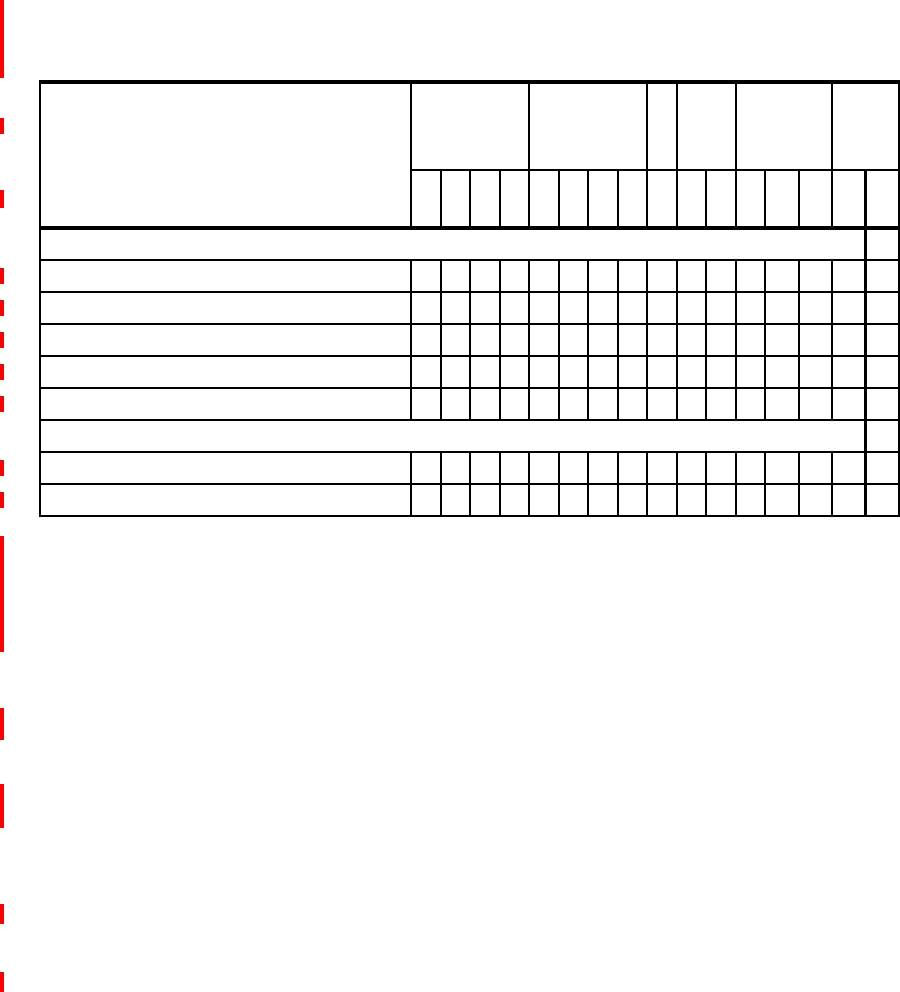
52 i5 Handbook
The components for the Enterprise, Standard, Solution, Domino, High
Availability, and Capacity BackUp editions are represented in the following table.
See “Edition upgrades” on page 173 for considerations when upgrading editions.
You can find product brochures for the System i5 editions at:
http://www.ibm.com/servers/eserver/iseries/literature/index.html
Capacity tables
The tables in this chapter summarize the resource capabilities and performance
characteristics of the System i5 processors in the current product line of System
i5 servers. Processor and performance characteristics are included, along with
the maximum capacities for main storage, disk, local area network (LAN),
communication lines, workstations, tape devices, CD devices, and other
input/output (I/O) components. Edition content structure is described and
summarized for the packages offered for today’s System i5 servers.
The following graphic depicts the commercial processing workload (CPW) ratings
of each of the currently marketed System i5 servers.
Standard Enterprise
Domino
Solution
HA CBU
520
550
570
595
520
550
570
595
550
520
550
520
570
595
570
595
Features
Support for multiple operating systems YYYYYYYYYYYYY Y Y Y
Support for Web modernization YYYYYYYYYYYYY Y Y Y
Support for LPAR YYYYYYYYYYYYY Y Y Y
Support for Capacity on Demand Y Y Y YYYY YYY Y Y Y
Support for 5250 OLTP YYYY YYYY Y Y Y
Software license or licenses
IBM i5/OS V5R3 YYYYYYYYYYYYY Y Y Y
IBM i5/OS V5R4 Y Y Y Y
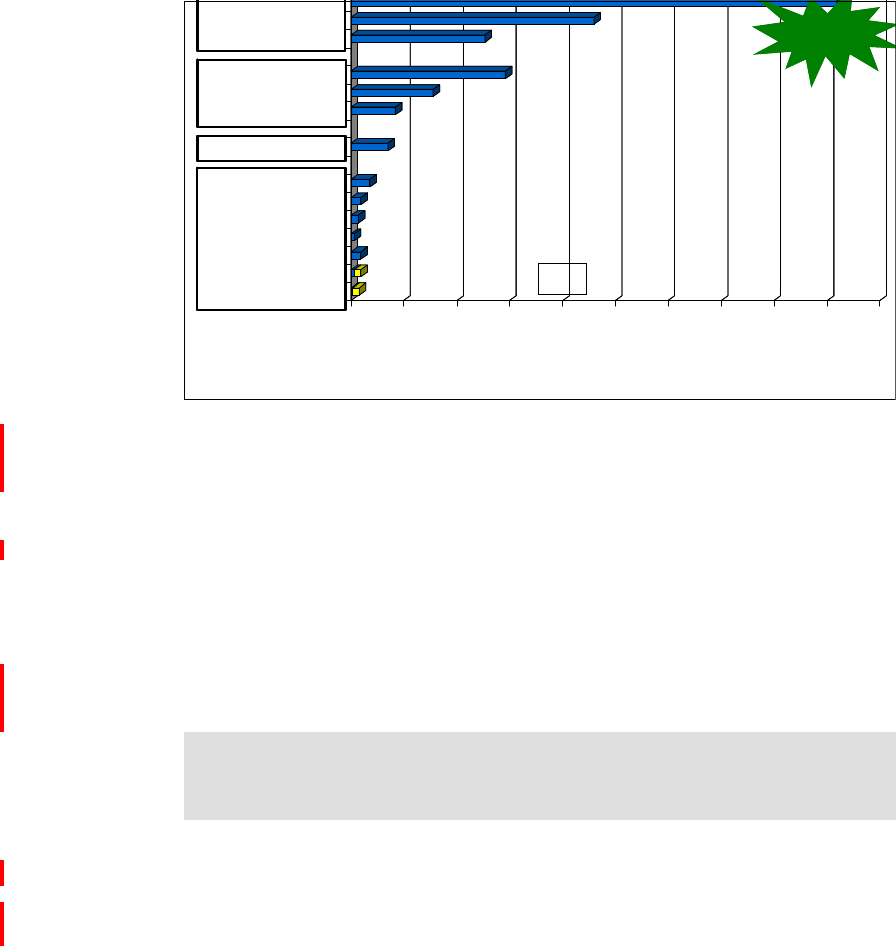
Today’s System i5 summary 53
The capacities of System i5 processors that are no longer marketed are
summarized in Chapter 28, “Summary of earlier AS/400, AS/400e, and iSeries
models” on page 449, and in the IBM Eserver i5, iSeries, and AS/400e System
Builder, SG24-2155.
You can find information about i5/OS V5R4 operating system limits, such as the
maximum members in a database file, maximum objects in a library, and jobs on
the system, in the iSeries Information Center at:
http://www.ibm.com/eserver/iseries/infocenter
then under Systems Management, select the Availability topic, and then click
OS/400 Maximum Capacities.
Summary of the System i5 Model 520+ (9405 and 9406)
The following table provides the 9405 and 9406 Model 520+ system minimum
and maximum capacities.
Note: In the following tables, the values in the columns with the darker shaded
heading represent the base configuration of the system. The capacities shown
may require prerequisites. Some combinations of features are not valid.
0 20000 40000 60000 80000 100000 120000 140000 160000 180000 20000
0
CPW
520 Value/Express
520 Value/Express
520 Value/Express
520 1-way
520 1-way
520 1-way
520 1/2-way
550 1/4-way
570 2/4-way
570 4/8-way
570 8/16-way
595 8/16-way
595 16/32-way
595
32/64
-
way
Notes:
64-way measured as two 32-way partitions
Yellow bars on 520 indicate Accelerator for S
y
stem i5
184,000
0 20000 40000 60000 80000 100000 120000 140000 160000 180000 20000
0
CPW
520 Value/Express
520 Value/Express
520 Value/Express
520 1-way
520 1-way
520 1-way
520 1/2-way
550 1/4-way
570 2/4-way
570 4/8-way
570 8/16-way
595 8/16-way
595 16/32-way
595
32/64
-
way
Notes:
64-way measured as two 32-way partitions
Yellow bars on 520 indicate Accelerator for S
y
stem i5
184,000
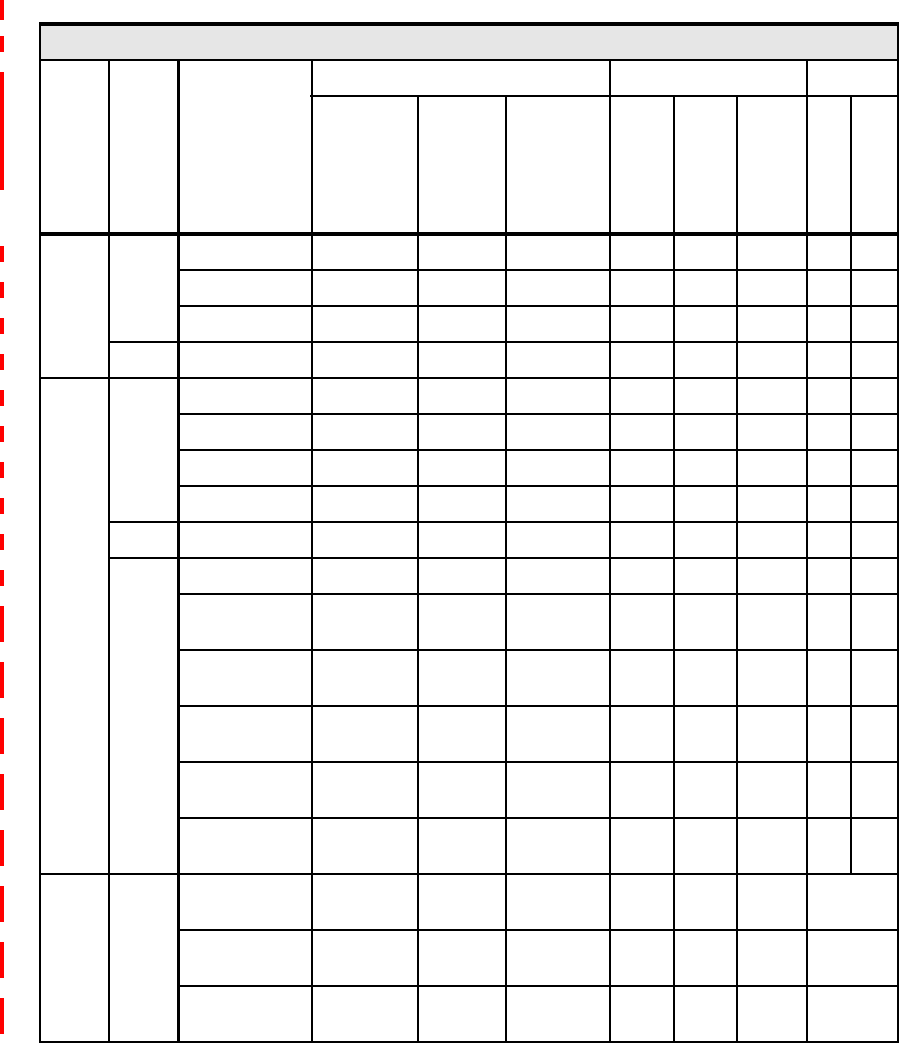
54 i5 Handbook
9405/9406 Model 520+
Processor
Feature
Server
Feature
Edition
Feature
Processor/5250 CPW5MCU2a LPAR
Base
with
Accelerator12b
2-way with
max 5250
Base
with
Accelerator12b
2-way
Base
with
Accelerator12b
#8325 #0970 #7140 Express 600/30 3100/30 - n/r2a 6600 - 2 10
#7141 Express 600/30 3100/30 - n/r2a 6600 - 2 10
#7142 Express 600/30 3100/30 - n/r2a 6600 - 2 10
#0975 #7350 Value 600/30 3100/30 - n/r2a 6600 - 2 10
#8327 #0970 #7143 Express 1200/60 3800/60 - 2600 8200 - 3 10
#7148 Express 1200/60 3800/60 - 2600 8200 - 3 10
#7144 Express 3800/60 - - 8200 - - 10 -
#7152 Express 3800/60 - - 8200 - - 10 -
#0975 #7352 Value 1200/60 3800/60 - 2600 8200 - 3 10
#0906 #7366 Solution 1200/1200 - - 2600 - - 3 -
#7373 High
Availability
1200/1200 - - 2600 - - 3 -
#7374 High
Availability
2800/2800 - - 6100 - - 7 -
#7734
Enterprise
1200/1200 - - 2600 - - 3 -
#7735
Enterprise
2800/2800 - - 6100 - - 7 -
#7784
Standard
3800/0 - - 8200 - - 10 -
#8330 #0906 #7375 High
Availability
3800/3800 - 7100/7100 8200 - 15600 10/pro-
cessor
#7736
Enterprise
3800/3800 - 7100/7100 8200 - 15600 10/pro-
cessor
#7785
Standard
3800/0 - 7100/0 8200 - 15600 10/pro-
cessor

Today’s System i5 summary 55

56 i5 Handbook
The following table provides the 9405 Model 520 system minimum and maximum
capacities.
To review the footnotes for this table, see “Notes for System i5 capacity tables” on
page 74.
9405/9406 Model 520+
Processor feature #8325 #8327 #8330
Number/type/speed of processor 1/POWER5+/1.9 GHz 1/POWER5+/1.9 GHz 1/2-way POWER5+ /1.9
GHz
L2 Cache (MB) 1.9 1.9 1.9
L3 Cache (MB) 0 36 36
Main storage (GB min/max) 1/32 1/32 1/32
Main storage DIMMs (min/max) 2/8 2/8 2/8
Minimum i5/OS / LIC level V5R3/V5R3M5 V5R3/V5R3M5 V5R3/V5R3M5
Software group 6a P05 P10 P20
9405 Model 520
Processor feature #8950 #8951 #8972
Server feature9#0900 #0901 #0912
Number/type/
speed of processor
1/POWER5/
1.5 GHz
1/POWER5/
1.5 GHz
1/POWER5/
1.5 GHz
Relative system performance 1, 2
Processor CPW 500 1000 2400
Mail and Calendar Users 2a 2300 5500
5250 CPW
5
Express 6a 30 60 60
L2 Cache (MB) 1.88 1.88 1.88
L3 Cache (MB) 0 0 0
Main storage (GB min/max) 1/32 2/32 4/32
Main storage DIMMs (minimum/maximum) 4/8 4/8 4/8?
Logical partitions (LPAR) 2 4 10
Minimum i5/OS level V5R3 V5R3 V5R3
Software group 6a P05 P10 P10

Today’s System i5 summary 57
The following table provides the 9406 Model 520 system minimum and maximum
capacities.
9406 Model 520
Processor feature #8950 #8951 #8952 #8953 #8954 #8955 #8972
Server feature 9#0900 #0901 #0902 #0903 #0904 #0905 #0912
Number/
type/
speed of processor
1/
POWER5/
1.5 GHz
1/
POWER5/
1.5 GHz
1/
POWER5/
1.5 GHz
1
/POWER5
/1.5 GHz
1/
POWER5/
1.65 GHz
2/
POWER5/
1.65 GHz
1/
POWER5/
1.5 GHz
Relative system
performance1, 2
Processor CPW 500 1000 1000 2400 3300 6000 2400
Mail and Calendar
Users 2a
--- 2300 2300 5500 7300 13300 5500
5250 CPW
5
Value
6a 30 60 - - - - 60
Express 6a 30 60 - - - - 60
Standard 6a - - 0000 -
Solution 6a - -1000----
Enterprise 6a - - 1000 2400 3300 6000 -
High Availability
6a - - 1000 2400 3300 6000 -
L2 Cache (MB) 1.88 1.88 1.88 1.88 1.88 1.88 1.88
L3 Cache (MB) 0 0 0 0 36 36 0
Main storage
(GB min/max)
0.5/32 1/32 1/32 1/32 1/32 1/32 1/32
Main storage DIMMs
(minimum/maximum)
2/8 4/8 4/8 4/8 4/8 4/8 4/8
Logical partitions (LPAR) 2 4 4 10 10 20 10
Minimum i5/OS level V5R3 V5R3 V5R3 V5R3 V5R3 V5R3 V5R3
Software group 6a P05 P10 P10 P10 P20 P20 P10

58 i5 Handbook
To review the footnotes for this table, see “Notes for System i5 capacity tables” on
page 74.
The Model 520+ Express configurations and Value Editions provide limited 5250
CPW but can use the Accelerator for System i5 option to increase the processor
CPW if needed.
Numbers are for all 9405 and 9406 520 processor
features
Base system unit System maximum
Disk storage (GB)
Integrated minimum 7b 0-
Integrated maximum 7a 1129 39234
Total maximum 7, 7a 39234
DASD arms maximum 8 278
Internal arms 8 278
External LUNs - 278
Physical packaging
Rack design - EIA units 4 4
External HSL-2/RIO-G ports 0/2 2
External HSL-2/RIO-G loops 0/1 1
PCI/PCI-X Expansion Tower 6 6
External xSeries Servers 8 8
PCI card slots 10a 690
Communication lines38 192
LAN ports (includes embedded) 5 36
Integrated xSeries Servers 1 18
Twinaxial workstation controllers 3 48
Twinaxial workstations 120 1920
Internal tape/CD/DVD 41 tape / /2 DVD 13 tapes / 14 CD/DVD
External tape/optical/CD/DVD
(single partition maximum)
018
External tape/optical/CD/DVD
(system maximum)
036
Cryptographic coprocessor 0 8
Cryptographic accelerator 0 2
Note: The values in the previous table are package dependent.
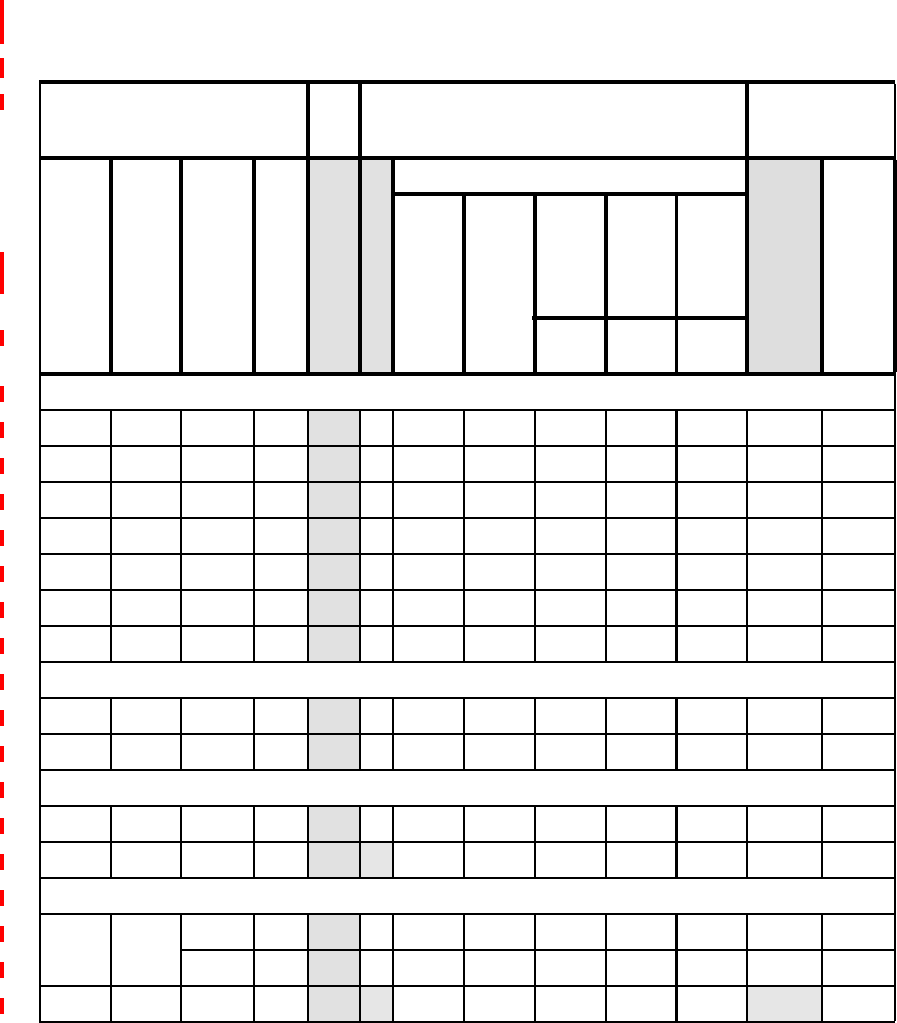
Today’s System i5 summary 59
The following table summarizes the On Demand feature codes for the Model 520.
Features included with each Model 520 (base features) are shaded in gray.
Model 520 Processor activations Enterprise
Enablement
(5250 OLTP)
Processor feature
Server feature
Edition feature
n-way
Base i5/OS Licenses
(5722-SS1)
#8410 Base Processors
On Demand
#9299 Base 5250
Additional 5250
(per processor)
Accelerator
CoD purchased
On/Off CoD
Enablement
On/Off CoD
(Billing)
Reserve CoD
(Prepaid)
360
days 1 day 30
days
Express configurations
#8325 #0970 #7140 uni 1 - #7680 - - - - Note 1 -
#7141 uni 1 - #7681 - - - - Note 1 -
#7142 uni 1 - #7682 - - - - Note 1 -
#8327 #0970 #7143 uni 1 - #7354 - - - - Note 2 -
#7148 uni 1 - #7687 - - - - Note 2 -
#7144 uni 1------Note 2-
#7152 uni 1------Note 2-
Value Edition
#8325 #0975 #7350 uni 1 - #7355 - - - - Note 1 -
#8327 #0975 #7352 uni 1 - #7357 - - - - Note 2 -
Standard Edition
#8327 #0906 #7784 uni 1------- -
#8330 #0906 #7785 1/2 11 - #7320 #7620 #7621 #7622 - -
High Availability Edition
#8327 #0906 #7373 uni 1------Note 3-
#7374 uni 1------Note 3-
#8330 #0906 #7375 1/2 11 - #7320 #7620 #7621 #7622 1 #7256

60 i5 Handbook
Enterprise Edition
#8327 #0906 #7734 uni 1 - - - - - Note 3 -
#7735 uni 1 - - - - - Note 3 -
#8330 #0906 #7736 1/2 11 - #7320 #7620 #7621 #7622 1 #7256
Solution Edition
#8327 #0906 #7366 uni 1------Note 3-
Note 1: This Edition includes 30 OLTP (5250) CPW with no feature code.
Note 2: This Edition includes 60 OLTP (5250)CPW with no feature code.
Note 3: This Edition includes OLTP (5250) CPW up to the amount of processor CPW available with no feature code.
Model 520 Processor activations Enterprise
Enablement
(5250 OLTP)
Processor feature
Server feature
Edition feature
n-way
Base i5/OS Licenses
(5722-SS1)
#8410 Base Processors
On Demand
#9299 Base 5250
Additional 5250
(per processor)
Accelerator
CoD purchased
On/Off CoD
Enablement
On/Off CoD
(Billing)
Reserve CoD
(Prepaid)
360
days 1 day 30
days
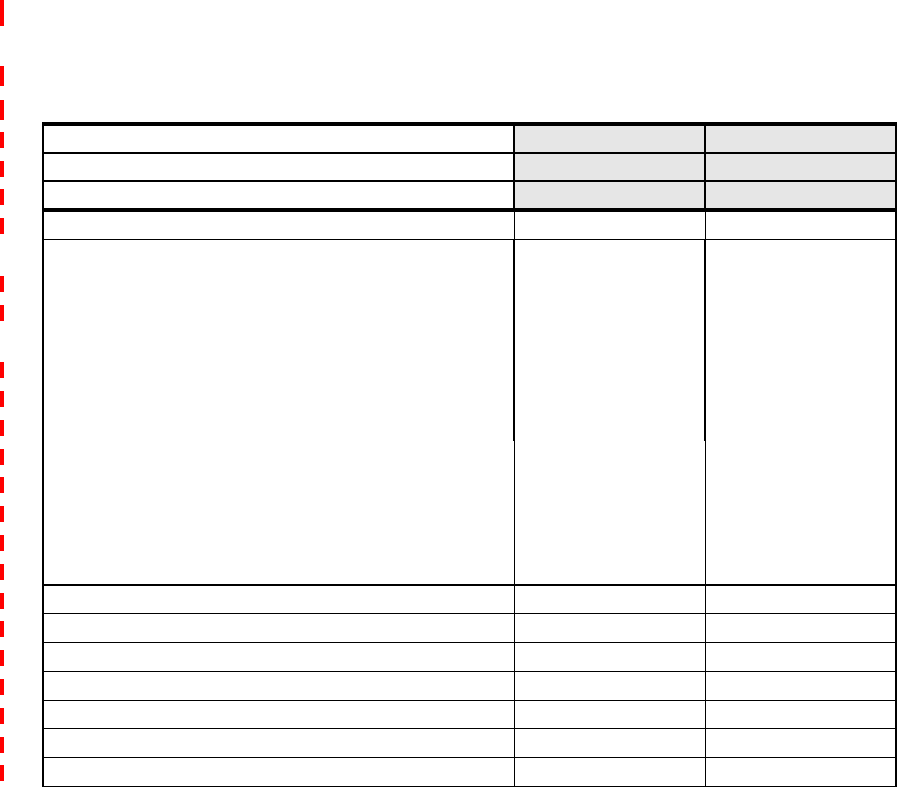
Today’s System i5 summary 61
Summary of the System i5 Model 550
The following table provides the Model 550 system minimum and maximum
capacities.
Model 550+ Model 550
Processor feature #8312 #8958
Server feature9#0910 #0915
Number/type/speed of processor 1/4/POWER5+/1.9 GHz 1/4/POWER5/1.65 GHz
Relative system performance1, 2
Processor CPW 3800/14000 3300/12000
Mail and Calendar Users 2a 8200/30000 7300/26600
5250 CPW
5
Standard
6b 00
Enterprise 6b Maximum Maximum
Solution 6b Maximum Maximum
Solution Edition for PeopleSoft Enterprise One 6b Maximum Maximum
Domino 6b 00
C2CRM (Clear Technology with Domino) Maximum Maximum
SAP 2-way 0 0
SAP 4-way 0 0
L2 Cache (MB) 1.9 1.9
L3 Cache (MB) 36 36
Main storage (GB min/max) 2/64 2/64
Main storage DIMMs (minimum/maximum) 4/16 4/16
LPAR 10-40 10-40
Minimum i5/OS level V5R3 V5R3
Software group6b P20 P20

62 i5 Handbook
To review the footnotes for this table, see “Notes for System i5 capacity tables” on
page 74.
The following table summarizes the On Demand feature codes for the Model 550.
Edition Content will vary by processor and server features selected. For more
information on Editions see “Editions” on page 176.
Features included with each Model 550 (base features) are shaded in gray.
Numbers are for all 550 processor features Base system unit System maximum
Disk storage (GB)
Integrated minimum7b 0
Integrated maximum 7a 1129 77051
Total maximum 7, 7a 77051
DASD arms maximum
Internal arms 8 548
External LUNs - 548
Physical packaging
Rack design - EIA units 4 4
External HSL-2/RIO-G ports 2 4
External HSL-2/RIO-G loops 1 2
PCI/PCI-X Expansion Tower 6 12
External xSeries Servers 8 16
PCI card slots 10 5 172
Communication lines3320
LAN ports (includes embedded) 5 96
Integrated xSeries Servers 1 36
Twinaxial workstation controllers 2 133
Twinaxial workstations 80 5320
Internal CD/DVD/tape 4226
External tape/optical/CD/DVD (LPAR) 2(2) 18 (36)
Cryptographic coprocessor 1 8
Cryptographic accelerator 1 4

Today’s System i5 summary 63
Model 550
1/4-way
Processor activations Enterprise Enablement
(5250 OLTP)
Server feature
Edition feature
n-way
Base i5/OS
Licenses
(5722-SS1)
#8450/#8413 Base
Processors
On Demand
Base 5250
Additional 5250
(per processor)
100% CPU
(initial order only)
CoD purchased
On/Off CoD
Enablement
On/Off CoD
(Billing)
Reserve CoD
(Prepaid)
360
days 1 day 90
days
Standard Editions
#0910 #7154 1/4 11 #7323 #7930 #7341 #7741 N/A N/A N/A
#0915 #7462 1/4 12 #7871 #7930 #7931 #7934 N/A N/A N/A
Enterprise Editions
#0910 #7155 1/4 11 #7323 #7930 #7341 #7741 #9299 x1 #7257 N/A
#0915 #7463 1/4 12 #7871 #7930 #7931 #7934 #9286 x1 #7576 N/A
Domino Editions
#0910 #7629 1/4 22 #7323 #7930 #7341 #7741 N/A N/A N/A
#0915 #7530 1/4 22 #7871 #7930 #7931 #7934 N/A N/A N/A
High Availability Edition
#0910 #7551 1/4 11 #7323 #7930 #7341 #7741 #9299 x1 #7257 N/A
Solution Editions
#0910 #7630 1/4 11 #7323 #7930 #7341 #7741 #9299 x1 #7257 N/A
#7631 1/4 11 #7323 #7930 #7341 #7741 #9299 x1 #7257 N/A
#7632 1/4 11 #7323 #7930 #7341 #7741 #9299 x1 #7257 N/A
#7640 2 22 #7323 #7930 #7341 #7741 N/A N/A N/A
#7941 4 44 #7323 #7930 #7341 #7741 N/A N/A N/A
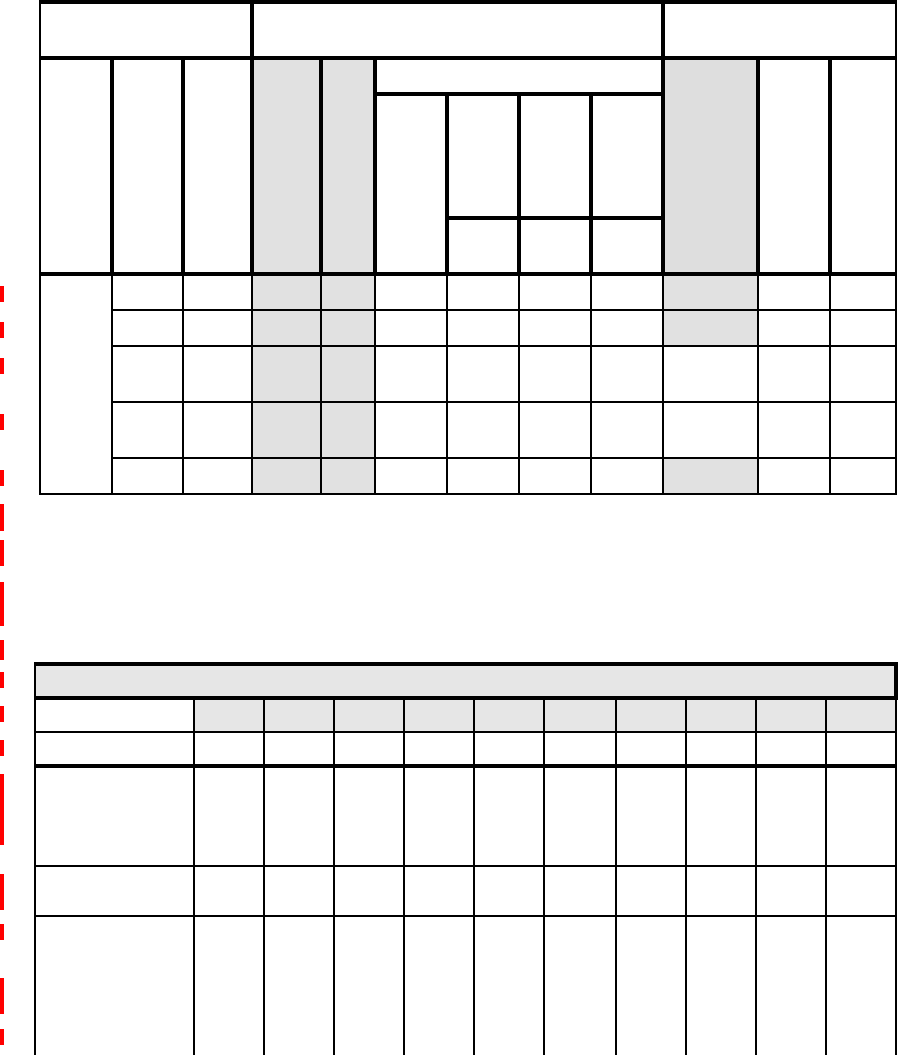
64 i5 Handbook
Summary of the System i5 Model 570+ and i5 Model 570
The following table provides the Model 570 and 570+ system minimum and
maximum capacities.
#0915 #7531 1/4 12 #7871 #7930 #7931 #7934 1 #7576 N/A
#7532 1/4 12 #7871 #7930 #7931 #7934 1 #7576 N/A
#7533
2-way
222 #7871 #7930 #7931 #7934 N/A N/A N/A
#7534
4-way
444 #7871 #7930 #7931 #7934 N/A N/A N/A
#7558 1/4 12 #7871 #7930 #7931 #7934 1 #7576 N/A
Model 550
1/4-way
Processor activations Enterprise Enablement
(5250 OLTP)
Server feature
Edition feature
n-way
Base i5/OS
Licenses
(5722-SS1)
#8450/#8413 Base
Processors
On Demand
Base 5250
Additional 5250
(per processor)
100% CPU
(initial order only)
CoD purchased
On/Off CoD
Enablement
On/Off CoD
(Billing)
Reserve CoD
(Prepaid)
360
days 1 day 90
days
Model 570 and Model 570+
Processor feature #8971 #8971 #8971 #8971 #8971 #8971 #8338 #8338 #8338 #8338
Server feature #0930 #0921 #0922 #0924 #0926 #0928 #0934 #0935 #0936 #0937
Number/
type/
speed of processor
1/2/
POWER5/
1.65 GHz
2/4/
POWER5/
1.65 GHz
5/8/
POWER5/
1.65 GHz
9/12/
POWER5/
1.65 GHz
13/16/
POWER5/
1.65 GHz
2/16/
POWER5/
1.65 GHz
2/4/
POWER5+/
2.2GHz
4/8/
POWER5+/
2.2 GHz
8/16/
POWER5+/
2.2GHz
2/16/
POWER5+/
2.2 GHz
Processor CPW 3300/
6000
6350/
12000
15200/
23500
25500/
33400
36300/
44700
6350/
44700
8400/
16000
16700/
31100
31100/
58500
8100/
58500
Relative system
performance1
Mail and Calendar
Users 2a
7300/
13300
14100/
26600
33600/
52500
57300
77000
83600/
102000
14100/
102000
18200/
34500
35500/
67500
67500/
130000
18200/
130000
5250 CPW 5

Today’s System i5 summary 65
Standard6c 00000 -0000
Enterprise6c Max. Max. Max. Max. Max - Max. Max. Max. -
High Availability6c Max. Max. Max. Max. Max. - Max. Max. Max. -
Capacity BackUp6c -----Max.---Max.
L2 Cache (MB)/chip 1.9 1.9 1.9 1.9 1.9 19 1.9 1.9 1.9 1.9
L3 Cache
(MB)/processor
36 36 36 36 36 36 36 36 36 36
Main storage (GB
minimum/maximum
2/64 4/128 8/256 12/384 16/512 16/512 4/128 8/256 16/512 16/512
Main storage
DIMMs
4/8 8/16 16/32 24/48 32/64 32/64 8/16 16/32 32/64 32/64
LPAR12 10/20 20/40 50/80 90/120 120/
160
20/160 20/40 40/80 80/160 20/160
Minimum i5/OS
level 8
V5R3 V5R3 V5R3 V5R3 V5R3 V5R3 V5R3 V5R3 V5R3 V5R3
Software group 6c P30 P30 P40 P40 P40 P30 P30 P40 P40 P40
Disk storage (GB)
Integrated
minimum7b
00000 00000
Total maximum
7a 38949 77051 116000 154949 193898 193898 77051 116000 193898 193898
DASD arms
maximum
276 546 822 1098 1374 1374 546 822 1374 1374
Internal arms 276 546 822 1098 1374 1374 546 822 1374 1374
External LUNs 276 546 822 1098 1374 1374 546 822 1374 1374
Physical packaging
Rack design - EIA
units
4 4 8121616 4 81616
Ext. RIO-G ports 2 4 81216 16 4 81616
Ext.RIO-G loops 1 2 4 6 8 8 2 4 8 8
PCI-X Expansion
To w e r
612243648 4812244848
Ext. xSeries
Servers (IXA)
816324857 5716325757
PCI card slots 12 90 173 346 519 692 692 173 346 692 695
Communication
lines 3
278 320 480 480 480 480 320 480 480 480
Model 570 and Model 570+
Processor feature #8971 #8971 #8971 #8971 #8971 #8971 #8338 #8338 #8338 #8338
Server feature #0930 #0921 #0922 #0924 #0926 #0928 #0934 #0935 #0936 #0937

66 i5 Handbook
To review the footnotes for this table, see “Notes for System i5 capacity tables” on
page 74.
The Standard, Enterprise and High Availability Editions also provide support for
Capacity on Demand (permanent and temporary). The Capacity on Demand
Edition provides support for temporary capacity only.
The following table summarizes the On Demand feature codes for the Model 570.
Features included with each Model 570 (base features) are shaded in gray.
LAN ports
(includes
74 96 128 128 128 128 96 128 128 128
Integrated xSeries 18 36 48 48 48 48 36 48 48 48
Twinaxial
workstation
69 134 204 274 334 334 134 204 334 334
Twinaxial 2760 5360 7200 7200 7200 7200 5360 7200 7200 7200
Internal DVD-ROM/
DVD-RAM 4
11234 41244
Internal 0000000000
I/O Tower
Tape/CD-ROM/DVD
13 (13) 18 (25) 26 (36) 26 (48) 26 (48) 26 (48) 18 (25) 26 (36) 26 (48) 26 (48)
External tape 18 (36) 18 (36) 26 (48) 26 (48) 26 (48) 26 (48) 18 (36) 26 (48) 26 (48) 26 (48)
External
optical/CD/DVD
26 (48) 26 (48) 26 (48) 26 (48) 26 (48) 26 (48) 26(48) 26 (48) 26 (48) 26 (48)
Cryptographic
coprocessor
(combined system
8 8 8 (32) 8 (32) 8 (32) 8 (32) 8 8 (32) 8 (32) 8 (32)
Cryptographic
accelerator
(combined system
4 (8) 4 (8) 4 (8) 4 (8) 4 (8) 4 (8) 4 (8) 4 (8) 4 (8) 4 (8)
Model 570 and Model 570+
Processor feature #8971 #8971 #8971 #8971 #8971 #8971 #8338 #8338 #8338 #8338
Server feature #0930 #0921 #0922 #0924 #0926 #0928 #0934 #0935 #0936 #0937

Today’s System i5 summary 67
Model 570 i5/OS Processor activations Enterprise Enablement
(5250 OLTP)
Server feature
Edition feature
N-way
Licenses per CPU
Base Processors
On Demand
Base
Additional CPU
All CPU
(initial order only)
Capacity Upgrade
on Demand
on Demand
Enablement
Billing
(per CPU-day)
Reserve prepaid
(per CPU-day)
5722-
SS1
1 day 30
days
Standard Edition
#0934 #7757 2/4 1 x
5722-
SS1
2 x
#7738
#7618 #7951 #7624 #7728 N/A N/A N/A
#0935 #7758 4/8 1 x
5722-
SS1
4 x
#7738
#0936 #7759 8/16 1 x
5722-
SS1
8 x
#7738
#0930 #7490 1/2 1 x
5722-
SS1
1 x
#8452
#7897 #7951 #7952 #7956 N/A N/A N/A
#0921 #7494 2/4 1 x
5722-
SS1
2 x
#8452
#0922 #7471 5/8 1 x
5722-
SS1
5 x
#8452
#0924 #7473 9/12 1 x
5722-
SS1
9 x
#8452
#0926 #7475 13/
16
1 x
5722-
SS1
13 x
#8452
Enterprise and High Availability Editions *

68 i5 Handbook
#0934 #7747 2/4 1 x
5722-
SS1
2 x
#7738
#7618 #7951 #7624 #7728
1 x
#9299 #7260 #7258
#0934 #7763 2/4 1 x
5722-
SS1
2 x
#7738
#0935 #7748 4/8 1 x
5722-
SS1
4 x
#7738
#0935 #7764 4/8 1 x
5722-
SS1
4 x
#7738
#0936 #7749 8/16 1 x
5722-
SS1
8 x
#7738
#0936 #7765 8/16 1 x
5722-
SS1
8 x
#7738
Model 570 i5/OS Processor activations Enterprise Enablement
(5250 OLTP)
Server feature
Edition feature
N-way
Licenses per CPU
Base Processors
On Demand
Base
Additional CPU
All CPU
(initial order only)
Capacity Upgrade
on Demand
on Demand
Enablement
Billing
(per CPU-day)
Reserve prepaid
(per CPU-day)
5722-
SS1
1 day 30
days
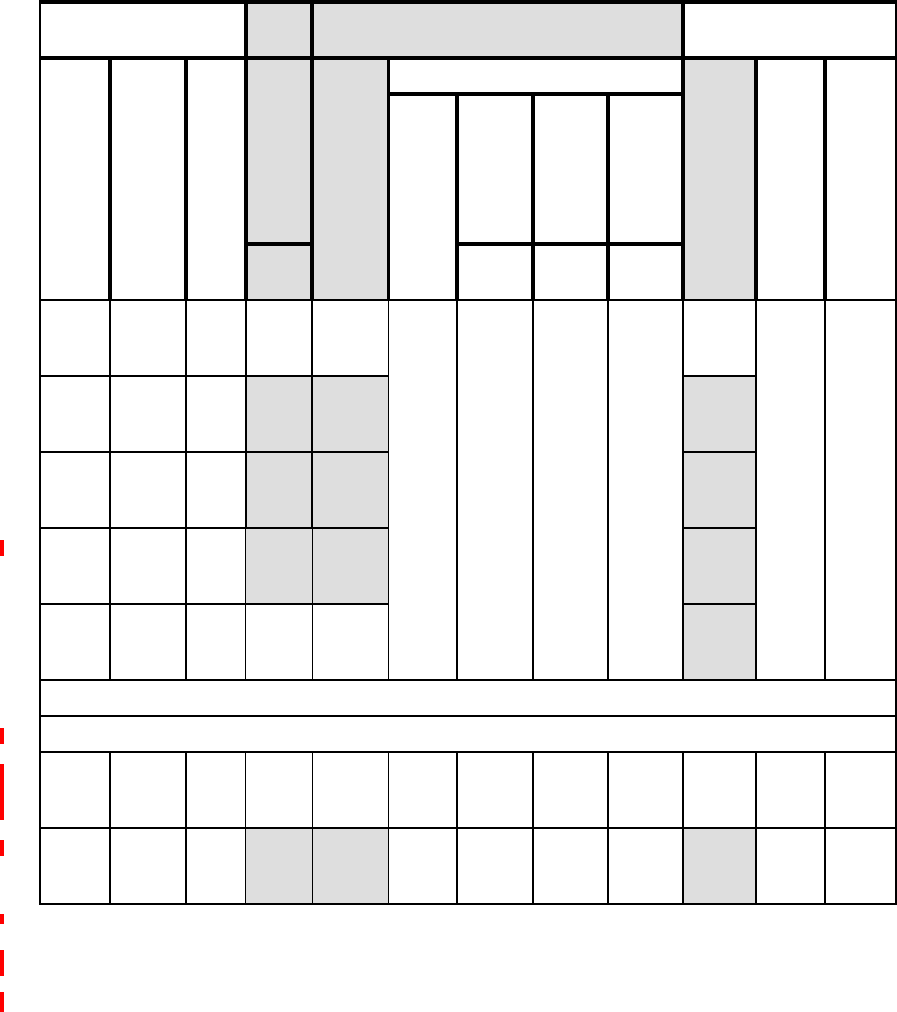
Today’s System i5 summary 69
Summary of the System i5 and eServer i5 Model 595
The Model 595 1.9 GHz and 595 system minimum and maximum capacities are
provided in the following table.
#0930 #7491/
#7559
1/2 1 x
5722-
SS1
2 x
#8452
#7897 #7951 #7952 #7956
2 x
#9286
#7577 #7597
#0921 #7495/
#7560
2/4 1 x
5722-
SS1
3 x
#8452
4 x
#9286
#0922 #7472/
#7561
5/8 1 x
5722-
SS1
6 x
#8452
4 x
#9286
#0924 #7474/
#7562
9/12 1 x
5722-
SS1
10 x
#8452
4 x
#9286
#0926 #7476/
#7563
13/
16
1 x
5722-
SS1
14 x
#8452
4 x
#9286
* Includes a processor activation for Linux
Capacity Backup Editions
#0937 #7760 2/16 2 x
5722-
SS1
2 x
#7738
n/a #7951 #7624 #7728 2 x
#9299
Max. Max.
#0928 #7570 2/16 2 x
5722-
SS1
2 x
#8452
n/a #7951 #7952 #7956 2 x
#9286
Max. Max.
Model 570 i5/OS Processor activations Enterprise Enablement
(5250 OLTP)
Server feature
Edition feature
N-way
Licenses per CPU
Base Processors
On Demand
Base
Additional CPU
All CPU
(initial order only)
Capacity Upgrade
on Demand
on Demand
Enablement
Billing
(per CPU-day)
Reserve prepaid
(per CPU-day)
5722-
SS1
1 day 30
days

70 i5 Handbook
Model 595 1.9GHz
Processor feature #8966 #8966 x 2 #8966 x 4 #8966 x 2
Server feature #0940 #0941 #0943 #0944
Number/type/speed of processor 8/16 /POWER5/
1.9 GHz
16/32 /POWER5/
1.9 GHz
32/64 /POWER5/ 1.9
GHz
4/32/POWER5/
1.9 GHz
Relative system performance1, 2
Processor CPW 26700/50500 51000/92000 92000/184000 13600/92000
Mail and Calendar Users 2a 60500/114000 115000/2130002c 213000/4050002c 31500/2130002c
5250 CPW
5
Standard6d 00 00
Enterprise6d Maximum Maximum Maximum -
High Availability6d Maximum Maximum Maximum -
Capacity BackUp6- - - Maximum
L2 Cache (MB per processor) 1.9 1.9 1.9 1.9
L3 Cache (MB per processor) 36 36 36 36
Main storage (GB
minimum/maximum)11
8/512 16/1024 32/2048 16/1024
Main storage DIMMs
(minimum/maximum)
4/16 4/32 4/64 4/32
Logical partitions (LPAR)12 160 254 254 254
Minimum i5/OS level 8V5R3 V5R3 V5R3 V5R3
Software group 6d P50 P50 P60 P50
Disk storage (GB)
Integrated minimum
7b 00 00
Total maximum7a 228614 381024 381024 381024
DASD arms maximum7c 1620 2700 2700 2700
Internal arms 1620 2700 2700 2700
External LUNs 1620 2700 2700 2700
Physical packaging
Rack design - EIA units 18 18 18 18
External RIO-G ports 14 30 62 24
External RIO-G loops 7 15 31 12
PCI/PCI-X Expansion Tower 36 72 96 72
External xSeries Servers 48 57 57 57
PCI card slots 10 504 1008 1152 1008
Communication lines 3600 600 600 600
LAN ports (includes embedded) 160 160 160 160
Integrated xSeries Servers 60 60 60 60
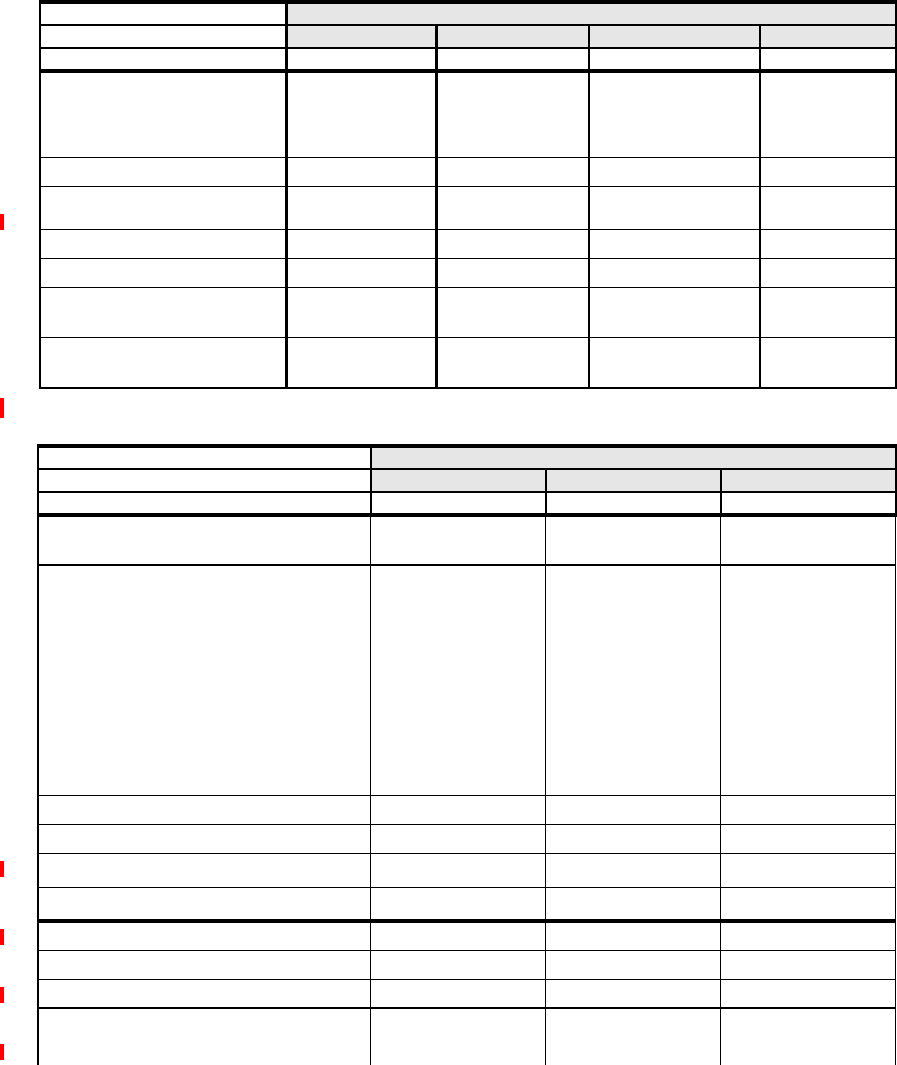
Today’s System i5 summary 71
Twinaxial workstation controllers 180 180 180 180
Twinaxial workstations 7200 7200 7200 7200
Internal DVD-ROM/DVD-RAM 422 22
Internal CD-ROM/Tape 0 0 0 0
Feature I/O Tower
Tape/CD-ROM/DVD (combined
26 (60) 26 (60) 26 (60) 26 (60)
External tape 26 (60) 26 (60) 26 (60) 26 (60)
External optical/CD/DVD 26 (60) 26 (60) 26 (60) 26 (60)
Cryptographic coprocessor
(combined system partition
8 (32) 8 (32) 8 (32) 8 (32
Cryptographic accelerator
(combined system partition
4 (16) 4 (16) 4 (16) 4 (16)
Model 595
Processor feature #8981 #8981x2 #8981x4
Server feature #0946 #0947 #0952
Number/type/speed of processor 8/16 /POWER5/
1.65 GHz
16/32 /POWER5/
1.65 GHz
32/64 /POWER5/ 1.65
GHz
Relative system performance1, 2
Processor CPW 24500/45500 46000/85000 86000/165000
Mail and Calendar Users 2a 104000 194000 375000
5250 CPW
5
Standard6d 000
Enterprise6d Maximum Maximum Maximum
High Availability6d Maximum Maximum Maximum
Capacity BackUp6---
L2 Cache (MB per processor) MCM 1.88 1.88 1.88
L3 Cache (MB per processor) MCM 36 36 36
Main storage (GB minimum/maximum)11 8/512 16/1024 32/2048
Main storage DIMMs (minimum/maximum) 4/16 4/32 4/64
Logical partitions (LPAR)12 160 254 254
Minimum i5/OS level 8V5R3 V5R3 V5R3
Software group 6d P50 P50 P60
Disk storage (GB)
Integrated minimum
7b 000
Model 595 1.9GHz
Processor feature #8966 #8966 x 2 #8966 x 4 #8966 x 2
Server feature #0940 #0941 #0943 #0944

72 i5 Handbook
To review the footnotes for this table, see “Notes for System i5 capacity tables” on
page 74.
Total maximum7a 228614 381024 381024
DASD arms maximum 7c 1620 2700 2700
Internal arms 1620 2700 2700
External LUNs 1620 2700 2700
Physical packaging
Rack design - EIA units 18 18 18
External HSL-2/RIO-G ports 14 30 62
External HSL-2/RIO-G loops 7 15 31
PCI/PCI-X Expansion Tower 36 72 96
External xSeries Servers (IXA) 48 57 57
PCI card slots 10 504 1008 1152
Communication lines 3600 600 600
LAN ports (includes embedded) 160 160 160
Integrated xSeries Servers 60 60 60
Twinaxial workstation controllers 180 180 180
Twinaxial workstations 7200 7200 7200
Internal DVD-ROM/DVD-RAM 4222
Internal CD-ROM/Tape 0 0 0
Feature I/O Tower Tape/CD-ROM/DVD 26 (60) 26 (60) 26 (60)
External tape 26 (60) 26 (60) 26 (60)
External optical/CD/DVD 26 (60) 26 (60) 26 (60)
Cryptographic coprocessor
(combined system partition maximum)
8 (32) 8 (32) 8 (32)
Cryptographic accelerator
(combined system partition maximum)
4 (16) 4 (16) 4 (16)
Model 595
Processor feature #8981 #8981x2 #8981x4
Server feature #0946 #0947 #0952
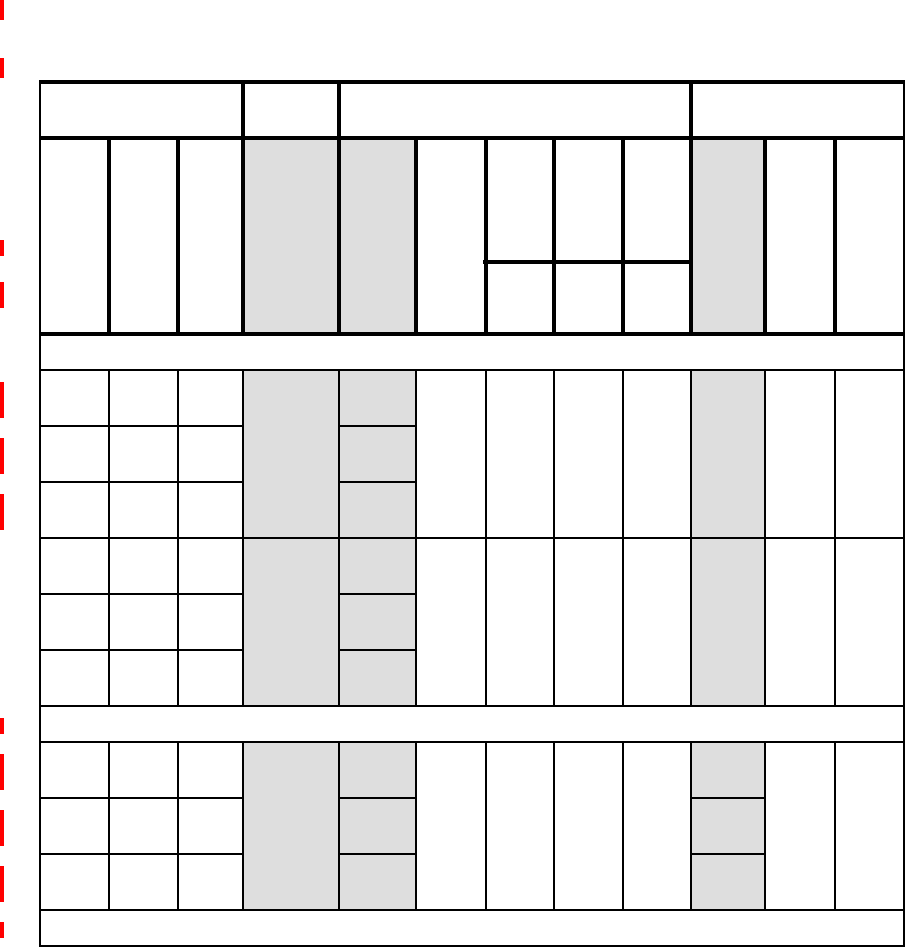
Today’s System i5 summary 73
The following table summarizes the On Demand feature codes for the Model 595.
Features included with each Model 595 (base features) are shaded in gray.
Model 595 i5/OS
licenses
Capacity on Demand Enterprise Enablement
(5250 OLTP)
Server feature
Edition feature
n-way
Base Processor
licenses
Base Processor
activation
CUoD
(permanent activation)
on/off CoD
Enablement
on/off CoD
billing
Reserve CoD
(prepay)
Base processors
Additional processors
All processors
(initial order only)
1 day 30
days
Standard Edition
#0940 #7480 8/16 4 x
5722-SS1
8 x
#8457
#7815 #7971 #7972 #7975 N/A N/A N/A
#0941 #7482 16/32 16 x
#8457
0943 #7486 16/32 32 x
#8457
#0946 #7496 8/16 4 x
5722-SS1
8 x
#8461
#7925 #7839 #7993 #7926 N/A N/A N/A
#0947 #7489 16/32 16 x
#8461
#0952 #7984 32/64 32 x
#8461
Enterprise Edition and High Availability Editions*
#0940 #7481 8/16 4 x
5722-SS1
8 x
#8457
#7815 #7971 #7972 #7975
4 x
#9299
#7261 #7259
#0941 #7483 16/32 16 x
#8457
4 x
#9299
#0943 #7487 32/64 32 x
#8457
4 x
#9299
* Includes a processor activation for Linux on systems with processor #8981.

74 i5 Handbook
Notes for System i5 capacity tables
#0946 #7497 8/16 4 x
5722-SS1
9 x
#8461
#7925 #7839 #7993 #7926
4 x
#9286
#7579 #7598
#0947 #7499 16/32 17 x
#8461
4 x
#9286
#0952 #7985 32/64 33 x
#8461
4 x
#9286
Capacity BackUp Edition
#0944 #7590 4/32 4 x
5722-SS1
4 x
#8457
N/A #7971 4 x
#9299
Max Max
Note 1 Commercial Processing Workload (CPW) is used to measure the performance of all System i5 processors
announced from September 1996 onward. The CPW value is measured on maximum configurations. The
type and number of disk devices, the number of workstation controllers, the amount of memory, the system
model, other factors, and the application running determine what performance is achievable.
Note 2 Processor performance represents the relative performance (maximum capacity) of a processor feature
running CPW in a client/server environment. Processor capacity is achievable when the commercial
workload is not constrained by main storage and direct access storage device (DASD). Performance of the
5250 CPW represents the relative performance available to perform host-centric workloads. The amount of
5250 CPW capacity consumed reduces the available processor capacity by the same amount.
Note 2a Mail and Calendar Users (MCU) is a relative performance measurement derived by performing mail and
calendar functions using Domino and Notes clients. The MCU workload represents users on a Notes client
who are reading, updating or deleting documents in an e-mail database. It also represents users who are
performing lookups in the Domino directory and scheduling calendar appointments and invitations. Reported
values reflect 70% processor utilization to allow for growth and peak loads in excess of customer workload
estimates.
n/r = not recommended.
Note 2c The MCU rating is a projected value.
Model 595 i5/OS
licenses
Capacity on Demand Enterprise Enablement
(5250 OLTP)
Server feature
Edition feature
n-way
Base Processor
licenses
Base Processor
activation
CUoD
(permanent activation)
on/off CoD
Enablement
on/off CoD
billing
Reserve CoD
(prepay)
Base processors
Additional processors
All processors
(initial order only)
1 day 30
days
* Includes a processor activation for Linux on systems with processor #8981.

Today’s System i5 summary 75
Note 3 One line is used if #5544 System Console on Operations Console is used. One line might be used if #5546
System Console on 100 Mbps Token Ring or #5548 System Console on 100 Mbps Ethernet is selected and
the #0367 Operations Console PCI Cable must be connected. The numbers include the ECS line.
Note 4 There must be one DVD-ROM or DVD-RAM per system. For Models 870 and 890, there must be one
DVD-RAM or DVD-ROM in the #9094 Base PCI I/O Enclosure.
Note 5 5250 CPW (Interactive) is an approximate value that reflects the amount of Processor CPW that can be used
for workloads performing 5250-based tasks. Remember that:
The iSeries Enterprise Edition provides maximum 5250 CPW support (up to 100% of the capacity of
the active processor CPW).
The iSeries Standard Edition provides zero CPW for 5250 work. Limited 5250 CPW is available for a
system administrator to use 5250 display device I/O to manage various aspects of the server. Multiple
administrative jobs exceed this capability.
A task submitted through a 5250 session (5250 device or 5250 emulation) that does display or printer
I/O requires 5250 CPW.
A task submitted through a 5250 session (5250 device or 5250 emulation) as a "batch" job is not
considered 5250 OLTP work and does not require any 5250 CPW unless the task does display or
printer I/O.
Maximum 5250 CPW is equivalent to the Processor CPW for the active processor.
Note 6a
Model
520
Software group is determined by the combination of processor feature and edition feature. Display the
QPRCFEAT system value or DSPHDWRSC TYPE(*AHW) to display the processor feature code value. This
value is also shown for the Capacity Card CCIN value when using SST to perform a Capacity Upgrade on
Demand. This table provides a cross reference.
For Model 520 2-way processors shipped prior to 10 December 2004 that have keyed products installed,
update the server firmware to accept the lower P20 software tier.
Apply PTF MH00199 on servers using i5/OS to apply the firmware.
Apply SF222_075 on servers using HMC to apply the firmware. Order PTF MH00201 to receive a CD
that can be applied via the HMC. Update HMC code to the latest V4R3 level before updating the server
firmware. See the following Web site for the latest HMC updates:
http://techsupport.services.ibm.com/server/hmc/power5
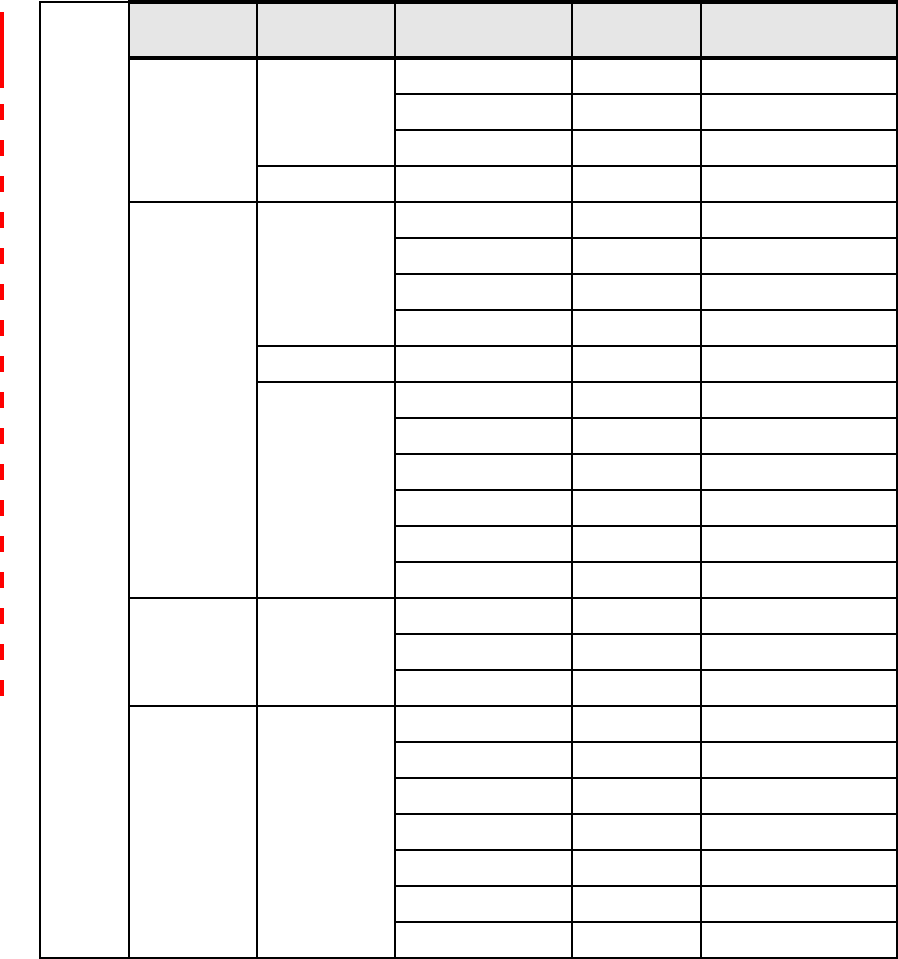
76 i5 Handbook
Note 6a
Model
520
(cont.)
Processor Server feature Edition feature Software
group
Processor feature code
or QPRCFEAT value
#8325 #0970 #7140 Express P05 7140
#7141 Express P05 7141
#7142 Express P05 7142
#0975 #7350 Value P05 7350
#8327 #0970 #7143 Express P10 7143
#7148 Express P10 7148
#7144 Express P10 7144
#7152 Express P10 7152
#0975 #7352 Value P10 7352
#0906 #7784 Standard P10 7784
#7734 Enterprise P10 7734
#7735 Enterprise P10 7735
#7373 High Availability P10 7373
#7374 High Availability P10 7374
#7366 Solution P10 7366
#8330 #0906 #7785 Standard P20 7785
#7736 Enterprise P20 7736
#7375 High Availability P20 7375
#8950 #0900 #7390 Express P05 7390
#7391 Express P05 7391
#7393 Express P05 7393
#7411 Express P05 7411
#7413 Express P05 7413
#7417 Express P05 7417
#7450 Value P05 7450

Today’s System i5 summary 77
Note 6a
Model
520
(cont.)
#8951 #0901 #7392 Express P05 7392
#7394 Express P05 7392
#7414 Express P10 7414
#7420 Express P10 7420
#7451 Value P10 7451
#8952 #0902 #7458 Standard P10 7458
#7459 Enterprise P10 7459
#7541 Solution P10 7541
#7552 High Availability P10 7459
#8953 #0903 #7452 Standard P10 7452
#7453 Enterprise P10 7453
#7553 High Availability P10 7453
#8954 #0904 #7454 Standard P20 7454
#7455 Enterprise P20 7455
#7554 High Availability P20 7455
#8955 #0905 #7456 Standard P20 7456
#7457 Enterprise P20 7457
#7555 High Availability P20 7457
#8972 #0912 #7395 Express P10 7395
#7396 Express P10 7395
#7397 Value P10 7397
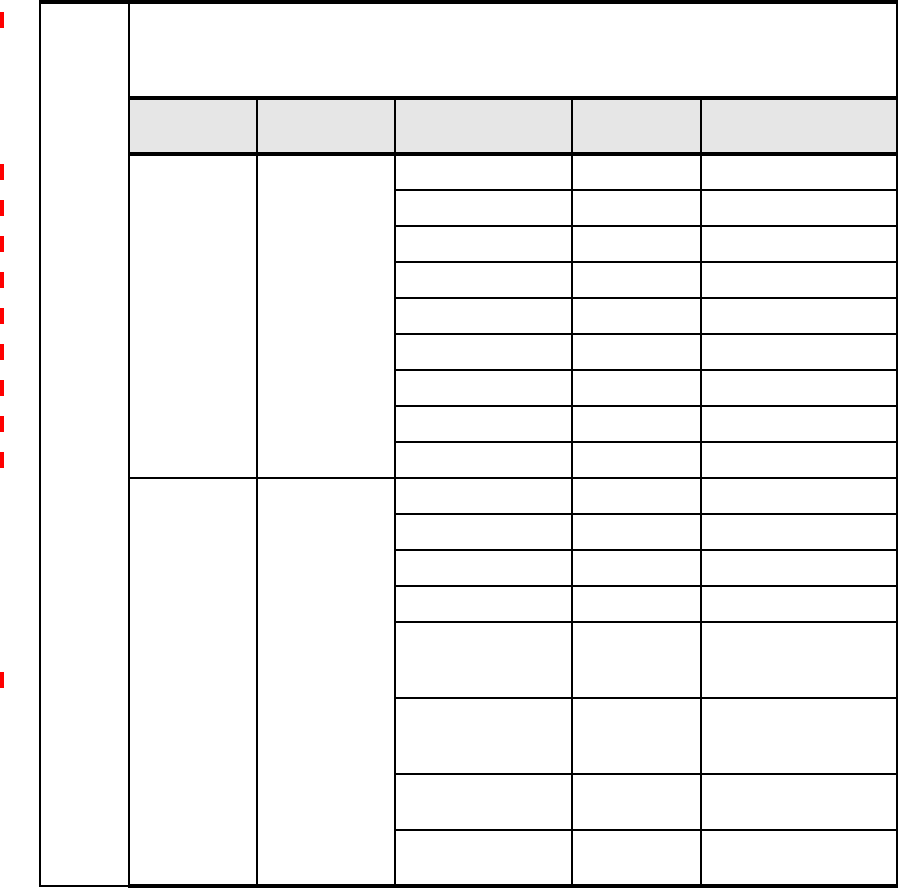
78 i5 Handbook
Note 6b
Model
550
Software group is determined by the combination of processor feature and edition feature. Display the
QPRCFEAT system value or DSPHDWRSC TYPE(*AHW) to display the processor feature code value. This
value is also shown for the Capacity Card CCIN value when using SST to perform a Capacity Upgrade on
Demand. This table provides a cross reference.
Processor Server feature Edition feature Software
group
Processor feature code
or QPRCFEAT value
#8312 #0910 #7154 Standard P20 7154
#7155 Enterprise P20 7155
#7551 High Availability P20 7551
#7629 Domino P20 7629
#7630 Solution P20 7630
#7631 Oracle JDE E1 P20 7631
#7632 C2CRM P20 7632
#7640 2-way SAP P20 7640
#7641 4-way SAP P20 7641
#8958 #0915 #7462 Standard P20 7462
#7463 Enterprise P20 7463
#7530 Domino P20 7462
#7558 Solution P20 7463
#7531 Solution Edition
for PeopleSoft
Enterprise E1
P20 7463
#7532 C2CRM
Solution Edition with
Domino
P20 7463
#7533 2-Way SAP
Solution Edition
P20 7462
#7534 4-Way SAP
Solution Edition
P20 7462

Today’s System i5 summary 79
Note 6c
Models
570+ 570
Software group is determined by the combination of processor feature and edition feature. Display the
QPRCFEAT system value or DSPHDWRSC TYPE(*AHW) to display the processor feature code value. This
value is also shown for the Capacity Card CCIN value when using SST to perform a Capacity Upgrade on
Demand. This table provides a cross reference.
Processor Server feature Edition feature Software
group
Processor feature code
or QPRCFEAT value
#8338 #0934 #7757 Standard P30 7757
#7747 Enterprise P30 7747
#7763 High Availability P30 7763
#0935 #7758 Standard P40 7758
#7748 Enterprise P40 7748
#7764 High Availability P40 7764
#0936 #7759 Standard P40 7759
#7749 Enterprise P40 7749
#7765 High Availability P40 7765
#0937 #7760 Capacity
BackUp
P30 7760
#8961 #0919 #7488 Standard P30 7450
#7489 Enterprise P30 7451
#0920 #7469 Standard P30 7458
#7470 Enterprise P30 7459

80 i5 Handbook
Note 6c
Models
570+ 570
(cont.)
#8971 #0921 #7494 Standard P30 7494
#7495 Enterprise P30 7495
#7560 High Availability P30 7495
#0922 #7471 Standard P40 7441
#7472 Enterprise P40 7472
#7561 High Availability P40 7472
#0924 #7473 Standard P40 7473
#7474 Enterprise P40 7474
#7562 High Availability P40 7474
#0926 #7475 Standard P40 7475
#7476 Enterprise P40 7476
#7563 High Availability P40 7476
#0928 #7570 Capacity
BackUp
P30 7570
#0930 #7490 Standard P30 7490
#7491 Enterprise P30 7491
#7559 High Availability P30 7491
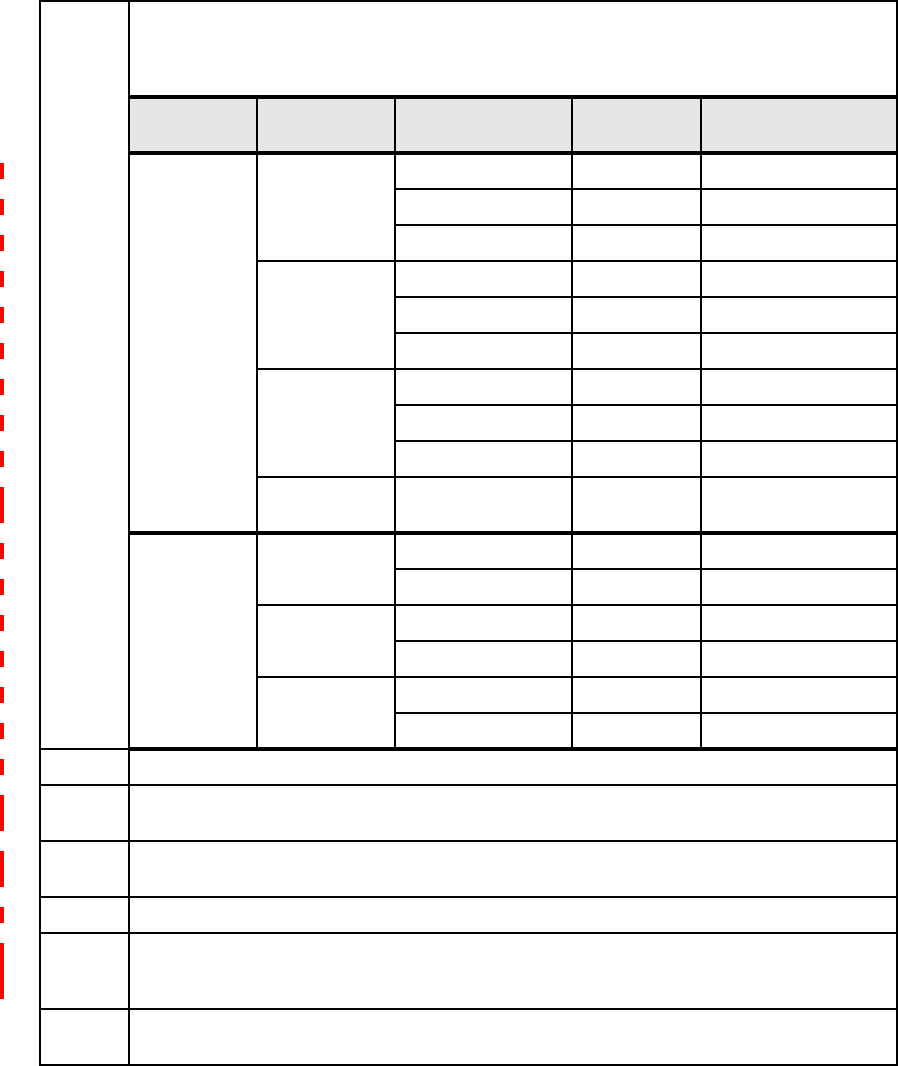
Today’s System i5 summary 81
Note 6d
Model
595
Software group is determined by the combination of processor feature and edition feature. Display the
QPRCFEAT system value or DSPHDWRSC TYPE(*AHW) to display the processor feature code value. This
value is also shown for the Capacity Card CCIN value when using SST to perform a Capacity Upgrade on
Demand. This table provides a cross reference.
Processor Server feature Edition feature Software
group
Processor feature code
or QPRCFEAT value
#8966 #0940 #7480 Standard P50 7480
#7481 Enterprise P50 7481
#7580 High Availability P50 7481
#0941 #7482 Standard P50 7482
#7483 Enterprise P50 7483
#7581 High Availability P50 7483
#0943 #7486 Standard P60 7486
#7487 Enterprise P60 7487
#7583 High Availability P60 7487
#0944 #7590 Capacity
BackUp
P50 7590
#8981 #0946 #7496 Standard P50 7496
#7497 Enterprise P50 7497
#0947 #7498 Standard P50 7498
#7499 Enterprise P50 7499
#0952 #7984 Standard P60 7984
#7985 Enterprise P60 7985
Note 7 External DASD cannot exceed the maximum system capacity or the maximum number of disk arms.
Note 7a Total maximum DASD capacity assumes 141.12 GB Disk Drives, which were announced in July
2005.External DASD cannot exceed the maximum system capacity or the maximum number of disk arms.
Note 7b With the Announcement of SAN Boot there is no longer a requirement for an internal Disk. San Boot requires
#2847.
Note 7c Maximum of 2000 DASD arms in a single i5/OS partition.
Note 8 i5/OS V5R3 with the latest level of LIC and Cumulative PTF package available. For the latest information,
refer to: http://www-912.ibm.com/e_dir/eServerPrereq.nsf/UpgradeCategories/Hardware?opendocument
for the IBM System i5 520+ with a 1.9 GHz processor i5/OS V5R3 and LIC V5R3M5 is required as minimum.
Note 9 The Server features used for iSeries for Domino specify the minimum amount of disk, memory, and Domino
licenses required for an initial order.
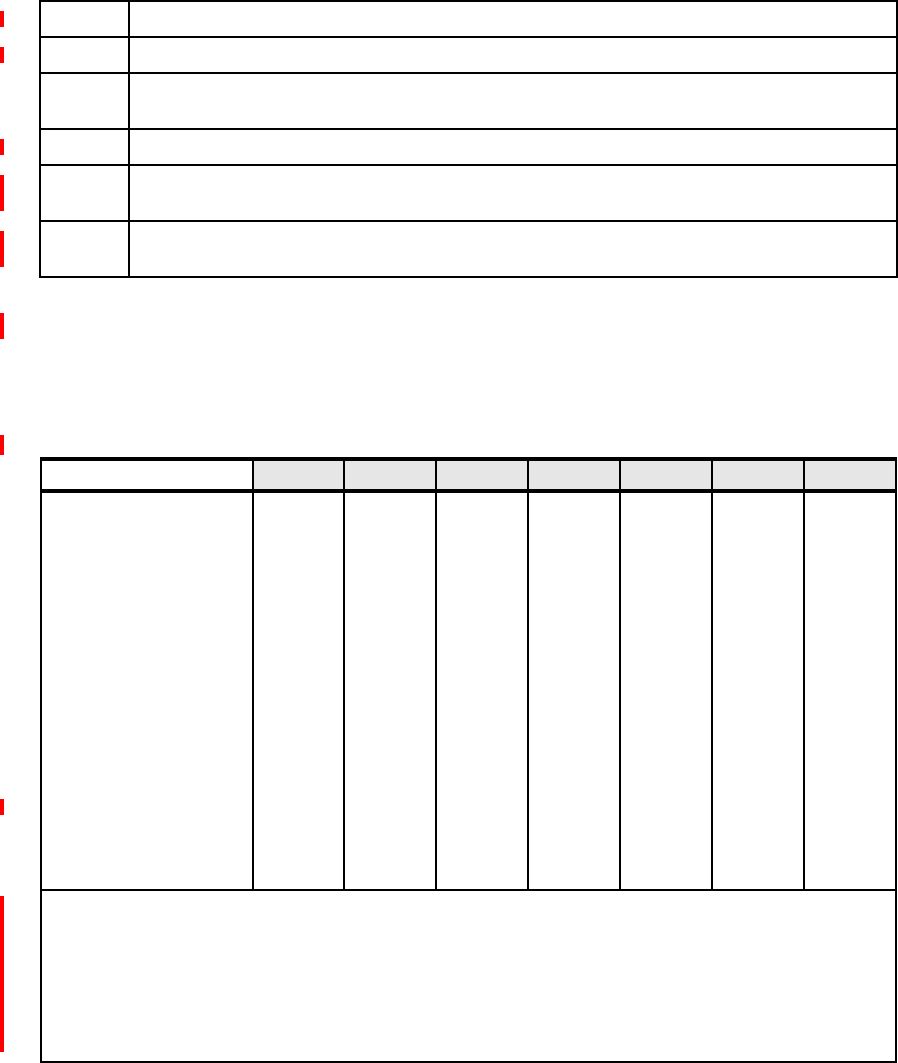
82 i5 Handbook
Summary of the System i5 expansion units and towers capacity
tables
This section identifies the maximum capacities of expansion units and towers
supported by Models 520, 550, 570, and 595.
Note 10 When a second RIO-G loop is required, one PCI card slot is used for the RIO-G adapter.
Note 10a The 520+ models have one PCI-X 2.0 card slot (P1-C4) that is for IOP-less cards only
Note 11 One terabyte (TB) of memory can be ordered after 28 October 2004. Two TB are planned to be available in
2005.
Note 12 A maximum of 64 i5/OS partitions applies.
Note 12b The optional Accelerator for System i5 feature provides a dramatic boost in processor CPW for additional
workloads and partitions. (was 2b)
Note 13 Rack containing the system unit is a 42U, 24-inch rack. The bulk power supplies are installed in 8U leaving
16U empty.
#5094 #5095 #5088 #5294 #0588* #0595 #5790
Disk storage
DASD arms maximum 45 12 N/A 2x 45 N/A 12 N/A
Disk grouping 5 6 N/A 2x 5 N/A 6 N/A
# of supported Controllers 9 N/A 2x 9 N/A N/A
Maximum Disk storage GB 3164.4 843.84 N/A 6328.8 N/A 843.84 N/A
Physical packaging Tower Tower Tophat Rack Drawer Drawer Drawer
Rackable No Yes Yes Yes
EIA Units 18 N/A 8 36 8 5 4
Internal CD/DVD/tape 2 N/A N/A 0
Dual Power Cords #5115 optional yes #5116 yes yes
Redundant Power Supply yes #5138 yes yes #5138 yes
Slim line media bays N/A N/A N/A N/A N/A N/A N/A
Number of busses
Base IOP 0000000
PCI Slots 14 7 14 2x 14 14 7 6
Integrated xSeries Server 2 2 4 2
Minimum i5/OS level V5R3 V5R3 V5R3 V5R3 V5R3 V5R3 V5R3
* There is limited support of the higher speed HSL interface on the #5088 PCI-X Expansion Unit and #0588 PCI-X
Expansion Unit in Rack as of June 2005. Convert the existing HSL interface to the higher speed HSL interface (#6417
HSL-2/RIO-G Bus Adapter).
The #0588/#5088 is implemented like the #5094/#5294. You can purchase new with a #9517 Base HSL-2/RIO-G Bus
Adapter.
Prerequisite: RPQ 847204
The e-config and LVT configurator tools do not support this RPQ. Configurations must be managed without the benefit
of the configurator tools.

Today’s System i5 summary 83
Copper RIO-G adapters * #9517 #9517 #9877 #9517 #9417
#9517
#9517 #9531
Optical RIO-G #9876 #9876 #9876 #9876 #9876 #9876
* There is limited support of the higher speed HSL interface on the #5088 PCI-X Expansion Unit and #0588 PCI-X
Expansion Unit in Rack as of June 2005. Convert the existing HSL interface to the higher speed HSL interface (#6417
HSL-2/RIO-G Bus Adapter).
The #0588/#5088 is implemented like the #5094/#5294. You can purchase new with a #9517 Base HSL-2/RIO-G Bus
Adapter.
Prerequisite: RPQ 847204
The e-config and LVT configurator tools do not support this RPQ. Configurations must be managed without the benefit
of the configurator tools.
84 i5 Handbook

© Copyright IBM Corp. 1997 - 2006. All rights reserved. 85
Chapter 6. IBM System i5 Model 520+
The IBM System i5 Model 520+ is designed for small to
mid-sized businesses. These are clients that need power
and capacity to run traditional core business applications,
with the freedom and scalability to add new applications to
the same system. The advanced POWER5 processor
models come with faster POWER5+ processors that
deliver improved scalability and have noticeably improved
capacity for solutions using Java or WebSphere.
The 9406 Model 520+ now has more flexibility with
Capacity on Demand for a 1/2-way processor in the
Standard, Enterprise, Solution and High Availability Editions.
The Model 520 Value Editions and the 9405 Model 520 Express configurations
that are based on them, can use a new Accelerator for System i5 to conveniently
provide more processor CPW if required.
All of the 520 models have the capability to simultaneously run multiple operating
environments and dynamically distribute processing resources.
6

86 i5 Handbook
Editions and configurations
9405 Model 520 Value Edition
The Value Edition is tailored specifically to small enterprises and is available in
two offerings as shown in the following table:
9405 Model 520 Express Configurations
The 9405 Model 520 Express configurations provide ready-to-run, fixed
configurations as shown in the following table. The Express configurations are
based on the 9406 Value Editions.
9405 Model 520+
Processor feature #8325 #8327
Server feature #0975 #0975
Edition feature #7350 #7352
Number/type/speed of processor 1/POWER5+/1.9 GHz 1/POWER5+/1.9 GHz
Processor/OLTP CPW 600/30 1200/60
Processor/OLTP CPW with Accelerator 3100/30 3800/60
L2 Cache/L3 Cache (MB) 1.9/0 1.9/36
Main storage (GB minimum/maximum) 1/32 1/32
Disk (GB - system minimum/maximum) 0/39234 0/39234
LPAR/LPAR with Accelerator 2/10 3/10
Minimum i5/OS / LIC level V5R3/V5R3M5 V5R3/V5R3M5
Software group P05 P10
9405 Model 520 Express Configurations
Configuration Entry Entry Plus Entry Plus
with RAID
Growth Growth
with RAID
Turbo Turbo
with RAID
CPW 600 600 600 1200 1200 3800 3800
CPW with
Accelerator
3100 3100 3100 3800 3800 n/a n/a
OLTP CPW30303060606060
LPAR 2/10 2/10 2/10 3/10 3/10 10 10
Server feature 0970 0970 0970 0970 0970 0970 0970
Processor 8325 8325 8325 8327 8327 8327 8327
Configuration 7140 7141 7142 7148 7143 7144 7152
Disk 2x#9256
(2x35GB)
2x#9256
(2x35GB)
4x#9256
(4x35GB)
2x#9256
(2x35GB)
4x#9256
(4x35GB)
2x#9256
(2x35GB)
4x#9256
(4x35GB)
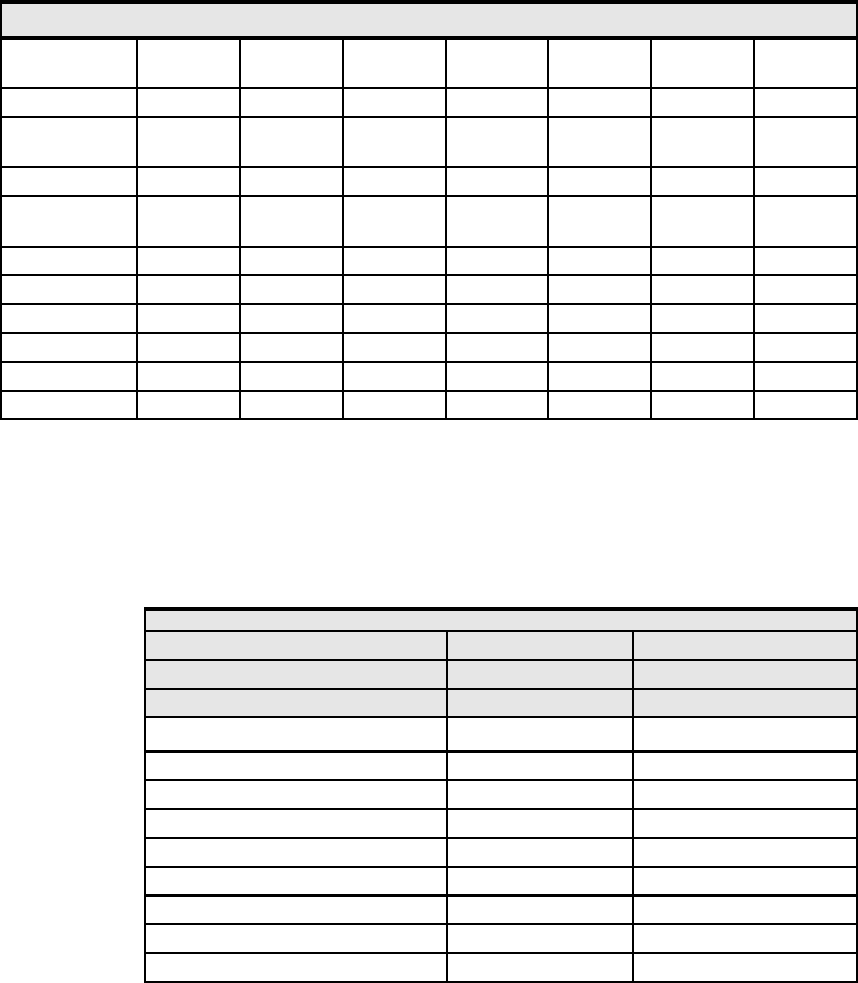
IBM System i5 Model 520+ 87
9406 Model 520 Standard Edition
The Standard Edition is designed for clients who require more capacity and
flexibility than is available in the Value Edition and who do not require any OLTP
(5250) CPW. 5250 OLTP applications modernized using the WebFacing tool of
IBM WebSphere Development Studio can be run on this edition.
Disk protection 0040
Mirror
0040
Mirror
0041
RAID-5
0040
Mirror
0041
RAID-5
0040
Mirror
0041
RAID-5
Cache/RAID None None 9510 None 9510 None 9510
Console 5540
Twinax
5540
Twinax
5540
Twinax
5540
Twinax
5540
Twinax
5540
Twinax
5540
Twinax
RIO loops0000000
DDR2 memory 9548
(1GB)
9548
(1GB)
9548
(1GB)
9549
(2GB)
9549
(2GB)
9553
(4GB)
9553
(4GB)
30GB QIC tape 9653 9653 9653 9653 9653 9653 9653
DVD-ROM 9540 9540 9540 9540 9540 9540 9540
Modem 9793/9794 9793/9794 9793/9794 9793/9794 9793/9794 9793/9794 9793/9794
Base IOP 9844 9844 9844 9844 9844 9844 9844
Twinax 9746 9746 9746 9746 9746 9746 9746
Software group P05 P05 P05 P10 P10 P10 P10
9405 Model 520 Express Configurations
9406 Model 520+
Processor feature #8327 #8330
Server feature #0906 #0906
Edition feature #7784 #7785
Number/type/speed of processor 1/POWER5+/1.9 GHz 1/2-way POWER5+/1.9 GHz
Processor/OLTP CPW 3800 3800/7100
OLTP (5250) CPW 0 0
LPAR 10 10 per processor
L2 Cache/L3 Cache (MB) 1.9/36 1.9/36
Main storage (GB minimum/maximum) 1/32 1/32
Disk (GB - system minimum/maximum) 0/39234 0/39234
Minimum i5/OS/LIC level V5R3/V5R3M5 V5R3/V5R3M5
Software group P10 P20

88 i5 Handbook
9406 Model 520 Enterprise, High Availability and Solution
Editions
The Enterprise Edition is ideal for clients with dynamic business environments
who need to respond immediately to fluctuating, unpredictable On Demand
Business needs. It is shipped with advanced tools for managing mixed
workloads. The Enterprise Edition provides base 5250 CPW authorization up to
the processor CPW value. On the 1/2-way, an additional Enterprise Enablement
feature can be purchased if additional 5250 CPW is required.
The High Availability (HA) Edition is for those clients who need 24x7 availability.
The 520 HA Edition must be equal in size or smaller than the primary processor
to which it is linked by specific high-availability software provided by a qualified
ISV. The HA Edition is physically identical to the equivalent CPW size Enterprise
Edition. Different content is shipped with the HA Edition than with the Enterprise
edition.
The following table summarizes the Enterprise, High Availability and Solution
Editions:
Model overview
The Model 520 initial installation is Customer Setup (CSU). IBM Service
Representatives perform the processor upgrades within models.
9406 Model 520+
Processor feature #8327 #8330
Server feature #0906 #0906
Edition feature
#7366
Solution
#7373
HA
#7374
HA
#7734
Enterprise
#7735
Enterprise
#7375
HA
#7736
Enterprise
Processor CPW 1200 1200 2800 1200 2800 3800/7100 3800/7100
OLTP (5250) CPW 1200 1200 2800 1200 2800 max max
LPAR 3 3 7 3 7 10 per processor
Number/type/speed of
processor
1/POWER5+/1.9 GHz 1/2-way/POWER5+/1.9 GHz
L2 Cache/L3 Cache (MB) 1.9/36 1.9/36
Main storage (GB min/max) 1/32 1/32
Disk (GB - system min/max) 17.54/39234 17.54/39234
Minimum i5/OS/LIC level V5R3/V5R3M5 V5R3/V5R3M5
Software group P10 P20

IBM System i5 Model 520+ 89
This section takes a closer look at the processor features, minimum functional
server, required features, and optional features of the Model 520. Refer to IBM
Eserver i5, iSeries, and AS/400e System Builder, SG24-2155 for schematics.
PCI cards and features
The number of PCI cards supported by the total system depends on the
input/output (I/O) towers that are attached. PCI card placement rules and LPAR
configuration considerations also affect the number of slots supported.
See the table on page 48 for the number of maximum features supported by the
total system and in the Model 520 system unit. See Chapter 20, “System i5 PCI
and PCI-X I/O processors” on page 271, and Chapter 11, “System i5 I/O
adapters and controllers” on page 135, for full descriptions of the features that
are supported.
Processor features
The Model 520 POWER5+ system supports a single processor card. The
processor card supports eight Dual InLine Memory Module (DIMM DDR2)
memory positions that allow memory to be plugged in the processor card (direct
attach). Memory is plugged in pairs of DIMMs.
The processor cards are the:
#8325 520 1.9GHz Processor (?-way)
– 1.9MB L2 cache
– no L3 cache
#8327 520 1.9GHz Processor (?-way)
– 1.9MB L2 cache
– 36MB L3 cache
#8330 520 1.9GHz Processor 0/2-way
– 1.9MB L2 cache
– 36MB L3 cache
Three media bays and one operator panel bay
The three media bays consist of one half-height and two slimline bays. The
half-height bay is for SCSI tape devices.
Note: The placement of PCI cards follows special rules. Refer to PCI Card
Placement Rules for the IBM Eserver iSeries Server Version 5 Release 3,
REDP-4011.

90 i5 Handbook
The top slimline bay is usable by IBM i5/OS for the required DVD-ROM or
DVD-RAM. The second slimline bay is straight IDE and is usable only with
AIX 5L or Linux partitions on 9406 Model 520 systems.
Two system and two USB 2.0 ports
– Neither USB port is usable by i5/OS.
– Only system port T2 is usable by i5/OS (for #1827 Serial-UPS Conversion
Cable)
Two 10/100/1000 Mbps Ethernet ports
One of these Ethernet ports is usable for a local area network (LAN) console.
Base Service Processor
Two Hardware Management Console (HMC) ports and two SPCN ports
Refer to “Summary of the System i5 Model 520+ (9405 and 9406)” on page 53 to
find the capacity and configuration maximums.
Required features
The required features for the 520 system unit include:
Specific combinations of the Processor feature, Edition feature, and Server
feature.
Main storage
Load source disk unit - internal or external (SAN load source)
DVD-ROM or DVD-RAM
System console attachment specify
Rack Mount or Deskside specify.
Refer to IBM Eserver i5, iSeries, and AS/400e System Builder, SG24-2155 for
description of other features available for Model 520.
Optional features
The optional features for the 520 system unit include:
#2888 RIO-G Ports - 2 Copper
#5159 850 Watt Power Supply
Note: A Hardware Management Console (HMC) is required to manage
specific configurations. See “Hardware Management Console” on
page 315 for more information.

IBM System i5 Model 520+ 91
#5727 Integrated Cache 40MB
The #5727 provides a card which augments the base integrated disk
controller of the model 520 with 40MB of write cache and also enables
RAID-5 capability for the internal disk drives of the system unit.
#6585 Disk Locking Kit
#6574 - 4-Disk Slot Expansion Base Controller
#6594 4-Disk Slot Expansion
The #6594 cannot be controlled by the integrated base disk controller and
requires a feature disk controller.
#6598 Disk Slot Filler
Internal tape unit
High-speed link on Model 520
The Model 520 does not include as base a RIO-G port. If a RIO-G loop is
required, an optional feature #2888 RIO-G Ports - 2 Copper can be added. The
maximum rated speed of RIO-G is 2 GB/s (full duplex).
For more information, see High-speed Link Loop Architecture for the IBM
Eserver iSeries Server: OS/400 Version 5 Release 2, REDP-3652, and the
HSL Rules presentation available at:
http://www-1.ibm.com/servers/eserver/iseries/ha/systemdesign.html
External towers
Refer to Chapter 10, “Towers, racks, mirroring packages, high-speed link, and
i5/OS on p5” on page 117, for information about supported towers for the Model
520. See “Summary of the System i5 expansion units and towers capacity tables”
on page 82 for a table of configuration maximums.
Model 520 upgrades
Supported model upgrades for the Model 520 are identified in the Upgrade topic
of the Find and Compare Tool (FACT) at:
http://www-919.ibm.com/servers/eserver/fact/
92 i5 Handbook

© Copyright IBM Corp. 1997 - 2006. All rights reserved. 93
Chapter 7. System i5 Model 550+
The System i5 Model 550 is a mid-sized IBM POWER5+
server which supports the On Demand Business. It has the
ability to simultaneously run multiple operating
environments and dynamically distribute processing
resources. This system is designed for small to mid-sized
businesses. which need power and capacity to run
traditional core business applications and to support IBM
i5/OS applications together with Linux, Windows, AIX
applications.
The Model 550 is offered as a deskside tower and a rack
mounted configuration with one to four POWER5+ processors active. It provides
an integrated set of hardware capabilities including two integrated 1 Gbps
Ethernet ports and an integrated Small Computer System Interface (SCSI)
controller. Hot-plugging is supported for PCI-X card slots, disk slots, and
redundant fans. In addition, the System i5 model 550 can have input/output (I/O)
towers and drawers added concurrently and have xSeries servers attached by
using the Integrated xSeries Adapters to increase its capabilities.
7

94 i5 Handbook
Model overview
This section gives an overview and takes a closer look at the minimum functional
server, required features, and optional features of the System i5 model 550.
Refer to IBM Eserver i5, iSeries, and AS/400e System Builder, SG24-2155 for
schematics of the Model 550.
Editions
There are five Edition offerings for the model 550: Standard, Enterprise, High
Availability, Domino and Solution.
The Editions of the 550+ come with fewer licenses of i5/OS than previous 550
Editions. Most Editions on the 550+ include only one license to allow maximum
flexibility in choosing the operating systems required to be deployed. The
exceptions are the Domino Edition and the two SAP Solution Editions which ship
with more i5/OS licences.
Standard Edition (#7154)
The Standard Edition is ideal for a wide variety of On Demand Business and
client/server solutions. 5250 OLTP applications modernized using the
WebFacing tool of IBM WebSphere Development Studio can be run on this
Edition. There is no native 5250 OLTP processing capability
System i5 Model 550
Processor Feature #8312
Server Feature #0910
Number/Type/Speed of Processors 1/4-way/POWER5+/1.9 GHz
L2 Cache/L3 Cache (MB) 1.9/36
Processor CPW / OLTP CPW 3800-14000 / 0-14000
Main Storage (GB minimum/maximum) 2/64
Maximum disk (MB) 77339
LPAR 10/40
Minimum i5/OS level V5R3
Software group P20
System i5 Model 550+ 95
Enterprise Edition (#7155)
The Enterprise Edition provides additional processing support over the Standard
Edition for those with traditional 5250 OLTP applications.
The Enterprise Edition includes a Base Enterprise Enablement feature which
provides one processor authorization of 5250 CPW. Further Enterprise
Enablement features can be purchased if additional 5250 CPW capacity is
required.
The Enterprise Edition also ships with additional advanced software tools for
managing mixed workloads and virtual workplace software.
System i5 Optimum Care is available upon request with the Enterprise Edition.
High Availability (HA) Edition (#7551)
If 24x7 availability is needed, multiple System i5 units can be linked using with
high-function third-party software. Role swapping and production on both primary
and secondary servers is typical. The HA Edition is attractively priced for this
purpose.
The 550 HA Edition must be equal or smaller than the primary processor to
which it is linked, and the primary server must have 5250 OLTP capability. Both
the primary and secondary servers must use specific high-availability software
provided by a qualified ISV.
The HA Edition is physically identical to the equivalent Model 550 Enterprise
Edition except different content is shipped with the High Availability Edition than
with the Enterprise Edition.
Domino Edition (#7629)
The Domino Edition supports many Lotus solutions as well as other client/server
applications. 5250 OLTP applications are supported when modernized by tools
like Webfacing.
The Domino Edition requires proof of license for two Domino Enterprise Servers
and Lotus Client licenses as defined on the Domino Edition website.
Solution Editions (#7630 with #7631, #7632, #7640, #7641)
Solution Editions are used with qualified ISV software to provide attractively
priced solutions. Specific Solution Editions are available for some application
providers.

96 i5 Handbook
For more information on the configuration content and a more complete definition
of the service and education offerings, see:
http://www.ibm.com/eserver/iseries/hardware/editions.html
PCI cards and features
The total number of PCI cards supported in a System i5 model 550 depends on
the I/O towers that are attached. PCI card placement rules and LPAR
configuration considerations also affect the number of slots that are supported.
See the table on page 48 for the number of maximum features supported by the
total system and in the model 550 system unit. See Chapter 20, “System i5 PCI
and PCI-X I/O processors” on page 271, and Chapter 11, “System i5 I/O
adapters and controllers” on page 135, for full descriptions of the features that
are supported.
Processor features
The Model 550 POWER5+ 1/4-way system has two 0/2-way processor cards.
Each processor card consists of a #8312 550 1.9GHz Processor 0/2-way with:
1.9MB L2 cache
36MB L3 cache
Memory features
Each processor card supports eight Dual InLine Memory Modules (DIMM DDR2)
memory positions that allow memory to be plugged in the processor card (direct
attach). A memory feature must be present on each processor card for a
minimum of two features.
Each memory feature consists of two DIMMs. Best performance is achieved with
equally sized DIMMs.
Model 550 Capacity on Demand
The System i5 model 550 offers Capacity on Demand options that make it
possible to activate additional processor resource. On Demand features are
available as:
Capacity Upgrade on Demand (Permanent)
On/Off Capacity on Demand (Temporary)
Note: The placement of PCI cards follows special rules. Refer to PCI Card
Placement Rules for the IBM Eserver iSeries Server Version 5 Release 3,
REDP-4011.
System i5 Model 550+ 97
Reserve Capacity on Demand (Prepaid)
Trial Capacity on Demand (Temporary)
See the following Web site for more information about Capacity on Demand:
http://www-1.ibm.com/servers/eserver/iseries/ondemand/cod/
Minimum functional server
A minimum functional server consists of the base server unit and selected priced
features. The base server includes:
Five hot-plug PCI-X card slots
Operator panel
Base 1475W Power Supply and line cord
Base direct access storage device (DASD) cage
Base SCSI controller
This controller is integrated with the backplane and does not take up one of
the PCI-X slots. It provides support for up to eight disk units, the required
internal DVD feature and optional internal feature DVDs, and feature tapes.
Three media bays and one operator panel bay
The three media bays consist of one half-height bay and two slimline bays.
The half-height bay is for SCSI media devices. The top slimline bay is usable
by i5/OS for the required DVD-ROM or DVD-RAM. The second slimline bay is
only usable with AIX 5L or LINUX partitions.
Two system and two USB 2.0 ports
One system port can be used for the UPS. Otherwise these ports are not
usable by i5/OS.
Two 10/100/1000 Mbps Ethernet ports
One of these ports can be used for a local area network (LAN) console.
Base Service Processor
Two Hardware Management Console (HMC) ports and two SPCN ports
Two high-speed link (RIO-G) ports
Required features
The required features for the 550 system unit include:
Specific combinations of the Processor feature, Edition feature, and Server
feature.
Main storage
Two memory features are required. The minimum memory is 2GB.

98 i5 Handbook
Load source disk unit - internal or external (Load source on SAN)
DVD-ROM or DVD-RAM
System console attachment adapter specifier
Disk protection specifier
Rack Mount (default) or Deskside specify
Refer to IBM Eserver i5, iSeries, and AS/400e System Builder, SG24-2155 for
description of other features available for Model 550.
Optional features
The optional features for the System i5 Model 550 system unit include:
#5727 Integrated Cache 40MB
The #5727 provides a card which augments the Base Integrated Disk
Controller of a model 550 with 40MB of write cache and also enables the
RAID-5 capability for the disk drives situated in the system unit.
Additional RIO-G port
Internal tape unit
#7889 1475W Power Supply
#6592 4-Disk Slot Expansion
#6593 4-Disk Slot Expansion
The #6593 cannot be controlled by the integrated base disk controller and
requires a further feature disk controller.
#6598 Disk Slot Filler
The model 550 initial installation is IBM installed. Processor upgrades within
models are performed by IBM Service Representatives.
Note: A Hardware Management Console (HMC) is required as a console
for specific configurations. See “Hardware Management Console” on page
for more information.

System i5 Model 550+ 99
High-speed link on Model 550
Expansion units and towers are supported using RIO-G cabling. The Model 550
supports two RIO-G loops. The maximum rated speed of the RIO-G is 2 GB/s.
For more information, see High-speed Link Loop Architecture for the IBM
Eserver iSeries Server: OS/400 Version 5 Release 2, REDP-3652, and in the
HSL Rules presentation available at:
http://www-1.ibm.com/servers/eserver/iseries/ha/systemdesign.html
External towers
Refer to Chapter 10, “Towers, racks, mirroring packages, high-speed link, and
i5/OS on p5” on page 117, for information about supported towers for the model
550, and “Summary of the System i5 expansion units and towers capacity tables”
on page 82 for a table of configuration maximums.
Model 550 upgrades
Supported model upgrades for the Model 550 are identified in the Upgrade topic
of the Find and Compare Tool (FACT) at:
http://www-919.ibm.com/servers/eserver/fact/
100 i5 Handbook

© Copyright IBM Corp. 1997 - 2006. All rights reserved. 101
Chapter 8. System i5 Model 570+
The System i5, originally introduced as the IBM Eserver
iSeries, was the industry's first POWER5 processor-based
system and is now offered with the faster 2.2 GHz POWER5+
processor. The System i5 model 570+ is designed for the
complex requirements of medium to large enterprises. It can
help businesses reduce datacenter complexity, simplify IT
infrastructures, and effectively manage IT service level
commitments.
8
102 i5 Handbook
Highlights
Simplify your IT infrastructure, run multiple applications and even multiple
operating systems simultaneously, including IBM i5/OS, Linux, IBM AIX 5L,
Microsoft Windows Server, WebSphere, and Lotus Domino software on a single
highly flexible, resilient System i5 570+. The 570+ offers built-in Capacity on
Demand for more performance when your business needs it.
Dynamic Logical Partitioning (LPAR) allows the System i5 resources to be
grouped into logically separate systems within the same physical footprint. With
capabilities like “uncapped partitions,” System i5 processors can be shared
between partitions (defined via policies). Micropartitioning allow you to allocate
less than a full processor to a logical partition.
System i5 model 570 and i5/OS adapt to disruptive technology changes while
helping to protect your business from the expense of changing or recompiling
your applications.
A highly scalable, upgradable, industry-standard rack-optimized building block
architecture helps support balanced growth from 2/4-way to 8/16-way systems.
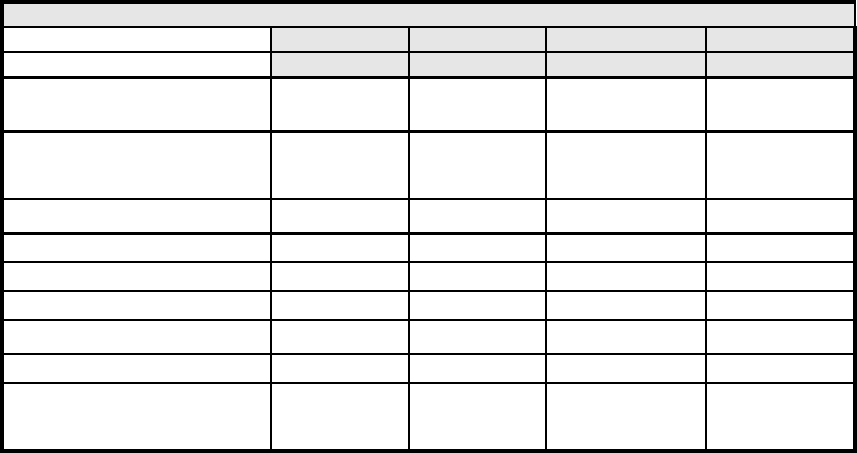
System i5 Model 570+ 103
Model overview
This section provides an overview and takes a closer look at the minimum
functional server, required features, and optional features.
The Model 570+ initial installation and processor upgrades within models are
performed by IBM Service Representatives.
The Model 570+ is offered as a rack mounted configuration. It provides an
integrated set of hardware capabilities that include two integrated 1 Gbps
Ethernet ports and an integrated Small Computer System Interface (SCSI)
controller for the enclosure's disk and DVD slots. Also incorporated are hot-plug
PCI-X card slots and disk slots, redundant hot-plug power supplies, dual power
cords, redundant hot-plug cooling fans. Hot-plugging of removable media devices
is not supported.
Editions
Editions for the 570+ comes with one license of i5/OS. This offers you greater
flexibility in choosing which operating system you wish to deploy.
Four editions are offered to simplify your decision and maximize your business
value: Standard, Enterprise, High Availability, and Capacity BackUp.
Model 570+
Processor feature #8338 x 2 #8338 x 4 #8338 x 8 #8338 x 8
Server feature #0934 #0935 #0936 #0937
Number/type/speed of processor 2/4/ POWER5+/
2.2GHz
4/8/ POWER5+/
2.2 GHz
8/16/ POWER5+/
2.2GHz
2/16/ POWER5+/
2.2 GHz
Processor CPW 8400/16000 16700/31100 31100/58500 8100/58500
Mail and Calendar Users 18200/34500 35500/67500 67500/130000 18200/130000
Main storage (GB min/max) 4/128 8/256 16/512 16/512
Logical partitions (LPAR) 20/40 40/80 80/160 20/160
Minimum i5/OS level V5R3 V5R3 V5R3 V5R3
Software group P30 P40 P40 P40
Disk storage (GB) system maximum 77051 116000 193898 193898
DASD arms maximum 546 822 1374 1374
External RIO-G loops 2 4 8 8
PCI/PCI-X Expansion Tower 12 24 48 48
104 i5 Handbook
Standard Edition (#7757/#7758/#7759)
Order the Standard Edition if you do not need the maximum flexibility of the
Model 570 Enterprise Edition. The Standard Edition is featured for a wide variety
of On Demand Business and client/server solutions. 5250 OLTP applications
WebFaced using the WebFacing tool of IBM WebSphere Development Studio
can be run with no 5250 CPW requirement.
Enterprise Edition (#7747/#7748/#7749)
Order the Enterprise Edition if you need a higher level of flexibility on the model
570+. It is ideal for clients with dynamic business environments who need to
respond immediately to fluctuating, unpredictable On Demand Business needs.
The Enterprise Edition includes a Base Enterprise Enablement feature which
provides one processor authorization of 5250 CPW. One Enterprise Enablement
feature is included in the Enterprise Edition. Purchase additional Enterprise
Enablement features if you require additional 5250 CPW capacity.
The Enterprise Edition starts with the Standard Edition content and builds on it.
As a total system, it integrates and exploits fundamental hardware and software
for e-businesses. It is shipped with advanced tools for managing mixed
workloads and virtual workplace software.
System i5 Optimum Care is available upon request with the Enterprise Edition.
High Availability Edition (#7763/#7764/#7765)
If you need 24x7 availability, you can tie multiple System i5 units together with
high-function third-party software. Role swapping and production on both primary
and secondary servers is typical. In this multiple System i5 environment, the
System i5 model for high availability is an attractively priced model 520, 550, 570,
or 595 linked with a model 520, 550, 570, 595, 810, 825, 870, or 890, of equal or
higher CPW.
These systems are physically identical to the equivalent Enterprise Edition model
570 except different content is shipped with the High Availability Edition than with
the Enterprise Edition.
Capacity BackUp Edition (#7760)
A System i5 for Capacity BackUp can give you an off-site disaster recovery
machine at an affordable price. A 2/16-way model 570+ leverages On/Off
Capacity on Demand capabilities into an effective backup server. Two processors
can be permanently activated and used for any workload. Fourteen standby
processors can be used at no-charge in the event of a disaster for an extended
period of time, but cannot be permanently activated.

System i5 Model 570+ 105
The Capacity BackUp Edition contains a minimal set of software content
because IBM software licensing can allow the primary server's licensing to be
transferred to a backup server in case the primary server is out of production.
For more information on configuration content and a more complete description
of the service and education offerings, see:
http://www.ibm.com/eserver/iseries/hardware/editions.html
http://www-03.ibm.com/servers/eserver/iseries/hardware/is4ha/
http://www-03.ibm.com/servers/eserver/iseries/hardware/is4cbu/
PCI-X cards and features
The number of PCI- X cards that can be supported in a Model 570+ depends on
whether an I/O tower is attached and the number of PCI-X slots. PCI- X card
placement rules and LPAR configuration considerations also affect the number of
slots supported.
See the table on page “Summary of the System i5 Model 570+ and i5 Model 570”
on page 64 for the number of maximum features supported by the total system
and in the Model 570 system unit. See Chapter 20, “System i5 PCI and PCI-X I/O
processors” on page 271, and Chapter 11, “System i5 I/O adapters and
controllers” on page 135, for full descriptions of the features that are supported.
Processor features
The System i5 Model 570+ 2.2GHz DCM processor card #8338 is offered as a
2/4-way, 4/8-way or 8/16-way system. There is also a 2/16-way model 570+
designed for disaster recovery usage.
The model 570 processor is housed in a four EIA-unit rack-optimized processor
enclosure. Each enclosure holds up to four processors (two 0/2-way processor
features). Thus a 2/4-way has one processor enclosure.
Additional single processor activations are orderable with #7897.
Refer to “Summary of the System i5 Model 570+ and i5 Model 570” on page 64
to find the capacity and configuration maximums.
Note: The placement of PCI cards follows special rules. Refer to PCI Card
Placement Rules for the IBM Eserver iSeries Server Version 5 Release 3,
REDP-4011.
106 i5 Handbook
Main storage
Each 2.2GHz DCM #8338 processor card supports eight Dual InLine Memory
Module (DIMM DDR2) memory positions that allow memory to be plugged in the
processor card. Supported memory features for the Model 570+ are available in
512MB, 1GB, 2GB, 4GB, 8GB, and 16 GB options.
Performance measurements have determined that optimal performance requires
both the spreading of memory across processors and balancing memory across
processors. Balance memory by having the same or similar size memory
features for all processor features.
Refer to IBM Eserver i5, iSeries, and AS/400e System Builder, SG24-2155 for
memory rules for Model 570+.
Model 570+ Capacity on Demand
The System i5 Model 570+ offers Capacity on Demand options that make it
possible to activate additional processor resource. CUoD, On/Off Capacity on
Demand, Reserve Capacity on Demand, and Trial Capacity on Demand are
available for the Model 570+. Available On Demand features include:
Capacity Upgrade on Demand (Permanent)
On/Off Capacity on Demand (Temporary)
Reserve Capacity on Demand (Prepaid)
Trial Capacity on Demand
See the following Web site for more information about Capacity on Demand:
http://www-1.ibm.com/servers/eserver/iseries/ondemand/cod/
Minimum functional server
A minimum functional server consists of the base server unit and selected priced
features. The base server includes:
Two base power supplies
Base CEC enclosure including CEC backplane, a CPU Regulator, sixteen
memory slots
I/O Backplane, which includes:
–Two USB Type A
Supported by specific releases of AIX 5L and specific Linux distributions.
Not supported on IBM i5/OS.
– An integrated 1 Gps/100 Mbps/ 10 Mbps UTP Ethernet LAN adapter with
two ports.
Supported with i5/OS V5R4 for local area network (LAN) console.

System i5 Model 570+ 107
– One RIO-G loop with two RIO-G ports
– One system connection port (for Service Processor flex cable connection)
– Six hot-plug PCI-X card slots
Service Processor
Includes two SPCN ports, two HMC ports
One Rack Indicator Port
Two System ports
System VPD card
Direct access storage device (DASD) backplane
Six disk slots (three enabled with an optional Integrated Cache feature)
A slot to add an optional card for CEC Integrated Cache and RAID-5
capability.
Removable media backplane
Two slots for slimline DVD drives. i5/OS supports only one slimline removable
media slot for the required DVD-ROM/RAM.
Base I/O adapters (IOAs) or I/O processors (IOPs)
Operator Panel
Required features
The required features for the 570+ system unit include:
Specific combinations of the Processor feature, Edition feature, and Server
feature. See the Model 570+ Edition Table on page 94.
Main storage
One internal DVD-ROM or DVD-RAM
Load source disk unit internal or external (SAN Load source)
A load source specify code
A disk protection specify code
A system console specify code
Note: A Hardware Management Console (HMC) is required to manage
specific configurations. See “Hardware Management Console” on
page 315 for more information.

108 i5 Handbook
Optional features
The model 570 offers outstanding configuration flexibility with base or included
features and a large selection of optional features, the #8453 Base Customer
Placement.
The #8453 places hardware components as directed by information from the
LPAR Verification Tool (LVT). The client is responsible for submitting LVT
information. Hardware placement can be provided at the customer site by IBM
Global Services for a fee if #8453 is not on the initial order.
Refer to IBM Eserver i5, iSeries, and AS/400e System Builder, SG24-2155 for
description of other optional features available for Model 570+.
High-speed link on Model 570+
The Model 570+ supports up to eight RIO-G loops with a maximum of 48 towers
across all loops. The speed of the RIO-G is 2 GB/s compared to the previous
high-speed link adapters that operated at 1 GB/s.
See High-speed Link Loop Architecture for the IBM Eserver iSeries Server:
OS/400 Version 5 Release 2, REDP-3652, and the HSL Rules presentation
available at:
http://www-1.ibm.com/servers/eserver/iseries/ha/systemdesign.html
External towers
Refer to Chapter 10, “Towers, racks, mirroring packages, high-speed link, and
i5/OS on p5” on page 117, for information about supported towers for the Model
570+, and “Summary of the System i5 expansion units and towers capacity
tables” on page 82 for a table of configuration maximums.
Model 570+ upgrades
Supported model upgrades for the Model 570 are identified in the Upgrade topic
of the Find and Compare Tool (FACT) at:
http://www-919.ibm.com/servers/eserver/fact/

© Copyright IBM Corp. 1997 - 2006. All rights reserved. 109
Chapter 9. eServer i5 Model 595
The System i5 Model 595 is the largest and most powerful
member of the POWER5 technology-based servers with
four processor points, an 8/16-way, a 16/32-way, a
32/64-way, and a 4/32-way. Performance has increased to
a maximum rating of 184,000 commercial processing
workload (CPW). A new Capacity BackUp Edition has
been added to provide a cost effective, disaster recovery
solution.
The Model 595 consists at a minimum of two enclosures: a
two-meter system unit enclosure and an I/O tower about
one meter in height.
9
110 i5 Handbook
Highlights
Simplify your IT environments by enabling your business to deploy multiple
applications and even multiple operating systems simultaneously, including IBM
i5/OS, Linux, IBM AIX 5L, Microsoft Windows Server, WebSphere, and Lotus
Domino software on a single highly flexible, resilient System i5 595.
Built-in Capacity on Demand features allow your business to dynamically
respond to unexpected demands for CPU and/or memory and to meet constantly
changing business priorities.
Dynamic Logical Partitioning (LPAR) allows the IBM System i5 resources to be
grouped into logically separate systems within the same physical footprint. With
capabilities like “uncapped partitions”, System i5 processors can be shared
between partitions (defined via policies).Micropartitioning allows the allocation of
less than a full processor to a logical partition.
System i5 595 and i5/OS adapt to disruptive technology changes while helping to
protect your business from the expense of changing or recompiling your
applications.
Unmatched scalable, upgradeable, building block architecture supports balanced
growth from 8/16-way to 32/64-way systems.

eServer i5 Model 595 111
Model overview
This section has an overview table and takes a closer look at the minimum
functional server, required features, and optional features.
The Model 595 initial installation and processor upgrades within models are
performed by IBM Service Representatives.
Refer to IBM Eserver i5, iSeries, and AS/400e System Builder, SG24-2155 for
schematics of the Model 595.
Editions
Four Editions are offered: Standard, Enterprise, High Availability, and Capacity
BackUp. All editions for the Model 595 come with four licenses of i5/OS.
Standard Edition (#7480/#7482/#7486)
The Standard Edition is ideal for a wide variety of On Demand Business and
client/server solutions. 5250 OLTP applications modernized using the
WebFacing tool of IBM WebSphere Development Studio can be run on this
Edition.
Model 595
Processor feature #8966 #8966 x 2 #8966 x 4 #8966 x 2
Server feature #0940 #0941 #0943 #0944
Number/type/speed of processor 8/16 /POWER5/
1.9 GHz
16/32 /POWER5/
1.9 GHz
32/64 /POWER5/
1.9 GHz
4/32/POWER
5/1.9GHz
Relative system performance
Processor CPW 26700/50500 51000/92000 92000/184000 13600/92000
Mail and Calendar Users 60500/114000 115000/213000 213000/405000 31500/213000
Main storage (GB minimum/maximum) 8/512 16/1024 32/2048 16/1024
Logical partitions (LPAR) 160 254 254 254
Disk storage (GB)
Total maximum 228614 381024 381024 381024
DASD arms maximum 1620 2700 2700 2700
Physical packaging
External RIO-G loops 7 15 31 12
PCI/PCI-X Expansion Tower 36 72 96 72
Software group P50 P50 P60 P50
Minimum i5/OS level V5R3 V5R3 V5R3 V5R3
112 i5 Handbook
Enterprise Edition (#7481/#7483/#7487)
The Enterprise Edition provides additional processing support over the Standard
Edition for those with traditional 5250 OLTP applications.
The Enterprise Edition includes a Base Enterprise Enablement feature which
provides four processor authorizations of 5250 CPW. Further Enterprise
Enablement features may be purchased if additional 5250 CPW capacity is
required. The Enterprise Edition also ships with additional advanced software
tools for managing mixed workloads and virtual workplace software.
Upon request System i5 Optimum Care is available with this edition.
High Availability (HA) Edition (#7580, #7581, #7583)
If 24x7 availability is needed, multiple System i5 units can be linked using with
high-function third-party software. Role swapping and production on both primary
and secondary servers is typical.
The 595 HA Edition must be smaller than or equal in size (CPW) to the primary
processor to which it is linked, and the primary server must have 5250 OLTP
capability. Both the primary and secondary servers must use specific
high-availability software provided by a qualified ISV.
These systems are physically identical to the equivalent Enterprise Edition model
595 except different content is shipped with the High Availability Edition than with
the Enterprise Edition.
Capacity BackUp (CBU) Edition (#7590)
A System i5 model for Capacity BackUp can give you an offsite, disaster
recovery machine at an affordable price. A 4/32-way model 595 leverages On/Off
Capacity on Demand capabilities into an effective backup server. I/O and
memory minimums and maximums are the same as the 16/32-way 595 server.
The 28 standby processors of the 595 Capacity BackUp server cannot be
permanently activated.
The System i5 for Capacity BackUp server is not intended for, or priced as, a
backup server for 24x7 high availability solutions that require day-to-day full
operation of the backup server.
For more information on the edition's content and a complete definition of the
service and education offerings, see:
http://www.ibm.com/eserver/iseries/hardware/editions.html
http://www.ibm.com/eserver/iseries/hardware/is4ha

eServer i5 Model 595 113
http://www.ibm.com/eserver/iseries/hardware/is4cbu
Model 595 PCI cards and features
The number of PCI cards that can be supported in a Model 595 depends on the
number of I/O tower is attached and the number of PCI slots. PCI card placement
rules and LPAR configuration considerations also affect the number of slots
supported.
See the Summary table on page 109 for the number of maximum features
supported by the total system and in the Model 595 system unit.
Processor features
The Model 595 POWER5 system supports from one to four processor books.
Each #8966 595 1.9Ghz Proccessor 0/16-way processor book has two 8-way
Multi Chip Modules (MCM). Each processor book supports sixteen Dual InLine
Memory Module (DIMM DDR1) memory positions that allow memory to be
plugged in the processor card (direct attach). Each processor MCM has 36 MB of
L3 cache and 1.9 MB of L2 cache.
Refer to “Summary of the System i5 and eServer i5 Model 595” on page 69 to
find the capacity and configuration maximums.
Main Storage
Refer to IBM Eserver i5, iSeries, and AS/400e System Builder, SG24-2155 for
memory options and placement rules.
Model 595 Capacity on Demand
The System i5 Model 595 offers Capacity on Demand options that make it
possible to activate additional processor resource on either a permanent or
temporary basis. The options are:
Capacity Upgrade on Demand (Permanent)
On/Off Capacity on Demand (Temporary)
Reserve Capacity on Demand (Prepaid)
Trial Capacity on Demand (Temporary)
Note: The placement of PCI cards follows special rules. Refer to PCI Card
Placement Rules for the IBM Eserver iSeries Server Version 5 Release 3,
REDP-4011 before you propose any configuration.

114 i5 Handbook
See the following Web site for more information about Capacity on Demand:
http://www-1.ibm.com/servers/eserver/iseries/ondemand/cod/
Minimum functional server
A minimum functional server consists of the base server unit and selected priced
features. The Model 595 supports hot plug and concurrent add of PCI cards, disk
units, and removable media devices.
Included in the base server are the physical package and power elements as
follows:
System unit (also known as the Central Electronics Complex or CEC)
#9194 Base PCI-X Expansion Tower
Line cords
Power Assemblies
CEC Rack Front and Rear Doors
#3757 Service Shelf Toolkit
Up to four 16-way processor books (each has two 8-way MCMs)
Sixteen main storage card slots in each processor book
Seven slots for feature RIO-G adapters in first processor book, eight slots in
each of the second, third and fourth processor books.
Two #7818 RIO-G 2-port Copper
One #9844 Base PCI IOP
Two Service Processors
Note: A Hardware Management Console (HMC) is required to manage
specific configurations. See “Hardware Management Console” on
page 315 for more information.
eServer i5 Model 595 115
Required features
The required features for the 595 system unit include:
Supported specific combinations of the Processor feature, Edition feature,
and Server feature. See Model 595 Edition Table on page 95.
Main storage
PCI disk controller (SCSI or Fibre IOA)
The SCSI IOA supports the DVD-ROM, DVD-RAM, migrated CD-ROM,
internal tape, and disk units in the base PCI enclosure.
– #2757 PCI-X Ultra RAID Disk Controller
– #2780 PCI-X Ultra RAID Disk Controller (the base default)
– #2847 PCI IOP for SAN Load Source with #2787 or #5760 PCI-X Fibre
Channel Disk Controller
– #5580 #2780 Controller with Auxiliary Write Cache
– #5581 #2757 Controller with Auxiliary Write Cache
Removable optical device
Internal Load Source or SAN Load Source and associated Load Source
Specify Code
Disk protection specify code
System console
– #5540 System Console on Twinaxial Workstation IOA
– #5544 System Console on Operations Console
– #5546 System Console on 100 Mbps Token Ring
– #5548 System Console on 100 Mbps Ethernet
– #5550 System Console On HMC
– #5557 System Console Ethernet No IOP
Communications adapter
Refer to IBM Eserver i5, iSeries, and AS/400e System Builder, SG24-2155 for
description of other features available for Model 595.
High-speed link on Model 595
The Model 595 supports up to a maximum of 31 RIO-G loops with a maximum of
96 I/O towers across all loops. The speed of the RIO-G is 2 GB/s compared to
the previous high-speed link adapters that operated at 1 GB/s.
See High-speed Link Loop Architecture for the IBM Eserver iSeries Server:
OS/400 Version 5 Release 2, REDP-3652, and in the HSL Rules presentation
available at:
http://www-1.ibm.com/servers/eserver/iseries/ha/systemdesign.html

116 i5 Handbook
External towers
Refer to Chapter 10, “Towers, racks, mirroring packages, high-speed link, and
i5/OS on p5” on page 117, for details about supported towers for the Model 595,
and “Summary of the System i5 expansion units and towers capacity tables” on
page 82 for a table of configuration maximums.
#9194 Base PCI-X Expansion Tower
The #9194 Base PCI-X Expansion Tower is the base PCI I/O enclosure shipped
with a Model 595 server. It has 15 disk unit slots and can be expanded to a total
of 45 disk unit slots with the addition of the optional. One #9844 Base PCI IOP
and one #9793 Base PCI 2-Line WAN w/Modem are included.
#8294 Optional Base 1.8M Rack
The #8294 Optional Base 1.8M Rack is a racking option for a Model 595 and can
be substituted for #9194 Base PCI-X Expansion Tower. It has 90 disk unit slots,
28 PCI-X slots, four removable media slots, and is the equivalent to two I/O
towers.
The #8294 is a 1.8m rack with two enclosures; a bottom enclosure and a top
enclosure. The bottom enclosure is basically a #9194 Base PCI-X Expansion
Tower with the optional #5168 30 disk unit expansion enclosure feature while the
top enclosure is basically a #5094 PCI-X Expansion Tower with optional #5108
30 disk unit expansion enclosure feature. The #5168 and #5108 optional 30 disk
unit expansion enclosure features are not required for a #8294
Included with the bottom enclosure are a #9517 Base HSL-2/RIO-G Bus Adapter
and a #9844 Base PCI IOP. The top enclosure comes with. a #9517 Base
HSL-2/RIO-G Bus Adapter and no #9844 Base PCI IOP.
Each enclosure supports 45 disk units for a total of 90 disk units.
Model 595 upgrades
Supported model upgrades for the Model 595 are identified in the Upgrade topic
of the Find and Compare Tool (FACT) at:
http://www-919.ibm.com/servers/eserver/fact/
Customization options
Customer specified card placement, rack placement, partition initialization, and
operating system preload (currently limited to i5/OS and AIX5L) into defined
partitions options are available for new systems. You can find detailed information
at the following web site:
http://www-1.ibm.com/servers/eserver/power/csp/iseries.html

© Copyright IBM Corp. 1997 - 2006. All rights reserved. 117
Chapter 10. Towers, racks, mirroring
packages, high-speed link,
and i5/OS on p5
To house components beyond the capability of the system unit,
towers are added. Expansion towers are offered for new or
migrated PCI features. Rack mounting options are available for
select systems and towers. Towers and rack-mounted devices
are connected to each other using high-speed links (HSL), either
HSL or HSL-2/RIO-G.
For information about the software required to support towers and
input/output (I/O) on System i5 servers, refer to Informational APAR II13440 on
the Web at:
http://www-912.ibm.com/n_dir/nas4apar.nsf/nas4aparhome
To learn about planning for System i5 racks, including PDU specifications, the
number of PCI cards supported, and the number of EIA units, refer to the iSeries
racking presentation at:
http://www-1.ibm.com/servers/eserver/support/iseries/planning/pdf/
iseriesracking.pdf
10

118 i5 Handbook
For configuration rules for tower and migration, see IBM Eserver iSeries
Migration: System Migration and Upgrades at V5R1 and V5R2, SG24-6055, and
IBM Eserver iSeries Migration: A Guide to Upgrades and Migrations to POWER
Te c h n o l o gy, SG24-7200. Refer to the IBM Eserver i5, iSeries, and AS/400e
System Builder, SG24-2155, for detailed information about each migration tower.
PCI and PCI-X expansion towers
Expansion towers provide System i5 servers with the ability to support additional
I/O and disk units. For information about the number and types of towers
supported by each System i5 server, see Chapter 5, “Today’s System i5
summary” on page 47.
#5088 PCI-X Expansion Unit
The #5088 is an eight-EIA-unit-high “top hat” installed on top of a #5074/#5094
expansion tower, or on top of a #9079 Base I/O Tower or #9094 Base PCI I/O
Enclosure. The #5088 has 14 PCI-X slots for PCI IOPs and IOAs. Disk units and
removable media are not supported by the #5088. A 5088 cannot be converted
to a #0588.
For a schematic of the #5088, see the IBM Eserver i5, iSeries, and AS/400e
System Builder, SG24-2155.
#0588 PCI-X Expansion Unit in Rack
The #0588 is the equivalent of a #5088 PCI-X Expansion Unit, but the #0588 is
mounted in a rack. A #0588 is eight EIA units high and has 14 PCI-X slots for PCI
IOPs and IOAs. Disk units and removable media are not supported by the #0588.
An #0588 can be on initial, upgrade, or MES orders, but cannot be converted to a
#5088.
#5094 PCI-X Expansion Tower
The #5094 PCI-X Expansion Tower has 15 disk unit slots, with an additional 30
slots available when using feature #5108 Disk Unit Expansion. The 45 disk unit
positions are in groups of 15. The #5094 has two removable media slots and 14
PCI-X card slots.
Note: The Eserver i5 520, 550, 570, and 595 do not support migration
towers or SPD hardware.

Towers, racks, mirroring packages, high-speed link, and i5/OS on p5 119
#5108 30 Disk Expansion Feature
The #5108 is a disk unit expansion enclosure feature for a #5094 Base I/O
Expansion Tower and the #9094 Base PCI I/O Enclosure. It includes two 15 disk
unit enclosures, one 840-watt power supply, backplanes, and cables.
A schematic of the #5094 PCI-X Expansion Tower can be found in IBM Eserver
i5, iSeries, and AS/400e System Builder, SG24-2155.
#5115 Dual Line Cords - Tower
The #5115 is a dual line cord enabler for the upper unit in a #8094 Optional 1.8 M
I/O Rack, and for the #5094 PCI-X Expansion Tower.

120 i5 Handbook
#5095 PCI-X Expansion Tower
The #5095 PCI-X Expansion Tower has seven PCI-X IOP/IOA slots and supports
up to 12 disk units. A #5095 cannot be converted to a #0595.
A schematic of the #5095 PCI-X Expansion Tower can be found in IBM Eserver
i5, iSeries, and AS/400e System Builder, SG24-2155.
#0595 PCI-X Tower Unit in Rack
#0595 PCI-X Expansion Unit in Rack is the racked version of the #5095 PCI-X
Expansion Tower which provides I/O capability for System i5 servers. The #0595
has functional capabilities identical to the #5095. The #0595 has seven PCI-X
IOP/IOA slots and supports up to 12 disk units. The #0595 requires 5 EIA Units
in a rack. A #0595 cannot be converted to a #5095.
A schematic of the #0595 PCI-X Expansion Unit in Rack can be found in IBM
Eserver i5, iSeries, and AS/400e System Builder, SG24-2155.
#5294 1.8m I/O Tower
The #5294 1.8m I/O Tower has space for up to 90 disk units, 28 PCI-X IOA/IOP
slots, and up to four removable media units. A #5294 is equivalent to two #5094
PCI-X Expansion Towers with side covers and casters removed, and with two
30-disk expansion included (no feature required) and placed in a 1.8 M tower.
The 90 disk unit positions are controlled by up to 18 OS/400 or Linux controlled
disk controllers.
The #5294 also supports up to four removable media devices (internal tape or
CD-ROM/DVD). These removable media devices are supported by the two PCI
RAID Disk Unit Controllers
A schematic of the #5294 1.8m I/O Tower can be found in IBM Eserver i5,
iSeries, and AS/400e System Builder, SG24-2155.
#5116 Dual Line Cords - #5294 Tower
The #5116 provides dual line cord capability for a single enclosure in a #5294
tower.

Towers, racks, mirroring packages, high-speed link, and i5/OS on p5 121
#5790 PCI-X Expansion Unit
The #5790 PCI Expansion Drawer is a rack mounted, four EIA, half-wide unit that
has six full-length 64bit PCI-X slots requiring four units of vertical space in the
rack. The #5790 PCI-X Expansion Unit requires i5/OS V5R3.
A schematic of the #5790 PCI-X Expansion Unit can be found in IBM Eserver
i5, iSeries, and AS/400e System Builder, SG24-2155.
#7307 Dual I/O Unit Enclosure
The #7307 enclosure provides the mounting hardware, with adjustable rails,
required to install a #5790 I/O drawer in a #0551, #0553, #0554, or #0555 rack.
The enclosure can accommodate two #5790 drawers, side by side, but it may
also be used with only one #5790 drawer installed.
The #7307 and #7311 are functionally equivalent except the #7307 can be used
in the #0554 and #0555 racks and has rails adjustable to 29.25 inches depth.
#7311 Dual I/O Unit Enclosure
The #7311 enclosure provides the mounting hardware required to install a #5790
I/O drawer in a #0551 or #0553 rack. The enclosure can accommodate two
#5790 drawers, side by side, but it may also be used with only one #5790 drawer
installed.
Racks
Options are available to rack mount selected System i5 models and towers. Rack
mounting allows multiple components to be mounted in a rack, conserving floor
space and providing a secure environment for the devices.
#0551 iSeries Rack
The #0551 iSeries Rack is an empty 1.8-meter rack that provides a total of 36
EIA units of space.
#0553 iSeries 2.0m Rack
The #0553 iSeries 2.0m Rack is a 19-inch wide two meter high rack which
contains 42 EIA units of space.

122 i5 Handbook
#0554 iSeries 11U Rack
The #0554 iSeries 11U Rack provides a 19-inch .6 meter (24-inch) high rack with
eleven EIA units of total space for installing rack mounted system units and/or
expansion units. The #0554 includes a lockable front door.
#0555 iSeries 25U Rack
The #0555 iSeries 25U Rack provides a 19-inch, 1.3 meter (49-inch) high rack
with 25 EIA units of total space for installing rack-mounted system units and/or
expansion units. The #0555 includes lockable front and rear doors.
#0599 Rack Filler Kit
The #0599 Rack Filler Kit provides four spare filler panels 3x 1U and 1x 3U
height. Use the filler panels if equipment is removed from racks. The #0599 helps
ensure and maintain proper air flow, and improves the appearance of the rack.
#6586 Modem Tray for 19-Inch Rack
The #6586 Modem Tray for 19-Inch Rack feature provides hardware for installing
one or two modems in a 19-inch rack. The modem tray occupies 1U of rack
space when it is mounted in the front of the rack. It provides a secure location in
the rack for external modems such as the ones attached to the Hardware
Management Console.
#7198 Adjustable Depth Rack Rails
The #7198 Adjustable Depth Rack Rails provides rails that are adjustable to a
depth of 29.5 inches for mounting a model 520 system unit in an OEM rack. The
fixed depth rail provided in the prerequisite #7884, 520 Rack Mount specify, are
replaced by the adjustable rails. The adjustable rails are installed by the client.
The combination of #7884 and #7198 is equivalent to the #7883 specify feature.
#7841 Ruggedize Rack Kit
The #7841 Rugged Rack Kit provides additional hardware that reinforces the
rack and anchors it to the floor. The #7841 kit is designed to provide enhanced
rigidity and stability for racks primarily installed in locations where earthquakes
are a concern. This feature includes a large steel brace or truss that bolts into the
rear of the rack.
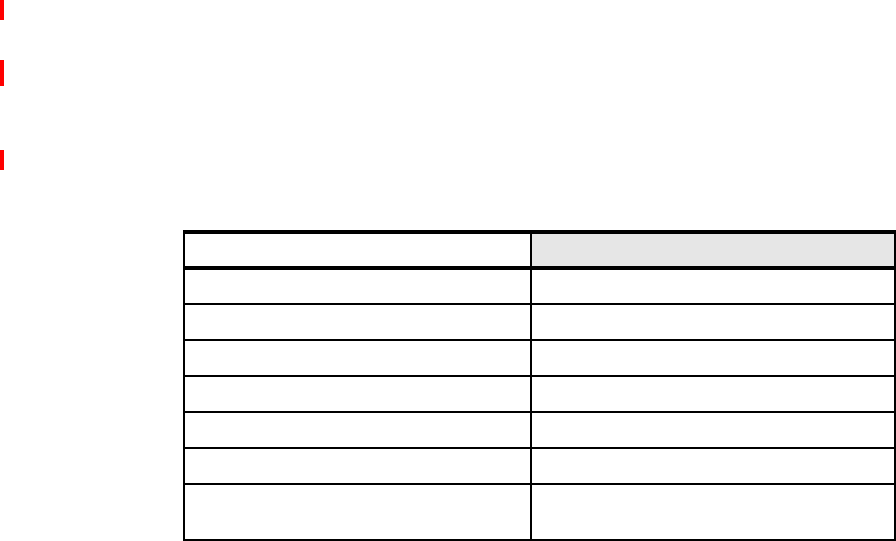
Towers, racks, mirroring packages, high-speed link, and i5/OS on p5 123
#7937 595 Bolt-Down (Low Raised Floor)
The #7937 provides rack ruggedizing and bolt-down hardware for securing a
24-inch rack to a concrete floor beneath a 9.25" to a 11.75" (235mm to 298mm)
raised floor. Installation of this feature helps to secure and protect the rack and its
contents from damage when exposed to vibrations and shocks, such as those in
a seismic event.
#7738 595 Bolt-Down (High-Raised Floor)
The #7938 provides rack ruggedizing and bolt-down hardware for securing a
24-inch rack to a concrete floor beneath a 11.75" to 16.0" (298mm to 405mm)
raised floor. Installation of this feature helps to secure and protect the rack and its
contents from damage when exposed to vibrations and shocks, such as those in
a seismic event.
#7939 595 Bolt-Down (Non-raised floor)
The #7939 provides rack ruggedizing and bolt-down hardware for securing a
24-inch rack to a concrete floor. Installation of this feature helps to secure and
protect the rack and its contents from damage when exposed to vibrations and
shocks, such as those in a seismic event.
EIA units in a rack
The marketing configurator does not manage rack space in the
#0551/#0553/#0554/#0555 racks. Use the following table to determine the
number of EIA units required in the #0551 for each System i5 system unit or
expansion tower.
System unit or expansion tower EIA units
3581- xx3, xx7 5
3581- L28 2
3582 4
3583 14
3590 12
3592 10
Model 270 System Unit 16 EIA units (includes one for #0127, 2 for #0133
and #0137)
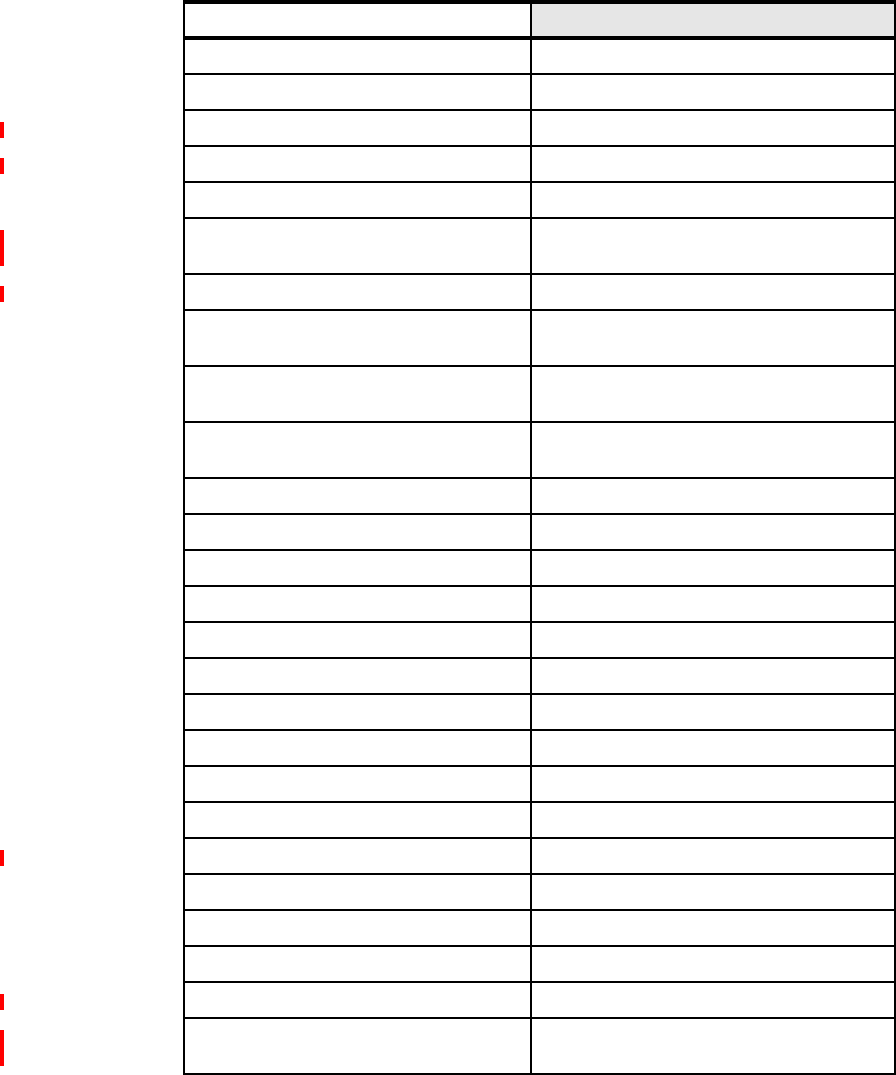
124 i5 Handbook
Model 520 System Unit 4
Model 550 System Unit 4
Model 570 Processor 0/4and 2/4-way 4
Model 570 Processor 4/8 and 5/8-way 8
Model 570 Processor 9/12-way 12
Model 570 Processor 2/16, 8/16 and
13/16-way
16
Model 595 Processor 18 EIA in a 24-inch Enterprise Rack
Model 800 System Unit 16 EIA units (includes 2 EIA for #0133 and
#0137)
Model 810 System Unit 16 EIA units (includes 2 EIA for #0133 and
#0137)
Model 825 System Unit 16 EIA units (includes 2 EIA for #0134 and
#0138)
Model 870 System Unit 17 EIA in a 24-inch Enterprise Rack
Model 890 System Unit 17 EIA in a 24-inch Enterprise Rack
#0551 iSeries Rack 36
#0578 PCI Expansion Unit in Rack 8
#0588 PCI-X Expansion Unit in Rack 8
#5094 PCI-X Expansion Tower 14
#0595 PCI-X Expansion Unit in Rack 5
#5560 MIRROR 35GB Drawer Package 5
#5561 MIRROR 70GB Drawer Package 5
#5790 PCI-X Expansion drawer 4 (two can be mounted side by side)
#6586 Modem Tray for 19-Inch Rack 1
7210-025 External DVD RAM Drive 2 EIA (includes the #8723 rack shelf)
7210-030 External DVD RAM Drive 2 EIA (includes the #8723 rack shelf
7212-102 Tape/Optical Rack Enclosure 1
7307 Dual I/O Unit Enclosure 4
7310-CR2/CR3 Hardware Management
Console
1
System unit or expansion tower EIA units

Towers, racks, mirroring packages, high-speed link, and i5/OS on p5 125
For more information about the EIA units used in a rack or tower, refer to the
following Web site:
http://www-1.ibm.com/servers/eserver/support/iseries/planning/index.html
Mirror disk controller packages
The following packages for bus level, IOP level, or disk level mirroring are offered.
#5555 Mirror 70GB Disk/Controller Package
The #5555 Mirror 70GB Disk/Controller Package provides a disk unit controller (a
#2780 PCI-X Ultra RAID Disk Controller equivalent) and twelve 15k rpm 70 GB
disk units (a #4327 70.56 GB 15k RPM Disk Unit equivalent) for servers doing
mirroring. Either a #0042 Mirrored System IOP Level or #0043 Mirrored System
Bus Level is a prerequisite.
#5556 Mirroring 140 GB Disk/Controller Packagee
The #5556 Mirroring 140 GB Disk/Controller Package provides a disk unit
controller (a #2780 PCI-X Ultra RAID Disk Controller equivalent) and twelve 15k
RPM 141.12 GB disk units (a #4328 141.12 GB 15k RPM Disk Unit equivalent)
for servers doing bus level mirroring. Either a #0042 Mirrored System IOP Level
or #0043 Mirrored System Bus Level is a prerequisite.
#5560 Mirror 35GB Drawer Package
The #5560 Mirror 35GB Drawer Package feature includes one #0595 PCI-X
Expansion Unit in Rack, one Base PCI IOP (#9844 Base PCI IOP), twelve disk
units, #4326 35.16 GB 15k RPM Disk Units and two high-function, large write
cache disk controllers (#2757 PCI-X Ultra RAID Disk Controller or newer) for
servers doing mirroring. The #0040 Mirrored System Disk Level is a prerequisite.
#5561 Mirror 70GB Drawer Package
The #5561 Mirror 70GB Drawer Package feature includes one #0595 PCI-X
Expansion Unit in Rack, one Base PCI IOP (#9844 Base PCI IOP), twelve disk
units (#4327 70.56 GB 15k RPM Disk Units) and two high-function, large write
7311 Dual I/O Unit Enclosure 4
System unit or expansion tower EIA units

126 i5 Handbook
cache disk controllers (a #2757 PCI-X Ultra RAID Disk Controller or newer) for
servers doing mirroring. The #0040 Mirrored System Disk Level is a prerequisite.
#5562 Morror 35 GB Tower Package
The #5562 Morror 35 GB Tower Package feature includes one #5095 PCI-X
Expansion Tower, one Base PCI IOP (#9844 Base PCI IOP), twelve 15k RPM
Disk Units, (#4326 35.16 GB 15k RPM Disk Units) and two high-function, large
write cache disk controllers (#2757 PCI-X Ultra RAID Disk Controller or newer)
for servers doing mirroring. The #0040 Mirrored System Disk Level is a
prerequisite.
#5563 Mirror 70GB Tower Package
The #5563 Mirror 70GB Tower Package feature includes one #5095 PCI-X
Expansion Tower, one Base PCI IOP (#9844 Base PCI IOP), twelve disk units
(#4327 70.56 GB 15k RPM Disk Units) and two high-function, large write cache
disk controllers (#2757 PCI-X Ultra RAID Disk Controller or newer) for servers
doing mirroring. The #0040 Mirrored System Disk Level is a prerequisite.
HSL fabric
HSL loops provide redundancy to all attached towers. In addition, the
implementation of HSL and OS/400 provide data flow balancing across the loop
by assigning communication paths during an initial program load (IPL) to
optimize loop throughput based upon loop and tower configurations.
HSL loops can be either copper or optical. Optical provides longer distance, but
offers a lower data rate.
Considerations for loop configurations include:
Rack mounted Model 520 system units can only attach to HSL-2/RIO-G
cables 2.5m or longer and can only attach to SPCN cables 3m or longer.
Shorter cable lengths do not allow the system unit to be pulled out from the
rack far enough for concurrent maintenance.
The speed allowed by the two nodes of a link with Eserver i5 servers
attached are:
– 1 GB/s for RIO-G to RIO-G
– 500 MB/s for RIO to RIO-G
The HSL bus structure provides:

Towers, racks, mirroring packages, high-speed link, and i5/OS on p5 127
Performance improvements and future system growth
– Up to 1 GB/s technology with HSL or HSL-2 (copper HSL or HSL-2 cables)
– Up to 2 GB/s technology with HSL-2/RIO-G (copper HSL-2 cables) on
Models 520, 550, 570, and 595 up to the10m cable length: Use of the 15m
cables on these loops results in reduced speeds.
You can find the base rules for tower placement in the IBM Eserver iSeries and
AS/400e System Builder, SG24-2155.
Refer to the following publications for an explanation of HSL configuration rules
and placement considerations:
IBM Eserver iSeries Migration: A Guide to Upgrades and Migrations to
POWER Technology, SG24-7200
This redbook also contains configuration rules for Eserver i5 Models and
towers.
IBM Eserver iSeries Migration: System Migration and Upgrades at V5R1
and V5R2, SG24-6055
This redbook also contains configuration rules for System i5 models and
towers.
High-speed Link Loop Architecture for the IBM Eserver iSeries Server:
OS/400 Version 5 Release 2, REDP-3652
Also refer to the following web sites.
http://publib.boulder.ibm.com/infocenter/eserver/v1r2s/en_US/index.htm
http://www-1.ibm.com/servers/eserver/iseries/ha/pdf/HSL_rules_V5R3.pdf
The following figure shows the HSL connectivity of loops.

128 i5 Handbook
HSL OptiConnect
In system complexes that contain only V5R1 HSL hardware, the HSL
OptiConnect loop implementation consists of loops that may contain up to four
PCI/PCI-X I/O towers and units or external xSeries servers between two System
i5 servers. The same is also true for OS/400 V5R2 scenarios. However, V5R2
allows for three System i5 servers to be connected on an HSL OptiConnect loop.
When there are three System i5 servers on a loop, there cannot be any I/O
towers or external xSeries servers on that loop.
In an HSL OptiConnect loop, external xSeries servers count against the per loop
tower limits. Depending on the number of towers and I/O operations performed in
these towers, overall system performance may be impacted.
HSL loops
System i5 models have HSL-2/RIO-G ports to serve loops at a maximum speed
of 2 GB per second. Only a limited number of towers can be enabled for this
higher speed.
i5 Server
HSL Loop
Switchable
Tow er (IASP)
PCI Expansion
Tow er
xSeries for
iSeries
i5 Server
Note: HSL-2 also supports HSL towers (such as #5074 or #5079) in the loop.
However, mixing these towers with HSL-2 in the same loop slows down faster
devices.

Towers, racks, mirroring packages, high-speed link, and i5/OS on p5 129
The following table identifies the HSL loop maximums.
You should see comparable performance due to the high bandwidth of HSL,
whether using copper or optical HSL, even though optical runs at a slower speed.
However, some performance degradation is possible with optical HSL for
intensive I/O bandwidth requirements (for example, large system data mining).
Use less than the allowed maximum number of I/O towers on an optical HSL loop
to optimize performance.
System maximums 520 550 570 595 800 810 825 870 890
HSL loops 1 2 8 31 1 13814
HSL loops supporting fiber optic
cables
01424002612
I/O units 6 1248961 4 184747
Integrated xSeries Adapter cards in
xSeries towers
8 1657573 7 186060
I/O units and Integrated xSeries
Adapter cards
9 1860604 8 276060
HSL OptiConnect loops 1 2 8 24 1 12713
HSL migration tower 000000000
HSL loop maximums
I/O units 666614666
Integrated xSeries Adapter cards in
xSeries towers
8888378
188
I/O units and Integrated xSeries
Adapter cards
999948999
HSL OptiConnect loop: Two systems
I/O units and Integrated xSeries
Adapter cards
444444444
HSL OptiConnect loop: Three systems
I/O units and Integrated xSeries
Adapter cards
0000N/AN/A000
Notes: I/O unit maximums do not include the base I/O tower attached to Models 840, 870, and 890. An I/O unit
contains two HSL ports (0 and 1). The #5079 and #5294 I/O towers have two I/O units.
1 Model 825: Maximum of five Integrated xSeries Adapters on loops A and C. Maximum on loop B is eight.
2 Models 830 and 840: Maximum of eight Integrated xSeries Adapters. Limit on first loop is one, 0 if with migration
tower.
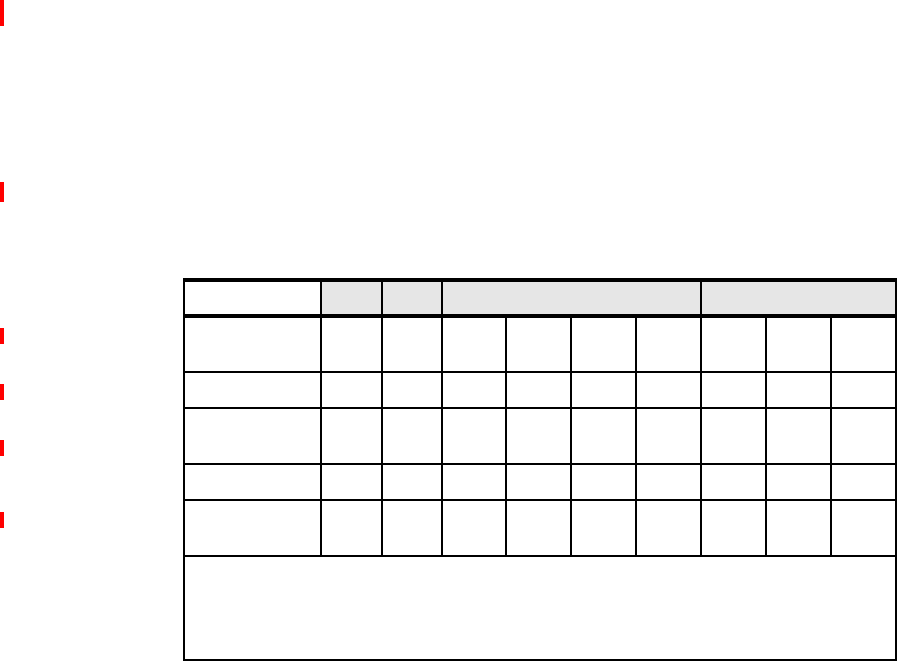
130 i5 Handbook
eServer i5 Models 520, 550, 570, and 595 tower and drawer support
This section identifies the towers and drawers supported on Eserver i5 Models
520, 550, 570, and 595. The following table assumes the maximum number of
processor features to support the maximum number of loops. The maximum
number of towers may be less on other processor features supporting a lower
maximum number of loops.
A base I/O tower, where applicable to a model is included in these maximum
values.
Tower/drawer 520 550 570 595
Number of
loops
12246871531
Towers 6 121224364836
** 72** 96**
IXA
(1519-100/200)
8 1616324857485757
7040-61D*000000444
Combined
totals
9 181836546036
** 72** 96*
* AIX and Linux partition only. Available for the purpose of consolidating existing Eserver p5
servers. The Eserver i5 and iSeries Marketing Configurator does not support the configuration
of these towers.
**Includes the primary I/O tower

Towers, racks, mirroring packages, high-speed link, and i5/OS on p5 131
IBM i5/OS on eServer p5
Eserver p5 enables clients to run relatively large AIX 5L workloads along side a
small amount of i5/OS workload. Many Eserver p5 I/O components are different
from Eserver i5 I/O components. For example, i5/OS uses an IOP, and disk
drives on Eserver i5 models are formatted differently and have additional
function than disk drives on Eserver p5 servers. The i5/OS V5R3 operating
system, for Eserver i5, runs on Eserver p5 servers to support Eserver i5 I/O.
Each Eserver p5 partition acts as a separate i5/OS server.
i5/OS support on Eserver p5 servers is facilitated through the use of a
9411-100 Eserver p5 I/O subsystem for i5/OS. The 9411-100 allows clients
who use the Eserver p5 model to consolidate i5/OS workloads onto their
server. The 9411-100 is ordered for each Eserver p5 server running i5/OS to
facilitate hardware feature orders for the I5/OS partitions.
The i5/OS operating system that runs on Eserver p5 servers is the same as
i5/OS that runs on Eserver i5 servers. Since the Eserver i5 and Eserver p5
are built with the same POWER5 processors and server technology, i5/OS
applications that run on Eserver i5 can run on Eserver p5 unchanged.
For a list of ISV applications that are available on i5/OS see:
http://www-1.ibm.com/servers/eserver/iseries/solutions/v5r3ready/
9411-100 eServer p5 I/O Subsystem for i5/OS
The 9411-100 Eserver p5 I/O Subsystem for i5/OS provides a machine type
and model with prices, warranty, and service identical to that provided for the
same I/O features on a Eserver i5 model. The 9411-100 i5/OS I/O is basically
an administrative holder of Eserver i5 I/O that is attached to Eserver p5.
The 9411-100 is the structure under which the 5250 OTLP capability is ordered.
Like the System i5, each Enterprise Enablement feature provides one processor
authorization of 5250 Online Transaction Processing (OLTP) capacity.
There is a maximum of one 9411-100 for each Eserver p5 server. A unique
9411-100 serial number is associated with a specific Eserver p5 server and
stays with that server. It cannot be transferred to a different Eserver p5 serial
number. All the I/O features associated with the 9411-100, with the exception of
Note: From an IBM marketing configurator view, i5/OS support on the
Eserver p5 is like having a machine type for a subsystem. Each tower,
drawer, adapter, and DASD is a feature of the subsystem machine type.

132 i5 Handbook
the Enterprise Enablement feature, may be transferred to another 9411-100
associated with a different Eserver p5 server.
The 9411-100 uses the same hardware feature codes as used for the 9406
Eserver i5 machine type. If a Eserver p5 client has all the System i5 I/O they
need, the 9411-100 starts as an empty model. The IBM administrative system
transfers the existing Eserver i5 I/O features into this 9411-100. New Eserver
i5 I/O features are ordered against the 9411.
The 9411-100 provides the I/O for any i5/OS partitions running on a 1.65 GHz
Eserver p5 570, 590, or 595 server. Specifically, the 9411-100 is supported on
the following Eserver p5 models:
The 1.65 GHz 9117 570 supports one processor worth of i5/OS workload.
The 1.65 GHz 9119 590 and 595 supports up to two processors worth of
i5/OS workload.
The I/O maximums for a 9411 are consistent with an Eserver i5 Model 570:
270 disk drives
19 TB disk storage
18 Integrated xSeries Servers
Eight Integrated xSeries Adapters
84 PCI slots
– 192 communication lines
– 36 LAN ports
– 48 twinax controllers
12 internal DVD/CD/tape drives
The minimum configuration for a 9411-100 is:
One IOP in an System i5 I/O tower or drawer
One disk controller for a load source drive
For more information, see iSeries planning in the Information Center at:
http://www.ibm.com/eserver/iseries/infocenter
When you reach this site, select Language → V5R3 → Planning.
1519-100, 1519-200 Integrated xSeries Adapter for
iSeries (direct attach)
The IBM Integrated xSeries Adapter for iSeries provides a direct high-speed
attachment (HSL) of an xSeries server to an System i5 server and installs in
select xSeries servers. The Integrated xSeries Adapter extends System i5

Towers, racks, mirroring packages, high-speed link, and i5/OS on p5 133
integration with Windows 2000, Windows Server 2003, Linux RedHat Enterprise
3 (AS or ES) and SUSE LINUX Enterprise Server 8 to xSeries high performance
n-way Intel architecture servers. With the Integrated xSeries Adapter, more
Windows users and more complex Windows and Linux applications can be
integrated with iSeries servers.
There are two models of the Integrated xSeries Adapter, 1519-100 and
1519-200. These two Integrated xSeries Adapter models provide the same
function, but they are designed to work with different xSeries models. The
1519-100 plugs into selected 3U, 4U, 5U n-way xSeries servers. The 1519-200
plugs into rack-optimized (2U) xSeries x236 and x346 servers. Make sure you
use the Integrated xSeries Adapter model that is designed to work with your
choice of xSeries server.
The direct attach server consists of an xSeries server tower that contains a 1519
Model 100 or 200 Integrated xSeries Adapter for iSeries. The System i5 servers
and features require OS/400 V5R2 or i5/OS V5R3. The iSeries Integration for
Windows Server licensed program 5722-WSV provides the necessary software
and device drivers that enable Windows Server to run on the Integrated xSeries
Adapter server. 5722-WSV is included with all i5/OS shipments. Refer to page
547 for iSeries Windows integration and Microsoft Cluster Support.
The external xSeries server attaches to System i5 models via a copper HSL.
Optical HSL is not supported.
The number of Integrated xSeries Servers and Integrated xSeries Adapters that
can be attached varies by model, HSL loops, and number of I/O towers. Refer to
the xSeries servers maximums table on page 129 for the maximum external
xSeries servers by model.
Refer to the HSL system maximums table on page 129 for the maximum external
xSeries servers per HSL loop on each System i5 model.
See “#4711/#4812/#4813/#9812/#9813 PCI Integrated xSeries Server” on
page 275 for information regarding Integrated xSeries Server.
You can find additional information about PTF requirements for the Integrated
xSeries Adapter on the Web at:
http://www-912.ibm.com/e_dir/eServerPrereq.nsf
For xSeries server requirements, supported models, and Windows integration,
go to:
http://www-1.ibm.com/servers/eserver/iseries/integratedxseries/windows/

© Copyright IBM Corp. 1997 - 2006. All rights reserved. 135
Chapter 11. System i5 I/O adapters and
controllers
There are three categories of PCI adapters (IOA) for the System i5.
Traditional adapters are IOP-based and must be driven by an I/O processor.
Single-mode adapters do not require an IOP. As of 31 January 2006, only the
#5707/#5706 PCI-X 1Gbps Ethernet-TX IOA and the #4806 PCI-X Crypto
Coprocessor are in this single-mode category.
Dual-mode adapters can function with or without an IOP. The operational
mode of these enhanced controllers/adapters is determined by their location
relative to an IOP.
IBM plans to continue expanding on the new IOA capabilities of POWER5 and
later systems. Moving the IOP function mostly into the I/O adapter/controller and
to a much lesser degree, the main processor, provides several benefits. It frees
up a PCI slot, saves the cost of an IOP and increases configuration flexibility,
especially for multiple i5/OS partition environments.
This chapter discusses input/output adapters (IOA) that are available from IBM
for System i5 Peripheral Component Interconnect (PCI) system units and
associated PCI towers. Refer to Chapter 20, “System i5 PCI and PCI-X I/O
processors” on page 271, for input/output processor (IOP) information.
11

136 i5 Handbook
Communication restrictions for Peripheral Component Interconnect (PCI)
systems are defined in the “LAN/WAN adapters” section of the model chapters in
the IBM Eserver iSeries and AS/400e System Builder, SG24-2155. You can find
rules for individual communication cards (adapters or IOPs) and sizing rules in
the specific adapter or IOP feature description within each model chapter of the
System Builder. For general communications performance considerations, refer
to the online document iSeries Performance Capabilities Reference, SC41-0607.
PCI card placement rules
There are two sets of rules that govern the placement of PCI cards in the System
i5 servers:
Hard rules: Impose restrictions on the type of card, size, and valid slot
placement. Hard rules are taken into account by the IBM marketing
configurator.
Soft rules: Impose restrictions based on possible performance bottlenecks
associated with certain configuration and use. Soft rules depend on the use of
the cards and required performance and, therefore, are not supported by the
marketing configurator and must be taken into account separately.
For a complete explanation of both hard and soft rules, as well the types of cards
and slots supported on each system, refer to PCI Card Placement Rules for the
IBM Eserver iSeries Server Version 5 Release 2, REDP-3638, before you
propose any configuration. Rules and placement information are also explained
in the IBM Eserver Hardware Information Center in the How to install an
Adapter topic at:
http://publib.boulder.ibm.com/infocenter/eserver/v1r2s/en_US/index.htm?info/
iphak/howtodecide.htm
PCI adapters are Customer Install Features. Refer to IBM Eserver iSeries and
AS/400e System Builder, SG24-2155, for a list of CIF features for current System
i5 models.
AIX and Linux Direct Attach features overview
The following IOA features are supported without IOPs when an AIX or Linux
partition is defined. To determine which features are customer installable, refer to
IBM Eserver iSeries and AS/400e System Builder, SG24-2155. The features
supported are determined by the operating system selected.
For current details about AIX and Linux features supported in System i5 servers,
see:
http://www.ibm.com/servers/eserver/iseries/aix/pdf/facts_features.pdf

System i5 I/O adapters and controllers 137
http://www.ibm.com/servers/eserver/linux/power/hardware/linux_facts.pdf
Feature code AIX5RedHat6SLES 97System i5
equivalent
#0601 Direct Attach #2743 PCI 1 Gbps Ethernet IOA X X #2743
#0602 Direct Attach #2760 PCI 1 Gbps Ethernet UTP IOA X X #2760
#0603 Direct Attach #2744 PCI 100 Mbps Token-Ring IOA X X #2744
#0607 Direct Attach #4838 PCI 100/10 Mbps Ethernet IOA X X #4838
#0608 Direct Attach #4745 PCI WAN IOA X X #4745
#0609 Direct Attach #2772 PCI Dual WAN/Modem IOA X X #2772
#0610 Direct Attach #2773 PCI Dual WAN/ModemIOA X X #2773
#0611 Direct Attach #2765 PCI Fibre Channel Tape Controller X X X #2765
#0612 Direct Attach #2766 PCI Fibre Channel Disk Controller X X #2766
#0613 Direct Attach #2742 PCI 2-Line WAN IOA X X #2742
#0614 Direct Attach #2793 PCI 2-Line WAN w/Modem X X #2793
#0615 Direct Attach #2794 PCI 2-Line WAN w/Modem X X #2794
#0616 Direct Attach #2805 PCI Quad Modem IOA X X #2805
#0617 Direct Attach #2806 PCI Quad Modem (CIM) X X #2806
#0618 Direct Attach #2757 PCI-X Ultra RAID Disk Controller X X #2757
#0619 Direct Attach #2782 PCI-X RAID Disk Unit Controller X X #2782
#0620 Direct Attach #5700 PCI 1 Gbps Ethernet IOA X X X #5700/
#6800
#0621 Direct Attach #5701 PCI 1 Gbps Ethernet UTP IOA X X X #5701/
#6801
#0623 Direct Attach #2849 PCI 100/10 Mbps Ethernet IOA X X #2849
#0624 Direct Attach #5702 PCI-X Ultra Tape Controller X X #5702
#0625 Direct Attach #5704 PCI-X Fibre Channel Tape
Controller
X X X #5704
#0626 Direct Attach #2787 PCI-X Fibre Channel Disk Controller X X #2787
#0627 Direct Attach #2780 PCI-X Ultra4 RAID Disk Controller X X X #2780
#0628 Direct Attach #5703 PCI-X RAID Disk Unit Controller X X X #5703

138 i5 Handbook
#0632 - PCI USB 2.0 Adapter XXXNone
#0633 - Graphics Adapter XXXNone
#0634 128-port ASYNC Adapter XNone
#0635 - SDLC/X.25 - 2-port Adapter X None
#0637 - 100/10 Mbps 4-port Ethernet Adapter X(3,4) X X None
#0638 - SSA (40 MB/s) Adapter X(3,4) None
#0639 - 128MB SSA Adapter Memory X(3,4) None
#0640 - Fast Write Cache Option X(3,4) None
#0642 PCI Ultra-3 RAID Adapter X(1,2,3) None
#0643 Direct Attach #5706 PCI-X Gbps Ethernet-TX IOA X X #5706
#0644 Direct Attach #5707 PCI-X 1 Gbps Ethernet-SX IOA X X #5707
#0645 Direct Attach #5712 PCI-X Tape/DASD Controller X X X #5712
#0646 Direct Attach #5716 2 Gb Fibre Channel PCI-X Adapter X X X #5716
#0647 PCI-X Disk/Tape Controller No IOP X X X #5736
#0648 PCI-X Disk Controller-90MB No IOP X X X #5737
#2848 PCI 2D Entry Graphics Adapter XXXNone
#2732 - PCI Serial HIPPI Adapter X(3,4) None
#2737 - PCI USB 1.1 Adapter X(3,4) X(3,4) X(3,4) None
#2943 - 8-Port ASYNC Adapter X None
#2946 PCI 622 Mbps ATM Fibre Adapter X (3,4) None
#2947 - PCI Multiprotocol Adapter X None
#4953 - 155 Mbps ATM UTP Adapter X(3,4) None
#4957 - 155 Mbps ATM Fiber Adapter X(3,4) None
#4959 - PCI 16/4 Mbps Token-Ring IOA X None
#4960 - Cryptographic Accelerator- X(3,4) None
#4962 - PCI 100/10 Mbps Ethernet IOA XXXNone
#4963 - PCI Crypto Coprocessor X(3,4) None
#5706 PCI-X 1Gbps Ethernet-TX IOA X X X #5706
Feature code AIX5RedHat6SLES 97System i5
equivalent
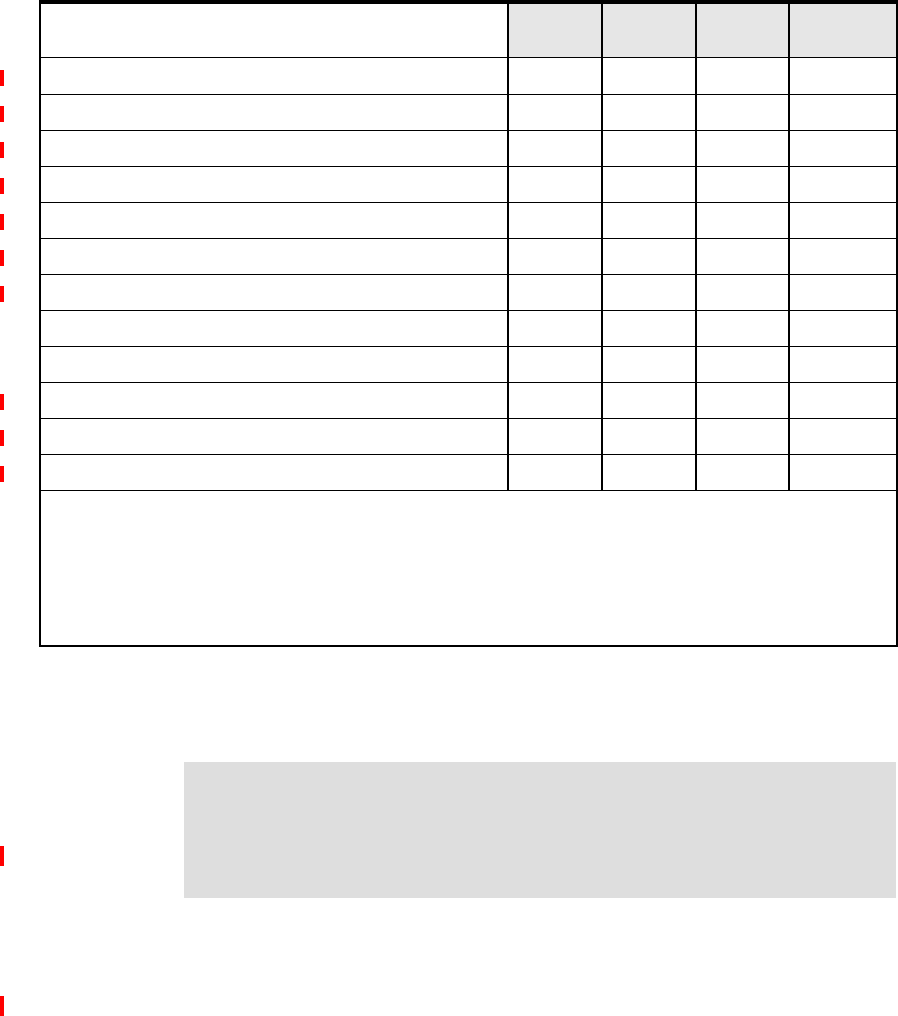
System i5 I/O adapters and controllers 139
Not all features are supported on all models. Some features may be withdrawn
but are in the table for reference. Not all AIX-specific adapters are described in
this book.
System unit hardware (PCI)
System i5 PCI IOAs available from IBM are described in this section. IOAs that
are supported but are now withdrawn from marketing are described in the IBM
Eserver i5, iSeries, and AS/400e System Builder, SG24-2155. Withdrawn
#5707 1 Gbps Ethernet Adapter (Fiber) X X X #5707
#5709 RAID Enabler Card X(1,2) X(1,2) X(1,2) #5709
#5718 10 Gbps Ethernet Adapter (short) X None
#5719 10 Gbps Ethernet Adapter (long) XXXNone
#5723 2-Port EIA-232 Async Adapter XXXNone
#5726 RAID Enabler Card X(3) X(3) X(3) #5726
#5727 Integrated Cache 40MB X X X #5727
#6203 PCI Ultra3 SCSI Adapter X(3,4) X(3,4) X(3,4) None
#6204 Differential SCSI Adapter XXXNone
#6312 Quad Digital Trunk Adapter X(1,2) None
#8136 Remote Async Node, Rack X None
#8137 RS232 Remote Async Node X None
1 Model 520
2 Model 550
3 Model 570
4 Model 595
5 AIX 5L for POWER V5.2 for IBM Eserver or later
6 Red Hat Enterprise Linux AS for POWER Version 3 with Update 3 or later
7 SUSE LINUX Enterprise Server 9 for POWER or later
Feature code AIX5RedHat6SLES 97System i5
equivalent
Note: The IBM marketing configurator does not add IOPs to #06xx direct
attach features because they are not needed. The #06xx features can be
moved to OS/400 or i5/OS partitions if there is sufficient IOP to support them.
The equivalent System i5 features can be moved to a Linux or AIX partition (if
supported) without the IOP.

140 i5 Handbook
features are identified in “Products and features no longer marketed by IBM” on
page 370.
#0299 MES Conversion Analysis for #5580/#5581 MES
The #0299 MES Conversion Analysis for #5580/#5581 provides additional
ordering and scheduling steps for customers adding an auxiliary write cache IOA
to existing large cache disk controllers. For example, when they are converting a
#2757 PCI-X Ultra RAID Disk Controller or #2780 PCI-X Ultra RAID Disk
Controller to a #5580 #2780 Controller with Auxiliary Write Cache or #5581
#2757 Controller with Auxiliary Write Cache.
For more details on the auxiliary write cache IOA, see:
http://www.itso.ibm.com/redpieces/abstracts/redp4003.html?Open
#2742 Two-Line WAN IOA
The #2742 Two-Line WAN IOA supports up to two multiple protocol
communications ports
#2744 PCI 100 Mbps Token Ring IOA
The #2744 PCI 100 Mbps Token Ring IOA provides a single attachment to a
100 Mbps, 16 Mbps, or 4 Mbps IBM Token Ring network. The feature consists of
an IOA card, internal code, which supplies IEEE 802.5 Media Access Control
(MAC), and IEEE 802.2 Logical Link Control (LCC) functions. The 100/16/4
Token Ring IOA is capable of operating in half or full duplex mode.
#2757 PCI-X Ultra RAID Disk Controller
The #2757 PCI-X Ultra RAID Disk Controller is an Ultra SCSI disk unit controller
with a 757 MB compressed maximum cache that provides RAID-5 protection for
internal disk units. It also supports up to two internal tape devices, CD-ROM, and
DVD units. The #2757 has four Ultra SCSI buses.
The #2757 is not supported in the system unit of Models 520, 550, 570, or 595.
A minimum of three disk units of the same capacity is needed for a valid RAID-5
configuration. A maximum of six arrays is allowed per controller, with a maximum
of 18 disk units allowed per array.

System i5 I/O adapters and controllers 141
#2772 and #2773 PCI Dual WAN/Modem IOA
The #2772 PCI Dual WAN/Modem IOA and #2773 PCI Dual WAN/Modem IOA
are basically the same interface. The #2772 is the non-Complex Impedance
Matching (CIM) version of this card. Both are 2-line WAN adapters, with two
ports (RJ11) supporting V.90 56K Async PPP and FAX applications at data rates
up to 14.4K via internal modems. Connection to the V.90 ports is via a telephone
cable. Neither of these features support remote power on. #1012 Modem
Cable-Africa
#2780 PCI-X Ultra RAID Disk Controller
The #2780 PCI-X Ultra RAID Disk Controller is an Ultra4 (u320) SCSI disk unit
controller with a maximum compressed write cache of 757 MB and a maximum
compressed read cache of 1GB that provides RAID-5 protection for internal disk
units. It also supports up to two internal tape devices, CD-ROM, and DVD units.
The #2780 has four Ultra4 SCSI buses.
The #2780 is not supported in the system unit of the Model 520, 550, 570, or
595. Up to 20 disk units per #2780 are supported in a #5094 PCI-X Expansion
Tower attached to a Model 520, 550, 570, or 595.
A minimum of three disk units of the same capacity is needed for a valid RAID-5
configuration. A maximum of six arrays is allowed per controller, with a maximum
of 18 disk units allowed per array.
#2787 PCI-X Fibre Channel Disk Controller
The #2787 PCI-X Fibre Channel Disk Controller provides Fibre Channel
attachment capability for external disk devices. The #2787 supports
point-to-point and arbitrated loop topologies and has an LC-type cable connector.
Each #2787 is shipped with a wrap connector (part number 05N6767). The
#2787 supports 64-bit, 133MHz PCI-X bus speeds.
The #2787 PCI-X Fibre Channel Disk Controller is the recommended
replacement card for the #2766 PCI Fibre Channel Disk Controller.
#2793/#2794/#9793/#9794 PCI Dual WAN/Modem IOA
The #2793/#2794/#9793/#9794 PCI Dual WAN/Modem IOA cards all provide the
same interface. The #2793/#9793 are offered in all countries (regions) except
Australia and New Zealand, where the #9793/#9794 is offered instead. The
#9793/#9794 are base models.

142 i5 Handbook
The #2793/#9793 is a two-line WAN with Modem adapter and is the non-CIM
version. The #2794/#9794 is the CIM version.
Port 0 is the modem port and supports V.92 56K Async PPP, V.92 data modem,
V.44 data compression, V.34 FAX modem and FAX functions such as ECM and
2D/1D conversion. Port 0 does not provide Sync modem capabilities (SDLC and
Sync PPP). Port 1 is the RVX port and supports multiple communications
protocols.
#2805 and #2806 PCI Quad Modem IOA
The #2805 PCI Quad Modem IOA and #2806 PCI Quad Modem (CIM) are
basically the same interface. The #2805 is the non-CIM version of the card. Both
are 4-line WAN modem adapters, with four RJ-11 ports that support V.92 56K
Async SLIP/PPP and V.34 Fax applications at data rates up to 33.6K via internal
modems. Connection to the V.92 ports is via a telephone cable.
The V.92 functions offer increased throughput for upload operations, improved
V.44 data compression, and shortened modem synchronization periods. The call
waiting and modem-on-hold functions associated with V.92 are not supported.
Remote Power-On via ring-indicator, SDLC, and synchronous PPP are not
supported.
The #2805 and #2806 cards need country (region)-specific telephone cables (a
minimum of one and a maximum of four per card). Feature #2806, the CIM
version, is intended for Australia and New Zealand only. The #2805/#2806
require country (region) certification/homologation.
#2849 10/100 Mbps Ethernet Adapter
The #2849 10/100 Mbps Ethernet Adapter card allows an System i5 server to
attach to standardized 100 Mbps high speed Ethernet LANs and allows
attachment to existing 10 Mbps Ethernet LANs. The adapter comes standard
with an RJ45 connector for attachment to UTP-5 media.
#4745 PCI 2-line WAN IOA
The #4745 PCI 2-line WAN IOA supports up to two multiple protocol
communications ports..
#4746 PCI Twinaxial IOA
The #4746 PCI Twinaxial IOA is an 8-port twinaxial workstation IOA with a
20-foot attachment cable for attaching up to 56 5250-type displays and printers.

System i5 I/O adapters and controllers 143
Each port supports seven attached devices and allows up to 56 attached
addresses of which only 40 can be active. When the attached display supports
address sharing, a maximum of 120 shared sessions is supported.
#4801 PCI Cryptographic Coprocessor
The #4801 PCI Cryptographic Coprocessor is a hardware cryptography solution
based on the IBM 4758-023 card. The #4801 is a half-length PCI card that offers
rich cryptography function, secure storage of cryptographic keys, and triple DES
capability. The Cryptographic Access Provider licensed program (no-charge
5722-AC3) must be installed to set the key length prior to using the adapter.
#4805 PCI Cryptographic Accelerator
The #4805 PCI Cryptographic Accelerator feature provides improved
performance for high transaction rate secure Web applications, which use the
Secure Sockets Layer (SSL) or Transport Layer Security (TLS) protocols.
Establishing SSL/TLS secure Web connections requires very compute intensive
cryptographic processing.
You can use the Cryptographic Accelerator to offload cryptographic processing.
SSL/TLS secure Web connections typically protect information (for example,
credit card number) as it is transferred over the Internet, for example between a
Web browser and a server.
T
#4806 PCI-X Crypto Coprocessor
The #4806 Crypto Coprocessor provides both cryptographic coprocessor and
secure-key cryptographic accelerator functions in a single PCI-X card. The
coprocessor functions are targeted to banking and finance applications. Financial
Note: On new systems from the plant, the #4801 is shipped with the system.
Due to temperature requirements (card temperature must not drop below 5
degrees Fahrenheit (-15 degrees Celsius)), it is not installed.
FIPS: Applications that require a FIPS 140 certified, tamper-resistant module
for storing cryptographic keys or require financial PIN processing should
continue to use the IBM 4758-023 Cryptographic Coprocessor PCI card
(#4801 or #4802).
FIPS 140-1 is a U.S. Government National Institute of Standards &
Technology (NIST) administered standard and certification program for
cryptographic modules.

144 i5 Handbook
PIN processing and Europay, Master Card, Visa (EMV) credit card functions are
provided. EMV is a standard for integrated-chip based credit cards. The
secure-key accelerator functions are targeted to improving the performance of
i5/OS Secure Sockets Layer (SSL) transactions. The #4806 provides the security
and performance required to support eBusiness and emerging digital signature
applications.
The #4806 provides secure storage of cryptographic keys in a tamper-resistant
hardware security module (HSM), which is designed to meet FIPS 140 security
requirements. FIPS 140 is a U.S. Government National Institute of Standards
and Technology (NIST) administered standard and certification program for
cryptographic modules.
The firmware for the #4806 is available on a separately ordered/distributed CD as
the Cryptographic Device Manager (5733-CY1). The #4806 also requires
Cryptographic Access Provider (5722-AC3) to enable data encryption.
The #4806 has country-specific rules.
#4811/#4812/#4813/#9812/#9813 PCI-X Integrated xSeries Server
The #4811, #4812, #4813, #9812, or #9813 PCI-X Integrated xSeries Server
contains an Intel Pentium 2.0 GHz processor with 2 MB integrated L2 cache.
Features #4811, #4812, #4813 are functionally identical but have some physical
differences depending on the model in which they are used.
The #4811 is supported in the 520 system tower. The #4812 is supported in the
550, 595, 800, 810, 825, 870 and 890 system towers and in the #0588, #0595,
#5088, #5095, #5074, #5079, #5094 and #5294 expansion towers. The #4813 is
supported in the 570 system tower and in the #5790 expansion unit.
The #9812 and #9813 are functionally identical to the #4812 and #4813 but are
included in the base with orders for Enterprise Editions on system models 550,
595 and 570
The #4811, #4812, #4813, #9812, or #9813 PCI-X Integrated xSeries Server has
two memory slots and supports up to 2 GB of memory.
The #4811, #4812, #4813, #9812, or #9813 PCI-X Integrated xSeries Server
occupies two PCI slots and requires an IOP #9744, #9844 or #2844 to drive it.
The IBM Eserver Marketing Configurator adds #9744 Base PCI IOP to the
order. The #9744 can be removed from the order to conserve PCI slots. The IOP
may be shared, but only one #4811, #4812, #4813, #9812, or #9813 is permitted
per IOP.

System i5 I/O adapters and controllers 145
The #4811, #4812, #4813, #9812, or #9813 PCI-X Integrated xSeries Server
includes two embedded 1000/100/10 Mbps UTP Ethernet LAN ports for
attachment to IEEE standard 802.3Z high-speed (1 Gbps) Ethernet LANs. The
Ethernet LAN ports may also be used to connect to existing 10 and 100 Mbps
Ethernet LANs by using switches with 10/100/1000 Mbps ports. The adapter
supports UTP CAT 5 or higher media interface and TCP/IP.
i5/OS V5R3 is required to support the Integrated xSeries Server.
The #4811, #4812, #4813, #9812, or #9813 PCI-X Integrated xSeries Server
runs Windows or Linux. The supported versions of Windows are:
Windows Server 2003 Standard, Enterprise and Web Editions
Windows 2000 Server and Windows 2000 Advanced Server Windows 2000
The supported versions of Linux are:
Red Hat Enterprise Linux ES 3
Red Hat Enterprise Linux AS 3
#5580 #2780 Controller with Auxiliary Write Cache
The #5580 #2780 Controller with Auxiliary Write Cache IOA provides a disk
controller with auxiliary write cache to improve cache data redundancy. The
#5580 includes a #2780 PCI-X Ultra RAID Disk Controller and a secondary IOA
with 757MB of auxiliary maximum compressed write cache.
The #2780 and the secondary IOA each require one PCI-X slot and must be
installed together in the same system unit or I/O unit/drawer/tower. The auxiliary
cache card connects to one of the SCSI ports on the #2780 and reduces the
maximum number of disks supported to fifteen.
For more details regarding Auxiliary Write Cache, see Planning for IBM eServer
i5 Data Protection with Auxiliary Write Cache Solutions, REDP-4003 at:
http://www.redbooks.ibm.com/abstracts/redp4003.html?Open
#5581 #2757 Controller with Auxiliary Write Cache
The #5581 #2757 Controller with Auxiliary Write Cache provides a disk
controller with auxiliary write cache to improve cache data redundancy. The
#5581 includes a #2757 PCI-X Ultra RAID Disk Controller and a secondary IOA
with 757 MB of auxiliary maximum compressed write cache.
The #2757 and the secondary IOA each require one PCI-X slot and must be
installed together in the same system unit or I/O unit/drawer/tower. The auxiliary

146 i5 Handbook
cache card connects to one of the SCSI ports on the #2757 and reduces the
maximum number of disks supported to fifteen.
For more details regarding Auxiliary Write Cache, see Planning for IBM eServer
i5 Data Protection with Auxiliary Write Cache Solutions, REDP-4003 at:
#5700 PCI 1 Gbps Ethernet IOA
The #5700 PCI 1 Gbps Ethernet IOA allows attachment to IEEE standard 802.3Z
high-speed (1 Gbps) Ethernet LANs. It can also be used to connect to existing
100 Mbps Ethernet LANs via switches capable of handling multiple speeds with
10 Mbps, 100 Mbps, or 1000 Mbps ports. It cannot be directly attached
(crossover cables are not supported) to 10 Mbps or 100 Mbps networks.
The #5700 supports a multimode fiber interface with a 62.5 micron or 50.0
micron cable requirement. The adapter has a duplex LC fiber optic connector for
attachment to client supplied cabling.
The #5700 adapter supports TCP/IP only. TCP/IP Checksum Offload and TCP
Segmentation Offload are not supported. SNA and IPX protocols are not
supported.
The #5700, #0620, and #6800 are physically the same adapter card but have
different feature numbers that denote to IBM configurator tools whether or not an
IOP is required.
#5701 PCI 1 Gbps Ethernet UTP IOA
The #5701 PCI 1 Gbps Ethernet UTP IOA allows attachment to IEEE standard
802.3Z high-speed (1 Gbps) Ethernet LANs. The #5701 PCI 1 Gbps Ethernet
UTP IOA can negotiate to a lower speed and can directly attach to 10 Mbps or
100 Mbps networks with appropriate switches and hubs. Direct attachment via
crossover cables is not supported. The #5701 adapter supports a UTP CAT 5
media interface.
The #5701 adapter supports TCP/IP only. TCP/IP Checksum Offload and TCP
Segmentation Offload are not supported. SNA and IPX protocols are not
supported.
The #5701, #0621, and #6801 are physically the same adapter card but have
different feature numbers that denote to IBM configurator tools whether or not an
IOP is required.

System i5 I/O adapters and controllers 147
#5702/#5712 PCI-X Tape/DASD Controller
The #5702/#5712 PCI-X Tape/DASD Controller is an Ultra SCSI LVD controller
for attachment of two external tape devices or external CD-ROM devices that
have a Low Voltage Differential (LVD) SCSI interface. The #5702 has two ports
with VHDCI connectors. The #5702 is rated at up to 160MBps and is a good
match for 358x LTO tape drives.
#5703 PCI-X RAID Disk Unit Controller
The #5703 PCI-X RAID Disk Unit Controller is an Ultra3 SCSI controller with a
cache size of 40 MB that provides RAID-5 protection for internal disks and
internal tape units, CD-ROM, DVD-RAM, and DVD-ROM units. The #5703 has
two Ultra3 SCSI buses and runs at a U320 (320 MB/s) data rate.
The #5703 controller supports a maximum of 12 disk units. DASD compression
is not supported. The #5703 can control up to two removable media devices
#5704 PCI-X Fibre Channel Tape Controller
The #5704 PCI-X Fibre Channel Tape Controller provides Fibre Channel
attachment capability for external tape devices. The #5704 supports
point-to-point and arbitrated loop topologies and has an LC-type cable connector.
The #5704 is rated at up to 200 MBps. The highest performing tape drives are
attached via fibre channel.
#5705/#5715 PCI-X Tape/DASD Controller
The #5705/#5715 PCI-X Tape/DASD Controller provides SCSI Ultra PCI
attachment capability for external tape devices, up to two removable media
devices (internal tape, CD-ROM or DVD), and internal disk devices. The #5705
has two SCSI buses, with each bus providing an internal and an external device
port (four ports total: two internal and two external). Each bus can only support
one connection, either an internal DASD connection or internal tape on the
internal port, or an external tape or removable media connection on the external
port.
The internal SCSI DASD port supports up to six disk units. RAID is not
supported.
Note: The #5702 has both internal and external SCSI ports. Devices cannot
be attached both internally and externally on the same bus.

148 i5 Handbook
Order a #5702/#5712 if two external SCSI ports are required.
#5706 PCI-X 1Gbps Ethernet-TX IOA
The #5706 PCI-X 1Gbps Ethernet-TX IOA is a 2-port 1000/100/10 Mbps
Base-TX Ethernet PCI-X Adapter. The #5706 is a full duplex, dual ported, Gigabit
Ethernet adapter designed with highly integrated components. This adapter can
be configured to run each port at 1000, 100, or 10 Mbps data rates. This adapter
interfaces to the system via a PCI or PCI-X bus and connects to a network using
a 4-pair CAT-5 Unshielded Twisted Pair (UTP) cable for distances of up to 100m.
The adapter conforms to the IEEE 802.3ab 1000Base-T standard. The #5706
also supports jumbo frames when running at the 1000 Mbps speed.
The #5706 does not provide i5/OS native SNA support.
The #5706 IOA does not require a PCI IOP. The IOP functions are already
integrated into the IOA.
#5707 1 Gbps Ethernet Adapter (Fiber)
The #5707 1 Gbps Ethernet Adapter (Fiber) is a 2-Port Gigabit Ethernet-SX
PCI-X Adapter that provides two 1 Gbps (1000 Base-SX) full-duplex Ethernet
LAN connections with throughput on a standard shortwave multimode optical
cable that conforms to the IEEE 802.3z standard. The adapter supports
distances of 260m for 62.5 micron Multi Mode Fiber (MMF) and 550m for 50.0
micron MMF.
The #5707 IOA does not require a PCI IOP. The IOP functions are already
integrated into the IOA.
#5709 RAID Enabler Card
The #5709 RAID Enabler Card has 16 MB write cache. It supports up to eight
disk unit positions in the Model 520 and 550 system unit and up to six disk unit
positions in the Model 570 system unit. The #5709 is not supported on the Model
595. The #5709 provides RAID capability to the embedded SCSI controller. It
plugs into its own specific internal slot and does not require or use a PCI card
slot. Hardware disk compression is not supported.
Note: The i5/OS operating system does not have the capability to interface
directly to the embedded SCSI controller. The #5709 communicates solely
with the embedded controller. An IOP must be present for the #5709 to
communicate with the i5/OS operating system.

System i5 I/O adapters and controllers 149
#5719 10 Gbps Ethernet Adapter (long)
The #5719 10 Gbps Ethernet Adapter (long) supports ten Gigabit Ethernet PCI-X
based server connections over a maximum of 10 kilometers of 1310nm
single-mode fiber optic cable. The #5719 conforms to the IEEE 802.3ae
standard. The adapter requires 9um single-mode fiber optic cables and uses a
SC connector type for connecting into network infrastructure components like 10
Gigabit Ethernet switch/router with SC connectors.
#5726 RAID Enabler Card
The #5726 RAID Enabler Card provides a SCSI RAID controller which is
installed into its own specific internal slot of a system unit. It does not require a
PCI slot. The #5726 replaces the base integrated disk controller, adding RAID-5
capability and 40MB disk controller write cache.
#5727 Integrated Cache 40MB
The #5727 provides a card which augments the base integrated disk controller of
the model 520 or the model 550 with 40MB of write cache and also enables
RAID-5 capability for the internal disk drives of the system unit. This feature is
functionally equivalent to #5709, but can run in IOP-less mode. The #5727 is
installed into its own specific internal slot of a system unit and does not require a
PCI slot.
The #9510 is the base feature for this card when it is included in 9405 Express
configurations with RAID.
#5728 Integrated Cache 40MB
The #5728 provides a card which augments the base integrated disk controller in
the model 570 with 40MB of write cache and also enables RAID-5 capability for
the internal disk drives in the processor enclosure. This feature is functionally
equivalent to #5709 and #5726, but can run in an IOP-less mode. The #5728 is
installed into its own specific internal slot of a 570 processor enclosure and does
not require a PCI slot. The #5728 or its #5709/#5726 predecessor is required if
i5/OS is to access the 4th, 5th and 6th disk slots in the processor enclosure.
#5736 PCI-X Disk/Tape Controller with IOP
The #5736 provides a PCI-X Disk/Tape SCSI Controller with zero write cache
and without RAID support. Disk mirroring support is supported through i5/OS. A
maximum of six disk drives are supported on the #5736. Removable media
devices (tape, optical libraries, CD-ROM, DVD-ROM, or DVD-RAM) are also

150 i5 Handbook
supported. The #5736 has two U320 buses each with a bus data rate of up to
320MBs. Each SCSI bus can be either internal (using an internal port) or
external (using an external port), but not both. There are four physical ports on
the #5736, two internal and two external. Internal devices connect to the internal
ports (1 or 2). External devices connect to the external ports (1 or 2) and use an
LVD (Low Voltage Differential) interface and VHDCI connectors. A #1850 VHDCI
to P Converter Cable is available to connect to external devices with type P
connectors.
The #0647, #5736, #5766 and #5775 are physically the same adapter card but
have different feature numbers to indicate to IBM configurator tools that an IOP is
or is not being used in the configuration.
#5736 should be the choice over #5702/#5712 or #5705/#5715 controllers for
systems running V5R3, or later.
#5737 PCI-X Disk Controller 90MB with IOP
Provides a PCI-X SCSI disk controller that has a 90MB write cache and can
provide RAID-5 or RAID-6 protection of disk units. The #5737 has two U320
SCSI buses each with a bus data rate of up to 320MBs. A maximum of 12
internal disk drives and up to two internal removable media devices (tape,
CD-ROM, DVD-ROM, or DVD-RAM) are supported on the #5737.
A minimum of three disk drives are required for RAID-5, providing protection
against a single drive failure in an array. A minimum of four disk drives are
required for RAID-6, providing protection against up to two drives failing in an
array.
#0648, #5737, and #5776 are physically the same adapter card but have different
feature numbers to indicate to IBM configurator tools that an IOP is or is not
being used in the configuration.
Note the #2780/#5580 and #2757/#5581 disk controllers with an effective 757MB
write cache provide greater disk performance and can have an auxiliary write
cache IOA to protect the write cache contents
#5740 1Gbps BaseT Ethernet(4-Port)
The #5740 provides a 4-port 10/100/1000Mbps BaseT Ethernet adapter which
supports four 1-Gigabit ports on a single adapter, delivering increased bandwidth
for slot-constrained servers and providing high connectivity and reliability using
two integrated, dual-port Gigabit Ethernet controllers

System i5 I/O adapters and controllers 151
#5760 PCI-X Fibre Channel Disk Controller
Provides a 4Gbps Single Port Fibre Channel PCI-X 2.0 Adapter which attaches
external DASD devices. #5760 is a 64-bit address/data, short form factor PCI-X
adapter with an LC type external fiber connector that provides single initiator
capability over an optical fiber link or loop. With the use of appropriate optical
fiber cabling, this adapter provides the capability for a network of high-speed
local and remote located storage.
The #5760 will auto-negotiate for the highest data rate between adapter and an
attaching device at 1Gbps, 2Gbps or 4Gbps of which the device or switch is
capable. Distances of up to 500 meters running at 1Gbps data rate and up to 300
meters running at 2Gbps data rate and 4Gbps data rate up to 150 meters are
supported between the adapter and an attaching device or switch. When used
with IBM supported Fibre Channel storage switches supporting long-wave optics,
distances of up to 10 kilometers are capable running at either 1Gbps or 2Gbps or
4Gbps data rates.
The #5760 can be used to attach devices either directly, or by means of Fibre
Channel Switches. The #5760 requires a PCI IOP.
#5761 PCI-X Fibre Channel Tape Controller
Provides a 4Gbps Single Port Fibre Channel PCI-X 2.0 Adapter which attaches
external tape devices. #5761 is a 64-bit address/data, short form factor PCI-X
adapter with an LC type external fiber connector that provides single initiator
capability over an optical fiber link or loop. With the use of appropriate optical
fiber cabling, this adapter provides the capability for a network of high-speed
local and remote located storage.
The #5761 will auto-negotiate for the highest data rate between adapter and an
attaching device at 1Gbps, 2Gbps or 4Gbps of which the device or switch is
capable. Distances of up to 500 meters running at 1Gbps data rate and up to 300
meters running at 2Gbps data rate and 4Gbps data rate up to 150 meters are
supported between the adapter and an attaching device or switch. When used
with IBM supported Fibre Channel storage switches supporting long-wave optics,
distances of up to 10 kilometers are capable running at either 1Gbps or 2Gbps or
4Gbps data rates.
The #5761 can be used to attach devices either directly, or by means of Fibre
Channel Switches.

152 i5 Handbook
#5775 PCI-X Disk/Tape Controller No IOP
The #5775 provides a PCI-X Disk/Tape SCSI Controller with zero write cache
and without RAID support. Disk mirroring is supported through i5/OS. A
maximum of six disk drives are supported on the #5775. Removable media
devices (tape, optical libraries, DVD-ROM, or DVD-RAM) are also supported on
the #5775.
The #5775 has two U320 buses each with a bus data rate of up to 320MBs. Each
SCSI bus can be either internal (using an internal port) or external (using an
external port), but not both. There are four physical ports on the #5775, two
internal and two external.
Internal devices connect to the internal ports (1 or 2). External devices connect
to the external ports (1 or 2) and use an LVD (Low Voltage Differential) interface
and VHDCI connectors. A #1850 VHDCI to P Converter Cable is available to
connect to external devices with type P connectors.
#0647, #5736, #5766 and #5775 are physically the same adapter card but have
different feature numbers to indicate to IBM configurator tools that an IOP is or is
not being used in the configuration.
The #5775 should be the choice over #0624/#0645 or #5705/#5715 controllers. It
requires V5R4 or later except for the Model 520+ with 1.9GHz processors where
V5R3 with V5R3M5 LIC, or later, is required.
#5776 PCI-X Disk Controller 90MB No IOP
The #5776 provides a PCI-X SCSI disk controller that has a 90MB write cache
and can provide RAID-5 or RAID-6 protection of disk units.
The #5776 has two U320 SCSI buses each with a bus data rate of up to 320MBs.
A maximum of 12 internal disk drives and up to two internal removable media
devices (tape, DVD-ROM, or DVD-RAM) are supported on the #5776.
A minimum of three disk drives are required for RAID-5, providing protection
against a single drive failure in an array. A minimum of four disk drives are
required for RAID-6, providing protection against up to two drives failing in an
array.
The #0648, #5737, and #5776 are physically the same adapter card but have
different feature numbers to indicate to IBM configurator tools that an IOP is or is
not being used in the configuration.

System i5 I/O adapters and controllers 153
Note the #2780/#5580 and #2757/#5581 disk controllers with an effective 757MB
write cache provide greater disk performance and can have an auxiliary write
cache IOA to protect the write cache contents.
#6800 PCI 1Gbps Ethernet IOA
The #6800 provides a PCI-X IOA which does not require an IOP and allows a
System i5 to attach to IEEE standard 802.3Z high speed (1Gbps) Ethernet LANs.
The #6800 adapter supports a multimode fiber interface with a 62.5 micron or
50.0 micron cable requirement. The adapter has a duplex LC fiber-optic
connector for attachment to customer-supplied cabling.
The #6800 only supports TCP/IP and requires an intervening switch/hub/router
when connecting to 100Mbps or 10Mbps networks.
The #6800, #0620, and #5700 are physically the same adapter card but have
different feature numbers that denote to IBM configurator tools whether or not an
IOP is required.
#6801 PCI 1Gbps Ethernet UTP IOA
The #6801 provides a PCI-X IOA which does not require an IOP and allows a
System i5 to attach to IEEE standard 802.3ab high speed (1Gbps) Ethernet
LANs. The adapter supports a UTP CAT 5 media interface.
The #6801 only supports TCP/IP and requires an intervening switch/hub/router
when connecting to 100Mbps or 10Mbps networks.
The #6801, #0621, and #5701 are physically the same adapter card but have
different feature numbers that denote to IBM configurator tools whether or not an
IOP is required.
#6803 PCI WAN for ECS
The #6803 is a WAN w/modem adapter which provides connectivity for IBM
Electronic Customer Support (ECS) only. This feature is the non-CIM (Complex
Impedance Matching) version offered in all countries except Australia and New
Zealand. The #6803 is functionally equivalent to #0614/#2793/#9793, but #6803
indicates to IBM configurator tools that the IOA is being used by i5/OS in an
IOP-less mode. When in IOP-less mode the adapter function is restricted to
communicating to IBM ECS on port 0 (modem port). Port 1 is the RVX port and is
not supported in an IOP-less mode.

154 i5 Handbook
Port 0 supports V.92 56K PPP, V.92 data modem and V.44 data compression.
Port 0 does not provide Synchronous modem capabilities (SDLC and
Synchronous PPP).
#6804 PCI WAN for ECS (CIM)
The #6804 is a WAN w/modem adapter which provides connectivity for IBM
Electronic Customer Support (ECS) only. This feature is the CIM (Complex
Impedance Matching) version offered in Australia and New Zealand. The #6804
is functionally equivalent to #0615/#2794/#9794, but #6804 indicates to IBM
configurator tools that the IOA is being used by i5/OS in an IOP-less mode.
When in IOP-less mode the adapter function is restricted to communicating to
IBM ECS on port 0 (modem port). Port 1 is the RVX port and is not supported in
IOP-less mode.
Port 0 supports V.92 56K PPP, V.92 data modem and V.44 data compression.
Port 0 does not provide Synchronous modem capabilities (SDLC and
Synchronous PPP).
#9493/#9494 Base PCI WAN for ECS (CIM)
The #9493 is a WAN w/modem adapter which provides connectivity for IBM
Electronic Customer Support (ECS) only. This feature is the non-CIM (Complex
Impedance Matching) version offered in all countries except Australia and New
Zealand. #9493 is functionally equivalent to #0614/#2793/#9793, but #9493
indicates to IBM configurator tools that the IOA is being used by i5/OS in an
IOP-less mode. When in IOP-less mode the adapter function is restricted to
communicating to IBM ECS on port 0 (modem port). Port 1 is the RVX port and is
not supported in an IOP-less mode.
Port 0 supports V.92 56K PPP, V.92 data modem and V.44 data compression.
Port 0 does not provide Synchronous modem capabilities (SDLC and
Synchronous PPP).
The #9494is the CIM (Complex Impedance Matching) version offered in Australia
and New Zealand. #9494 is functionally equivalent to #0615/#2794/#9794, but
#9494 indicates to IBM configurator tools that the IOA is being used by i5/OS in
an IOP-less mode.

© Copyright IBM Corp. 1997 - 2006. All rights reserved. 155
Chapter 12. Upgrades to IBM System i5
and i5/OS V5R4
Use the IBM Prerequisite tool to find compatibility information for hardware and
software features for IBM System i5 520, 550, 570, and 595 processors. Find this
tool at:
http://www-912.ibm.com/e_dir/eServerPrereq.nsf
The term upgrade in this chapter refers to a change or enhancement to an
existing server, which can result in a more powerful server, but has the same
machine type and serial number. An extensive set of upgrades to System i5
servers is supported both to a different model and within an existing model.
The following table shows an overview of the supported upgrades between and
within System i5 models.
12
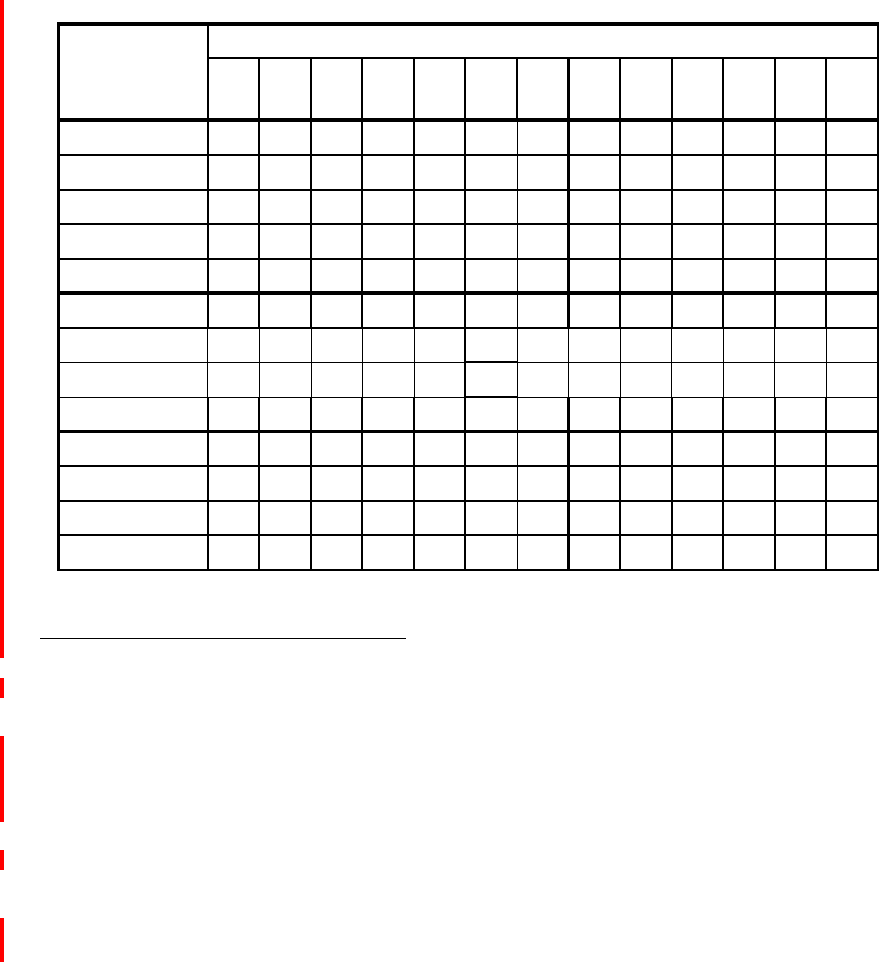
156 i5 Handbook
Upgrade considerations
Supported model upgrades for System i5 models are identified in the Upgrade
topic of the Find and Compare Tool (FACT) at:
http://www-919.ibm.com/servers/eserver/fact/
Refer to “Planning information” on page 41 and “Withdrawn products and
end-of-support” on page 42 to understand upgrade considerations. Refer to IBM
Eserver iSeries Migration: A Guide to Upgrades and Migrations to POWER
Te c h n o l o gy, SG24-7200, for guidance about upgrading to eServer i5 server
models.
For software upgrade considerations, see “Supported software upgrade paths”
on page 158, and “” on page 159. For considerations when upgrading to i5/OS
V5R3, see:
http://www-1.ibm.com/servers/eserver/iseries/support/planning/v5r3software.html
From model
To model
520
520+
550
550+
570
570+
595
595+
800
810
825
870
890
Model 520 33
Model 520 + 3
Model 550 33
Model 550 + 3
Model 570 333
Model 570 + 33
Model 595 33
Model 595+ 3
Model 800 3
Model 810 333333 3
Model 825 33333 33
Model 870 3333 33
Model 890 3333 3

Upgrades to IBM System i5 and i5/OS V5R4 157
For considerations when upgrading to OS/400 V5R2, see:
http://www-1.ibm.com/servers/eserver/iseries/support/planning/v5r2software.html
5250 OLTP considerations
iSeries 5250 online transaction processing (OLTP) is a powerful, efficient, and
reliable transaction processor that is used by many clients. A maximum 5250
CPW is offered if upgrading to the Model s520, 550, 570, 595 with an Enterprise
Edition. The server’s entire resources are available for 5250 OLTP applications if
desired. The High Availability and Capacity BackUp Editions also provide
maximum 5250 CPW.
A Model 520, 550, 570, 595, with a Standard Edition has zero 5250 commercial
processing workload (CPW). The maximum 5250 CPW is available with an
upgrade from a Standard to Enterprise Edition. Many additional software,
hardware, services, and education components are included in the Enterprise
Edition. However, the additional components are not included during a Standard
Edition upgrade to an Enterprise Edition.
You can find further information about 5250 CPW in Chapter 3, “Workload,
capacity, and performance” on page 27.
Main storage features of
one model typically
cannot be used in a
different model.
However, some Model
810 and 825 main
storage features can be
used in the Model 520,
550, or 570 if quad rules
for these systems are
fulfilled.
Some features
supported on earlier
models cannot be
ordered on the
Eserver i5 Models
520, 550, 570, 595, and
iSeries Models 800,
810, 825, 870, or 890.
840
890
825
800
Yes
No
No
No
No
520 Std/Ent
520 Value
550
570
820
No
No
810
Yes
Yes
No
No
Memory Reuse
595
No
830
No
No
No
No
No
870

158 i5 Handbook
When upgrading existing I/O towers (see the following figure):
Supported model upgrades for System i5 models are identified in the Upgrade
topic of the Find and Compare Tool (FACT) at:
http://www-919.ibm.com/servers/eserver/fact/
Refer to IBM Eserver iSeries Migration: System Migration and Upgrades at
V5R1 and V5R2, SG24-6055, and IBM Eserver iSeries Migration: A Guide to
Upgrades and Migrations to POWER Technology, SG24-7200, for a full
explanation of migration considerations.
Supported software upgrade paths
The following table identifies software upgrade paths supported for i5/OS and
OS/400.
X
SPD I/O
I/O Tower/Drawer Migration
X
X#5078/#0578 PCI
IXA
#5079/#5074
PCI #5095/#0595 PCI-X
#5075 PCI
#5294/#5094
PCI-X
#5088/#0588 PCI-X
To:
From OS/400:
OS/400
V5R1
OS/400
V5R2
i5/OS
V5R3
V3R2
V4R1
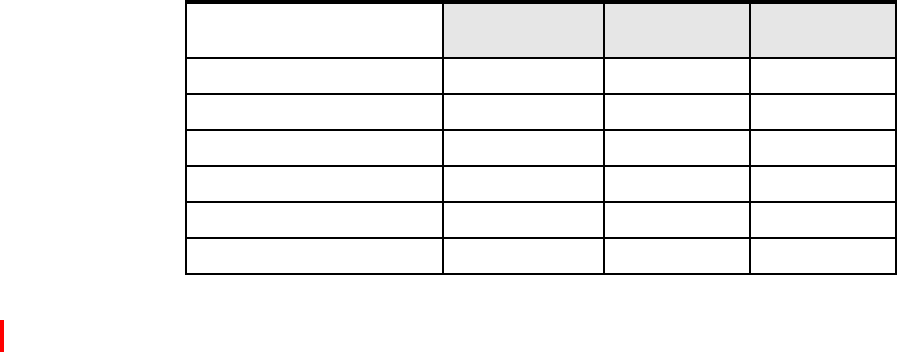
Upgrades to IBM System i5 and i5/OS V5R4 159
V4R2
V4R3
V4R4 X
V4R5 X X
V5R1 X X
V5R2 X
To:
From OS/400:
OS/400
V5R1
OS/400
V5R2
i5/OS
V5R3
160 i5 Handbook

© Copyright IBM Corp. 1997 - 2006. All rights reserved. 161
Chapter 13. Internal storage
Storage on the System i5 is more than just disk drives. It is also about data
protection, ease of use, low cost and low maintenance. The IBM System i5 offers
many options for integrated disks and tape drives.
Integrated disks offer automated and optimized performance, which can extend
SAN-like storage virtualization to multiple operating environments enabled on the
System i5. Internal tape choices are provided as low-cost, convenient options for
data backup and exchange with other i5 systems.
This chapter highlights the disk, tape, CD-ROM, DVD-ROM and DVD-RAM
storage devices internal to the system unit or tower complex. It identifies
specifications such as speed and capacities, with brief descriptions of the
features and data protection methods, as well as alternate initial program load
(IPL) options.
Data protection and hardware compression
This section introduces the functions that can be used to protect the data stored
on System i5 disk drives.
13

D
ev
i
ce par
it
y pro
t
ec
ti
on
Device parity protection is a hardware function that protects data from being lost because of a
disk unit failure or damage to a disk. Calculating and saving a parity value for each bit of data
protects data. Conceptually, the parity value is computed from the data at the same location
on each of the other disk units in the device parity set. When a disk failure occurs, the data on
the failing unit can be reconstructed by using the saved parity value and the values of the bits
in the same locations on the other disk.
Device parity protection is a high-availability function. It allows the IBM System i5 to continue
to operate when a disk failure has occurred. RAID-5 and RAID-6 are the two levels of device
parity protection available. They require disk controllers that support these functions.
RAID-5
RAID-5 protects against the failure of a single disk unit. Logically, the capacity of one disk unit
is dedicated to storing parity data in a parity set. In practice, the parity data is spread among
multiple disk units depending upon the number of disk units in the parity set and the level of
the disk controller. Internal disk units of different technology (that is, different feature
numbers), but of the same capacity, can be RAID-5 protected.
RAID-6
RAID-6 protects against the failure of two disk units. Logically, the capacity of two disk units is
dedicated to storing parity data. In practice, the parity data is spread among multiple disk
units. The minimum number of disk units in a parity set is four and the maximum is eighteen.
When a RAID-6 parity set is started, all the disk units contain parity data.
Mirroring
Mirrored protection is a function that increases the availability of IBM System i5 servers in the
event of a failure of a disk-related hardware component. Mirroring protection is a function of
the i5/OS operating system.
Different levels of mirrored protection are possible, depending on the hardware that is
duplicated. Mirroring involves duplicating disk-related hardware (bus, IOP, disk device). When
a disk-related mirrored component fails, the system remains available.
Cross-site mirroring
Geographic mirroring provides the ability to replicate changes made to the production copy of
an independent auxiliary storage pool (IASP) to a mirror copy of that IASP. As data is written
to the production copy of an IASP, the operating system mirrors that data to a second copy of
the IASP through another System i5. This process keeps multiple identical copies of the data.
Number of units in the array Number of units parity is spread across
32
4 - 7 4
8 - 15 8
16 - 18 16

C
ross-s
it
e m
i
rror
i
ng
(XSM)
, com
bi
ne
d
w
ith
th
e geograp
hi
c m
i
rror
i
ng
f
unc
ti
on, ena
bl
es you
t
o
mirror data on disks at sites that can be separated by a significant geographic distance. This
technology can be used to extend the functionality of a device cluster resource group (CRG)
beyond the limits of physical component connection.
Integrated hardware disk compression
Data is dynamically compressed or uncompressed by the disk controller as data is written to
and read from disk. Disk compression does not affect CPU utilization since compression is
performed by the disk controller.
The compression ratio results of disk DASD varies. The compression ratio achieved and the
impact on DASD performance depends on the data and how it is accessed. Compression is
limited to user auxiliary storage pools (ASPs).
Internal disk storage
This section summarizes information for the Peripheral Component Interconnect (PCI) disk
features supported by the System i5. The following table identifies the system and expansion
units that each disk drive is supported in, and specifications of each internal drive type such
as RAID and mirror support, the number of bytes, and the minimum operating system level
required.
PCI internal disks System and expansion units
supported
RAID/Mirror1
Minimum operating
system level
(OS/400)2
Feature description
Bytes
520
550
570
595
800
810
825
870
890
#5074
#5075
#5079
#5094
#5095
#5294
#4317 8.58 GB 10k RPM Disk Unit32S S S S G/7 V4R5
#4318 17.54 GB 10k RPM Disk Unit42S S S S H/8 V4R5
#4319 35.16 GB 10k RPM Disk Unit 2 S S S S J/9 V5R1
#4326 35.16 GB 15k RPM Disk Unit 2 N N - N J/9 V5R2
#4327 70.56 GB 15k RPM Disk Unit 2 N N - N K/10 V5R2
#4328 141.12 GB 15k RPM Disk Unit 2 N - - N V5R3
#6817 8.58 GB 10k RPM Disk Unit 2 R R R R D/7 V4R5
#6818 17.54 GB 10k RPM Disk Unit 2 R R R R E/8 V4R5
#8817 8.58 GB Optional Base Two-byte Disk Unit 10k RPM 2 R R R R D/7 V4R5
#8818 17.54 GB Optional Base Two-byte Disk Unit 10k
RPM
2R R R R E/8 V4R5
#8917 8.58 GB Optional Base 10k RPM Disk Unit 2 R R R R D/7 V4R5
#8918 17.54 GB Optional Base 10k RPM Disk Unit 2 R R R R E/8 V4R5
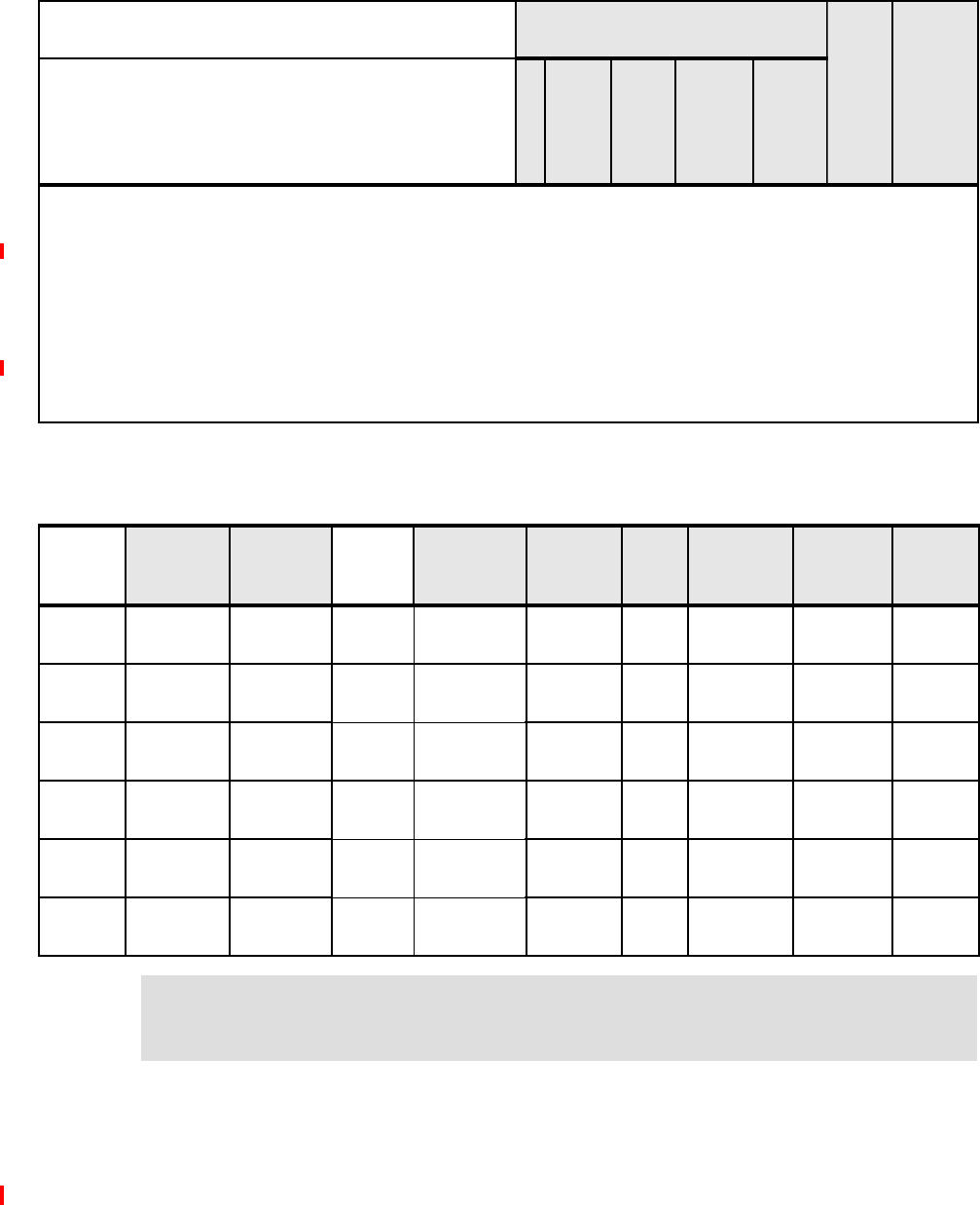
The following table shows the specifications of the current IBM internal disk technologies
supported on the System i5.
Internal tape, CD-ROM, DVD-RAM, and DVD-ROM
Internal tape for the System i5 is available in several different formats such as quarter inch
cartridge (QIC), VXA-2, VXA-320 and LTO-2, as follows:
The QIC tape drives have the smallest capacity and the slowest performance of any of the
currently available internal tape drives. Choose QIC for tape media compatibility with other
Notes:
1. Like lettered disks can be part of the same RAID array, and like numbered disks can mirror each other.
2. Minimum operating system support level on System i5.
3. This feature is supported for conversion only on Model 595. This feature is withdrawn effective December 2002.
4. This feature is supported for conversion only on Model 595. This feature is withdrawn effective September 2004.
N Available as a new disk.
M Available via Miscellaneous Equipment Specification (MES) only.
R Feature conversion to #4317 or #4318 during an MES upgrade is required to allow mounting of disk units in #5074, #5075, #5079,
#5094, #5095 and #5294 towers or System i5 system units. RPQ 847102 may be used in place of feature conversion to obtain
mounting hardware and instructions.
S Supported but not orderable.
PCI internal disks System and expansion units
supported
RAID/Mirror1
Minimum operating
system level
(OS/400)2
Feature description
Bytes
520
550
570
595
800
810
825
870
890
#5074
#5075
#5079
#5094
#5095
#5294
Disk
type
Disk
diameter
Capacity SCSI
type
Average
seek time
Average
latency
RPM Data-rate
(burst)
Areal
density
Mb/inch
Read
ahead
cache
#4317 3.5 inches 8.58 GB Ultra 2 R 5.3 ms
W 6.3 ms
2.99 ms 10 K 80 MB/s 1353 to
2024
4 MB
#4318 3.5 inches 17.54 GB Ultra 2 R 4.9 ms
W 5.9 ms
2.99 ms 10 K 80 MB/s 3197 to
3535
2 MB
#4319 3.5 inches 35.16 GB Ultra 2 R 4.9 ms
W 5.9 ms
3.00 ms 10 K 80 MB/s 7040 3.58
MB
#432613.5 inches 35.16 GB Ultra3 R: 3.6 ms
W: 4 ms
2 ms 15 K 160 MB/s 34000 8 MB
#432713.5 inches 70.56 GB Ultra3 R: 3.6 ms
W: 4 ms
2 ms 15 K 160 MB/s 34000 8 MB
#4328 3.5 inches 141.1 GB Ultra4 R:3.7 ms
W: 4.1 ms
2 ms 15K 320 MB/s 61.700 16 MB
1 These disk drives can run at U320 speeds under certain circumstances, such as the disk,
IOA, or backplane used. Therefore, a mixture of devices running U160 and U320 can be in your
system.

Th
e
VXA
-
2
t
ape
d
r
i
ves o
ff
er
b
e
tt
er per
f
ormance an
d
hi
g
h
er capac
it
y
th
an
th
e
QIC
t
ape
drives. The new VXA-320 tape drive is an entry drive offering excellent speed and
capacity. It is up to twice the speed and capacity of the predecessor VXA-2 product, and
up to three times the speed and five times the capacity of the 30GB QIC tape drive.
The highest performing internal tape drive offered is the LTO-2 drive. It’s native data rate is
approximately twice that of the VXA-320, and it has higher capacity. LTO-2 media is
supported on external LTO tape drives and libraries, which is a benefit if future growth is a
consideration.
The following table shows which internal storage devices are supported in the IBM System i5
and associated towers.

Internal storage media System units supported
Feature 520 550 570 595 800 810 825
870
890
#5074
#5079
#5094
#5294
CD
#4425 CD-ROM S S S
#4525 CD-ROM S S
#4625 CD-ROM S S S S
DVD
#2640 DVD-ROM X X X
#4430 DVD-RAM X X S
#4530 DVD-RAM X X
#4531 DVD-ROM X X
#4533 DVD-RAM X X
#4630 DVD-RAM X X X
#4631 DVD-ROM X X X X
#4633 DVD-RAM X X X X
#5751 DVD-RAM X X X
¼-inch Cartridge Tape Devices
#4482 4GB ¼-inch Cartridge Tape
Device
SS S
#4483 16 GB ¼-inch Cartridge Tape
Device
SS S
#4486 25 GB ¼-inch Cartridge Tape
Device
SS S
#4487 50 GB ¼-inch Cartridge Tape
Device
XX X
#4582 4 GB ¼-inch Cartridge Tape
Device
SS
#4583 16 GB ¼-inch Cartridge Tape
Device
S
#4584 30 GB ¼-inch Cartridge Tape
Device
XX
#4682 4 GB ¼ inch Cartridge Tape
Device
SS X
#4684 30 GB ¼ inch Cartridge Tape
Device
XXXX
#4686 25 GB ¼-inch Cartridge Tape
Device
SSS
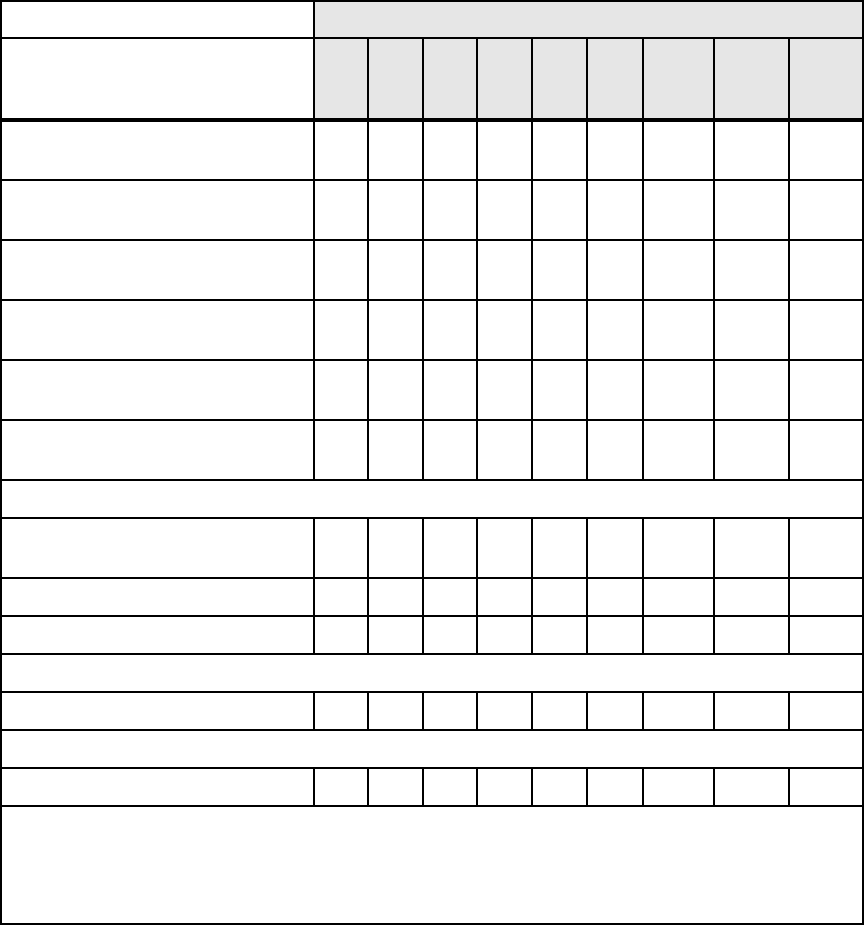
#4687 50 GB ¼-inch Cartridge Tape
Device
XXX X X
#5753/#9653 30 GB ¼ inch
Cartridge Tape Unit
XX
#5754/#8754 Optional Base 50 GB
¼-inch Cartridge Tape Device
XX
#8287 50 GB ¼ inch Cartridge Tape
Unit
X
#9284 30 GB ¼ inch Cartridge Tape
Unit
X
#9285 80 GB ¼ inch Cartridge Tape
Unit
X
VXA-2 Tape Devices
#1889/#9689 80 GB VXA-2 Tape
Device
XX
#4585 80 GB VXA-2 Tape Device X X
#4685 80 GB VXA-2 Tape Device X X X X
VXA-320 Tape Devices
#6279 160GB VXA-320 Tape Drive X X
LTO Tape Devices
#5755 200 GB LTO-2 Tape Unit X X
Notes:
All tape features #44xx and #45xx are CIF. Orders for these devices are installed by the client. The IBM Service
Representative can install the CIF as a billable service.
XAvailable as a new device.
SSupported but not orderable. May only be supported as part of a conversion.
Internal storage media System units supported
Feature 520 550 570 595 800 810 825
870
890
#5074
#5079
#5094
#5294

Th
e
f
o
ll
ow
i
ng
t
a
bl
e
id
en
tifi
es
th
e rea
d/
wr
it
e capa
bilit
y, opera
ti
ng sys
t
em requ
i
remen
t
s,
capacity, media part numbers, performance and compression specifications of LTO and VXA
internal tape devices available for the System i5.
IBM tape device VXA-2 VXA 320 LTO-2
Tape Unit
Drive storage capability 80 GB 160 GB 400GB
Compaction algorithm ALDC ALDC SLDC
Minimum OS/400 level V5R1 V5R3 V5R3
Format Native Media
Capacity
Native
data
transfer rate
Media Media part
number
#18896
#4585
#4685
#9285
#96896
#6279 #5755
VXA11,6 59 GB 6 MB/s V17-59GB 19P4877 R/W -- --
20 GB 6 MB/s V6-20GB 19P4878 R/W -- --
20 GB 6 MB/s V6-test 19P4879 R/W -- --
VXA21,3 80 GB 6 MB/s V23-80GB 19P4876 R/W R/W --
59 GB 6 MB/s V17-59GB 19P4877 R/W -- --
20 GB 6 MB/s V6-20GB 19P4878 R/W -- --
20 GB 6 MB/s V6-test 19P4879 R/W -- --
80 GB 6 MB/s X23-80GB 24R2137 R/W R/W --
40 GB 6 MB/s X10-40GB 24R2136 R/W R/W --
20 GB 6 MB/s X6-20GB 24R2134 R/W R/W --
20 GB 6 MB/s X6-test 24R2135 R/W R/W --
VXA31,2,4,5 80 GB 12 MB/s V23-80GB 19P4876 -- R/W --
80 GB 12 MB/s X23-80GB 24R2137 -- R/W --
40 GB 12 MB/s X10-40GB 24R2136 -- R/W --
20 GB 12 MB/s X6-20GB 24R2134 -- R/W --
20 GB 12 MB/s X6-test 24R2135 -- R/W --
LTO 1 200 GB 24 MB/s LTO Ultrium 1 09L9120 -- -- R/W
LTO 2 400 GB 24 MB/s LTO Ultrium 2 08L9870 -- -- R/W
Notes:
1. Indicates that the capacity can double typically when the compression option is selected.
2. The VXA3 format doubles the native capacity of the media.
3. The VXA-2 drive can use VXA1 and VXA2 formats.
4. The VXA-320 drive can use VXA2 and VXA3 formats.
5. The VXA-320 drive will auto-eject all V-type media except V23.
6. The VXA1 format is not supported on V23 and X-Type media.
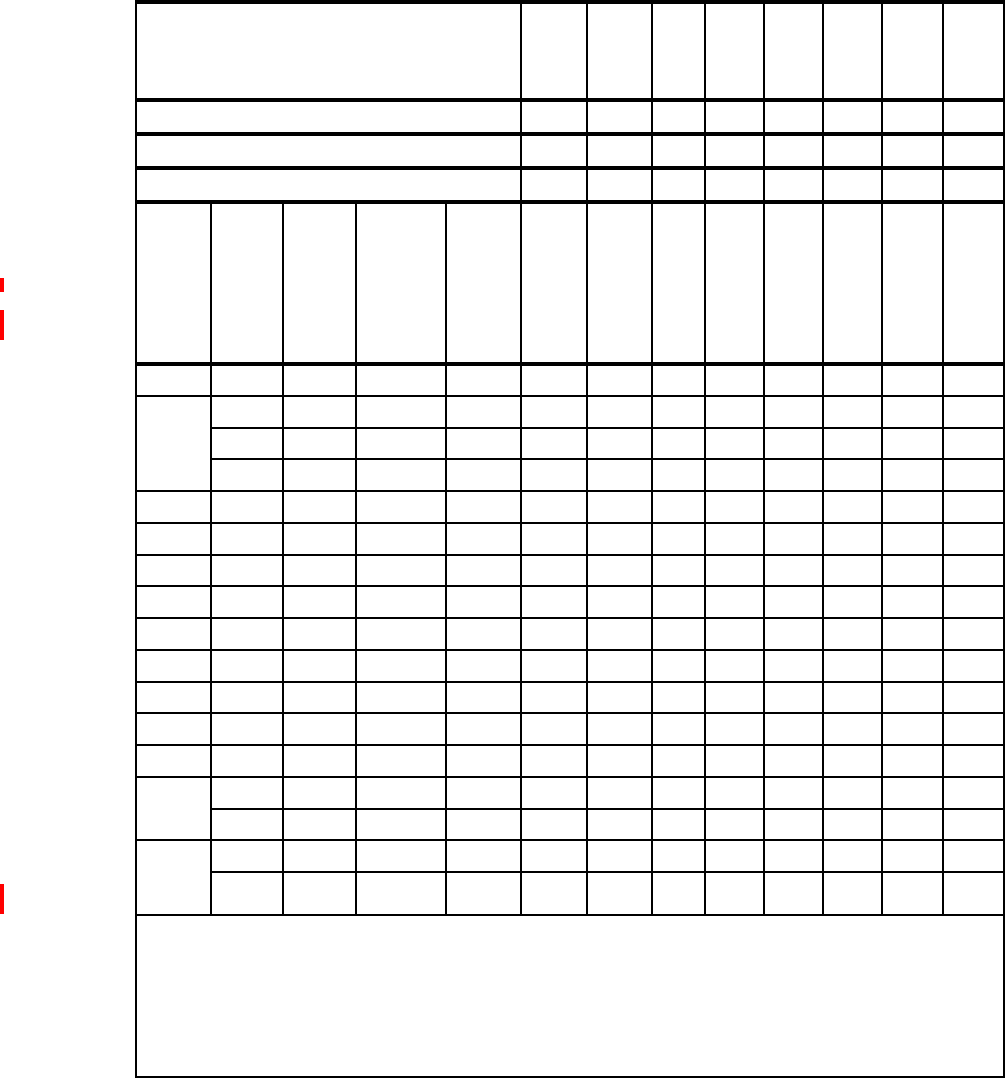
Th
e
f
o
ll
ow
i
ng
t
a
bl
e
id
en
tifi
es
th
e rea
d/
wr
it
e capa
bilit
y, opera
ti
ng sys
t
em requ
i
remen
t
s,
capacity, performance and compression specifications of QIC internal tape devices available
for the System i5.
IBM tape device QIC-
2GB
QIC-
2GB
DC
4/8GB
SLR5
QIC-
4GB
DC
MLR1
QIC
5010
DC
MLR1
QIC
5010
DC
MLR3 SLR
60
SLR
100
Drive storage capability 2.5 GB42.5 GB44 GB 13 GB416 GB 25 GB 30 GB 50 GB
Compaction algorithm LZ1 LZ1 LZ1 LZ1 LZ1 LZ1 LZ1
Minimum OS/400 level V4R1 V4R1 V4R1 V3R7 V4R1 V4R1 V4R5 V5R1
Format Capacity Native
data
transfer
rate
Media Media
part
number
#6380
#6480
#6381
#6481
#4482
#4582
#6382
#6482
7207-
122
#63857
#64857#4483
#4583
#6383
#6483
#4486
#4586
#6386
#6486
#4584
#4684
#57536
#6384
#6484
#9284
#96536
7207-3
30
#4487
#4587
#57546
#8287
#87546
#4687
7329-3
08
MLR3 1 25 GB82 MB/s MLR3-25GB 59H4128 -- -- -- -- -- R/W R/W R/W
QIC5010116 GB 1.5 MB/s MLR1-16GB 59H4175 -- -- -- R/W R/W R/W R/W R
13 GB 1.5 MB/s DC5010 16G8574 -- -- -- R/W R/W R/W R/W R
2 GB 1.5 MB/s MLR1-2GB 35L0589 -- -- -- R/W R/W R/W R/W R
QIC4DC28 GB 760 KB/s SLR5-4GB 59H3660 -- -- R/W -- R R R R
QIC4GB 4 GB 380 KB/s SLR5-4GB 59H3660 -- -- R/W -- R R R R
QIC2DC25 GB 600 KB/s DC9250 16G8436 -- R/W R/W -- R R R
QIC2GB 2.5 GB 300 KB/s DC9250 16G8436 R/W R/W R/W R/W R R R
QIC1000 1.2 GB 300 KB/s DC9120 21F8730 R/W R/W R/W R/W -- --
QIC525 525 MB 200 KB/s DC6525 21F8597 R/W R/W R/W R/W5-- --
QIC525 320 MB 200 KB/s DC6320 21F8583 R/W R/W R/W R/W -- --
QIC120 120 MB 120 KB/s DC6150 21F8578 R/W R/W R/W R/W5-- --
QIC24360 MB DC6150 R R -- -- -- --
SLR100 50 GB 5 MB/s SLR100-50 35L0968 -- -- -- -- -- -- -- R/W
5 GB 5 MB/s SLR100-5G 35L0961 -- -- -- -- -- -- R/W R/W
SLR60 30 GB 4 MB/s SLR60-30G 19P4209 -- -- -- -- -- -- R/W R/W
37.5 GB 4 MB/s SLR60-37.5
GB
24R0146 -- -- -- -- -- -- R/W R/W
Notes:
1. Indicates that the capacity can double typically when the compression option is selected.
2. QIC-2DC and QIC-4DC are compression formats. Cartridge capacity is data dependent. Capacities shown are typical.
3. QIC24 format is written by S/36.
4. Available as a migration feature only during an upgrade.
5. Use of DC6150 and DC6525 media may shorten the life of the tape device and require more frequent maintenance.
6. Requires i5/OS V5R3
7. The internal 13 GB tape drives with feature code #6385 or #6485 also supports the 16 MB IBM MLR1 tape media.
8. Minimum operating system to support the 25GB capacity cartridge drive: V4R1.

I
n
t
erna
l
CD
-
ROM
,
DVD
-
RAM
, an
d
DVD
-
ROM
d
r
i
ves
The following table identifies the CD-ROM, DVD-ROM, and DVD-RAM devices supported in
System i5 models. Also listed is the supported format, maximum capacity, minimum operating
system level, write supported media and the required IOA. All DVD drives support ISO 9660
and UDF formats.
Feature Description Minimum
operating
system
Supported
formats
Write
Supported
Media
Maximum
capacity
(compressed)1
#26402DVD-ROM i5/OS V5R3 CD ROM N/A 650 MB
DVD-ROM
Single-sided
4.7 GB
DVD-ROM
Double-sided
9.4 GB
#4525
#4625
CD-ROM OS/400
V4R4
CD-ROM
Read only
N/A 650 MB
#4530
#4630
DVD-RAM OS/400
V5R1
CD-ROM
Read only
N/A 650 MB
DVD-RAM
Single-sided
4.7 GB - Bare5
2.6 GB &
4.7 GB
Cartridge
2.6 GB4
4.7 GB
DVD-RAM
Double-sided
9.4 GB
#45332, 3, 6 DVD-RAM OS/400
V5R2
CD-ROM
Read only
N/A 650 MB
DVD-RAM
Single-sided
4.7 GB Bare 4.7 GB
DVD-RAM
Double-sided
9.4 GB
#46332, 3, 6 DVD-RAM OS/400
V5R2
CD-ROM
Read only
N/A 650 MB
DVD-RAM
Single-sided
4.7 GB Bare 4.7 GB
DVD-RAM
Double-sided
9.4 GB
#57512, 6 DVD-RAM i5/OS V5R3 CD-ROM
Read only
N/A 650 MB
DVD-RAM
Single-sided
4.7 GB Bare 4.7 GB
DVD-RAM
Double-sided
9.4 GB

System i5 code distribution
System i5 code (LIC, firmware, operating system and licensed programs) is distributed on
CD-ROM media. One CD-ROM, DVD-RAM, or DVD-ROM drive must be ordered as a
separate feature of the system unit of all IBM System i5 servers. The CD-ROM and
DVD-ROM can also be used for alternate IPL, but not as a save/restore device for the system.
The DVD-RAM can be an alternate IPL and save/restore device. It is not recommended as a
save/restore device for performance reasons.
Virtual Storage
Virtual Storage consists of objects that, when used together, imitate tape, CD, DVD and
write-once read-many (WORM) media on the disk units of a System i5. The imitated media
appear to the server to be actual media.
When virtual storage is used, a virtual device description is created to support the virtual
storage, in a similar way that an actual device description is needed to support a physical tape
device.
Virtual storage is of benefit for the following reasons:
Eliminates media errors
Eliminates user intervention
Increases system availability
Simplifies software and data distribution by using electronic distribution
allows CD, DVD and tape creation using the DUPTAP or DUPOPT commands
increases security by using Object signing for digital signatures
simplifies creating copies by using catalog shadowing to create them
Virtual Tape
Virtual tape devices use virtual tape volumes that are created on a servers disk units. This
allows i5/OS SAV commands to be used to back up data to virtual tapes stored on disk rather
#45312
#46312
DVD-ROM OS/400
V5R2
CD-ROM
(Read only)
N/A 650 MB
DVD-RAM
Single-sided
(Read only)
N/A 4.7 GB
DVD-RAM
Double-sided
(Read only)
N/A 9.4 GB
Notes:
1. Compressed values assume a 2:1 compression. Actual results may vary depending on the type and volume
of data.
2. Use of a cleaning kit could damage the drive.
3. See Information APAR II13797 for software requirements of #4533 and #4633 when run with OS/400 V5R2.
4. Only the #4530 and #4630 drives support writing of 2.6GB media
5. Base i5/OS V5R3 supports writing bare 4.7GB and 9.4GB media. OS/400 V5R2 requires PTF MF32271 to
support the writing of 4.7GB and 9.4GB bare media.
6. Supports dual-sided bare media but not recommended due to handling issues. The media must be flipped
manually.
Feature Description Minimum
operating
system
Supported
formats
Write
Supported
Media
Maximum
capacity
(compressed)1

th
an on ac
t
ua
l
t
apes w
hi
c
h
i
s a
l
o
t
s
l
ower.
Vi
r
t
ua
l
t
ape
d
ev
i
ces can per
f
orm
th
e same
t
as
k
s as
a physical tape except:
Install of base i5/OS (RSTLICPGM is supported)
SAVSTG
Dump to Media from SST & DST
The considerations for using virtual tape storage include the:
Correct authority to create virtual images
Disk space requirements (smallest volume size is 48 MB. The largest is 1,000,000 MB)
Quantity of virtual image volumes required
Maximum block size supported by the physical tape device that the virtual tape volume will
be saved to
User profiles used to create the virtual tape volume must have their maximum storage
allowed attribute set to *MAX.
For further information, select the “Storage Solution” tab in the V5R4 information Centre at:
http://publib.boulder.ibm.com/infocenter/iseries/v5r4/index.jsp

© Copyright IBM Corp. 1997 - 2006. All rights reserved. 173
Chapter 14. External storage and SAN
This chapter describes the latest external storage media devices that are
marketed today for IBM System i5. Specification charts are provided for the
supported attachment methods and external devices. It also covers storage area
network (SAN) components that are marketed and supported by the System i5.
Further descriptions of the storage features highlighted in this chapter can be
found in IBM Eserver i5, iSeries, and AS/400e System Builder, SG24-2155.
You can find more information about System i5 storage on the Web at:
http://www.storage.ibm.com/
You can find more information about System i5 and SAN on the Web at:
http://www.ibm.com/servers/storage/san/
14
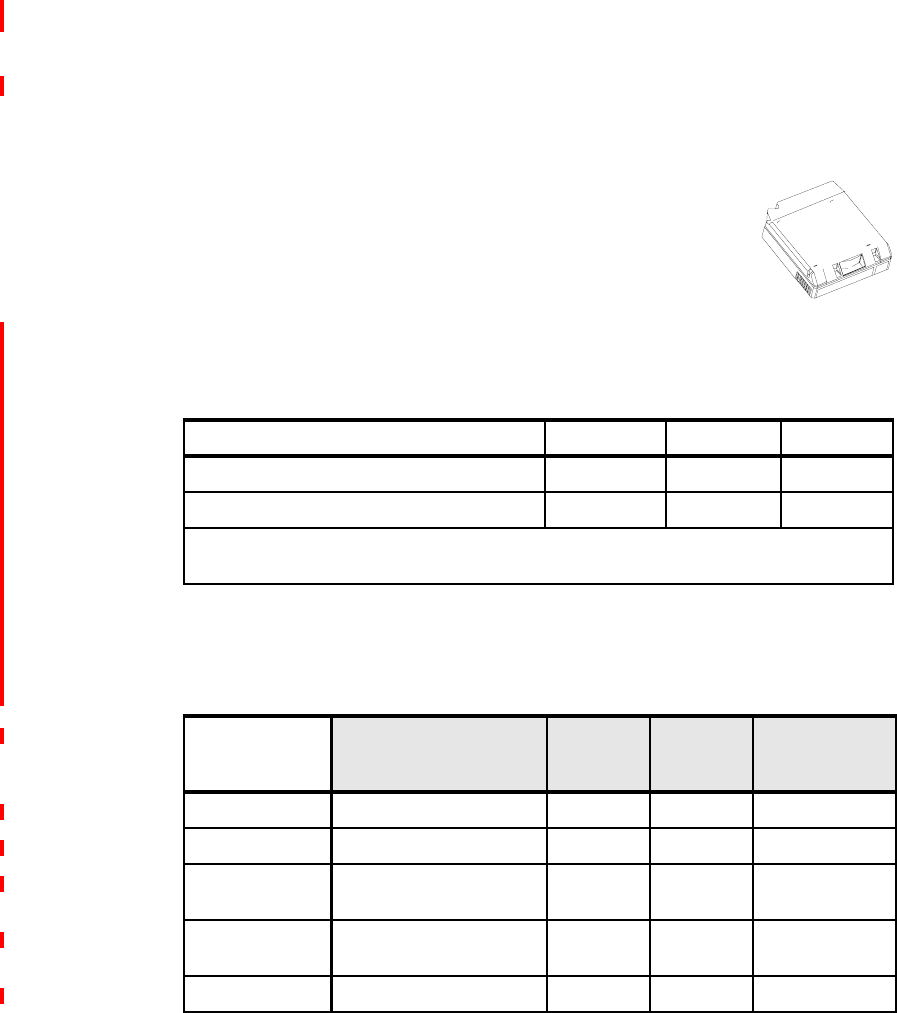
174 i5 Handbook
External storage tape
This section describes select external storage tape devices supported by the
current System i5 product line.
IBM TotalStorage 358x Ultrium Solutions with LTO Technology
The 358x Ultrium tape family of devices supports the latest
industry standard Linear Tape-Open (LTO) technology. LTO
technology enhances data compression capacity, performance,
and reliability. A powerful open tape architecture, Ultrium sets
the stage for the new generation of tape storage products
expected to surpass current tape capacity and performance
benchmarks while maintaining the highest data integrity. The following table
compares Ultrium feeds and speeds:
The models of the 358x supported on the System i5 are shown in the following
table:
Ultrium Model Ultrium 1 Ultrium 2 Ultrium 3
Cartridge capacity GB/s (native/compressed) 100/200 200/400 400/800
Data transfer rate GB/s (native/compressed) 15/30 35/70 80/160
Note: Compressed data rates are estimates and are data, application, and processor dependent.
User results may vary.
358x Model Device description Number
of drives
Maximum
number of
cartridges
Interface
3580 L23, H23 Ultrium 2 Tape Drive 1 1 LVD, HVD
3580 L33 Ultrium 3 Tape Drive 1 1 LVD
3581 L28, F28 Ultrium 2U Tape
Autoloader
1 8 LVD, HVD, FC
3581 L38, F38 Ultrium 2U Tape
Autoloader
18LVD, FC
3582 L23 Ultrium Tape Library 1 - 2 24 LVD, HVD, FC

External storage and SAN 175
The IBM TotalStorage 358x tape devices that are supported on the System i5
include:
IBM TotalStorage Ultrium External Tape Drive 3580
.The IBM LTO 3580 tape drive is an external
stand-alone or rack-mountable unit. It is the entry
point for the family of IBM Ultrium tape products.
The Ultrium 3 tape drive provides up to 400GB of
uncompressed data storage. The IBM Ultrium 3
tape drive can read and write LTO Ultrium 2 data
cartridges and can read LTO Ultrium 1 cartridges.
The IBM Ultrium External Tape Drive 3580 is an
excellent alternative to S-DLT, DLT, ¼-inch, 4 mm,
or 8 mm tapes drives.
IBM TotalStorage Ultrium Tape Autoloader 3581
The IBM LTO 3581 Autoloader is an external
stand-alone or rack-mountable unit and
contains a single LTO Ultrium 2 or Ultrium 3
tape drive. The Ultrium Tape Autoloader 3581
capacity is seven to eight tape cartridges
depending on the model and provides a media
capacity of up to 3.2TB of uncompressed data
storage.
3583
L18 - 18 Carts
L36 - 16 Carts
L72 - 72 Carts
Ultrium Scalable Tape
Library
1 - 6 72 LVD, HVD
FC
3584
L22 - Base
Frame
D22 - Expansion
Frame (up to 16
frames)
Ultrascalable Tape Library
For 3592-J1A drives
1- 192 6260 FC
3584
L32 / L52 - Base
Frame
D32 / D522 -
Expansion
Frame
Ultrascalable Tape Library
For Ultrium 1 or Ultrium 2
LTO drives
1- 192 6881 LVD, HVD
FC
358x Model Device description Number
of drives
Maximum
number of
cartridges
Interface
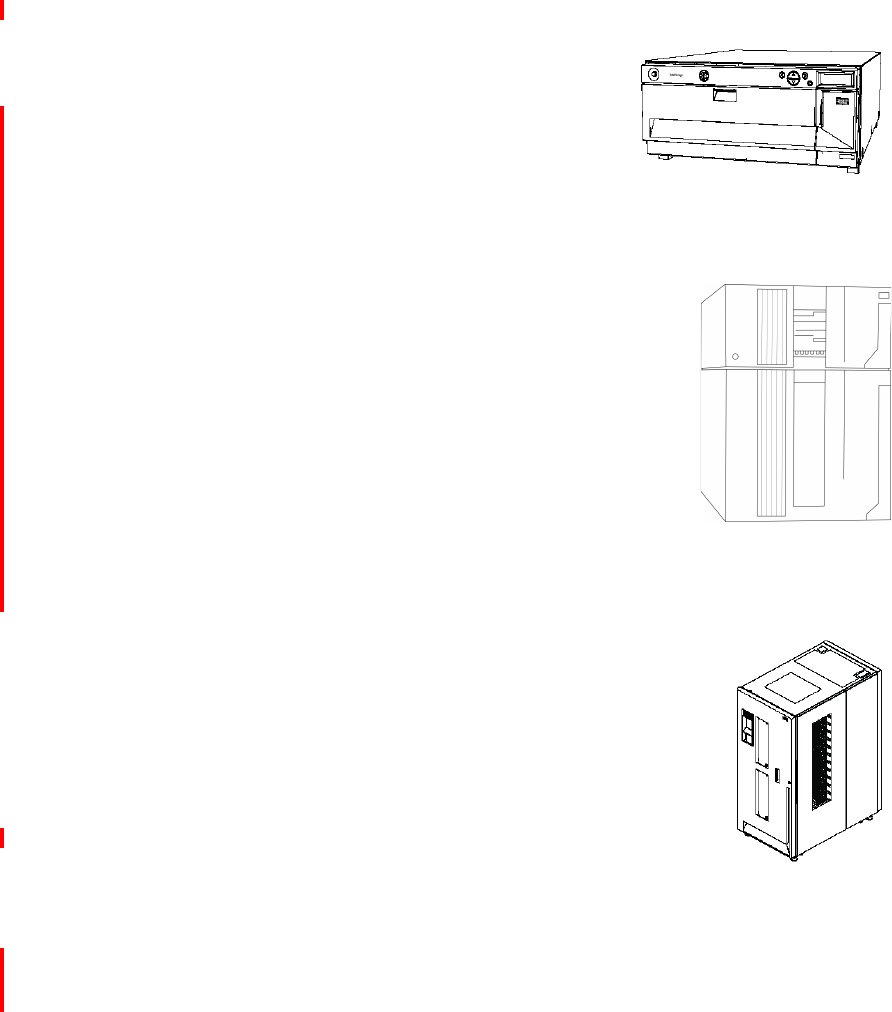
176 i5 Handbook
IBM TotalStorage Ultrium Tape Library 3582
The IBM LTO 3582 Tape Library is an external
stand-alone unit that my be optionally
rack-mounted. It supports up to two IBM
TotalStorage Ultrium 3 or Ultrium 2 Tape
Drives and comes standard with a
one-cartridge I/O station and twenty-three
data cartridge slots giving a native library
capacity of up to 9.6TB of uncompressed data storage.
IBM 3576 System Storage TS3310 Tape Library
The TS3310 Tape Library is a modular, scalable tape
library designed to address the tape storage needs
of rapidly growing companies who find themselves
space and resource constrained with tape backup
and other tape applications. The TS3310 is designed
to scale vertically with expansion for LTO tape
cartridges, drives and a redundant power supplies.
For organizations unsure of their short or long term
tape capacity needs, the TS3310's Capacity on
Demand (COD) built-in capability allows the system
to scale as needs grow. The TS3310 Tape Library
models supports LTO Ultrium 3 Tape Drives with
either LVD Ultra160 SCSI or 2Gb switched fabric Fibre Channel attachment.
IBM TotalStorage UltraScalable Tape Library 3584
The IBM LTO 3584 Tape library provides a highly
scalable mid-range, open systems, and network server
tape storage solution. It combines reliable, automated
tape handling, and storage with reliable,
high-performance IBM LTO Ultrium tape drives and IBM
TotalStorage 3592 tape drives.
The 3584 supports up to 16 frames housing a maximum
of 6,881 LTO Ultrium tape cartridges and 192 LTO
Ultrium tape drives. The UltraScalable Tape Library is
designed with a variety of advanced features. The IBM
Multi-path Architecture and Advance Library
Management System (ALMS) are designed to simultaneously attach
heterogeneous servers and applications to LTO logical library partitions,
including mixed Ultrium drives and media.
For additional information about the LTO products, see the following Web site:
http://www-1.ibm.com/servers/storage/tape/lto/index.html
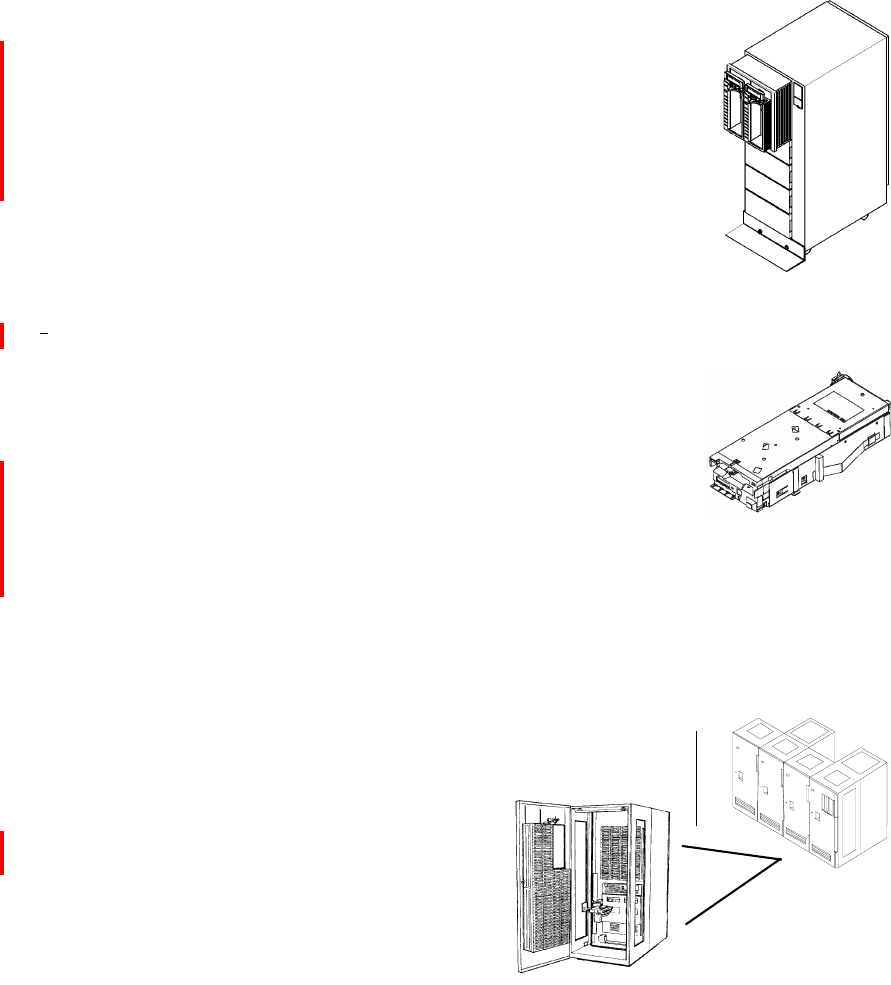
External storage and SAN 177
IBM TotalStorage Enterprise Tape System 3590
The IBM TotalStorage Enterprise Tape System 3590 is
designed to provide high levels of performance and data
reliability for both stand-alone and automated systems.
The 3590 Models B11, E11, and H11 incorporate a
standard 10-slot ACF for high-capacity stand-alone
unattended operation. The 3590 Models B1A, E1A, and
H1A come without the ACF. They are designed to go into
the IBM 3494 Enterprise Automated Tape Library.
IBM TotalStorage 3592 Tape Drive Model J1A
The IBM TotalStorage 3592 Tape Drive Model J1A
surpasses the capabilities of its predecessors by
providing up to five times the capacity and two and a half
times the data transfer rates of the Enterprise Tape
System 3590 E or H Model. The drive has dual fibre
channel ports and is supported in the IBM TotalStorage
Enterprise Tape Library 3494. The 3592 Model J1A is
also available for installation in a stand-alone rack
For more information about the Enterprise Tape System 3592, go to:
http://www-1.ibm.com/servers/storage/tape/3592/index.html
IBM TotalStorage 3494 Enterprise Tape Library
The IBM TotalStorage 3494
Enterprise Tape Library is a
stand-alone automated tape
storage subsystem for 3590 and
3592 ½-inch cartridges available
for attachment to the IBM System
i5. It provides an automated tape
solution for automating tape
operations such as save and
restore, migration of data between
disk and tape, and other mass
data applications.
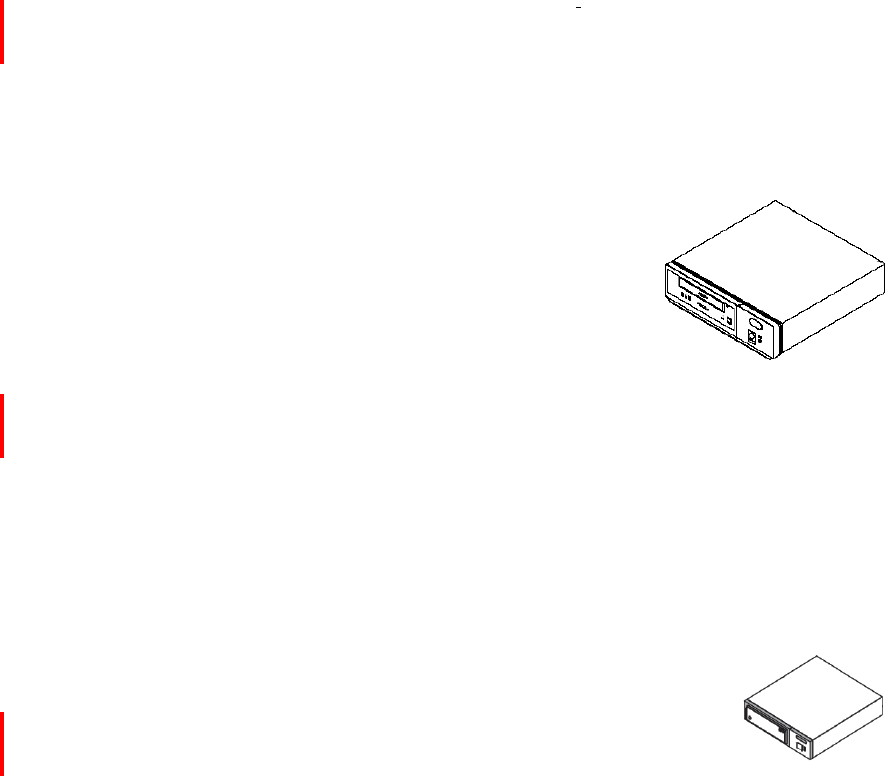
178 i5 Handbook
Flexible configuration choices start at a single frame configuration with up to two
tape drives and up to 240 tape cartridges. Optional drives and cartridge storage
can be added as needed to create an automated tape library multiple frame or
tape drives, and up to 6,240 tape cartridges.
For additional information about the 3494 Enterprise Tape Library, see:
http://www-1.ibm.com/servers/storage/tape/3494/index.html
IBM 7206 Model VX2 80 GB External VXA-2 Tape Device
The IBM 7206 Model VX2 External Tape Drive is a
VXA-2 Packet Drive that features capacity of 80 and
160 GB (native and compressed) and six and 12
MB/s transfer rates (native and compressed). The
VXA Packet Technology provides a digital solution
to the long-standing mechanical problem of
head-to-tape alignment. This is a common problem
that causes conventional tape storage products to
trade off costly mechanical complexity with data
restore integrity.
The IBM 7206 Model VX2 is an excellent solution for midrange tape
requirements with an entry level price.
For additional information about the 7206-VX2 and other 7206 products, see:
http://www.storage.ibm.com/tape/drives/7206/models/model_vx2.html
IBM 7207 Model 122 4 GB External SLR5 QIC Tape Drive
The IBM 7207 Model 122 4 GB External SLR5 QIC Tape
Drive is a stand-alone streaming linear tape drive in a raven
black enclosure incorporating the most recent Single
Channel Linear Recording (SLR5) QIC technology.
For additional information about the 7207-122 and other
7207 products, see:
http://www-1.ibm.com/servers/storage/tape/7207/index.html
IBM 7207 Model 330 30 GB External SLR60 Tape Drive
The IBM 7207 Model 330 30 GB External SLR60 Tape Drive is a stand-alone
streaming tape drive in a single, externally attached enclosure. It incorporates
4-Channel Scalable Linear Recording (SLR) technology.

External storage and SAN 179
For additional information about the 7207-330 and other
7207 products, go to:
http://www-1.ibm.com/servers/storage/tape/7207/index.ht
ml
IBM 7212 Model 102 TotalStorage Storage Device Enclosure
The 7212 Model 102 is designed to mount in one EIA unit of standard 19-inch
rack using an optional rack-mount hardware feature kit. The 7212 Model 102 can
also be configured for desktop installation.
The 7212 Model 102 is an excellent choice for
applications where availability of server bays
for storage devices is limited or not available
and it is important to consolidate storage
devices in a single, convenient location to
minimize space and cabling impacts.
The two bays of the 7212 Model 102 can
accommodate any two of the following
features codes on the 7212 to support
System i5 servers:
#1103 DVD-RAM 2 Drive
#1104 VXA-2 Tape Drive
#1106 DVD ROM Drive
#1107 SLR60 Tape Drive
#1108 SLR100 Tape Drive
For additional information about the 7212-102, see the following Web site:
http://www-1.ibm.com/servers/storage/tape/7212/index.html
VXA, QIC, 8mm tape and DVD-RAM specifications summary
The following table helps to distinguish the technical characteristics of the IBM
7206, 7207, 7208, 7212 tape, and 7210 DVD devices.
Machine
model
7206-VX2 7207-122
7207-330
7208-345 7210-025 7210-030 7212-102
Description VXA-2 QIC ¼ inch
8mm
Mammoth-2 DVD-RAM DVD-RAM
Storage Device
Enclosure

180 i5 Handbook
External tape storage automated library specifications
The following table helps to distinguish the technical characteristics of the
external storage automated tape library devices supported by the System i5
servers marketed today.
Native /
Compressed180 GB /
160 GB
122:
4 GB/8 GB
330:
30 GB/60 GB
60 GB /
150 GB
2.6 GB /
4.7 GB
2.6 GB /
4.7 GB
DDS-4:
20/40 GB
DAT72:
36/72GB
VXA-2:
80/160 B
Maximum Data
Rate/sec26 MB/s
12 MB/s
122:
380 KB/s
760 KB/s
330:
4 MB/s
8 MB/s
12 MB/s
20 MB/s
CD:
3.6 MB/s
DVD-RAM:
1.35 MB/s3
2.7 MB/s4
CD:
3.6 MB/s
DVD-RAM:
2.7 MB/s3
2.7 MB/s4
DDS/DAT72:
3/6 MB/s
VXA: 6/12
MB/s
Interface Ultra2 SCSI
LVD
122:
Wide SCSI
330:
Ultra2 SCSI
LVD
LVD/SE
Ultra wide
SCSI-2
SCSI-2 SCSI-2 SE
Fast/Wide
Fast/Narrow
SCSI-2 F/W
SE,
LVS/SE
Supported Controllers #2768
#57025
#57055
#2768
#57025
#57055
#2768
#57025
#57055
#2768
#57025
#57055
#2768
#57025
#57055
#57126
#2768
#57025
#57055
#57126
Minimum operating system
level
OS/400
V5R1
122: OS/400
V4R2 with
PTFs
330: OS/400
V5R1 with
PTFs
OS/400
V4R5
OS/400
V5R1
7xx and 8xx:
OS/400
V5R2
System i5
i5/OS V5R3
OS/400 V5R2
Notes:
1. The degree of compression that is achieved is highly sensitive to the characteristics of the data being compressed.
2. Compressed data rates are estimates and are data, application, and processor dependent. User results may vary.
3. Write rate of DVD
4. Read rate of DVD
5. Minimum operating system to support the #5702 and #5705: OS/400 V5R2
6. Minimum operating system to support the #5712: i5/OS V5R3
Machine
model
7206-VX2 7207-122
7207-330
7208-345 7210-025 7210-030 7212-102
Note: The last models of the 3490E, 3570, and 3575 range were withdrawn
from marketing in 2002. They are included in the table for comparison
purposes.

External storage and SAN 181
Machine
model
Desktop
3490E-F10
Rack
3490E-F11
Library
3490-F1A 9
3494-L12
3494-L22
3494-L10
3494-D12
3494-D22
3494-D10
3494-HA1
Desktop
3570-C01
3570-C02
Rack
3570-C11
3570-C12
3575-L06
3575-L12
3575-L18
3575-L24
3575-L32
Desktop/Rack
3581-L28, F28
3582-L23
Library, Floor/Rack
3583-L18
3583-L36
3583-L72
Library
3584-L52, L22, L32 9
3584-D52, D22, D32
3590-B1A
3590-B11
3590-E1A
3590-E11
3590-H1A
3590-H11
3592-J1A
Description ½-inch
tape
Library for
3490-x1A
3590-x1A
3592-J1A
C-XL format
0.31 inch
C-XL format
0.31 inch
LTO Ultrium 1 or 2
3592-J1A (3584 L22 and
D22)
½-inch tape
Recording
technology
Longitudinal
Serpentine
Longitudinal
Serpentine or
Linear
Serpentine
(J)
Longitudinal
Serpentine
Longitudinal
Serpentine
Longitudinal
Serpentine
Longitudinal
Serpentine
J: Linear
Serpentine
Native/
compressed1800 MB /2.4
GB
Depends on
installed
drives; See
columns
3590-X1A
and
3592-J1A.
7 GB/21 GB 7 GB/21 GB Ultrium 1 100/200 GB
Ultrium 2 200/400 GB
3592-J1A
300GB/900GB
B: 10/30 GB or
20/60 GB7
E: 20/60 GB or
40/120 GB7
H: 30/90 GB7
J1A
300GB/900GB
Maximum
number
of cartridges/
library
10 6240 20 L06: 60
L12: 120
L18: 180
L24: 240
L32: 324
L28/F28: 8
L23: 24
L18: 18
L36: 32
L72: 72
L52, D52: 64-688712
L22, D22: 58 - 626012
L32, D32: 281-688112
B1A: 1
B11: 10
E1A: 1
E11: 10
H1A: 1
H11: 10
J1A:1
Maximum total
capacity
24 GB 1.12 PB
(3590H)
5.62PB
3592J
(3:1 comp)
420 GB L06: 1.2 TB
L12: 2.5 TB
L18: 3.78
TB
L24: 5.04
TB
L32: 6.8 TB
L28: 3.2 TB
L23: 9.6 TB
L18: 7.2TB
L36: 14.4 TB
L72: 28.8 TB
L32 + D32:
56.2 to 2752 TB
L52, D52:
25.6 TB to 2.76PB
(2:1 comp)
L22, D22:
52TB to 5.63PB (3:1 comp)
L32, D32:
112TB to 2.75PB
(2:1 comp)
B1A: 60 GB
B11: 0.6 TB
E1A: 120 GB
E11: 1.2 TB
H1A: 180 GB
H11: 1.8 TB
J1A: 900GB
(3:1 comp)

182 i5 Handbook
Maximum
data rate/sec
(native) 2
3 MB/s Depends on
installed
drives; see
columns
3590-X1A
and
3592-J1A.
7MB/s 7MB/s 35 MB/s B11: 9 MB/s
E11: 14 MB/s
H11 14 MB/s
J1A:40 MB/s
Time to
load and
thread a
cartridge
81 sec See columns
3590-X1A
and
3592-J1A.
19 sec 20 sec 15 sec, LTO Ultrium 2 40 sec
(3590 J media)
60 sec
(3590 K media)
19 sec
(3592 J1A)
Interface SCSI-2
Fast/wide
differential
RS232
Async
or LAN for
Library
Manager/
robotics
SCSI-2
Fast/wide
differential
SCSI-2
Fast/wide
differential
Ultra160 SCSI LVD
Fibre Channel
SCSI-2 HVD (with #3104
Converter Kit)
3590
SCSI-2
Fibre Channel
3592
Fibre Channel
only
Compression/
compaction
method6
HDC
IDRC
Depends on
installed
drives; see
columns
3590-X1A
and
3592-J1A.
LZ1 LZ1 LTO-DC (LZ1) I3590 - ALDC
(LZ1
3592 - SLDC
(LZ1)
Controllers
supported
#27493Depends on
installed
drives; see
columns
3590-X1A
and
3592-J1A
#27493#27493#27493
#27654, 5
#57028
#57048
#57058
#571210
3590
#27493
#27654, 6
#570411
3592
#2765,
#570411
Minimum
operating
system level
OS/400
V4R1
OS/400
V2R3
OS/400
V3R1
OS/400
V4R1
OS/400 V5R1 B1x: OS/400
V3R1
E1x: OS/400
V4R1
H1x: OS/400
V4R5
J1A: OS/400
V5R1
Machine
model
Desktop
3490E-F10
Rack
3490E-F11
Library
3490-F1A 9
3494-L12
3494-L22
3494-L10
3494-D12
3494-D22
3494-D10
3494-HA1
Desktop
3570-C01
3570-C02
Rack
3570-C11
3570-C12
3575-L06
3575-L12
3575-L18
3575-L24
3575-L32
Desktop/Rack
3581-L28, F28
3582-L23
Library, Floor/Rack
3583-L18
3583-L36
3583-L72
Library
3584-L52, L22, L32 9
3584-D52, D22, D32
3590-B1A
3590-B11
3590-E1A
3590-E11
3590-H1A
3590-H11
3592-J1A
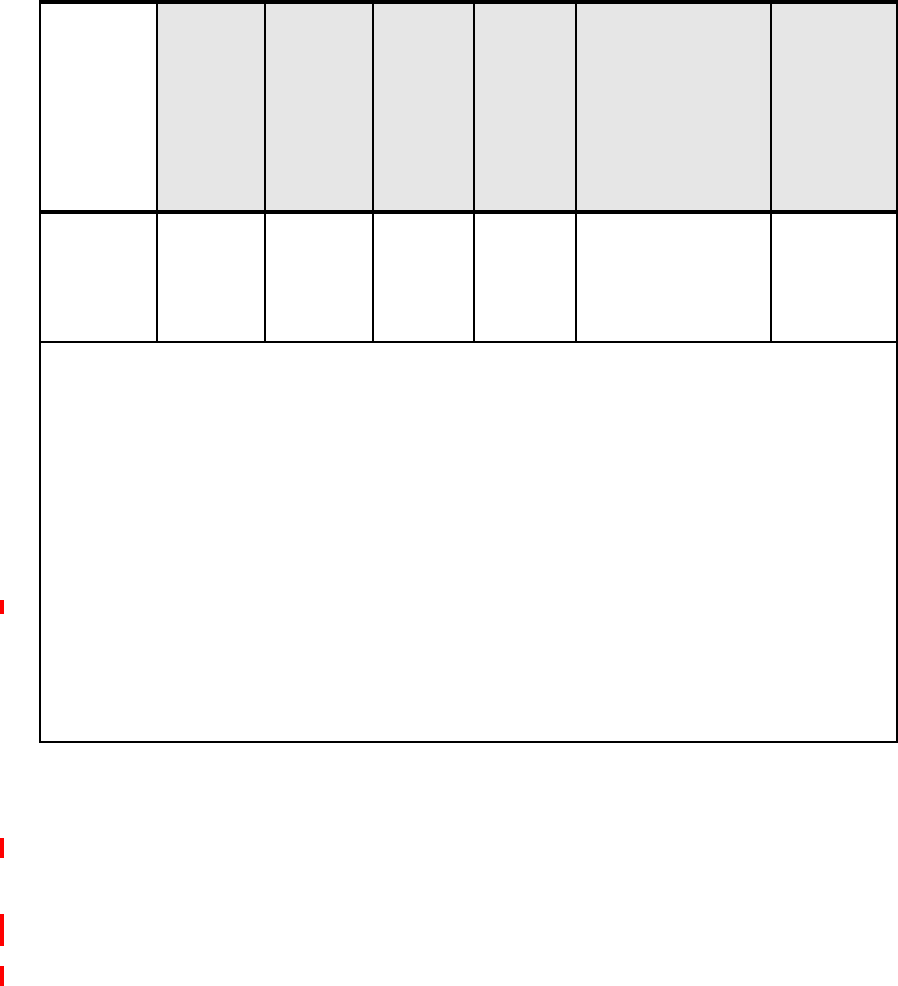
External storage and SAN 183
Refer to IBM TotalStorage Tape Selection and Differentiation Guide, SG24-6946
to assist you in finding the best tape product solution for the designated backup
environment. The 2004 edition of this Redbook covers the 3494, 3580, 3581,
3582, 3583, 3584, 3590, 3592, and other tape products.
Magnetic media controller transfer rates
The following table identifies the theoretical transfer rates of System i5 media
controllers. Refer to appropriate benchmarks for an accurate representation of
Alternate IPL
device specify
#5504 Depends on
tape devices
installed; see
columns
3590-X1A
and
3592-J1A
#5515 #5515 #5537 #5519 for 3590
Notes:
1. The actual degree of compression achieved is highly sensitive to the characteristics of the data compressed.
2. This entry illustrates the best possible performance. Other components of the system may limit the actual performance achieved.
The best source of information about performance is the iSeries Performance Capabilities Reference, SC41-0607.
3. The #2749 PCI Ultra Magnetic Media Controller attachment requires a minimum of OS/400 V4R5.
4. The #2765 PCI Fibre Channel Tape Controller attachment requires a minimum of OS/400 V5R1.
5. The #2765 PCI Fibre Channel Tape Controller supports attachment to the 3582, 3583, and 3584 only.
6. The #2765 PCI Fibre Channel Tape Controller supports attachment to the 3590-Exx and 3590-Hxx only.
7. The 3590 capacities depend on cartridge type. The Extended High Performance Cartridge has twice the capacity of the original
High Performance Cartridge. The compressed capacities assume 3:1 compression.
8. Minimum operating system to support the #5702 PCI-X Ultra Tape Controller, #5704 PCI-X Fibre Channel Tape Controller and
#5705 PCI-X Tape/DASD Controller attachment is OS/400 V5R2.
9. The maximum number of drives depends on the adapter used to attach to the System i5 server:
– #2765, #5702: 16 drives, media changers, or both per adapter with a maximum of 96 devices in the library partition.
– OS/400 is limited to 32 drives pooled per library, regardless of how the drives are attached (one versus multiple).
10. Minimum operating system to support #5712 PCI-X Tape/DASD Controller attachment: i5/OS V5R3.
11. Minimum operating system to support #2765 attachment: OS/400 V5R1.
Minimum operating system to support #5704 attachment: OS/400 V5R2
12. Multiple frame combinations are possible.
Machine
model
Desktop
3490E-F10
Rack
3490E-F11
Library
3490-F1A 9
3494-L12
3494-L22
3494-L10
3494-D12
3494-D22
3494-D10
3494-HA1
Desktop
3570-C01
3570-C02
Rack
3570-C11
3570-C12
3575-L06
3575-L12
3575-L18
3575-L24
3575-L32
Desktop/Rack
3581-L28, F28
3582-L23
Library, Floor/Rack
3583-L18
3583-L36
3583-L72
Library
3584-L52, L22, L32 9
3584-D52, D22, D32
3590-B1A
3590-B11
3590-E1A
3590-E11
3590-H1A
3590-H11
3592-J1A
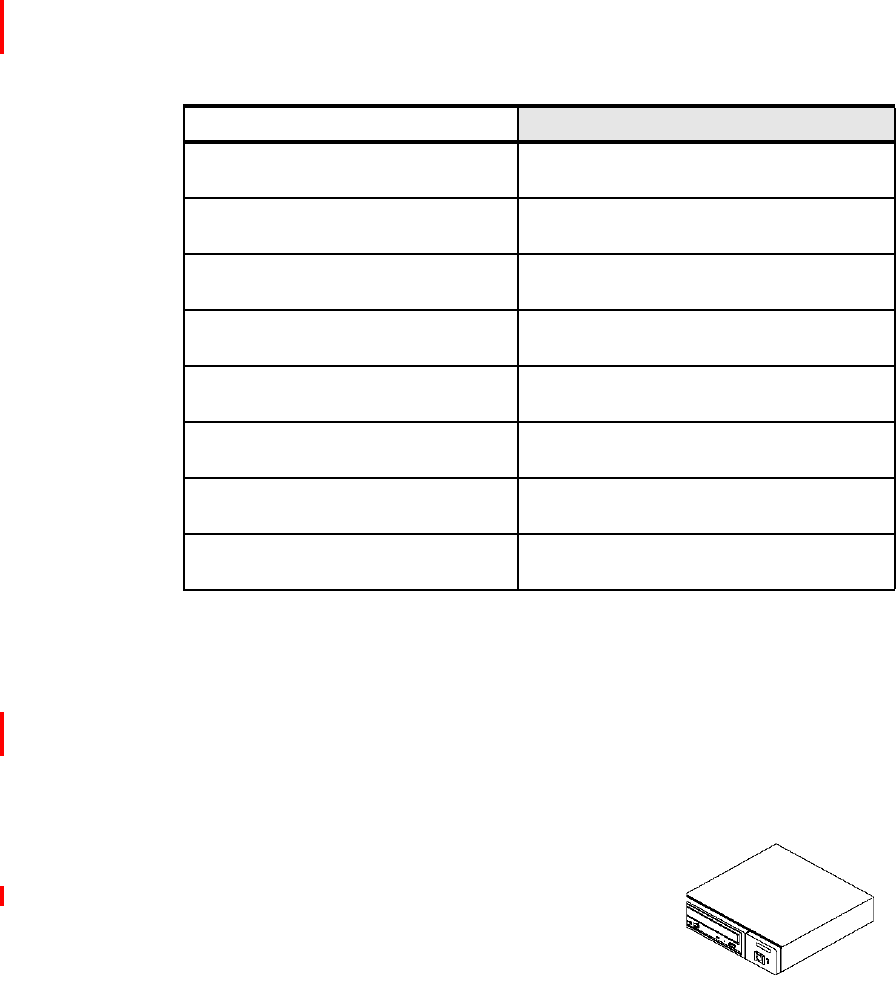
184 i5 Handbook
performance capabilities. Refer to the following two guides for benchmark
information:
iSeries Performance Capabilities Reference, SC41-0607
iSeries in Storage Area Networks, SG24-6220
External DVD-RAM storage
DVD-RAM is an optical technology that advances the capabilities that CD-ROM
brings to System i5. This section describes select external storage DVD-RAM
devices supported by the current System i5 product line.
IBM 7210 Model 025 External DVD-RAM Drive
The IBM 7210 External DVD-RAM drive provides data
interchange capability in support of LPAR
configurations for System i5. The 7210 Model 25 is
flexible, supporting synchronous and asynchronous
data transfer and accommodates both 12 cm and 8 cm
disks. The Model 025 reads multi-session disks,
CD-recordable disks, and CD-RW disks. DVD disk
capacities of 2.6 GB, 4.7 GB, 5.2 GB, and 9.4 GB are supported. The IBM 7210
IOP or IOA Transfer rate
#2749 PCI Ultra Magnetic Media Controller
OS/400 V4R5
Up to 38 MB/s
Aggregate sustained data rates up to 108 GB/hour
#2765 PCI Fibre Channel Tape Controller
OS/400 V5R1
Up to 100 MB/s
#2766 PCI Fibre Channel Disk Controller
OS/400 V5R1
Up to 100 MB/s
#2787 PCI-X Fibre Channel Disk Controller
OS/400 V5R2
Up to 200 MB/s
#5702 PCI-X Ultra Tape Controller
OS/400 V5R2
80 MB/s
Up to 160 MB/s with MF30636 applied
#5704 PCI-X Fibre Channel Tape Controller
i5/OS V5R3
Up to 200 MB/s
#5705 PCI-X Tape/DASD Controller
OS/400 V5R2
80 MB/s
Up to 160 MB/s with MF30636 applied
#5712 PCI-X Tape/DASD Controller
i5/OS V5R3
Up to 160 MB/s
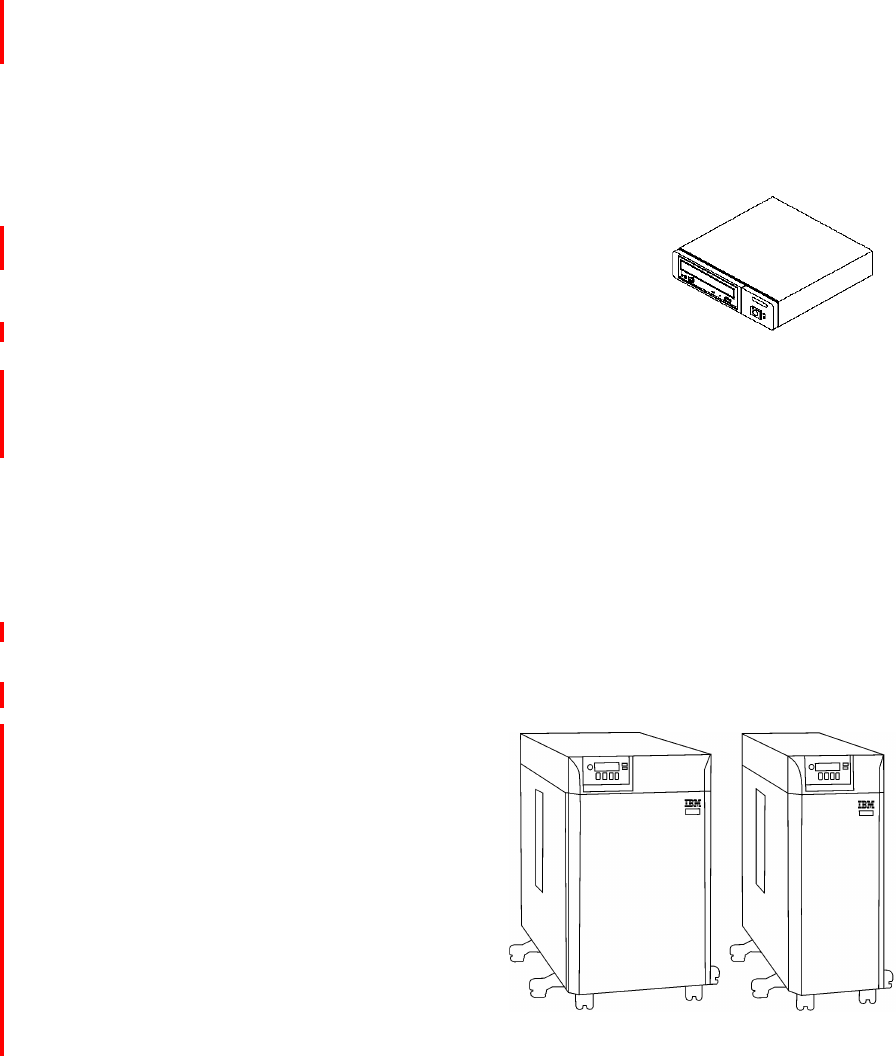
External storage and SAN 185
External DVD-RAM Drive enhances the function and capabilities of the
System i5.
For additional information about the 7210-025, see the following Web site:
http://www-1.ibm.com/servers/storage/tape/7210/index.html
IBM 7210 Model 030 External DVD-RAM Drive
The high-performance IBM 7210 External
DVD-RAM drive provides data interchange
capability in support of LPAR configurations for
System i5. The 7210 Model 30 is flexible,
supporting synchronous and asynchronous data
transfer and accommodates both 12 cm and 8 cm
bare media only. The Model 030 reads
multi-session disks, CD-recordable disks, and
CD-RW disks. The Model 030 writes to 4.7Gb and 9.4Gb DVD-RAM media
Media capacities of 2.6 GB, 4.7 GB, 5.2 GB, and 9.4 GB are supported.
For additional information about the 7210-030, see the following Web site:
http://www-1.ibm.com/servers/storage/tape/7210/index.html
External optical storage
This section describes select external storage optical devices supported by the
current System i5.
IBM 3996 Optical Library
The IBM 3996 Optical Library is
designed for excellent reliability
and performance. This family of
optical libraries features 5.25 inch,
30GB Ultra Density Optical (UDO)
technology, and the UDO media
provides up to five times the
maximum capacity of media used
in the previous 3995 optical library
offered by IBM. The IBM 3996
Optical Library supports
permanent Write Once / Read
Many (WORM), and rewritable
recording technologies in a single library. The IBM 3996 is available with a low
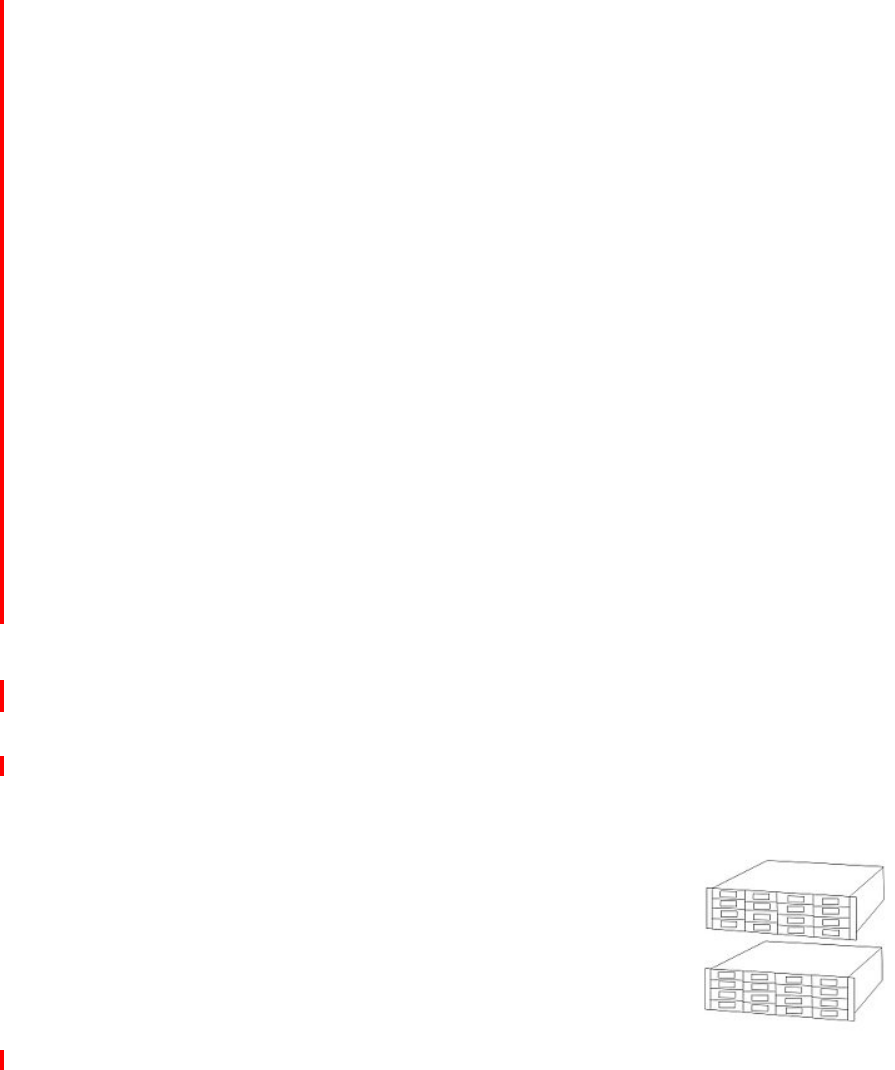
186 i5 Handbook
voltage differential (LVD) SCSI interface connectivity and has an optional
barcode scanner to facilitate library inventory.
The 3996 Optical Library is available in three models.
Model 3996-032
The IBM 3996 Model 032 has the physical capacity to hold optical discs
capable of holding up to 960 GB. Each of the 32 media slots can handle an
optical disc providing up to 30 GB of optical storage.
Model 3996-080
The IBM 3996 Model 080 has the physical capacity to hold optical discs
capable of holding up to 2.4 TB. Each of the 80 media slots can handle an
optical disc providing up to 30 GB of optical storage. When additional drives
are added, its capacity becomes 2.16 TB. Adding two optional drives uses
eight media slots, reducing the storage capacity of the 3996.
Model 3996-174
The IBM 3996 Model 174 has the physical capacity to hold optical discs
capable of holding up to 5.2 TB. Each of the 174 media slots can handle an
optical disc providing up to 30 GB of optical storage. With two 30 GB optical
disc drives and an option of increasing to four drives, its capacity becomes
4.98 TB. Adding the two optional drives uses eight media slots, reducing the
storage capacity of the 3996.
The IBM 3996 features an optional barcode scanner tor out-of-library media
management, faster media inventorying inside the library, and added security.
External disk storage devices
This section describes select external storage disk storage devices that are
supported by the current System i5.
IBM TotalStorage DS6000
The IBM TotalStorage DS6000 series is designed to
deliver enterprise-class storage capabilities in a
space-efficient, modular design at a low price. This
functionality, as well as the high performance and
advanced functions found in enterprise disk storage
devices, is available in 19-inch rack mountable packages
with the base storage server enclosure 5.25-inch (3U)
high, and modular expansion enclosures of the same
size to add capacity as your needs grow.
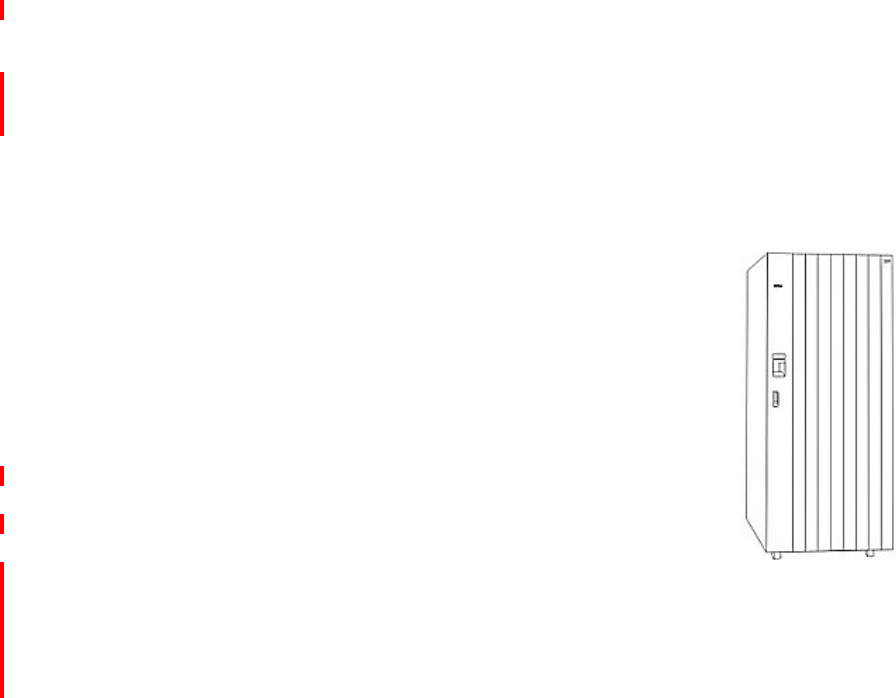
External storage and SAN 187
The IBM TotalStorage DS6800 consists of redundant, hot-swappable power
supplies and cooling fan assemblies, redundant RAID controllers, supporting
RAID 5, RAID 10 and optional IBM TotalStorage Resiliency Family functions, IBM
TotalStorage FlashCopy®, Metro Mirror, Global Mirror, and Metro/Global Copy.
For additional information about DS6000, see the following Web site:
http://www-1.ibm.com/servers/storage/disk/ds6000/index.html
IBM TotalStorage DS8000
The IBM TotalStorage DS8000 series is designed to provide
unmatched functionality, flexibility, and performance for
enterprise disk storage systems. It incorporates a high
bandwidth internal fabric designed to support fault tolerance,
highly expandable and flexible processor memory, and Fibre
Channel attached disks. It has a dual processor complex
implementation base on IBM POWER5 technology that
supports concurrent microcode loads, transparent I/O failover
and failback support, and redundant, hot-swappable
components for 24 x 7 business environments. The DS8000
series offers support for IBM TotalStorage Resiliency Family
technologies, which includes FlashCopy, Global Mirror, and
Metro Mirror. The DS8000 supports RAID-5 and RAID-10 disk
protection. It is designed to support a broad range of
operating environments including zSeries, System i5 and pSeries servers, as
well as servers from Sun, HP, and other Intel-based providers. For the System i5,
attachment via 2 Gbps Fibre Channel controllers is supported.
For additional information about DS8000, see the following Web site:
http://www-1.ibm.com/servers/storage/disk/ds8000/index.html
IBM TotalStorage Enterprise Storage Server Model 750
The IBM TotalStorage ESS Model 750 is designed to help meet the needs of
clients who do not require the full range of capacity and performance scalability
offered by the IBM TotalStorage ESS Model 800, but need enterprise level
functionality intended to support reliable, continuous access to data at an
affordable price.
The ESS Model 750 provides an entry point into the IBM TotalStorage ESS
product family comprised of ESS Model 750 and ESS Model 800. The ESS
Model 750 offers many of the features of ESS Model 800, but is based on a
two-way processor with 8 GB cache and 2 GB of Non Volatile Storage (NVS).

188 i5 Handbook
This is in contrast to the 4-way or 6-way processors available with the ESS Model
800.
For additional information about ESS, see the following Web site:
http://www-1.ibm.com/servers/storage/disk/ess/
IBM TotalStorage Enterprise Storage Server Model 800
The IBM TotalStorage Enterprise Storage Server Model 800, the third generation
of IBM intelligent storage, sets yet another milestone in ESS functionality,
flexibility, performance, and overall value available to meet today's storage
requirements. The Model 800 is designed to provide performance, scalability,
and flexibility. Meanwhile, it supports 24 x 7 operations to help provide the access
and protection demanded by today's business environment and delivers the
flexibility and centralized management needed to lower long-term costs.
The Model 800 integrates a new generation of hardware, including faster
symmetrical multiprocessors (SMP) with an optional Turbo feature, 64 GB cache,
double internal bandwidth, and 2 Gb Fibre Channel/FICON Host Adapters. This
hardware, in addition to RAID-10 support and 15,000 rpm drives, enables the
Model 800 to deliver excellent levels of performance throughput.
For additional information about ESS, see the following Web site:
http://www-1.ibm.com/servers/storage/disk/ess/
Storage area network components
SAN can be defined as a combination of technologies (including hardware,
software, and networking components) that provide any-to-any interconnection of
server and storage elements.
SANs connect SAN storage (usually tape and disk) together with servers into a
network called a fabric. Today’s industry standard for interconnecting

External storage and SAN 189
components of a SAN is Fibre Channel. The System i5 supports connection of
disk and tape using Fibre Channel.
IBM SAN switches and directors for System i5
SAN switches are supported on the System i5 servers for connecting multiple
host servers with storage servers and devices, creating a SAN. There are a
variety of SAN switches supported by the System i5, including:
IBM TotalStorage SAN Switches 2005-H08/-H16, 3534-F08 and
2109-F16/-F32 with 4-32 ports and 2 Gbps fabric switching.
IBM TotalStorage SAN Switches SAN12M-1 2026-E12 and SAN24M-1
f2026-224 2 Gbps fabric switches with FlexPort scalability from 4 to 24 ports.
Cisco MDS 9216 Multilayer Fabric Switch 2062-D01 and 9120/9140
2061-020/-040, with 16 to 48 ports and 2 Gbps performance.
IBM TotalStorage SAN Switch SAN32M-1 2027-232 and Director SAN140M
2027-140 with 8 and 140 ports and 2 Gbps performance.
CNT UltraNet Multi-service Director (UMD) 2042-N16, CNT FC/9000 Fibre
Channel Director 2042-256/128/001/
Cisco MDS Multilayer Director 9509 2062-D07 and 9506 2062-D04 which
support 1 and 2 Gbps Fibre Channel and up to 128 and 224 fibre channel
ports.
IBM TotalStorage SAN Director 2109-M14/M12 and Cabinet 2109-C36 with
up to 128 ports 2 Gbps performance.
For additional information about System i5 with SAN, refer to IBM Eserver
iSeries in Storage Area Networks: Implementing Fibre Channel Disk and Tape
with iSeries, SG24-6220, and the following Web site:
http://www-1.ibm.com/servers/storage/san/
190 i5 Handbook

© Copyright IBM Corp. 1997 - 2006. All rights reserved. 191
Chapter 15. I/O devices and other
components
This chapter describes the printers that are offered and supported today for
System i5 servers.
15

192 i5 Handbook
System i5 printers
System i5 printers are designed, built, tested, and supported as an integrated
component of the system. Printer options are scalable from desktop to
production, impact to laser, with 375 characters per second up to 2200
impressions per minute.
This section describes the current line of printers for the System i5. The
descriptions are divided into these sections depending on typical usage:
Monochrome laser
Color laser
Cutsheet departmental
Industrial printers
Production
Industrial
The following table summarizes the characteristics of each of these printers,
including the duty cycle ratings.
Category Printer Machine
number
Printer form Speed
(IPM)
Maximum monthly
usage (pages)*
IPDS™
Monochrome Infoprint® 1512 Cutsheet laser
Infoprint 1532
Infoprint 1552
Infoprint 1572
Infoprint 1585
Color Infoprint Color 1454 4924 Cutsheet laser 25 IPM 85K Y
Infoprint Color 1464 4924 24 IPM 85K Y
Infoprint Color 1534
Infoprint Color 1567
Departmental Infoprint 2090ES 2790 Cutsheet laser 90 IPM 800K Y
Infoprint 2105ES 2706 105 IPM 1M Y
Production Infoprint 3000 3300 Continuous
form laser
344 IPM 4.4M - 8.8M Y
Infoprint 4000 4000 1002
IPM
11.6M Y
Infoprint 4100 4100 2200
IPM
23.2M Y
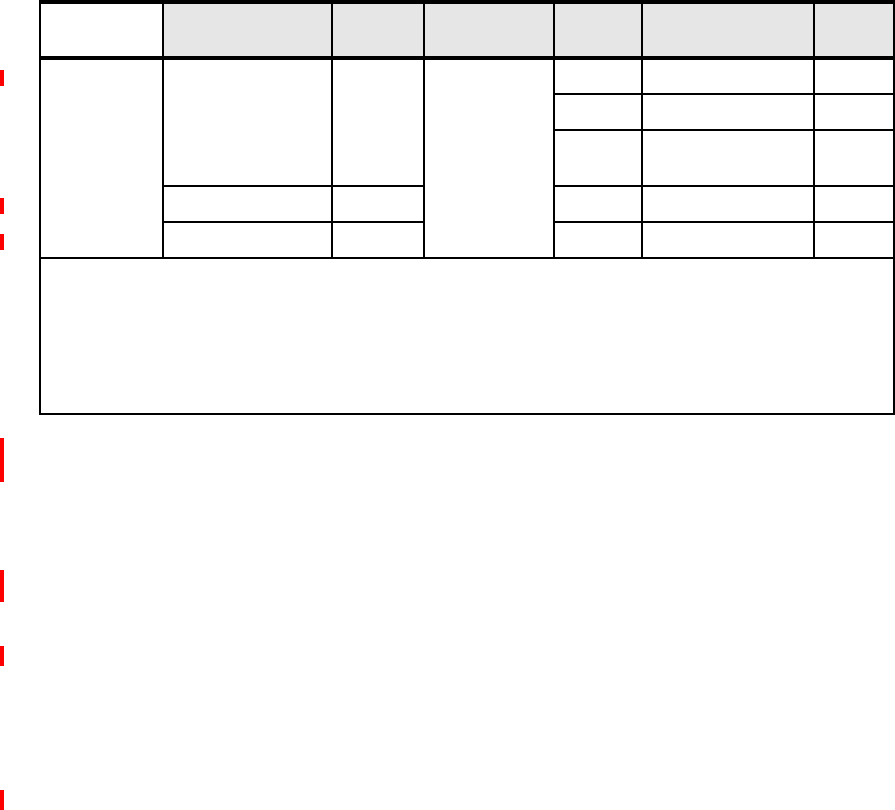
I/O devices and other components 193
You can find information about System i5 print applications on the System i5
printing Web site at:
http://www.printers.ibm.com/R5PSC.NSF/Web/as400overview
System i5 workgroup printers
IBM Infoprint workgroup printers are a family of high-performance laser printers
designed for System i5 and network printing environments. System i5 workgroup
printers provide high fidelity (600 dots-per-inch (dpi) or 1200 dpi) and multiple
concurrent connections. They support multiple print data streams (Advanced
Function Printing™ (AFP™)/Intelligent Printer Data Stream™ (IPDS), PostScript,
Printer Control Language (PCL), Portable Document Format (PDF), a wide range
of paper handling options, high-performance color, and a complete line of
multifunction printer (MFP) options.
Industrial IBM 4247 4247 Continuous
form line
matrix
600 CPS --- Y
600 CPS --- N
1100
CPS
--- Y
IBM 6500
IBM 6700
IPM Impressions per minute
IPS Inches per second
CPS Characters per second
LPM Lines per minute
K1,000
M1,000,000
* IBM does not recommend printing at the maximum monthly usage rate on a continuous basis.
Category Printer Machine
number
Printer form Speed
(IPM)
Maximum monthly
usage (pages)*
IPDS™

194 i5 Handbook
IBM Infoprint 1512 Workgroup Laser Printer
With a small footprint and a low acquisition
price, the IBM Infoprint 1412 delivers the
function needed to support small businesses
and small workgroups. With a fast print speed,
32 MB of memory, a first page out time as fast

I/O devices and other components 195
as eight seconds, and a 200 MHz processor, the Infoprint 1412 allows you to
keep up with the pace of On Demand Business.
IBM Infoprint 1532 Workgroup Laser Printer)
The IBM Infoprint 1332 is a mid-speed laser
printer designed for both System i5 and
workgroup applications.
IBM Infoprint 1552 Workgroup Laser Printer)
The IBM Infoprint 1352 is a high-speed
workgroup laser printer at a low
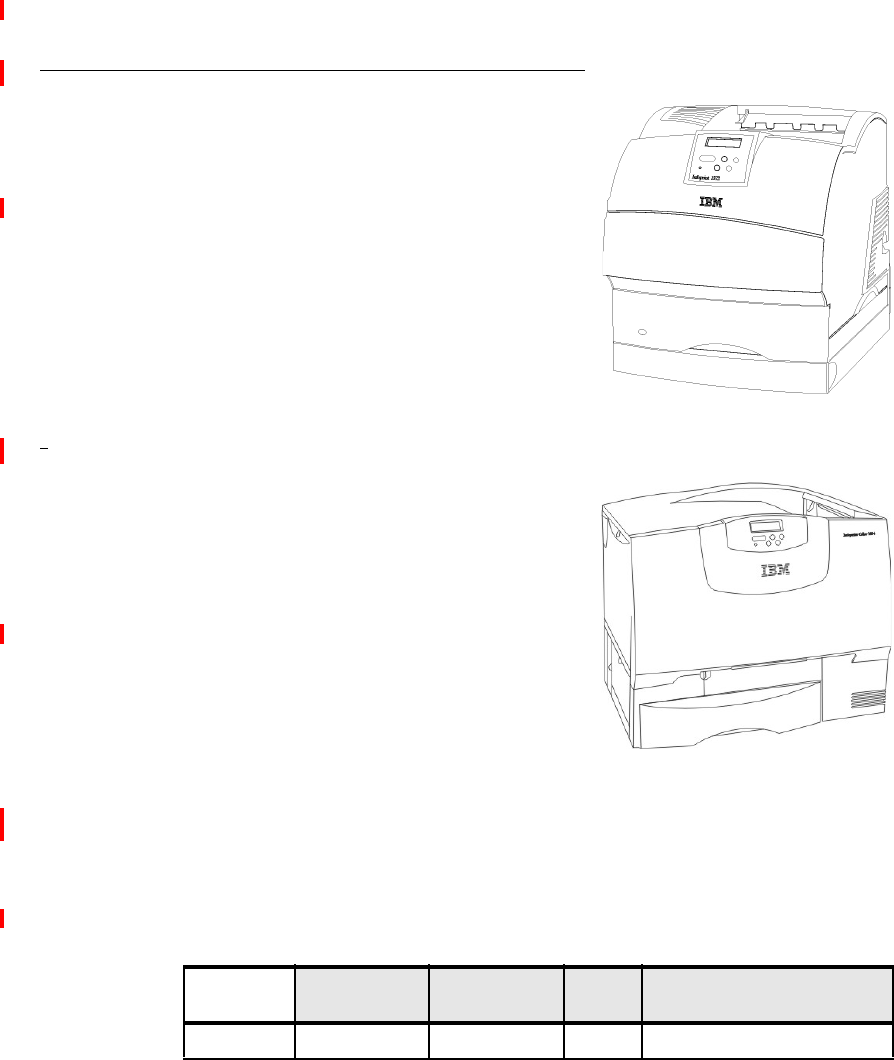
196 i5 Handbook
cost-per-page and with a wide array of options.
IBM Infoprint 1572 Workgroup Laser Printer)
The IBM Infoprint 1372 provides
high-performance monochrome workgroup
laser printing with the memory and speed to
handle complex documents at a high
throughput rate.
IBM Infoprint Color 1454 and 1464 Laser Printer
The IBM Infoprint Color 1454 and 1464 are
high-value workgroup color printers that
provide high-speed printing for both color and
black-and-white jobs. The outstanding
performance, reliability and fast page delivery
of the 1454 and 1464 laser printers can help
workgroups become more efficient.
Multifunction printing options
MFP options enable you to protect and expand your printer investment by adding
scan, fax, and copy functions to IBM Infoprint 1000 series workgroup printers.
The following table summarizes current Infoprint MFP options.
MFP option Mono scan
(IPM)
Color scan
(IPM)
Duplex Printers supported
M22 15 14 N Infoprint 1332, 1352, 1372

I/O devices and other components 197
M26 23 14 Y Infoprint 1332, 1352, 1372
M30 23 14 Y Infoprint 1332, 1352, 1372, 1464
M32 34 19 Y Infoprint 1357
M35 40 N/A N Infoprint 1145
MFP option Mono scan
(IPM)
Color scan
(IPM)
Duplex Printers supported

198 i5 Handbook
System i5 departmental and production printers
In the same manner that the System i5 server scales up in performance, IBM
system printers provide a wide range of choices at midrange and production
printing speeds (generally 60 impressions per minute and up). These include
both cutsheet and continuous form printers, currently achieving up to 2200
impressions per minute (with the IBM Infoprint 4100). All of the departmental and
production printers feature the Advanced Function Common Control Unit
(AFCCU™), a high-performance controller using the same processor technology
as the System i5 servers.
IBM Infoprint 2090ES
The IBM Infoprint 2090ES is the 90
impression per minute member of the ES
midrange production printing family. This
cutsheet digital multifunction system
effectively combines high-speed System i5
production printing with full reproduction
capabilities.
IBM Infoprint 2105ES
The IBM Infoprint 2105ES is the 105
impression per minute member of the ES
midrange production printing family. This
cutsheet digital multi-function system
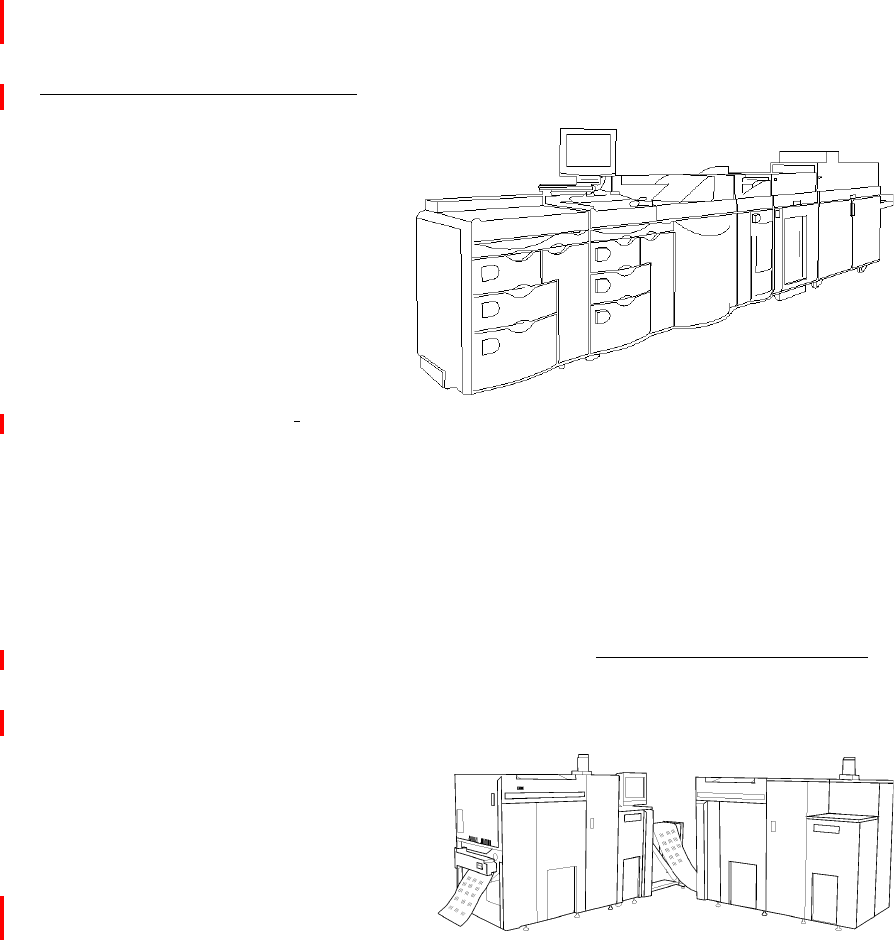
I/O devices and other components 199
effectively combines high-speed System i5 production printing with full
reproduction capabilities.
IBM Infoprint 2000(keep?)
Infoprint 2000 printers
bring cutsheet printer
capabilities to address
the output needs of an
On Demand Business.
This high-speed
cutsheet printer
combines advanced
hardware and software
technologies to provide
exceptional
performance, flexibility,
and control. Internet Printing Protocol (IPP) and is ready for On Demand
Business. IPP provides mobile users the means to address a printer from
anywhere, allows companies to provide their clients with direct access to their
printer, and provides notifications to communicate printer status.
Powered by an advanced imaging technology, Infoprint 2000 is designed to
monitor and self-adjust print quality as needed. Establishing new AFP/IPDS
benchmark print quality, Infoprint 2000 produces fine lines and offset-like
halftones. To ensure user-friendly paper support and reliability, the system has a
straight paper path, as well as three standard and three optional vacuum fed
paper drawers for preventing paper mis-feeds. In addition, IBM Infoprint 2000
IBM Infoprint 3000 Advanced Function Printing System
IBM Infoprint 3000 is a
high-speed,
high-resolution,
continuous-form
production printing system
designed and integrated
for high-volume System i5
printing. geFull application
enablement includes
system printer file function, DDS, Infoprint Designer for iSeries, AFP Utilities,
Advanced Print Utility (APU), Page Printer Formatting Aid (PPFA/400), AFP
Toolbox, and many other IBM and third-party document composition products.

200 i5 Handbook
With high-volume applications such as reports, statements, documents, and
direct mail, continuous-forms printing ensures high reliability. They also ensure
the attachment of a wide variety of pre- and post-processing devices (paper roll
input, cutters, inserters, and so on) for a smooth end-to-end process. This is an
intelligent process that starts with blank paper and can end up a complete
package ready for mailing.
IBM Infoprint 4000 Advanced Function Printing Systems
Infoprint 4000 is a high-speed,
continuous-form production printer
family for System i5 servers.
Infoprint architecture provides higher
resolutions and support for PostScript
data streams to meet far more
wide-ranging organizational document
requirements, including the replacement
of applications that traditionally went to
offset printing. Driven by IBM AFCCU,
which provides high-speed processing
of complex documents, full IPDS function, and comprehensive connectivity
IBM Infoprint 4100 Advanced Function Printing Systems
The Infoprint 4100 offers continuous
forms printing with 19-inch wide print
line for digital publishing and
statements printing. Infoprint
architecture provides higher
resolutions and support for PostScript
data streams. This helps to meet far
more wide-ranging organizational
document requirements, including
replacement of applications that
traditionally went to offset printing.
Reduced total cost of printing
System i5 industrial printers
Central to today’s supply chain environments, System i5 industrial printers are
designed for harsh environments and multi-part form applications. The printer
technology is either dot matrix or line matrix. IPDS is supported throughout, both

I/O devices and other components 201
for complete print management and graphics function (for example, barcodes).
This category includes the IBM 4232, IBM 4247, and IBM 6400 printer families.
IBM 4247 MultiForm Matrix Printer)
The 4247 printers are desktop
model impact printers. They
include two continuous paper paths
and a standard manual cutsheet
input.
The 4727 can be used as a directly
attached workstation printer, as a
system printer, remote or
distributed, or for departmental
printing. Supported applications
include word processing and spreadsheets, business graphics such as pie
charts, barcode printing, line drawings from CAD/CAM applications, and special
forms for checks, labels, and mailers.
202 i5 Handbook

203
Software

Software

© Copyright IBM Corp. 1997 - 2006. All rights reserved. 205
Chapter 16. i5/OS: Architecture
After you buy an System i5 server, you do not have to continue shopping for
system software components before the server is ready to run your business. All
of the software factors for a relational database, comprehensive security,
communications with a broad range of diverse systems, including Internet
capabilities, and many more components are already in the operating system.
Each is fully integrated into i5/OS. All components and prerequisites for running
business applications in the 21st century are fully tested and work. i5/OS
operates as a single entity.
The System i5 operating system is architected as a single entity. This means that
such facilities as relational database, communication and networking capabilities,
online help, Web enablement technologies, easy enterprise management, and
much more are fully integrated into the operating system and the machine. The
user communicates with all components of i5/OS using a single command
language Control Language (CL) or administers and manages the system using
a graphical user interface (GUI).
16
Note: This chapter provides an overview of i5/OS at V5R4. In this Handbook,
the term i5/OS is used to include V5R4 and previous releases, unless
otherwise noted.
IBM i5/OS for V5R2 and earlier versions is called OS/400.

206 i5 Handbook
i5/OS provides the industry’s foremost application flexibility with support for
System i5, Linux, Windows 2000, Java, and UNIX applications. It combines high
availability with superior workload management and logical partitioning. The next
generation of applications can be quickly deployed and managed in a single,
partitioned server alongside current business applications.
With i5/OS, a business can simply and rapidly deploy applications for On
Demand Business with seamless integration of existing applications and data.
With extensions to its robust security and networking options, i5/OS enables
business-to-business (B2B) connectivity through the supply chain and to clients.
This chapter describes the capabilities and enhancements integrated into the
System i5 operating system which enable System i5 as servers in a
network-centric design. Features of the operating system product itself are
described in “i5/OS (5722-SS1): Operating system licensed products” on
page 235.
V5R4 i5/OS highlights
Improved application portability with new Java™ Virtual Machine
Improved security and compliance with integrity protection, network intrusion
detection, and auditing enhancements
Improved integration with Web applications
Simplified application development with free-format SQL in RPG applications
Improved workload management with enhancements to i5/OS subsystems
Support for SNA applications over IP networks with Enterprise Extenders
Simplified Web administration and performance management
Simplified database performance management and index maintenance
Enhanced capabilities and simplified management of business continuity
solutions
Improved management and retention of printed information
Enhanced cluster resource services for high availability
Networking enhancements including establishment of VPNs through network
address translation (NAT) firewalls and additional IPv6 support

i5/OS: Architecture 207
i5/OS base functions
i5/OS is a 64-bit operating system. With its base function, i5/OS provides ease of
implementation, management, and operation in one totally integrated
object-oriented operating system. The integrated features are:
Advanced GUI support to provide for:
– Easy setup and management of the system, including TCP/IP functions
– Database functions
– User and printer job administration
– System management
– Software distribution
– Performance monitoring
– Centralized management of multiple systems
– Plug-in support for Domino, Backup Recovery and Media Services
(BRMS), and others
Network computing
IFS with industry standards
Multiple operating environments and logical partitions (LPARs)
– Different versions and releases of i5/OS and OS/400
–Linux
–AIX 5L
– OS/400 Portable Application Solutions Environment (PASE)
– Resource sharing
Clustering and shared resources
High system availability
Client/server connectivity
DB2 Universal Database (UDB) for iSeries
Transaction processing
Batch processing
Extensive run-time applications
Openness standards
PM Eserver iSeries
Electronic Customer Support (ECS)
Note: i5/OS V5R3 is the required operating system release level for all
Eserver i5 or System i5 systems. i5/OS V5R3, OS/400 V5R2 and earlier
releases are supported on earlier System i5 servers. See “i5/OS overview” on
page 237 for further information and “Today’s System i5 summary” on page 47
or “Summary of earlier AS/400, AS/400e, and iSeries models” on page 449 to
identify the minimum operating system level of a specific system.

208 i5 Handbook
Comprehensive security for system resources
Interfaces to system functions
Connectivity to remote devices, systems, and networks
Office services
National language versions and multilingual support
Each function of i5/OS follows a consistent design philosophy. This consistency
is one of the cornerstones of System i5 ease of use. Ease-of-use translates into
higher productivity for its users and easier systems management.
Linux on System i5
Linux enables a stream of applications for On Demand Business to complement
the strengths of the System i5 as an integrated core business solution. Linux
inherits important strengths and reliability features of the System i5 architecture.
i5/OS is enhanced to support Linux running in a secondary LPAR. The primary
partition must run OS/400 V5R1 or later. Up to 31 Linux partitions are supported,
depending on the System i5 model. The Eserver i5 and System i5 Models 520,
550, 570 and 595 running i5/OS support from 2 to 254 partitions based on the
model.
Processor features for iSeries Models 270, 800, 810, 820, and 840 using SSTAR
technology, iSeries Models 825, 870, and 890 using POWER4 technology, and
Eserver i5 Models 520, 550, 570, and 595 POWER5 technology-based
processors, allow Linux to run in a shared processor pool, where one processor
can be shared between four IBM i5/OS, OS/400, and Linux partitions. On n-way
processor features for iSeries Models 820, 830, and 840 with ISTAR technology,
Linux requires a minimum of one processor per Linux partition.
The System i5 extends support for Linux on the Integrated xSeries Server,
feature #4811/#4812/#4813/#9812/#9813.
For details about supported operating systems and xSeries models, refer to the
Web site:
http://www.ibm.com/servers/eserver/iseries/integratedxseries
Linux on the System i5 can be implemented as either hosted or non-hosted. In a
hosted environment, Linux uses virtual resources (such as disk, tape, CD-ROM,
and LAN), which are owned by an i5/OS partition and shared with the i5/OS
partition. Linux is started from the hosting i5/OS partition by varying on a network
server description (NWSD).
An i5/OS partition can host multiple LPARs subject to appropriate capacity
planning.

i5/OS: Architecture 209
In a non-hosted environment, the Linux partition does not depend on a hosting
i5/OS partition for any input/output (I/O) resources. The LPAR has its own disk
units or the partition uses networking support to perform a network start.
You can start a non-hosted LPAR can be started even if the primary partition is
not fully active. You can start it from the Work with Partitions Status display. The
non-hosted LPAR has its own resources defined to it.
Virtual I/O in a Linux partition
Virtual I/O resources are devices owned by the hosting i5/OS partition that
provides I/O function to the LPAR. The System i5 Linux kernel and i5/OS
supports several different kinds of virtual I/O resources:
Virtual console
Virtual disk unit
Virtual CD
Virtual tape
Virtual Ethernet
Directly attached I/O in a Linux partition
With directly attached I/O, Linux manages the hardware resources directly. All I/O
resources are under the control of the Linux operating system and i5/OS or
OS/400 does not see the devices and cannot directly use them. Input/output
processors (IOPs) are not used with direct I/O..
The Linux console is a PC connected to the System i5 primary or hosting
partition via a TCP/IP LAN. Operations Console with LAN Connectivity (a
function of iSeries Access) is required to establish a secure connection to i5/OS.
A Telnet environment is then used to connect into the Linux environment through
the Virtual Ethernet. The console is used for installation and problem
determination operations. There is no console adapter in the Linux partition.
The System i5 processors, based on IBM POWER5+ technology, are capable of
running POWER Linux distributions. Linux for iSeries product upgrades, support,
Note: Linux is not part of i5/OS or OS/400. Therefore, it must have its own
partition of the system processor resources segregated from i5/OS and
OS/400.

210 i5 Handbook
and maintenance are available directly from Linux distributors. Red Hat and
Novell (SUSE) offer POWER Linux distributions for the System i5.
Linux integration with i5/OS
The following products help to integrate Linux and the System i5:
iSeries Open Database Connection (ODBC) driver for Linux
For further information and to download the product, go to:
http://www-1.ibm.com/servers/eserver/iseries/linux/odbc/
iSeries Access for Linux
For more information and to download the product, see:
http://www-1.ibm.com/servers/eserver/iseries/access/linux/
Grid Toolbox V3 for Linux on iSeries (5733-GD1)
For further information, see:
http://www.alphaworks.ibm.com/tech/gridtoolbox
WebSphere Application Server Express for Linux (5733-WL1)
WebSphere Application Server Express for Linux is a tightly integrated
development tool and application server that provides an easily affordable
entry point to On Demand Business for companies creating dynamic Web
sites. It is available on the 570, 810, 825, 870, and 890 Enterprise Editions
(otherwise orderable via Passport Advantage).
Suggested reading
For additional information about Linux, see the following Web site:
http://www.ibm.com/eserver/iseries/linux
XML enablers
XML is a key technology for B2B solutions that links together trading partners
and pervasive computing applications, which connect mobile devices such as
cell phones to core business solutions.
The XML application enablers provided in i5/OS include:
XML parsers for use with Java and C++ applications
XML parsers are a common building block that XML-based solutions use to
work with data in XML format.

i5/OS: Architecture 211
XML parsing interfaces for procedural languages such as RPG, COBOL,
and C
An XSL processor used to apply XSL stylesheets to transform an XML
document into another markup language format
System i5 system support for XML is delivered through IBM XML Toolkit for
iSeries (5733-XT1).
For more information, search on “XML Toolkit” at:
http://publib.boulder.ibm.com/infocenter/iseries/v5r4
IBM Java for System i5
Java is the environment of choice for programming in today's network computing
environment. It allows true portability of applications between platforms without
modification or recompiling. System i5 servers are uniquely positioned to
leverage Java as it evolves from its current Web focus to a full commercial
application environment. The strengths of the System i5 server are combined
with Java's object-oriented, network computing technology to provide solutions in
this millennium.
Java is a key application development environment for the System i5 server. The
Java virtual machine (JVM™), which resides below the Machine Interface,
enables fast interpretation and execution of Java code on the System i5 servers.
A class transformer enables the direct execution of Java on the system without
the overhead of interpretation.
A new Java Virtual Machine (JVM) technology is included in i5/OS V5R4. This
new JVM technology is common on all IBM platforms and has improved its
capability to be modular, flexible, and reliable. For i5/OS operating system, this
32-bit JVM provides a much smaller memory footprint that especially benefits
small to medium business (SMB) applications on smaller servers. This new JVM
supports JDK 1.5 and does not require any code change for the vast majority of
pure Java applications. The existing JVM remains in i5/OS as a highly scalable
JVM for JDK 1.3, 1.4, and 1.5.
Java is a complete computing environment, reaching new standards for program
portability and programmer productivity. Java provides an object-oriented
programming environment that is dramatically simpler than C++. iSeries Java
implementation provides improved scalability compared to other Java platforms
and synergy with the System i5 object-based architecture.
Because of its portability, Java is the programming language for On Demand
Businesses. And the System i5 system support for Java is the best of breed.

212 i5 Handbook
Components
Java support on the System i5 is delivered in the following components:
IBM Developer Kit for Java (5722-JV1)
IBM Toolbox for Java (5722-JC1)
Incremental enhancements have been made to the most popular components of
the Java Toolbox, and several new components have been added.
New components include:
SaveFile component enables Java applications to work with "save files”
located on the server. The Subsystem component similarly enables
applications to query and manipulate subsystems.
SignonHandler feature enables applications to plug in their own customized
signon GUIs for use when the Toolbox needs to prompt for missing or
changed signon information.
Enhanced JDBC functions:
Numerous enhancements to JDBC exploit recently introduced DB2 enhance-
ments, including:
2 MB statement size
128-byte column name support
Database host server trace support
eWLM Correlator support
The JarMaker utility, which produces stripped-down versions of the Toolbox JAR
file, is enhanced for improved effectiveness and usability.
Both are included with every i5/OS V5R4. See “IBM Toolbox for Java (5722-JC1)”
on page 291 and “IBM Developer Kit for Java (5722-JV1)” on page 292 for
product information.
i5/OS integrated functions
The following sections list the functions that are integrated into the i5/OS
operating system.
NetServer: File and print serving
For additional information, refer to:
http://www.ibm.com/servers/eserver/iseries/netserver

i5/OS: Architecture 213
Network printing support
Host print transform
Printer load balancing
Business continuity
With a new virtualization capability for backup/restore operations, you can create
virtual tape devices that enable reliable, high-speed backups directly to disk
using your normal save/restore functions. This function can reduce the
scheduled save windows, enabling increased scheduled production hours of
operation. Virtual tape files can then be moved from disk to physical tape
cartridges while end-user applications are in production. Other save/restore
enhancements include:
Ability to directly back up and recover spool files
Use of parallel save and restore for files in the integrated file system
Avoiding downtime associated with a periodic SAVSYS
Dual parity support within a disk array (RAID6) ensures a new level of data
protection for continued operation even if two units fail in a RAID protected set of
disks with appropriate hardware. System i5 SAN support is simplified, enabling
additional options for IBM TotalStorage® copy services. Other enhancements to
availability include improved IPL recovery and journal performance and recovery.
Enhancements to cluster services include additional ease of use in managing
critical resources in a highly available environment. With the new cluster
administrative domain you can easily maintain the operational environment for
business applications across a system cluster to ensure consistent application
results. You can designate that certain configuration objects, environmental
attributes, and system values be maintained so that they have the same values
across the administrative domain. If a change is made to one of these values on
any node in the administrative domain, that change is propagated to all other
administrative domain nodes.
A new type of cluster resource group supports additional application and
management models such as stateless Web serving. The Peer CRG supports an
environment where multiple nodes are involved in the recovery domain for a
resource without the use of a primary or backup. All nodes in the recovery
domain are equal in role and can provide access for the associated resources.
Data resilience technologies are enhanced. To help ensure that all critical objects
are covered by the logical replication process, you can designate that new
objects added to a library be automatically journaled. If you use cross-site
mirroring, changes made on the source are tracked when geographic mirroring is
suspended. This ability helps eliminate situations where complete

214 i5 Handbook
resynchronization between source and target needs to be done. Several new
commands enable additional mechanisms to monitor and manage IASPs. For
example, you can observe the IASP vary on progress details.
Communication and networking
This section discusses the communications and networking features.
Connectivity to remote devices, systems, and networks
i5/OS offers many integrated capabilities and functions that enable
communications with a variety of IBM and non-IBM systems, either in batch or
interactive modes. Worldwide standard TCP/IP or the traditional SNA hierarchy,
as well as SNA peer networks and Systems Application Architecture® (SAA®)
standards, are supported and offer the greatest flexibility possible in network
design.
With V5R4, i5/OS offers the second stage of a multistage delivery of IPv6
function. This release has an IPv6-capable TCP/IP stack that removes many of
the restrictions that existed in the V5R2 and V5R3 IPv6 application development
platform. Restrictions on the number of adapters that can support IPv6 are
removed, and all Ethernet adapters including 10/100 MB, Gigabit, 10 Gigabit,
and Virtual Ethernet can be used for IPv6 traffic. In addition, adapters can be
shared between IPv4, IPv6, and PPPoE. Previously, separate Ethernet adapters
were required to run IPv4, IPv6, and PPPoE concurrently. Along with the ability to
share IPv4 and IPv6 over the same adapters, the i5/OS TCP/IP stack also
includes the dual stack transition mechanism, which enables a server application
to be developed on i5/OS that can seamlessly support both IPv4 and IPv6 clients
simultaneously.
The need for other solutions is driven by forces such as networking equipment
providers' discontinuance of adapters capable of carrying SNA traffic natively.
Enterprise Extender, using a widely supported industry standard, allows most
SNA-based applications to communicate over an IP network. Enterprise
Extender is a strategic replacement for AnyNet® on i5/OS for those who have
adopted TCP/IP as their networking infrastructure but need to protect their
investment in SNA-based applications. Enterprise Extender offers more
capabilities than AnyNet with complete APPN® function, the ability to
transport alerts, and the ability to support Dependent LU sessions to host
systems, when used in conjunction with the Dependent LU Requester
support on i5/OS.
Virtual Private Network (VPN) support on i5/OS is enhanced to establish
VPNs that traverse one or more network address translation (NAT) firewalls.
Previously, i5/OS VPN provided this ability when the i5/OS is the
client/initiator of the VPN connection. Now, VPN support enables VPN NAT

i5/OS: Architecture 215
traversal when i5/OS takes the role of the server/responder of the VPN
connection. With this enhancement, i5/OS VPN support provides a complete
solution for allowing VPNs through NAT firewalls.
Improvements to checksum processing include support for TCP/IP checksum
offload when running over Gigabit and 10 Gigabit Ethernet adapters that
support this feature. Enhancements are also made in the TCP/IP stack for
optimizing TCP/IP checksum processing.
Ability to define virtual IP addresses and assign the adapters allowed to
perform Proxy ARP functions on behalf of virtual IP addresses. You can
assign an alias name to a local IP interface. This function, along with CL
command capabilities, enables you to change IP address assignments
without having to change associated CL commands (for example, those
defining network configurations or for starting and ending local IP interfaces).
Network management facilities
Several communications and systems management functions are available to
manage System i5 servers. Some are integrated into i5/OS, and some are
separately-priced features. These functions help manage and control local
systems and distributed systems that operate within a network controlled by a
host system or by another System i5 server.
Network management functions available for the System i5 server include:
Systems management in TCP/IP networks
Alerts support to NetView®, System/36, System/38, System i5
Distributed System Node Executive (DSNX)
Security
The many levels of security available with i5/OS eases the job of system security
management. The five levels of security range from minimal to an enhanced level
that enables the System i5 servers to operate at the C2 level of trust as defined
by the United States Government. Security foundation offered with i5/OS
includes system integrity with digital signature and object signing, a Digital
Certificate Manager (DCM), and password protection.
System i5 security has been enhanced with the addition of an intrusion detection
system and a new line of defense to protect data. The new i5/OS intrusion detec-
tion system notifies you of attempts to hack into, disrupt, or deny service. The
function consists of a shared policy file parser with the Quality of Service (QoS or
*QOS) TCP server that organizes and acts upon the conditions and actions from
the parsed IDS policy file. Types of intrusions that are caught, discarded, and
audited include:

216 i5 Handbook
Attacks: Malformed packets, IP fragments, SYN floods, restricted IP
protocols, restricted IP options, perpetual echoes, and ICMP redirect
attempts
Scans: Scan events that are either classified as single isolated events or as
part of a global scan
Traffic regulation: Events that are statistically analyzed to determine that
either a TCP or UDP interface might be the subject of a denial of service
attack
Intrusion Monitor (entry type: IM) records are cut in the system audit journal
(QSYS/QAUDJRN) for all of the listed intrusions based on an existing IDS policy
file and threshold values.
New line of defense added to protect data: All supported systems have enhanced
hardware storage protection (HSP) capabilities. This stronger HSP "force field" is
applied to most machine interface (MI) objects, even those that were created on
previous releases.
Hardware checks every attempted access against the protection attributes
assigned to that particular storage.
Only directly addressable spaces retain previous protection attributes that are
appropriate to the direct nature of their intended uses. The encapsulated part
of spaces are newly protected.
All other objects, including database record and file system containers, are
given stronger protection and are accessible only to Licensed Internal Code
(LIC).
Nothing changes for valid programs because LIC already accesses MI objects on
their behalf. In contrast, now even altered programs are denied back-door
access.
See Tips and Tools for Securing Your iSeries, SC41-5300, for information about
System i5 security implementation.
Network security
i5/OS includes many ways to secure network connections and transactions
between other servers and clients. The strategic methods include:
Secure Sockets Layer
Digital Certificate Management
A digital certificate is an electronic credential to establish proof of identity in
an electronic transaction. Digital certificates are increasingly used to provide
enhanced network security measures. They are essential to configure and
use the SSL to secure connections between users and server applications

i5/OS: Architecture 217
across an untrusted network, such as the Internet, by protecting such key
data as user names and passwords. Many System i5 services and
applications (including FTP, Telnet, and HTTP Server for iSeries) provide SSL
support to ensure data privacy.
i5/OS provides extensive digital certificate support to use digital certificates
as credentials with SSL or for client authentication in both SSL and virtual
private network (VPN) transactions. Digital certificates can also sign objects,
making it possible to detect changes or possible tampering to object contents.
The Digital Certificate Manager allows the creation and management of
certificates on the System i5 and those obtained from another Certificate
Authority (CA).
Enterprise Identity Mapping (EIM)
EIM for iSeries is the i5/OS implementation of an IBM infrastructure intended
to solve the problem of managing multiple user registries across an
enterprise. The need for multiple user registries evolves into a large
administrative problem that affects users, administrators, and application
developers. EIM enables inexpensive solutions for easier management of
multiple user registries and user identities in your enterprise.
EIM allows the creation of a system of identity mappings called associations,
between the various user identities in various user registries for a person in
your enterprise. It also provides a common set of APIs. They can be used to
develop applications that use these identity mappings to look up the
relationships between user identities across platforms.
In conjunction with network authentication service, the i5/OS implementation
of Kerberos, EIM provides an SSO environment that is managed and
configured though iSeries Navigator.
Network Authentication Service
Network Authentication Service allows the System i5 server and several
System i5 services, such as iSeries Access for Windows, to use a Kerberos
ticket as an optional replacement for a user name and password for
authentication. The Kerberos protocol, developed by Massachusetts Institute
of Technology (MIT), allows a principal (a user or service) to prove its identity
to another service within an unsecure network. Authentication of principals is
completed through a centralized server called a Kerberos server or key
distribution center (KDC).
Virtual private networking
VPN allows a company to extend its private intranet securely over the existing
framework of a public network, such as the Internet. It controls network traffic
while providing important security features such as authentication and data
privacy.

218 i5 Handbook
i5/OS VPN is an optionally-installable component of iSeries Navigator. It
allows the creation of a secure end-to-end path between any combination of
host and gateway. i5/OS VPN uses authentication methods, encryption
algorithms, and other precautions to ensure that data sent between the two
endpoints of its connection remains secure.
IP filtering and Network Address Translation (NAT)
IP filtering and NAT act as a firewall to protect internal network from intruders.
With IP filtering, IP traffic is controlled by filtering packets according to rules
that are user-defined. NAT allows the hiding of unregistered private IP
addresses behind a set of registered IP addresses. This serves to protect
internal networks from outside networks. NAT also alleviates the IP address
depletion problem, since many private addresses can be represented by a
small set of registered addresses.
DB2 Universal Database for iSeries
DB2 UDB for iSeries offers state-of-the-art database
functions and open systems, standards-based
technology, while providing the maturity, stability, and
ease of use that is the trademark of the System i5
server. It is not a separate product. DB2 UDB for
iSeries is fully integrated into i5/OS software.
The fact that the database is integrated allows the
operating system to control some of its management
functions and makes it easier to maintain than competitive database from other
vendors reducing the need for a dedicated database administrator. Its security
functions are integrated into the operating system. These functions allow a better
security model than other databases where additional tools may need to be
purchased to provide these functions.
Many System i5 clients have the need for applications that access both DB2 UDB
for System i5 data and data on other databases platforms such as Oracle or
Sybase. The SQL Client Integration application programming interface (API)
allows providers of gateways and client/server solutions to integrate their
products with DB2 UDB for iSeries.
DB2 UDB for iSeries can be used for both transaction processing and complex
decision support applications. Advanced parallel processing and advanced query
optimization techniques support queries of large decision support databases for
applications such as business-to-business, business-intelligence, customer
relationship management (CRM), and other applications for On Demand
Business.

i5/OS: Architecture 219
In an on demand world, standards and globalization are important for integration
and openness. Application portability through standards and the flexibility to
access the database via numerous client interfaces from Linux partitions and
Windows systems allows the application provider and the client the most
flexibility possible.
DB2 UDB for iSeries embodies that flexibility through the support of its traditional
database interface along with enhancing the Structured Query Language
(SQL)-based database required by today’s enterprise application systems.
Enhancements to the RPQ SQL pre-compiler help clients and independent
software vendors (ISVs) to more easily make use of both interfaces.
Features
Object-relational technology
DATALINK data type
DB2 UDB Extenders for iSeries
Advanced query optimization technologies
DB2 UDB family compatibility
Database SQL portability
National language support (NLS)
User-defined types
User-defined functions (UDF)
Declarative referential integrity
Column-level security
complete.
Two-phase commit transaction management
Data replication
Open Database Connectivity (ODBC) driver for DB2 UDB for iSeries
enhanced with ODBC 3.5 support and support for Microsoft Transaction
Server (MTS)
System-wide database catalog
Multiple-level concurrency control
Server consolidation
SQL enhancements
SQL Repeatable Read
Journaling and SQL DDL operation journaling (V5R1)

220 i5 Handbook
Open standards-based interoperability
Support for client/server environments is greatly enhanced in DB2 UDB for
iSeries by incorporating popular database standards and transmission protocols,
such as support for:
ANSI X3.135.1999, ISO 9075-1999, and FIPS 127-2 SQL
The Open Group’s Distributed Relational Database Architecture™ (DRDA®)
Distributed Unit of Work - Application Directed
Microsoft’s ODBC
Apple's Data Access Language (DAL)
XML
JDBC™
Object Link Embedded (OLE) DB and ADO
U.S. Government C2 security
UCS-2 (Unicode or ISO 10646)
Euro character support
Stored procedures
Tr igg e rs
Join operators
Enhanced SQL query support
X/Open's Call Level Interface (CLI) supported transmission protocols for the
System i5 include:
TCP/IP
Advanced Program-to-Program Communication (APPC)
Advanced Peer-to-Peer Networking® (APPN)
X/Open Call Level Interface to SQL
The integrated database is a full-function database with features competitive to
other widely used databases, reducing the need for a dedicated Database
Administrator. The fact that the database is integrated allows the operating
system to control some of its management functions and makes it easier to
maintain than a competitive database. With security built-into i5/OS, DB2 UDB
allows a better security model than other database where additional tools are
purchased to provide the security functions.
The SQL Client Integration API allows providers of gateways and client/server
solutions to integrate their products with DB2 UDB for iSeries. Many System i5
clients need applications that both access DB2 UDB for iSeries data, and access
data on other databases platforms such as Oracle or Sybase.

i5/OS: Architecture 221
Distributed database support
i5/OS supports distributed relational databases using SQL. Distributed database
support allows read and write access from an System i5 server to another
System i5 server or to any other database supporting the Open Group DRDA
architecture, including DB2 UDB for OS/390® and z/OS®, DB2 UDB for
Windows, and DB2 UDB for AIX.
High performance database server (centralized and distributed
server)
The high performance System i5 server and improvements in communication
performance combine to strengthen the position of the System i5 server as a
high performance database server. In addition, DB2 UDB for iSeries offers
enhanced performance for both centralized and distributed client/server
database access, making the System i5 the database server of choice for many
computing needs.
The following DB2 UDB for iSeries functions are available to enhance application
performance:
Advanced SQL optimizer
SQL encoded vector indexes (EVIs)
Explain function
Block INSERT and FETCH
Automatic record blocking
Parallel data access
Query Governor
Query tuning
Scalability
DB2 UDB for iSeries supports very large database environments. A single
table can be up to one TB and 4.2 billion rows. Distributed tables can be up to
32 TB.
DB2 Symmetric Multiprocessing (SMP) for iSeries and DB2 Multisystem
support enable both horizontal and vertical growth.
Database ease of use and management
The System i5 reputation for usability and maintainability is unsurpassed in the
industry. This is due in part to the tight integration of i5/OS and DB2 UDB for
iSeries. Users do not have to learn separate operating system and database
functions, nor are they burdened with maintaining the complex interfaces
between multiple layers of software. In addition to seamless integration, a rich set
of utilities continue to be provided for easy management of DB2 UDB for iSeries
databases.

222 i5 Handbook
New with i5/OS V5R4 DB2 Universal Database for iSeries
DB2 On Demand Performance Center, included with iSeries Navigator, allows
you to easily analyze and improve the indexing strategy on your system.
The "always on" diagnostic information in the SQL plan cache enables you to do
query performance analysis and comparisons from one point in time to another
without the overhead of a database monitor. With the DB2 Health Center, also
part of iSeries Navigator, you can track your environment against system limits,
including archiving of that information to do trend analysis.
Satisfies all of the core components of the 2003 SQL StandardDB2
Expands support of data warehouse workloads in V5R4
Delivers additional SQL Syntax to support OLAP functions, improved
Materialized Query Table support, and recursive common table expressions.
Has advancements in the DB2 code generation engine and enhancements in
the operating system and in the XML Extenders code
Has System Managed Access Path Protection (SMAPP) support for Encoded
Vector Index (EVI) and resiliency improvements to the database cross
reference file.
Journaling is also easier in V5R4 with automatic journaling of sequence objects
and automatic journal restart after database copies and restore processing.
Integrated file system
The IFS is a part of i5/OS that lets you support stream input, output, and storage
management similar to personal computer and UNIX operating systems. The IFS
treats the library and folders support as separate file systems. Other types of file
management support that have differing capabilities are also treated as separate
file systems.
Supported file systems within the IFS are:
Network File System (NFS)
QDLS
QFileSvr.400
QNetWare
QNTCQOpenSys
QOPT
QSYS.LIB
root (/)
UDFS
You can interact with any of the file systems through a common interface that
includes commands, menus, displays, and APIs. The interface is optimized for

i5/OS: Architecture 223
the I/O of stream data, in contrast to the record I/O provided through the data
management interfaces.
The IFS is a hierarchical directory structure that provides support for storing
information in stream files that can contain long continuous strings of data. It is a
common interface that allows users and applications to access not only the
stream files, but also database files, documents, and other objects that are
stored in the System i5 server.
Ease of installation, use, and maintenance with i5/OS
i5/OS is renowned for its ease-of-use and management. Some of these utilities
contributing to this notoriety include:
iSeries Navigator database (Database Navigator)
Online backup and restore
Object-level recovery
Roll forward and backward recovery
Audit trail
Performance tuning and trace
Operations Console
iSeries Models 800, 810, 825, 870, and 890 support a directly-attached or
LAN-attached full-function 5250 PC console that includes a graphical control
panel application.
Functions provided by Operations Console and Remote Operator and Control
Panel, are managed via the Hardware Management Console (HMC) for the
Eserver i5 and System i5 Models 520, 550, 570 and 595. To understand
equivalent functions to operations console for the Models 520, 550, 570 and 595,
refer to “Hardware Management Console” on page 315.
For further information about Operations Console, refer to “System i5 system
console solutions” on page 312.
Remote capabilities
The direct-attach Operations Console can serve as a gateway for a remote,
dial-in Operations Console. See “System i5 system console solutions” on
page 312 for details about Operations Console and cabling requirements.

224 i5 Handbook
Software requisites
Operations Console is a component of iSeries Access for Windows (known as
Client Access Express for iSeries in releases prior to OS/400 V5R2). The PC
must be running the Windows NT 4.0, 2000, or XP Professional operating system
to be supported. The LAN-attached Operations Console is supported on servers
with i5/OS V5R4, V5R3 and OS/400 V5R2 or V5R1.
EZ-Setup
EZ-Setup is part of the iSeries Access code, and is delivered on the Setup and
Operations CD-ROM which is shipped with all orders. An Operations Console
connection is required to set up TCP/IP if you are using a PC console. EZ-Setup
then uses a TCP/IP connection to communicate with the server.
EZ-Setup consists of two parts:
An interview process
The task list
Clients can complete the interview either on the Internet or on the PC where they
have installed iSeries Access. The output of this interview includes a setup
definition file that is used to customize the EZ-Setup task list. EZ-Setup also
requires a connection to the iSeries Information Center, either on the Internet or
locally installed.
iSeries Navigator
i5/OS provides iSeries Navigator, the premier System i5 user interface for
managing and administering your System i5 servers from your Windows desktop.
The iSeries Navigator interface is packaged as a component of iSeries Access
for Windows. No license is required.
iSeries Navigator provides wizards that help simplify System i5 management for
a wide variety of functions including security, TCP/IP services, applications, and
more. You can customize the powerful iSeries Navigator displays to optimize your
productivity.
iSeries Navigator includes Management Central, a technology for doing systems
management tasks across one or more servers simultaneously.
Using an Internet capable cellular phone, personal digital assistant (PDA) with a
wireless modem, or a Web browser, the administrator can monitor and manage
their System i5 server status and performance metrics on the System i5 servers.
This includes task scheduling, real-time performance monitoring, managing
fixes, distributing objects, and running commands from a central system.

i5/OS: Architecture 225
Systems management tasks can be requested on multiple servers with just one
request.
Refer to the iSeries Navigator for Wireless Web site for more information about
Management Central-Pervasive:
http://www-1.ibm.com/servers/eserver/iseries/navigator/pervasive.html
Availability and recovery
Many functions are available to help maintain the availability of an System i5
server. They include:
System Managed Access Path Protection (SMAPP)
Uninterruptable power supply
Redundant Array of Independent Disks (RAID)
The System i5 provides disk protection and availability. RAID-0, RAID-1 (disk,
controller, and bus level protection), RAID-5, and RAID-6 are supported.
Concurrent maintenance of disks is also supported.
Journaling
Commitment control
Batch journal caching
Save-while-active (SWA)
Save/restore to multiple tapes concurrently
Print/Output Management
Native save/restore spool file gives you a better, faster method of saving and
restoring spool files to and from backup media. It saves and restores all
attribute information and spool file identity information. Auto deletion of spool
files includes a tool that enables you to more easily clean up unnecessary
spool files, reducing the number of spool files on an output queue. You can
use standard 2D barcodes in documents when printing them on ASCII
printers. You can also place constant text data anywhere on a page in a
document.
ASPs
IASP
Large capacity disk load balancing
Teraspace storage
Expert Cache
Note: All I/O, not just the disk in the I/O tower, are switched. Any LAN, wide
area network (WAN), workstation controllers, and so on in the I/O tower are
switched at the same time.
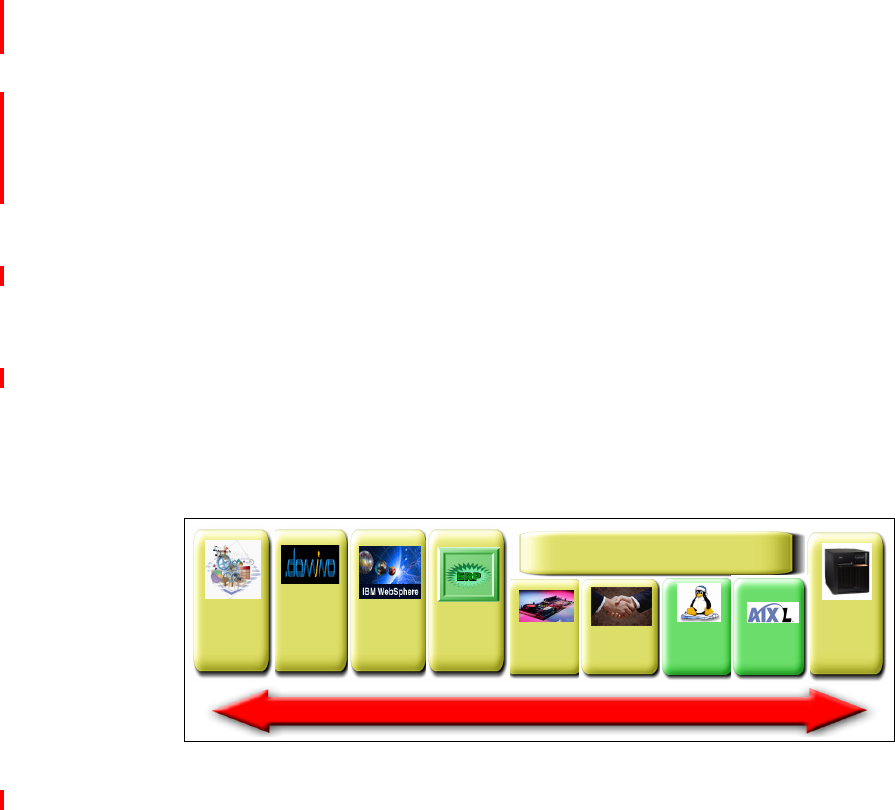
226 i5 Handbook
Integrated hardware disk compression
Integrated Hardware Disk Compression is supported by select DASD
controllers.
Compression is limited to user ASPs only.
Hierarchical Storage Management (HSM)
Concurrent maintenance
Concurrent maintenance of some components are feature or configuration
dependent.
Select models of 270, 250, 520, 550, 570, 595, 800, 810, 820, 825, 830, 840,
870, and 890 hardware also support concurrent maintenance.
Logical partitions
Logical partitioning enhances the role of the System i5 as a consolidated server.
With LPAR, companies have both the power and flexibility to address multiple
system requirements in a single machine to achieve server consolidation,
business unit consolidation, a mix of production and test environments, and
integrated clusters.
LPARs are ideal for companies that want to run varied workloads in a single
System i5 system. They allow the CPW performance of an System i5 system to
be flexibly allocated between partitions. Licenses can be managed across
partitions.
Each partition’s system name is distinct and the system values can be set
independently. Each partition can have a different primary and secondary
national language and can be operated using different time zones. This flexibility
is ideal for multinational companies to centralize operations in a single location,
yet retain the national characteristics of each system.
Interconnected for application enhancement
Integrated
xSeries
Server
Lotus
Domino e-business OS/400 PASE -
UNIX
Runtime
iSeries
Business
Applications LINUX
Application Porting
Consolidation/ASP
Business
Intelligence iSeries
Traditional
Applications
AIX

i5/OS: Architecture 227
LPAR allows for the simultaneous running of multiple independent servers, each
with its own system processor or (with V5R1 onward) with parts of shared
processors. Memory can be shared within a single System i5 server.
The System i5 LPAR capabilities have been improved with each release since
OS/400 V4R4. Enhancements with i5/OS V5R4 include:
Hardware Management Console
A Hardware Management Console (HMC) can be required for POWER5 and
POWER5+ processors implementing LPAR. HMC features a specific NetVista
workstation running Linux with preloaded HMC software to perform
multi-partition LPAR management function (and CoD) as well as console
functions. A single HMC supports up to 160 partitions and up to 32 servers. It
is supported in IBM Eserver i5 and System i5 Models 520, 550, 570 and 595
only.
Refer to “Product Previews” on page 40 to understand the future direction of
HMC.
Virtual Partition Manager
For more information about VPM, refer to the Redpaper Virtual Partition
Manager A Guide to Planning and Implementation, REDP-4013.
Dynamic creation and deletion of partitions
Partition shared processor resource specified as uncapped (Eserver i5 and
System i5 Models 520, 550, 570 and 595 only)
Idle processing resources may be used by that partition up to the number of
virtual processor specified.
Unallocated, powered off dedicated or newly added processor resources (via
CoD) can make part of a shared pool that is used by uncapped partitions
(Eserver i5 Models 520 and 570 only)
Software Licensed Management (SLM) APIs
A dynamic movement of processor, memory, and 5250 CPW performance
between partitions spreads the system workload to where resources are
needed, and potentially reduces the total amount of resource required on a
system.
The capability to support partial (fractional) processors was introduced with
V5R1. The number of partitions allowed per physical processor depends on
the processor type.
Note: HMC and VPM can only be used on the Eserver i5 systems. They are
not supported on earlier models.

228 i5 Handbook
Multiple operating system support
– i5/OS and OS/400
–Linux
–AIX 5L
– Windows (via Integrated xSeries Server or Integrated xSeries Adapter)
Multiple i5/OS and OS/400 versions within a partitioned environment on
appropriate systems
Virtual OptiConnect emulates external OptiConnect hardware by providing a
virtual bus between LPARs. To use Virtual OptiConnect, you only need to
purchase OptiConnect for OS/400. Additional hardware is not required.
iSeries Navigator support creates and manages partitions including a
scheduled movement of resources on non Eserver i5 systems.
LPAR partition support
LPAR specify features
The following feature codes relate to ordering LPAR on an System i5 Server:
#0006 LPAR Restrict Build Process
The #0006 LPAR Restrict Build Process feature is added to an initial order
where LPAR #0140 is requested. The #0006 feature instructs manufacturing
to only load SLIC on the minimum number of disk drives.
#0140 Logical Partition Specify
The #0140 Logical Partition Specify feature is used to specify that this system
will be logically partitioned.
#0142 Linux Partition Specify
The #0142 Linux Partition Specify feature is used to specify that this system
will be logically partitioned with a Linux partition.
#0145 AIX Partition Specify
The #0145 AIX Partition Specify feature is used to specify that this system will
be logically partitioned with an AIX partition.
#0454 LPAR Partition Initialization
The #0454 LPAR Partition Initialization enables a partition configuration and
assignment of resources as specified by the customer.
#0455 LPAR OS Preload
The #0455 LPAR OS Preload feature determines that the Operating System
specified by the customer (i5/OS or AIX 5L) for a partition is configured via the
#0454 LPAR Partition Initialization feature.

i5/OS: Architecture 229
#0496 Force i5/OS Preload
The #0496 feature preloads i5/OS on a new server whether partitioning is
specified or not. i5/OS is preloaded on all the disk drives in the ordered
configuration. It forces the preload of a single i5/OS partition when Linux or
AIX 5L partitions with virtual storage is configured.
#8453 Base Customer Placement:
The #8453 Base Customer Placement feature places hardware components
as directed by the hardware placement information from the LPAR Verification
Tool (LVT). The customer is responsible for submitting LVT information.
Suggested reading
For additional information about logical partitioning, see:
http://www.ibm.com/servers/eserver/iseries/lpar
http://www-1.ibm.com/servers/eserver/iseries/service/itc
http://www.redbooks.ibm.com/redpapers/pdfs/redp4013.pdf
System i5 clustering
A cluster is a group of independent servers that appears on a network as a single
machine. It is a collection of complete systems that work together to provide a
single unified computing resource.
Today, System i5 clusters enable you to set up an environment to provide
availability beyond 99.94% for critical applications and critical data. System i5
server high availability business partners and Solution Developers complete the
solution with easy-to-use cluster management, robust data resiliency, and
resilient applications that take advantage of the new technology.
IASPs offer significant functions that allow even more flexibility and improved
availability. Data residing in IASPs can be switched between servers using HSL
OptiConnect loop. IASPs allow you to take data offline and bring data online
independent of the system ASP and other user ASPs. IASPs also support:
Journaling of IFS objects, data areas and data queues, and options to reduce
the amount of data journaled
System services support of HA Switchable Resources, which allows use of
resilient device cluster resource groups that contain IASPs
HSL OptiConnect support as a cluster communications fabric
Note: Do not specify an #0496 feature if the Linux or AIX 5L partition has
dedicated disk controllers and drives are in the ordered configuration.

230 i5 Handbook
Options to adjust the tuning and configuration parameters of your cluster to
match better your communications environment
IBM Cluster Management Utility, which allows you to create and manage a
simple four-node, switched disk cluster
See IBM Eserver iSeries Independent ASPs: A Guide to Moving Applications to
IASPs, SG24-6802, and Independent ASP Performance Study on the IBM
Eserver iSeries Server, REDP-3771, for more information about IASPs.
Cluster Resource Services consists of an open set of APIs that provide cluster
facilities. System i5 application providers and clients use the APIs to enhance
their application availability and to create, configure, and administer the cluster.
Systems are defined into the cluster as cluster nodes. Communication interface
addresses are defined to form the cluster node-to-node interconnection links.
Resilient resources (objects replicated to one or more nodes) are associated with
a Cluster Resource Group (CRG) so they can be managed as a single unit.
Cluster Resource Services includes integrated facilities such as heartbeat
monitoring, reliable message delivery, switch-over administration, and distributed
activities. The services are built on a robust cluster topology and messaging
functions that keep track of each node in the cluster and ensure that all nodes
have consistent information about the state of cluster resources.
Heartbeat monitoring ensures that each node is active. When the heartbeat for a
node fails, the condition is reported so that the cluster can automatically failover
to the resilient resources on the backup node. System services for high
availability solutions are enhanced with real-time recording of IFS stream file
changes into journals. Data resiliency applications can use this function to
provide enhanced support for this class of objects.
System i5 clusters support up to 128 nodes. Any OptiConnect, WAN, and LAN
connectivity options can be used to build a cluster, as follows:
HSL copper and fiber bus connections are fully supported system features.
When used with OptiConnect software, they are attractive connectivity
methods for high-end and mid-range models existing in the same location.
IASPs and switched disk work in this environment as of V5R1.
ATM provides a high-performance connection to remote systems in the
cluster.
Ethernet and token-ring LANs are ideal for connecting low-end System i5
models into the cluster.
All systems are managed from a single workstation that contains the
high-availability business partner cluster management application. The required
minimum release of OS/400 to support each node in the cluster is V4R4.

i5/OS: Architecture 231
High Availability Switchable Resources installs as Option 41 of i5/OS. A
chargeable option of i5/OS, HA Switchable Resources provides the capability to
achieve a highly available environment using switchable resources (IASPs). The
resources are physically switched between systems so that only one copy of the
resource is required.
Additional capabilities in System i5 clustering include:
IASPs containing i5/OS DB2 library-based objects and output queues
Groups of IASPs that can be linked together
Thread relative naming for controlling job attributes
Multiple library namespaces that allow multiple databases and duplicate
library names across different namespaces
Clustered Hash Table Server for sharing and replicating of non-persistent
data between cluster nodes
Clustered Hash Table APIs for connection control, storage, and retrieval table
of entries, and generate keys and information about stored entries
Cluster GUI enhancements
On rejoin, cluster node ability to self start
Fully supported cluster commands
User control of automatic failover
Fully supported cluster commands
Suggested reading
For additional information about clustering, refer to the following Web sites:
http://www-1.ibm.com/servers/eserver/iseries/ha
http://www-1.ibm.com/servers/eserver/iseries/service/itc
iSeries Windows integration and Microsoft cluster support
The System i5 servers offer integration with Windows to support both simple and
complex Windows applications integration. This support is provided through the
use of the Integrated xSeries Server and the Integrated xSeries Adapter
offerings. Support for Virtual Ethernet LAN, Microsoft Cluster Services,
Automatic Cartridge Loader as well as additional tools help reduce the cost of
managing a Windows server environment. Some of these functions are
highlighted below.

232 i5 Handbook
Suggested reading
Refer to the following web site for additional information about Windows
integration as well as a list of currently supported xSeries servers.
http://www-1.ibm.com/servers/eserver/iseries/windowsintegration
Virtual Ethernet LAN
The Virtual Ethernet supports Integrated xSeries Servers and xSeries servers
attached with Integrated xSeries Adapters.
Microsoft Cluster Services
With the clustering support provided in Windows 2000 Advanced Server, two
Integrated xSeries Servers or two xSeries servers attached with Integrated
xSeries Adapters can form a cluster and use the 16 new shared storage spaces
available with OS/400 V5R2.
Auto Cartridge Loader
Clients who have systems with large amounts of data often have Auto Cartridge
Loader (ACL) tape devices (3570, 3580, and 3590) with the ability to
automatically load another tape cartridge. Support is now added in the Windows
integration support to handle commands for ACLs. Multiple tape cartridges can
be accessed during backup/restore operations initiated from the Windows server.
Attachment of n-way xSeries servers
The System i5 server supports the attachment of n-way xSeries servers via the
high-speed link.
iSeries Navigator support for Windows disk and user
management
GUI management and administration
This section discusses the i5/OS GUI management and administration functions.
Work Management
The Work Management function of i5/OS eases the job of systems management
by giving the operator control of the activities of a job and of its performance
characteristics. Work Management supports concurrent execution of batch jobs,
5250 CPW jobs, and non-conversational transactions on the system. Each job is

i5/OS: Architecture 233
protected from other jobs on the system. However, job-to-job communication is
allowed.
iSave/restore
Save is the capability of making a backup copy of objects or members on tape or
online save file. Restore is the capability to copy saved objects back to the
original or a different system.
Support for virtual tape devices has been added to base i5/OS V5R4.
Parallel save supported
Data is written to disk
Virtual tape volumes stored as type 2 IFS stream files.
Full BRMS support
For more information, see the High Availability and Clusters Web site at:
http://www-1.ibm.com/servers/eserver/iseries/ha
Graphical (GUI) management of a system
Performance collection and evaluation
Collection
CL application development language
i5/OS V5R4 continues to deliver enhancements to the CL application
development language.
Support for subroutines within a CL procedure
New pointer (*PTR) data type for CL variables
Ability to declare based (*BASED) variables whose storage depends on the
address of the basing pointer
Ability to declare defined (*DEFINED) variables whose storage depends on
the CL variable being defined over.
i5/OS system management functions include Simple Network Management
Protocol (SNMP) APIs and access to additional management information.
The SNMP APIs for managing applications have the ability to manipulate
management data via local or remote SNMP agents. Information can be
retrieved from systems on SNA or TCP/IP networks. This makes it easier to
discover and manage potential problems anywhere within the network.
234 i5 Handbook
Application programming interfaces
Hundreds of i5/OS APIs can provide access to functions and data not available
through any other interface or levels of performance not available through other
interfaces. These CLIs are intended for use by Solution Developers and IBM
Business Partners whose applications require these functions and data. You can
find a complete list in System API Reference, SC41-5801.
Extensive run-time application function
OS/400 is a functionally-rich platform for applications. Because it is enabled to
run a wide range of applications, clients can easily grow their application base as
their business needs grow. The extensive run-time function integrated into the
i5/OS licensed programs enables application programs created with these
languages, utilities, and support:
ILE RPG for iSeries
RPG/400®
IBM System/36-Compatible RPG II
IBM System/38-Compatible RPG III
ILE COBOL for iSeries
COBOL/400®
IBM System/36-Compatible COBOL
IBM System/38-Compatible COBOL
ILE C for iSeries
SAA AD/Cycle® C/400®
System C/400
VisualAge® C++ for iSeries
AS/400 BASIC
AS/400 Pascal
AS/400 PL/I
RM/COBOL-85 for the AS/400
The corresponding licensed programs are not required for systems that execute
the code.

© Copyright IBM Corp. 1997 - 2006. All rights reserved. 235
Chapter 17. i5/OS (5722-SS1): Operating
system licensed products
The computing industry is moving rapidly toward a network-centric world made
up of global networks. The newest release of IBM i5/OS builds on this to make
the System i5 servers key players in this vibrant and vital area.
This chapter describes the features and enhancements of the System i5
operating system product. The functionality and integrated capabilities of the
operating system are described in “i5/OS: Architecture” on page 205. Associated
licensed programs and enhancements are described in the following chapters of
this Handbook.
17

236 i5 Handbook
New with i5/OS V5R4
i5/OS is necessary for the IBM System POWER5+ technology-based hardware.
Consider it as an upgrade from previous versions of OS/400 to take advantage of
new and enhanced functions such as:
Improved application portability with new Java™ Virtual Machine
Improved security and compliance with integrity protection, network intrusion
detection, and auditing enhancements
Improved integration with Web applications
Simplified application development with free-format SQL in RPG applications
Improved workload management with enhancements to i5/OS subsystems
Support for SNA applications over IP networks with Enterprise Extenders
Simplified Web administration and performance management
Simplified database performance management and index maintenance
Enhanced capabilities and simplified management of business continuity
solutions
Improved management and retention of printed information
Enhanced cluster resource services for high availability
Networking enhancements including establishment of VPNs through network
address translation (NAT) firewalls and additional IPv6 support
IBM i5/OS (5722-SS1)
Version and release i5/OS V5R4
Software type Usage - Processor based
Software Subscription - Yes
IPLA - Yes
Keyed - Yes
Installation prerequisites None
Related products All
Client code Delivered as 5722-XE1, which is stored in an integrated file system
(IFS) directory and is downloaded to the PC
Replaces product 5722-JC1 (functions included in OS/400)
5769-SS1, 5716-SS1, 5763-SS1, 5763-VP1
Further information http://www.iseries.ibm.com/infocenter

i5/OS (5722-SS1): Operating system licensed products 237
i5/OS overview
i5/OS contains the base operating system, additional optional feature
components, and separate licensed programs bundled with the operating system
at no extra charge. The client can purchase advanced features and functions that
are not included in the base group of products shipped with the operating
system.
V5R4 of i5/OS provides system support for the following RISC models:
270
800, 810, 820, 825, 830, 840, 870, 890
SB2, SB3
520, 550, 570, and 595
9117-570 or 9119-590 servers configured with 1.65 GHz POWER5™
processor or 9119-595 server configured with 1.65 GHz or 1.9 GHz POWER5
processors
V5R4 of OS/400 is the final release supported on the following RISC models:
270
820, 830, 840
SB2, SB3
Refer to “Planning information” on page 41 for information about OS/400 and
processor compatibility.
Version 5 of OS/400 is offered for no additional charge. See “New with i5/OS
V5R3” on page 261.
The following sections briefly describe the components of i5/OS. Programs
offered within i5/OS are described in “Programs within i5/OS” on page 239. Refer
Note: V5R4 Licensed Internal Code requires more storage space on the load
source than in previous releases. A load-source disk unit of 17GB or largeris
required on each server or logical partition to upgrade to the V5R4 i5/OS or
V5R3 i5/OS with V5R3M5 Licensed Internal Code (LIC).
Important: Some functions of the operating system are available only on
newer hardware.
Note: V5R4 of OS/400 does not run on models of the AS/400 system based
on internal microprogram instruction (IMPI) processors (CISC models) and
some earlier RISC models
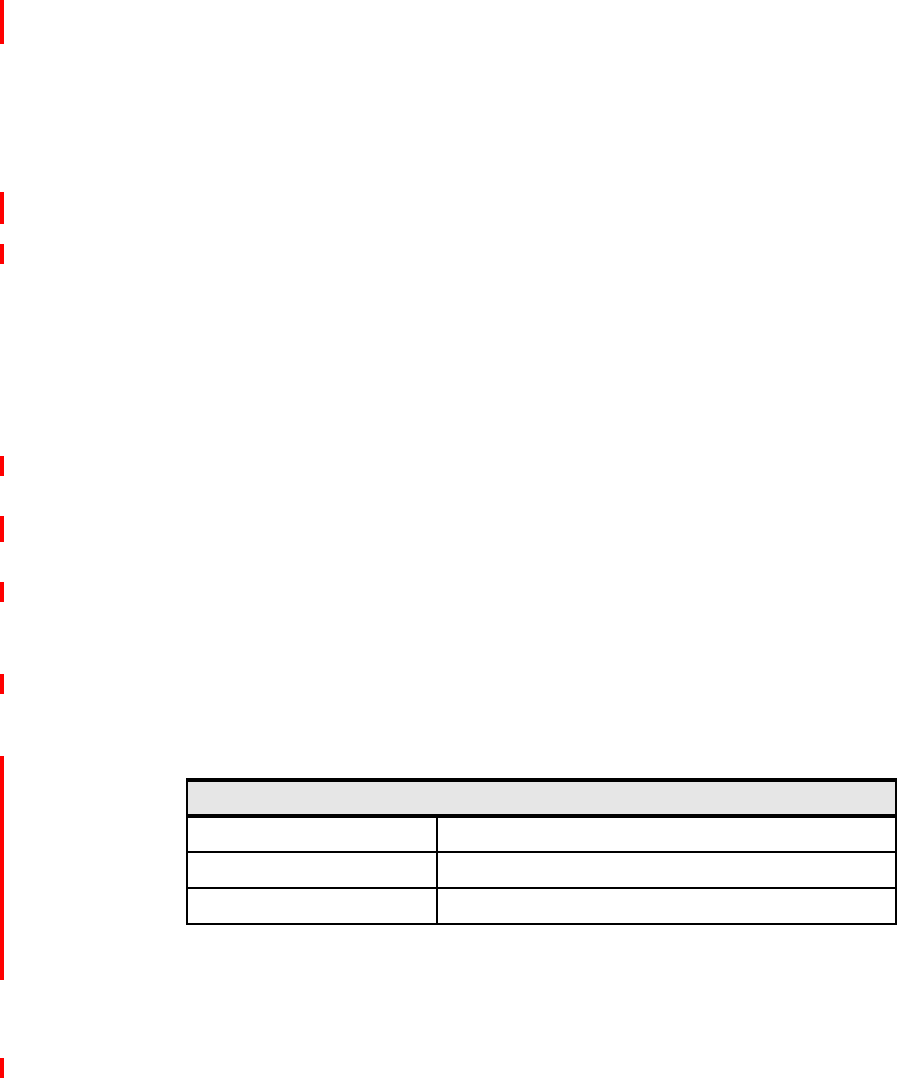
238 i5 Handbook
to “i5/OS V5R4 options” on page 246 for a list of all OS/400 options available at
i5/OS V5R4.
Version 5 of OS/400 is delivered on CD-ROM to speed loading of software and to
reduce the risk of media errors. All manuals are delivered in softcopy on
CD-ROM.
National language and multilingual support (5722-NLV)
The System i5 server with i5/OS is a worldwide product that addresses many
country (region)-unique requirements. For different countries (regions) and
languages, specific support is provided, either with translated machine-readable
information (MRI), such as screens and messages, or with keyboards and
displays on the local or remote workstation twinaxial controller.
Multilingual support allows multiple users on the same system to operate in
different languages. This means that system messages, displays, and help
information, as well as user applications, can be presented to the end user in
their national language.
Primary and secondary national languages
The national language in which licensed programs are ordered is considered the
primary national language.
Second languages in a single partition are known as secondary languages. Users
can switch among the languages as necessary. Multiple national language
versions can be installed on a single System i5 server. Regardless of the national
language version, all system commands are in U.S.A. English. Therefore, a
single set of system commands works in all national language environments.
Universal Coded Character Set support
Many clients do business in a worldwide environment. It is too costly and time
consuming to redesign and rewrite an application to support users in another
national language or culture. These applications require the ability to store and
process character data from more than one national language.
National Languages for i5/OS (5722-NLV)
Included in base Yes
Status Shipped with OS/400 as no charge feature
Further information http://www.iseries.ibm.com/infocenter

i5/OS (5722-SS1): Operating system licensed products 239
The Universal Coded Character Set (UCS) is an emerging global character
encoding, developed jointly by the industry (UNICODE 1.1) and the International
Organization for Standardization (ISO). ISO/IEC 10646-1 defines a code page
(UCS-2) encompassing the characters used by all currently significant
languages, a rich set of scientific and publishing symbols, and a variety of script
languages. This common code page spans the character sets of many
languages. It can ease application development and management issues
historically found in multiple code page system environments and networks. This
capability is provided in i5/OS with the UCS2 Level 1 support for database to
permit characters of any national language to “coexist” in database files.
Locale support of cultural values
Cultural values change from one national language to another. Examples of
cultural values are:
Date and time format
Currency symbol
Sort (collating) sequence
Euro currency support
Euro currency sign support is offered to those countries (regions) that are
currently supported in the System i5 national language structure, that are inside
and outside the European Monetary Units (EMU), and whose national standards
authorities have approved the appropriate standards. This support has been
available in OS/400 since V4R5.
Options and licensed programs offered with i5/OS
The following sections describe the options that can be ordered or ship with the
i5/OS operating system.
Programs within i5/OS
The licensed programs in the following table appear within the iSeries Software
Resources and Licensed Program menus as a separate product. Each is part of
the base i5/OS (product 5722-SS1). Each program ships with i5/OS
automatically with no additional charge and does not need to be ordered
separately.
The following programs are included with all i5/OS shipments:
5722-DG1 HTTP Server*
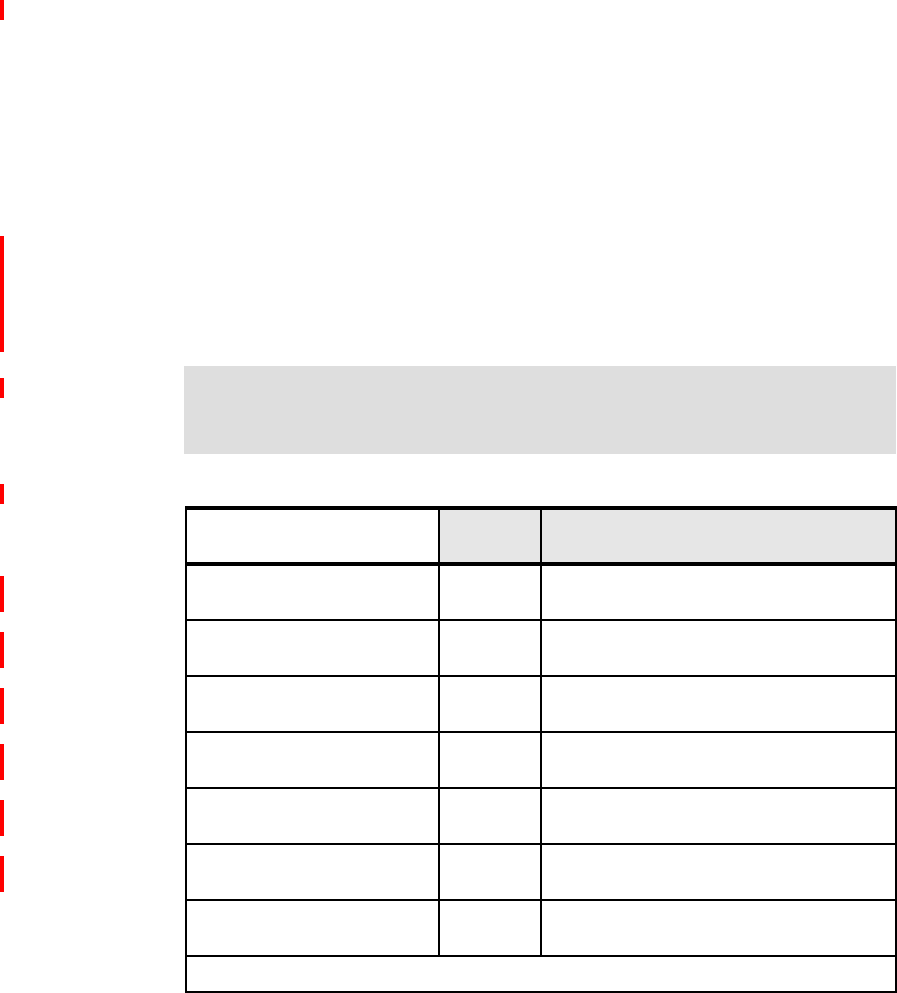
240 i5 Handbook
– Option 1 triggered Cache Manager
5722-IA1 Software Integration Assistant
5722-JC1 Toolbox for Java*
5722-JV1 Developer Kit for Java*
– Option 5 Java Developer Kit 1.3*
– Option 6 Java Developer Kit 1.4
– Option 7 Java Developer Kit 5.0
– Option 8 J2SE 5.0 32 bit
1TME-LCF Tivoli Management Agent*
5722-TC1 TCP/IP Utilities*
5722-XE1 iSeries Access for Windows*
5722-XP1 iSeries Access for Wireless
5722-LSV i5/OS Integration for Linux on xSeries
5722-BZ1 Business Solutions V1.0
Note: The previously listed software is included in the software order. Those
product and product options identified with an asterisk (*) are preloaded on all
new system orders.
Product name Product
number
For further information, see:
DB2 UDB for iSeries N/A Chapter 19, “IBM licensed programs: Database
accessories” on page 265
HTTP Server for iSeries 5722-DG1 “IBM TCP/IP Connectivity Utilities for iSeries
(5722-TC1)” on page 244
IBM Software Integration
Assistant for iSeries
5722-IA1 “IBM Software Integration Assistant for iSeries
(5733-IA1)” on page 322
TCP/IP Connectivity Utilities for
iSeries
5722-TC1 “IBM TCP/IP Connectivity Utilities for iSeries
(5722-TC1)” on page 244
i5/OS Integration for Linux on
xSeries
5722-LSV
iSeries Access for Windows
iSeries Navigator*
5722-XE1 Chapter 24, “IBM eServer iSeries Access
products” on page 305
Tivoli Management Agent 1TMELCF “IBM Tivoli Storage Manager Extended Edition
(5698-A11)” on page 718
* Formerly known as Client Access Express and Operations Navigator
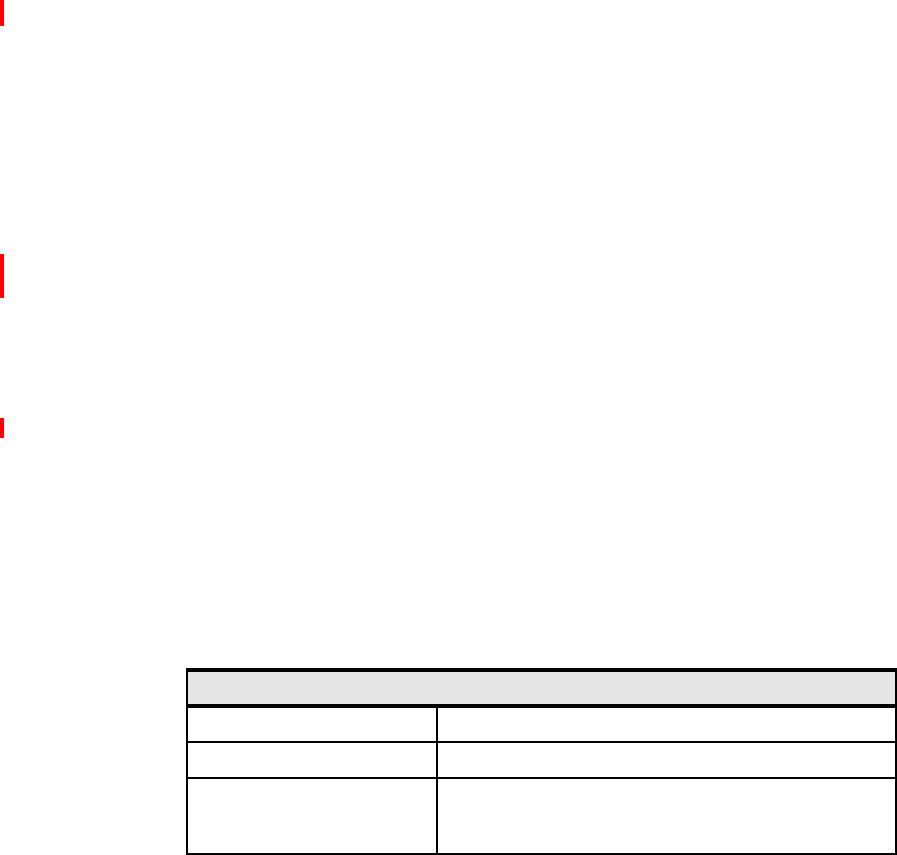
i5/OS (5722-SS1): Operating system licensed products 241
HTTP Server for iSeries (5722-DG1)
HTTP servers are the core foundation of technology at the heart of all
applications for On Demand Business. They handle the communication with the
client (typically browsers or Extensible Markup Language (XML)-rendering
devices such as personal digital assistant (PDAs)) and provide the entry point
into server resources. These resources can range from simple Hypertext Markup
Language (HTML) and GIF files, to On Demand Business and e-commerce
applications, all the way to complete business-to-business, collaborative
enterprises.
For System i5 servers, network computing is supported with HTTP Server for
iSeries. An System i5 servers can access a vast network of computers as though
they were a single entity. Everyone and everything can access and distribute
information, applications, and services provided by the network.
Based on the popular Apache 2.0 open-source software, the HTTP Server
(powered by Apache) is the IBM strategic HTTP server. Multiple HTTP servers
can be active simultaneously on a single System i5.
The HTTP Server for iSeries product also contains several Internet-enablement
tools to aid in Web/Internet application development:
Apache Software Foundation (ASF) Jakarta Tomcat
Net.Data®
Search and Web Crawler
These tools are described further in this section.
Refer to the following Web site for information about preventive service planning
(PSP) for the iSeries HTTP Server:
http://www.ibm.com/eserver/iseries/software/http
Apache, a freeware HTTP server, is open-source software that implements the
industry standard HTTP/1.1 protocol. The focus is on being highly configurable
HTTP Server for iSeries (5722-DG1)
Included in base Yes
Status Shipped with OS/400 as no charge feature
Further information http://www.ibm.com/eserver/iseries/software/http
http://www.webdav.org/
http://www.apache.org/

242 i5 Handbook
and easily extendable. It is built and distributed under the Apache Software
License by the ASF. You can find it on the Web at:
http://www.apache.org
Apache Web Server
The enhancements to Apache Web Server include the following:
New and existing directives allow CGI jobs to run in more than one language
from a single Apache server.
CGI job handling is enhanced by avoiding unnecessary conversions until the
CGI CCSIDs and conversion mode are determined specific to the
configuration.
Log files are tagged with CCSID 1208 (UTF-8).
Porting open source modules to i5 is easier.
Apache Software Foundation Jakarta Tomcat (5722-DG1)
The HTTP Server includes the popular ASF Tomcat Servlet Engine. With ASF
Tomcat, you can serve both servlets and JavaServer Pages (JSPs) using an “In
Process” or “Out of Process” servlet engine. Tomcat, which is based on open
source software, is compatible with the IBM HTTP Server (powered by Apache).
IBM plans for i5/OS V5R4 to be the final release to ship Apache Tomcat
(jsp/servlet) support in IBM HTTP Server, which is shipped with i5/OS.
Net.Data
The IBM HTTP Server product includes Net.Data. IBM Net.Data is an application
that allows Web developers to easily build dynamic Internet applications using
“Web Macros”. Net.Data Web Macros combine the simplicity of HTML with the
power of dynamic SQL. Net.Data provides connectivity to a variety of relational
data sources as well as flat files.
For more information, see the following Web site:
http://www.iseries.ibm.com/netdata
Toolbox for Java (5722-JC1)
Incremental enhancements have been made to the most popular components of
the Java Toolbox, and several new components have been added.
New components include:
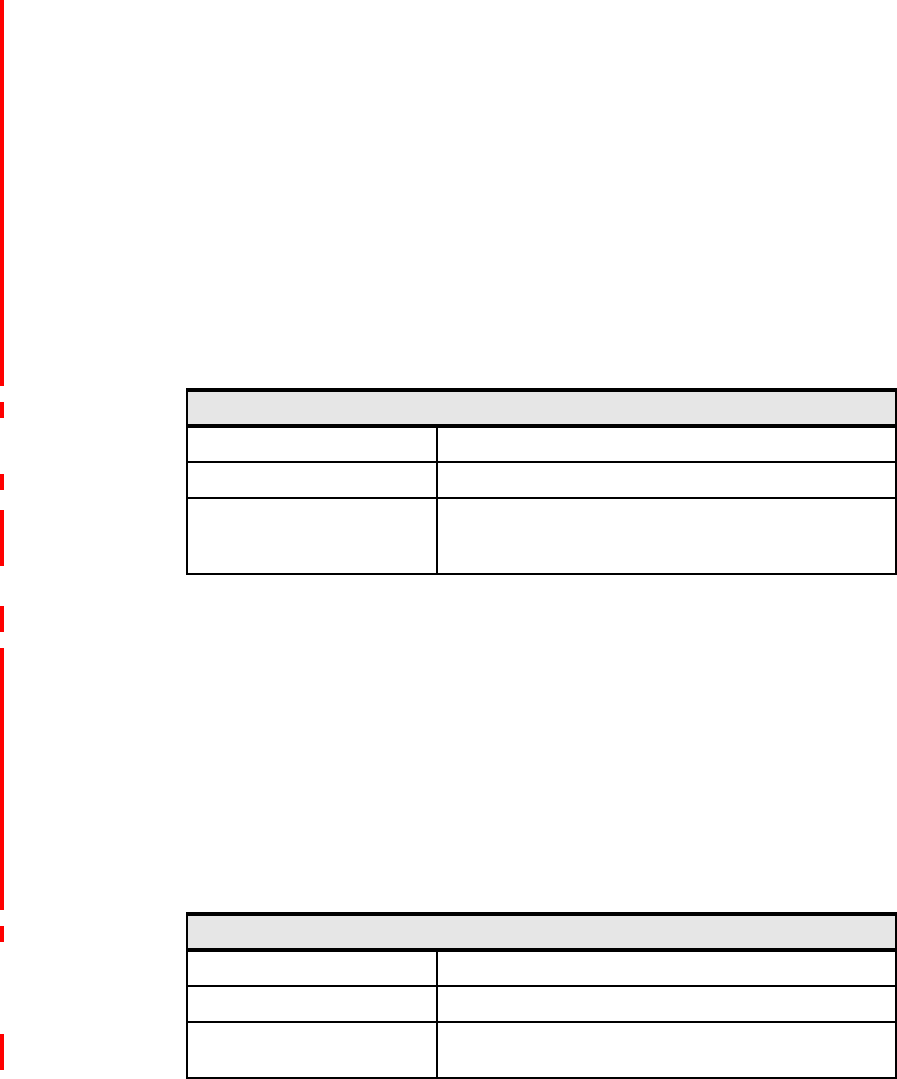
i5/OS (5722-SS1): Operating system licensed products 243
SaveFile component enables Java applications to work with "save files"
located on the server. The Subsystem component similarly enables
applications to query and manipulate subsystems.
SignonHandler feature enables applications to plug in their own customized
signon GUIs for use when the Toolbox needs to prompt for missing or
changed signon information.
Enhanced JDBC functions: Numerous enhancements to JDBC exploit
recently introduced DB2 enhancements, including:
– 2 MB statement size
– 128-byte column name support
– Database host server trace support
– eWLM Correlator support
The JarMaker utility, which produces stripped-down versions of the Toolbox JAR
file, is enhanced for improved effectiveness and usability.
Developer Kit for Java (5722-JV1)
A new Java Virtual Machine (JVM) technology is included in i5/OS V5R4.
New JVM technology is common on all IBM platforms
Has improved its capability to be modular, flexible, and reliable.
32-bit JVM provides a much smaller memory footprint that especially benefits
small to medium business (SMB) applications on smaller servers.
New JVM supports JDK 1.5 and does not require any code change for the
vast majority of pure Java applications. The existing JVM remains in i5/OS as
a highly scalable JVM for JDK 1.3, 1.4, and 1.5.
IBM Toolbox for Java (5722-JC1)
Included in base Yes
Status Shipped with OS/400 as no charge feature of 5722-SS1
Further information Search using “IBM Toolbox for Java”
http://publib.boulder.ibm.com/infocenter/iseries/v5r4
http://www.ibm.com/servers/eserver/iseries/toolbox/
IBM Developer Kit for Java (5722-JV1)
Included in base Yes
Status Shipped with OS/400 as no charge feature
Further information http://publib.boulder.ibm.com/infocenter/iseries/v5r4
Search using “IBM Developer Kit for Java”
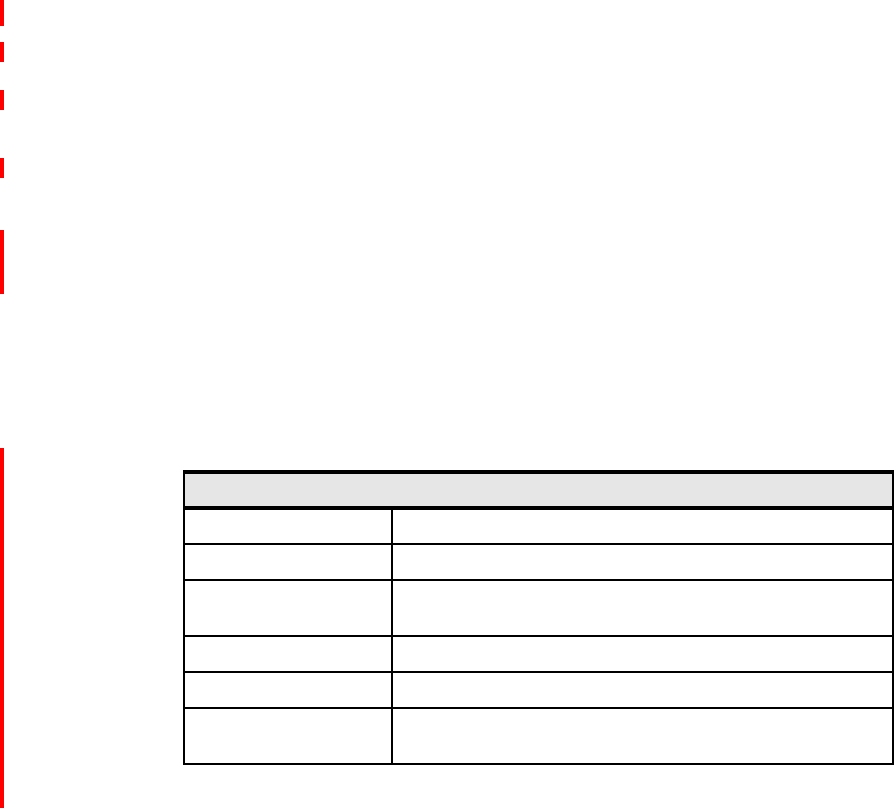
244 i5 Handbook
IBM TCP/IP Connectivity Utilities for iSeries (5722-TC1)
System i5 servers come with a complete and robust suite of TCP/IP protocols,
servers, and services. It is easy to implement full-featured intranets by simply
cabling System i5 servers and workstations together and starting the desired
services. In most cases, no additional software or hardware is required.
TCP/IP networking on System i5 is administered and managed directly from
iSeries Navigator running on a PC client. You can define Dynamic Host
Configuration Protocol (DHCP), Domain Name System (DNS), and Dynamic
Domain Name System (DDNS) servers from a single graphical interface.
The TCP/IP protocol stack on the System i5 is tuned for robust, secure, and
scalable TCP/IP services and servers. This results in significant improvements in
capacity for TCP/IP users.
The base protocols are implemented within OS/400 and OS/400 microcode for
excellent performance, security, and stability. A wide range of physical interfaces
is supported.
For a full description of TCP functions and features, refer to the Networking -
TCP/IP section of the iSeries Information Center, and IBM Eserver iSeries IP
Networks: Dynamic!, SG24-6718.
IBM TCP/IP Connectivity Utilities
Product number 5722-TC1
Ordering Included free of charge with OS/400
Minimum operating
system level
V5R1
Software type Software Subscription
Replaces product 5769-TC1
Further information http://www-1.ibm.com/servers/eserver/iseries/tcpip
IBM Eserver iSeries IP Networks: Dynamic!, SG24-6718
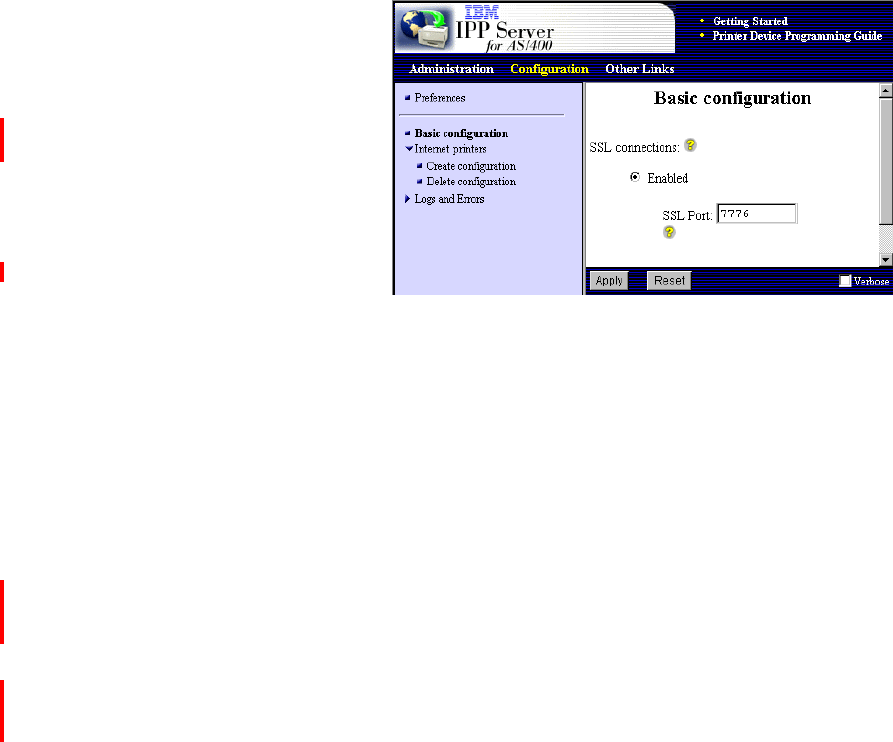
i5/OS (5722-SS1): Operating system licensed products 245
Internet Printing Server for iSeries
The Internet Printing Protocol (IPP) defines an industry-standard method of
delivering print jobs using Internet technologies providing for Web-enabled print
around the world. The IPP was developed by the Printer Working Group, a
consortium of all major companies involved in network printing. IPP is fast
becoming the single standard interface for printing on the Internet, with broad
vendor implementation and client acceptance.
The IPP Server for
iSeries, included in
OS/400, provides an
IPP Version 1.0
compatible print
server for the System
i5. The IPP Server for
iSeries allows anyone
working remotely, to
submit and manage
print jobs on a distant
System i5. IPP is built
on top of HTTP, which
in turn, runs over TCP/IP. Clients can now use the same print solution on local
area networks, intranets, and the Internet. The same process used to send a
print document to the department printer down the hall can be used to send the
document to the corporate printer across the country (region).
The IPP Server for iSeries provides security features for user authentication and
encryption of print jobs using SSL 3.
iSeries Webserver Search Engine
The iSeries Webserver Search Engine allows you to perform full text searches on
HTML and text files from any Web browser. The Webserver Search Engine also
includes a Web crawler.
For more information, see:
http://www-1.ibm.com/servers/eserver/iseries/software/http/services/
searchinfo.htm
http://www-1.ibm.com/servers/eserver/iseries/software/http/services/
webcrawler.htm

246 i5 Handbook
i5/OS V5R4 options
The programs in the following list appear within the iSeries Software Resources
and Licensed Program menus as a separate product. Each is part of the base
i5/OS (product 5722-SS1). Some programs ship with i5/OS automatically with no
additional charge. Others are ordered separately or are a chargeable option.
Option 0 i5/OS -- Per Processor Pricing Key
Option 1 i5/OS -- Extended Base Support
Option 2 i5/OS -- Online Information
Option 3 i5/OS -- Extended Base Directory Support
Option 5 i5/OS -- System/36(TM) Environment
Option 6 i5/OS -- System/38(TM) Environment
Option 7 i5/OS -- Example Tools Library
Option 8 i5/OS -- AFP(TM) Compatibility Fonts
Option 9 i5/OS -- *PRV CL Compiler Support
Option 12 i5/OS -- Host Servers
Option 13 i5/OS -- System Openness Includes
Option 14 i5/OS -- GDDM(R)
Option 18 i5/OS -- Media and Storage Extensions(3)
Option 21 i5/OS -- Extended NLS Support
Option 22 i5/OS -- ObjectConnect
Option 23 i5/OS -- OptiConnect(3)
Option 25 i5/OS -- NetWare Enhanced Integration(3)
Option 26 i5/OS -- DB2 Symmetric Multiprocessing(3)
Option 27 i5/OS -- DB2 Multisystem(3)
Option 29 i5/OS -- Integrated Server Support
Option 30 i5/OS -- Qshell
Option 31 i5/OS -- Domain Name System
Option 33 i5/OS -- Portable Application Solutions Environment
Option 34 i5/OS -- Digital Certificate Manager
Option 35 i5/OS -- CCA Crypto Service Provider
Option 36 i5/OS -- PSF/400 1-45 IPM Printer Support(3)
Option 37 i5/OS -- PSF/400 1-100 IPM Printer Support(3)
Option 38 i5/OS -- PSF/400 Any Speed Printer Support(3)
Option 39 i5/OS -- International Components for Unicode
Option 41 i5/OS -- HA Switchable Resources(3)
Option 42 i5/OS -- HA Journal Performance(3)
Option 43 i5/OS -- Additional Fonts
3 This software is only included if it is ordered.

i5/OS (5722-SS1): Operating system licensed products 247
System/36 environment (5722-SS1 Option 5)
Most System/36 applications can run on the System i5 server using the
System/36 environment. When running in the System/36 environment, OS/400
supports a set of commands designed to migrate data between the System/36
and the System i5 server or the System i5 server and the System/36. These
commands save and restore library source, procedure members, and data files
between the two systems.
System/38 environment (5722-SS1 Option 6)
The System/38 environment provides:
Migration from System/38 systems
Intermixing System/38 and System i5 functions
Maintenance of System/38 applications on the System i5 server
The System/38 environment allows the execution of most programs written for a
System/38 system. The same job can execute any combination of System i5 or
System/38 programs. The programmer menu on the System i5 supports source
types to enable the identification of System/38 syntax. The programmer can
maintain either System i5 or System/38 programs during the same job.
Host servers (5722-SS1 Option 12)
Host servers handle requests from client PCs or devices such as running an
application, querying a database, printing a document, or even performing a
backup or recovery procedure.
System/36 environment (5722-SS1 Option 5)
Included in base Yes
Status No charge
System/38 environment (5722-SS1 Option 6)
Included in base Yes
Status No charge
Host Servers (5722-SS1 Option 12)
Included in base Yes
Status No charge

248 i5 Handbook
System Openness Includes (5722-SS1 Option 13)
System Openness Includes provides developers with header files for the many
callable APIs and exits found in OS/400. The header files are provided in a
high-level language source for application development in languages such as C,
C++, OPM RPG, ILE RPG, OPM COBOL, and ILE COBOL. They provide for
easier access to many of the functions found in OS/400.
The Pthread APIs are based on open APIs described in the ANSI/IEEE Standard
1003.1, 1996 edition (also known as ISO/IEC 9945-1: 1996) and the Single UNIX
Specification, Version 2, 1997 standards.
Media and Storage Extensions (5722-SS1 Option 18)
For software developers who want to customize their own storage management
applications, Media and Storage Extensions provides an API to enable
application monitoring and control of media usage, including volumes to be
selected and volume expiration dates. The API also enables fast search for IBM
3480, 3490, 3490E, and 3575 tape devices.
An API is provided to handle the interruption that occurs when an application
tries to open a database file that has been migrated to offline media. The API
Further information http://www.iseries.ibm.com/infocenter
Host Servers (5722-SS1 Option 12)
Included in base Yes
System Openness Includes (5722-SS1 Option 13)
Included in base Yes
Status No charge
Media and Storage Extensions (5722-SS1 Option 18)
Included in base No
Status Charged feature
Related products Backup Recovery and Media Services (BRMS)
(5722-BR1)
Tivoli Storage Manager (5697-TSM)
Further information http://www.iseries.ibm.com/infocenter
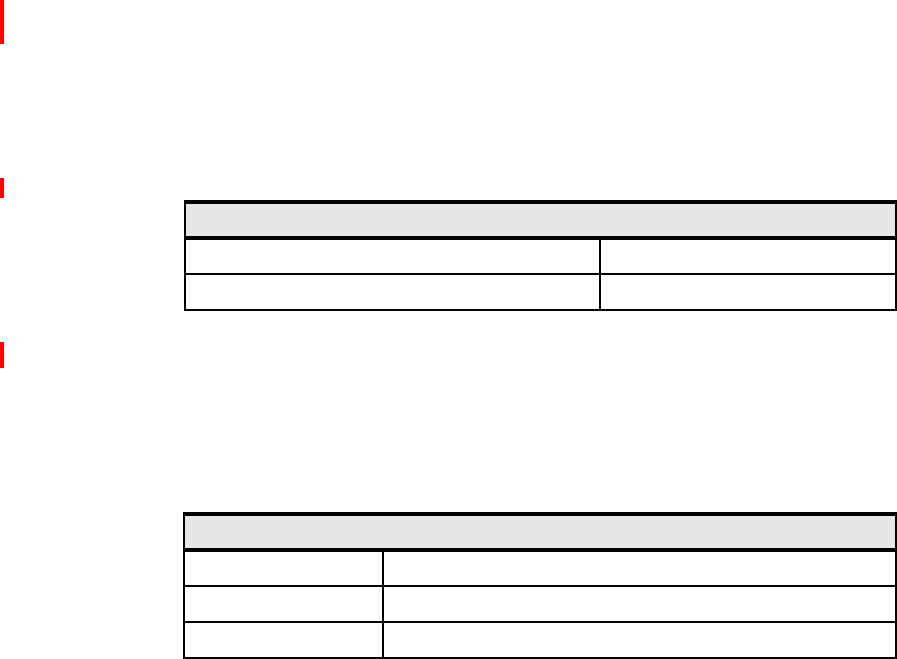
i5/OS (5722-SS1): Operating system licensed products 249
enables an on demand recall of a database file from offline media to direct
access storage device (DASD) and resumption of the application. Application
changes are not required.
These APIs provide support to use or build applications to manage tape usage
and the recall of data from offline media to DASD. This feature is a prerequisite
feature to BRMS. It is also required when developing HSM dynamic retrieval
functions.
Object Connect for iSeries (5722-SS1 Option 22)
Object Connect for iSeries provides support to simply and efficiently move
individual objects, entire libraries, or entire IFS directories from one System i5
server to another over a standard communications connection. Systems can be
connected via standard APPC (using APPN), TCP/IP communications lines
(using AnyNet), local area network (LAN), or an high-speed link (HSL)
OptiConnect loop (fiber or copper). The economy of not requiring intermediate
save file procedures and copies to distribution queues saves DASD and
improves performance in a manner that is nondisruptive to system operations.
OptiConnect for iSeries (5722-SS1 Option 23)
OptiConnect for iSeries provides high-speed transparent access to data through
SPD fiber optic bus connections or HSL fiber optic and copper bus connections.
It also includes performance enhancements to iSeries Distributed Data
Management (DDM).
The mechanism used by OptiConnect for iSeries to access database files on
connected systems is modeled after DDM. Just as DDM uses a DDM file and
APPC communications to redirect file access operations, OptiConnect for iSeries
Object Connect for iSeries (5722-SS1 Option 22)
Included in base Yes
Status No Charge
OptiConnect for iSeries (5722-SS1 Option 23)
Included in base No
Status Charged feature
Further information http://www-1.ibm.com/servers/eserver/iseries/ha/opticonnect

250 i5 Handbook
uses DDM files and a specialized transport service to redirect file access
operations to a target system.
Using OptiConnect for iSeries among systems sharing the same bus (connected
with SPD fiber or HSL fiber/copper cables only) can achieve transport
efficiencies not possible with more general purpose, wide-area communications
protocols.
With HSL OptiConnect for iSeries, clients can offload the database application
CPU cycles of up to 28 System i5 servers given three CECs per loop. However
when three CECs are on a loop, no I/O towers can exist on that loop.
The major advantages of OptiConnect for iSeries are realized by clients who are
rapidly approaching system capacity limits, and who intend to implement
distributed database application servers within a data center or short-distance
campus environment. OptiConnect for iSeries is also an integral part of high
availability configurations.
When used with the Object Connect for iSeries facility, OptiConnect for iSeries
provides a high-efficiency migration aid for the iSeries Advanced Series.
OS/400 - NetWare Enhanced Integration (5722-SS1 Option 25)
OS/400 - NetWare Enhanced Integration provides NetWare client and integration
services for System i5 users, operators, and applications. This is achieved using
a Network Loadable Module (NLM) that runs on NetWare 6.0.
TCP/IP support in OS/400 is used to connect the System i5 using a token-ring
adapter, an Ethernet adapter, IPCS, X.25, or frame relay adapters. OS/400
Enhanced Integration for Novell NetWare provides user profile and password
integration from the System i5 to NetWare. System i5 user or group profiles can
be propagated to multiple NetWare Directory Services (NDS) trees. When
System i5 users change their passwords, the change is propagated to NetWare.
Note: Novell no longer supports NetWare 4.2 and NetWare 5.0, and therefore,
nor does IBM. A license is required for each NetWare server.
NetWare Enhanced Integration has a nonwarranted license with no committed
support for V5R4.
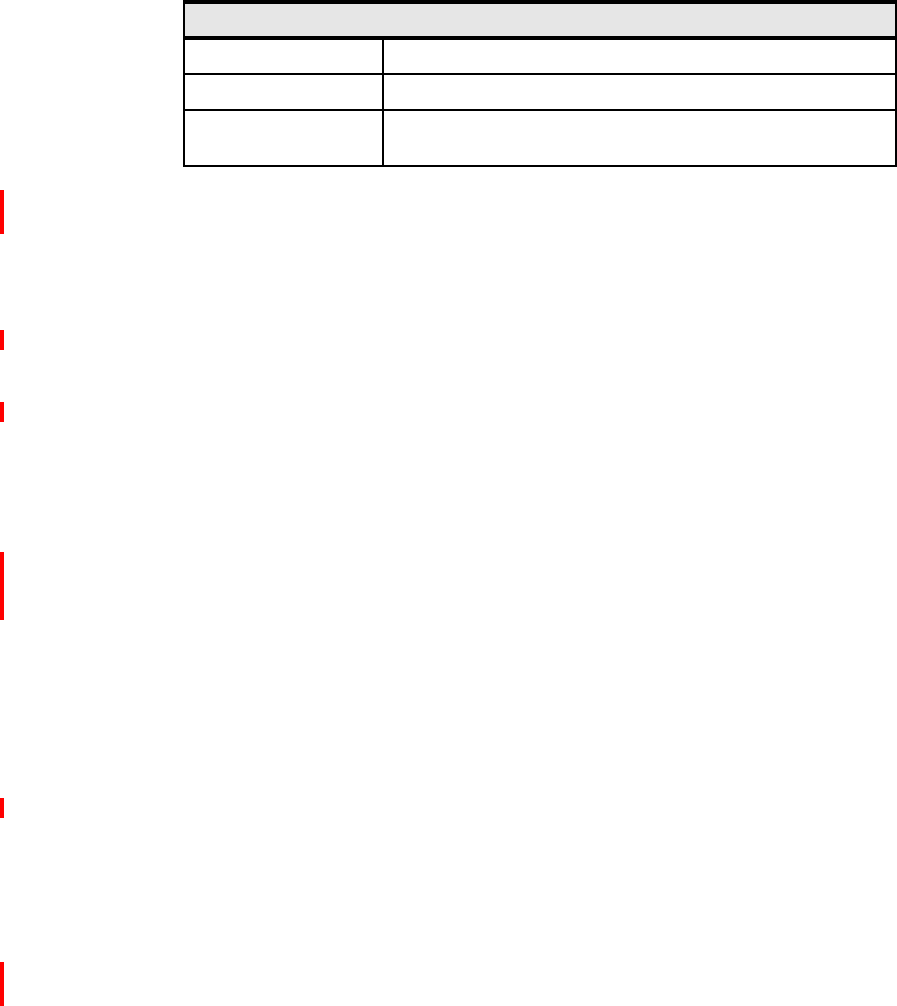
i5/OS (5722-SS1): Operating system licensed products 251
OS/400 - NetWare Enhanced Integration provides System i5-to-NetWare printing
support. An System i5 user’s printed output is sent from an System i5 output
queue to a printer queue managed by the NetWare server. OS/400 host print
transform services are used to translate the output to print on common PC
printers.
IFS support is provided, allowing System i5 users, including iSeries Access
users, and applications access to files and directories in multiple NDS trees
throughout the network. Full integration with NetWare security ensures that each
System i5 user of these services is fully authenticated in NetWare Directory
Services. Another use of the file system is to access files on NetWare servers to
be served by OS/400 Internet connection support:
Internet Connection Server for AS/400 (V4R1 and V4R2 only)
HTTP Server for iSeries (V4R3 or later release)
Server configuration and management tasks can operate from System i5
interfaces. This is not intended to provide full management and operations of a
NetWare server. However, System i5 operators can manage user connections
and disk resources. Facilities are provided for creating, extending, and mounting
or dismounting volumes on NetWare servers.
OS/400 - DB2 Symmetric Multiprocessing (5722-SS1 Option 26)
OS/400 - DB2 Symmetric Multiprocessing (SMP) expands on the parallel
capabilities of DB2 UDB for iSeries. This separately priced feature of OS/400
improves the performance of the database for the System i5 server. This
improved performance is critical, especially in a data warehouse or
decision-support environment. The performance gains provided by this feature
allow for better and more effective business decisions to be made in a timely
manner.
OS/400 - DB2 Symmetric Multiprocessing further enables DB2 UDB for iSeries
with SMP on any n-way System i5 server. SMP capabilities have existed since
the introduction of the System i5 n-way systems. This form of SMP allows
multiple database operations to take place simultaneously on multiple
OS/400 - NetWare Enhanced Integration (5722-SS1 Option 25)
Included in base Yes
Status No charge
Further information http://www-1.ibm.com/servers/eserver/iseries/netware/
as4nwhm.htm
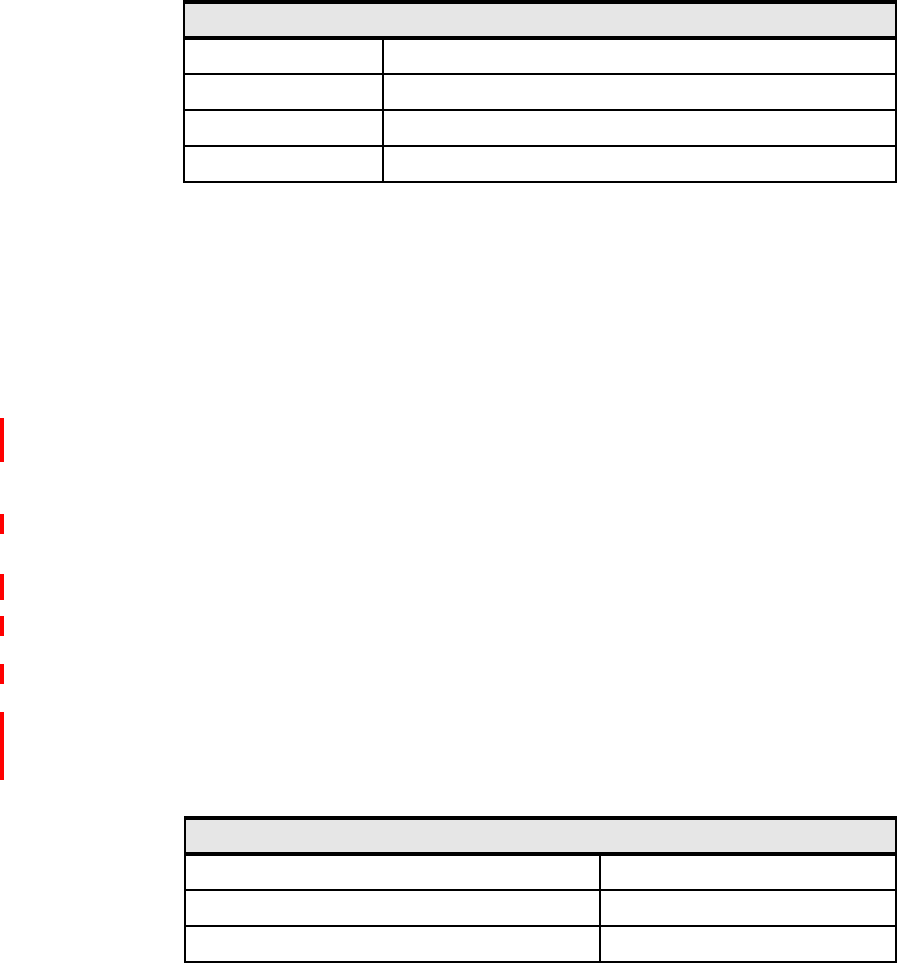
252 i5 Handbook
processors. Each database operation runs on a single processor, therefore,
optimizing DB2 UDB for iSeries for online transaction processing.
With the DB2 Symmetric Multiprocessing, a single database operation can run
on multiple processors at the same time or in parallel. These database
operations are typically queries. However, parallel processing is also supported
for import and export between DB2 UDB for iSeries and other databases.
This parallel index build, splitting an individual query into many smaller subtasks,
can then be run independently on separate processors before the subtask results
are combined again. This allows for significant performance increases. These
performance increases become more pronounced with the addition of more
processors. For example, if a query is running in 20 seconds on an System i5
with a dedicated processor, adding a second dedicated processor along with the
DB2 Symmetric Multiprocessing feature may allow this query to run in
approximately 10 seconds. Adding two additional processors may allow this
query to run in approximately 5 seconds.
OS/400 - DB2 Multisystem (5722-SS1 Option 27)
The System i5 server and OS/400 - DB2 Multisystem provide a scalable solution
for data warehousing that spans from the smallest datamart to the largest
enterprise data warehouse. DB2 Multisystem allows multiple System i5 servers
to be connected to allow the processing power and storage capacity of all the
servers to be used. From a database perspective, these interconnected System
i5 servers appear as a single large system. It is intended for use when System i5
servers are used for large data warehouse installations.
OS/400 - DB2 Symmetric Multiprocessing (5722-SS1 Option 26)
Included in base No
Status Charged feature
Related products DB2 Multisystem for iSeries
Further information http://www-1.ibm.com/servers/eserver/iseries/db2/db2sym.htm
OS/400 - DB2 Multisystem (5722-SS1 Option 27)
Included in base No
Status Charged feature
Related products DB2 Symmetric Multiprocessing

i5/OS (5722-SS1): Operating system licensed products 253
Integrated Server Support (5722-SS1 Option 29)
The i5/OS Integrated Server Support option 29 for i5/OS replaces the IBM
iSeries Integration for Windows Server product. This new option delivers virtual
storage, communications, and operations management integration between
i5/OS and integrated xSeries® solutions and Linux™ and AIX 5L™ partitions for
the System i5 family.
The Integrated Server Support option includes enhancements provided with
i5/OS V5R4 to deliver:
Virtual Ethernet support for Linux on xSeries systems attached by an
Integrated xSeries Adapter
Support for extending the size of a network server storage space
Support for Windows Server 2003 Volume Shadow Copy Service, which can
be used by Windows backup applications
iSeries Navigator enhancements to deliver a consistent management
interface for integrated xSeries systems, and Linux and AIX 5L partitions
OS/400 - Domain Name System (5722-SS1 Option 31)
OS/400 includes a full-function Domain Name System server. It can be
configured for primary, secondary, and caching roles. DNS configuration data
from other platforms can easily be migrated to the System i5 DNS server. In
addition, a migration utility that moves existing System i5 host table information
into the DNS configuration databases is provided.
Dynamic DNS
OS/400 DNS services are based on the widely used industry-standard DNS
reference implementation. A dynamic update capability is offered that transforms
the DNS into a DDNS.
OS/400 - Domain Name System (5722-SS1 Option 31)
Included in base Yes
Status No charge feature
Related products Requires 5722-SS1 Option 33 (OS/400 PASE) to run with full functionality
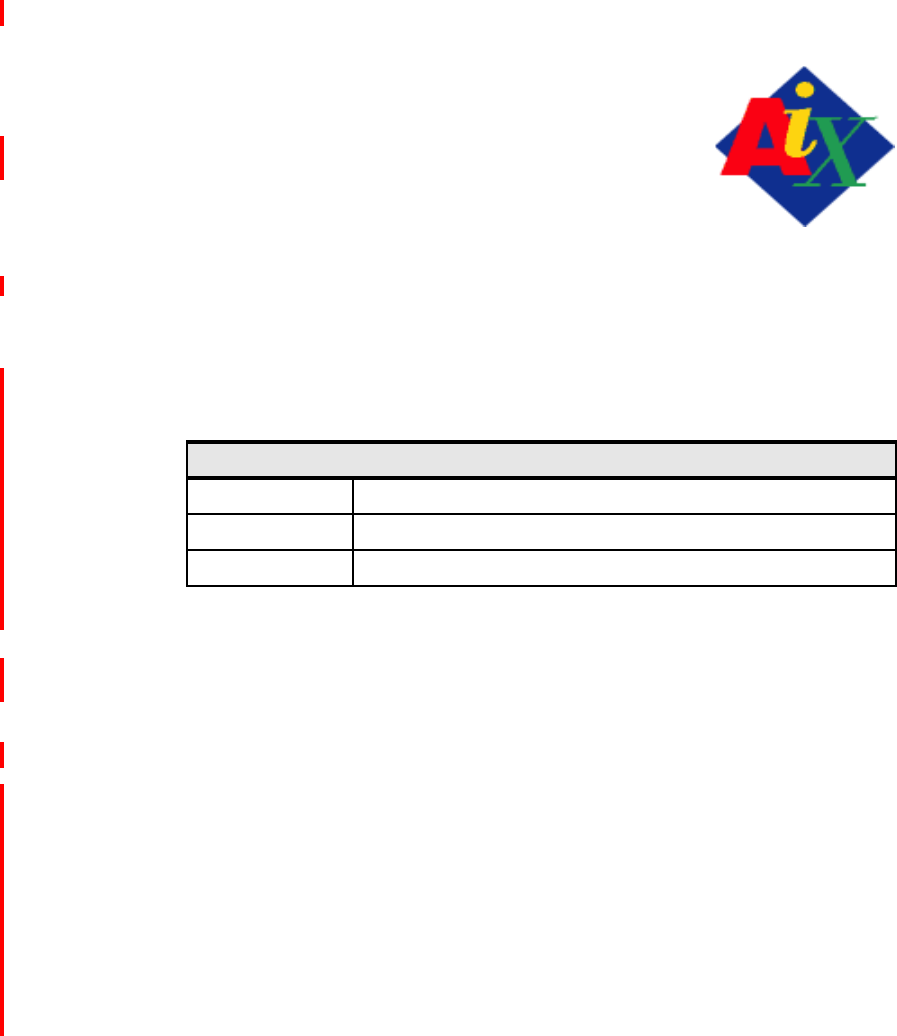
254 i5 Handbook
OS/400 Portable Application Solutions Environment (5722-SS1
Option 33)
OS/400 PASE is an integrated runtime that provides
simplified porting of selected solution provider UNIX
applications. OS/400 PASE complements and expands the
System i5 solution portfolio by focusing on rapidly porting
UNIX applications to the System i5 platform.
OS/400 PASE is a library of APIs and system services that
enable AIX programs to run in OS/400. It provides a
subset of AIX functionality to support running 32-bit and 64-bit UNIX applications
directly on System i5 hardware. OS/400 PASE includes full support for
X-Windows.
OS/400 PASE applications are created on an AIX workstation and execute on
System i5 hardware.
OS/400 PASE exploits the System i5 processor’s ability to switch between
OS/400 and AIX runtime modes within an OS/400 job. This allows applications
deployed using OS/400 PASE to run directly on System i5 hardware and take full
advantage
Digital Certificate Manager (5722-SS1 Option 35)
Digital certificate management changes for V5R4 include:
Self-signed certificates with private keys can be assigned to application
identifiers.
Reverse order PKCS12 files cab be imported. This may be extended to
“orderless” PKCS12 files.
Target release for exporting certificates and creating certificates for another
system are eliminated.
Optional, overriding labels on server/client certificates are enabled when
importing a PKCS12 file.
OS/400 PASE (5722-SS1 Option 33)
Included in base Header and export file extensions are packaged with OS/400 Option 33
Status No charge feature
Further information http://www-1.ibm.com/servers/enable/site/porting/iseries/pase
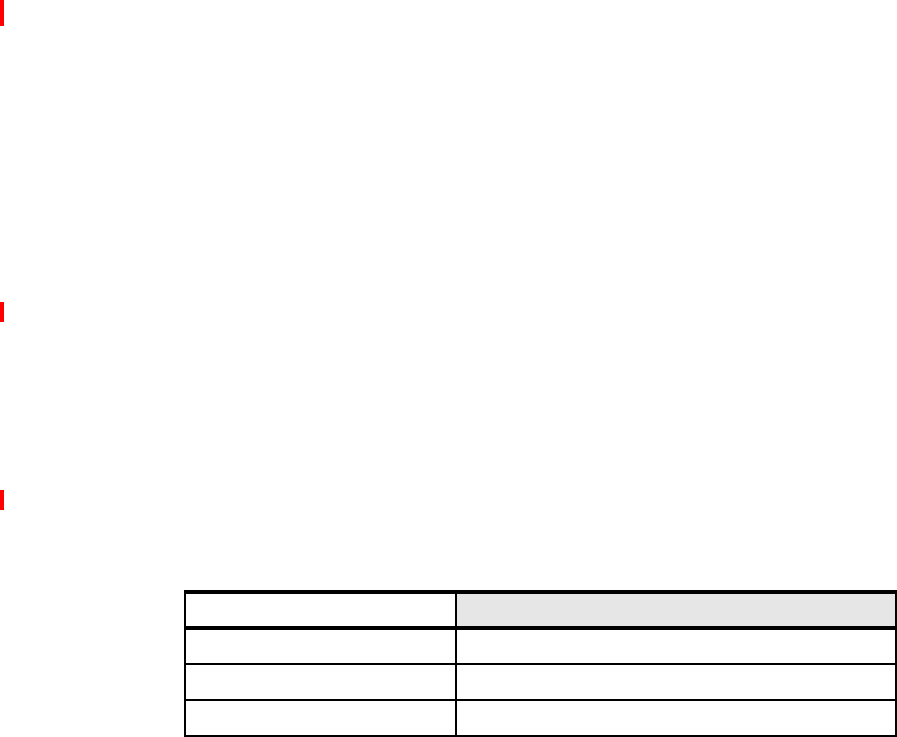
i5/OS (5722-SS1): Operating system licensed products 255
IBM Print Services Facility (5722-SS1 Options 36, 37, 38)
IBM Print Services Facility™ for OS/400 (PSF/400) provides support for
high-function Advanced Function Presentation (AFP) electronic printing and print
management of Intelligent Printer Data Stream (IPDS) printers. With AFP,
application output can be transformed into fully graphical documents with
electronic forms, image, graphics, barcoding, lines, boxes, and text in a wide
variety of fonts. This flexibility enables the production of electronic documents
that are more effective, and enables the re-engineering of business processes.
Documents and reports can be produced using a variety of enabling tools,
including Infoprint Designer for iSeries (5733-ID1). Other enabling tools include
OS/400 printer file keywords (for front and back overlays, N-up, and duplex), DDS
printer files, System i5 page and form definitions, Advanced Print Utility (APU),
and AFP Toolbox. Output created by network and client applications can be
transformed to AFP, and, therefore, managed by PSF/400 to IPDS printers.
OS/400 Version 5 includes capabilities (via Infoprint Server for iSeries) to handle
PCL, PostScript, and PDF output with PSF/400 print management.
PSF/400 is the OS/400 subsystem driving the interactive management of IPDS
printers. IPDS is a bidirectional print architecture that ensures that the printing
process can be managed every step of the way.
The following table lists the OS/400 option number associated with each tier.
An unlimited number of printers within each tier is supported.
Option number Feature description
36 1 to 45 IPM
37 1 to 100 IPM
38 Any speed printer support
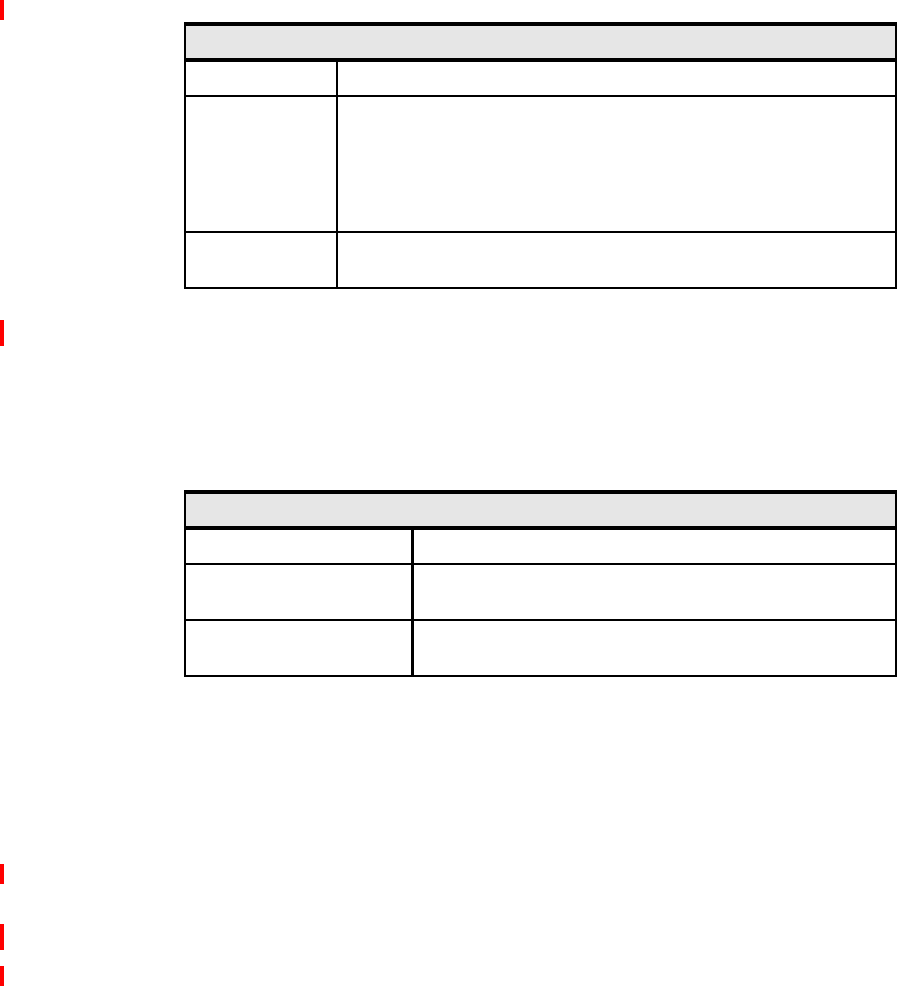
256 i5 Handbook
OS/400 High Availability Switchable Resources (5722-SS1 Option 41)
OS/400 High Availability (HA) Switchable Resources provides the capability to
achieve a highly available environment using switchable resources. The
resources are physically switched between systems so that only one copy of the
resource is required.
Option 41 includes support for:
Switchable IASPs: Allow you to move the data to a backup system to keep
the data constantly available. The data is contained in a collection of
switchable disk units such as an I/O tower.
IBM Simple Cluster Management GUI: Allows you to create and manage a
simple four-node, switched disk cluster. The utility includes wizards and help
text that simplify the tasks involved in and managing the cluster.
OS/400 High Availability Journal Performance (5722-SS1 Option 42)
For the most demanding high-availability clustering environments supported by
our high availability Business Partners, Journal Standby Mode and
Asynchronous Journaling capabilities enable faster failover and reduce
IBM Print Services Facility (5722-SS1 Options 36, 37, 38)
Included in base No
Related products Advanced Function Printing Utilities (5722-AF1)
Infoprint Designer for iSeries (5733-ID1)
iSeries Facsimile Support (5722-FAX)
Infoprint Server for iSeries (5722-IP1)
IBM AFP Font Collection (5648-B45)
IBM Infoprint Fonts for Multiplatforms (5648-E77)
Further
information
http://www.printers.ibm.com/internet/wwsites.nsf/vwwebpublished/
psfhome_i_ww
High Availability Switchable Resources (5722-SS1 Option 41)
Included in base No
Status Charged feature
Keyed - Yes
Further information http://www-1.ibm.com/servers/eserver/iseries/ha/
clustertech.htm
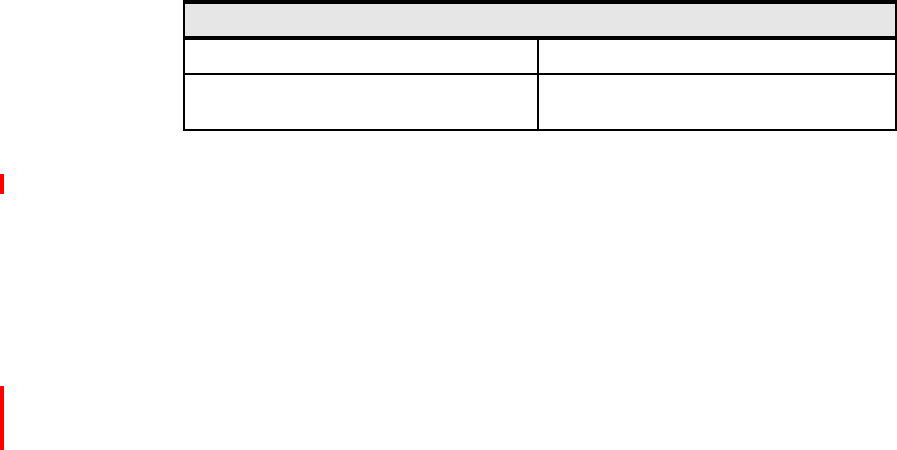
i5/OS (5722-SS1): Operating system licensed products 257
performance bottlenecks. Both the Journal Caching feature and the Journal
Standby feature are provided by installing OS/400 option 42.
Journal Caching feature
The Journal Caching feature allows batch applications to substantially reduce the
number of synchronous disk write operations performed, thereby reducing overall
elapsed batch execution time.
Journal Caching provides significant performance improvement for batch
applications that perform large numbers of add, update, or delete operations
against journaled objects. Applications using commitment control see less
improvement (commitment control already performs some Journal Caching).
Journal Caching is especially useful for situations where journaling is being used
to enable replication to a second system.
You can find more detailed information in the iSeries Information Center at:
http://www.iseries.ibm.com/infocenter
OS/400 High Availability Journal Performance (5722-SS1 Option 42)
Included in base No
Status Charged feature
Keyed - Yes
258 i5 Handbook

© Copyright IBM Corp. 1997 - 2006. All rights reserved. 259
Chapter 18. Software terms
Software on System i5 servers is priced in one of three ways:
Per server based by the grouping of systems into tiers
By the number of processors on which the software is running
By the number of users
Software is grouped into seven tiers: P05, P10, P20, P30, P40, P50, and P60.
Each server is placed into a tier based on its processor and, for older models, its
5250 commercial processing workload (CPW) feature. Software pricing is then
based on this tier for that server. Each server in the hardware section has a
software tier indicated.
Some software products are chargeable by the number of processors on which
the software is running, rounded up to the nearest processor. If the number of
processors is increased, by IBM Eserver Capacity Upgrade on Demand
(CUoD) for example, an additional charge becomes payable.
User-based pricing depends on the number of actual active users using that
software on a system. Keyed software where user pricing is required needs a
software key for the “base” license and for the allowed number of users. In some
cases, after purchasing a certain amount of licenses in a particular software tier,
the user is then entitled to unlimited use of that software on that system. Where
user pricing is applicable, the terms of use are stated in the respective chapters.
18

260 i5 Handbook
This chapter discusses software migration, upgrade paths, previous release
support, software maintenance, terms and conditions, and software upgrades.
For more Information review Announcement Letter 205-163.
http://www-1.ibm.com/servers/eserver/iseries/announce/
Software Maintenance for System i5
Software Maintenance for iSeries (SWMA) is an offering that provides
entitlement to new versions and releases of Operating System/400 (OS/400) and
selected iSeries Licensed Program Products (LPP) and provides access to IBM
world class System i5 software support services for assistance with routine,
short duration installation and usage (how-to) questions, and code-related
problems. The eligible Software Maintenance products are listed on the Web at:
http://www-1.ibm.com/servers/eserver/iseries/sftsol/subscript3.html
Software license and upgrades
With the one- or three-year Software Maintenance option included for a price with
every new System i5 purchase, clients are entitled to order future versions and
releases for eligible software products during the period they are covered by
Software Maintenance. At renewal time, the client is required to purchase
Software Maintenance for System i5 to maintain their entitlement to future
versions and releases of eligible products they are licensed for.
Failure to renew makes a client ineligible to receive new versions, releases, or
updates. The client becomes liable for an After License fee in addition to the
applicable Software Maintenance for System i5 offering charge when
reinstatement of Software Maintenance eventually takes place. The client must
ensure that reinstatements are on a timely basis to avoid this After License Fee.
On 12 July 2005, IBM announced new PID’ s for IBM Software Maintenance by
processor for i5/OS and selected products on all Eserver i5 models. There is a
transition period through 30 September 2005. There are no changes to POWER4
and earlier models.
The i5/OS software maintenance program numbers are:
5733-SPP IBM Software Maintenance i5/OS for 1-year
5733-SP3 IBM Software Maintenance i5/OS for 3-years

Software terms 261
The additional processor i5/OS license program numbers are:
5733-SSA IBM Software Maintenance i5/OS additional processor license
combined with 1-year per processor maintenance.
5733-SPE IBM Software Maintenance for i5/OS, 3-year extended registration
(billing and registration for the second and third year additional processor
license).
To determine if a product is covered Software Maintenance (SWMA) or Passport
Advantage refer to the following URL:
http://www-03.ibm.com/services/sl/swm/
The Passport Advantage Online website enables the client to submit and
manage their contact information, view purchase history, and more. See:
http://www.ibm.com/software/passportadvantage
This is an IBM program that covers software license acquisition and maintenance
options under a single common set of agreements, processes, and tools. Using
Passport Advantage Online, IBM Clients can submit contact updates, view
purchase history, and more.
You can find full details about Passport Advantage on the Passport Advantage
Home page at:
http://www.lotus.com/services/passport.nsf/WebDocs/Passport_Advantage_Home
A tutorial on Passport Advantage is available at:
http://www.lotus.com/services/passport.nsf/startpa.htm
New with i5/OS V5R3
i5/OS is included with System i5 systems and licensed under the International
Program License Agreement (IPLA). OS/400 Version 5 is software keyed to the
designated serial number of the machine where it is initially installed. Version 5 of
OS/400 is licensed to operate on only that serial number machine. It may not be
moved or transferred from one machine to another except in an emergency
backup situation.
The number of processors that need an OS/400 license entitlement are the
aggregation of all processors, including partial shares of a processor, across all
partitions of a single system where OS/400 is used, rounded up to the next
highest whole number. Clients must license based on what the System i5 is
configured to use, the dedicated and capped partitions, and the virtual processor
quantity for uncapped partitions. If large Virtual Processor quantities are

262 i5 Handbook
configured for uncapped partitions, IBM does not require OS/400 licensing for
processors larger than the number of processors in a system.
Each System i5 Edition feature includes the quantity of OS/400 processor
licenses for the startup processors of the hardware model.
For software-only OS/400 Version 5 orders, the OS/400 License Authorization
Code is ordered from IBM. Contact your IBM Representative or IBM Business
Partner for ordering information.
Many of the program products and optional features also require a software key
to function. These are all included in the Keyed Stamped Media distribution.
Keyed Stamped Media Distribution
Many OS/400 product features are available on Keyed Stamped Media shipped
with OS/400. This provides on demand delivery of these products and features
and allows a 70-day evaluation period for any of the provided products or
features. To use the software distributed on the Keyed Stamped Media after the
70-day evaluation period, the software license must be ordered and a software
key is created. Contact your IBM Representative or IBM Business Partner for
ordering information.
New software license keys are required when the version, release, or
modification level of the software changes, or the software is transferred to a
different system. Some software is keyed based on the software tier. A new
software key must be obtained when the software tier changes.
If a keyed product or feature is to be upgraded, the current Proof of Entitlement or
the invoice must be provided to your IBM Representative or IBM Business
Partner as proof of license.
Note: When ordering software license keys for the iSeries 720, 730, 740, and
newer models, the Processor Feature code that is used is displayed in the
QPRCFEAT system value or in the Hardware Service Manager report. Refer
to “Today’s System i5 summary” on page 47 and “Summary of earlier AS/400,
AS/400e, and iSeries models” on page 449 to find the QPRCFEAT value
associated with a specific processor.

Software terms 263
Keyed Stamped Media Distribution for i5/OS V5R3
The following products are included with the standard set for every software or
upgrade order.
5722-SS1 IBM i5/OS
– Option 18 Media and Storage Extensions
– Option 36 Print Services Facility 1-45 IPM Printer Support
– Option 37 Print Services Facility 1-100 IPM Printer Support
– Option 38 Print Services Facility Any speed Printer Support
– Option 41 High Availability Switchable Resources
– Option 42 High Availability Journal Performance
5722-AF1 AFP Utilities for iSeries
5722-AP1 Advanced DBCS Printer Support for iSeries
– Option 1 Advanced DBCS Printer Support - IPDS
5722-BR1 Backup Recovery and Media Services for iSeries
– Option 1 - Network
– Option 2 - Advance
5722-CM1 Communication Utilities for iSeries
5722-DE1 DB2 Universal Databases Extenders for iSeries V7.2
5722-DP4 DB2 DataPropagator for iSeries V8.1
5722-IP1 Infoprint Server for iSeries
5722-JS1 Advanced Job Scheduler for iSeries
5722-PT1 Performance Tools for iSeries
– Option 1 - Manager
– Option 2 - Agent
5722-QU1 Query for iSeries
5722-ST1 DB2 Query Manager and SQL Development Kit for iSeries
5722-WDS WebSphere Development Studio
5722-XH2 iSeries Access for Web
5722-XW1 iSeries Access Family
– Option 1 - iSeries Access Enablement Support
264 i5 Handbook

© Copyright IBM Corp. 1997 - 2006. All rights reserved. 265
Chapter 19. IBM licensed programs:
Database accessories
DB2 Universal Database (UDB) for iSeries is the relational database manager
that is fully integrated on your System i5 server. Because it is integrated, DB2
UDB for iSeries is easy to use and manage. DB2 UDB for iSeries embodies
flexibility through the support of its traditional database interface along with
enhancing the Structured Query Language (SQL)-based database required by
today’s Enterprise Application Systems.
Multiple databases are now supported on an System i5 server through the use of
independent disk pools. You can manage all of the databases on the server using
iSeries Navigator. DB2 UBD provides databases access from client interfaces
such as Linux partitions and Windows systems.
This chapter identifies the accessories available from IBM to complement the
IBM i5/OS integrated database.
19

266 i5 Handbook
The following database accessory products are part of the iSeries Access Family
(5722-XW1):
iSeries Access for Windows (5722-XE1) delivers an iSeries Open Database
Connectivity (ODBC) driver and OLE DB provider for accessing DB2 for
iSeries. It also provides an end-user graphical user interface (GUI) and
ActiveX® Automation Objects, for uploading PC data to DB2 for iSeries or
downloading DB2 for iSeries data to the PC.
iSeries Access for Web (5722-XH2) delivers an end-user GUI for uploading or
downloading DB2 UDB for iSeries data. It also provides the capability to
download database information to a PC browser or spreadsheet, and to
convert it to Portable Document Format (PDF) or Extensible Markup
Language (XML) format.
Refer to Chapter 24, “IBM eServer iSeries Access products” on page 305, for an
overview of these products.
Product name Product number Refer to
page
IBM System/38 Utilities for AS/400 5722-DB1 269
IBM DB2 Universal Database Extenders for iSeries V7.2 5722-DE1 270
IBM DB2 DataPropagator for iSeries, V8.1 5722-DP4 267
IBM DB2 Warehouse Manager V8 5724-E66 269
DB2 QMF Distributed Edition V8.1 for Multiplatforms 5724-E86 268
DB2 Spatial Extender Version 8 5765-F40 270
IBM Query for iSeries 5722-QU1 267
IBM DB2 Query Manager and SQL Development Kit for iSeries 5722-ST1 268

IBM licensed programs: Database accessories 267
IBM DB2 DataPropagator for iSeries V8.1 (5722-DP4)
IBM DB2 DataPropagator for iSeries V8.1 provides read-only, update anywhere, and on demand
replication between relational sources and targets. It consists of the Administration, Capture, and
Apply autonomous components and programs.
DataPropagator for iSeries provides capabilities to view and analyze multiple aspects of business
information. Replication provides the ability to share the same data among multiple locations, or
multiple business functions. Data replication can consistently deliver he right data, to the right
people, at he right time, allowing them to improve decision making, increase online throughput,
improve data availability, and reduce application costs
Data replication has proven value in application areas with a need to share access to data in a
distributed computer environment. In addition to one-for-one copying of data from source to
target, replication allowed clients to combine data from multiple sources into a single target
location for easy access and analysis.
Ordering OS/400 software group-based
Minimum operating
system level
OS/400 V5R2
Software type PassPort Advantage
Replaces products IBM DB2 DataPropagator Version 7.1 for AS/400 (5769-DP3)
IBM DB2 DataPropagator Relational for AS/400 V5.1 (5769-DP2)
IBM DB2 DataPropagator Relational Capture and Apply OS/400
(5769-DP1)
Further information http://www.ibm.com/software/data/dpropr/
http://publib.boulder.ibm.com/html/as400/infocenter.html
http://www.redbooks.ibm.com
http://www.ibm.com/software/data/dpropr/cmd/as400cmd.html
IBM Query for iSeries (5722-QU1)
Query for iSeries is recommended for non-programming users of
5250-family workstations or remotely attached 3270-family Web links who
must extract, display, and format reports containing data from the iSeries
database, and merge resulting data into documents.
Further information http://www.ibm.com/eserver/iseries/software/query/
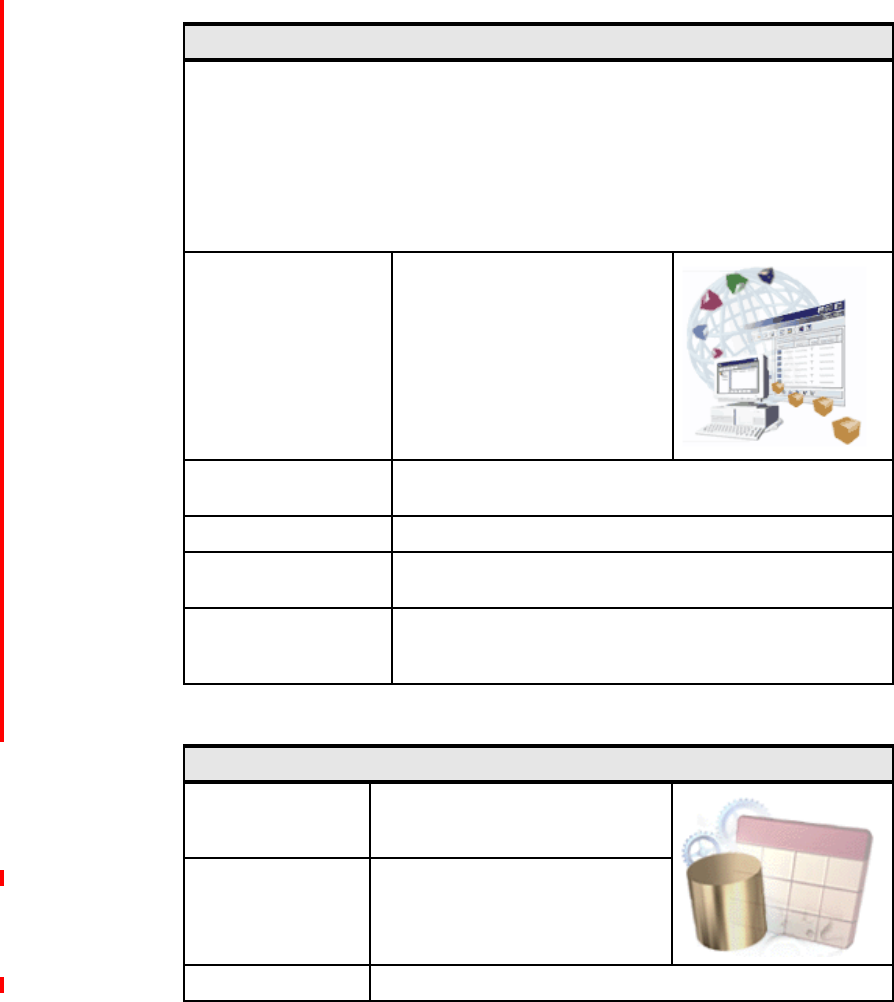
268 i5 Handbook
IBM DB2 Query Manager and SQL Development Kit for iSeries (5722-ST1)
The DB2 Query Manager and SQL Development Kit for iSeries provides an interactive query and
report writing interface. It also provides precompilers and tools to assist in writing SQL application
programs in high-level programming languages. Most SQL functions can be performed
interactively or in application programs.
The DB2 Query Manager and SQL Development Kit for iSeries provides an SQL Development Kit
for relational database access using programming languages such as C, RPG, COBOL, PL/I, and
REXX. The interactive query interfaces, Query Manager and Interactive SQL, are provided for
users to generate queries and reports, and for programmers to test complex SQL statements.
Ordering Shipped as a chargeable LPO
OS/400 software group-based
A software key is required.
Included on the Distribution
Keyed Media CD
Minimum operating
system level
i5/OS V5R4
Related product IBM Query for AS/400 (5722-QU1)
Replaces product IBM DB2 Query Manager and SQL Development Kit for AS/400
(5769-ST1)
Further information http://www-1.ibm.com/servers/eserver/iseries/db2/db2sql.htm
http://www.ibm.com/eserver/iseries/infocenter
http://www.ibm.com/servers/eserver/iseries/db2/
IBM DB2 QMF Distributed Edition for Multiplatforms V8.1 (5724-E86)
Minimum client and
OS/400 level
Microsoft Windows (on the Integrated
xSeries Server) or client based Server
capable of running OS/400 V5R1
Software type Passport Advantage
Replaces QMF for Windows for iSeries 5697-G24
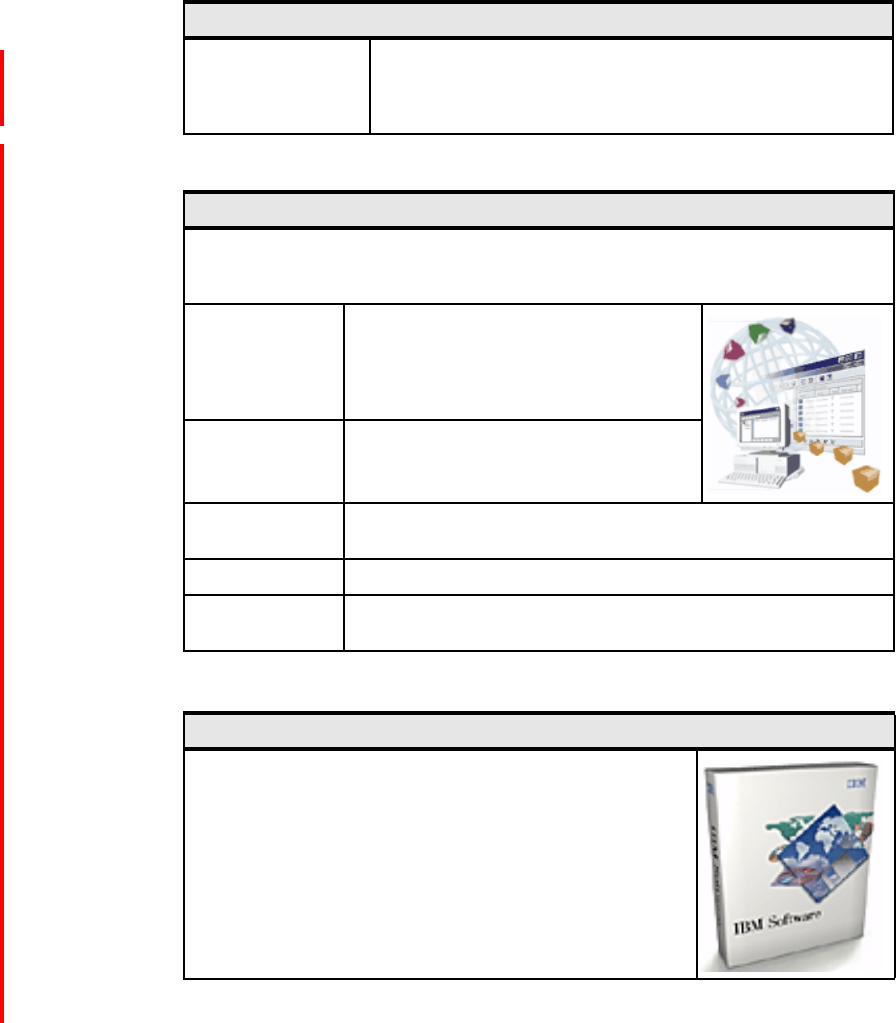
IBM licensed programs: Database accessories 269
Further information http://www-3.ibm.com/software/data/qmf/
ftp://ftp.software.ibm.com/software/data/qmf/pdfs/r202046.pdf
http://www.ibm.com/servers/eserver/iseries/db2/db2udbprod.htm
http://www.ibm.com/software/data/qmf/library.html
IBM DB2 UDB Data Warehouse Enterprise Edition and Standard Edition V8.1 (5724-E66)
IBM is a leader in Business Intelligence (BI). The technology built into the DB2 UDB Data
Warehouse Editions enables real-time information integration, insight, and decision making. The
editions combine the strength of DB2 UDB with the essential IBM BI infrastructure.
Ordering 5724-E66
Part number BB0HENA for DB2 UDB Data
Warehouse Enterprise Edition V8.1 Media Pack
Part number BB0HFNA for DB2 UDB Data
Warehouse Standard Edition V8.1
Software type Passport Advantage
Prerequisites http://www-3.ibm.com/software/data/db2/
datawarehouse/
Replaces product DB2 Warehouse Manager V8 (5765-F42)
Further information http://www-3.ibm.com/software/data/db2/datawarehouse/
http://www.ibm.com/eserver/iseries/software/s38utilities/
IBM System/38 Utilities for AS/400 (5722-DB1)
System/38 Utilities is used to run applications that were written using
System/38 Data File Utility or System/38 Query and that were
migrated from the System/38. The alternative is to rewrite all these
existing System/38 applications. The Text Management/38
component of System/38 Utilities for AS/400 is for use by migrators
whose word processing and data processing personnel use the Text
Management/38 component of System/38 Personal Services.
IBM DB2 QMF Distributed Edition for Multiplatforms V8.1 (5724-E86)
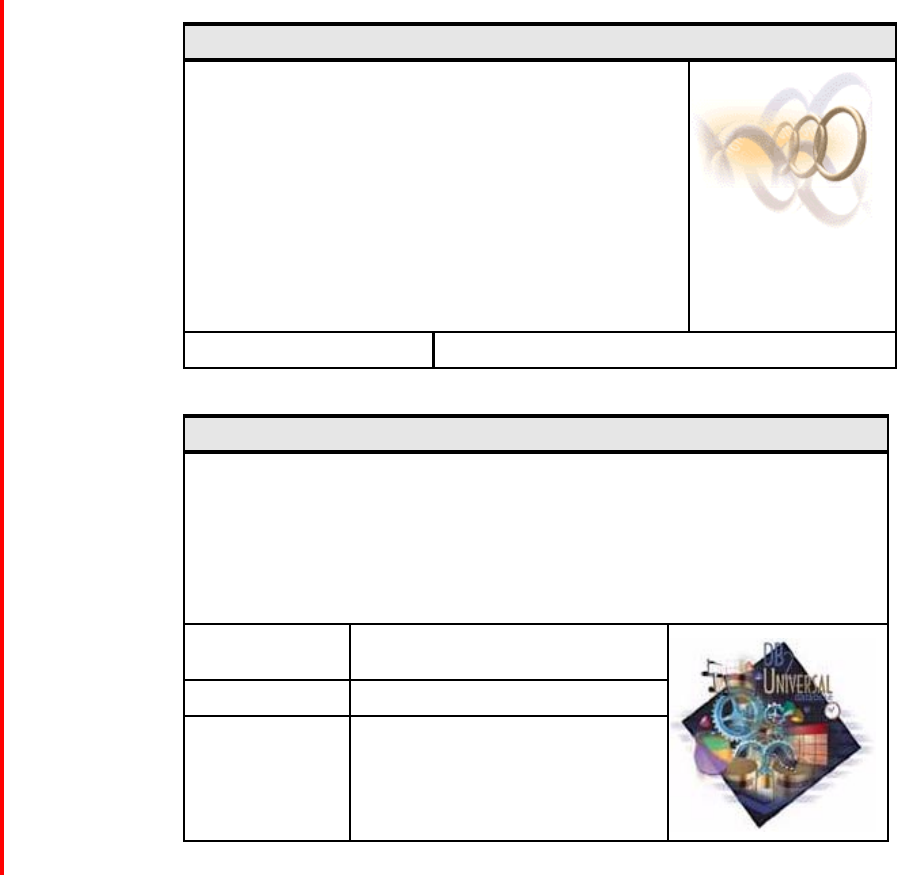
270 i5 Handbook
DB2 Spatial Extender Version 8 (5765-F40)
DB2 Spatial Extender allows you to store, manage, and analyze
spatial data (information about the location of geographic features)
in DB2 UDB along with traditional data for text and numbers. With
this capability, you can generate, analyze, and exploit spatial
information about geographic features, such as the locations of
office buildings or the size of a flood zone.
DB2 Spatial Extender extends the function of DB2 UDB with a set of
advanced spatial data types that represent geometries such as
points, lines, and polygons and many functions and features that
interoperate with those new data types. These capabilities allow you
to integrate spatial information with your business data, adding
another element of intelligence to your database.
Further information http://www.ibm.com/eserver/iseries/db2/extender/
IBM DB2 Universal Database Extenders for iSeries V8 (5722-DE1)
Web-enabled On Demand Business is driving most companies to redefine their IT strategy.
Moving away from proprietary data formats toward an open, interchangeable format, such as
XML, to transact business on the Web is a key part of the strategy.
In this electronic age, the bulk of a company’s managed data (90%), including e-mail, technical
and business documents, contracts, problem reports, and customer complaints, is still in textual
form. Companies continue to look for efficient ways to leverage such massive textual data to
provide valuable information. IBM DB2 Universal Database Extenders for iSeries V8 can help.
Minimum operating
system level
i5/OS V5R4
Software type SWMA
Further information http://www.ibm.com/software/data/db2
/extenders/
http://www-1.ibm.com/servers/eserver
/iseries/db2/

© Copyright IBM Corp. 1997 - 2006. All rights reserved. 271
Chapter 20. System i5 PCI and PCI-X I/O
processors
IBM System i5 models are designed for business computing. One of the
fundamental characteristics of that environment is that it is input/output
(I/O)-intensive, rather than compute-intensive. This chapter discusses Peripheral
Component Interconnect (PCI) system unit I/O processors (IOP) available from
IBM for System i5 servers and associated towers.
Refer to Chapter 11, “System i5 I/O adapters and controllers” on page 135, for
I/O adapter (IOA) information. Refer to the Customer Information Feature chapter
of the IBM System i5, Eserver i5, and iSeries System Builder, SG24-2155, to
identify the CIF status for each supported feature. See the IBM Redpaper PCI
Card Placement Rules for the IBM Eserver iSeries Server Version 5 Release 3,
REDP-4011 for complete configuration and card placement rules.
This chapter describes PCI IOPs that are supported by current System i5.
20

272 i5 Handbook
#2844/#9744/#9844 PCI IOP
The #2844 PCI IOP is an I/O processor which drives PCI IOA adapters in the
Model 520, 550, 570, 595, 800, 810, 825, 870, and 890 system units, and on
HSL attached PCI or PCI-X I/O expansion towers/units.
A #2844 can drive a maximum of four IOAs, subject to configuration restrictions
The #9844 Base PCI IOP was included with Models 520, 550, 570, 595, 825,
870, and 890, and PCI-X I/O towers #0595, #5094, #5095, #5294, #8094, and
#9094. However, as of 31 January 2006, the #9844 is not always included in
system units and expansion towers. The inclusion rules are as follows:
For expansions ordered after 31 January 2006, an IOP (#9844, #9943) is not
included at no-charge. The order process tools (LVT, Manufacturing
configurator and marketing configurator) cease to default any IOP for
expansion units, but do require priced IOPs (for example, the #2844) as
required to support the IOAs that are ordered. The exception to this is the
“base” I/O tower (#9194 or #8294) on the Model 595. The marketing
configurator defaults to a #9844 on a Model 595 with a 1.65GHz processor,
and allows de-selection of the #9844 if i5/OS V5R4 is ordered.
The existing definition of features #5560, #5561, #5562 and #5563 mirror
tower packages include an enclosure equivalent to a #0595 or #5095. The
#0595 and #5095 have included an IOP to be ordered at no-charge, and that
IOP is assumed to be part of the #0595 and #5095 in the four mirror tower
packages. As of 31 January 2006, #0595 and #5095 ordered as features, on
their own, no longer allow a no-charge IOP to be ordered for them. However,
because each of the four mirror tower package features also include two disk
IOAs (that cannot run IOP-less), the intent is to continue to allow a no-charge
IOP (a #9844) to be ordered with each of the four mirroring package features.
Model 520, 550 and 570 Systems ordered with processors announced prior
to 31 January 2006 (1.5GHz and 1.65GHz processors) include one no-charge
IOP (a #9844) to be placed in the first IOP slot in the system unit. This is
limited to one #9844 per system including a Model 570 with multiple system
unit enclosures.
A Model 595 system ordered with processor features (1.65GHz) announced
prior to 31 January 2006 include one no-charge IOP (#9844), regardless of
whether i5/OS V5R3 or V5R4 is ordered. When V5R3 is ordered, this #9844
must be placed in the #9194/#8294. When V5R4 is ordered, the marketing
configurator allows the #9844 to be de-selected. If the #9844 is ordered, it can
be placed wherever required within the system.
9406 Systems ordered with 31 January 2006 announced processors (1.9GHz
and 2.2GHz) do not allow any no-charge IOPs (except in conjunction with

System i5 PCI and PCI-X I/O processors 273
mirror tower package features), regardless of whether i5/OS V5R3 or V5R4 is
ordered.
Models 550, 570 and 595 ordered with 31 January 2006 announce
processors (1.9GHz and 2.2GHz) and i5/OS V5R3 require an IOP. The
required IOP (a #2844) must be purchased.
9405 Model 520 systems ordered with 31 January 2006 announce
processors (1.9GHz) allow a single no-charge IOP (a #9844 to drive the
included twinaxial IOA) to be ordered and placed in the first IOP slot in the
system unit.
9406 Systems ordered with V5R4 support IOP-less in all expansion towers,
including the primary I/O tower on Model 595 (1.65GHz and 1.9GHz
processors). Note that a Model 595 ordered with a 1.65GHz processor and
i5/OS V5R4 continue to default a no-charge IOP, even though IOP-less is
supported in the primary I/O tower. The marketing configurator defaults to a
#9844 on the interface for all Model 595s when a 1.65GHz processor is
selected. The #9844 can be deselected if i5/OS V5R4 is also selected.
Dual-mode adapters may be used with or without an IOP (IOP-less). They are
not supported IOP-less in the system units of Models 520, 550 and 570 with
1.5GHz or 1.65GHz processors, regardless of whether i5/OS V5R4 is ordered
or not.
IOPs on existing systems (both priced and no-charge features) migrate when
doing model upgrades. No-charge IOP features are supported but are not
orderable, except as explicitly noted otherwise.
#2847 PCI IOP for SAN Load Source
PCI IOP for SAN Load Source provides the specialized function required to
attach an i5/OS load source via a fibre channel adapter and boot from that load
source. The #2847 PCI IOP for SAN Load Source does not support multipath for
the i5/OS load source disk unit. It does support multipath for all other logical units
(LUNs) attached to this IOP. A minimum of two IOPs are required for enabling
redundancy.
The #2847 I/O processor is dedicated to driving a maximum of one IOA from the
following list:
#2766 PCI Fibre Channel Disk Controller
#2787 PCI-X Fibre Channel Disk Controller
#5760 PCI-X Fibre Channel Disk Controller
Refer to iSeries and IBM TotalStorage: A Guide to Implementing external disk on
eServer i5, SG24-7120 for more information.

274 i5 Handbook
http://www-912.ibm.com/n_dir/nas4apar.nsf/nas4aparhome
#4806 PCI-X Crypto Coprocessor
The #4806 PCI-X Crypto Coprocessor provides both cryptographic coprocessor
and secure-key cryptographic accelerator functions in a single PCI-X card. The
coprocessor functions are targeted to banking and finance applications. Financial
Pin processing and Europay, Mastercard, Visa (EMV) credit card functions are
provided. EMV is a standard for integrated-chip based credit cards.
The secure-key accelerator functions are targeted to improving the performance
of i5/OS Secure Sockets Layer (SSL) transactions. The #4806 provides the
security and performance required to support eBusiness and emerging digital
signature applications.
The #4806 provides secure storage of cryptographic keys in a tamper-resistant
hardware security module (HSM), which is designed to meet FIPS 140 security
requirements. FIPS 140 is a U.S. Government National Institute of Standards
and Technology (NIST) administered standard and certification program for
cryptographic modules.
The firmware for the #4806 is available is Licensed Program Product 5733-CY1
Cryptographic Device Manager. The firmware CD is ordered and distributed
separately from the #4806. The #4806 also requires Licensed Program Product
5722-AC3 Cryptographic Access Provider to enable data encryption.
This feature has country-specific usage.
#4710/#4810/#9710 PCI Integrated xSeries Server
The #4710, #4810, or #9710 PCI Integrated xSeries Server has a 2 GHz
processor and four memory slots. Each server memory slot can contain one of
the following features, providing a total main storage capacity from 1024 MB to
4096 MB:
512 MB server memory (#0426/#9726)
1 GB server memory (#0427)
A minimum of two server memory cards are required and must be installed in
identical capacity pairs. On model upgrades or MES orders, you may order a
#4710/#4810 without memory features if usable supported memory features
already exist on the installed system.

System i5 PCI and PCI-X I/O processors 275
The #4710, #4810, or #9710 includes one embedded 100/10 Mbps Ethernet LAN
controller. It can support the following LAN IOAs in combination:
#2744 PCI 100 Mbps Token Ring IOA
#5700 PCI 1 Gbps Ethernet IOA
#5701 PCI 1 Gbps Ethernet UTP IOA
You can order the #4710/#4810 without any LAN IOA features.
Up to three IOA LAN features can be supported by the #4710/#4810, depending
on the system unit or tower position into which the #4710/#4810 is placed.
Native AS/400 functions are not supported.
The #4710, #4810, or #9710 does not support an external host LAN.
#4711/#4812/#4813/#9812/#9813 PCI Integrated xSeries
Server
The #4711, #4812, #4813, #9812 and #9813 PCI Integrated xSeries Servers
contain a 2 GHz processor with 2MB integrated L2 cache. There are two
integrated 1000/100/10Mbps Ethernet ports. Two USB 1.1 ports are included and
an additional PC keyboard and mouse port.
There are two memory slots that must always contain a pair of identical memory
features. Total memory can be either 1GB or 2GB.
The #4811, #4812, #4813 are functionally identical with some physical
differences depending on the model in which they are used. The #9812 and
#9813 are functionally identical to the #4812 and #4813, but are included in the
base with orders for Enterprise editions on Models 550, 570 and 595.
The PCI Integrated xSeries Server requires an #2844, #9744, or #9844 Base
PCI IOP to drive it. The IOP can be shared, but only one PCI Integrated xSeries
Server is permitted per IOP.
The Integrated xSeries Server does not support any other LAN features and
does not support native i5/OS functions.
For Linux server products supported, see:
http://www.ibm.com/eserver/iseries/integratedxseries/linux
276 i5 Handbook

© Copyright IBM Corp. 1997 - 2006. All rights reserved. 277
Chapter 21. Lotus products for System i5
Lotus Domino for iSeries is the leading groupware solution available for the
System i5 server. It provides unparalleled capability for System i5 clients to use
their business data in collaborative solutions for On Demand Business, both
within their organizations and with their partners over the Internet. Lotus Domino
for iSeries provides a critical foundation as companies begin to move from
“information overload” into organizational learning and knowledge management.
No competitive product offers the ease of use, low cost of ownership, tight
integration, and positioning for the future that Lotus Domino for iSeries delivers.
Lotus Domino for iSeries is offered with familiar iSeries and AS/400e terms and
conditions for purchase, services, and support.
IBM Lotus Domino is the brand name for the server component in a family of
integrated messaging, collaboration, and Web application software from IBM.
Domino is a software, a framework, and an infrastructure that connects your
business to anyone, anywhere, anytime.
Domino is designed for growing organizations that need to improve customer
responsiveness and streamline business processes. Electronic
business-to-business communication, which was once a luxury, is now a
necessity. Electronic mail has become an important application. Web-enabling
your business (On Demand Business) is a requirement to remain competitive in
the marketplace.
IBM and Lotus work in partnership to offer solutions for today's business
environment by combining the strengths of Lotus Domino collaborative software
21

278 i5 Handbook
and System i5 hardware. The combination of Lotus Domino and the System i5
server delivers a highly scalable and reliable infrastructure for e-collaboration.
Lotus Domino for iSeries enables existing System i5 clients to build and deploy
messaging, mail, and collaborative applications on the same system as their
enterprise applications and data.
For clients who are looking to reduce their service delivery cost by eliminating
server farms and consolidating to a single platform, System i5 delivers the
scalability and reliability to support thousands of users and applications.
This chapter highlights the following IBM products that are offered by Lotus
Software.
Refer to Lotus Domino for the IBM Eserver iSeries Server Buying and Selling
Guide, REDP-3845, to further understand Domino solutions for the iSeries
server.
Product name Product number Refer to page
Lotus Domino 6 Message Server Licensing option 280
Lotus Domino 6 Enterprise Server Licensing option 280
Lotus Domino 6 Utility Server Licensing option 280
IBM Lotus Domino Collaboration Express
offering
Licensing option 278
IBM Lotus Domino Utility Server Express
offering
Licensing option 278
IBM Lotus Domino 6.5 for iSeries 5733-L65 281
Lotus Domino client Varies 282
IBM Lotus Enterprise Integrator® for iSeries 5733-LEI 284
IBM Lotus Instant Messaging and Web
Conferencing for iSeries
5733-LST 285
IBM Lotus Team Workplace for iSeries 5733-LQP 285
IBM Lotus Domino Document Manager 5769-LDD 286
IBM Integrated Domino Fax for iSeries 5733-FXD 286

Lotus products for System i5 279
Domino on iSeries
A Domino on iSeries solution provides a compelling case for using the iSeries as
the Domino server of choice. Of particular interest to Domino users are:
Reliability
The stability of the iSeries hardware and software coupled with the iSeries
architecture, which logically insulates applications from one another,
promotes uninterrupted performance.
Availability
Centralized backup and recovery for applications and data and the ability to
run multiple partitioned Domino servers (DPARs) on one physical iSeries
server leads to increased system availabilty.
Scalability
The iSeries server product line allows for nondisruptive growth from a
uni-processor to a 32-way system on the same operating system, using the
same skill sets.
Server efficiency
iSeries servers feature system management capabilities that allow processor
resources to be highly used. Servers that lack these capabilities lead to
server farms of poorly used systems.
Server consolidation
Multiple physical Domino servers can be consolidated into one iSeries server,
and additional users can be catered for without additional servers. This saves
cost and eases the management environment. Local area network (LAN)
traffic declines as Domino servers communicate over the virtual Ethernet
within the iSeries hardware.
Integration
Domino for iSeries is designed to integrate with many of the built-in Operating
System/400 (OS/400) services including security, backup and recovery,
systems management, iSeries Navigator, Java virtual machine (JVM), and
IBM DB2 Universal Database (UDB) for iSeries. Furthermore, the iSeries is
the only server that allows deployment of Linux, Java, UNIX, Windows, AIX 5L
and Domino-based applications on a single server.

280 i5 Handbook
Domino server options
Lotus Domino for iSeries is a powerful, popular, versatile, and integrated
groupware product from Lotus Software. It provides functions that include e-mail,
workflow-based computing, and the integration and management of both
structured and unstructured data. Domino is a server product that runs on a
variety of platforms, providing easy-to-manage interpretability in a
heterogeneous network.
Versions of IBM Lotus Domino prior to Version 6 are not supported at i5/OS
V5R3. Lotus Domino 6 for iSeries includes five separately orderable
components, as represented in the following table.
Domino Server Options Description
IBM Lotus Domino
Messaging Server
IBM Lotus Domino Messaging Server combines full support for
the latest Internet mail standards with Domino’s state of the art
messaging and calendaring capabilities, all in one manageable
and reliable package.
IBM Lotus Domino
Enterprise Server
IBM Lotus Domino Enterprise Server includes all functions of the
messaging server, plus support for custom intranet and Internet
applications, and partitioning and clustering technology for high
availability.
IBM Lotus Domino Utility
Server
IBM Lotus Domino Utility Server is an application server license
option that includes unlimited access to non-mail applications.
Entitlement to messaging capability is not available with this
option.
IBM Lotus Domino Utility
Server Express offering
The IBM Lotus Domino Utility Server Express offering is powered
by the Domino Enterprise Server. It provides unlimited access to
collaborative applications, but does not allow the use of individual
mail files. Clients can choose to access their Domino applications
through a Web browser or via a separately purchased Lotus
Notes® client. IBM Lotus Domino Utility Server Express makes
applications available to users who are internal to that
organization and to external users. Access is allowed for
individually authenticated and anonymous users.
IBM Lotus Domino
Collaboration Express
offering
The IBM Lotus Domino Collaboration Express offering is powered
by the Domino Enterprise Server and allows clients to use both
the messaging and collaborative capabilities of Domino. Clients
can choose to access Domino via Lotus Notes or Lotus Domino
Web Access (iNotes™) clients for both e-mail and collaborative
applications.

Lotus products for System i5 281
IBM Lotus Domino 6.5 for iSeries (5733-L65)
With the delivery of Domino 6.5 Lotus continues to play a major role in the On Demand Business
revolution. To meet the challenges of business globalization, frequent mergers and acquisitions,
and the increasing demand for Web-based business tools, Lotus has combined both evolution
and innovation in its latest upgrade of Domino server technology. The features in Domino 6.5 build
on the features in previous releases to address rapidly changing industry trends and meet their
challenges directly.
Ordering product number 5724-E70
Minimum operating
system level
OS/400 V5R1
Software type Software Maintenance
Installation prerequisites http://www.lotus.com/products/produ
ct4.nsf/wdocs/
65dominosysrequirements
http://www-10.lotus.com/ldd/notesua
.nsf/RN?OpenView
Related products IBM Integrated Domino Fax for iSeries
(5733-FXD)
Lotus Enterprise Integrator (LEI)
(5733-LE1)
Replaces product Lotus Domino Server for iSeries R5
Ordering Domino 6 is orderable through standard Lotus channels only.
Further information http://www.ibm.com/software/howtobuy
http://www.ibm.com/servers/eserver/iseries/domino/
http://www.lotus.com/products/r5web.nsf/webpi/
Domino+for+iSeries/
http://www.lotus.com/ldd/domino6

282 i5 Handbook
Domino Notes client choices
The choice of clients supported by Domino for iSeries are represented in the
following table.
New with Lotus Domino Client 6.5
The clients provided for Domino build upon previous clients. They include such
enhancements as:
Single access point for Lotus Notes users
Improve productivity by providing unified access to the tools, tasks, and
people with whom users work. There is also an introduction to portals.
Lotus Notes clients Description
IBM Lotus Domino Access for
Microsoft Outlook®
IBM Lotus Domino Access for Microsoft Outlook allows
Microsoft Outlook users to access e-mail and calendar
features based on Lotus Domino.
IBM Lotus Domino Web Access
(iNotes)
IBM Lotus Domino Web Access extends Domino messaging
and collaboration, personal information management (PIM),
and offline services to Web browsers clients.
IBM Lotus Notes for Messaging IBM Lotus Notes for Messaging is a license-only Lotus Notes
client option with capability limited to messaging, calendar,
and discussions. The degree of function available to the user
is controlled by the administrator via a parameter in the
Domino Directory.
IBM Lotus Notes for
Collaboration
IBM Lotus Notes for Collaboration is a full-function integrated
client for messaging, calendar, and discussions, plus the
capability to use custom Domino applications.
Domino Administrator Domino Administrator is the Win32® graphical interface for
administration and management of the Domino environment,
including registration of users and servers. It is provided with
the Domino server and with the Domino Designer® client. It is
not available separately.
Domino Designer Domino Designer is the interactive, Win32 graphical
development environment for creation of powerful intranet and
Internet applications. The Domino Designer client option also
includes Lotus Notes for Collaboration and Domino
Administrator.

Lotus products for System i5 283
Lotus Instant Messaging integration
Single signon gives users the ability to view and manage online status and be
aware of a colleagues presence through online status indicators while users
remain within the context of a e-mail or task.
Enablement of applications to start IBM Lotus Instant Messaging via
application integration
Follow up
You have the ability the mark e-mails with a follow up flag (high, normal, or
low) to indicate further action is necessary. Alarms can be set for a specific
date and time, including e-mail notifications. The inbox can be sorted via the
follow-up priority flags.
Inbox management features
Anti-spam features block e-mails from specified senders reducing junk mail. A
QuickRules option on the Tools menu automates the creation of rules by
populating sender, domain, and subject from selected messages.
Further productivity features
You have the ability to drag and drop e-mails from the inbox view to the
calender. You can view only unread mail in the inbox view by toggling the
message on and off. A facility is included to allow Lotus Notes to be set as the
default mail client, so that when users click a mailto: link on a Web page, a
new message window is automatically open in Notes.
Linux client support via a Mozilla browser in Lotus Domino Web Access
(iNotes)
Lotus Domino Web Access 6.5 integration of Lotus Instant Messaging
functionality and an increased feature parity with Lotus Notes
Changes to Lotus Domino Access for Microsoft Outlook
The new architecture uses open Internet standards (IMAP/Simple Mail
Transfer Protocol (SMTP)/iCAL), with improved scalability, lower resource
use, and a more solid solution. It also supports Outlook 2000 and 2002
clients.
Refer to the following Web site for information about Domino client choices:
http://www.lotus.com/engine/jumpages.nsf/wdocs/products

284 i5 Handbook
The following table shows the Domino and LEI release compatibility.
IBM Lotus Enterprise Integrator 6.5 for iSeries (5733-LEI)
The Lotus Enterprise Integrator (LEI) is a server-based product that provides data movement
between DB2 UDB for iSeries and Domino with no programming required. LEI allows the
exchange of data with the integrated file system (IFS) of the iSeries and Enterprise Resource
Planning (ERP) applications. Domino forms-based interfaces are used to map fields in a Domino
database to columns in a DB2 table. Lotus Enterprise Integrator takes care of the movement and
conversion of data between the data sources.
Ordering product
number
5724-E89
Minimum operating
system level
OS/400 V5R1
Software type Software Maintenance
Related product Lotus Domino Enterprise Server for
iSeries (5733-LD6)
Replaces product IBM Lotus Enterprise Integrator for Domino R5 (5769-LNP)
Ordering LEI is orderable through standard Lotus Channels only.
Further information http://www.lotus.com/products/product4.nsf/wdocs/
enterpriseintegrator/
http://www-1.ibm.com/servers/eserver/iseries/domino/related/
lei.htm
LEI for iSeries versions and updates Compatible Domino releases
LEI 6.5.1 for iSeries Domino 6.5.1
LEI 6.5.0 for iSeries Domino 6.5.0 and Domino 6.0.3
LEI 6 for iSeries LEI 6.0.1 for Domino 6.0.1, LEI 6.0.2 for Domino 6.0.2

Lotus products for System i5 285
l
IBM Lotus Instant Messaging and Web Conferencing (5733-LST)
Lotus Instant Messaging and Web Conferencing is real-time collaboration software, with online
awareness, instant messaging, application sharing and virtual meetings. Lotus Instant Messaging
and Web Conferencing helps your organization be more responsive and more efficient by allowing
your employees, customers, partners, and suppliers to easily interact with one another in
real-time.
Real-time collaboration is a natural extension to e-mail. You not only chat with colleagues, but you
use the Web to improve customer service, reduce travel costs, and create communities among
your employees, customers, partners, and suppliers.
The product is also included within WebSphere Portal - Express Plus. WebSphere Portal -
Express Plus is included with the Enterprise Edition of the Models 520, 550, 570, and 595 as well
as the Solutions Edition of 550.
Minimum operating
system level
OS/400 V5R1
Software type Software Maintenance
Passport Advantage
Installation prerequisites http://www.ibm.com/eserver/iseries/sametime/sysreq.html
Related products IBM Lotus Domino 6 for iSeries (5733-LD6)
IBM Lotus Domino 6.5 for iSeries (5733-L65)
IBM Lotus Team Workplace (QuickPlace) (5733-LQP)
Replaces product None
Ordering Through standard Lotus channels or free with the Enterprise Edition of
Models 825, 870, and 890
Further information http://www.ibm.com/eserver/iseries/sametime
http://www.lotus.com/sametime
http://www.lotus.com/ldd
IBM Lotus Team Workplace for iSeries (5733-LQP)
IBM Lotus Team Workplace (QuickPlace) is the Web-based solution for creating team work spaces
for collaboration. The product is also included within WebSphere Portal - Express Plus.
WebSphere Portal - Express Plus is included with the Enterprise Edition of the Models 520, 550,
570, and 595 as well as the Solutions Edition of the 550. For more information about WebSphere
Portal Express Plus, refer to “IBM WebSphere Portal - Express, IBM WebSphere Portal - Express
Plus for Multiplatform, Version 5 (5724-E77)” on page 651.
Minimum operating
system level
OS/400 V5R1
Software type Software Maintenance
Passport Advantage
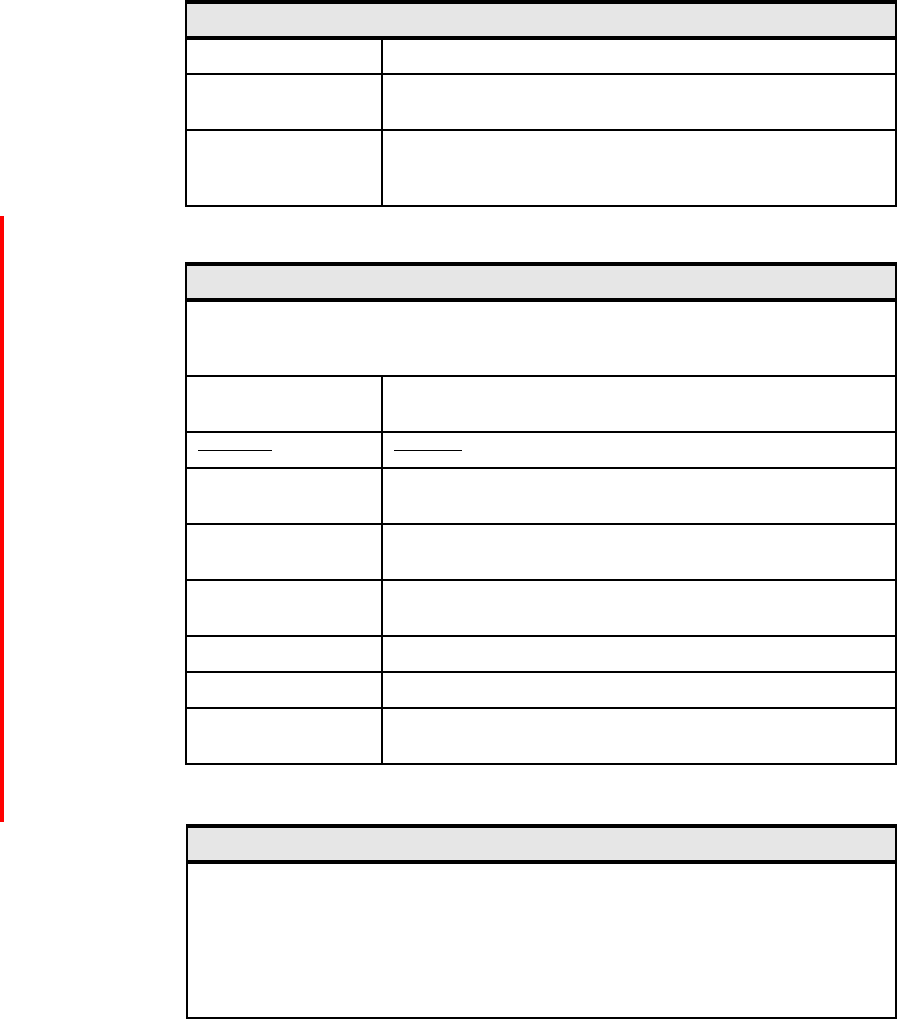
286 i5 Handbook
Installation prerequisites http://www.ibm.com/eserver/iseries/quickplace/sysreq.htm
Related products IBM Lotus Domino 6.5 for iSeries (5733-L65)
IBM Lotus Instant Messaging and Web Conferencing (5733-LST)
Further information http://www.ibm.com/eserver/iseries/quickplace
http://www.lotus.com/quickplace
http://www.lotus.com/ldd
IBM Lotus Domino Document Manager (5769-LDD)
IBM Lotus Domino Document Manager (Domino.Doc®) brings scalable, flexible document
Management capabilities to Domino. It extends the concept of a shared document library via an
open, Web accessible, distributed, and collaborative environment.
Minimum operating
system level
OS/400 V4R5
Availability July 2001
Software type Software Maintenance
Passport Advantage
Installation prerequisites http://www-1.ibm.com/servers/eserver/iseries/domino/related/
domdoc.htm
Related products IBM Lotus Workflow™
IBM Instant Messaging and Web Conferencing
Replaces product None
Ordering Through standard Lotus channels
Further information http://www.lotus.com/products/domdoc.nsf/content/
domdochomepage
IBM Integrated Domino Fax for iSeries (5733-FXD)
IBM Integrated Domino Fax for iSeries enables Lotus Notes users to send and receive faxes
directly from their Notes client, using their current telephone system and Domino infrastructure.
Domino Fax for iSeries supports more than just simple text. Notes memos containing rich text and
graphics can also be faxed. Files attached to Notes memos can also be formatted and faxed. In
addition with the Print-to-Fax driver (available for download at no charge), Notes users can send
faxes directly from within a Microsoft Windows application, such as word processing or
spreadsheet software.
IBM Lotus Team Workplace for iSeries (5733-LQP)

Lotus products for System i5 287
Minimum operating
system level
OS/400 V5R1
Software type Software Subscription
Installation prerequisites http://www-1.ibm.com/servers/
eserver/iseries/domino/
related/fxd/
Related product Lotus Domino 6 for iSeries
Replaces product Lotus Fax for Domino V4R1
Ordering IBM Licensed Program Product. Not available through Passport
Advantage.
Further information http://www-1.ibm.com/servers/eserver/iseries/domino/
related/fxd/
IBM Integrated Domino Fax for iSeries (5733-FXD)
288 i5 Handbook

© Copyright IBM Corp. 1997 - 2006. All rights reserved. 289
Chapter 22. IBM Application
Development Licensed
Program Products
Business leaders who are looking to solve business problems with automation
start by choosing an application to fit their business goals and needs. System i5
clients worldwide have tens of thousands of proven business applications from
which to select. Application development is an undeniable strength of the System
i5 server. This strength is based on the support for traditional and On Demand
Business development provided in the i5/OS operating system.
This chapter describes today’s application development Licensed Program
Offerings (LPOs). It focuses on the key tools for application development for the
System/i5 client. To understand this and how to develop new business value then
the iSeries Developers RoadMap can be found at:
http://www-03.ibm.com/servers/eserver/iseries/roadmap/index.html
To learn about the IBM On Demand Business strategy for the System/i5, refer to
WebSphere for IBM Eserver iSeries Server Buying and Selling Guide,
REDP-3646. See Chapter 26, “Web collaboration and WebSphere” on page 325,
to understand the strength of the WebSphere family of products.
22
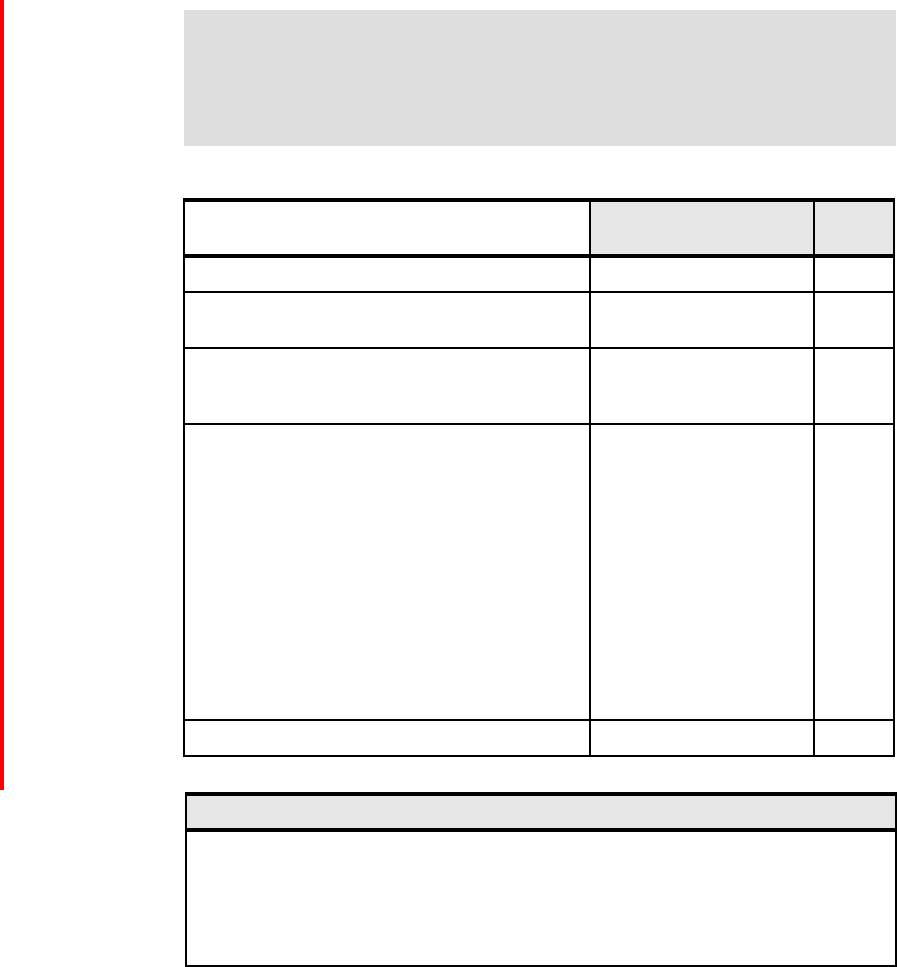
290 i5 Handbook
Tip: As an operating system (AIX within OS/400) and an application
development suite (AIX/UNIX application development for OS/400), OS/400
Portable Application Solutions Environment (PASE) gives application
providers a path to the System/i5 product line. Refer to “OS/400 PASE” on
page 261 for a description of OS/400 PASE.
Product name Product number Refer
to page
IBM CICS Transaction Server for iSeries 5722-DFH 290
IBM WebSphere Application Server Version 5.1 for
iSeries Developer Edition
5724-D18 330
IBM Java for iSeries
IBM Toolbox for Java
IBM Developer Kit for Java
5722-JC1
5722-JV1
291
292
IBM WebSphere Development Studio for iSeries
Server components:
Application Development ToolSet
ILE RPG
ILE COBOL
ILE C
ILE C++
Workstation components:
IBM WebSphere Development Studio Client for
iSeries, V6.0
IBM WebSphere Development Studio Client
Advanced Edition for iSeries V6.0
5722-WDS
5722-WDS (Standard client
is free with entitlement)
(Advanced client is offered
via the Passport Advantage
channel)
294
295
294
295
295
295
296
297
298
IBM XML Toolkit for iSeries 5733-XT1 291
IBM CICS Transaction Server for iSeries (5722-DFH)
The Customer Information Control System (CICS) platform is widely used as a basis for
implementing business solutions. The CICS architecture defines a common programming
interface and inter-system communications between various systems. Because of this
architecture, CICS Transaction Server for iSeries enables many of these applications to be made
available on the iSeries server without excessive costs of code conversion. CICS applications and
data can coexist with iSeries applications and data.
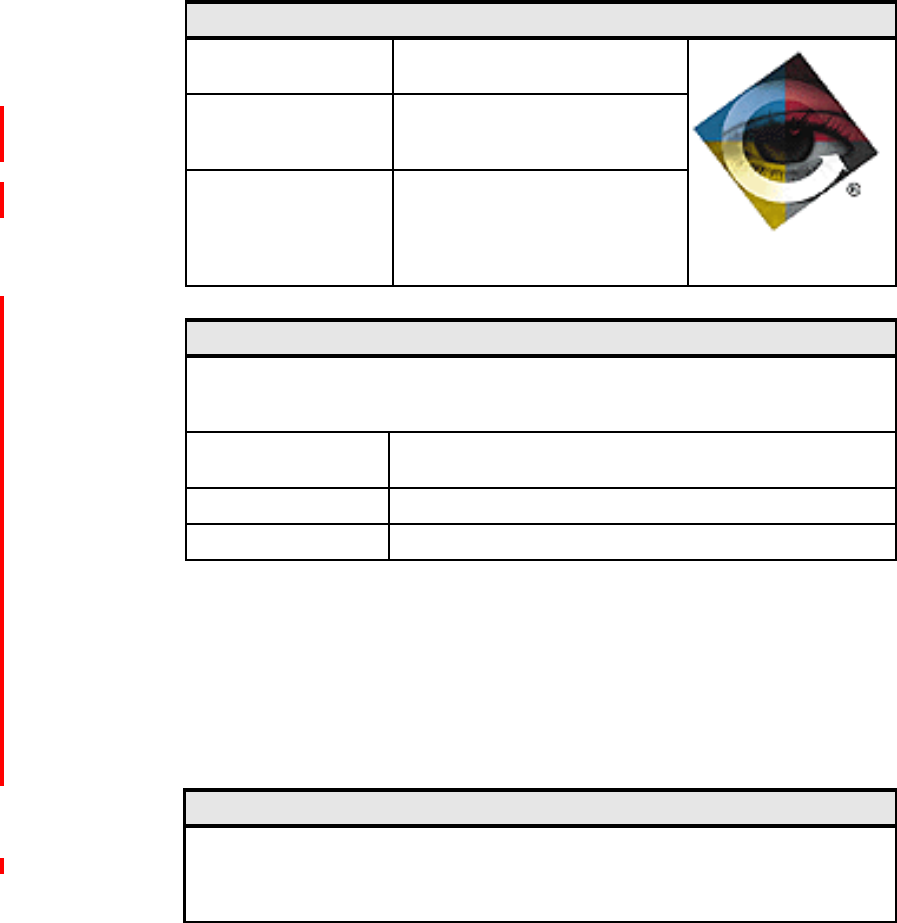
IBM Application Development Licensed Program Products 291
Minimum operating
system level
OS/400 V5R2
Replaces Product CICS Transaction Server for iSeries
(5722-DFH) (V5R1)
CICS for AS/400 (5769-DFH
Further information http://www-306.ibm.com/software/h
tp/cics/
http://publib.boulder.ibm.com/inf
ocenter/iseries/v5r3/topic/rzahg/
rzahgcics.htm
XML Toolkit for iSeries (5733-XT1)
XML is widely touted as a solution to the problem of information exchange between applications
and within B2B environments. It is simple, extensible, and non-proprietary. XML parser APIs
assist in the creation, navigation, or modification of XML document content.
Minimum operating
system level
OS/400 V5R1
Replaces product XML parsers service programs QXML4C310 and QXMLPR310
Further information http://www.ibm.com/servers/eserver/iseries/software/xml
IBM Toolbox for Java (5722-JC1)
IBM Toolbox for Java is a set of Java classes that allow you to write Java applications, applets, and
servlets to access data on your System/i5 server. IBM Toolbox for Java also provides a set of
graphical user interface (GUI) classes. These classes use the access classes to retrieve data and
then present the data to the user.
IBM CICS Transaction Server for iSeries (5722-DFH)
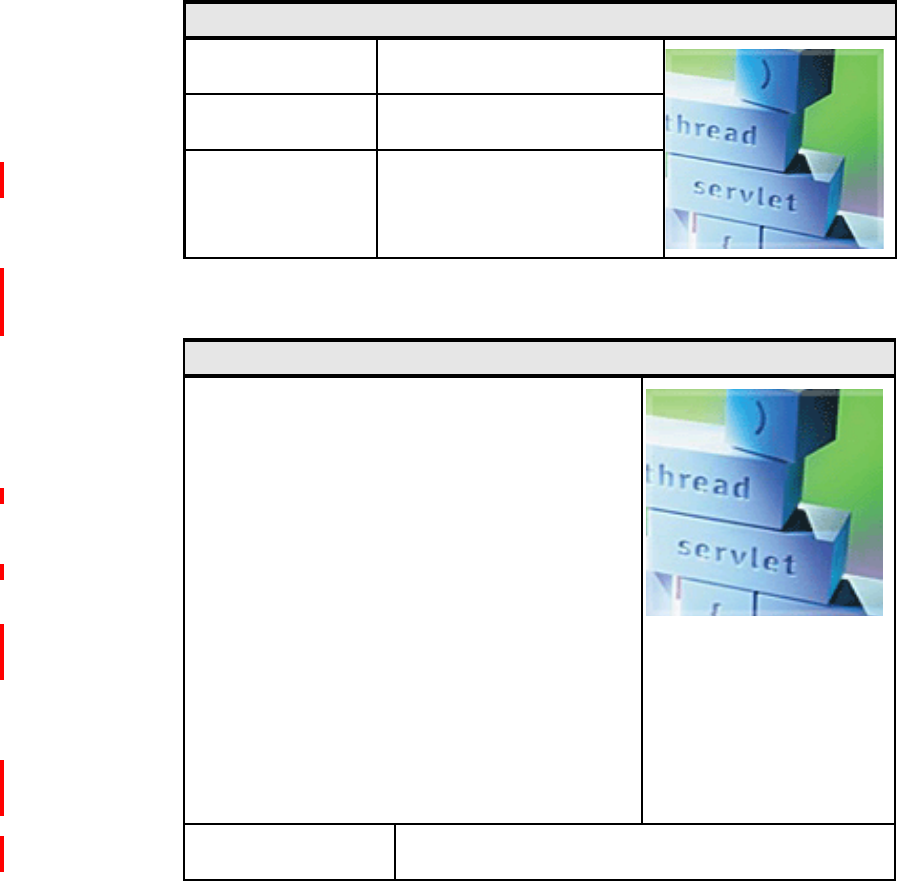
292 i5 Handbook
Ordering product
number
Included with 5722-SS1
Minimum operating
system level
OS/400 V5R1
Further information http://www-03.ibm.com/servers/es
erver/iseries/toolbox/
IBM Developer Kit for Java (5722-JV1)
IBM Developer Kit for Java facilitates the creation of Java
applets and full-scale applications. It includes a collection of
development tools, help files, and documentation for Java
programmers. As Sun Microsystems, Inc. rolls out new Java
technologies and provides updates, the Developer Kit is also
updated. System i5 support of Java is planned to be made
available over several releases, and applications written using
the Developer Kit are portable.
The System/i5 supports multiple Java 2 Software Developer
Kit (SDK) (J2SDK) Standard Editions. It also supports the use
of multiple JDKs simultaneously, but only through multiple
JVMs. A single JVM runs one specified JDK. Find the JDK to
be used and select the coordinating option to be installed.
More than one JDK can be installed at one time. The
java.version system property determines which JDK to run.
After a JVM is up and running, changing the java.version
system property has no effect.
There is a new 32-bit version of the JVM intended to help ISV
portability. It should also help memory usage and could
improve Java application performance.
Further information http://publib.boulder.ibm.com/infocenter/iseries/v5r3/topic
/rzaha/multjdk.htm?resultof=%22%6a%64%6b%22%20
IBM Toolbox for Java (5722-JC1)
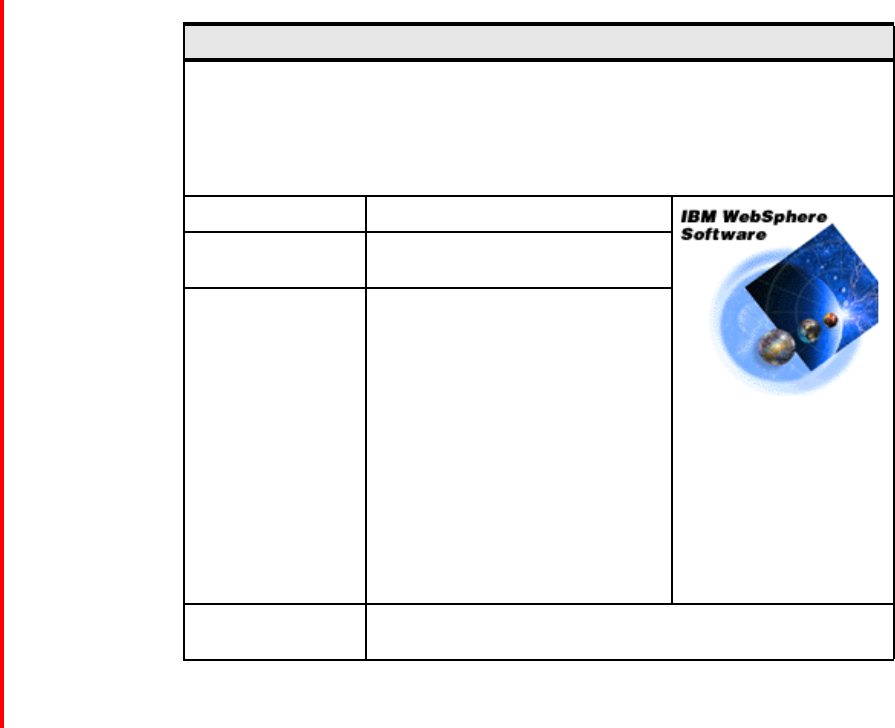
IBM Application Development Licensed Program Products 293
The following diagram shows the server (host) and workstation (client)
components of WebSphere Development Studio 6.0.1. The workstation
components are those included with the “base” client.
IBM WebSphere Development Studio for iSeries (5722-WDS)
WebSphere Development Studio for iSeries is an integrated, comprehensive suite of
application development tools for both On Demand Business and traditional iSeries
development. It is the pervasive iSeries development tool set containing both server and
workstation components that are optimized for iSeries development. With this product new
iSeries server applications and new applications for On Demand Business can be created. It
is also easy to convert existing business applications to Web-enabled solutions.
Ordering 5722-WDS
Minimum operating
system level
OS/400 V5R4
Replaces products 5769-CB1 ILE COBOL for AS/400
5769-CL2 VA RPG and CODE/400
5769-CL3 WebSphere Development
Tools for AS/400
5769-CX2 ILE C for AS/400
5769-CX5 VisualAge for C++ for AS/400
5799-GDW ILE C++ for AS/400 PRPQ
5769-PW1 Application Development
ToolSet for AS/400 (ADTS)
5769-RG1 ILE RPG for AS/400
Note: Clients with Software
Subscription can upgrade, at no
additional charge, to 5722-WDS from
any of the products listed, except
5799-GDW.
Further information http://www-306.ibm.com/software/awdtools/wds400/
http://www-306.ibm.com/software/awdtools/library/
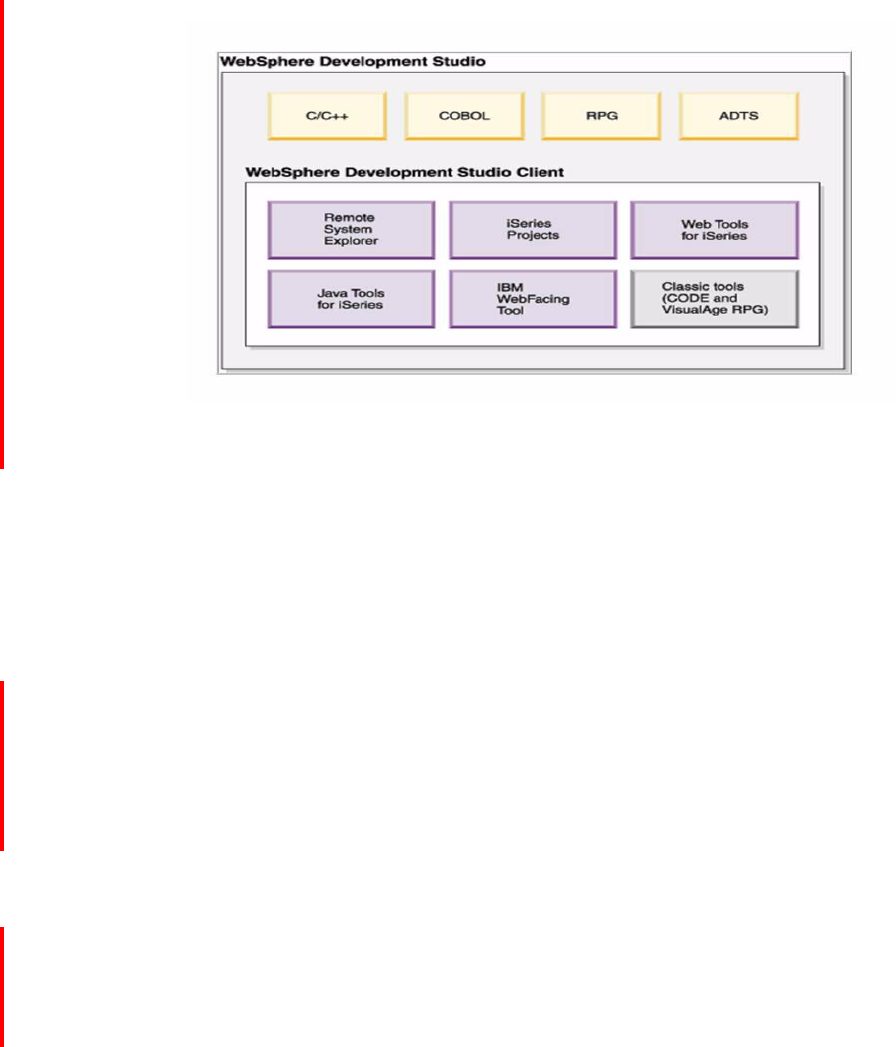
294 i5 Handbook
A description of the host and workstation components of WebSphere
Development Studio are highlighted in the following sections.
Server components of 5722-WDS
The host (server-based programming tools) components of WebSphere
Development Studio include:
IBM Integrated Language Environment RPG for iSeries
IBM Integrated Language Environment Cobol for iSeries
IBM Integrated Language Environment C and C++ for iSeries
Application Development ToolSet
IBM Integrated Language Environment RPG for iSeries
RPG is the most popular language for writing iSeries business logic due to its
ease of use and tight integration with the server.
ILE RPG for iSeries is designed for writing various types of application programs.
This language is easy to learn, yet offers many advanced functions for
experienced programmers. It delivers RPG IV, the next evolution of the
programming language. The RPG IV compiler offers improved programmer
productivity and application growth and quality. Previous versions of the RPG are
shipped as options.
For a list of the current and previous enhancements to the RPG compiler, see:
http://www-306.ibm.com/software/awdtools/wds400/about/ile_rpg.html

IBM Application Development Licensed Program Products 295
IBM ILE COBOL for iSeries
Cobol is popular language for writing iSeries business logic because of its ease
of use and integration with the system. ILE COBOL for iSeries is a programming
language that is used in the processing of business problems. COBOL can be
used to manipulate DB2 Universal Database (UDB) for iSeries database files in a
relatively simple way. COBOL uses English-like syntax to assist the programmer
in generating self-documenting, structured programming constructs. Previous
versions of Cobol are shipped as options
For a list of current and previous enhancements to the COBOL compiler, see:
http://www-306.ibm.com/software/awdtools/wds400/about/ile_cobol.html
IILE C
The ILE C compiler is a high-performance, high-function compiler for C
development on the System i5 platform. It provides a combination of function-rich
C programming and the power of Integrated Language Environment (ILE). ILE
gives fast calls and a uniform run-time model which are definite benefits for
call-intensive C programming
ILE C++
The C++ compiler provides additional features not found in the C language.
These features include additional keywords, parameterized types (templates),
support of object-oriented programming via classes, and stricter type checking.
With the ILE C++ Compiler, you can develop object-oriented, mission-critical
applications for the System i5 server. You can take advantage of the
object-oriented technology, such as data encapsulation and code reuse, to
quickly design and adapt applications for changing business needs
For a list of the current and previous enhancements to the C and C++ compilers,
see:
http://www-306.ibm.com/software/awdtools/wds400/about/ile_ccpp.html
Application Development ToolSet
Application Development ToolSet (ADTS) is the traditional tool suite for System i5
application development programmers. These tools are included in the package
so that existing System i5 programmers can more easily make the shift to the
new development tools and environment.
ADTS contains these utilities:
Programming Development Manager (PDM)
Source Entry Utility (SEU)
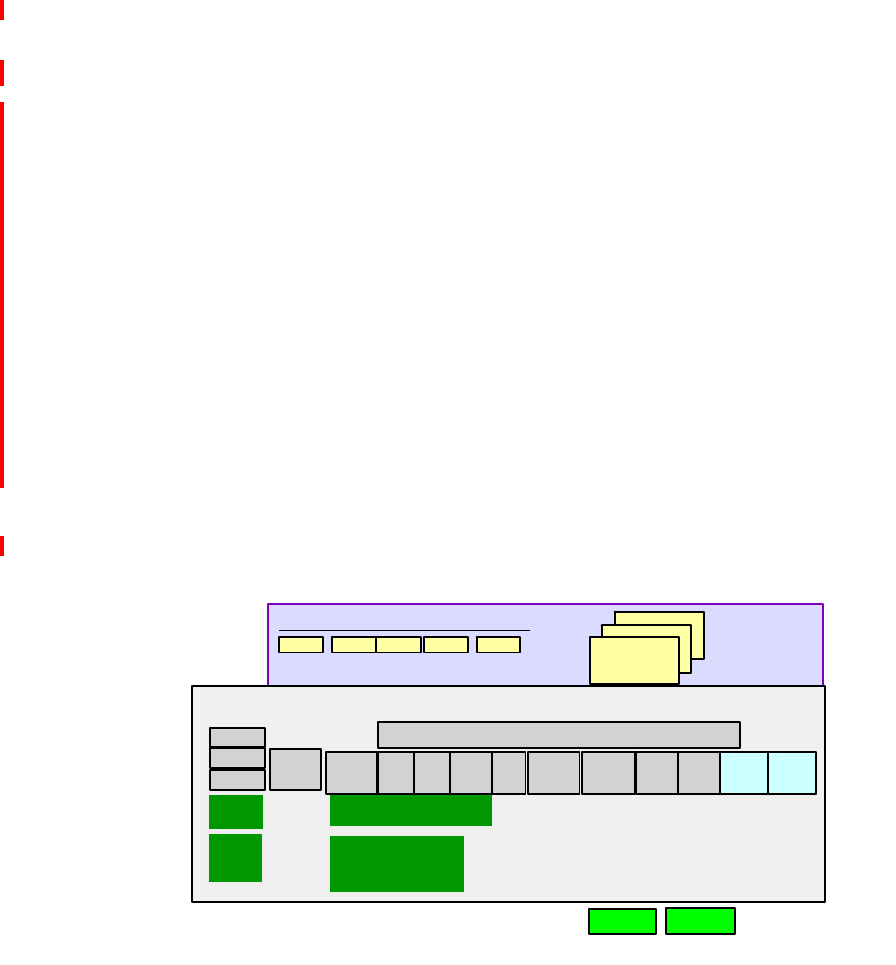
296 i5 Handbook
Screen Design Aid (SDA)
Report Layout Utility (RLU)
Data File Utility/Application Development (DFU/AD)
File Compare and Merge Utility (FCMU)
Interactive Source Debugger (ISDB)
Workstation components of 5722-WDS
The WebSphere Development Studio client for iSeries is a free entitlement with
WebSphere Development Studio for iSeries. New orders of 5722-WDS are
entitled to the V6.0 workstation tools. Existing V5R3 5722-WDS customers who
have a current iSeries SW Maintenance contract may upgrade to V6 by ordering
5722-WDS #2656. The workstation product is also available via Passport
Advantage as 5724-A81. The workstation tools contained are:
WebSphere Development Studio Client refesh pack V6.0.1
Rational Web Developer refresh pack V6.0.1
Remote System Explorer
i5/OS plugins for Java, Web and Web Services
IBM Webfacing Tool
Host Access Transformation Toolkit V6.0.4
5/OS debugger
separate installation of CODE and VARPG
The following diagram shows the workstation (client) and server (host)
components of WebSphere Development Studio.
WebSphere
Development
Studio Client
WebSphere
Development
Studio Client
WebSphere Development Studio 6.0.1
WebSphere
Development
Studio Client
COBOL RPG CC++ ADTS
Host
Client
Rational Web Developer + iSeries Tools
Rational Web Developer + iSeries Tools
CODE VARPG
iSeries
Projects
Remote
System
Explorer
iSeries
Extensions
IBM WebFacingTool
Team
Projects
UI F/W
Plug-in
Tools
Java
Tools
Web
Struts
Appl. Srvr
Tools
WebSphere Application Server Unit Test Environment
Web Svc.
Tools
XML
Tools
DB
Tools
HATS
Toolkit
V6.0.4
JSF
EGL
Java
generation
Debug WDSc Lite

IBM Application Development Licensed Program Products 297
IBM WebSphere Development Studio Client for iSeries, V6.0.1
WebSphere Development Studio Client for iSeries leverages the capabilities of
Rational Web Developer to optimize and simplify Web application development.
Remote Systems Explorer provides System i5 system access similar to PDM for
the editing, compiling and debugging of System i5 applications. The improved
development capabilities of this environment provide the upgrade path for those
more familiar with SEU and PDM.
iSeries Java Tools are included offering improved Program Call Markup
Language (PCML) support and a new feature in the Program Call Wizard
allowing authentication and library list settings to be defined in a separate
configuration file for greater flexibility.
The iSeries integrated debugger delivers support for end- to-end debugging of
Web applications plus enhanced integration with RSE.
The tools also include the IBM Web Facing Tool, which is a source-code based
application transformation development tool. New web settings simplify
customizing of Web-enabled interfaces to 5250 applications to make them look
and feel like native Web applications. Web-enabled applications run in batch
mode with no OLTP requirement.
The tool has been updated to include extensions to allow Web-enabled
applications created with the WebFacing tool to interoperate with a 5250
application in a browser using IBM Host Access Transformation Server (HATS).
The HATS Toolkit (V6.0.4) quickly and easily generates a default dynamic
runtime transformation of the 5250 data stream with no requirement for 5250
OLTP capacity at V5R4. The resulting Web interface can also be customized with
the HATS Toolkit. The Web interface can be deployed to production with the
purchase of HATS separately.
For a detailed comparison of the IBM WebFacing Tool and the HATS Toolkit, see:
http://www-306.ibm.com/software/awdtools/wdt400/about/compareWebFacingHats.html
Note: You must have i5/OS V5R4 for the server portion of WebSphere
Development Studio. The V6.0.1 client can work with OS/400 V5R2, i5/OS
V5R3 or V5R4. The C++ compiler requires a machine capable of running
OS/400 PASE and Option 33 of OS/400 (5722-SS1).
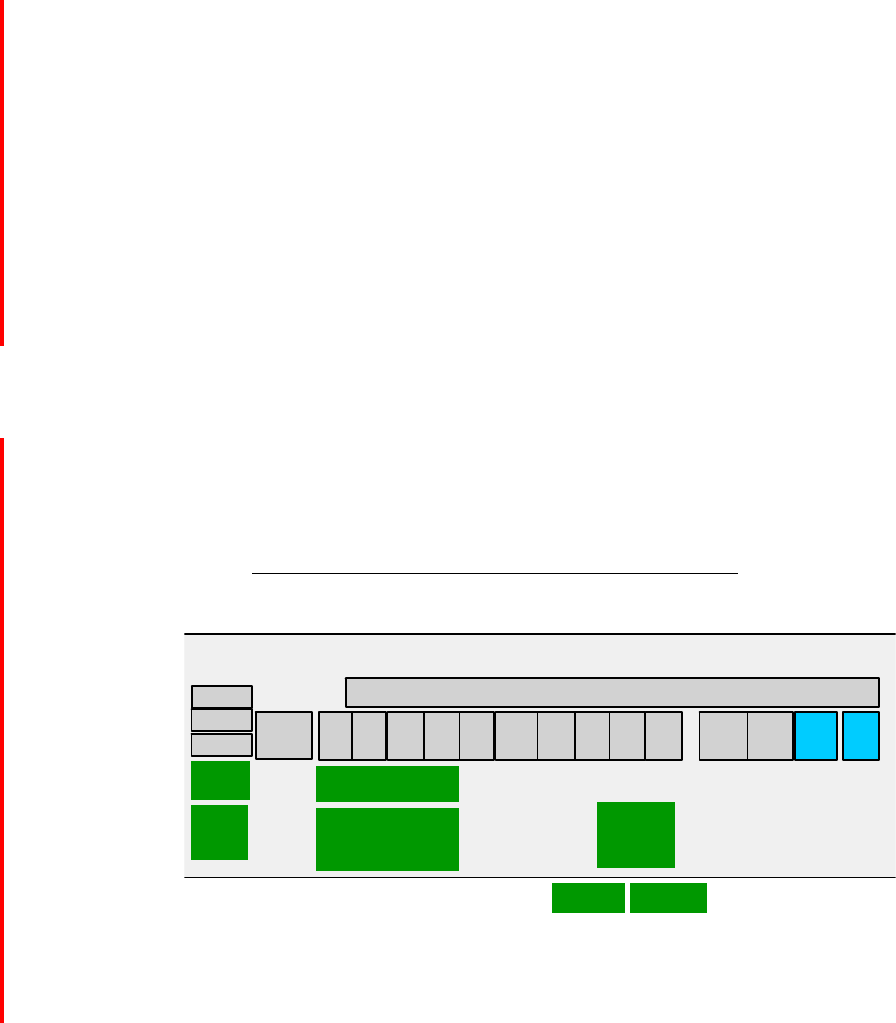
298 i5 Handbook
WebSphere Development Studio Client Advanced Edition for
iSeries V6.0.1
WebSphere Development Studio Client Advanced Edition for iSeries contains all
the features of the base client, with the following extensions:
Extension of the Web Facing Tool to include Single signon enabling users to
access more than one application and mulitple platforms using one ID and
password.
Portal support allowing the generation of Struts-based portlet applications or
add a WebFacing portlet to an existing non-Struts based portlet project.
System Screen support to allow developers to include System i5 system
screens in their Web enablement.
Additional capabilities include the J2EE development environment and
Enterprise Java Bean support. For a full comparison, see:
http://www-306.ibm.com/software/awdtools/wdt400/about/WDSC_featureList.
html
The following diagram shows the workstation (client) components of WebSphere
Development Studio Client Advanced Edition for iSeries V6.0.1
Web technology choices
The following table may be used for selecting an appropriate tool within IBM
Development Studio Client Advanced Edition to provide business solutions. Find
WebSphere Development Studio Client Advanced Edition V6.0.1
Client
Rational Application
Rational Application Developer +
Developer + iSeries Tools
iSeries Tools
CODE VARPG
iSeries
Projects
Remote
System
Explorer
iSeries
Extensions
IBM WebFacingTool
Team
Projects
UI F/W
Plug-in
Tools
Java
Tools
Web
Struts
Appl.
Srvr
Tools
WebSphere Application Server Unit Test Environment
Web
Svc.
Tools
XML
Tools
DB
Tools
Debug EJB
Tools
Profiling
Tracing
Tools
Perform
ance
Analysis
Tools
HATS
Studio
Portal
Toolkit
EGL COBOL
generation
JSF
EGL
Java
gen

IBM Application Development Licensed Program Products 299
the objective in the first column of the table that most closely matches your goal
and review the technology choice that can help you achieve the goal.
Easy/400
Easy/400 is an Open Source Site that provides free tools that enable RPG and
COBOL programmers to develop full rational e-business solutions by exploiting
their current skills. These tools are delivered with their source. Easy/400 can be
found at:
http://www-922.ibm.com/en?
Your goal Technology Features
Quickly Web-enable existing
interactive System i5
applications
IBM WebFacing Tool Converts a display file (DSPF) DDS to JSPs built
on struts
Build Web applications with
System i5 business logic
iSeries Web Tools Wizards and Web components for building JSP
files that provide a user interface for System i5
business logic; build on Struts
Build Web applications with
System i5 data
JavaServer Faces (JSF) Rich tagging choices for user interface; strategic
choice for data-driven applications that have little
business logic; emerging technology (a potential
follow-on to Struts)
Build Web applications with
System i5 data, moving more
user interface logic to the
client
JSFs with client-side scripting Provides better response times by reducing trips to
the server; validation and formatting is done on the
client; uses JSF extensions
Build Web applications with
Java business logic
Struts and Struts tools Rich tagging choices for model-controller;
leverages JSPs for the user interface
Encapsulate your applications
from future technology
changes and enable them for
multiple platforms
Enterprise Generation
Language (EGL)
Fourth generation language (4GL); abstracts your
applications at a higher level and generated the
appropriate Java (standard edition) or iSeries
COBOL code (Advanced Edition only); leverages
JSF; learning time relatively short for COBOL or
RPG programmers
300 i5 Handbook
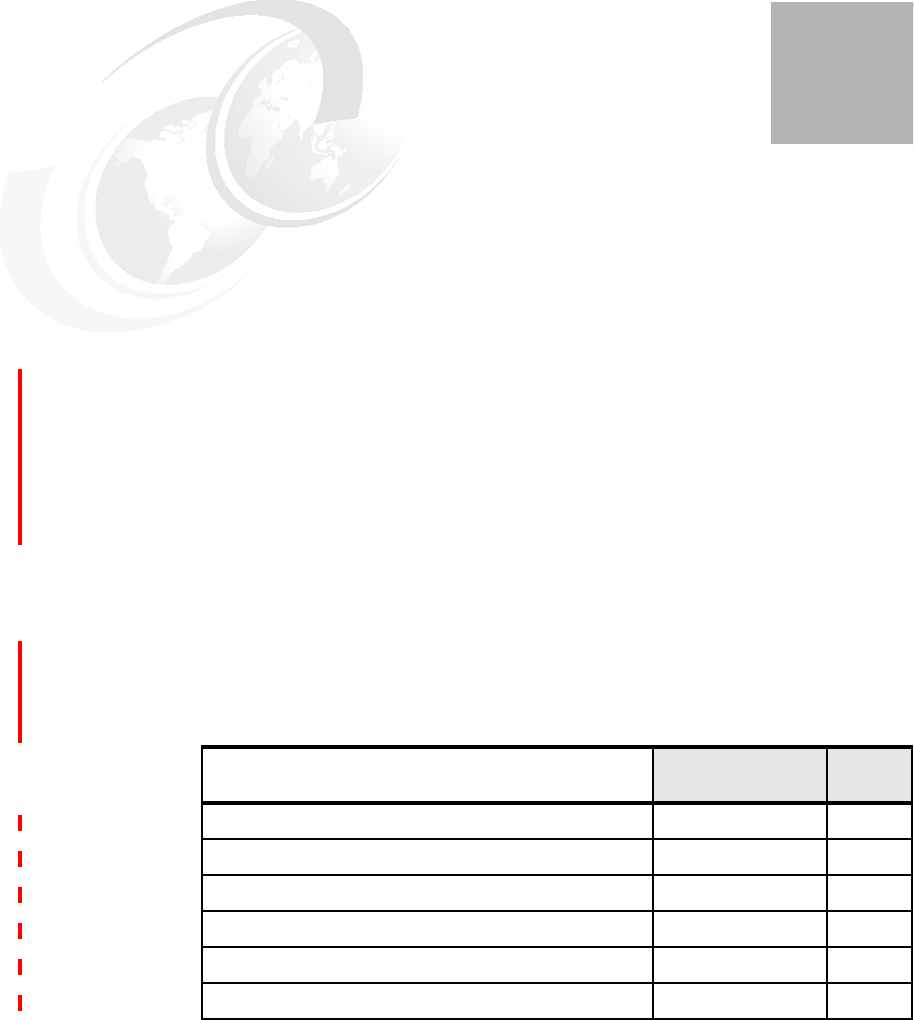
© Copyright IBM Corp. 1997 - 2006. All rights reserved. 301
Chapter 23. IBM Networking and
communications licensed
program products
Access to network resources is a fundamental requirement for today’s business
environment. This chapter identifies the optional Licensed Program Products
(LPP) that serve to connect users to the IBM System i5 or to link the System i5 to
a network. It also lists licensed programs that support secure network access.
23
Product name Product number Refer to
page
IBM WebSphere MQ for iSeries, V5.3 5724-B41 303
IBM Communications Utilities for iSeries 5722-CM1 302
IBM Cryptographic Support for AS/400 5722-CR1 302
IBM MQSeries Integrator for iSeries and DB2 Version 1.1 5697-F49 303
IBM Facsimile Support for iSeries 5798-FAX 302
IBM WebSphere Host Integration Solution for iSeries V5 5724-J97 / J98 303
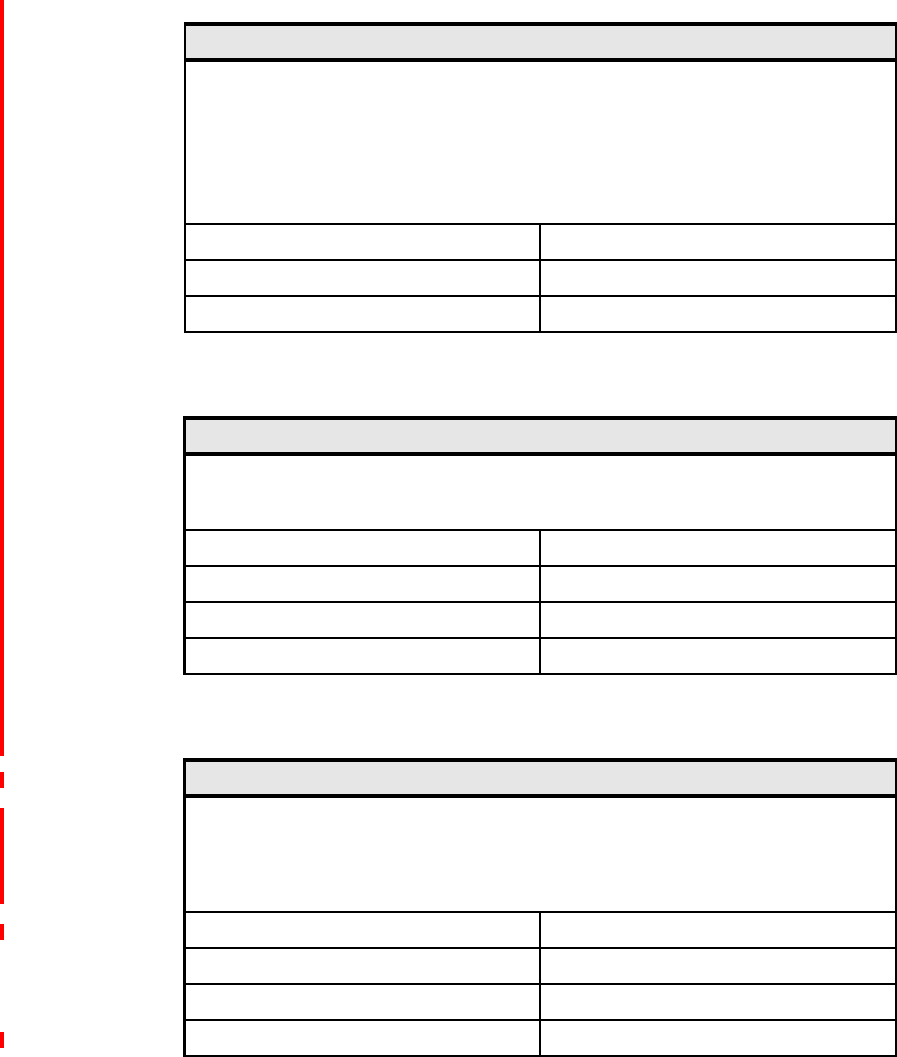
302 i5 Handbook
IBM Cryptographic Support for AS/400 (5722-CR1)
Cryptographic Support for AS/400 is a legacy product designed to be functionally equivalent to
the cryptographic facilities of the IBM 4700 Finance Controller. Cryptographic Support for AS/400
supports the following functions:
Data encryption/decryption using the Data Encryption Standard (DES) and 56-bit keys
Message Authentication Code generation and verification using DES
Key management
3624 Personal Identification Number (PIN) generation and verification
Minimum operating system level OS/400 V5R1
Related product None
Replaces product None
IBM Communications Utilities for iSeries (5722-CM1)
The Communications Utilities for iSeries comprise the MVS/VM bridge and Remote Job Entry
(RJE) functions. These capabilities provide the interchange of mail and files and the submitting or
receiving of jobs between connected systems.
Minimum operating system level OS/400 V5R1
Installation prerequisites None
Related product None
Replaces product None
IBM Facsimile Support for iSeries (5798-FAX)
Facsimile Support for iSeries provides the base product enablers to fax System i5 or PC output
(such as text, images, or graphics) and to receive incoming faxes. Integration of the product with
the OS/400 Mail Server Framework allows users of various electronic mail services to exchange
mail. The integration allows electronic mail to be sent to a fax machine as easily as it is sent to
another computer.
Minimum operating system level OS/400 V5R1
Installation prerequisites None
Related product None
Further information http://www.ibm.com/iseries/fax400

IBM Networking and communications licensed program products 303
IBM WebSphere MQ for iSeries V5.3 (5724-B41)
IBM WebSphere MQ for iSeries provides an open, scalable, industrial-strength messaging
backbone which supports high volume throughput, time-independent communication, with
assured one-time delivery. To this, WebSphere MQ V5.3 adds enhanced security via SSL
support, enhanced performance especially for Java Message Service (JMS) applications and
other new features that enhance system scalability and reliability.
Minimum operating
system level
OS/400 V5R1
Software type Passport Advantage
One-year subscription (5733-M27)
Three-year subscription (5733-M28)
Replaces product MQSeries for iSeries V5.2 5733-A38
Further information http://www.ibm.com/software/ts/mq
series/messaging/
IBM WebSphere Host Integration Solution for iSeries V5 (5724-J97/J98)
IBM WebSphere Host Integration Solution (HIS) for IBM System i5 can enable virtually every user
to access your mission-critical business systems, independent of the platform, network,
connectivity, or host system. It includes the following:
IBM Communications Server for Linux V6.2
IBM Communications Server for AIX V6.1
IBM Communications Server for Windows V6.1.2
IBM Personal Communications V5.8 for Windows
WebSphere Studio Site Developer (WSSD), V5.1
WebSphere Development Studio Client for iSeries (WDSc), V5.1
WebSphere Applications Server - Express (Application Server - Express) V5.1
IBM WebSphere Host On-Demand V9.0
IBM WebSphere Host Access Transformation Services (HATS) V5.0
Further information http://www.ibm.com/software/webservers/hostintegration/
304 i5 Handbook

© Copyright IBM Corp. 1997 - 2006. All rights reserved. 305
Chapter 24. IBM eServer iSeries Access
products
IBM Eserver iSeries Access Family (5722-XW1) provides the middleware
software to connect other systems and platforms to System i5 servers. This
chapter describes the iSeries Access products.
24
Product name Product number Refer to page
IBM Eserver iSeries ODBC Driver for Linux 5733-L01 310
IBM Eserver iSeries Access for Windows 5722-XE1 307
IBM Eserver iSeries Access for Web 5722-XH2 308
IBM Eserver iSeries Access for Linux 5722-XL1 309
IBM Eserver iSeries Access for Wireless 5722-XP1 309
IBM Eserver iSeries Access Family 5722-XW1 305
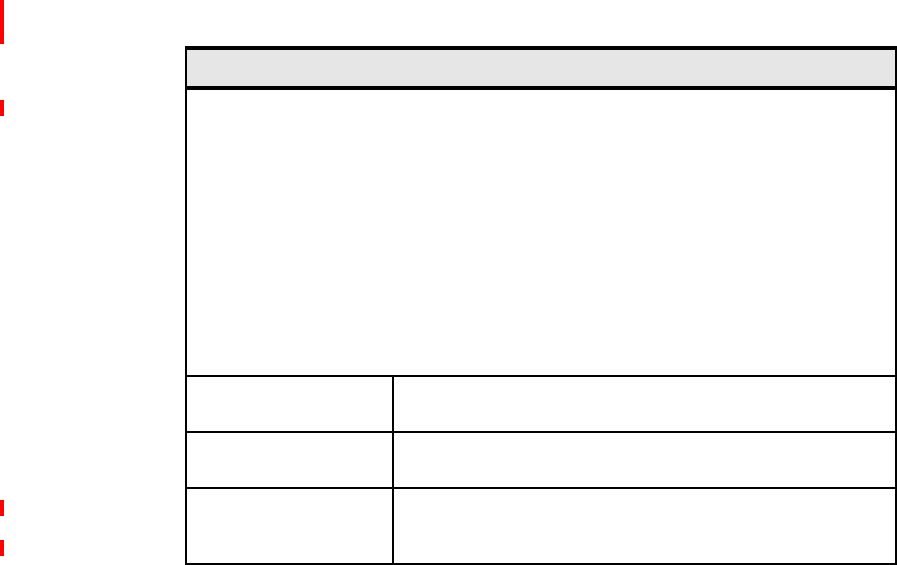
306 i5 Handbook
IBM Eserver iSeries Access Family (5722-XW1)
iSeries Access Family is a single product to solve all the desktop-to-iSeries connectivity needs. It
provides data connectivity from other systems and platforms to iSeries servers.
Increasingly, application providers are taking advantage of heterogeneous platforms to deliver
solutions. iSeries Access Family provides the middleware so that applications can easily be built
to run on the desktop, browsers, and wireless devices, yet work with iSeries resources simply and
efficiently. This combination provides iSeries clients with more application options and helps to
lower the cost of management for these solutions.
Deploying PCs to your users should enhance their productivity without increasing your PC
network administration costs. iSeries Access is your ideal connectivity solution because it
contains a unique set of products that integrate the use of a variety of PCs and workstation
desktops, browsers, and wireless devices with the iSeries server. It has the functions that end
users need, yet it is built to be centrally administered.
Minimum operating
system level
i5/OS V5R3
Replaces products Client Access Family (5722-XW1)
Client Access Family (5769-XW1)
Further Information http://www-03.ibm.com/servers/eserver/iseries/access/
http://publib.boulder.ibm.com/infocenter/iseries/v5r3/topic
/rzahg/rzahgicia.htm
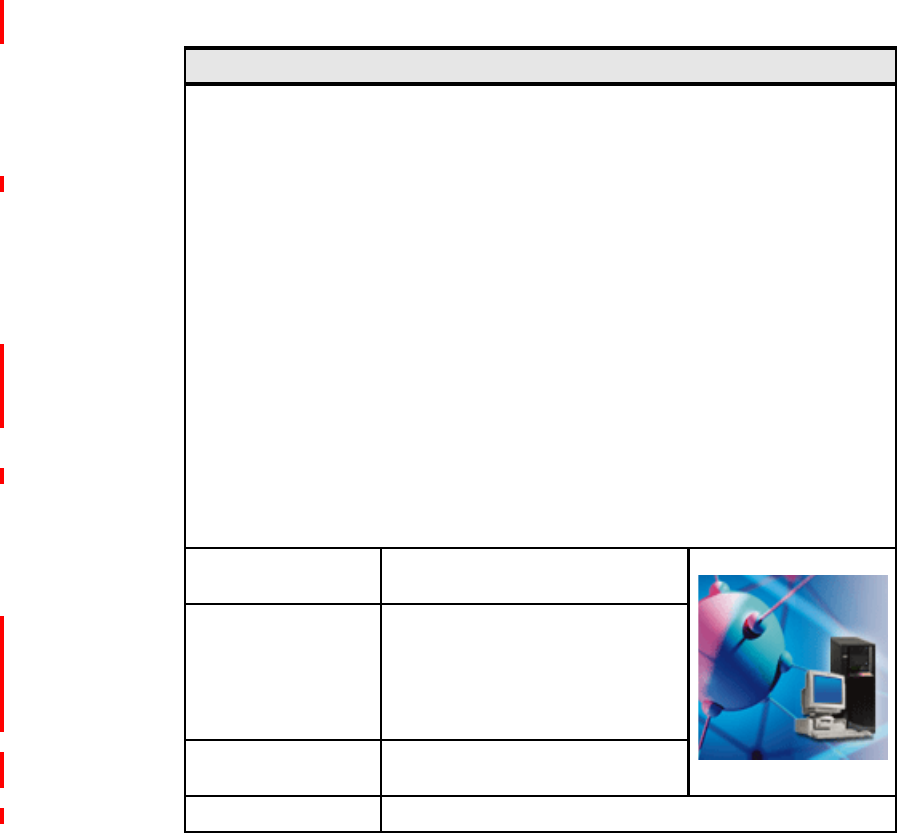
IBM eServer iSeries Access products 307
IBM Eserver iSeries Access for Windows (5722-XE1)
IBM Eserver iSeries Access for Windows, previously known as iSeries Client Access Express for
iSeries, is a component of the IBM Eserver iSeries Access Family (5722-XW1). It offers a
powerful set of capabilities to connect PCs to iSeries servers. It also enables end users and
application programmers to leverage business information, applications, and resources across an
enterprise by extending the System i5 resources to the PC desktop.
iSeries Access for Windows provides:
TCP/IP connectivity with Secure Sockets Layer (SSL) for client functions to improve TCP/IP
network security
iSeries NetServer for PC file serving and network print support
Operations Console for both local and remote system console access
All functions of iSeries Navigator for working with System i5 resources and administering and
operating System i5 servers, plus graphical interfaces to work with the System i5
With V5R4128-bit SSL encryption is an installable component. This function was previously
supplied as the product Client Encryption (5722-CE3).
Integrated graphical user interface (GUI) features deliver increased productivity for end users who
access resources on System i5 servers.
iSeries Access for Windows is compatible with Windows 98, Windows Me, Windows 2000,
Windows XP, and Windows NT 4.0 operating systems.
Minimum operating
system level
i5/OS V5R3
Client code This is an iSeries Access client that runs
on Windows operating systems. The
code is shipped in the LPP and stored in
IFS directory and is downloaded from
the IFS directory to the PC and is
shipped on a PC CD.
Replaces products Client Access Express (5722-XE1)
Client Access Express (5769-XE1)
Further information http://www-03.ibm.com/servers/eserver/iseries/access/

308 i5 Handbook
IBM Eserver iSeries Access for Web (5722-XH2)
IBM Eserver iSeries Access for Web is a Java application that runs in a Web application server
(for example, WebSphere Application Server or Apache Software Foundation ASF Tomcat) on
OS/400 V5R2 or later System i5 servers. End users access its functions by starting their browser
and connecting to an System i5 server.
iSeries Access for Web can used with the Mozilla browser as well as Internet Explorer and
Netscape. This enables users on desktop operating systems such as Windows, UNIX, Linux, and
MacIntosh to access System i5 resources.
It provides a variety of functions, such as 5250 emulation, and access to System i5 printers,
printer output, database, jobs, job queues, message queue, and so on. It also provides the ability
to run OS/400 CL batch commands without using a 5250 emulation session.
iSeries Access for Web also contains iSeries Access for Linux which provides an ODBC driver to
access the DB2 UDB for iSeries and a 5250 emulator.
New function in V5R4 includes supported Web Application Servers increased to include
WebSphere Application Server 6.0. Support for WebSphere Security model to enable single
sign-on. Enhancements to 5250 session support including Bypass signon, HTML keyword support
and hotspot support. Further enhancements include database function and the implementation of
style sheets.
Host Access Transformation Server Limited Edition (HAS LE) is no longer being bundled with
5722-XH2.
Minimum operating
system level
i5/OS V5R3
Ordering Ships with OS/400
Replaces Product 5722-XH1
Further information http://www-1.ibm.com/eserver/iseries
/access/web/
http://www-1.ibm.com/servers/eserver
/iseries/access/linux/
http://www.ibm.com/eserver/iseries/a
ccess/web/5250.html

IBM eServer iSeries Access products 309
IBM Eserver iSeries Access for Linux (5722-XL1)
IBM Eserver iSeries Access for Linux runs natively on Linux operating systems offering
Linux-based access to System i5 servers. iSeries access for Linux contains a 5250 emulator and
an ODBC driver.
It is not available as an individually orderable product. However, it is available with the iSeries
Access for Web (5722-XH2) client or via download from the Web:
http://www14.software.ibm.com/webapp/download/search.jsp?go=y&rs=ilinux
The 5250 Display Emulation component requires an iSeries Access Family (5722-XW1) license
before it can be used.
The new function in V1.10 provides Kerberos Support to provide authentication tools over a
network, together with single signon support and a bypass signon function. iSeries Access for
Linux information has also been added to the Information Center at V5R4.
Minimum operating system
level
OS/400 V5R1
Further information http://www.ibm.com/eserver/iseries/access/linux/
IBM eServer iSeries Access for Wireless (5722-XP1)
IBM Eserver iSeries Access for Wireless provides access to System i5 administrative functions
and development tools intended for wireless devices such as personal digital assistants (PDAs)
and Internet-enabled phones. Using the functions of the iSeries Access for Wireless licensed
program, you can use your wireless device to access and administer your servers.
iSeries Access for Wireless consists of two separate services that can be used individually, or
together, to provide the access you need:
iSeries Navigator for Wireless
IBM Toolbox for Java 2 Micro Edition
Minimum operating
system level
i5/OS V5R3
Client code This product is client code that runs on
wireless devices. The code is shipped
in the LPP and stored in IFS directory
and is downloaded to the client device
Further information http://www-1.ibm.com/servers/eserver/iseries/access/wireless/
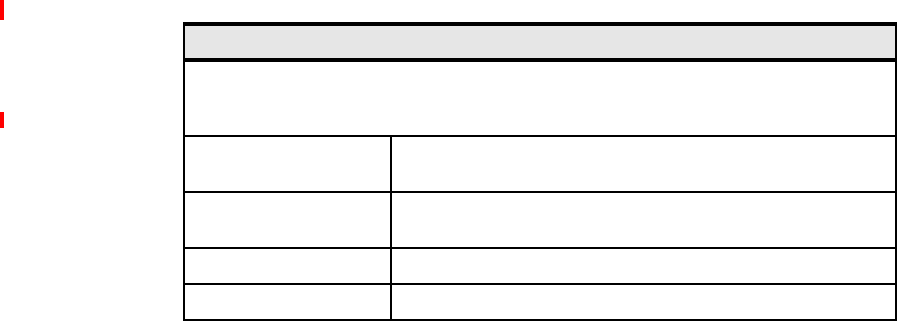
310 i5 Handbook
iSeries ODBC Driver for Linux (5733-L01)
The iSeries ODBC Driver for Linux is an ODBC driver that allows you to access the iSeries
database from a Linux client. Linux applications written to the ODBC API can use this driver to
connect to an System i5 server to access the database.
Minimum operating
system level
OS/400 V5R1
Related products iSeries Access for Windows (5722-XE1) and iSeries Access for Web
(5722-XH2)
Client code This product is client code.
Further information http://www-1.ibm.com/servers/eserver/iseries/linux/odbc

© Copyright IBM Corp. 1997 - 2006. All rights reserved. 311
Chapter 25. IBM System management
services and licensed
programs
The management of a System i5 is handled by built-in functions and licensed
programs for specific needs, each complemented by service offerings. This
chapter discusses the products and services that are listed in the following table.
25
Product or service name Product number Refer to
page
iSeries Operations Console: Direct Attach, LAN, and Remote --- 312
IBM Eserver Technical Support Advantage --- 311
IBM Director with Virtualization Engine Console for i5/OS V5.1 5733-DR1
BM Virtualization Engine Enterprise Workload Manager for
i5/OS, V2.1
5733-EWA
IBM Backup Recovery and Media Services for iSeries 5722-BR1 319
PATROL for iSeries – Predict 5620-FIF 323
IBM Software Integration Assistant for iSeries 5722-IA1 322
IBM Advanced Job Scheduler for iSeries 5722-JS1 321
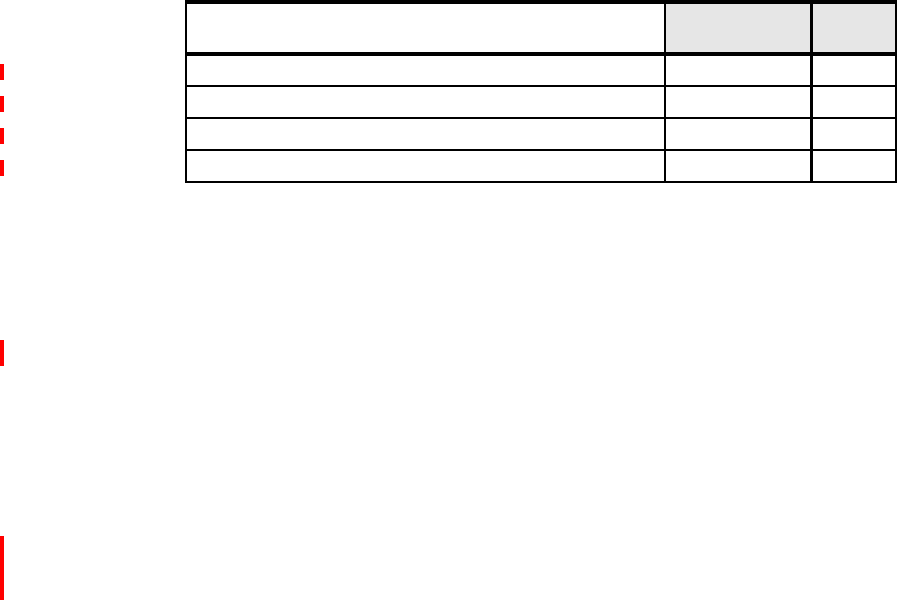
312 i5 Handbook
System management services
This section discusses the features and services that are integrated in i5/OS.
System i5 system console solutions
The following console solutions are available to help manage Eserver i5
systems:
Twinax attach console
Operations Console direct-connect
Operations Console LAN-connect
Hardware Management Console (HMC)
Advanced System Management Interface (ASMI)
The console solution selected depends on the number of PCI slots available, as
well as the function supported by each console type. This section discusses
these console options.
For further information on factors involved when deciding which type of console
to use on Eserver i5 servers, see the V5R3 i5/OS Console Positioning Paper on
the Web at:
http://www-1.ibm.com/servers/eserver/iseries/literature/index.html
IBM Managed System Services for iSeries 5722-MG1 321
IBM Performance Tools for iSeries 5722-PT1 322
IBM System Manager for iSeries 5722-SM1 322
IBM Tivoli Various 385
Product or service name Product number Refer to
page
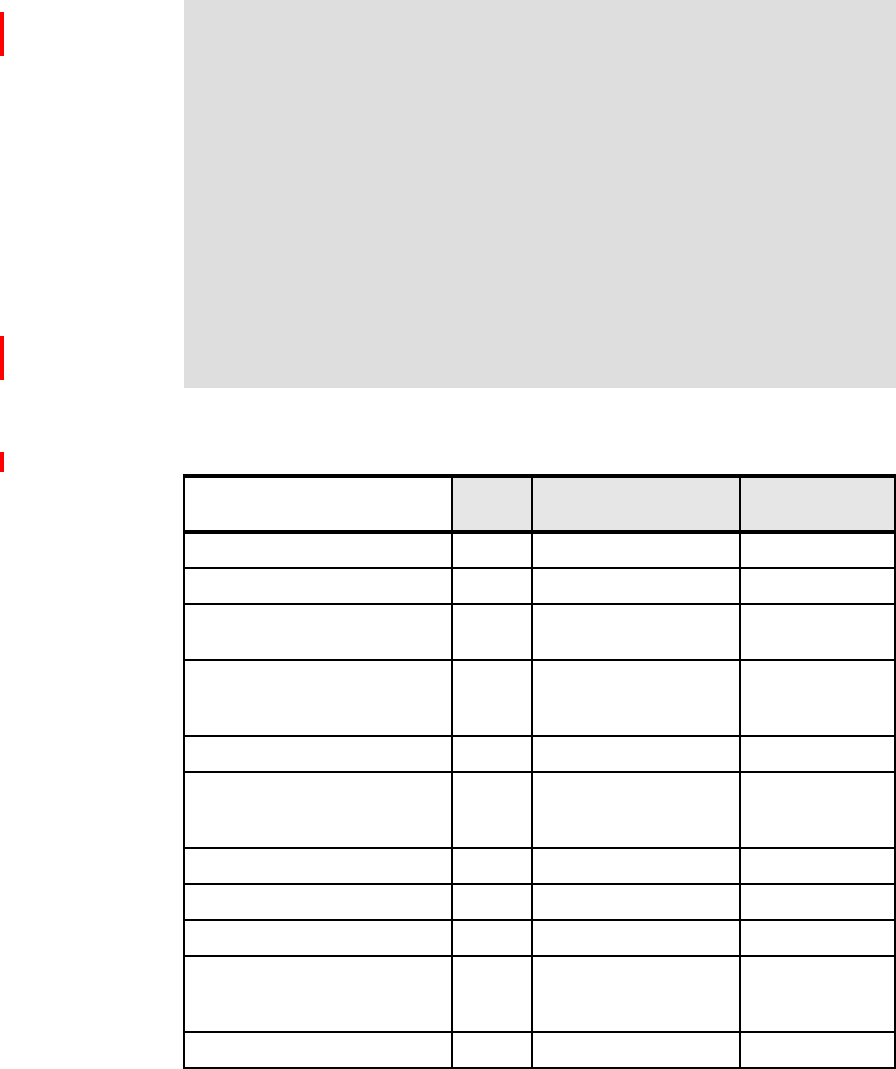
IBM System management services and licensed programs 313
The following table lists the functions that are available for each console option.
Important: All existing console types are supported in IBM i5/OS V5R4
partitions and on System i5.
HMC is required for managing partitions and Capacity on Demand. Although
the HMC can be used as a console device, all previously available console
types are still valid.
The #0367 is to be used for direct attached Operations Console and is
delivered when Operations Console on the local area network (LAN) is
selected. The #0367 can also be ordered for each partition running i5/OS
when the client chooses a console type making use of this cable.
The remote operator panel function of Operations Console is not supported on
Eserver i5 systems. The HMC or the ASMI interface can provide similar
function. Refer to “Hardware Management Console” on page 315 and
“Advanced System Management Interface” on page 316 for more details.
Function supported Twinax Operations Console HMC: Eserver i5
models only
Local 5250 access Yes Yes Yes
Remote 5250 access No Yes Yes via passthru
Many partitions and systems
managed with one console PC
No Yes
LAN-only
Ye s
Manage logical partitions (LPARs)
and IBM Eserver Capacity
Upgrade on Demand (CUoD)
No Yes
pre-Eserver i5 models
only
Ye s
Graphical disk management No Yes via iSeries Navigator No
Remote Control panel No Yes
Remote power capability
not available on i5 Models
Ye s
Requires IOP and dedicated IOA Yes Yes No
Supported via LAN No Yes Yes
Software required on console No Yes No
All languages supported by
OS/400 and i5/OS
Ye s Ye s N o
Language support
is limited
EZ Setup No Yes No

314 i5 Handbook
iSeries Operations Console features
Operations Console support allows a personal computer (PC) to be a local or
remote console of System i5 servers. This allows a system administrator to
monitor the system from another location. A twinaxial connection for console
functions is not required.
The remote console application is a full-function 5250 PC console session that
makes it possible to perform the majority of system operations tasks, for example
backup and recovery, when the System i5 and the operations staff are in
physically separate locations.
Operations Console enables connections across a LAN and enables directly
cabled connections. Multiple Operations Console LAN connections can be active
per system or partition at a time. Only one interface at a time can connect the
console, even though they each has data on the screen. A separate dedicated
interface for each partition is required.
A single PC can have multiple connections to multiple System i5 servers and can
be the console for multiple System i5 servers. Only one PC can have control of
the System i5 server at a given time. It also allows multiple local consoles on a
network connection, with only one directly cabled configuration.
There is a high level of security for the connections of Operations Console on the
LAN. Enhanced authentication and data encryption provide network security for
console procedures. Operations Console with LAN connectivity uses a version of
Secure Sockets Layer (SSL) that supports device and user authentication,
without using certificates.
IBM POWER5 hardware does not support a directly attached remote control
panel. For remote power on capability on this platform, consider remote HMC
(Remote Client) or ASMI.
iSeries Navigator can be enabled on the Operations Console PC. An advantage
of this is that you can centralize system management functions through a single
asynchronous connection to the System i5 server using the iSeries console,
Remote Control Panel capabilities, and iSeries Navigator on one PC.
Operations Console is a follow-on to the AS/400 Client Access Communications
console. It is packaged with the iSeries Access for Windows product (5722-XE1),
which is part of the iSeries Access Family (5722-XW1). Operations Console is an
Remote service No Yes Yes with Service
Focal Point
Function supported Twinax Operations Console HMC: Eserver i5
models only

IBM System management services and licensed programs 315
optionally installed component of 5722-XE1, but no 5722-XW1 license is
required to use this component.
You can find setup information in the iSeries Information Center at:
http://www.ibm.com/eserver/iseries/infocenter
Under Connecting to iSeries, select the Operations Console topic.
Hardware Management Console
The IBM Hardware Management Console is a PC-based console that runs a
Linux-based server management application. It is required for any of the new
POWER5 technology-based System i5 that implement partitions, Capacity on
Demand, or support concurrent maintenance. An HMC is only supported for
POWER5 technology-based servers and runs on a pre-installed Linux-based
workstation via an Ethernet LAN connection. An Ethernet cable attaches to the
HMC port.
The following figure illustrates the basic attachment of an HMC to a System i5
Model 595.
The HMC can be used to manage from one to thirty-two partitioned systems. It is
not required for non-logically partitioned systems. It can connect to one or more
Note: Virtual Partition Manager can be used to define up to four partitions for
Linux support without an HMC. Refer to “Virtual Partition Manager” on
page 227.
Front
Switch
Public
LAN
HMC
Eth
Eth
Back
Switch
A B
SP
A B
SP
Back BPC
Front BPC
Model 595

316 i5 Handbook
managed systems. A Model 520, 550, or 570 and 595 can be managed by only
one HMC. A virtual console terminal can be configured to run on the HMC for
each partition, reducing the need for extra hardware in each partition.
Management functions offered through the use of HMC include the ability to:
Create and maintain a LPAR environment
Display a virtual console session for each i5/OS partition
Detect, report, and store changes in hardware conditions
Power managed systems on and off
Act as a service focal point for IBM Service Representatives to determine an
appropriate service strategy and enable Service Agent to call home to IBM
Activate additional resources on demand
The HMC operates as a single, dedicated console for System i5 servers,
providing 5250 console support to run diagnostics and monitor operations.
Updates to the HMC are made via microcode (firmware). In some ways, the HMC
replaces the primary partition of a system.
Refer to the iSeries Information Center for setup information for the Hardware
Management Console:
http://www.ibm.com/eserver/iseries/infocenter
http://publib.boulder.ibm.com/infocenter/eserver/v1r2s/en_US/info/ipha1/
hardwaremanagementconsolehmc.htm
Refer to Logical Partitions on IBM PowerPC: A Guide to Working with LPAR on
POWER5 for IBM
Eserver
i5 Servers, SG24-8000, for a setup guide and
information about working with the HMC.
Advanced System Management Interface
ASMI is a browser-based interface that runs on the Service Processor (SP). It
allows you to perform general and privileged service tasks, such as reading
service processor error logs and vital product data, setting up the service
processor, controlling the system power, and performing hardware maintenance.
ASMI is used to allow concurrent hardware maintenance if you have an
Eserver
i5 system that does not include an HMC. ASMI may not be used often if an HMC
or an ASCII console is also installed. ASMI does not allow you to build partitions
Note: The HMC can be used only for the control and service functions of
the POWER5 technology-based servers it servers. It is not available for use
as a general purpose computing resource.

IBM System management services and licensed programs 317
on the system. Use either the HMC or Virtual Partition Manager (VPM) to build
partitions. VPM is used to build partitions to host Linux.
Refer to the IBM Systems Hardware Information Center for setup information for
the Advanced System Management Interface:
http://publib.boulder.ibm.com/infocenter/eserver/v1r3s/index.jsp
http://publib.boulder.ibm.com/infocenter/eserver/v1r3s/index.jsp?topic=/iphby/g
enconcepts.htm
IBM eServer Technical Support Advantage for iSeries
An important aspect of technology is technical support that helps make that
technology work for us as people. The IBM Eserver Technical Support
Advantage is a comprehensive set of resources available to IBM Clients, each
focused on one objective: the simplification and streamlining support of each IBM
Eserver solution. It offers easier access to total System i5 solutions in this
increasingly Web-based world.
The Technical Support Advantage initiative offers total server support that you
need for today’s On Demand Business world. You receive great support that is
personalized, flexible, and in the form you need it. What counts is keeping your
business running and helping you drive your business to the next level.
Technical Support Advantage is the total solutions focus of IBM for System i5
servers. It involves voice and Web-based technical support and support that is
integrated into the product. Emphasis is on a collaborative approach to technical
support that helps to ensure a personal touch.
You can find more information about technical support and resources at:
http://www.ibm.com/eserver/iseries/support
Management Central-Pervasive
Management Central-Pervasive allows network administrators to monitor the
performance and status of their System i5 servers while away from their
workstation or office. Using a cellular phone or personal digital assistant (PDA)
with a wireless modem, the administrator can check on System i5 server status
and monitor performance metrics on the System i5 servers. Management
Central-Pervasive also runs from a Web browser running on PCs or Network
Stations.
For more information about Management Central-Pervasive, see “IBM eServer
iSeries Access for Wireless (5722-XP1)” on page 309.

318 i5 Handbook
iSeries Information Center
The i5/OS V5R3 iSeries Information Center is available with tips, techniques,
scenarios, and technical information to help you take advantage of all of the
features of your System i5 server. From hardware specifications to wireless
management and Enterprise Identity Mapping (EIM) information, the iSeries
Information Center is a prime technical resource for your iSeries information
needs.
The iSeries Information Center is available on the Internet at:
http://www.ibm.com/eserver/iseries/infocenter
The hardware information for i5 systems is contained on the internet in the IBM
Systems Hardware Information Center located at:
http://publib.boulder.ibm.com/infocenter/eserver/v1r3s/index.jsp
Program temporary fixes
Program temporary fixes (PTFs) can be shipped to a central site, either on media
or electronically, and then packaged and distributed to remote license sites,
either on media or electronically. Clients can download PTFs over the Internet.
Configuration and setup information is documented on the Web at:
http://www-912.ibm.com/supporthome.nsf/document/10000045
PTFs (including Licensed Internal Code (LIC) changes) are loaded and applied
using a command.
System detected software problems
Symptom strings are automatically created by the i5/OS licensed programs at the
time an error occurs. They make the management of problems in the system
easier and recovery quicker by improving the rate at which clients can find
appropriate fixes for problems. Problem resolution time is decreased when failure
data is collected at the time of occurrence and reduces the need to recreate
failures.
Electronic Service Agent
The Electronic Service Agent™ is a “nocharge” software tool that resides on the
System i5 to monitor events and transmit system inventory information to IBM.
Electronic Service Agent has two functions: automatic hardware problem
reporting and system inventory collection. With these functions, Electronic
Service Agent can monitor, track and capture system inventory and hardware
error logs.
In V5R4, Electronic Service Agent is included in i5/OS.
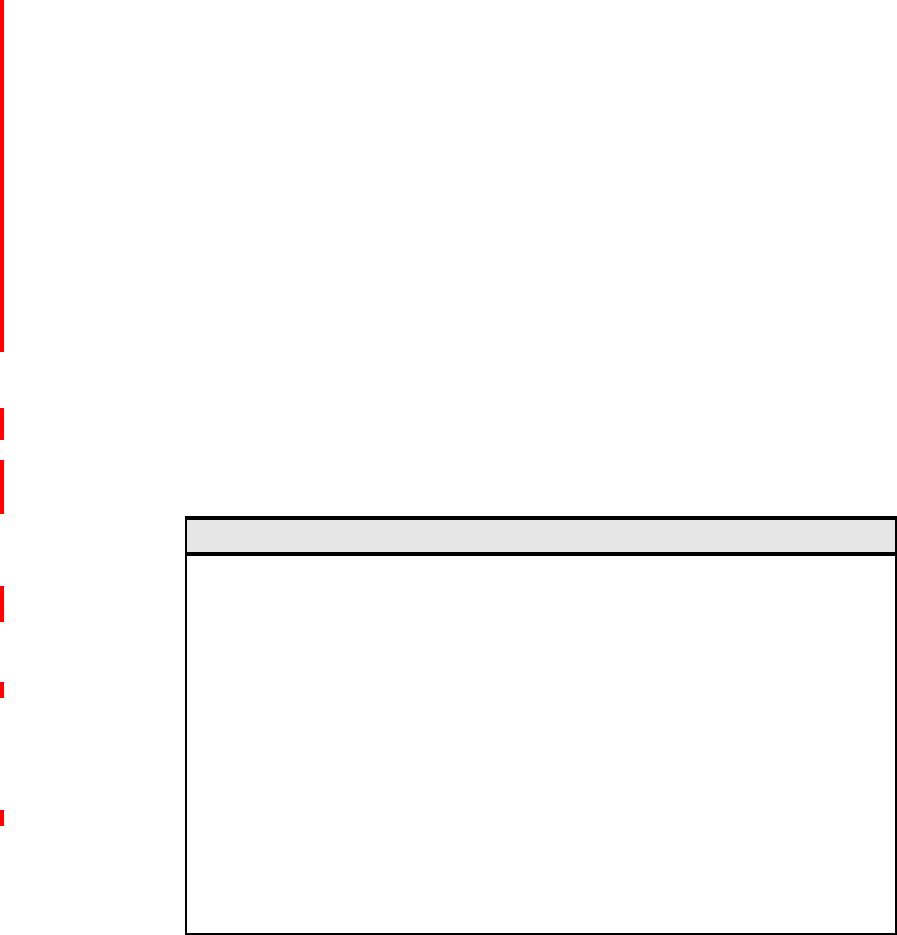
IBM System management services and licensed programs 319
Using the power of your System i5 and i5/OS software applications, Electronic
Service Agent monitors the system's functional hardware and selected
peripherals, and then electronically reports potential problems. In addition to
error detection and reporting, Service Agent also aids remote support centers
and onsite service personnel in problem source identification by providing a
comprehensive error history of the system.
Electronic Service Agent also collects and sends system hardware inventory and
i5/OS software, PTFs and software error logs to IBM. This information helps the
IBM Support Center in their analysis of a system problem or client question. The
inventory information and service requests are transmitted to IBM either by
Internet or AT&T Global Network. Client information is protected behind IBM
firewalls. Only those with a valid IBM business reason are authorized to access
the Electronic Service Agent data. The Service Agent inventory information is
available for clients to view at: http://www.ibm.com/support/electronic
System management products
This section discusses the products available to manage System i5 systems.
IBM Backup Recovery and Media Services for iSeries (5722-BR1)
IBM Backup Recovery and Media Services is the IBM strategic solution for planning and
managing the backup of the System i5 server. It provides all of the functions that most System i5
users need to implement a fully automated, single system, backup, recovery, and media
management strategy.
BRMS facilitates centralized management of media by maintaining a consistent view of removable
tape media, its contents, location, and availability across multiple System i5 servers or OS/400
partitions referred to as networked systems. This common media scratch pool contains shared
tape volumes, which are eligible for use by any participating networked system. When a
networked system uses one of the shared volumes, that usage is broadcast to all networked
systems so that each system has a current view of the active media and the available expired
media.
BRMS provides the System i5 server with support for policy-oriented setup and execution of
archive, backup, recovery, and other removable media-related operations. BRMS uses a consistent
set of intuitive concepts and operations, which can be used to develop and implement a backup
strategy tailored to your business requirements. The user interface is menu-driven, with a
significant number of functions enabled through the optional BRMS iSeries Navigator client, a
plug-in to iSeries Navigator.
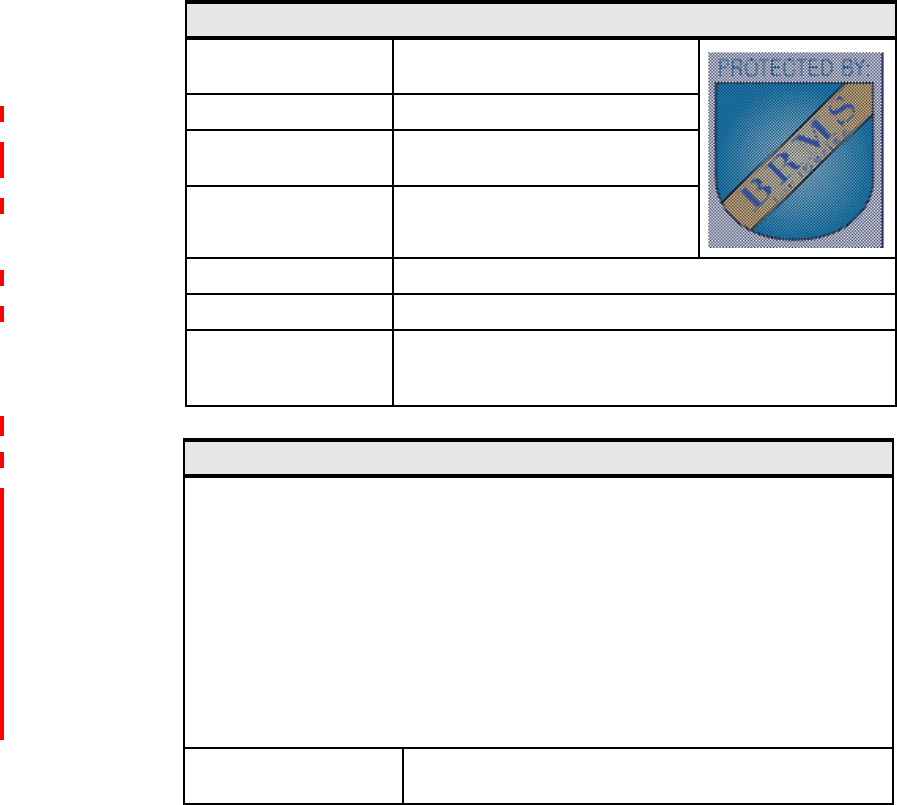
320 i5 Handbook
Minimum operating
system level
i5/OS V5R3
Replaces products 5769-BR1, 5716-BR1
Options Option 1 - Network feature
Option 2 - Advanced feature
Software type Software subscription
Installation prerequisites 5722-SS1 Option 18 Media and Storage Extensions
Client code Delivered with the server.
Further information http://www-1.ibm.com/servers/eserver/iseries/service/brms/
http://www-1.ibm.com/servers/eserver/iseries/service/brms/
adsmperf.htm
IBM Director with Virtualization Engine Console for i5/OS V5.1 (5733-DR1)
IBM Director V5.10 maximizes system availability. Director is designed to reduce the cost and
complexity of management by providing comprehensive yet easy-to-use administration of the
entire environment from a single point of control. It features an open, integrated toolset with new
functions and improved ease of use that helps you get started faster and be more productive.
The Virtualization Engine Console provides a comprehensive set of management tasks that
leverage the Virtualization Engine management collection as well as your existing management
structure and tools. Virtualization Engine console discovers your environment and works with
your existing management resources to harness their power into a consistent user experience.
Administrators can discover and explore relationships between IT resources in their virtualization
environment, and manage these resources through a common set of tasks. For deeper analysis
and troubleshooting, the console works with your existing tools and technology to launch tools
and applications, taking users to the tools they need.
Further information http://publib.boulder.ibm.com/infocenter/eserver/v1r2/inde
x.jsp
IBM Backup Recovery and Media Services for iSeries (5722-BR1)
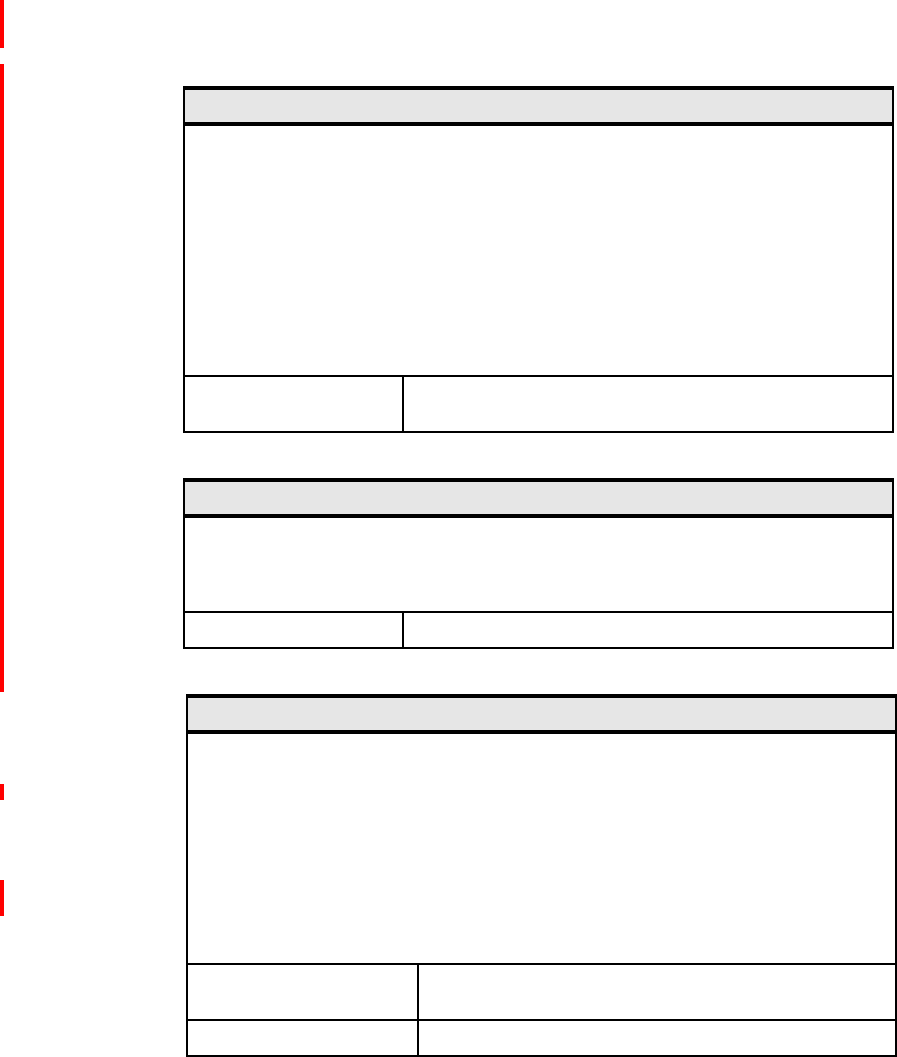
IBM System management services and licensed programs 321
IBM Virtualization Engine Enterprise Workload Manager for i5/OS,
V2.1 (5733-EWA)
IBM Virtualization Engine Enterprise Workload Manager for i5/OS, V2.1 (5733-EWA)
EWLM is a dynamic policy-based workload-management system that optimizes resources in
multi-tier heterogeneous application environments. Application performance can be measured
against pre-defined goals by end- to-end collection and reporting. Both IBM and non-IBM
platforms and operating systems are supported.
EWLM V2.1 builds upon the base functions delivered in the initial release of the Virtualization
Engine and continues the evolution toward autonomic management of customer service level
objectives in heterogeneous, multi-tiered server environments. EWLM support focuses on
expanding the set of operating system platforms supported as an EWLM Domain Manager and
as an EWLM Managed Server to provide end-to-end coverage of heterogeneous applications.
This release also introduces dynamic, goal-oriented EWLM server resource optimization
algorithms, focused on management of logically partitioned IBM eServer i5 and p5 hardware.
Further information http://publib.boulder.ibm.com/infocenter/eserver/v1r2/inde
x.jsp
IBM Advanced Job Scheduler for iSeries (5722-JS1)
Easily manage your job automation across multiple systems running the IBM Advanced Job
Scheduler for iSeries. For example, with the Advanced Job Scheduler on multiple systems, you
can condition jobs on one system to only start when a job on another system is successful or
ends in error. Supported network environments for the Advanced Job Scheduler include TCP/IP.
Further information http://www.ibm.com/eserver/iseries/jscheduler/product.html
IBM Managed System Services for iSeries (5722-MG1)
IBM Managed System Services for iSeries (MSS) licensed program is part of an integrated
offering Operation Control Center/400, which includes System Manager for iSeries. MSS enables
an System i5 server to be managed from a central site running either S/390 NetView Distribution
Manager for MVS (Release 5 or later) for MVS-based networks or System Manager for
iSeries-based networks.
The central site defines, schedules, and tracks software distribution (change management)
requests sent to an System i5 server with Managed System Services for iSeries installed. These
change management requests include sending, receiving, and deleting System i5 system files,
programs, and other objects (libraries, save files, message files, documents, folders, PTFs, and
so on).
Minimum operating system
level
OS/400 V5R1
Installation prerequisites None

322 i5 Handbook
Related product System Manager for iSeries (5722-SM1)
Replaces product 5769-MG1
IBM System Manager for iSeries (5722-SM1)
System i5 objects can be sent directly to or received from System i5 libraries or through the local
System i5 distribution repository with IBM System Manager for iSeries. Non-System i5 objects
can be received into, stored, and distributed from the System i5 distribution directory. The
capability for the central site System i5 to define, schedule, run these change requests one time
or repetitively, and track their status significantly enhances unattended operation of the remote
systems supported by System Manager.
Minimum operating system
level
OS/400 V5R1
Software type Part of the integrated offering Operations Control Center/400,
which includes Managed System Services for iSeries
Installation prerequisites None
Related product Managed System Services for iSeries (5722-MG1)
Replaces product 5769-SM1
IBM Software Integration Assistant for iSeries (5733-IA1)
Some IBM software products are created and packaged so that a single version of the software
can be installed on any one of several operating system platforms, including i5/OS. The IBM
Software Integration Assistant for iSeries provides mechanisms that enable standard System i5 fix
(PTF) delivery and application procedures for these multiplatform products. These products are
not packaged as System i5 licensed programs because the same product can be installed on
platforms other than System i5.
Minimum i5/OS level i5/OS V5R2
Software type Shipped with i5/OS at no charge
Replaces product New in i5/OS V5R2
IBM Performance Tools for iSeries (5722-PT1)
Performance Tools for iSeries is a program product that provides a set of reporting, analysis, and
modeling functions to assist an System i5 administrator to manage the performance of the
system. It provides printed and online reports. These can be in graphic or tabular form.
The Performance Advisor function assists the user in analyzing system performance and
provides recommendations. Performance Tools for iSeries, through its modeling facility, can be
used to help predict probable system performance before changes are made.
IBM Managed System Services for iSeries (5722-MG1)

IBM System management services and licensed programs 323
Valupak for iSeries (5722-VP1)
Valupak for iSeries is a package of chargeable products which provides a
discount rather than buy all the products separately. Valupak consists of:
5722-PT1 Performance Tool for iSeries
5722-PT1 - Option 1 Manager Feature
5722-QU1 Query for iSeries
5722-ST1 DB2 Query Manager and SQL Development Kit for iSeries
5722-XW1 iSeries Access Family (user based)
The number of iSeries Access licenses varies with the software tier of the
Valupak ordered as shown in the following table.
Minimum operating
system level
OS/400 V5R1
Installation prerequisites None
Related product PATROL for iSeries – Predict (5620-FIF)
Client code Client Access Express plug-in distributed with 5722-PT1
Replaces products 5769-PT1, 5716-PT1, 5763-PT1, 5769-GP1, 5769-VP1, 5798-RYP
Further information http://www-1.ibm.com/servers/eserver/iseries/perfmgmt/
pt400.htm
PATROL for iSeries – Predict (5620-FIF)
PATROL for iSeries – Predict is a performance analysis and capacity planning product for System
i5. Using existing performance data from Collection Services or STRPFRMON, PATROL for
iSeries – Predict provides comprehensive response-time analysis and predictive modeling
capabilities. The “what-if” analysis capabilities reveal the impact of changes, such as load,
configuration, and users across the System i5 environment. With this approach, users can prevent
performance, service and response-time problems before they occur, and ensure ongoing
success by provisioning the right hardware upgrades, at the right time.
Minimum operating
system level
OS/400 V4R4
Related products 5722-PT1
Replaces product BEST/1-400 function of 5722-PT1
Further information http://www.bmc.com/products/proddocview/
0,2832,19052_19429_23137_7064,00.html
IBM Performance Tools for iSeries (5722-PT1)

324 i5 Handbook
When upgrading to a new version or release, the upgrade is achieved by using
individual product upgrades, and not by upgrading to a new ValuPak. Similarly if
an System i5 upgrade involves a processor upgrade, which requires moving to a
new software tier, the software charges are calculated on an individual product
basis, not as a Valupak upgrade.
Tivoli Software
Tivoli Software is a portfolio of products delivering a better way to manage the
business of I.T. by intergrating people, processes, technology and information.
The portfolio includes a range of software covering Application Management,
Availability, Business Service Management, Orchestration and Provisioning
Management, Security and also Storage and Optimisation.
Tivoli software is intended to support complex and heterogeneous environments
though supporting a broad set of market leading platform and database products.
To understand the full range of Tivoli products visit:
http://www-306.ibm.com/software/tivoli/
To obtain a consolidated view of what System i5 support is available for all Tivoli
products, a spreadsheet is available at:
http://www-306.ibm.com/software/sysmgmt/products/support/Tivoli_Support
ed_Platforms.html
Software tier Client Access users
P05 10
P10 20
P20 50
P30 70
P40 125
P50 150
P60 175

© Copyright IBM Corp. 1997 - 2006. All rights reserved. 325
Chapter 26. Web collaboration and
WebSphere
IBM i5/OS contains everything that is needed to quickly create a Web presence.
As the integrated platform, it provides the infrastructure and components
necessary to “Start Simple” with On Demand Business adoption. For example,
WebSphere Application Server - Express is now included with every i5 Edition.
In addition to these base features, a set of On Demand Business products is
available to help you “Grow Fast”, allowing a complete On Demand Business
Web site to be built that is secure and easy to develop, maintain and scale.
These products (listed in the following table) belong to the WebSphere family of
products offered by IBM for the System i5 server.
Each of these products addresses specific client requirements to build
applications for On Demand Business quickly and easily. They often include
graphical user interface (GUI)-based PC development and management tools.
The base of these WebSphere products is the WebSphere Application Server
technology. An application server “serves” applications written in Java, which in
turn can leverage your existing System i5 programs and data.
26
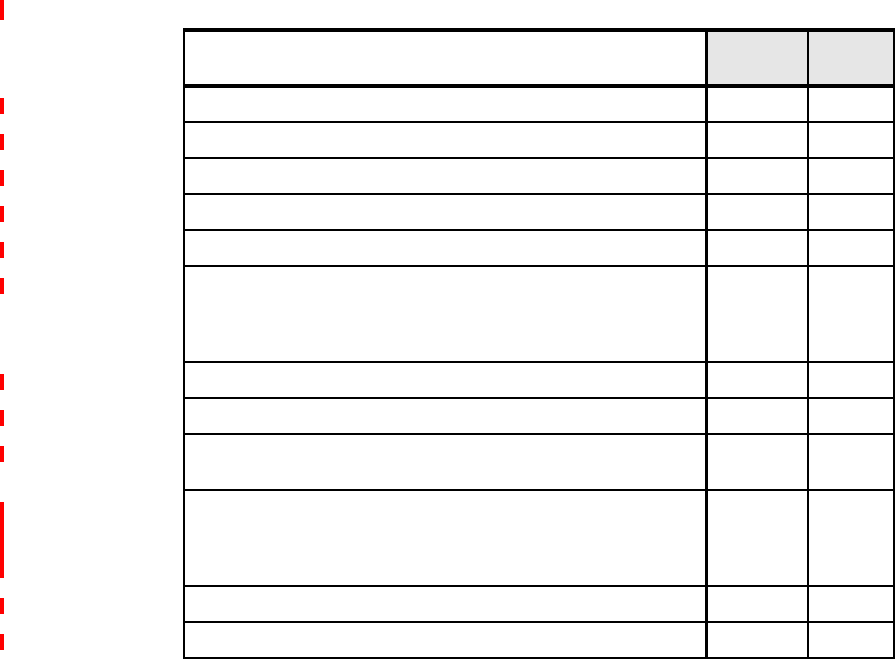
326 i5 Handbook
Product name Product
number
Refer to
page
IBM Business Solutions 5722-BZ1 329
IBM WebSphere Application Server Version 5.1, Developer Edition 5724-D18 330
IBM WebSphere Application Server - Express Version 5.1 for iSeries 5722-E51 328
IBM WebSphere Host Access Transformation Services (HATS) 5724-L03 333
IBM WebSphere Portal Express and Express Plus 5724-E77 332
IBM WebSphere Commerce for iSeries, Version 5.6 Express Edition
IBM WebSphere Commerce for iSeries, Version 5.6 Business Edition,
IBM WebSphere Commerce for iSeries, Version 5.6 Professional
Edition
5724-I36
5724-I38
5724-I40
332
IBM Web Enablement for iSeries 5722-WE2 328
IBM WebSphere Application Server Version 5.1 for iSeries 5733-W51 329
IBM WebSphere Application Server Version 5.1, Network Deployment
for iSeries
5733-W51 329
IBM WebSphere Application Server V6.0 for iSeries
IBM WebSphere Application Server Network Deployment V6.0 for
OS/400
IBM WebSphere Application Server for Developer V6.0 for OS/400
5733-W60 379
IBM WebSphere Application Server - Express V6.0 for OS/400 5724-I63 379
IBM WebFacing Deployment Tool - with HATS Technology 5724-N52 382

Web collaboration and WebSphere 327
WebSphere Application Server offerings
System i5 clients have the following WebSphere Application Server offerings
from which they can choose:
IBM WebSphere Application Server - Express for iSeries: This is a Java
application server based on a servlet-based engine that turns your existing
Web server (IBM HTTP Server for iSeries) into a Java Web application server.
It supports the full Java 2 Enterprise Edition (J2EE) 1.4 programming model
and extensions including Servlets, JSPs, EJBs, and Web services
IBM WebSphere Application Server V6.0.1 for OS/400: Provides similar
support to the Express version but allows multiple application server
processes per Websphere application instance.
IBM Websphere Application Server V6.0.1 for OS/400: extends
WebSphere Application Server Version 6.0.1 with network deployment
management facilities allowing multiple WebSphere Application server nodes
to be managed from a single console. It also provides clustering, edge
services, and high availability services for distributed configurations as well as
load balancing capabilities.
To understand the IBM On Demand Business strategy for the System i5 server,
and the positioning of strategic WebSphere products, refer to WebSphere for IBM
Eserver iSeries Server Buying and Selling Guide, REDP-3646.
Product positioning: WebSphere Application Server and
Jakarta Tomcat
The strategic Web application server from IBM is WebSphere Application Server.
The latest version of WebSphere Application Server is Version 6.0.1. All
WebSphere Application Server offerings support Servlets, JSPs, EJBs, and
more.
Some System i5 clients want a basic, no-cost Web application server that
supports servlets and JavaServer Pages. Relying on the IBM HTTP Server
(powered by Apache) as its Web server, the Apache Software Foundation’s
Jakarta Tomcat provides a basic Web application server for System i5 clients.
Jakarta Tomcat is available with OS/400 and at no additional cost to clients.
Note:
Use the IBM
Eserver
Workload Estimator to help size all system
configurations:
http://www-912.ibm.com/wle/EstimatorServlet
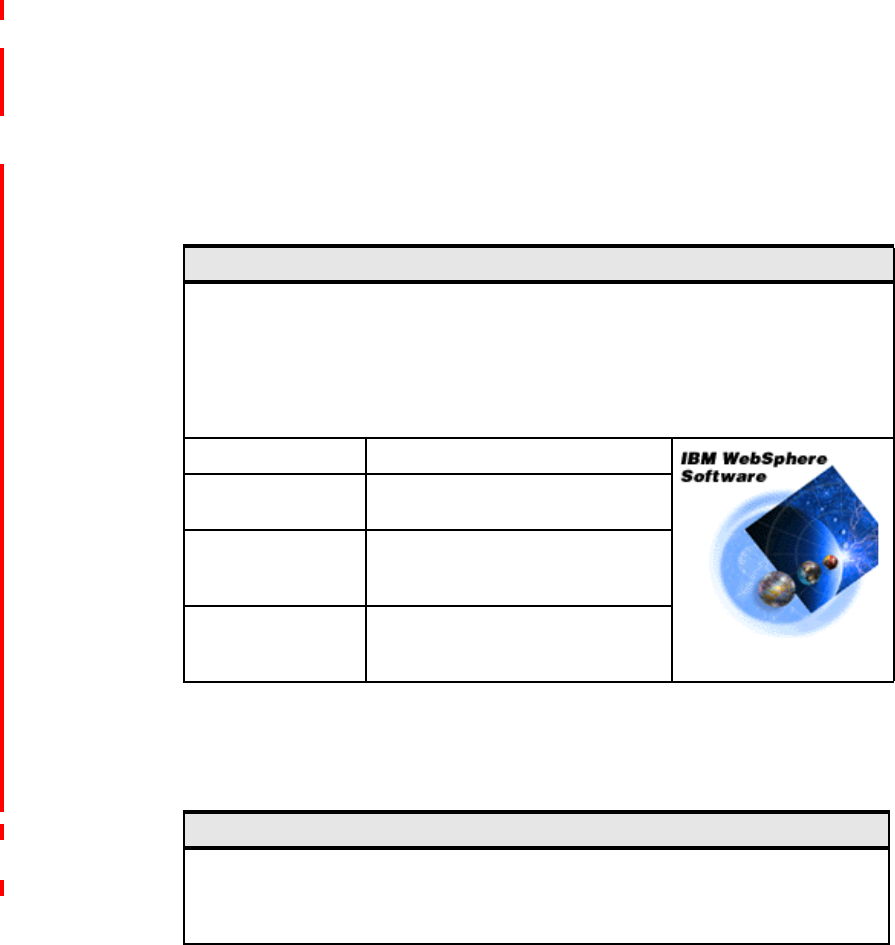
328 i5 Handbook
Clients who require a robust and scalable Web application server can select
WebSphere Application Server. Jakarta Tomcat provides fewer functions and
capabilities compared to the IBM WebSphere Application Server. IBM plans for
i5/OS V5R4 to be the final release to ship Apache Tomcat support in the IBM
HTTP Server which is shipped with i5/OS.
For more information, see iSeries e-business Handbook: A Technology and
Product Reference, SG24-5694.
IBM WebSphere Application Server - Express Version 5.1 for iSeries (5722-E51)
IBM WebSphere Application Server - Express for iSeries is delivered to System i5 customers
via IBM Web Enablement for iSeries (5722-WE2) or can be purchased through Passport
Advantage. It is intended for fast, productive development, deployment, and management of
dynamic Web sites. As such it has a subset of the application server shipped with the
WebSphere Application Server 5.1 for iSeries product, shipping without EJB support, some
clients applications and the ability to have multiple application server processes per
WebSphere application server instance.
Ordering 5724-D06
Minimum operating
system level
OS/400 V5R1
Replaces product WebSphere Application Server
Standard Edition V3.5 or WebSphere
Application Server - Express V5.0
Further information http://www-03.ibm.com/servers/eserv
er/iseries/software/websphere/wsapp
server/express/indexexp51.html
IBM Web Enablement for iSeries (5722-WE2)
IBM Web Enablement for iSeries is a license only product that delivers WebSphere Application
Server - Express Version 6.0 and Version 5.1 (5722-IWE and 5722-E51). Web Enablement is
included on every i5/OS order. It can be removed from the order if desired. This makes an
application server available with i5/OS at no additional cost to the client.

Web collaboration and WebSphere 329
Minimum operating
system level
i5/OS V5R3
Replaces product 5722-WE1
Further information http://www-03.ibm.com/servers/eserver/ise
ries/software/websphere/wsappserver/news/
package.html
IBM Business Solutions Version 1.0 (5722-BZ1)
IBM Business Solutions Version 1.0 (5722-BZ1) provides a set of enterprise Web applications
available for iSeries servers. Each application is an integrated solution to a common business
need that works in conjunction with your existing applications, server components, and
enterprise data. The applications demonstrate the value of integrated solutions for On
Demand Business, increase worker productivity, provide services that virtually any business
may find useful, and are easy to understand and use.
Ordering 5722-BZ1
Minimum operating
system level
OS/400 V5R1
Further information http://www-03.ibm.com/servers/eserv
er/iseries/software/bizapps/
IBM WebSphere Application Server Version 5.1 for iSeries and
IBM WebSphere Application Server Version 5.1, Network Deployment for iSeries (5733-W51)
IBM WebSphere Application Server Version 5.1 for iSeries is supplied via Passport Advantage. It
is Java 2 Enterprise Edition (J2EE) compatible with full support for SDK 1.4 (both client and
server). It has core web services support as well as Enterprise Java Bean (EJB) V2 support and
Java Message Services V1.0.2. The Network Deployment version additionally provides advanced
Web services, enhanced work management and performance management tools for workload
management across multiple servers via load balancing and clustering capabilities.
IBM Web Enablement for iSeries (5722-WE2)

330 i5 Handbook
Ordering product
number
5630-A36, BA0BWML Base Application
Server
5630-A36, BA0BVML Network Deployment
Minimum operating
system level
OS/400 V5R1
Replaces products WebSphere Application Server Version 4.0,
Advanced Single Server Edition
(5733-WA4)
WebSphere Application Server Version 4.0,
Advanced Edition (5733-WS4)
Further information http://www-03.ibm.com/servers/eserver
/iseries/software/websphere/wsappserv
er/indexb51.html
http://www-03.ibm.com/servers/eserver
/iseries/software/websphere/wsappserv
er/indexnd51.html
IBM WebSphere Application Server Version 5.1 for iSeries, Developer Edition (5724-D18)
The IBM WebSphere Application Server V5.1 for iSeries Developer Edition is a Passport
Advantage program. It is the same product as WebSphere Application Server V5.1 for iSeries
(Base edition) with different licensing.
Ordering BA0BUML
Minimum operating
system level
OS/400 V5R1
Replaces product WebSphere Application Server V5.0 for
iSeries Developer
Further information http://www-03.ibm.com/servers/eserv
er/iseries/software/websphere/wsapp
server/indexdev51.html
IBM WebSphere Application Server - Express Version 6.0 for iSeries (5733-W60)
IBM WebSphere Application Server - Express for iSeries is delivered to System i5 customers
via IBM Web Enablement for iSeries (5722-WE2) or can be purchased through Passport
Advantage. It is intended for fast, productive development, deployment, and management of
dynamic Web sites. It provides the almost the same function as the WebSphere Application
Server 6.0 for iSeries product without the ability to have multiple application server processes
per WebSphere application server instance.
IBM WebSphere Application Server Version 5.1 for iSeries and
IBM WebSphere Application Server Version 5.1, Network Deployment for iSeries (5733-W51)

Web collaboration and WebSphere 331
Ordering 5724-I63
Minimum operating
system level
OS/400 V5R2
Replaces product WebSphere Application Server -
Express V5.0, 5.1 Express
Websphere Application Server 4.0
Advanced Edition
Further information http://www-03.ibm.com/servers/eserv
er/iseries/software/websphere/wsapp
server/express/indexexp60.html
IBM WebSphere Application Server Version 6.0 for OS/400, Network Deployment Edition for
iSeries V6.0, and WebSphere Application Server for Developers V6.0 (5733-W60)
The IBM WebSphere Application Server V6.0 is shipped as a licensed program option (LPO) via
Passport Advantage and is installed as product 5733-W60 on the System i5.
All three products contain the same full function WebSphere Application Server.
The Network Deployment edition contains advanced Web services and functions for managing
multiple application servers including clustering, networking, load balancing and distributed
administration capabilities.
The application server for Developers is the same product as the WebSphere Application Server
V6 but with different licensing.
Ordering 5724-J08 Base Application Server
5724-H88 Network Deployment
5724-H89 Developers
Minimum operating
system level
OS/400 V5R2
Replaces product WebSphere Application Server Version
5.1
Further information http://www-03.ibm.com/servers/eserv
er/iseries/software/websphere/wsapp
server/indexb60.html
http://www-03.ibm.com/servers/eserv
er/iseries/software/websphere/wsapp
server/indexnd60.html
http://www-03.ibm.com/servers/eserv
er/iseries/software/websphere/wsapp
server/indexdev60.html
IBM WebSphere Application Server - Express Version 6.0 for iSeries (5733-W60)

332 i5 Handbook
IBM WebSphere Commerce for iSeries, Version 5.6 Business Edition (5724-I38),
Professional Edition (5724-I40), and Express Edition (5724-I36)
IBM WebSphere Commerce for iSeries, Version 5.6 are Passport Advantage products providing
complete e-commerce solutions for business-to-consumer (B2C) or business-to-business (B2B)
Web sites.
WebSphere Commerce Express is an easily installed, yet complete solution to help growing
mid-market companies do business on the Web. It is ready to go out-of-the-box to affordably build
and maintain an e-commerce site for B2B or B2C.
WebSphere Commerce Professional Edition increases site functionality for B2B and B2C
retailers. By enhancing client buying experiences and improving operational efficiencies,
Professional Edition can increase customer satisfaction and loyalty.
WebSphere Commerce Business Edition provides a powerful solution for running large
high-volume B2B and advanced B2C e-commerce Web sites for global On Demand Businesses.
It is a flexible infrastructure based on a unified platform for running complex and high volume
sites.
Ordering 5724-I38, 5724-I40, 5724-I36
Minimum operating
system level
OS/400 V5R2
Replaces products IBM WebSphere Commerce for
iSeries Version 5.5 (5724-A18)
WebSphere Commerce Suite
Version 5.1 (5798-WC5)
WebSphere Commerce V5.4
(5733-WC5)
Further information http://www-306.ibm.com/software
/sw-by
category/subcategory/SWH10.html
IBM WebSphere Portal - Express, and IBM WebSphere Portal - Express Plus for
Multiplatform, Version 5 (5724-E77)
Portals serve as unified access points to Web applications. A portal delivers integrated content
and applications, plus a unified, collaborative workplace.
IBM WebSphere Portal - Express for Multiplatform (5724-E77) is a Passport Advantage program
allowing easy deployment of portal solutions.
WebSphere Portal Express Plus adds collaboration features to help teams work together more.

Web collaboration and WebSphere 333
Ordering Express BAOBYML,
Express Plus BAOCOML
Minimum operating
system level
OS/400 V5R2
Replaces product N/A
A WebSphere Portal Enable V4.1
upgrade to WebSphere Portal Express
V5 is not supported
Further information http://www-03.ibm.com/servers/eserv
er/iseries/software/websphere/porta
l/
IBM WebSphere Host Access Transformation Services (HATS) V6 (5724-L03)
IBM WebSphere Host Access Transformation Services (HATS) is ordered via Passport Advantage.
It provides all the tools necessary to make 5250 applications available as HTML through the most
popular web browser, while converting host screens to a Web look and feel in real time. This
significantly improves the navigation and productivity of host applications.
Ordering D52WTLL, D52WULL
Minimum operating
system level
OS/400 V5R3
Replaces product IBM Websphere Host Access
Transformation Services V5
Further information http://www-306.ibm.com/software/web
servers/hats/index.html
IBM WebFacing Deployment Tool for WebSphere Development Studio V6.0.1 with HATS
Technology (5724-N52)
IBM WebFacing Deployment Tool - with HATS technology (WDHT) is a runtime enabler allowing
the WebFacing Tool and HATS technologies to work together in an integrated fashion. To leverage
the new WebFacing extensions, WDHT is needed for deployment to production.
IBM WebSphere Portal - Express, and IBM WebSphere Portal - Express Plus for
Multiplatform, Version 5 (5724-E77)

334 i5 Handbook
Ordering 5724-N52
Minimum operating
system level
OS/400 V5R2
Replaces product None
Further information http://www-306.ibm.com/software/awd
tools/wds400/news/announcement-hats
013106.html
IBM WebFacing Deployment Tool for WebSphere Development Studio V6.0.1 with HATS
Technology (5724-N52)

© Copyright IBM Corp. 1997 - 2006. All rights reserved. 335
Chapter 27. IBM licensed programs:
Printing and document
handling products
Office and printing products provide the vehicle for communications both inside
and outside a company. To help you understand the System i5 print solutions that
are available for a particular set of business requirements, refer to this Web site:
http://www.printers.ibm.com/internet/wwsites.nsf/vwwebpublished/main_ww
27

336 i5 Handbook
The office and printing products that are listed in the following table are
discussed in this chapter.
Product name Product number Refer to
page
IBM Advanced Function Printing Utilities for iSeries 5722-AF1 337
IBM Advanced DBCS Printer Support for iSeries 5722-AP1 337
IBM AFP Font Collection for Workstations and OS/400 5648-B45 338
IBM Dictionary and Linguistics Tools for AS/400 5769-DL1 339
IBM Business Graphics Utility for AS/400 5722-DS1 340
IBM Infoprint Fonts for Multiplatforms 5648-E77 341
IBM Facsimile Support for iSeries 5798-FAX 341
IBM Advanced Function Printing Fonts for AS/400 5769-FNT 342
IBM Advanced Function Printing DBCS Fonts for AS/400 V4R3 5769-FN1 343
IBM Infoprint Designer for iSeries 5733-ID1 344
Infoprint Server for iSeries 5722-IP1 345
IBM Content Manager OnDemand for iSeries 5722-RD1 346
IBM Content Manager for iSeries 5722-VI1 346
IBM Print Services Facility for iSeries (PSF/400) 5722-SS1 options
36, 37, and 38
347
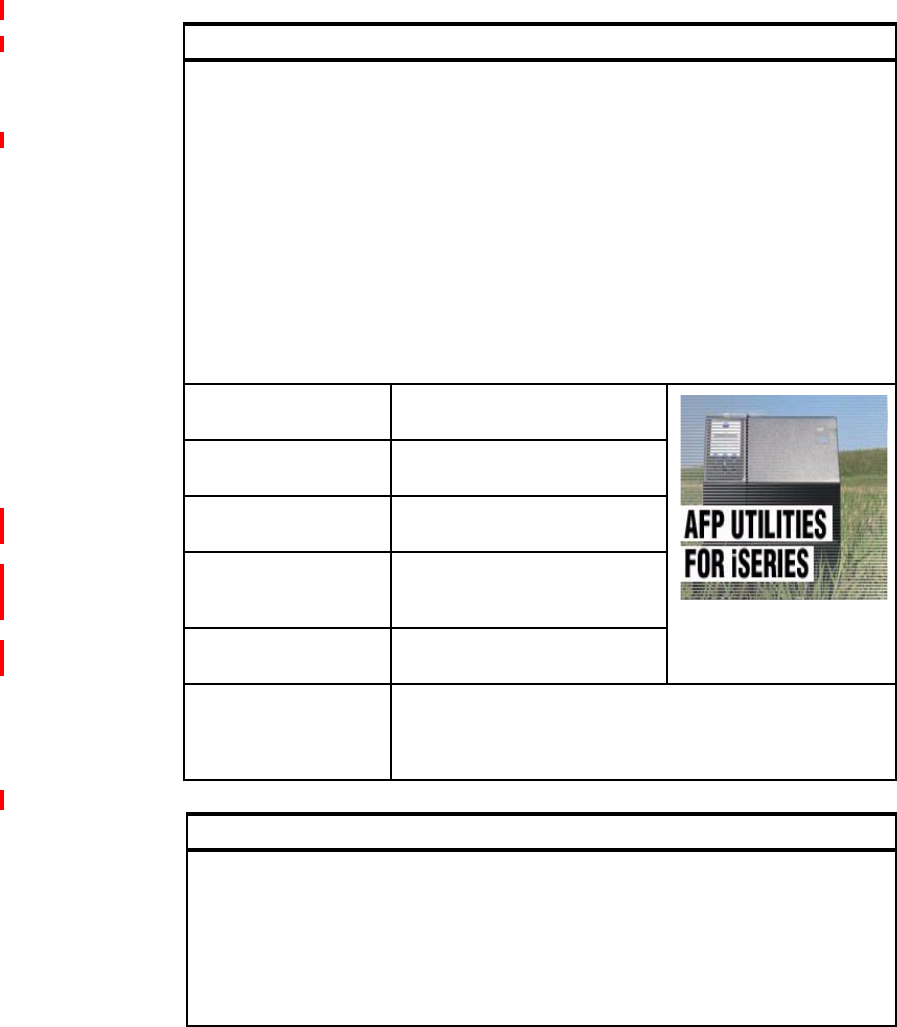
IBM licensed programs: Printing and document handling products 337
IBM Advanced Function Printing Utilities for iSeries (5722-AF1)
Advanced Function Printing (AFP) Utilities consists of three integrated utilities that support AFP
print applications. Included are Overlay Utility for electronic forms, Resource Management Utility
for managing document resources, and Print Format Utility, a “Query/AFP” tool to help you build
advanced electronic output directly from System i5 database files. For most System i5 document
design functions, look at Infoprint Designer (5733-ID1).
The user can interactively design, create, and verify AFP resources such as overlays. In addition
to the AFP resource creation and management, it provides the capability to print users’ data
contained in a database file in various formats, with various fonts and barcodes on the Intelligent
printer Data Stream (IPDS) printer without developing any application programs. For example, it
allows users to print barcode labels from data stored in the database file.
Uses with various levels of experience can easily take full advantage of IPDS printer capability
that is either not accessible to them now or accessible only with great difficulty.
Components include the Overlay Utility, Print Format Utility, and the Resource Management Utility.
Minimum operating
system level
OS/400 V5R1
Software type Software Subscription
5733-SW1 or 5733-SW3
Installation prerequisites 5722-SS1 Option 36, 37, or 38
PSF is required
Related products Infoprint Server, Infoprint Designer,
Page Printer Formatting Aid, AFP
Toolbox, and iSeries Access
Replaces product IBM Advanced Function Printing for
AS/400 (5769-AF1)
Further information http://www.printers.ibm.com/internet/wwsites.nsf/
vwwebpublished/supportoverview_ww
http://www.redbooks.ibm.com
http://www.printers.ibm.com/R5PSC.NSF/Web/software+overview
IBM Advanced DBCS Printer Support for iSeries (5722-AP1)
Advanced DBCS Printer Support for iSeries is a set of the following utilities:
Advanced Print Writer (APW)
Advanced Page Printer Writer (APPW)
Kanji Print Function (KPF)
Printer Function Control (PFC)
System/36 Resource Migration
The difference in these utilities is the supported printers and the print functions.
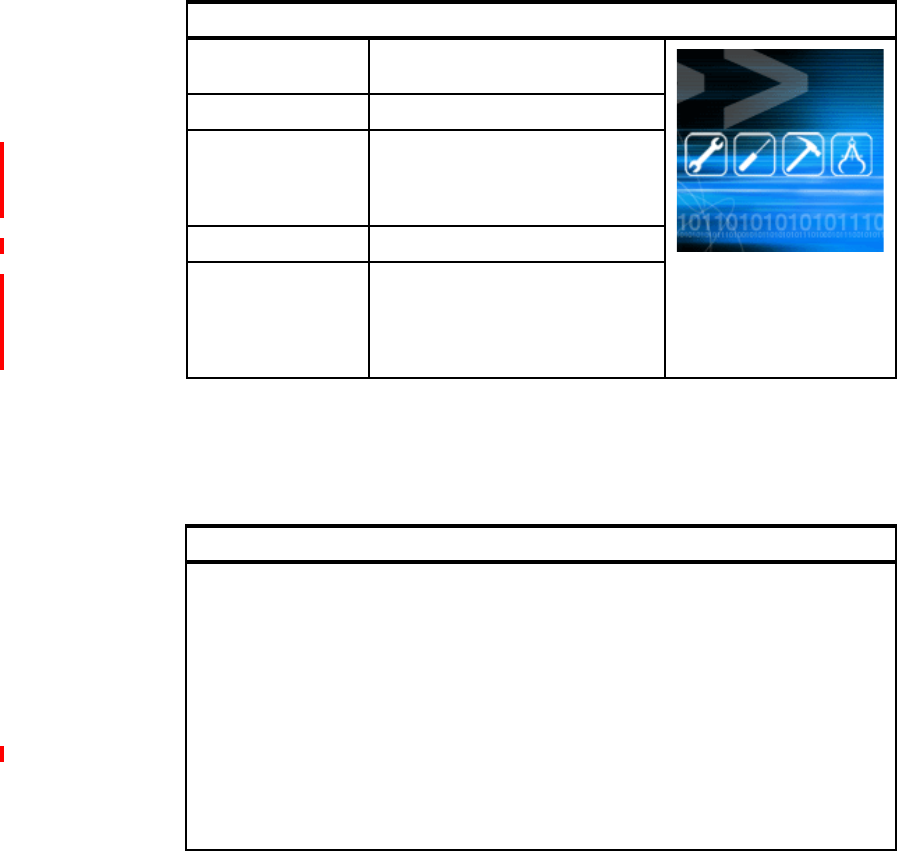
338 i5 Handbook
IBM AFP Font Collection for Workstations and OS/400
V2.1.1 (5648-B45)
Minimum operating
system level
OS/400 V5R1
Software type Software Subscription
Related products Infoprint Server, Infoprint Designer,
Advanced Print Utility, Page Printer
Formatting Aid, AFP Toolbox, and
iSeries Access
Replaces product 5769-AP1
Further information http://www.printers.ibm.com/R5PSC
.NSF/Web/software+overview
http://www.redbooks.ibm.com
http://www.ibm.com/eserver/iserie
s/infocenter
IBM Advanced DBCS Printer Support for iSeries (5722-AP1)
IBM AFP Font Collection for Workstations and OS/400 V2.1.1 (5648-B45)
The IBM AFP Font Collection for Workstations and OS/400 provides fonts that can be used by
most Advanced Function Presentation products. Skillful use of fonts in typography can
dramatically improve the readability and effectiveness of your documents. The IBM AFP Font
Collection CD is bundled and shipped with all orders of PSF/400.
The AFP Font Collection is designed to support printing on AFP/IPDS printers that accept host
downloaded fonts using Print Services Facility or Infoprint Manager. The AFP Font Collection CD
is shipped automatically with PSF/400.
AFP Font Collection provides one-stop shopping for System i5 printer fonts - the fonts you need to
realize the full potential of business communications. The fonts are provided in a full range of
resolutions (240 dpi, 300 dpi, and outlines) and in over 48 languages. Font sizes change easily to
support the latest IPDS printers, and to enable full graphical document viewing, as well as offer a
performance savings over raster fonts.
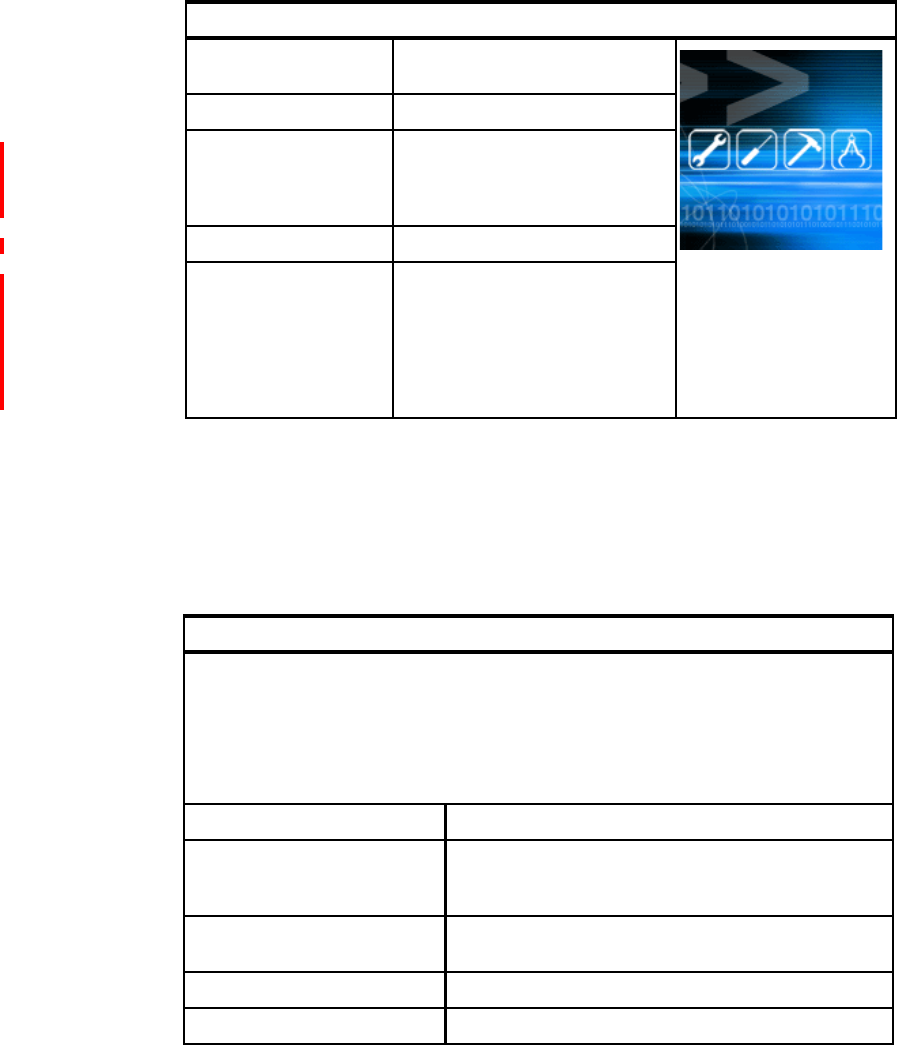
IBM licensed programs: Printing and document handling products 339
IBM Dictionary and Linguistics Tools for AS/400
(5769-DL1)
Minimum operating
system level
V2
Installation prerequisites 5722-SS1 Option 36, 37, or 38
Related products Infoprint Server, Infoprint Designer,
PSF/400 Advanced Print Utility, Page
Printer Formatting Aid, AFP Toolbox,
and iSeries Access
Replaces product 5648-B45 V2.1.0
Further information http://www.printers.ibm.com/inte
rnet/wwsites.nsf/
vwwebpublished/supportoverview_w
w
http://www.redbooks.ibm.com
http://www.printers.ibm.com/R5PS
C.NSF/Web/as400overview
IBM AFP Font Collection for Workstations and OS/400 V2.1.1 (5648-B45)
IBM Dictionary and Linguistics Tools for AS/400 (5769-DL1)
Dictionary and Linguistics Tools provides 36 dictionaries and a set of dictionary access methods
(application programming interfaces (APIs)) to allow clients to write applications to access the
dictionaries directly. Advanced linguistic information is built into each dictionary, such as
hyphenation, synonyms, spelling aid, morphological identification, and tokenization.
Dictionary and Linguistics Tools allow you to write your own APIs and support more languages
than the Language Dictionary product.
Minimum operating system level OS/400 V5R1
Software type Software Maintenance
One Year 5733-M89
Three Year 5733-M90
Ordering 5716-DCT is shipped with the System/38 Utilities product
(5722-DB1)
Installation prerequisites None
Replaces product Language Dictionaries (5716-DCT)
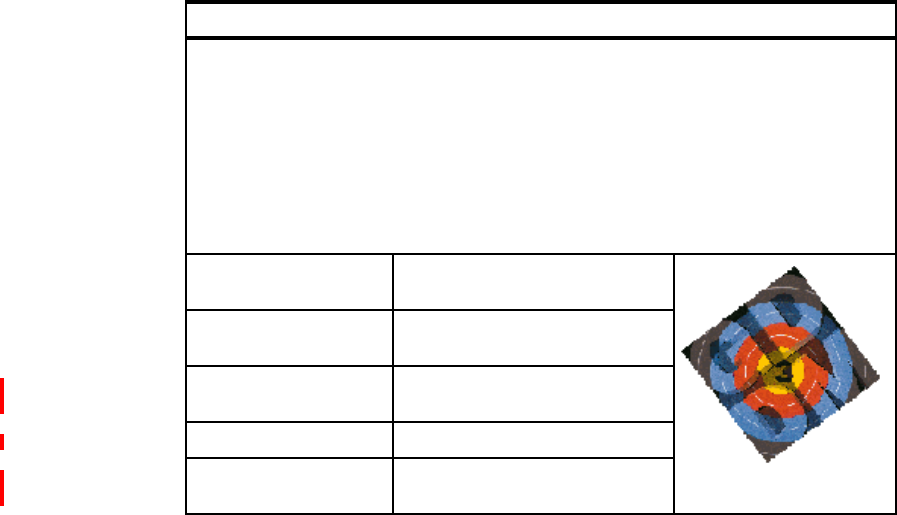
340 i5 Handbook
IBM Business Graphics Utility for AS/400 (5722-DS1)
IBM Business Graphics Utility for AS/400 (5722-DS1)
The Business Graphics Utility (BGU) for AS/400 licensed program provides a very flexible and
powerful business graphics function through a menu-driven interface. Users can create, modify,
store, display, print, and plot business graphics using data from a keyboard or database file.
Exercise and tutorial materials are supplied in the BGU User’s Guide to provide the necessary
familiarization.
Extensive options provided by BGU offer users considerable flexibility in creating computer-
generated charts. Font style, font size, font color, line styles, legend type, legend position,
annotation, and grid line construction are a few of the many options. A chart management facility
provides convenient storage, retrieval, deletion, modifications, renaming, and copying of charts.
Minimum operating
system level
OS/400 V5R1
Software type Software Subscription 5733-SW1 or
5733-SW3
Ordering Shipped as a chargeable software
group-based OS/400 LPO.
Installation prerequisites None
Replaces product IBM Business Graphics Utilities for
AS/400 (5769-DS1)
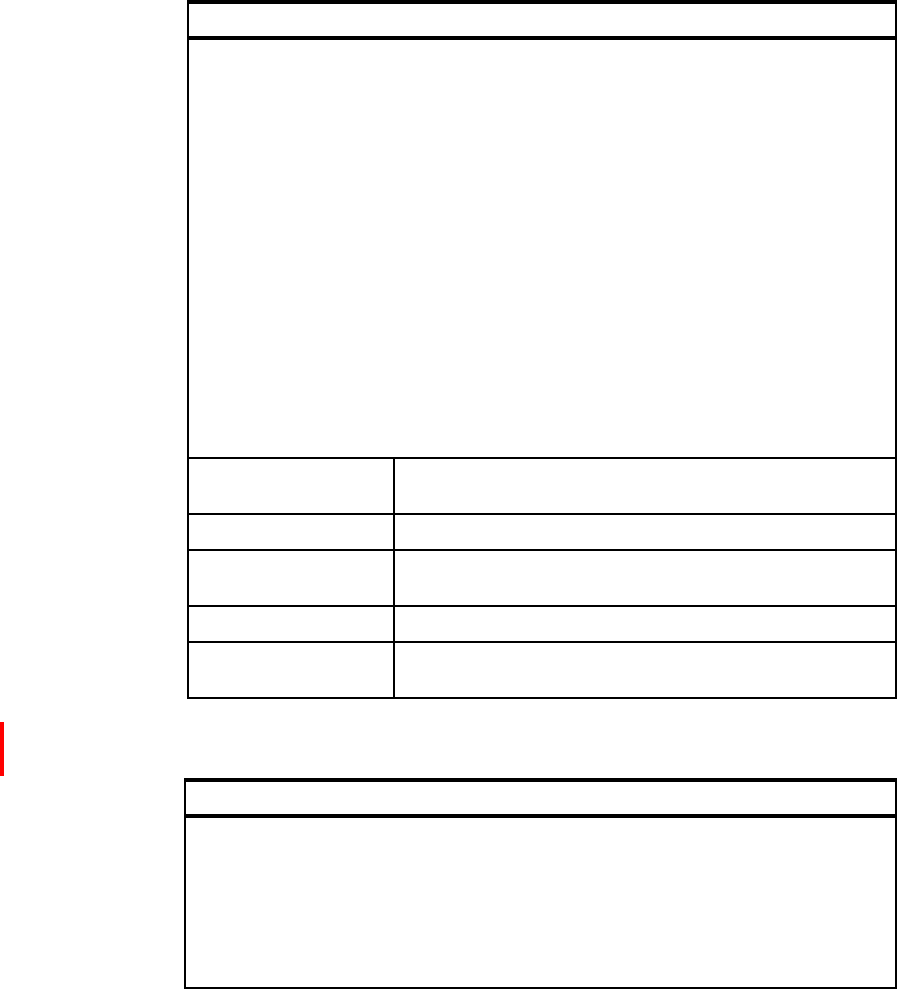
IBM licensed programs: Printing and document handling products 341
IBM Infoprint Fonts for Multiplatforms V1.1 (5648-E77)
IBM Infoprint Fonts for Multiplatforms V1.1 (5648-E77)
IBM Infoprint Fonts for Multiplatforms provides fonts that can be used by most Advanced Function
Presentation products. It includes all the outline fonts in the IBM AFP Font Collection V2.1, with
these enhancements:
Euro support for Eastern European and Asia Pacific languages
SAP support for Asia Pacific languages
GB18030 support for People’s Republic of China
JIS X0213 support for Japan
An improved graphical user interface (GUI) with context-sensitive help for the Type
Transformer
An improved GUI for RMARK font data
In addition, the GUIs that were in the AFP Font collection are improved.
Some additional considerations for Infoprint Fonts are:
Infoprint Fonts does not include the raster fonts included with the AFP Font Collection
(5648-B45).
If you currently have the AFP Font Collection and do not need the preceding functions, you do
not need to migrate to Infoprint Fonts for Multiplatforms.
The AFP Font Collection is shipped automatically with PSF/400.
Minimum operating
system level
OS/400 V5R1
Installation prerequisites 5722-SS1 Option 36, 37, or 38; PSF/400 is required
Related products Infoprint Server, Infoprint Designer, Page Printer Formatting Aid,
AFP Toolbox, iSeries Access
Replaces product None
Further information http://www.printers.ibm.com
http://www.printers.ibm.com/R5PSC.NSF/web/as400overview
IBM Facsimile Support for iSeries (5798-FAX)
Facsimile Support for iSeries enables your users and your applications to send and receive faxes.
Combined with native integrated modem hardware solutions, it provides a convenient, cost
efficient fax solution for your business. It provides users with direct fax capabilities, which help
increase operational efficiency and productivity through rapid information dispersal.
Cost savings may also be achieved through reduced human intervention time, paper cost,
telephone charges, postage charges, and document delivery time. Also, there is an audit trail of
both inbound and outbound activity to track the flow of your business data.
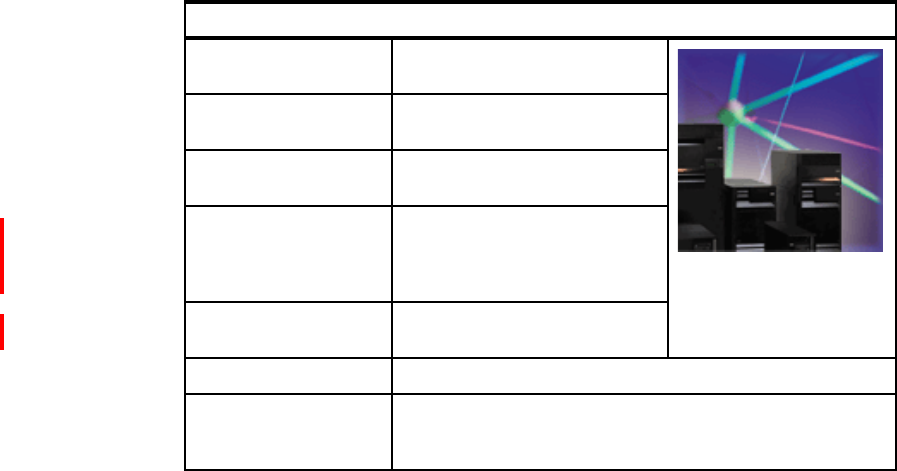
342 i5 Handbook
Minimum operating
system level
OS/400 V5R1
Software type Software Subscription
5733-SW1 or 5733-SW3
Ordering Shipped as a chargeable software
group-based OS/400 LPO
Installation prerequisites For hardware and software
requirements, see:
http://www-1.ibm.com/servers/es
erver/iseries/fax400/
Related products IBM Integrated Domino Fax
(5733-FXD)
Replaces product IBM Facsimile Support for AS/400 (5769-TBY)
Further information http://www-1.ibm.com/servers/eserver/iseries/fax400/
http://www.ibm.com/eserver/iseries/infocenter
http://www.redbooks.ibm.com
IBM Facsimile Support for iSeries (5798-FAX)

IBM licensed programs: Printing and document handling products 343
IBM Advanced Function Printing Fonts for AS/400
(5769-FNT)
IBM Advanced Function Printing Fonts for AS/400 (5769-FNT)
This is a set of 240 dpi fonts that primarily is provided for compatibility with existing print
applications. Unless you have applications that require these specific fonts, the standard font
product for OS/400 is AFP Font Collection (5648-B45).
Minimum operating
system level
OS/400 V5R1
Software type Software Subscription
Related products Infoprint Server, Infoprint Designer,
Advanced Print Utility, Page Printer
Formatting Aid, AFP Toolbox, and
iSeries Access
Replaces product None
Further information http://www.printers.ibm.com/in
ternet/wwsites.nsf/
vwwebpublished/main_ww
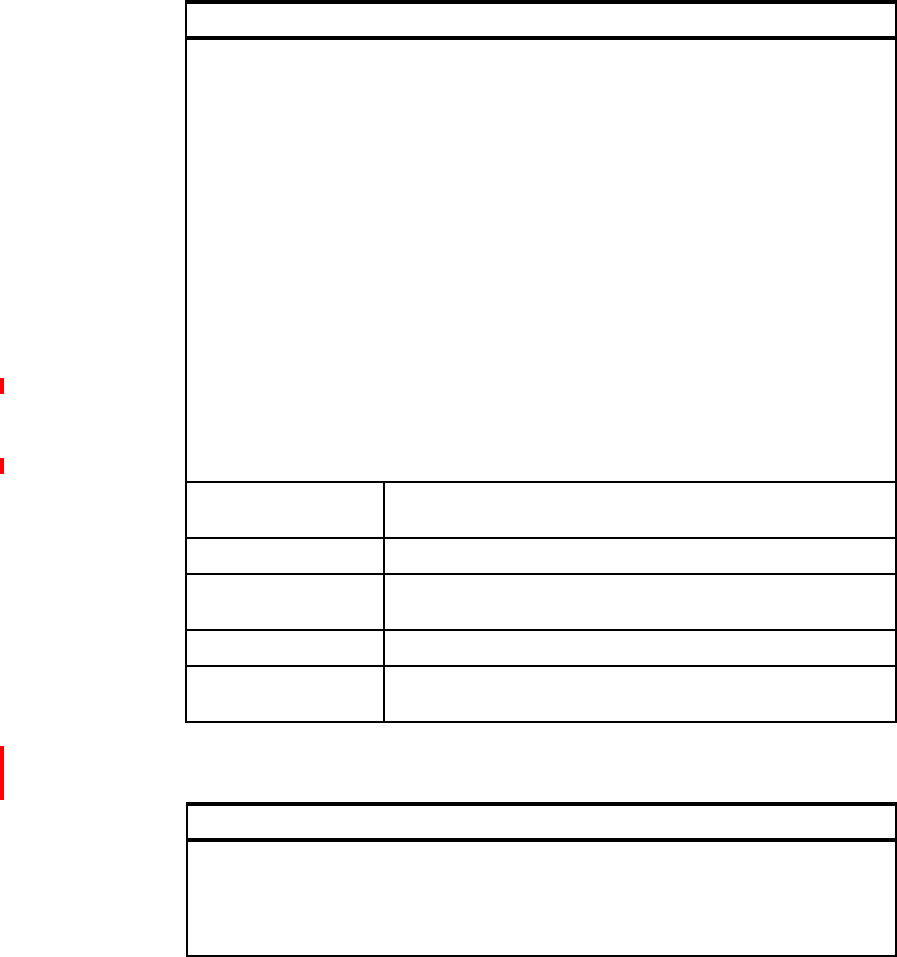
344 i5 Handbook
IBM Advanced Function Printing DBCS Fonts for AS/400
(5769-FN1)
IBM Advanced Function Printing DBCS Fonts for AS/400 (5769-FN1)
IBM Advanced Function Printing DBCS Fonts for AS/400 is a rich selection of DBCS font families
for use on 240 dots-per-inch, non-impact printers supported by AFP software integrated in the
OS/400. This program includes:
Japanese fonts
Korean fonts
Traditional Chinese fonts
Simplified Chinese fonts
Thai fonts
AFP is designed to allow printing on page printers. These fonts allow clients more flexibility in
printing. Some common uses for these families are for printing books, brochures, business plans,
handbooks, magazines, manuals, operating schedules, price lists, presentation materials,
headlines, subtitles, and reports.
Some of the features of IBM Advanced Function Printing are:
Provides a double-byte font library for use with 240 dots-per-inch, non-impact printers
attached to an System i5 server
Enhances system management flexibility with AFP resources transfer
Allows for growth and flexibility in the use of AFP printers
Enhances user productivity by printing the same object on AFP printers attached to an
S/370™ or System i5 server
Minimum operating
system level
OS/400 V5R1
Software type Software Subscription
Related products Infoprint Server, Infoprint Designer, Advanced Print Utility, Page
Printer Formatting Aid, AFP Toolbox, and iSeries Access
Replaces product 5716-FN1
Further information http://www.printers.ibm.com/internet/wwsites.nsf/
vwwebpublished/main_ww
IBM Infoprint Designer for iSeries (5733-ID1)
Infoprint Designer for iSeries provides a fully-graphical document composition interface to the
iSeries printing and e-output system. It supports the requirements of today's complex documents
and reports to produce fully electronic documents combining data, text, electronic forms,
graphics, image, barcoding, and typographic fonts. Infoprint Designer for iSeries can be used for
the design of new output applications or the re-engineering of existing applications.

IBM licensed programs: Printing and document handling products 345
Minimum operating
system level
OS/400 V4R5
Software type Software Subscription
5733-SW1 or 5733-SW3
Ordering Shipped as a chargeable software group-based OS/400 LPO
Installation prerequisites 5722-SS1 and option 37, 38, or 39 are optional
iSeries Access for Windows
Related products Infoprint Server, iSeries Access, and PSF/400
Replaces product IBM Advanced Function Printing Utilities for iSeries (5722-AF1)
Further information http://www.printers.ibm.com/internet/wwsites.nsf/
vwwebpublished/main_ww
Infoprint Server for iSeries (5722-IP1)
The focus of Infoprint Server is to extend the considerable capabilities of the iSeries beyond
printing to the management and dissemination of output. As business applications are
re-engineered into applications for On Demand Business, the output of those applications may
need to change and flow electronically to the consumer of that output. Infoprint Server provides for
multi-channel delivery of communications that include print, e-mail, Web, and other options.
For enterprise printing requirements, Infoprint Server delivers improved efficiency, improved
reliability, and lower overall printing costs. It applies iSeries printing management and System
i5-attached printers to the task of handling all of the essential printing generated across the
network.
Minimum operating
system level
OS/400 V5R1
Software type Software Subscription 5733-SW1
or 5733-SW3
Ordering Shipped as a chargeable software
group-based OS/400 LPO
Prerequisites OS/400 PASE, Option 33, is
required for PostScript, PCL, or
Portable Document Format (PDF)
to AFPDS transforms
Related products PSF/400, Infoprint Designer, and Content Manager OnDemand
Replaces product None
IBM Infoprint Designer for iSeries (5733-ID1)

346 i5 Handbook
Further information http://www.printers.ibm.com/internet/wwsites.nsf/
vwwebpublished/main_ww
IBM Content Manager OnDemand for iSeries (5722-RD1)
IBM Content Manager OnDemand for iSeries provides a powerful Enterprise Report Management
solution to electronically capture and archive large volumes of computer-generated information.
This includes customer statements, invoices, reports, scanned images, and e-mails.
Content Manager OnDemand (OnDemand/400) supports electronic statement presentment
solutions through robust, advanced client applications for both desktop and standard Web
browsers, with advanced search and report mining capabilities. With OnDemand/400, enterprises
can automatically organize printed output, and provide rapid, direct access to specific information,
making more effective use of the massive amounts of information captured over time.
Minimum operating
system level
OS/400 V5R1
Installation prerequisites None
Related products IBM Content Manager for iSeries, Content Manager CommonStore
for Lotus Domino, Enterprise Information Portal
Client code Downloaded from
ftp://service.software.ibm.com/software/ondemand/fixes/v71/
Replaces product 5769-RD1
Further information http://www.ibm.com/software/data/ondemand/400
IBM Content Manager for iSeries (5722-VI1)
IBM Content Manager for iSeries provides document imaging and workflow technology designed
to replace cumbersome paper document processing with image processing to achieve greater
productivity and process reliability. With Advanced Workflow, Content Manager provides a fast,
efficient way to customize and automate business processes by automatically routing documents
and folders through a business.
Content Manager is highly scalable, from entry level to enterprise level needs. It extends the
information infrastructure to manage unstructured content, integrate content with core business
applications, and automate business processes.
Infoprint Server for iSeries (5722-IP1)
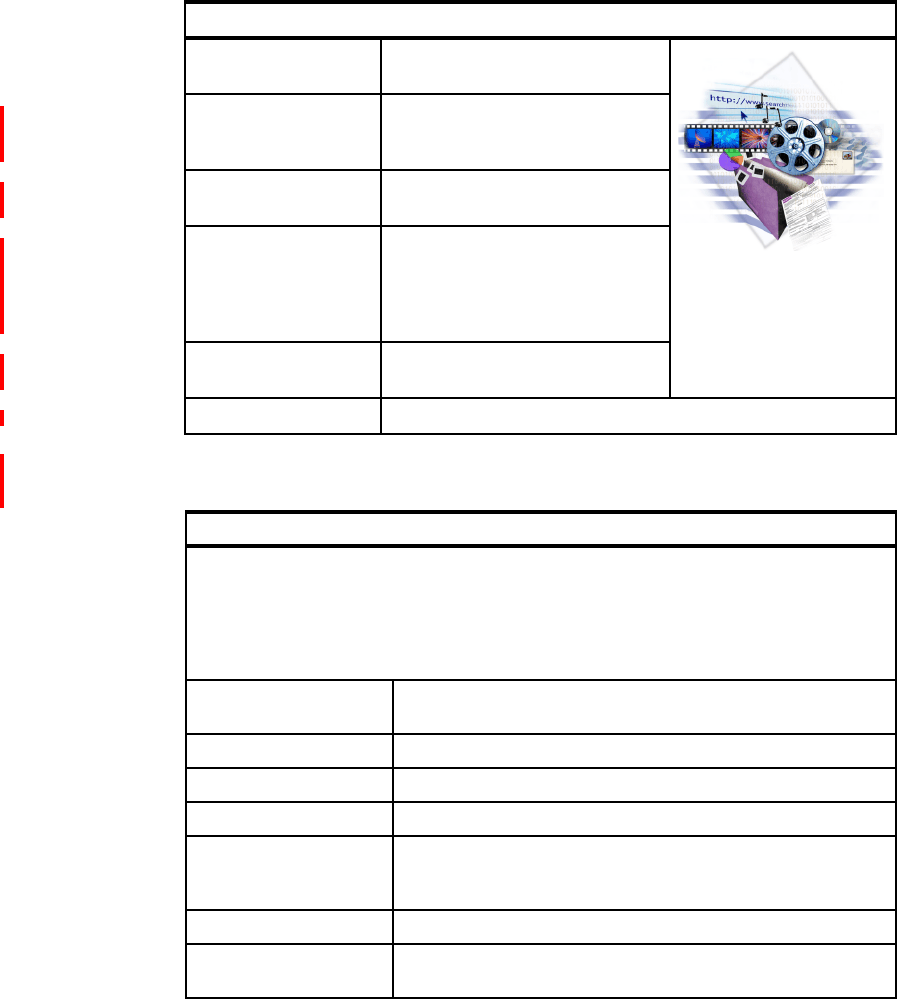
IBM licensed programs: Printing and document handling products 347
Minimum operating
system level
OS/400 V5R1
Software type Software Maintenance
One Year 5733-M81
Three Year 5733-M82
Installation prerequisites http://www.ibm.com/software/data/
ondemand/400/
Related products Content Manager OnDemand,
Content Manager CommonStore for
Lotus Domino, Content Manager
CommonStore for SAP, Enterprise
Information Portal
Replaces product IBM Content Manager for AS/400
(5769-VI1)
Further information http://www-3.ibm.com/software/data/cm/cmgr/400
IBM Print Services Facility for iSeries (PSF/400) (5722-SS1 options 36, 37, and 38)
Print Services Facility for OS/400 (PSF/400), a feature of OS/400, provides support for
high-function Advanced Function Presentation (AFP) electronic printing and print management of
IPDS printers. With AFP, application output can be transformed into fully graphical documents
with electronic forms, image, graphics, barcoding, lines, boxes, and text in a wide variety of fonts.
This flexibility enables the production of electronic documents that are more effective and enables
the re-engineering of business processes.
Minimum operating
system level
OS/400 V5R1
Software type Software Subscription
Ordering Feature of OS/400
Installation prerequisites None
Related products Infoprint Server for iSeries, AFP Font Collection Type Transformer for
Windows, Infoprint Designer for iSeries, and Facsimile Support for
iSeries
Replaces product PSF/400 (5769-SS1)
Further information http://www.printers.ibm.com/internet/wwsites.nsf/
vwwebpublished/main_ww
IBM Content Manager for iSeries (5722-VI1)
348 i5 Handbook

349
Reference

Reference

© Copyright IBM Corp. 1997 - 2006. All rights reserved. 351
Chapter 28. AS/400, AS/400e, and iSeries
model summary
This chapter identifies resources and capacities for all AS/400e and iSeries
processors that are no longer marketed by IBM.
You can find summary charts of iSeries processors currently marketed by IBM in
Chapter 5, “Today’s System i5 summary” on page 47.
28

352 i5 Handbook
CISC systems
You can find resource and capacity information for the AS/400 CISC systems
sold beginning in 1988 in AS/400 CISC System Builder, REDP-0042.
RISC servers
You can find resource and capacity information for the AS/400e RISC servers
sold beginning in 1996 in AS/400e RISC System Builder, REDP-0342. Refer to
the IBM Eserver iSeries and AS/400e System Builder, SG24-2155, for resource
and capacity information for AS/400e RISC systems that are not found in
AS/400e RISC System Builder, REDP-0342.
iSeries and AS/400e servers
This section presents resource and capacity information for the most recent
systems withdrawn from marketing. As such, they detailed information is no
longer represented in this IBM Redbook.
The following AS/400e and iSeries servers are found in this section:
9406 AS/400e Model 270
9406 AS/400e Model 720
9406 AS/400e Model 730
9406 AS/400e Model 740
9406 iSeries Model 800
9406 iSeries Model 810
9406 iSeries Model 820
9406 iSeries Model 825
9406 iSeries Model 830
9406 iSeries Model 840
9406 iSeries Model 870
9406 iSeries Model 890
Processor performance represents the relative performance (maximum capacity)
of a processor feature running CPW in a client/server environment. Processor
capacity is achievable when the commercial workload is not constrained by main
storage and direct access storage device (DASD). Performance of the 5250
CPW represents the relative performance available to perform host-centric
workloads. The amount of in 5250 CPW capacity consumed reduces the
available processor capacity by the same amount.

AS/400, AS/400e, and iSeries model summary 353
Mail and Calendar Users (MCU) is a relative performance measurement derived
by performing mail and calendar functions using Domino and Notes clients. The
MCU workload represents concurrent users on a Notes client who are reading,
updating, or deleting documents in an e-mail database. It also represents users
who are performing lookups in the Domino Directory, and scheduling calendar
appointments and invitations. Reported values reflect 70% processor utilization
to allow for growth and peak loads in excess of client workload estimates.
5250 CPW (Interactive) is an approximate value that reflects the amount of
Processor CPW that can be used for workloads performing 5250-based tasks.
Remember that:
The iSeries Enterprise Edition provides maximum 5250 CPW support (up to
100% of the capacity of the active processor CPW). The iSeries Standard
Edition provides zero CPW for 5250 work.
Any task that uses a 5250 data stream is considered 5250 online transaction
processing (OLTP) work and requires some amount of 5250 CPW to process
no matter how the task was started.
A task submitted through a 5250 session (5250 device or 5250 emulation)
that does display or printer input/output (I/O) requires 5250 CPW.
A task submitted through a 5250 session (5250 device or 5250 emulation) as
a “batch” job is not considered 5250 OLTP work and does not require any
5250 CPW unless the task does display or printer I/O.
Limited 5250 CPW is available with the Standard Edition for a system
administrator to use 5250 display device I/O to manage various aspects of the
server. Multiple administrative jobs exceed this capability

354 i5 Handbook
9406 Model 270
Model 270
Processor feature #2248 #2250 #2252 #2253
Relative system performance
Processor CPW 150 370 950 2000
5250 CPW
Base #1516 - 0 0 0
#1517 25 - - -
#1518 - 30 - -
#1519 - - 50 -
#1520 - - - 70
Number/type/speed of processors 1/Pulsar/400 MHz 1/Pulsar/400 MHz 1/Pulsar/450 MHz 2/Pulsar/450 MHz
L2 Cache (MB)/processor 0 0 2 4
Main storage (MB min/max) 256 - 4096 256-4096 256-8192 256-8192
Main storage DIMMs (min/max) 2/8 2/8 2/16 2/16
Minimum operating system level V4R5 V4R5 V4R5 V4R5
Software group P05 P10/P10 P05 P20/P20
Model 270 Dedicated Server for Domino
Processor feature #2422 #2423 #2424
Relative system performance (CPW)
Processor CPW 50 100 200
5250 CPW 0 0 0
Simple Mail Users 2400 3860 7580
Mail and Calendaring Users 1600 2570 5050
Number/type/speed of processors 1/Pulsar/400 MHz 1/Pulsar/450 MHz 2/Pulsar/450 MHz
L2 Cache (MB) 0 2 4
Main storage (MB min/max) 256-4096 256-8192 256-8192
Main storage DIMMs (min/max) 2/8 2/16 2/16
Minimum operating system level V4R5 V4R5 V4R5
Software group P05 P05 P10
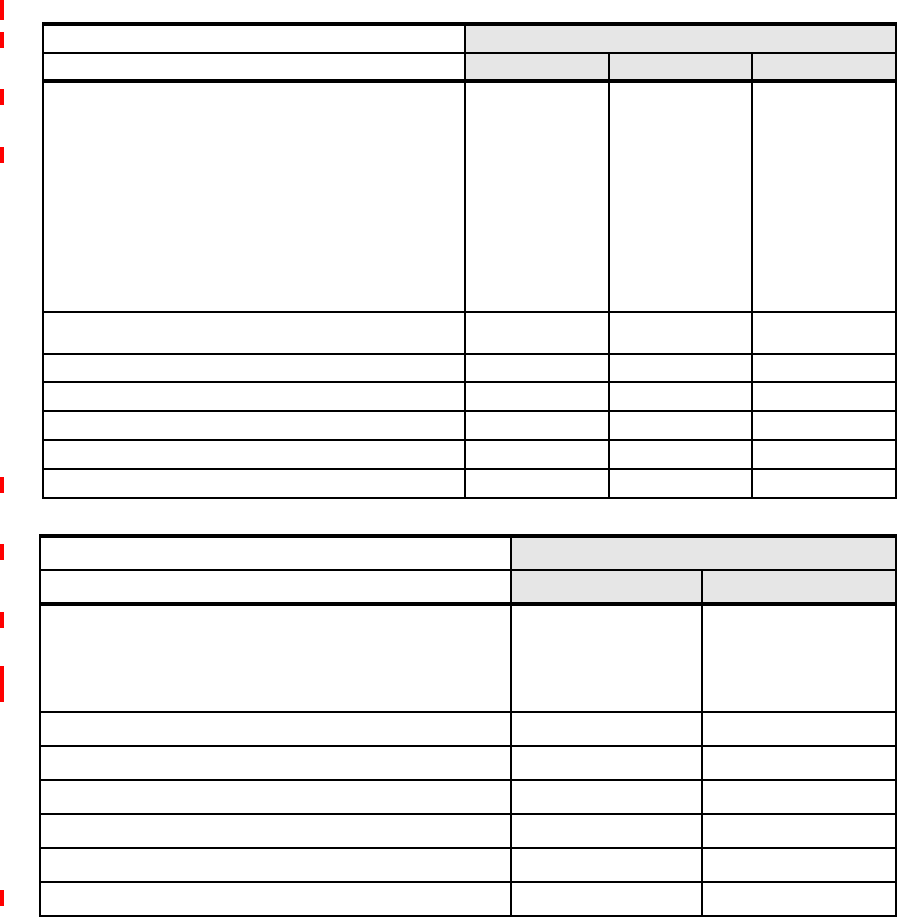
AS/400, AS/400e, and iSeries model summary 355
Model 270
Processor feature #2431 #2432 #2434
Relative system performance
Processor CPW 465 1070 2350
5250 CPW
#1516 (Base) - 0 0
#1517 - - -
#1518 30 - -
#1519 - 50 -
#1520 - - 70
Number/type/speed of processors 1/SSTAR/
540 MHz
1/SSTAR/
540 MHz
2/SSTAR/
600 MHz
L2 Cache (MB)/processor 0 2 4
Main storage (MB min/max) 256 - 8192 256 - 8192 256 - 16384
Main storage DIMMs (min/max) 1/8 1/8 2/16
Minimum operating system level V5R1 V5R1 V5R1
Software group P10 P10 P20
Model 270 Dedicated Server for Domino
Processor feature #2452 #2454
Relative system performance
Processor CPW 100 240
5250 CPW
Mail and Calendar Users
0
3070
0
6660
Number/type/speed of processors 1/SSTAR/540 MHz 2/SSTAR/600 MHz
L2 Cache (MB) 2 4
Main storage (MB min/max) 256 - 8192 256 - 16384
Main storage DIMMs (min/max) 1/8 2/16
Minimum operating system level V5R1 V5R1
Software group P05 P10
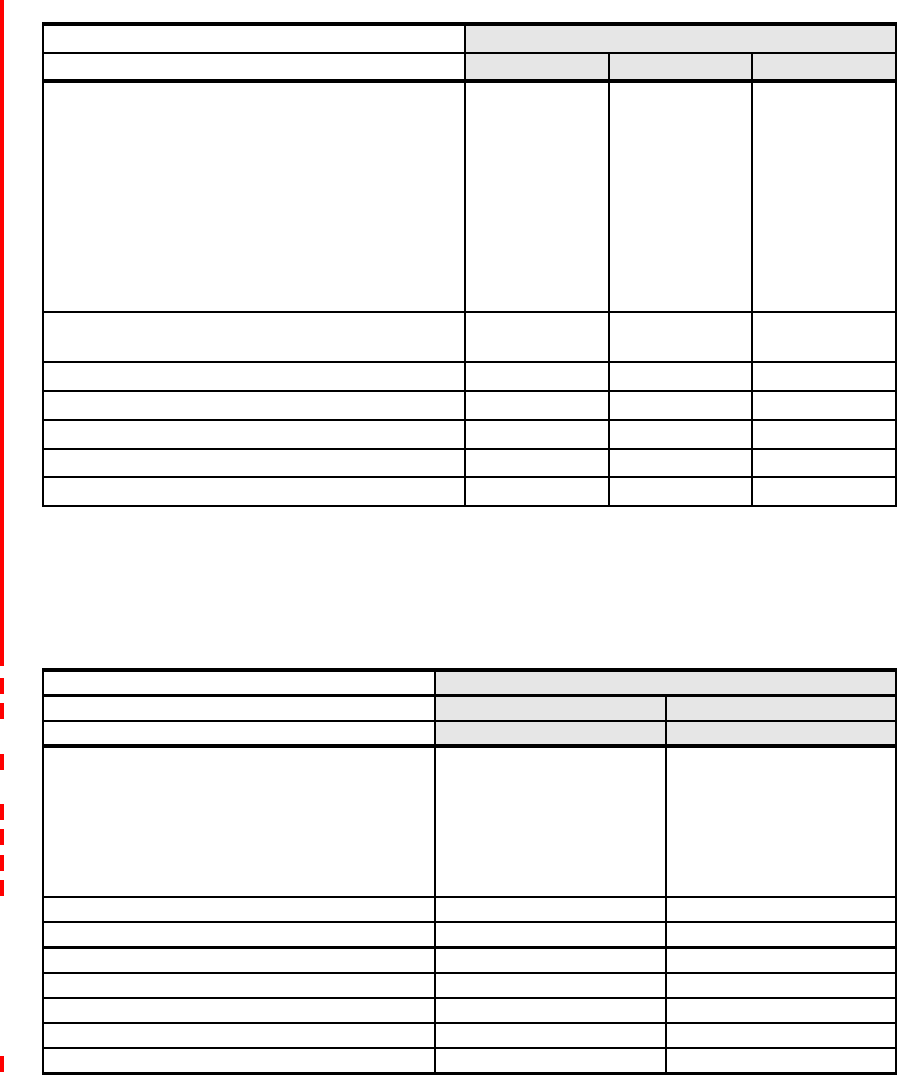
356 i5 Handbook
9405 and 9406 Model 520
9406 Model 570
Model 270
Processor feature #2431 #2432 #2434
Relative system performance
Processor CPW 465 1070 2350
5250 CPW
#1516 (Base) - 0 0
#1517 - - -
#1518 30 - -
#1519 - 50 -
#1520 - - 70
Number/type/speed of processors 1/SSTAR/
540 MHz
1/SSTAR/
540 MHz
2/SSTAR/
600 MHz
L2 Cache (MB)/processor 0 2 4
Main storage (MB min/max) 256 - 8192 256 - 8192 256 - 16384
Main storage DIMMs (min/max) 1/8 1/8 2/16
Minimum operating system level V5R1 V5R1 V5R1
Software group P10 P10 P20
Model 570
Processor feature #8961 #8961 (x2)
Server feature #0919 #0920
Relative system performance
Processor CPW 3300/6000 6350/12000
Mail and Calendar Users 7300/13300 14100/26600
5250 CPW
Standard 0 0
Enterprise Maximum Maximum
Number/type/speed of processor 0/2/POWER5/1.65 GHz 2/4/POWER5/1.65 GHz
L2 Cache (MB per processor) 1.88 1.88
L3 Cache (MB per processor) 36 36
Main storage (GB minimum/maximum) 2/65 2/128
Main storage DIMMs (minimum/maximum) 4/8 8/16
LPAR 10/20 20/40
Minimum i5/OS level V5R3 V5R3
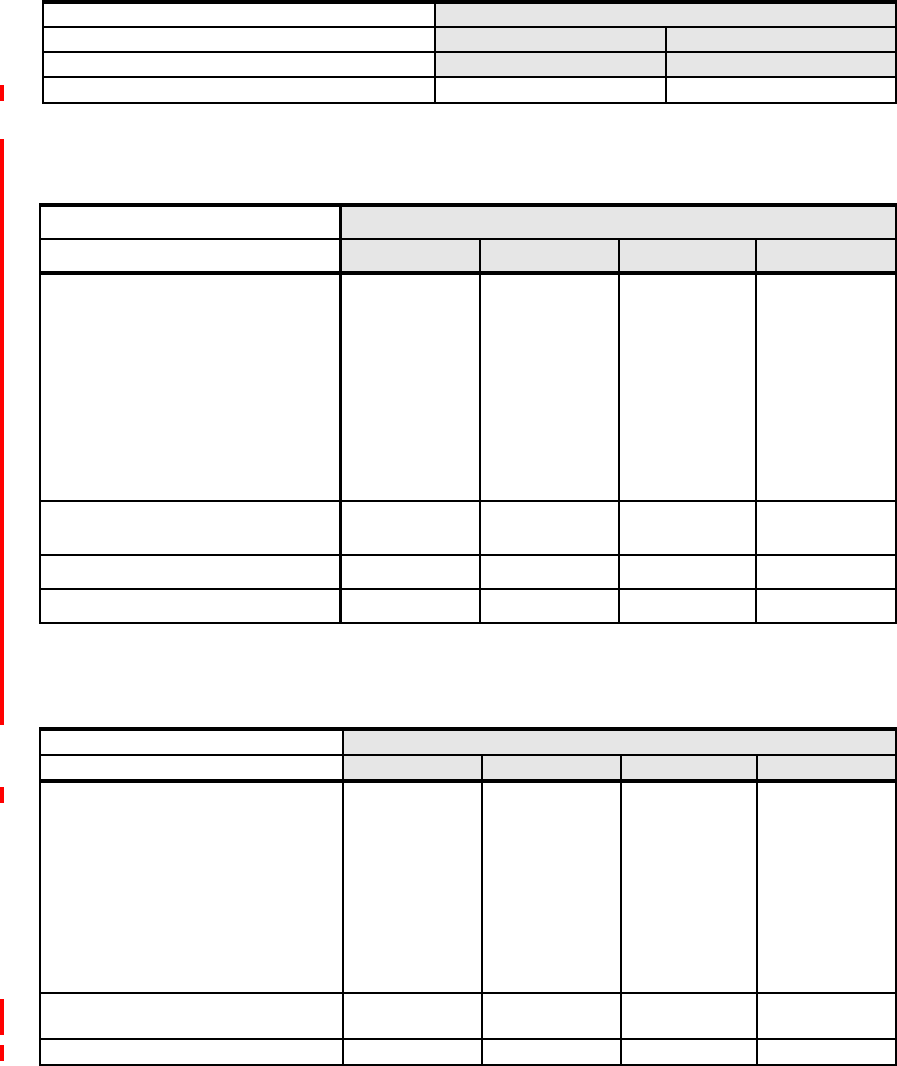
AS/400, AS/400e, and iSeries model summary 357
9406 Model 720
9406 Model 730
Software group P30 P30
Model 720
Processor feature #2061 #2062 #2063 #2064
Relative system performance
Version 4 Release 3 and later
Processor CPW
240 420 810 1600
Interactive CPW/system feature code
#1500 (Base)
#1501
#1502
#1503
#1504
#1505
35/206A
70/206B
120/206C
-
-
-
35/206D
70/206E
120/206F
240/207A
-
-
35/207B
-
120/207C
240/207D
560/207E
-
35/207F
-
120/208A
240/208B
560/208C
1050/208D
Number/type/speed of processors 1/Northstar/
250 MHz
1/Northstar/
250 MHz
2/Northstar/
250 MHz
4/Northstar/
250 MHz
Main storage (MB) 256-2048 256-4096 256-8192 256-8192
Software group P10-P20 P10-P20 P20-P30 P20-P30
Model 730
Processor feature #2065 #2066 #2067 #2068
Relative system performance
Version 4 Release 3 and later
Processor CPW
560 1050 2000 2890
Interactive CPW/system feature code
#1506 (Base)
#1507
#1508
#1509
#1510
#1511
70/2A6A
120/2A6B
240/2A6C
560/2A6D
-
-
70/2A6E
120/2A6F
240/2B6A
560/2B6B
1050/2B6C
-
70/2B6D
-
240/2B6E
560/2B6F
1050/2C6A
2000/2C6B
70/2C6C
-
240/2C6D
560/2C6E
1050/2C6F
2000/2D6A
Number/type/speed of processors 1/Northstar/
262 MHz
2/Northstar/
262 MHz
4/Northstar/
262 MHz
8/Northstar/
262 MHz
Main storage (MB) 512-24576 512-24576 512-24576 1024-24576
Model 570
Processor feature #8961 #8961 (x2)
Server feature #0919 #0920

358 i5 Handbook
Software group P20-P30 P20-P30 P30-P40 P30-P40
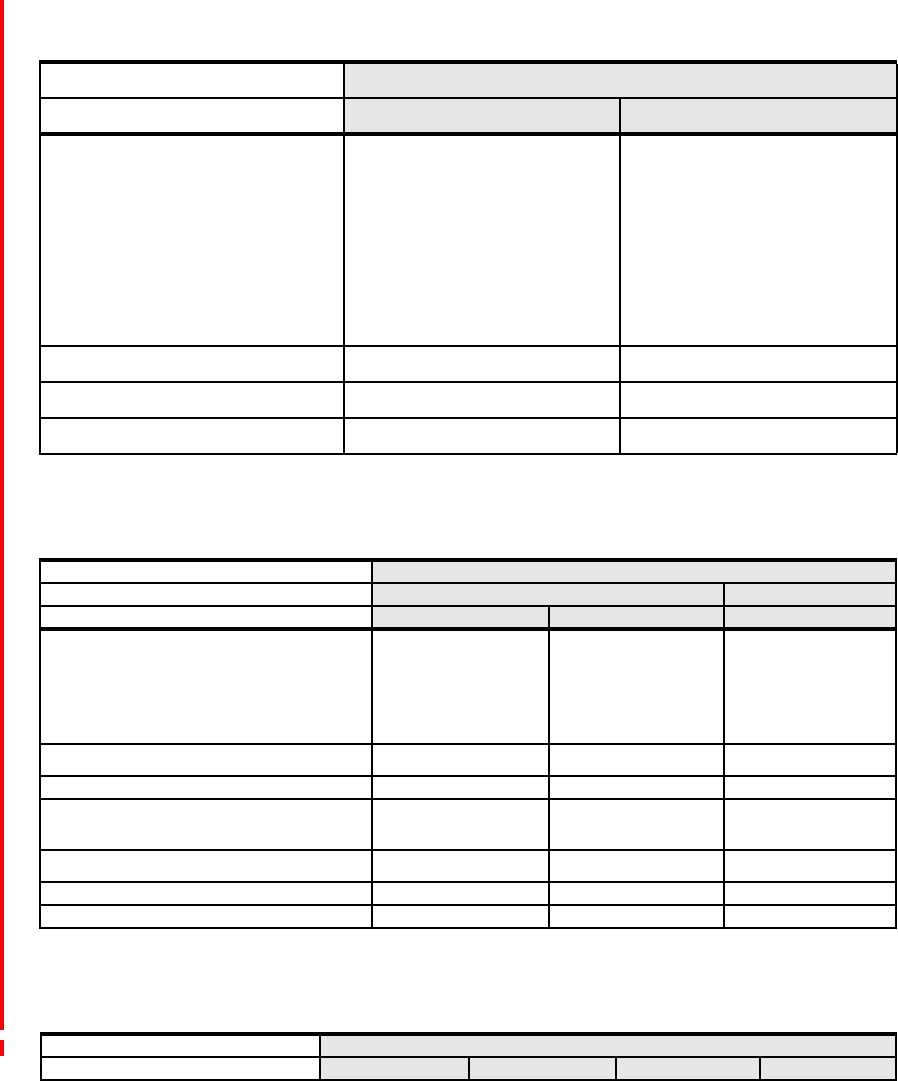
AS/400, AS/400e, and iSeries model summary 359
9406 Model 740
9406 Model 800
9406 Model 810
Model 740
Processor feature #2069 #2070
Relative system performance
Version 4 Release 3 and later
Processor CPW 3660 4550
Interactive CPW/system feature code
#1514 (Base)
#1510
#1511
#1512
#1513
120/2D6B
1050/2D6C
2000/2D6D
3660/2D6E
-
120/2E6A
1050/2E6B
2000/2E6C
3660/2E6D
4550/2E6E
Number/type/speed of processors 8/Northstar/ 262MHz 12/Northstar/ 262MHz
Main storage (MB) 1024-40960 1020-40960
Software group P40-P50 P40-P50
Model 800
Processor feature #2463 #2464
Server feature #0863 #0864 #0865
Relative system performance
Processor CPW 300 300 950
5250 CPW
#7400 25 25 -
#7408 - - 50
Number/type/speed of processor 1/SStar/540 MHz 1/SStar/540 MHz 1/SStar/750 MHz
L2 Cache (MB) per processor 0 0 2
Main storage
(MB minimum to maximum)
256 to 8192 256 to 8192 256 to 8192
Main storage DIMMs (minimum/maximum) 1/8 1/8 1/8
Minimum operating system level V5R2 V5R2 V5R2
Software group P05 P05 P10
Model 810
Processor feature #2465 #2466 #2467 #2469
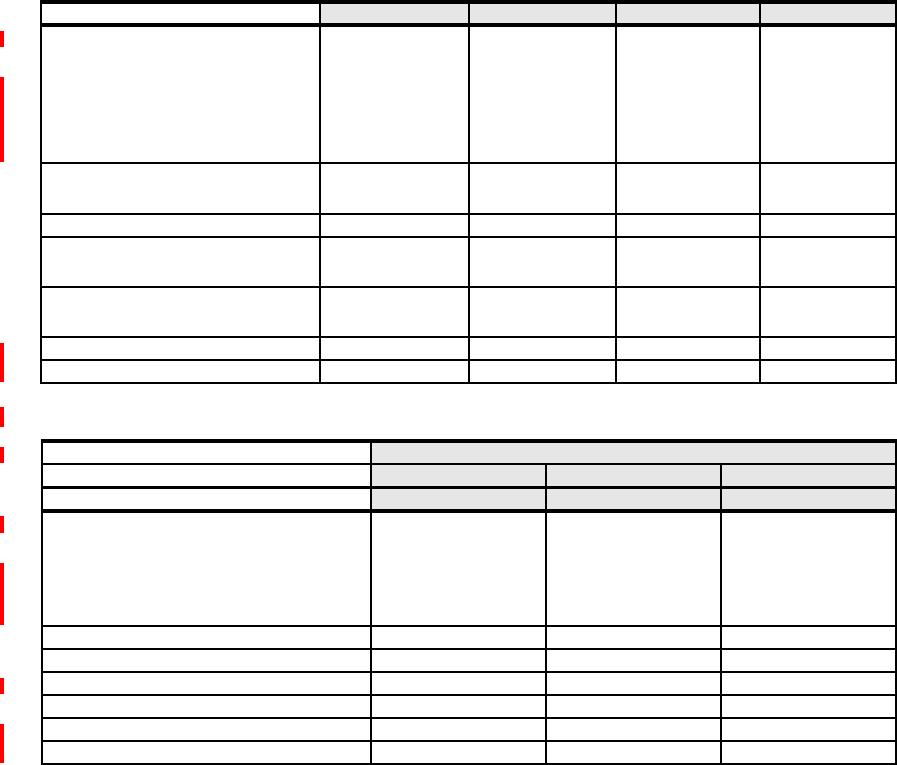
360 i5 Handbook
Server feature #0868 #0866 #0867 #0869
Relative system performance
Processor CPW 750 1020 1470 2700
5250 CPW
Standard 0 0 0 0
Enterprise 750 1020 1470 2700
High Availability 750 1020 1470 2700
Number/type/speed of processor 1/SStar/540 MHz 1/SStar/540 MHz 1/SStar/750 MHz 2/SStar/
750 MHz
L2 Cache (MB) per processor 2 2 4 4
Main storage
(MB minimum to maximum)
512 to 16384 512 to 16384 512 to 16384 512 to 16384
Main storage DIMMs
(minimum/maximum)
1/8 1/8 1/8 2/16
Minimum operating system level V5R2 V5R2 V5R2 V5R2
Software group P10 P10 P10 P20
Model 810 iSeries for Domino
Processor feature #2466 #2467 #2469
Server feature9c #0769 #0770 #0771
Relative system performance
Processor CPW 1020 1470 2700
Mail and Calendar Users (MCU) 3100 4200 7900
5250 CPW
Domino 0 0 0
Number/type/speed of processor 1/SStar/540 MHz 1/SStar/750 MHz 2/SStar/750 MHz
L2 Cache (MB) per processor 2 4 4
Main storage (GB minimum to maximum) 1.5 to 16 3.5 to 16 5.5 to 16
Main storage DIMMs (maximum) 8 8 16
Minimum operating system level V5R2 V5R2 V5R2
Software group P10 P10 P20
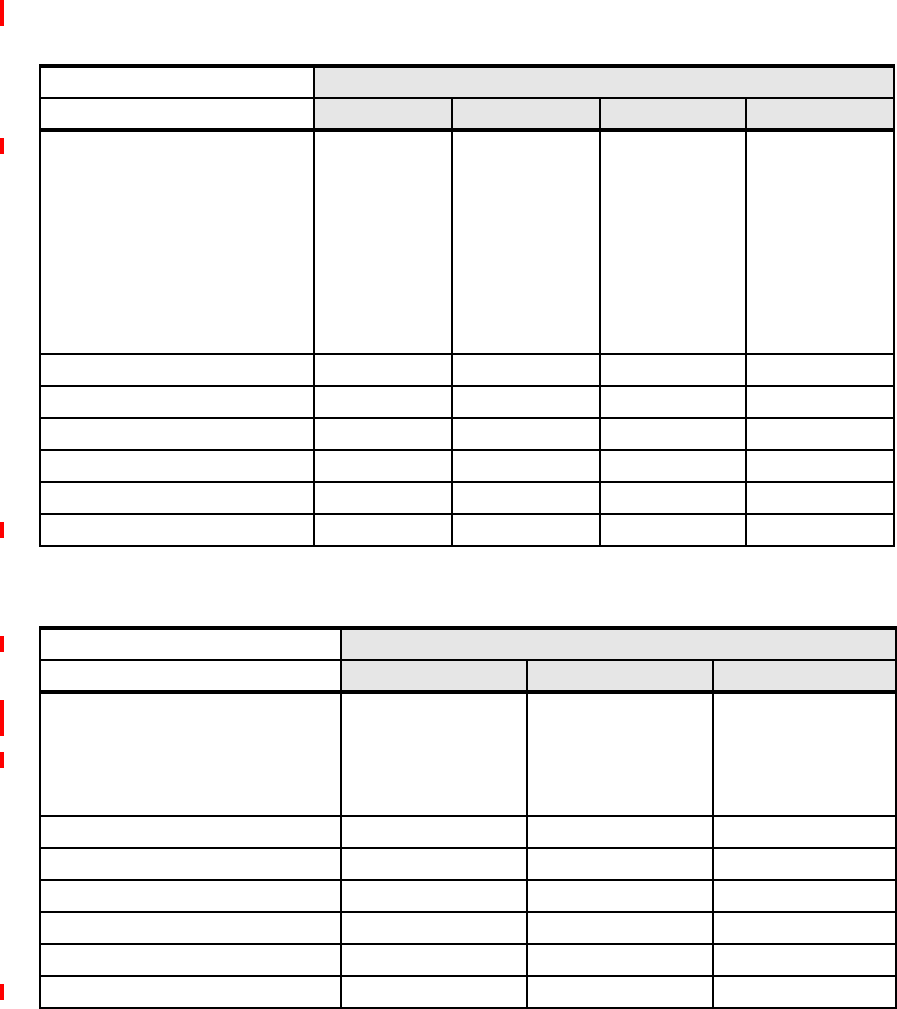
AS/400, AS/400e, and iSeries model summary 361
9406 Model 820
Model 820
Processor feature #2395 #2396 #2397 #2398
Relative system performance
Processor CPW 370
950 2000 3200
5250 CPW
#1521
#1522
#1523
#1524
#1525
#1526
#1527
35
70
120
240
-
-
-
35
70
120
240
560
-
-
35
70
120
240
560
1050
-
35
70
120
240
560
1050
2000
Number/type/speed of processors 1/Pulsar/400 MHz 1/Pulsar/450 MHz 2/ISTAR/500 MHz 4/ISTAR/500 MHz
L2 Cache (MB) 0 2 4 4
Main storage (MB min/max) 256 - 4096 256-8192 256-16384 256-16384
Main storage DIMMs (min/max) 2/8 2/16 2/32 2/32
Minimum operating system level V4R5 V4R5 V4R5 V4R5
Software group P10-P20 P20-P30 P20-P30 P30-P40
Model Dedicated Server for Domino
Processor feature #2425 #2426 #2427
Relative system performance
Processor CPW
100 200 300
5250 CPW
Simple Mail Users
Mail and Calendaring Users
0
4250
2570
0
8000
5610
0
14400
9890
Number/type/speed of processors 1/Pulsar/450 MHz 2/ISTAR/500 MHz 4/ISTAR/500 MHz
L2 Cache (MB) 2 4 4
Main storage (MB min/max) 256-8192 256-16384 256-16384
Main storage DIMMs (min/max) 2/16 2/32 2/32
Minimum operating system level V4R5 V4R5 V4R5
Software group P05 P10 P10

362 i5 Handbook
Model 820
Processor feature #2435 #2436 #2437 #2438
Relative system performance
Processor CPW 600 1100 2350 3700
5250 CPW
None
#1521
#1522
#1523
#1524
#1525
#1526
#1527
-
35
70
120
240
-
-
-
-
35
70
120
240
560
-
-
-
35
70
120
240
560
1050
-
-
35
70
120
240
560
1050
2000
Number/type/
speed of processors
1/SSTAR/
600 MHz
1/SSTAR/
600 MHz
2/SSTAR/
600 MHz
4/SSTAR/
600 MHz
L2 Cache (MB) 2 2 4 4
Main storage (MB min/max) 256 - 8192 256 - 16384 256 - 32768 256 - 32768
Main storage DIMMs 2/8 2/16 2/32 2/32
Minimum operating system level V5R1 V5R1 V5R1 V5R1
Software group P10 or P20 P20 or P30 P20 or P30 P30 or P40
Model 820 Dedicated Server for Domino
Processor feature #2456 #2457 #2458
Relative system performance
Processor CPW 120 240 380
5250 CPW
Mail and Calendar Users
0
3110
0
6600
0
11810
Number/type/speed of processors 1/SSTAR/600 MHz 2/SSTAR/600 MHz 4/SSTAR/600 MHz
L2 Cache (MB) 2 4 4
Main storage (MB min/max) 256 - 16384 256 - 32768 256 - 32768
Main storage DIMMs (min/max) 2/16 2/32 2/32
Minimum operating system level V5R1 V5R1 V5R1
Software group P05 P10 P10
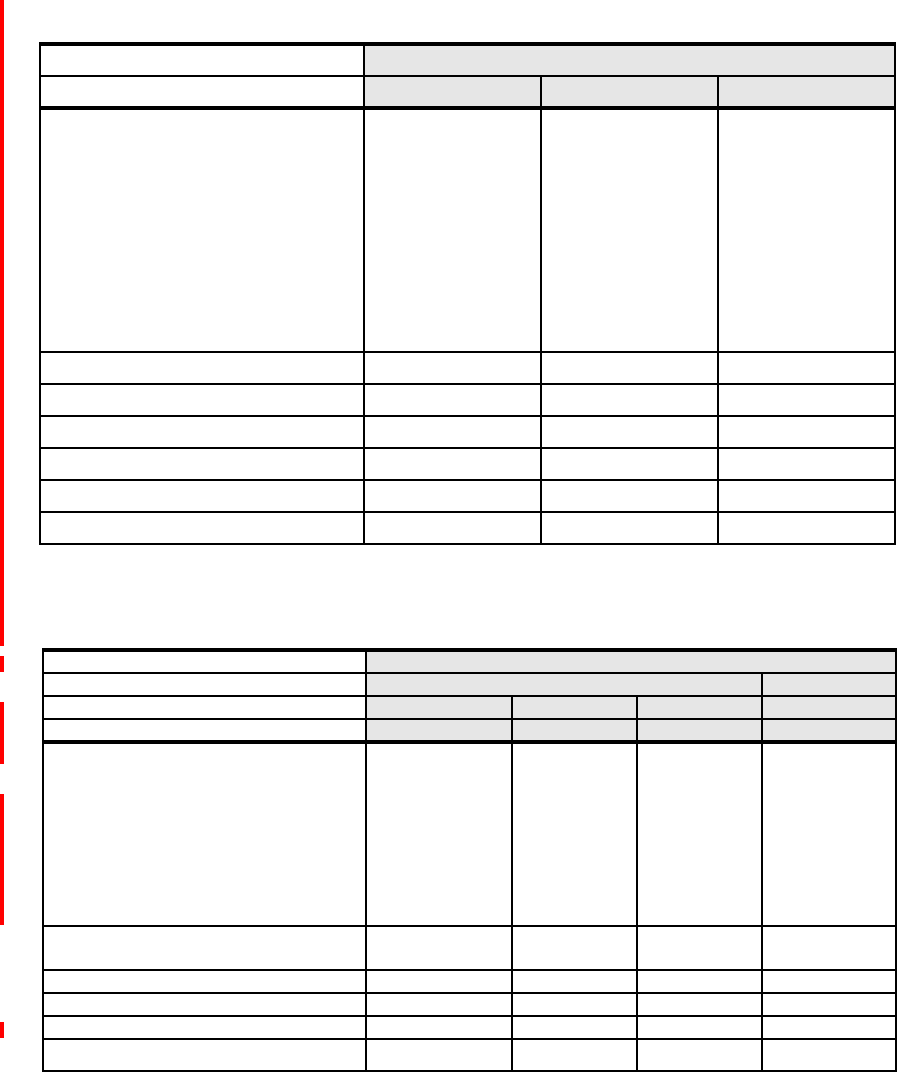
AS/400, AS/400e, and iSeries model summary 363
9406 Model 825
Model 820
Processor feature #0150 #0151 #0152
Relative system performance
Processor CPW 1100 2350 3700
5250 CPW
None
#1521
#1522
#1523
#1524
#1525
#1526
#1527
0
-
-
-
-
-
-
-
0
-
-
-
-
-
-
-
0
-
-
-
-
-
-
-
Number/type/speed of processors 1/SSTAR/600 MHz 2/SSTAR/600 MHz 4/SSTAR/600 MHz
L2 Cache (MB) 2 4 4
Main storage (MB min/max) 256 - 16384 256 - 32768 256 - 32768
Main storage DIMMs 2/16 2/32 2/32
Minimum operating system level V5R1 V5R1 V5R1
Software group P20 P20 P30
Model 825
Processor feature #2473 #2495
Server feature #0873 --#0890
Server feature for Domino -#0772 #0773 -
Relative system performance
Processor CPW 3600/6600 - - 1250/6600
Mail and Calendar Users (MCU) - 11600 17400 -
5250 CPW
Standard and Domino - 0 0 -
Enterprise Maximum - - -
High Availability Maximum - - -
Capacity Backup - - - Maximum
Number/type/speed of processor 3/6/POWER4/
1.1 GHz
4/POWER4/
1.1 GHz
6/POWER4
1.1 GHz
1/6/POWER4/
1.1 GHz
L3 Cache (MB per processor) 16 16 16 16
L2 Cache (MB per processor) 0.72 0.72 0.72 0.72
Main storage (GB minimum to maximum) 2 to 48 6 to 48 12 to 48 2 to 48
Main storage DIMMs (minimum/maximum) 8/24 8/24 8/24 8/24

364 i5 Handbook
9406 Model 830
Minimum operating system level V5R2 V5R2 V5R2 V5R2
Software group P30 P30 P30 P30
Model 830
Processor feature #2402 #2403
Relative system performance
Processor CPW
4200 7350
5250 CPW
#1531 (Base)
#1532
#1533
#1534
#1535
#1536
#1537
70
120
240
560
1050
2000
-
70
120
240
560
1050
2000
4550
Number/type/speed of processors 4/ISTAR/540 MHz 8/ISTAR/540 MHz
L2 Cache (MB) 4 4
Main storage (GB min/max) 1-64 1-64
Main storage DIMMs (min/max) 8/64 8/64
Minimum operating system level V4R5 V4R5
Software group P30-P40 P40-P50
Model 830
Processor feature #0153 #2349 #2400
Relative system performance
Processor CPW 7350 4200/7350 1850
5250 CPW
#1531 (Base)
#1532
#1533
#1534
#1535
#1536
#1537
0
70
120
240
560
1050
2000
4550
70
120
240
560
1050
-
-
Number/type/speed of processors 8/ISTAR/540 MHz 4/8/ISTAR/540 MHz 2/ISTAR/400 MHz
L2 Cache (MB) 4 4 2
Main storage (GB min-max) 1 - 64 1 - 64 1 - 64
Main storage DIMMs (min/max) 8/64 8/64 8/64

AS/400, AS/400e, and iSeries model summary 365
9406 Model 840
Minimum operating system level V5R1 V5R1 V4R5
Software group P30 P30 or P40 P20 or P30
Model 840
Processor feature #0158 #0159 #2352 #2353 #2354
Relative system performance
Processor CPW
5250 CPW
#1540 (Base)
#1541
#1542
#1543
#1544
#1545
#1546
#1547
#1548
12000
0
20200
0
9000-12000
120
240
560
1050
2000
4550
10000
-
-
12000-16500
120
240
560
1050
2000
4550
10000
16500
-
16500-20200
120
240
560
1050
2000
4550
10000
16500
20200
Number/type/
speed of processors
12/SSTAR/
600 MHz
24/SSTAR/
600 MHz
8 - 12/
SSTAR/
600 MHz
12 - 18/
SSTAR/
600 MHz
18 - 24/
SSTAR/
600 MHz
L2 Cache (MB) 16x4 16x4 16x4 16x4 16x4
Main storage (GB min/max) 4/128 4/128 4/128 4/128 4/128
Main storage cards (min/max) 4/16 4/16 4/16 4/16 4/16
Minimum operating system level V5R1 V5R1 V5R1 V5R1 V5R1
Software group P40 P40 P40 or P50 P40 or P50 P40 or P50
Model 840
Processor feature #2416 #2417 #2418 #2419 #2420 #2461
Relative system performance
Processor CPW
5250 CPW
#1540 (Base)
#1541
#1542
#1543
#1544
#1545
#1546
#1547
#1548
10000
120
240
560
1050
2000
4550
10000
-
13200
120
240
560
1050
2000
4550
10000
-
10000
120
240
560
1050
2000
4550
10000
-
16500
120
240
560
1050
2000
4550
10000
16500
16500
120
240
560
1050
2000
4550
10000
16500
20200
120
240
560
1050
2000
4550
10000
16500
20200

366 i5 Handbook
Number/
type/
speed of processors
8 to 12/
ISTAR/
500 MHz
12 to 18/
ISTAR/
500 MHz
12/ISTAR/
500 MHz
18 to 24/
ISTAR/
500 MHz
24/ISTAR/
500 MHz
24/SSTAR/
600 MHz
L2 Cache (MB) 8 8 8 8 8 16x4
Main storage (GB min/max) 4/128 4/128 4/128 4/128 4/128 4/128
Main storage cards (min/max) 4/16 4/16 4/16 4/16 4/16 4/16
Minimum operating system level V4R5 V4R5 V4R5 V4R5 V4R5 V5R1
Software group P40-P50 P40-P50 P40-P50 P40-P50 P40-P50 P40-P50
Model 840
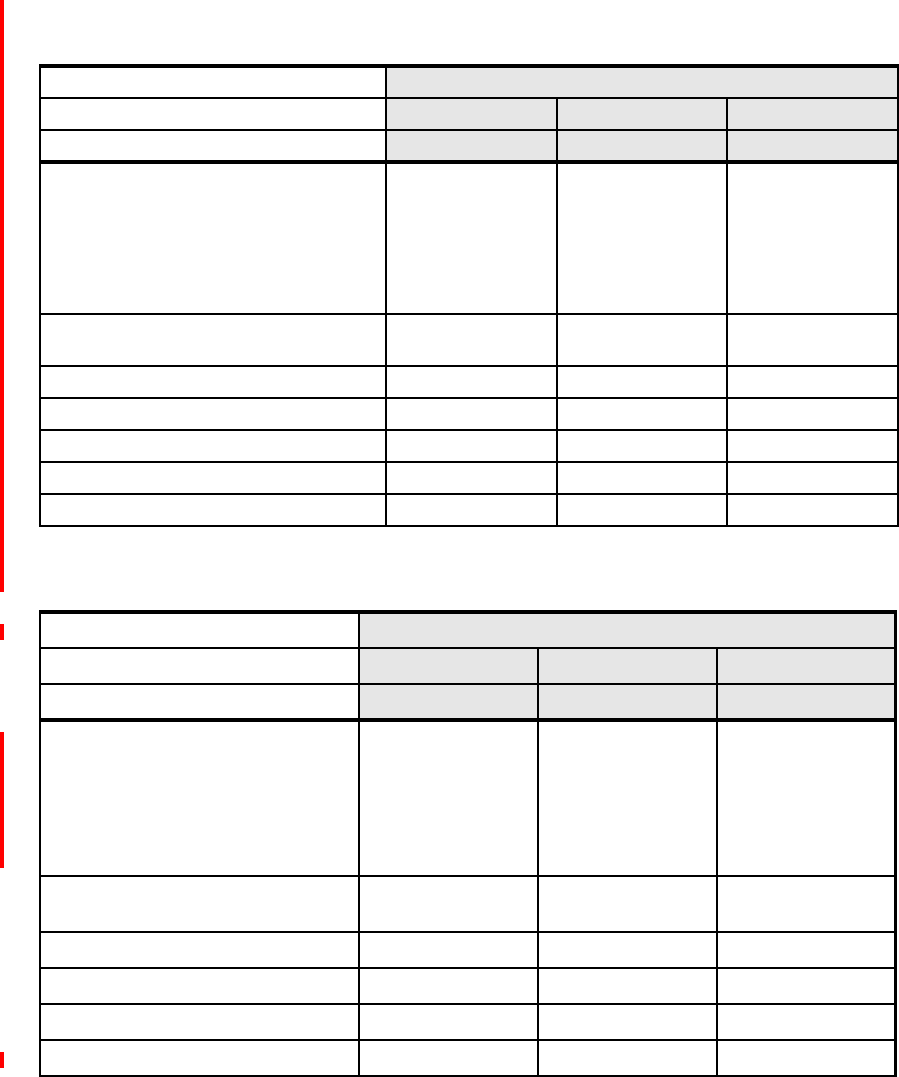
AS/400, AS/400e, and iSeries model summary 367
9406 Model 870
9406 Model 890
Model 870
Processor feature #2486 #2489 #2496
Server feature #0886 #0889 #0891
Relative system performance
Processor CPW
5250 CPW
Standard
Enterprise
High Availability
Capacity BackUp
11500/20000
0
Maximum
Maximum
--
7700/11500
0
Maximum
Maximum
--
3200/20000
--
0
Maximum
Maximum
Maximum
Number/type/speed of processor 8/16/POWER4/
1.3 GHz
5/8/POWER4/
1.3 GHz
2/16/POWER4/
1.3 GHz
L2 and L3 Cache (MB/processor) 16.72 16.72 16.72
Main storage (GB minimum to maximum) 8 to 128 8 to 64 8 to 128
Main storage cards (minimum/maximum) 2/4 2/2 2/4
Minimum operating system level V5R2 V5R2 V5R2
Software group P40 P40 P40
Model 890
Processor feature #2497 #2498 #2499
Server feature #0897 #0898 #0892
Relative system performance
Processor CPW
5250 CPW
Standard
Enterprise
High Availability
Capacity Backup
20000/29300
0
Maximum
Maximum
-
29300/37400
0
Maximum
Maximum
-
5600/37400
0
-
-
Maximum
Number/type/speed of processor 16/24/POWER4/
1.3 GHz
24/32/POWER4/
1.3 GHz
4/32/POWER4/
1.3 GHz
L2 and L3 Cache (MB/processor) 16.72 16.72 16.72
Main storage (GB minimum to maximum) 8 to 192 16 to 256 16 to 256
Main storage cards (minimum/maximum) 2/6 4/8 4/8
Minimum operating system level V5R2 V5R2 V5R2
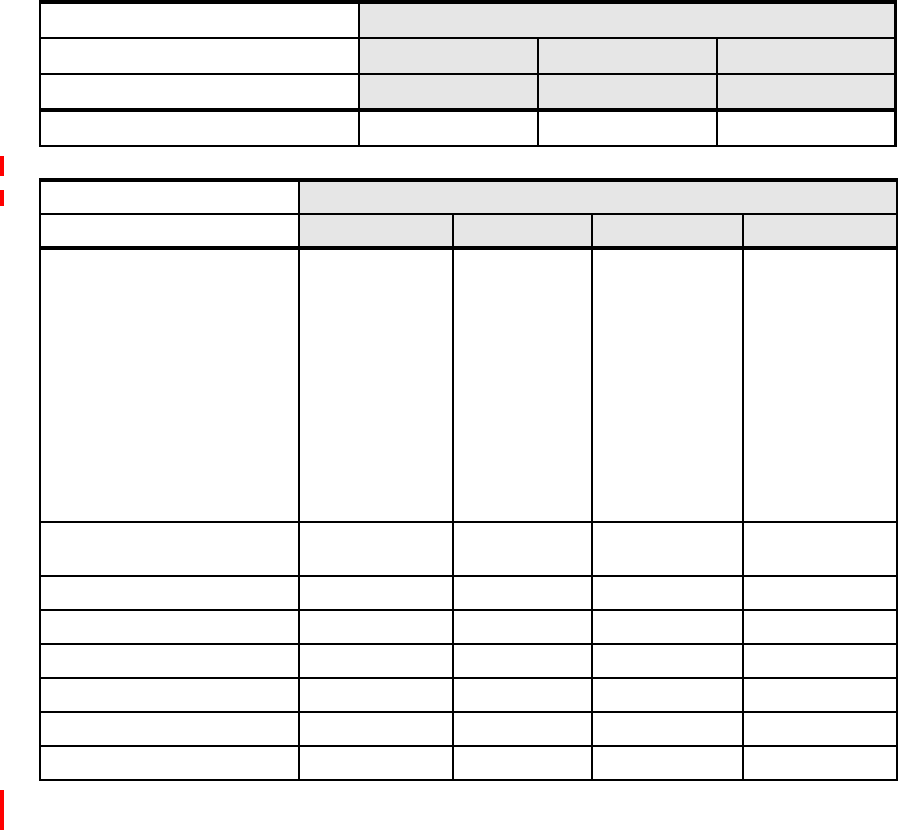
368 i5 Handbook
Software group6e P50 P50 P50
Model 890
Processor feature #0197 #0198 #2487 #2488
Relative system performance1
Processor CPW
5250 CPW5
#1576 (Base)
#1577
#1578
#1579
#1581
#1583
#1585
#1587
#1588
#1591
29300
0
37400
0
20200 - 29300
120
240
560
1050
2000
4550
10000
16500
20200
---
29300 - 37400
120
240
560
1050
2000
4550
10000
16500
20200
37400
Number/type/speed of processor 24/POWER4/
1.3 GHz
32/POWER4/
1.3 GHz
16 - 24/POWER4/
1.3 GHz
24 - 32/POWER4/
1.3 GHz
L2 Cache (MB) 1.5 MB/chip set 1.5 MB/chip set 1.5 MB/chip set 1.5 MB/chip set
L2 and L3 Cache (MB/processor) 16.72 16.72 16.72 16.72
Main storage (GB min-max) 16 - 192 24 - 256 16 - 192 24 - 256
Main storage cards (min/max) 2/6 4/8 2/6 4/8
Minimum operating system level7OS/400 V5R2 OS/400 V5R2 OS/400 V5R2 OS/400 V5R2
Software group6P50 P50 P50-P60 P50-P60
Model 890
Processor feature #2497 #2498 #2499
Server feature #0897 #0898 #0892

© Copyright IBM Corp. 1997 - 2006. All rights reserved. 369
Appendix A. Referenced lists
This appendix accommodates lists and details that are considered pertinent to
you, as referred to within the context of this publication. The details are presented
in this appendix to improve the readability of the base information.
A
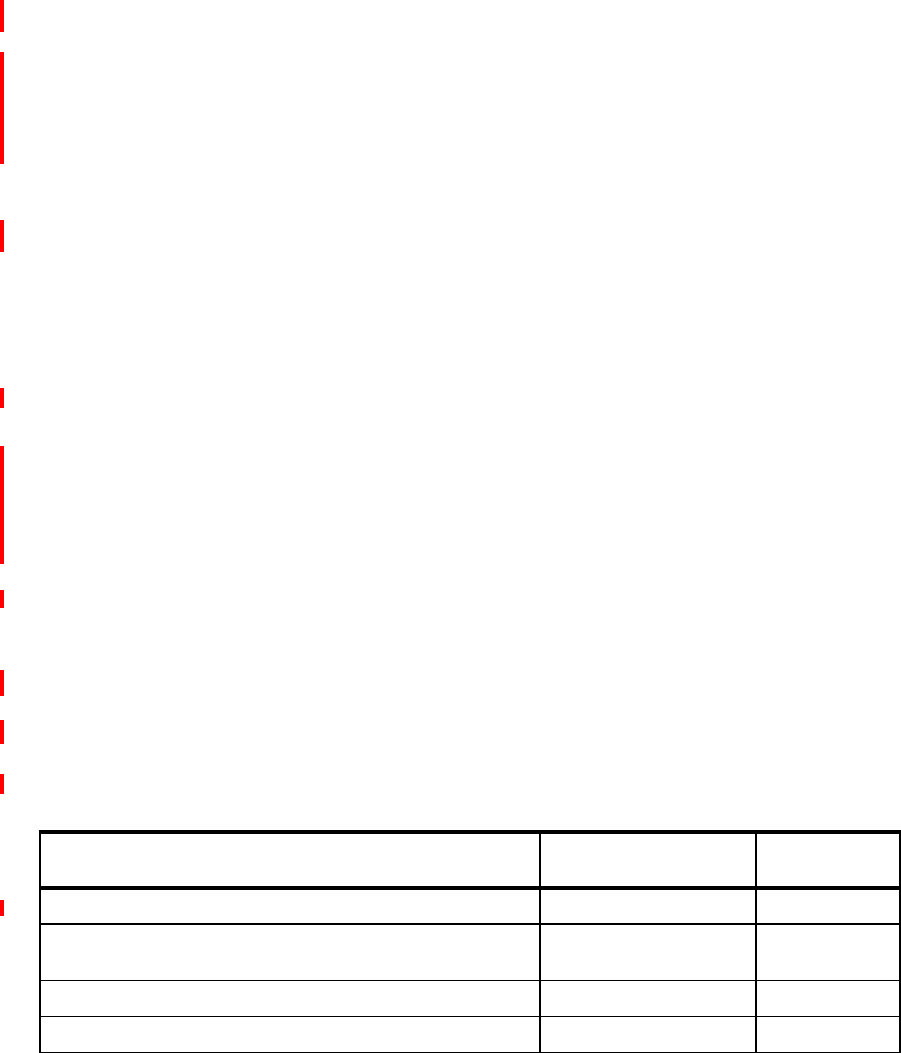
370 i5 Handbook
Options included in OS/400 and i5/OS
To view all the options of OS/400 and other programs then the manual “Install,
Upgrade or Delete i5/OS and Related Software” (SC41-5120-08) should be
referred to. It can be found in the Information Center at:
http://publib.boulder.ibm.com/iseries/
Products and features no longer marketed by IBM
As products and features are withdrawn from marketing, they are removed from
the published edition of the handbook. The tables in this section identify such
products.
The currently available features are listed in this book, which may assist with
providing a replacement. Refer to the iSeries Upgrade Planning Web site for
further information:
http://www-03.ibm.com/servers/eserver/support/iseries/planning/upgrade/
You can find alternate solutions for features no longer supported at V5R3 and
V5R4 (and earlier releases) on the Web at:
http://www-03.ibm.com/servers/eserver/support/iseries/planning/upgrade/v5r3/ind
ex.html
http://www-03.ibm.com/servers/eserver/support/iseries/planning/upgrade/v5r4/ind
ex.html
Hardware no longer marketed by IBM
Hardware withdrawn from marketing
The hardware products and features shown in the following table are now
withdrawn from marketing, along with the recommended replacement.
Product or feature Withdrawal date Recommended
replacement
2105 Model B09 Versatile Storage Server™ (VSS) 24 November 1999 2105-800
2105 Models Exx IBM TotalStorage Enterprise Storage Server
(ESS)
29 September 2000 2105-800
2105 Model F10 ESS 22 November 2000 2105-800
2105 Model F20 ESS 31 December 2003 2105-800

Referenced lists 371
2109 Mod S08 S16 SAN Fibre Channel Switch 30 January 2003 3534 Model F08,
2109 Model F16
2422 ½-inch Reel Tape Drive 3580, 3590
2440 Magnetic Tape Subsystem (½-inch Reel Tape Drive) 20 January 1992 3580, 3590
2480 Wireless LAN Access Point (2480-RS0) 13 January 1999 N/A
2480 Wireless LAN Access Point (2480-E00, -EB0, -TR0, -TB0) 24 May 1999 N/A
2482 AS/400 Wireless Portable Transaction Computer (PTC) 24 May 1999 N/A
2483 Integrated Laser PTC for AS/400 Wireless Network 24 May 1999 N/A
2484 Industrial PTC for AS/400 Wireless Network 24 May 1999 N/A
2486 IBM PTC 24 May 1999 N/A
3430 Magnetic Tape Subsystem (½-in. Reel Tape Drive) 19 December 1989 3580, 3590
3490E Models F00 F01, F11, F1A, FC0 Magnetic Tape 28 June 2002 3580, 3590
3494 - L10, D10 IBM TotalStorage Enterprise Tape Library 27 December 2002 3494 L12, D12
3499 All Model Media 26 December 2003 N/A
3534 Model 1RU SAN Fibre Channel Managed Hub 14 February 2003 3534-F08
3570 Models Bxx Magstar® MP (Multi-Purpose) Tape Library 31 December 1999 3580. 3581,
3582
3570 Models Cxx Magstar MP (Multi-Purpose) Tape Library 27 December 2002 3580, 3581,
3582
3575 Models Lxx Magstar MP (Multi-Purpose) Tape Library
Dataserver
28 June 2002 3583, 3584
3583-Lxx Ultrium Scalable Tape Library
Models L18, L36, L72
announced to be withdrawn
27 January 2006
3576-L5B
3584-D42 UltraScalable Tape Library 25 April 2003 N/A
3995 Models A43, 043 143, 042, 142 Optical library 06 December 1996 3995 C40, C42,
C44, C48
3995 Models C20, C22, C24, C26, C28 Optical Library, LAN
attached
31 January 2002 N/A
5308 ASCII to 5250 Connection 21 December 1999 N/A
5494 Remote Control Unit 21 December 1999 N/A
5500 Express IP Control Unit 21 December 1999 N/A
Product or feature Withdrawal date Recommended
replacement

372 i5 Handbook
6299 Midrange Hub 01 September 1999 N/A
7210-020 External CD ROM 29 June 2001 7210-025
7208-342 External 8mm Tape Drive 27 June 2003 7208-345
7208-345 60 GB External 8mm Tape Drive 31 March 2005
7315-CR2 Hardware Management Console 29 April 2005
7852-40Z AS/400 Data/Fax Modem V.34 12 March 2002 #0032 Modem
7852-400 External V.34 Data/Fax Modem 01 November 2003 #0032 Modem
8361 -100 Network Station® series 100 Ethernet 14 October 1999 Neoware Eon
Thin Client
8361 - 200 Network Station series 100 Token-Ring 14 October 1999 Neoware Eon
Thin Client
8361 - 210 Network Station series 300 Token-Ring 31 December 1999 Neoware Eon
Thin Client
8361 - 341 Network Station series 300 Twinax 31 December 1999 Neoware Eon
Thin Client
9309 1.6m Rack Enclosure 01 October 2002 #0551 iSeries
To we r
9347 Tape drive 31 October 2000 3580
9348 Magnetic tape device 26 February 1999 3580
Model 150 - System and features 31 October 2000 Model 520
Model 236 - Model upgrades from Model 236 to Model 436 25 February 2000 N/A
Model 436 Processor upgrades within the Model 436 25 February 2000 N/A
Model 170 - All models 31 May 2002 Model 520
Model 170 - All processor upgrades 28 December 2001 Model 520
Model 250- All models 16 June 2004 Model 520
Model 270 - All models, new model sales 21 November 2003 Model 520
Model 4xx - Model upgrades from 4xx to 7xx 30 June 2000 N/A
Model 5xx - Model upgrades from 5xx to 7xx 30 June 2000 N/A
Model 6xx - Model 600, 620, 640, and 650 31 May 1999 Model 520
Model 6xx - Model upgrades from 6xx to 6xx and processor feature
conversions within 6xx models
31 May 2000 N/A
Product or feature Withdrawal date Recommended
replacement

Referenced lists 373
Model 6xx/Sxx - Model upgrades from 6xx/Sxx to 7xx/8xx 28 September 2001 N/A
Model 7xx - All models, new model sales
Model 720
Model 730
Model 740
28 December 2001
Model 520
Model 520, 550
Model 550, 570
Model 7xx to 7xx model upgrades 28 December 2001 N/A
Model 7xx - Processor and interactive feature upgrades within 7xx
models
02 July 2002 N/A
Model 7xx to 820, 830, 840 model upgrades 08 October 2003
Models 800, 810, 825, 870, and 890 01 October 2005
Model 820 - #2396, #2397, #2398, #2425, #2426, and #2427 Model
820 processors
21 November 2003 Model 520, 550
Model 830 - #2402 and #2403 Model 830 processors 21 November 2003 Model 550, 570
Model 840 - #2416, #2417, #2418, #2419, #2420, and #2461 Model
840 processors
21 November 2003 Model 570
Model 890 - #0197, #0198, #2487, and #2488 Model 890 processors 07 May 2003 Model 570, 595
Model SB1 System 29 December 2000 Model 550, 570
Model SB2 System 03 December 2002 Model 550, 570
Model SB3 System 03 December 2002 Model 570
Model Sxx - Model S10, S20, S30, S40 31 May 1999 Model 520, 550
Model Sxx - Model upgrades from Sxx to Sxx and processor feature
conversions within Sxx
31 May 2000 N/A
Model Sxx - Model upgrades from Sxx to 7xx/8xx 28 September 2001 N/A
#0001 - MES Bulk Order 02 July 2002 N/A
#0018 - 2440-xxx Local Source Rack Mount 30 June 2000 N/A
#0029 - 9347-xx Local Source Rack Mount 31 October 2000 N/A
#0034 - Red Covers 31 October 2000 N/A
#0046 - OptiConnect system 28 December 2001 N/A
#0059 - Transition Data Link 31 May 2000 N/A
#0086 - Optimize 3590 Performance 31 May 1999 N/A
#0088 - OptiConnect Cluster Specify 28 December 2001 N/A
Product or feature Withdrawal date Recommended
replacement

374 i5 Handbook
#0123 - #5074 Lower Unit in Rack 03 December 2002 N/A
#0134 Field Install in Rack (HD) 03 November 2003
#0150 - 820 Base Processor 21 November 2003 Model 520, 550
#0151 - 820 Base Processor 01 October 2004 Model 520, 550
#0152 - 820 Base Processor 01 October 2004 Model 520, 550
#0153 - 830 8-way Processor 21 November 2003 Model 550, 570
#0158 - 840 12-way Processor 21 November 2003 Model 570
#0159 - 840 24-way Processor 21 November 2003 Model 570
#0185 - Performance Enhancement Model 150 31 October 2000 N/A
#0197 - Model 890 24-way processor 07 May 2003 Model 595
#0198 - Model 890 24-way processor 07 May 2003 Model 595
#0121 - 270 Lower Unit in a Rack 21 November 2003 N/A
#0122 - 270 Upper Unit in a Rack 21 November 2003 N/A
#0202 - Staged Upgrade Offering 31 May 1999 N/A
#0203 - Side-by-Side Install 02 July 2002 N/A
#0204 - Staged Side-by-Side Upgrade 31 May 1999 N/A
#0205 RISC-to-RISC Data Migration 1 April 2005
#0220 - Token ring on IPCS 1 December 2005 #0223
#0221 - Ethernet on IPCS 1 December 2005 #0224, #0225
#0295 - Performance Enhancement/28WS 31 October 2000 N/A
#0297 - Model 250 Package 16 June 2004 Model 520
#0298 - Model 250 Package 16 June 2004 Model 520
#0328 - Operations Console Cable 21 November 2003 #0367
#0349 V.24/EIA232 50-ft./15m PCI cable 02 December 2002
#0362 - 20-ft. Communications Console Cable 31 January 2001 #0367
#0366 - Optical Bus Cable 20m 28 December 2001 N/A
#0380, #0381 Remote Control Panel Cable, #0382 Remote Control
Panel Cable
02 July 2002 Virtual Control
Panel, see Info
APAR II13117
Product or feature Withdrawal date Recommended
replacement

Referenced lists 375
#0398 - Operations Console Package 02 July 2002 #9771
#0399 - 4 Port Twinaxial Expansion 30 June 2000 N/A
#0399 - Model 150 4 port Twinaxial Expansion 31 May 2000 N/A
#0578 PCI Expansion Unit in Rack 01 October 2004 N/A
#0588 PCI-X Expansion Unit in Rack announced to be withdrawn
1 June 2006
#0591 - Entry Twinaxial Package V4R4 (type 9401) 31 October 2000 Model 520
#0592 - Growth Twinaxial Package V4R4 (type 9401) 31 October 2000 Model 520
#0593 - Entry Server Package V4R4 (type 9401) 31 October 2000 Model 520
#0594 - Growth Server Package V4R4 (type 9401) 31 October 2000 Model 520
#0601 Direct Attach #2743 PCI 1 Gbps Ethernet IOA 01 October 2004 #0620
#0602 Direct Attach #2760 PCI 1 Gbps Ethernet UTP IOA 01 October 2004 #0621
#0604 Direct Attach #2763 PCI RAID Disk Unit Controller
Conversions to feature remain available.
21 November 2003 #0618
#0605 Direct Attach #4748 PCI RAID Disk Unit Controller
Conversions to feature remain available.
02 July 2002 #0606
#0606 Direct Attach #4778 PCI RAID Disk Unit Controller
Conversions to feature remain available.
l19 November 2004 #0618
#0618 Direct Attach #2757 PCI-X Ultra RAID Disk Controller 01 June 2006 #0627
#0628 Direct Attach #5703 PCI-X RAID Disk Unit Controller 01 June 2006 #0648
#0645 Direct Attach #5712 PCI-X Tape/DASD Controller 01 June 2006 #0647
#1312 - 1-Byte 1.03 GB Disk Unit Kit 31 October 2000 N/A
#1313 - 1-Byte 1.96 GB Disk Unit Kit 31 October 2000 N/A
#1322 - 2-Byte 1.03 GB Disk Unit Kit 31 October 2000 N/A
#1323 - 2-Byte 1.96 GB Disk Unit Kit 31 October 2000 N/A
#1325 - 2-Byte 1.03 GB Disk Unit Kit 31 October 2000 N/A
#1326 - 2-Byte 1.96 GB Disk Unit Kit 31 October 2000 N/A
#1327 - 2-Byte 4.19 GB Disk Unit Kit 31 October 2000 N/A
#1333 - 2-Byte 8.58 GB Disk Unit Kit 31 October 2000 N/A
#1334 - 2-Byte 17.54 GB Disk Unit Kit 31 October 2000 N/A
Product or feature Withdrawal date Recommended
replacement

376 i5 Handbook
#1336 - 2-Byte 1.96 GB Disk Unit Kit 31 October 2000 N/A
#1337 - 2-Byte 4.19 GB Disk Unit Kit 31 October 2000 N/A
#1349 - 1.2 GB ¼-inch Tape Kit 31 October 2000 #4582
#1350 - 2.5 GB ¼-inch Tape Kit 31 October 2000 #4582
#1355 - 13.0 GB ¼-inch Tape Kit 31 October 2000 #4583
#1360 7.0 GB 8mm Cartridge Tape Kit 31 October 2000 7208-345 8mm
#1471 30m Optical HSL Cable 21 November 2003 #1472
#1490 to #1496 - Interactive Capacity Specify 02 July 2002 Enterprise
Edition iSeries
#1500 to #1514 - Interactive Capacity Cards 02 July 2002 Enterprise
Edition iSeries
#1517 to #1527, #1531 to #1547 - Interactive Capacity Cards 01 October 2004 Enterprise
Edition iSeries
#1576 - Interactive Capacity Card 21 November 2004 Enterprise
Edition iSeries
#1577 to #1578 - Interactive Capacity Card 01 October 2004 Enterprise
Edition iSeries
#1579, #1581, #1583, #1585, #1587, #1591 - Interactive Capacity
Card
21 November 2003 Enterprise
Edition iSeries
#2061 - Model 720 Processor 28 December 2001 Model 520
#2062 - Model 720 Processor 02 July 2002 Model 520
#2063 - Model 720 2-way Processor 02 July 2002 Model 520
#2064 - Model 720 4-way Processor 02 July 2002 Model 520
#2065 - Model 730 Processor 28 December 2001 Model 520, 550
#2066 - Model 730 2-way Processor 02 July 2002 Model 520, 550
#2067 - Model 730 4-way Processor 02 July 2002 Model 520, 550
#2068 - Model 730 8-way Processor 02 July 2002 Model 520, 550
#2069 - Model 740 Processor 28 December 2001 Model 570
#2070 - Model 740 12-way Processor 02 July 2002 Model 570
#2159 - Model 170 Processor February 2000 Model 520
#2248 - Model 270 Processor 21 November 2003 Model 520
Product or feature Withdrawal date Recommended
replacement

Referenced lists 377
#2250 - Model 270 Processor 03 December 2002 Model 520
#2252 - Model 270 Processor 03 December 2002 Model 520
#2253 - Model 270 2-way Processor 03 December 2002 Model 520
#2289 - Model 170 Processor 31 May 2002 Model 520
#2295 - Model 250 Processor 02 July 2002 Model 520
#2296 - Model 250 Processor 02 July 2002 Model 520
#2310 - Model SB1 8-way Processor 25 July 2000 Model 550, 570
#2311 - Model SB1 12-way Processor 25 July 2000 Model 550, 570
#2312 - Model SB1 8-way Processor 25 July 2000 Model 550, 570
#2313 - Model SB1 12-way Processor 25 July 2000 Model 550, 570
#2315 - Model SB2 8-way Processor 03 December 2002 Model 550, 570
#2316 - Model SB3 12-way Processor 03 December 2002 Model 570
#2318 - Model SB3 24-way Processor 03 December 2002 Model 570
#2349 - Model 830 4/8-way Processor 01 October 2004 Model 550, 570
#2351 Model 830 1/8-way (POD) 21 November 2003 Model 550, 570
#2352 Model 840 8/12-way (POD) 21 November 2003 Model 570
#2353 Model 840 12/18-way 01 October 2004 Model 570
#2354 Model 840 18/24-way 01 October 2004 Model 570
#2395 Model 820 Processor 21 November 2003 Model 520, 550
#2396 Model 820 Processor 03 December 2002 Model 520, 550
#2397 Model 820 2-way Processor 03 December 2002 Model 520, 550
#2398 Model 820 4-way Processor 03 December 2002 Model 520, 550
#2400 Model 830 2-way Processor 21 November 2003 Model 550, 570
#2402 Model 830 4-way Processor 03 December 2002 Model 550 570
#2403 Model 830 8-way Processor 03 December 2002 Model 550, 570
#2407 Model 170 Dedicated Domino Processor 31 May 2002 Model 520
#2416 Model 840 8/12-way 03 December 2002 Model 570
#2417 Model 840 12/18-way 03 December 2002 Model 570
Product or feature Withdrawal date Recommended
replacement

378 i5 Handbook
#2418 Model 840 12-way Processor 03 December 2002 Model 570
#2419 Model 840 18/24-way 03 December 2002 Model 570
#2420 Model 840 24-way Processor 03 December 2002 Model 570
#2422 Dedicated Domino Processor 03 December 2002 Model 520
#2423 Dedicated Domino Processor 03 December 2002 Model 520
#2424 Dedicated Domino 2-way Processor 03 December 2002 Model 520
#2425 Dedicated Domino Processor 03 December 2002 Model
#2426 Dedicated Domino 2-way Processor 03 December 2002 Model
#2427 Dedicated Domino 4-way Processor 03 December 2002 Model
#2431 9406 Model 270 Processor 01 October 2004 Model 520
#2432 9406 Model 270 Processor 01 October 2004 Model 520
#2434 9406 Model 270 Processor 01 October 2004 Model 520
#2435 9406 820 Processor 01 October 2004 Model 520, 550
#2436 9406 820 Processor 01 October 2004 Model 520, 550
#2437 9406 820 2-way Processor 01 October 2004 Model 520, 550
#2438 9406 820 4-way Processor 01 October 2004 Model 520, 550
#2452 9406 Model 270 Processor 01 October 2004 Model 520
#2454 9406 Model 270 Processor 01 October 2004 Model 520
#2461 9406 Model 840 24-way Processor 03 December 2002 Model 570
#2487 Model 890 16/24-way Processor 07 May 2003 Model 570, 595
#2488 Model 890 24/32-way Processor 07 May 2003 Model 595
#2605 ISDN Basic Rate Interface Adapter 31 December 1999 #2742
#2609 EIA 232/V.24 Two-Line Adapter 31 March 1999 #2742
#2610 EIA 232/V.24 Two-Line Adapter 31 March 1999 #2742, #2772,
#2773, #2805,
#2806
#2612 EIA 232/V.24 One-Line Adapter 31 March 1999 #2742, #2793,
#2794
#2613 V.35 One-Line Adapter 31 March 1999 #2742, #2793,
#2794
Product or feature Withdrawal date Recommended
replacement

Referenced lists 379
#2614 X.21 One-Line Interface Adapter 31 March 1999 #2742, #2793,
#2794
#2617 Ethernet/IEEE 802.3 Adapter/HP 31 March 1999 #2744, #2849,
#4838, #5700,
#5701, #5706,
#5707
#2618 Fiber Distributed Data Interface Adapter 31 August 1998 N/A
#2619 LAN/WAN/Workstation IOA 31 March 1999 #2744
#2620 Full Cryptographic Processor 31 December 1999 #4801
#2621 Storage Device Controller 30 June 2000 #5702, #2749
#2623 Six-Line Communications Controller 31 December 1999 #2742
#2624 Storage Device Controller 28 December 2001 N/A
#2626 16/4 Mbps Token Ring Adapter/A 01 July 1997 #2744
#2628 Limited Cryptographic Processor 31 December 1999 #4801
#2629 LAN/WAN/Workstation IOP 31 May 2002 #2844
#2644 Magnetic Tape Attachment Card/HP 31 March 1999 #2749
#2654 EIA 232/V.24 Two-Line IOA 31 August 1998 #2742
#2655 EIA 232/V.24 20 31 August 1998 #2742
#2656 X.21 Two line 20 31 August 1998 #2742
#2657 EIA 232/V.24 50E 31 August 1998 #2742
#2658 EIA 232/V.24 50 31 August 1998 #2742
#2659 X.21 Two line 50 31 August 1998 #2742
#2664 Integrated Fax Adapter 31 December 1999 #2742 with
#0032
#2665 Copper distributed data interface 31 August 1998 #2849, #2744,
#5701
#2666 High-Speed Communications Adapter #2742
#2668 Wireless LAN Adapter 31 August 1998 N/A
#2669 Shared bus interface card 28 December 2001 N/A
#2673 Optical Bus Adapter 30 June 2000 N/A
#2674 Optical Bus Adapter 30 June 2000 N/A
Product or feature Withdrawal date Recommended
replacement

380 i5 Handbook
#2680 Optical bus receiver - 266 Mbps 28 December 2001 N/A
#2683 266 Mbps OptiConnect receiver 28 December 2001 N/A
#2685 1063 Mbps OptiConnect receiver 28 December 2001 #2792
#2686 Optical Link Processor 28 December 2001 #2842, #2843
#2688 Optical Link Processor 01 October 2004 #2842, #2843
#2695 Optical Bus Adapter 01 October 2004 N/A
#2699 Two-Line WAN IOA 28 December 2001 N/A
#2718 PCI Magnetic Media Controller 02 July 2002 #5702
#2720 Base PCI WAN/Twinaxial IOA 02 July 2002 #4746 and
#2742
#2721 PCI Two-Line WAN IOA 31 October 2000 #2742
#2722 Twinaxial Workstation IOA 31 July 2001 #4746
#2723 PCI Ethernet IOA 28 December 2001 #2849, #4838,
#5701, #5706
#2724 PCI 16/4 Mbps Token Ring IOA 31 July 2001 #2744
#2726 PCI RAID Disk Unit Controller 30 June 2000 #2757
#2729 PCI Magnetic Media Controller 02 July 2002 #2749
#2730 Programmable Regulator 01 October 2004 N/A
#2738 HSL ports - 8 copper 07 May 2003 N/A
#2740 PCI RAID Disk Unit Controller 31 May 2002 #2757
#2741 PCI RAID Disk Unit Controller 31 May 2002 #2757
#2743 1 Gbps PCI Ethernet IOA 16 June 2004 #5700, #5701,
#5707
#2744 PCI 100 Mbps Token Ring IOA announced to be withdrawn
1 June 2006
#2745 PCI Two-Line WAN IOA 01 October 2004 #2742
#2746 PCI Twinaxial Workstation IOA 01 October 2004 #4746
#2748 PCI RAID Disk Unit Controller 08 July 2003 #2757
#2749 PCI Ultra Magnetic Media Controller 01 October 2004 -->
3 March 2005
N/A
Product or feature Withdrawal date Recommended
replacement

Referenced lists 381
#2757 PCI-X Ultra RAID Disk Controller 01 June 2006 #2780
#2760 PCI 1 Gbps Ethernet UTP Adapter 01 October 2004 #5701, #5706
#2761 Integrated Analog Modem 02 July 2002 #2772, #2773
#2763 PCI RAID Disk Unit Controller 21 November 2003 #5703
#2766 PCI Fibre Channel Disk Controller 01 October 2004 #2787
#2768 PCI Magnetic Media Controller 01 October 2004 #5702
#2772 PCI Dual WAN/Modem IOA 01 June 2006
#2778 PCI RAID Disk Unit Controller 01 October 2004 #2757
#2782 PCI-X RAID Disk Unit Controller 01 January 2004 #5703
#2787 PCI-X Fibre Channel Disk Controller 01 June 2006 #5760
#2790 PCI Integrated Netfinity Server 31 May 2002 #4810
#2791 PCI Integrated xSeries Server 03 December 2002 #4810
#2792 PCI Integrated xSeries Server 1 January 2004
#2795 - 128 MB server memory 19 November 2004
#2796 - 256 MB Server IOP Memory 19 November 2004
#2799 PCI Integrated xSeries Server 21 November 2003 #4810
#2809 PCI LAN/WAN/Workstation IOP 31 May 2002 #2844
#2810 LAN/WAN IOP 31 May 2002 #2844
#2811 PCI 25 Mbps UTP ATM IOA 31 May 1999 N/A
#2812 PCI 45 Mbps Coax T3/DS3 ATM IOA 31 May 1999 N/A
#2815 PCI 155 Mbps UTP OC3 ATM IOA 31 May 2002 #2849, #4838,
#5700, #5701,
#5706, #5707
#2816 PCI 155 Mbps MMF ATM IOA 28 December 2001 #2849, #4838,
#5700, #5701,
#5706, #5707
#2817 PCI 155 Mbps MMF ATM IOA 03 December 2002 #2849, #4838,
#5700, #5701,
#5706, #5707
#2818 PCI 155 Mbps SMF OC3 ATM IOA 31 May 2002 #2849, #4838,
#5700, #5701,
#5706, #5707
Product or feature Withdrawal date Recommended
replacement

382 i5 Handbook
#2819 PCI 34 Mbps Coax E3 ATM IOA 31 May 1999 N/A
#2824 PCI Feature Controller 28 December 2001 N/A
#2838 PCI 100/10 Mbps Ethernet IOA 21 November 2003 #2849, #4838,
#5701, #5706
#2842 PCI IOP 21 November 2003 #2844
#2843 PCI IOP 01 October 2004 #2844
#2849 10/100 Mbps Ethernet Adapter announced to be withdrawn
1 June 2006
#5700 PCI 1
Gbps Ethernet
IOA
#2850 Integrated PC Server 31 March 1999 #4710, #4810
#2851 Integrated PC Server 31 March 1999 #4710, #4810
#2852 Integrated PC Server 30 June 2000 #4710, #4810
#2854 PCI Integrated PC Server 31 May 1999 #4710, #4810
#2857 Integrated PC Server 31 May 1999 #4710, #4810
#2858 FSIOA 128 MB memory, keyboard and mouse 30 June 2000 N/A
#2860 Integrated PC Server Memory 31 March 1999 N/A
#2861 32 MB IOP memory 28 December 2001
#2862 128 MB IOP memory 28 December 2001 N/A
#2865 PCI Integrated Netfinity Server 02 July 2002 N/A
#2866 PCI Integrated Netfinity Server 02 July 2002 N/A
#2867 - 256 MB IOP memory 02 July 2002 N/A
#2868 Integrated Netfinity Server 31 October 2000 N/A
#2890 PCI Integrated Netfinity Server 31 May 2002 N/A
#2891 PCI Integrated xSeries Server 03 December 2002 N/A
#2892 PCI Integrated xSeries Server 01 January 2004 N/A
#2895 - 128 MB server memory 19 November 2004
#2896 - 256 MB server memory 19 November 2004
#2899 PCI Integrated xSeries Server 21 November 2003 N/A
#3000, #3002, #3004, #3006, #3007, #3009 Memory features
(various)
01 October 2004 #3614
Product or feature Withdrawal date Recommended
replacement

Referenced lists 383
#3001, #3003, #3005 Memory features 31 May 2002 #3612
#3032 to #3034 Memory features 01 October 2004 #3613
#3025 512 MB main storage 03 December 2002 N/A
#3065 512 MB main storage 03 December 2002 N/A
#3103 32 MB main storage 31 March 1999 N/A
#3104 64 MB main storage 31 March 1999 N/A
#3110 64 MB main storage 30 March 2001 N/A
#3117, #3120, #3121 8 MB main storage 31 March 1999 N/A
#3118 16 MB main storage 31 March 1999 N/A
#3122 32 MB main storage 31 March 1999 N/A
#3133 64 MB main storage 31 March 1999 N/A
#3134 128 MB main storage 31 March 1999 N/A
#3135 256 MB main storage 31 March 1999 N/A
#3136 256 MB main storage 31 March 1999 N/A
#3138 64 MB main storage 31 March 1999 N/A
#3144 8 MB main storage 31 March 1999 N/A
#3145 16 MB main storage 31 March 1999 N/A
#3146 32 MB main storage 31 March 1999 N/A
#3147 32 MB main storage 31 March 1999 N/A
#3149 128 MB main storage 31 March 1999 N/A
#3172 32 MB main storage (two SIMMS) 31 March 1999 N/A
#3179 256 MB main storage 03 December 2002 N/A
#3180 512 MB main storage 03 December 2002 N/A
#3182 32 MB main storage 31 May 2002 N/A
#3189 128 MB main storage 03 December 2002 N/A
#3190 256 MB main storage 03 December 2002 N/A
#3191 512 MB main storage 03 December 2002 N/A
#3192 1024 MB main storage 03 December 2002 N/A
Product or feature Withdrawal date Recommended
replacement

384 i5 Handbook
#3193 2048 MB main storage 03 December 2002 N/A
#3195 4096 MB main storage 03 December 2002 N/A
#3197 1024 MB main storage 03 December 2002 N/A
#3198 2048 MB main storage 03 December 2002 N/A
#4308 4.19 GB disk unit 29 December 2000 #4326
#4314 8.58 GB Disk Unit 23 October 2000 #4326
#4317 8.58 GB 10k RPM Disk Unit
Feature conversions remain available 03 December 2002
#4326
#4318 17.54 GB 10k RPM Disk Unit 01 June 2004 #4326
#4324 17.54 GB Disk Unit 23 October 2000 #4326
#4425 CD-ROM 21 November 2003 #4625
#4430 DVD-RAM 01 January 2004 #4630
#4482 4GB ¼-inch Cartridge Tape Device 01 January 2004 #4682
#4483 16 GB ¼-inch Cartridge Tape Device 03 December 2002 #4684
#4486 25 GB ¼-inch Cartridge Tape Device 03 December 2002 #4684
#4487 50 GB ¼-inch Cartridge Tape Device 01 January 2004 #4687
#4525 CD-ROM 21 November 2003 #4625
#4582 4 GB ¼-inch Cartridge Tape Device 01 October 2005 #4584
#4583 16 GB ¼-inch Cartridge Tape Device 03 December 2002 #4584
#4584 30 GB ¼-inch Cartridge Tape Device 01 June 2006
#4586 25 GB ¼-inch Cartridge Tape Device 03 December 2002 #4584
#4625 CD-ROM 15 July 2005
#4682 4 GB ¼-inch Cartridge Tape Device 1 October 2005 #4684
#4710 PCI Integrated xSeries Server 01 June 2006 #4812
#4723 PCI 10 Mbps Ethernet Adapter 28 December 2001 #2849, #4838,
#5701, #5706
#4748 PCI RAID Disk Unit Controller
Feature conversions remain available
21 November 2003 #2757
#4761 PCI Integrated Analog Modem 02 July 2002 #2772, #2773,
#2805 or #2806
Product or feature Withdrawal date Recommended
replacement

Referenced lists 385
#4800 PCI Cryptographic Processor 29 December 2000 #4801
#4801 PCI Cryptographic Coprocessor announced to be withdrawn
1 June 2006
#4806
#4802 PCI Cryptographic Processor 21 November 2003 #4801
#4810 PCI Integrated xSeries Server announced to be withdrawn
1 June 2006
#4812
#4815 PCI ATM 155 Mbps UTP OC3 28 December 2001 #2849, #4838,
#5700, #5701,
#5706, #5707
#4816 PCI ATM 155 Mbps MMF 28 December 2001 #2849, #4838,
#5700, #5701,
#5706, #5707
#4818 PCI ATM 155 Mbps SMF OC3 28 December 2001 #2849, #4838,
#5700, #5701,
#5706, #5707
#5033 Migration Tower I 07 May 2003 N/A
#5034 Migration Tower I 21 November 2003 N/A
#5035 Migration Tower I 21 November 2003 N/A
#5043 Convert primary rack to secondary rack 31 March 1999 N/A
#5044 System Unit Expansion Rack 31 March 1999 #5094, #5294
#5051 Storage Expansion Unit for System Unit 30 June 2000 #5108, #7127
#5052 Storage Expansion Unit 31 May 2002 #5108, #7127
#5055 Storage Expansion Unit 31 May 2002 #5108, #7127
#5057 Storage Expansion Unit
Feature conversions remain available
02 July 2002 #5108, #7127
#5058 Storage Expansion Unit 31 May 2002 #5108, #7127
#5062 OptiConnect in tower 28 December 2001 N/A
#5063 OptiConnect in system unit tower 28 December 2001 N/A
#5064 System Unit Expansion 28 December 2001 N/A
#5065 Storage/PCI Expansion Tower 21 November 2003 #5094
#5066 1.8 M I/O Tower 21 November 2003 #5294
#5070 266 Mbps System Unit Expansion Tower 30 June 2000 #5088, #0588
Product or feature Withdrawal date Recommended
replacement

386 i5 Handbook
#5071 266 Mbps System Unit Expansion Tower 02 July 2002 #5088, #0588
#5073 1063 Mbps System Unit Expansion Tower 28 December 2001 #5088, #0588
#5074 PCI Expansion Tower 01 October 2005 #5094
#5075 PCI Expansion Tower 21 November 2003 #5095 / #0595
#5079 1.8 M I/O Tower 01 October 2005 #5294 1.8m I/O
To we r
#5080 266 Mbps Storage Expansion Tower 30 June 2000 #5088, #0588
#5081 266 Mbps Storage Expansion Tower 02 July 2002 #5094 with
#5108
#5082 Storage Expansion Tower 30 June 2000 #5094 with
#5108
#5083 Storage Expansion Tower 28 December 2001 #5094 with
#5108
#5088 PCI-X Expansion Unit announced to be withdrawn
1 June 2006
#5097 1.8m I/O Tower 01 October 2005
#5117 30 Disk Expansion with Dual Line Cord 07 May 2003
#5135 Feature Power Supply 30 June 2000 N/A
#5143 Power Supply 02 July 2002 N/A
#5150 Battery Backup 20 November 2001 N/A
02 July 2002 N/A
#5151 Power Supply 02 July 2002 N/A
#5153 Redundant Power Supplies 02 July 2002 N/A
#5155 Redundant Power and Cooling 01 October 2004 N/A
#5157 Feature Power Supply 01 October 2004 N/A
#5518 Alt IPL Spec 13 GB Tape 31 October 2000 N/A
#5543 Sys Console on comm 29 December 2000 N/A
#5546 System Console on 100 Mbps Token Ring 01 June 2006
#5554 Mirror 35GB Disk/Controller Package 25 October 2005 #5555
#5601 OptiConnect in Rack 28 December 2001 N/A
Product or feature Withdrawal date Recommended
replacement

Referenced lists 387
#5702 PCI-X Ultra Tape Controller 1 June 2006 #5712
#5703 PCI-X RAID Disk Unit Controller 1 June 2006 #5737
#5704 PCI-X Fibre Channel Tape Controller 1 June 2006 #5761
#5705 PCI-X Tape/DASD Controller 1 June 2006 #5715
#5709 RAID Enabler Card 1 June 2006 #5727
#5712 PCI-X Tape/DASD Controller 1 June 2006 #5736
#5715 PCI-X Tape/DASD Controller 1 June 2006 #5736
#5726 RAID Enabler Card 1 June 2006 #5728
#6134 60 GB 8mm Tape Device 24 June 2004 N/A
#6050 Enhanced Twinaxial Workstation Controller 31 May 2002 #4746
#6140 Twinaxial Workstation Controller 27 March 1998 #4746
#6141 ASCII Workstation Controller 31 March 1999 N/A
#6142 ASCII 12-Port Workstation Attachment 31 March 1999 N/A
#6148 Eight-Port Twinaxial Expansion 30 June 2000 #4746
#6149 16/4 Mbps Token Ring IOA 31 May 2002 #2744
#6151 X.21 One-line adapter 31 August 998 #2742
#6152 EIA 232/V.24 adapter 31 October 1996 #2742
#6153 V.35 One-line adapter 31 August 1998 #2742
#6173 V.35 One-line adapter 50 foot 31 August 1998 #2742
#6180 Twinaxial workstation IOA 31 July 2001 #4746
#6181 Ethernet IOA 31 July 2001 #2849, #4838,
#5701, #5706
#6325 CD-ROM
Feature conversions remain available 02 July 2002
#4525, #4625
#6380 2.5 GB ¼-inch Cartridge Tape Unit 30 June 2000 #4582, #4682
#6381 2.5 GB ¼-inch Cartridge Tape 29 December 2000 #4582, #4682
#6382 4 GB ¼-inch Cartridge Tape Unit 03 December 2002 #4582, #4682
#6383 16 GB ¼-inch Cartridge Tape Unit 03 December 2002 #4583, #4683
#6384 30 GB ¼-inch Cartridge Tape Unit 21 November 2003 #4584, #4684
Product or feature Withdrawal date Recommended
replacement

388 i5 Handbook
#6385 13 GB ¼-inch Cartridge Tape Unit 31 May 2000 #4583, #4683
#6386 25 GB ¼-inch Cartridge Tape Unit 03 December 2002 #4584, #4684
#6425 CD-ROM 02 July 2002 #4525, #4625
#6480 2.5 GB ¼-inch Cartridge Tape Unit 02 July 2002 #4582, #4682
#6481 2.5 GB ¼-inch Cartridge Tape Unit 29 December 2000 #4582, #4682
#6482 4 GB ¼-inch Cartridge Tape Unit 03 December 2002 #4582, #4682
#6483 16 GB ¼-inch Cartridge Tape Unit 03 December 2002 #4583, #4683
#6484 30 GB ¼-inch Cartridge Tape Unit 21 November 2004 #4584, #4684
#6485 13 GB ¼-inch Cartridge Tape Unit 31 May 2000 #4583, #4683
#6486 25 GB ¼-inch Cartridge Tape Unit 03 December 2002 #4584, #4684
#6501 Tape/Disk Device Controller 31 July 2001 #2787 for Disk
#2749 for Tape
#6502 High Performance Controller 02 November 1997 #2757
#6512 High Performance Controller 30 June 2000 #2757
#6513 Internal Tape Device Controller 01 October 1999 #2749 or #5702
#6522 Disk unit controller for RAID 30 June 2000 #2757
#6523 Storage Device Controller 30 June 2000 #2757
#6530 Disk Unit Controller No Cache 31 March 1999 #2757
#6532 RAID Disk Unit Controller 30 June 2000 #2757
#6533 RAID Disk Unit Controller 31 May 2002 #4317
#6534 Magnetic Media Controller 31 May 2002 #2749
#6584 4 Disk Slot Exp - PCI-X Controller 19 November 2004
#6607 4.19 GB Additional Two-byte Disk Unit 29 December 2000 #4326
#6616 Integrated PC Server 31 March 1999 #4710, #4810
#6617 Integrated PC Server 31 May 1999 #4710, #4810
#6618 Integrated Netfinity Server 28 December 2001 #4710, #4810
#6713 8.58 GB Disk Unit
New features
Feature conversions
23 October 2000
02 July 2002
#4326
Product or feature Withdrawal date Recommended
replacement

Referenced lists 389
#6714 17.54 GB Disk Unit 23 October 2000 #4326
#6717 8.58 GB 10k RPM Disk Unit
Feature conversions remain available
03 December 2002 #4326
#6718 17.54 GB 10k RPM Disk Unit 03 December 2002 #4326
#6807 4.19 GB Additoinal Two byte Disk Unit 29 December 2000 #4326
#6813 8.58 GB Additional Two-byte Disk Unit 23 October 2000 #4326
#6817 8.58 GB 10k RPM Disk Unit 03 December 2002 #4326
#6818 17.54 GB 10k RPM Disk Unit 01 June 2004 #4326
#6824 17.54 GB Disk Unit 23 October 2000 #4326
#6907 4.19 GB Additional Two-byte Disk unit 29 December 2000 #4326
#7000 Panel Keylock 30 June 2000 N/A
#7101 System Expansion Unit 31 May 2002 N/A
#7102 System Expansion Unit 02 July 2002 N/A
#7108 Expansion Gate 30 June 2000 N/A
#7117 Integrated Expansion Unit 30 June 2000 N/A
#7123 DASD Expansion Unit 01 October 2004 N/A
#7127 DASD Expansion Unit 01 October 2004 N/A
#7128 DASD Expansion Unit 01 October 2004 N/A
#7130 Expansion Unit Tape Cage 02 July 2002 N/A
#7174 Ethernet IEEE 802.3 Adapter 31 August 1998 #2849, #4838,
#5701, #5706
#7175 16/4 Mbps Token-ring Adapter 31 August 1998 #2744
#7311 Dual I/O Unit Enclosure 1 June 2006
#7411, #7413, #7417 Express Editions 15 April 2005 #7390, #7391,
#7393
#7417, #7420 Express Editions 15 April 2005 #7392, #7394
#7883 Model 520 OEM Rack Mount 1 June 2006
#8079 Optional Base 1.8 M I/O Rack 21 November 2003 #5294
#8093 Optional 1.8 M I/O Rack 07 May 2003 #8094
Product or feature Withdrawal date Recommended
replacement

390 i5 Handbook
#8094 Optional 1.8 M I/O Rack 1 October 2005
#8180 Opt. Base 512 MB main storage 28 December 2001 N/A
#8191 Opt. Base 512 MB main storage 28 December 2001 N/A
#8192 Opt. Base 1024 MB main storage 28 December 2001 N/A
#8193 Opt. Base 2048 MB main storage 28 December 2001 N/A
#8617 Opt. Base 8.58 Gb 10k RPM Disk Unit 28 December 2001 #4326
#8618 Opt. Base 17.54 Gb 10k RPM Disk Unit 28 December 2001 #4326
#8713 Opt Base 8.58 GB Disk Unit
New orders
Feature conversions
31 January 2001
02 July 2002
#4326
#8714 Opt Base 17.54 GB Disk Unit (7200 RPM)
New orders
Feature conversions
31 January 2001
02 July 2002
#4326
#8754 Optional Base 50 GB ¼-inch Cartridge Tape Device 15 October 2004
#8809 EIA 232/V.24 Two line adapter #2745
#8813 Opt Base 8.58 GB Disk Unit 23 October 2000 #4326
#8813 Opt Base 8.58 GB Disk Unit (7200 RPM) 31 January 2001 #4326
#8817 8.58 GB Optional Base Two-byte Disk Unit 10k RPM 28 December 2001 #4326
#8818 17.54 GB Optional Base Two-byte Disk Unit 10k RPM 28 December 2001 #4326
#8824 Opt Base 17.54 GB Disk Unit 23 October 2000 #4326
#8824 Opt Base 17.54 GB Disk Unit (7200 RPM) 31 January 2001 #4326
#8863 EIA 232/V.24 Two line adapter 31 May 2001 #2745
#8866 EIA 232/V.24 Two line adapter (50-foot) 31 May 2001 #2745
#8917 8.58 GB Optional Base 10k RPM Disk Unit 02 July 2002 #4326
#8918 17.54 GB Optional Base 10k RPM Disk Unit 02 July 2002 #4326
#8924 17.54 GB Optional Base Two-byte Disk Unit 23 October 2000 #4326
#8924 17.54 GB Optional Base Two-byte Disk Unit
(7200 RPM)
31 January 2001 #4326
#9052 Standard Storage Expansion Unit (16 disk) 02 July 2002 N/A
#9080 Watertight Line Cord 02 July 2002 N/A
Product or feature Withdrawal date Recommended
replacement

Referenced lists 391
#9082 120/240V 14-ft. Line Cord 02 July 2002 N/A
#9083 Locking Line Cord Plug 02 July 2002 N/A
#9094 Base PCI I/O Enclosure 01 October 2005
#9116 High Performance CD Enable 02 July 2002 N/A
#9119 Migrated DASD 02 July 2002 N/A
#9174 Ethernet/IEEE 802.3 Adapter #2849, #4838,
#5701, #5706
#9175 16/4 Mbps Token-ring Adapter #2744
#9179 Base 256 MB main storage 02 July 2002 N/A
#9180 Line Cord Specify 02 July 2002 N/A
#9182 14-ft. Line Cord Specify 02 July 2002 N/A
#9183 Locking Line Cord Plug 02 July 2002 N/A
#9190 Base 256 MB main storage 31 May 2002 N/A
#9240 Base 400 W Power Supply 30 June 2000 N/A
#9243 400 W Power Supply 30 June 2000 N/A
#9244 Expansion Unit 320 W Power Supply 30 June 2000 N/A
#9245 Base Battery Backup 30 June 2000 N/A
#9249 Base 16/4 Mbps Token Ring IOA 31 May 2002 #2744
#9251 Base I/O Tower 02 July 2002 N/A
#9280 Base Twinaxial Workstation Controller 28 December 2001 #2746 or #9746
#9313 8.58 GB Base Two-byte Disk Unit 23 October 2000 #4326
#9313 8.58 GB Base Two-byte Disk Unit 31 January 2001 #4326
#9329 PCI Card Expansion Unit 31 May 2002 N/A
#9330 PCI Integrated Expansion Unit
Feature conversions remain available 02 July 2002
N/A
#9331 Expansion Unit for SPD Cards- 001 and 002 Diskette drive 25 October 1995 N/A
#9331 Expansion Unit for SPD Cards- 011 and 011 Diskette drive 15 September 1998 N/A
#9331 Expansion Unit for SPD Cards 28 December 2001 N/A
#9347 Local Source Rack Mount 31 October 2000 N/A
Product or feature Withdrawal date Recommended
replacement

392 i5 Handbook
#9364 System Unit Expansion 28 December 2001 N/A
#9381 Base Ethernet IEEE 802.3 IOA 28 December 2001 #2849, #4838,
#5701, #5706
#9509 Base Ultra320 RAID Controller 01 June 2006
#9691 Base Bus Adapter 1 December 2005
#9699 Base Two-Line WAN IOA 28 December 2001 #2742
#9707 4.19 GB Base Two-byte Disk Unit (Ultra SCSI) 29 December 2000 #4326
#9720 Base PCI WAN/Twinaxial IOA 02 July 2002 #4746 and
#2742
#9721 Base PCI Two-Line WAN IOA 31 October 2000 #2742
#9723 PCI Ethernet IOA 02 July 2002 #2849, #4838,
#5701, #5706
#9724 PCI Token Ring IOA 02 July 2002 #2744
#9728 Base Disk Unit Controller 02 July 2002 #2757
#9738 PCI 100/10 Mbps Ethernet IOA 02 July 2002 #2849, #4838,
#5701, #5706
#9740 Base RAID Disk Unit Controller 02 July 2002 #2757
#9745 Base PCI Two-Line WAN IOA 02 July 2002 #2742
#9746 Base PCI Twinaxal IOA 1 October 2005
#9748 Base PCI RAID Disk Unit Controller 08 July 2003 #2757
#9751 Base MFIOP with RAID (Models 640, 650, S30,
S40, SB1)
31 May 1999 N/A
#9754 MFIOP with RAID 28 December 2001 N/A
#9771 Base PCI Two-Line WAN with integrated modem 1 October 2005
#9778 Base PCI RAID Disk Unit Controller 21 November 2003 #2757
#9789 Base HSL Ports - 4 Optical 07 May 2003 #9710
#9792 Base PCI Integrated xSeries Server 01 January 2004 N/A
#9793 Two-Line WAN IOA with Modem 01 October 2005
#9794 Two-Line IOA with Modem 01 October 2005
#9902 - Do not integrate 02 July 2002 N/A
Product or feature Withdrawal date Recommended
replacement

Referenced lists 393
#9907 - Base 4.19 GB Disk Unit 29 December 2000 #4326
Product or feature Withdrawal date Recommended
replacement
394 i5 Handbook

© Copyright IBM Corp. 1997 - 2006. All rights reserved. 395
Related publications
The publications listed in this section are considered particularly suitable for a
more detailed discussion about the topics covered in this redbook.
IBM Redbooks
For information about ordering these publications, see “How to get IBM
Redbooks” on page 401.
IBM Eserver i5 and iSeries System Handbook, GA19-5486
The latest update to this Handbook is always available in soft copy on the
World Wide Web. You can also view, search, or download in PDF or HTML
formats of this book from the Redbooks Web site. Simply enter iSeries Handbook
or GA19-5486 in the search parameter on the Web site.
You can find the final, edited edition of the Handbook directly at:
http://www.redbooks.ibm.com/pubs/pdfs/redbooks/ga195486.pdf
Prior to availability of the final edited edition, you can find the draft edition at:
http://www.redbooks.ibm.com/redpieces/pdfs/ga195486.pdf
IBM Eserver iSeries and AS/400e System Builder, SG24-2155
IBM Web-to-Host Integration Solutions, SG24-5237
Developing an e-business Application for the IBM WebSphere Application
Server, SG24-5423
WebSphere Application Servers: Standard and Advanced Editions,
SG24-5460
Web Enabling AS/400 Applications with IBM WebSphere Studio, SG24-5634
iSeries e-business Handbook: A Technology and Product Reference,
SG24-5694
IBM Eserver iSeries Migration: System Migration and Upgrades at V5R1
and V5R2, SG24-6055
WebSphere Scalability: WLM and Clustering Using WebSphere Application
Server Advanced Edition, SG24-6153
WebSphere Personalization Solutions Guide, SG24-6214
IBM Eserver iSeries in Storage Area Networks: Implementing Fibre Channel
Disk and Tape with iSeries, SG24-6220 (Redbook Draft)
396 i5 Handbook396 i5 Handbook
IBM Eserver iSeries IP Networks: Dynamic!, SG24-6718
IBM Eserver iSeries Independent ASPs: A Guide to Moving Applications to
IASPs, SG24-6802
IBM TotalStorage Tape Selection and Differentiation Guide, SG24-6946
Integrating Backup Recovery and Media Services and IBM Tivoli Storage
Manager on the IBM Eserver iSeries Server, SG24-7031
iSeries and IBM TotalStorage: A Guide to Implementing external disk on
eServer i5, SG24-7120
Logical Partitions on the IBM PowerPC: A Guide to Working with LPAR on
POWER5 for IBM Eserver i5 Servers, SG24-8000
OS/400 Maximum Capacities V5R2, REDP-0204
WebSphere for IBM Eserver iSeries Server Buying and Selling Guide,
REDP-3646
Lotus Domino for the IBM Eserver iSeries Server Buying and Selling Guide,
REDP-3845
Planning for IBM eServer i5 Data Protection with Auxiliary Write Cache
Solutions, REDP-4003
Virtual Partition Manager A Guide to Planning and Implementation,
REDP-4013
iSeries Model 825 High-speed Link Loop, TIPS-0297
Twinaxial Attached Device Throughput for Twinaxial Devices, TIPS-0358
Other resources
These publications are also relevant as further information sources:
Soltis, Frank G. Fortress Rochester: The Inside Story of the IBM Eserver
iSeries. 29th Street Press, July 2001. ISBN 1583040838.
IBM TotalStorage Enterprise Tape System 3590 Introduction and Planning
Guide, GA32-0329
AS/400 Road Map for Changing to PowerPC Technology, SA41-5150
iSeries Performance Capabilities Reference, SC41-0607
http://publib.boulder.ibm.com/infocenter/iseries/v5r3/ic2924/books/
sc410607.pdf
System/36 Migration Planning, SC41-4152
System/38 Migration Planning, SC41-4153
Tips and Tools for Securing Your iSeries, SC41-5300
Related publications 397
Backup Recovery and Media Services for iSeries, SC41-5345
IBM AS/400 Integration for Windows Server – Setup, SC41-5439
Client Access Express for Windows – Setup, SC41-5507
Operations Console Setup, SC41-5508
System API Reference, SC41-5801
Physical Planning Quick Reference
You can find this document in the iSeries Information Center at:
http://www.ibm.com/eserver/iseries/infocenter
For OS/400 V5R2, select your language and V5R2. Then select Plan for
hardware and software → Planning reference.
For i5/OS V5R3, select your language and V5R3. Then select Planning.
Referenced Web sites
These Web sites are also relevant as further information sources:
Redbooks home page
http://www.redbooks.ibm.com/
http://w3.itso.ibm.com
iSeries Information Center
http://www.ibm.com/eserver/iseries/infocenter
http://publib.boulder.ibm.com/pubs/html/as400/v5r2/ic2924/index.htm
iSeries and AS/400 publications: “What’s new” by release
http://publib.boulder.ibm.com/pubs/html/as400/online/chgfrm.htm
IBM Eserver iSeries Resource Library
http://www.ibm.com/eserver/iseries/library
IBM Eserver iSeries Support: Software Knowledge Base
http://www.as400service.ibm.com/supporthome.nsf/Document/10000051
iSeries Technical articles and white papers
http://www.ibm.com/servers/enable/resources/index.html
i5/OS V5R3 Console Positioning white paper
http://www-1.ibm.com/servers/eserver/iseries/literature/index.html
IBM Eserver Hardware Management Console
http://publib.boulder.ibm.com/infocenter/eserver/v1r2s/en_US/info/ipha1/
hardwaremanagementconsolehmc.htm
398 i5 Handbook398 i5 Handbook
IBM Product Publications
http://www.elink.ibmlink.ibm.com/public/applications/publications/
cgibin/pbi.cgi
IBM Publications Center (intranet site)
http://w3.ehone.ibm.com/public/applications/publications/cgibin/pbi.cgi
iSeries Nation
http://www-1.ibm.com/servers/eserver/iseries/nation/
Partnerworld for Developers - IBM Eserver iSeries
http://www.iseries.ibm.com/developer/index.html
IBM Eserver iSeries server site
http://www-1.ibm.com/servers/eserver/iseries/
iSeries software
http://www.ibm.com/eserver/iseries/software
ibm.com/software site
http://www.software.ibm.com
iSeries Planning
http://www.ibm.com/servers/eserver/support/iseries/planning
iSeries Upgrade Planning for OS/400 V5R2
http://www-1.ibm.com/servers/eserver/iseries/support/planning/
v5r2software.html
iSeries Upgrade Planning for i5/OS V5R3
http://www-1.ibm.com/servers/eserver/iseries/support/planning/
v5r3software.html
Product Previews, Statements of Direction, Planning for withdrawn products
http://www.ibm.com/servers/eserver/iseries/support/planning/v5r3direct.html
IBM Eserver Solution Connection
http://www-1.ibm.com/servers/solutions/finder/
CSFServlet.wss?mvcid=main&packageid=1000&ca=oiesc_uk&me=W
Performance Center
http://www.iseries.ibm.com/developer/performance/index.html
Performance ratings for Eserver p5 and pSeries servers
http://www-1.ibm.com/servers/eserver/pseries/hardware/rperf.html
IBM Eserver Workload Estimator
http://www-912.ibm.com/wle/EstimatorServlet
Related publications 399
Sizing IBM Eserver i5 servers for AIX 5L applications
http://www-1.ibm.com/servers/eserver/iseries/aix/index.html
iSeries technical support overview
http://www.as400service.ibm.com/supporthome.nsf/document/20965550
Storage networking home page
http://www.storage.ibm.com/ibmsan/index.html
IBM Eserver iSeries Support
http://www.ibm.com/iseries400/support
iSeries hardware editions
http://www-1.ibm.com/servers/eserver/iseries/hardware/editions
BRMS application client performance
http://www-1.ibm.com/servers/eserver/iseries/service/brms/adsmperf.htm
CICS
http://www.ibm.com/software/ts/cics/
IBM Connect for iSeries
http://www.ibm.com/eserver/iseries/btob/connect
iSeries Navigator for Wireless: Offers information and helpful links about
Management Central-Pervasive
http://www-1.ibm.com/servers/eserver/iseries/navigator/pervasive.html
5250 Emulation Products
http://www.networking.ibm.com/525
IBM Eserver Capacity Upgrade on Demand (CUoD)
http://www.ibm.com/eserver/iseries/ondemand
Windows integration (with iSeries)
http://www.iseries.ibm.com/windowsintegration
Electronic Support Access
http://www.iseries.ibm.com/tstudio/planning/esa/esa.htm
Ultrium Linear Tape-Open benefits
http://www.storage.ibm.com/hardsoft/tape/lto/prod_data/ultrium.html
IBM NetVista
http://www.pc.ibm.com/ww/netvista/index.html
Application Factory - OS/400 PASE
http://www.iseries.ibm.com/developer/factory/pase
400 i5 Handbook400 i5 Handbook
Linux for IBM Eserver iSeries
http://www.ibm.com/eserver/iseries/linux
Eclipse platform
http://www.eclipse.org/
The Apache Software Foundation
http://www.apache.org
Logical partitioning
http://www.ibm.com/servers/eserver/iseries/lpar
VisualAge Generator
http://www-4.ibm.com/software/ad/visgen
IBM Toolbox for Java
http://www.ibm.com/servers/eserver/iseries/toolbox
IBM Electronic Services for iSeries and AS/400e
http://www.ibm.com/services/electronic
DB2 Content Manager
http://www.ibm.com/software/data/cm/cmgr
Backup Recovery and Media Services
http://www.ibm.com/servers/eserver/iseries/service/brms.htm
Facsimile Support for iSeries
http://www.ibm.com/servers/eserver/iseries/fax400
Lotus SmartSuite
http://www.lotus.com/smartsuite
Lotus Domino
http://www.lotus.com/domino
Lotus Domino Support
http://www.ibm.com/servers/eserver/iseries/domino/support
Lotus Messaging
http://www.lotus.com/messaging
Lotus Enterprise Integration
http://www.edge.lotus.com
The ATM Forum
http://www.atmforum.com
Baan home page
Related publications 401
http://www.baan.com
SAP home page
http://www.sap.com
IBM terminology
http://www.ibm.com/ibm/terminology/
How to get IBM Redbooks
You can search for, view, or download Redbooks, Redpapers, Hints and Tips,
draft publications and Additional materials, as well as order hardcopy Redbooks
or CD-ROMs, at this Web site:
ibm.com/redbooks
Help from IBM
IBM Support and downloads
ibm.com/support
IBM Global Services
ibm.com/services
402 i5 Handbook402 i5 Handbook
© Copyright IBM Corp. 1997 - 2006. All rights reserved. 403
Index
Symbols
#0006 LPAR Restrict Build Process 228
#0140 Logical Partition Specify 228
#0299 MES Conversion Analysis for #5580/5581
140
#0454 LPAR Partition Init 228
#0455 LPAR OS Preload 228
#0496 Force i5/OS Preload 229
#0551 iSeries Rack 121
#0553 2.0m Rack 121
#0588 PCI-X Expansion Unit in Rack 118
#0595 PCI-X Tower Unit in Rack 120
#0599 122
#0599 Rack Filler Kit 122
#2452 Dedicated Domino processor 355
#2742 PCI Two-Line WAN IOA 140
#2744 PCI 100 Mbps Token Ring IOA 140
#2757 PCI-X Ultra RAID Disk Controller 140
#2772 PCI Dual WAN/Modem IOA 141
#2773 PCI Dual WAN/Modem IOA 141
#2780 PCI-X Ultra4 RAID Disk Controller 141
#2787 PCI-X Fibre Channel Disk Controller 141
#2791 Integrated xSeries Server 273
#2793 PCI Dual WAN/Modem IOA 141
#2794 PCI Dual WAN/Modem IOA 141
#2805 PCI Quad Modem IOA 142
#2806 PCI Quad Modem (CIM) 142
#2844 272
#2844 PCI IOP 272
#2849 10/100 Mbps Ethernet Adapter 142
#29749 10/100 Mbps Ethernet Adapter 142
#4317 163
#4318 163
#4319 163
#4326 163
#4327 163
#4328 141.12 GB 15k rpm Disk Unit 163
#4711/#4812/#4813/9812/#9813 PCI Integrated
xSeries Server 275
#4745 PCI Two-Line WAN IOA 142
#4746 PCI Twinaxial IOA 142
#4801 PCI Cryptographic Coprocessor 143
#4805 Cryptographic Accelerator 143
#4806 143, 274
#4806 PCI-X Crypto Coprocessor 143, 274
#4811 PCI-X Integrated xSeries Server 144
#4812 PCI-X Integrated xSeries Server 144
#4813 PCI-X Integrated xSeries Server 144
#5088 PCI-X Expansion Unit 118
#5094 PCI-X Expansion Tower 118
#5095 PCI-X Expansion Tower 120
#5108 30-Disk Expansion Feature 119
#5115 Dual Line Cords - Tower 119
#5116 Dual Line Cords - #5294 Tower 120
#5164 Dual Power Cords - #8294/#9194 116
#5294 1.8m I/O Tower 120
#5555 125
#5555 Mirror 70 GB Disk/Controller Package 125
#5555 Mirror 70GB Disk/Controller Package 125
#5556 - Mirror 141.12 GB Disk/Controller Package
125
#5560 - Mirror 35 GB Drawer Package 125
#5561 - Mirror 70GB Drawer Package 125
#5562 - Mirror 35 GB Tower Package 126
#5563 - Mirror 70GB Tower Package 126
#5580 - #2780 Controller with Auxiliary Write Cache
145
#5700 PCI 1 Gbps Ethernet IOA 146
#5701 PCI 1 Gbps Ethernet UTP IOA 146
#5702 PCI-X Ultra Tape Controller 147
#5703 PCI-X RAID Disk Unit Controller 147
#5704 PCI-X Fibre Channel Tape Controller 147
#5705 PCI-X Tape/DASD Controller 147
#5706 PCI-X 1Gbps Ethernet-TX IOA 148
#5707 PCI-X 1Gbps Ethernet-SX IOA 148
#5709 - RAID Enabler Card 148
#5709 RAID Enabler Card 148
#5719 - 10 Gbps Ethernet Adapter (long) 149
#5726 - Raid Enabler Card 149
#5790 PCI-X Expansion Unit 121
#6586 Modem Tray for 19-Inch Rack 122
#6817 163
#6818 17.54 GB 10k RPM Disk Unit 163
#7198 Adjustable Depth Rack Rails 122
#7307 Dual I/O Unit Enclosure 121
#7311 Dual I/O Unit Enclosure 121
#7738 595 Bolt-Down ( Hi Raised Fl ) 123
404 i5 Handbook
#7841 Ruggedize Rack Kit 122
#7937 595 Bolt-Down ( Lo Raised Fl ) 123
#7939 595 Bolt-Down ( Non Raised Fl ) 123
#8294 116
#8294 Optional Base 1.8M Rack 116
#8453 Base Customer Placement 229
#8817 Opt. Base 8.58 GB 10k RPM Disk Unit 163
#8818 Opt. Base 17.54 GB 10k RPM Disk Unit 163
#8917 Opt. Base 8.58 GB 10k RPM Disk Unit 163
#8918 Opt. Base 17.54 GB 10k RPM Disk Unit 163
#9744 272
#9744 PCI IOP 272
#9793 PCI Dual WAN/Modem IOA 141
#9794 PCI Dual WAN/Modem IOA 141
#9812 PCI-X Integrated xSeries Server 144
#9813 PCI-X Integrated xSeries Server 144
#9844 272
#9844 PCI IOP 272
Numerics
1519-100 Integrated xSeries Adapter for iSeries
132
270 Model 9406 352
3494 Tape Library Dataserver 177
358x Ultrium Tape Drive 174
3590 Tape System 177
3592 Tape System 177
4 GB External QIC Tape Drive 178
4247 MultiForm Matrix Printer 201
520 model 85, 93, 109
5250 CPW 29, 47
limited 48
5250 data stream 29
5250 online transaction processing (OLTP) CPW
47
5250 throughput 29
5620-FIF PATROL for iSeries - Predict 323
5648-B45 IBM AFP Font Collection for Workstations
and OS/400 338
5648-E76 IBM Infoprint Fonts for Multiplatforms
341
570 model 101
5722-AF1 IBM Advanced Function Printing Utilities
337
5722-AP1 IBM Advanced DBCS Printer Support for
iSeries 337
5722-BR1 IBM Backup Recovery and Media Servic-
es for iSeries 319
5722-CM1 IBM Communications Utilities for iSeries
302
5722-CR1 IBM Cryptographic Support for AS/400
302
5722-DB1 IBM System/38 Utilities for AS/400 269
5722-DE1 IBM DB2 Universal Database Extenders
for iSeries V8 270
5722-DFH IBM CICS Transaction Server for iSeries
290
5722-DG1 HTTP Server for iSeries 241, 323
5722-DP4 IBM DB2 DataPropagator for iSeries
V8.1 267
5722-DS1 IBM Business Graphics Utility for AS/400
340
5722-IP1 Infoprint Server for iSeries 345
5722-IWE IBM WebSphere Application Server - Ex-
press for iSeries 328–330
5722-JC1 IBM Java for iSeries 211
5722-JC1 IBM Toolbox for Java 291
5722-JS1 IBM Advanced Job Scheduler for iSeries
321
5722-JV1 IBM Developer Kit for Java 292
5722-JV1 IBM Java for iSeries 211
5722-MG1 IBM Managed System Services for iSer-
ies 321
5722-PT1 IBM Performance Tools for iSeries 28,
322
5722-QU1 IBM Query for iSeries 267
5722-RD1 IBM Content Manager OnDemand for iS-
eries 346
5722-SA3 Enhanced Integration with Novell Net-
Ware 250
5722-SM1 IBM System Manager for iSeries 322
5722-SS1 Operating System/400 205, 235
5722-SS1 Option 13 System Openness Includes
248
5722-SS1 Option 18 Media and Storage Extensions
248
5722-SS1 Option 22 Object Connect for iSeries
249
5722-SS1 Option 23 OptiConnect for iSeries 249
5722-SS1 Option 25 Enhanced Integration with No-
vell NetWare 250
5722-SS1 Option 26 DB2 Symmetric Multiprocess-
ing for OS/400 251
5722-SS1 Option 27 DB2 Multisystem for iSeries
252
5722-SS1 Option 31 Domain Name System and Dy-
namic Domain Name System Server 253
Index 405
5722-SS1 Option 33 OS/400 PASE 254
5722-SS1 Option 41 High Availability Switchable
Resources 256
5722-SS1 Option 42 High Availability Journal Per-
formance 256
5722-SS1 Options 36, 37, 38 IBM Print Services Fa-
cility for iSeries 255, 347
5722-ST1 IBM DB2 Query Manager and SQL De-
velopment Kit for iSeries 268
5722-TC1 IBM TCP/IP Connectivity Utilities for iSer-
ies 244
5722-VI1 IBM Content Manager for iSeries 346
5722-WDS IBM Integrated Language Environment
COBOL for iSeries 295
5722-WDS IBM Integrated Language Environment
RPG for iSeries 294
5722-WDS IBM WebSphere Development Studio
for iSeries 293
5722-XE1 iSeries Access for Windows 307
5722-XP1 iSeries Access for Wireless 309
5722-XW1 iSeries Access 306
5724-B78 DB2 OLAP Server for iSeries V8.1 267
5724-D18 330–331
5724-E86 IBM QMF Distributed Edition for Multiplat-
forms V8.1 268
5733-A38 IBM WebSphere MQ for iSeries, V5.3
303
5733-FXD IBM Integrated Domino Fax for iSeries
286
5733-ID1 IBM Infoprint Designer for iSeries 344
5733-L65 IBM Lotus Domino 6.5 for iSeries 281
5733-LE1 IBM Lotus Enterprise Integrator for iSer-
ies 284
5733-LQP IBM Lotus QuickPlace for iSeries 285
5733-LST IBM Lotus Sametime for iSeries 285
5733-SP3 IBM Software Maintenance i5/OS for
3-years. 260
5733-SPE IBM Software Maintenance for i5/OS,
3-year extended registration 261
5733-SPP IBM Software Maintenance i5/OS for
1-year. 260
5733-SSA IBM Software Maintenance i5/OS addi-
tional processor license combined with 1-year per
processor maintenance. 261
5733-WC5 IBM WebSphere Commerce for iSeries,
Version 5.4 332
5733-WS5 IBM WebSphere Application Server Ver-
sion 5.0 for iSeries 329
5733-XT1 XML Toolkit for iSeries 291
5769-BR1 Backup Recovery and Media Services for
iSeries 319
5769-DL1 IBM Dictionary and Linguistics Tools for
AS/400 339
5769-FN1 IBM Advanced Function Printing (AFP)
DBCS Fonts for AS/400 344
5769-FNT IBM Advanced Function Printing (AFP)
Fonts for AS/400 343
5798-FAX IBM Facsimile Support for iSeries 341
5801-AAR DB2 Spatial Extender Version 2.1.1 270
720 model 357
720 Model 9406 352
7206 Model VX2 178
7206 Tape Drive 178
7207 Model 122 178
7207 Model 330 178
7207 Tape Drive 178
7210 DVD-RAM 184–185
7210 Model 025 External DVD-RAM Drive
184–185
7210-102 179
7212 179
7212 Model 102 TotalStorage Storage Device En-
closure 179
7212 Storage Device Enclosure 179
730 Model 9406 352
740 model 359
740 Model 9406 352
80 GB External VXA-2 Tape Drive 178
820 Model 9406 352
830 model 364
830 Model 9406 352
840 model 365
840 Model 9406 352
890 Model 9406 352
9405 50
9405 Model 520
schematics 89
9406 iSeries Model 800 352
9406 iSeries Model 810 352
9406 iSeries Model 825 352
9406 iSeries Model 870 352
9406 Model 270 352
9406 Model 520 85, 93, 109
schematics 89
9406 Model 550
schematics 94
9406 Model 570 101
9406 Model 570 Summary of earlier Models 356
406 i5 Handbook
9406 Model 595
schematics 111
9406 Model 720 352, 357
9406 Model 730 352
9406 Model 740 352, 359
9406 Model 820 352
9406 Model 830 352
9406 Model 840 352
9406 Model 890 352
9411-100 131
9411-100 eServer p5 I/O Subsystem for i5/OS 131
A
activation feature
prepaid 32
ADTS features 295
Advanced DBCS Printer Support for iSeries 337
Advanced Function Printing (AFP) DBCS Fonts for
AS/400 344
Advanced Function Printing (AFP) Fonts for AS/400
343
Advanced Function Printing Utilities for iSeries 337
Advanced Job Scheduler for iSeries 321
Advanced System Management Interface (ASMI)
316
Advanced Workflow 346
AFP 337–338, 343–344
AFP Font Collection 338
AIX direct attach features 136
AIX for iSeries 24
Application Development ToolSet (ADTS) 295
AS/400 withdrawn products 42
automatic record blocking 221
availability 19, 162
B
Backup Recovery and Media Services for iSeries
319
Base OS/400 207
BEST/1 27
BGU (Business Graphics Utility) 340
Block INSERT and FETCH 221
BRMS/400 319
Business Graphics Utility (BGU) 340
Business Graphics Utility for AS/400 340
C
Capacity BackUp Edition 50–51
capacity key 31
Capacity on Demand
Model 550 59, 63, 96
Model 570 66, 106
Model 595 73
On/Off 33
reserve 32
trial 32
Capacity on Demand (CoD) 30
capped partition 33
CD-ROM 164, 170
CICS Transaction Server for iSeries 290
CL (Control Language) 206
class transformer 211
Client Access Express for iSeries 224
cluster enabled 20
cluster node 230
cluster technology 20
clustering with switchable DASD and IASP 20
ClusterProven 20
CoD (Capacity on Demand) 30
commercial processing workload (CPW) 28
communication and networking 214
communication networks 370
communication references 370
Communications Utilities for iSeries 302
compatibility tape 164, 168
compression 163
concurrent maintenance 126, 225–226, 315
connectivity 214
Console solutions 312
Content Manager for iSeries 346
Content Manager OnDemand for iSeries 346
Control Language (CL) 206
CPA Toolkit 248
CPW (commercial processing workload) 28
cross-site mirroring (XSM) 21, 163
cross-system mirroring 19
Cryptographic Support for AS/400 302
cultural value 239
current release to previous release support 159
D
DB2 DataPropagator for iSeries V8.1 267
DB2 Multisystem for iSeries 252
DB2 OLAP Server for iSeries V8.1 (5724-B78) 267
Index 407
DB2 Query Manager and SQL Development Kit for
iSeries 268
DB2 Spatial Extender Version 2.1.1 270
DB2 Symmetric Multiprocessing for OS/400 251
DB2 Universal Database
column-level security 219
declarative referential integrity 219
distributed database 221
encoded-vector index 221
Explain function 221
journal enhancements 219
national language support 219
parallel data access 221
Query Governor 221
query tuning 221
scalability 221
SQL optimizer 221
SQL query support 220
symmetric multiprocessing 251
system-wide database catalog 219
triggers 220
user-defined functions 219
user-defined types 219
DB2 Universal Database for iSeries 218
DCM 11
declarative referential integrity 219
Dedicated Domino processor 362
departmental and production printers 198
2000 199
2090ES 198
2105ES 198
4100 200
Developer Kit for Java 292
device parity protection 162
devices no longer supported with V5R1 43
devices not supported with V5R2 42
Dictionary and Linguistics Tools for AS/400 339
digital signature 216
disk arm requirements 35
disk compression 163
Disk Magic for iSeries 35
disk protection
device parity protection 162
mirroring 162
RAID-5 162
disk subsystem performance 35
Disk Units
PCI
#4317 8.58 GB 10k RPM Disk Unit 163
#4318 17.54 GB 10k RPM Disk Unit 163
#4319 35.16 GB 10k RPM Disk Unit 163
#4327 7056 GB Disk Unit 163
#4336 35.16 GB Disk Unit 163
SPD
#6817 17.54 GB 10k RPM Disk Unit 163
#6818 17.54 GB 10k RPM Disk Unit 163
#8817 Opt. Base 17.54 GB 10k RPM Disk
Unit 163
#8817 Opt. Base 8.58 GB 10k RPM Disk Unit
163
#8917 Opt. Base 8.58 GB 10k RPM Disk Unit
163
#8918 Opt. Base 17.54 GB 10k RPM Disk
Unit 163
distributed database 221
Distributed Switch 16
Domain Name System and Dynamic Domain Name
System Server 253
Domino Edition 50
Domino iNotes clients 282
Dual Chip Module 11
duty cycle ratings 192
DVD, 7210 184–185
DVD-RAM 164
Dynamic Domain Name System Server 253
dynamic logical partitioning 22
E
Easy/400 299
edition
Capacity BackUp 51
Domino 50
Enterprise 48
Express 49
High Availability 51
Solution 50
Standard 49
value 49
Edition feature 47
Editions 48
encoded-vector index 221
end of support dates for software 42
Enhanced Integration with Novell NetWare 250
Enterprise Edition 48
Enterprise Identity Mapping (EIM) 217
eServer i5 4
eServer i5 Model 520 53, 85, 93, 109
408 i5 Handbook
eServer i5 Model 550 61
eServer i5 Model 570 69, 101
eServer i5 Model 595 109
eServer p5 servers 131
Eserver Workload Estimator (WLE) 28
ESS disk drives 36
euro currency support 239
expansion tower 118
expansion unit summary 82
Explain function 221
Express Edition 49
Extensible Markup Language 241
external towers
Model 520 91
Model 550 99
Model 570 108
Model 595 116
EZ-Setup wizard 224
F
fabric 188
Facsimile Support for iSeries 341
features no longer supported with V5R1 43
features not supported with V5R2 42
file and print serving 212
functions no longer supported 43
G
geographic mirroring 21
graphical system management 233
GUI management 233
H
hard rules 136
Hardware Management Console 227, 315
hardware multithreading 15
hardware no longer marketed by IBM 370
HATS 37, 303, 333
HATS (Host Access Transformation Services) Tool-
kit 37
HATS Toolkit 297
heartbeat monitoring 230
hierarchy of microprocessors 11
high availability 162
High Availability Edition 51
High Availability Journal Performance 256
High Availability Switchable Resources 256
high-speed link 18–19
Model 520 91
Model 550 99
Model 570 108
Model 595 115
HMC 227, 315
Host Access Client Package for iSeries 37
Host Access Transformation Server Limited Edition
37
Host Access Transformation Services 303
Host Access Transformation Services (HATS) Tool-
kit 37
hosted and non-hosted Linux partitions 208
HSL (high-speed link) 18
HSL OptiConnect 128
HTML 241
HTTP Server for iSeries 241, 323
Hypertext Markup Language 241
Hypervisor 9
I
I/O processor features 135, 271
i5/OS 205
overview 237
i5/OS on eServer i5 servers 131
i5/OS on pSeries 131
IBM Cluster Management Utility 256
IBM DB2 DataPropagator for iSeries V8.1
(5722-DP4) 267
IBM eServer i5 server 4
IBM eServer Technical Support Advantage 317
IBM eServer Workload Estimator 35
IBM Print Services Facility 256
IBM Toolbox for Java 291
IBM WebFacing Tool 37
IBM WebSphere Host Access Transformation Ser-
vices 333
ILE C 295
ILE C++ 295
inactive processor 30, 33
independent ASP 229, 256
industrial printers
4247 201
Infoprint 1332 Workgroup Laser Printer 195
Infoprint 1352 Workgroup Laser Printer 195
Infoprint 1372 Workgroup Laser Printer 196
Infoprint 1412 Workgroup Laser Printer 194
Infoprint 2000 199
Index 409
Infoprint 2090ES 198
Infoprint 2105ES 198
Infoprint 3000 199
Infoprint 4000 Advanced Function Printing Systems
200
Infoprint 4100 Advanced Function Printing Systems
200
Infoprint Color 1454 Laser Printer 196
Infoprint Color 1464 Laser Printer 196
Infoprint Designer for iSeries 344
Infoprint Fonts for Multiplatforms 341
Infoprint Server for iSeries 345
Information Center 318
integrated DB2 Universal Database for iSeries 218
Integrated Domino Fax for iSeries 286
integrated file system 222
integrated hardware disk compression 163
Integrated Language Environment COBOL for iSer-
ies 295
Integrated Language Environment RPG for iSeries
294
Integrated xSeries Adapter for iSeries 132
integration with Novell NetWare 250
Interactive CPW 29
Interactive SQL 268
internal CD-ROM drives 170
internal drives
CD-ROM 170
DVD-RAM drives 170
Internal Magnetic Media 161
internal tape unit 164
migrated 168
internal tape, CD-ROM, DVD-RAM 164
International Program License Agreement 261
interoperability 220
IPLA 261
iSeries
architecture 7–8
closed Statement of Direction 41
direction 39
hierarchy of microprocessors 10
integration with Windows Server 18
microprocessor 13
open Statement of Direction 40
planning information 41
POWER Hypervisor 9
Product Preview 40
single-level storage 8
summary of current models 47
summary of expansion units and towers 82
TIMI layer 8
withdrawn products 42
iSeries Access 305–306
iSeries Access for Linux (5722-XL1) 309
iSeries Access for Windows 307
iSeries Access for Wireless 309
iSeries Editions 48
iSeries Information Center 318
iSeries Model 800 359
iSeries Model 810 82, 359
iSeries Model 825 82
iSeries Model 870 82
iSeries Navigator
Windows disk and user management 232
iSeries planning information Web site 39
iSeries Webserver Search Engine 245
J
Jakarta Tomcat 327
Java 211
Java for iSeries 211
Journal Caching feature 257
Journal Standby feature 257
journaling 219
K
key 32
keyed products for V5R3 263
Keyed Stamped Media 262
Keyed Stamped Media Distribution 263
L
limited 5250 CPW 48
Linear Tape-Open 174
Linux Direct Attach features 139
Linux for iSeries 25–26, 208
LMB (logical memory block) 34
load source 161
locale support 239
logical memory block (LMB) 34
logical partitioning 22
Lotus Domino 6.5 for iSeries 281
Lotus Domino for iSeries 277
Lotus Enterprise Integrator for iSeries 284
Lotus QuickPlace for iSeries 285
Lotus Sametime for iSeries 285
410 i5 Handbook
LPAR 226
LTO (Linear Tape-Open) 174
M
Magnetic media controller transfer rate 183
Mail and Calendar Users 29
Managed System Services for iSeries 321
Management Central-Pervasive (MC-Pervasive)
224
MC-Pervasive 224
MCU 29
Media and Storage Extensions 248
memory spreading and balancing 106
MFP 196
microprocessor hierarchy 10
migrated internal tape units 168
minimum functional server
Model 550 96
Model 570 103
Model 595 114
minimum number of disk arms 35
mirroring 162
Mirroring packages 125
Model 520 85, 93, 109
external towers 91
HSL 91
optional features 90
overview 88
PCI cards and features 89
POWER5 16
POWER5+ 17
processor features 89
required features 90
schematics 89
summary 53
system unit 89
upgrades 91
Model 520 and 570 performance terminology 29
Model 550
external towers 99
HSL 99
minimum functional server 96
optional features 98
overview 94
PCI cards and features 96
processor features 96
required features 97
schematics 94
summary 61
system unit 94
upgrades 99
Model 550 Capacity on Demand 96
Model 570 101
external towers 108
HSL 108
memory spreading and balancing 106
minimum functional server 103
optional features 108
overview 103
PCI cards and features 105
POWER5 16
POWER5+ 17
processor features 105
required features 107
summary 69
upgrades 108
Model 570 Capacity on Demand 106
Model 595 109
#9194 Base PCI I/O Enclosure 116
external towers 116
HSL 115
minimum functional server 114
overview 111
PCI cards and features 113
POWER5 16
POWER5+ 17
required features 115–116
schematics 111
upgrades 116
Model 800
performance terminology 29
summary 359
Model 810
summary 82, 359
Model 810, 825, 870 and 890 performance terminol-
ogy 29
Model 810, 825, 870, 890 performance terminology
29
Model 825
summary 82
Model 870
summary 82
Model 890
POWER4 16
multi-channel delivery 345
MultiForm Matrix Printer
4247 201
Index 411
multifunction printing options 196
multithreading 15
N
national language support 219
NetServer
file and print serving 212
Network Deployment for iSeries 329–331
network printing support 213
networked system 319
new with V5R2, OS/400 PASE 254
new with V5R3 261
DB2 UDB for iSeries 221
i5/OS 236
Integrated Language Environment RPG for iSer-
ies 294, 296
OS/400 236
WebSphere Development Studio for iSeries
294
n-way xSeries server attachment 232
O
Object Connect for iSeries 249
object signing 216
on 27, 30
on demand 4
On Demand feature codes
Model 520 59
Model 550 62
Model 570 66
Model 595 73
On/Off Capacity on Demand 33
OnDemand/400 346
open standards-based interoperability 220
Operating System/400 205, 235
Operations Console 223
remote capabilities 223
software requisites 224
Operations Console, 314
OptiConnect for iSeries 249
optional features
Model 520 90
Model 550 98
Model 570 108
options and licensed programs in OS/400 239
OS/400 205, 235
Base 207
communication and networking 214
DB2 Symmetric Multiprocessing 251
DB2 Universal Database for iSeries 218
functions 212
Keyed Stamped Media Distribution 262
Operations Console 223
options and licensed programs 239
overview 237
programs 239
security 215
Software Subscription license 260
V5R2 included options 370
V5R3 included options 246
OS/400 - DB2 Multisystem 252
OS/400 - High Availability Journal Performance
256
OS/400 - High Availability Switchable Resources
256
OS/400 - NetWare Enhanced Integration 250
OS/400 PASE 254
OS/400 PASE (Portable Application Solutions Envi-
ronment) 254
P
parallel data access 221
partitions
Linux, hosted and non-hosted 208
uncapped, capped 33
PATROL for iSeries - Predict 323
PCI cards and features
Model 520 89
Model 550 96
Model 570 105
Model 595 113
performance 27–28, 35
disk subsystem 35
ESS 36
IBM Performance Tools for iSeries 28
Performance Tools for iSeries 28, 322
planning information 41
PM eServer iSeries 34
PM/400 34
positioning
Jakarta Tomcat 327
WebSphere Application Server 327
POWER Hypervisor 9
POWER4 16
POWER5 16
POWER5+ 17
412 i5 Handbook
Prepaid Activation Feature 32
previous release support 159
primary national language 238
Print Services Facility (PSF) 255
Print Services Facility for iSeries 347
printer characteristics 192
printer load balancing 213
processor complex design 16
Processor CPW 47
processor features 47
Model 520 89
Model 550 96
Model 570 105
Product Preview 40
products, features no longer marketed by IBM 370
programs within OS/400 239
pSeries 131
PSF (Print Service Facility) 255
PSF/400 255, 347
Q
QMF Distributed Edition for Multiplaforms V8.1 268
QPRCMLTTSK 15
Query for iSeries 267
Query Governor 221
Query Manager 268
query tuning 221
R
racks 117
RAID-5 162
Redbooks Web site 401
Contact us xx
referenced lists 369
referential integrity 219
required features
Model 520 90
Model 550 97
Model 570 107
Model 595 115–116
Reserve Capacity on Demand 32
rPerf 29
S
S/38 environment 247
SAN (storage area network) 188
scalability 221
schematics
expansion tower 118, 120
Model 520 89
Model 550 94
Model 595 111
secondary language 238
security 215
features 216
Server feature 47
server structure 47
server virtualization 22
Simple Cluster Management GUI 256
simultaneous multithreading 15
Single Chip Module (SCM) 11
single system reliability 19
single-level storage 8
single-system availability management 20
SLIC (System Licensed Internal Code) 9
SMP 15
SMT 15
soft rules 136
software end of support dates 42
Software Maintenance 260
software no longer marketed by IBM 42, 370
Software Subscription 260
software terms 259
software upgrade paths 260
software upgrades 260
Solution Edition 50
SQL Development Kit 268
SQL optimizer 221
SQL query support 220
Standard Edition 49
standby processor 30
startup processor 33
storage area network (SAN) components 188
storage device enclosure 179
summary
eServer i5 Model 520 53
eServer i5 Model 550 61
eServer i5 Model 570 69
iSeries expansion units and towers 82
iSeries Model 800 359
iSeries Model 810 82, 359
iSeries Model 825 82
iSeries Model 870 82
Summary table
Model 270 354
Model 720 357
Index 413
Model 740 359
Model 820 361
Model 830 364
Model 840 365
support
marketing 370
supported upgrade paths 158
switchable independent ASP 256
symmetric multiprocessor 15
system concepts 3
system concepts and architecture 7
hierarchy of microprocessors 11
single-level storage 8
Technology Independent Machine Interface 8
System Licensed Internal Code (SLIC) 9
System Manager for iSeries 322
System Openness Includes 248
system unit
Model 520 89
Model 550 94
system value
QPRCMLTTSK 15
System/38 environment 247
System/38 Utilities for AS/400 269
system-wide database catalog 219
T
Table 3
Summary of the eServer i5 Model 570 64
tape compatibility 164, 168
tape drive
7206 178
7207 178
tape library dataserver 177
tape library, 3494 177
tape units 168
TCP/IP Connectivity Utilities for iSeries 244
Technical Support Advantage 317
Technology Independent Machine Interface (TIMI)
8
terminology 47
terms and conditions 261
new with V5R3 261
Text Extender for iSeries 270
threads 248
TIMI (Technology Independent Machine Interface)
8
Tivoli Management Agent 323
TotalStorage 3494 Enterprise Tape Library 177
TotalStorage 358x 174
TotalStorage Enterprise Tape Library 3494 177
TotalStorage Enterprise Tape System 3590 177
TotalStorage Enterprise Tape System 3592 177
tower summary 82
towers 117
#0551 121
#0553 121
#0588 118
#0595 120
#5088 118
#5094 118
#5095 120
#5294 120
#5790 121
trial capacity key 32
Trial Capacity on Demand 32
triggers 220
U
Ultimedia System Facility (USF) 41
Ultrium with Linear Tape-Open 174
uncapped partition 33
Universal Coded Character Set support 238
upgrades 155
considerations 156
Model 520 91
Model 550 99
Model 570 108
Model 595 116
user-defined functions 219
user-defined types 219
USF (Ultimedia System Facility) 41
V
V5R3 keyed products 263
Value Edition 49
Virtual Ethernet 23
Virtual LAN 23
Virtual Partition Manager 227
Virtualization Engine 22
virtualization technology 22
VPM 227
VXA-2 tape 178
414 i5 Handbook
W
Web crawler 245
Web technology choices 298
WebFacing Tool 37
Webserver Search Engine 245
WebSphere Application Server 327
WebSphere Application Server - Express for iSeries
328–330
WebSphere Application Server Version 5.0 for iSer-
ies 329
WebSphere Application Server Version 5.0, Net-
work Deployment for iSeries option 329
WebSphere Application Server Version 5.1 for iSer-
ies 330–331
WebSphere Application Server Version 5.1, Net-
work Deployment for iSeries option 330–331
WebSphere Commerce for iSeries, Version 5.4 332
WebSphere Development Studio for iSeries 293
WebSphere MQ for iSeries, V5.3 303
Windows integration support for Auto Cartridge
Loader 232
Windows Server 18
withdrawn products 42
workgroup printer
1332 195
1352 195
1372 196
1412 194
1454 196
1464 196
workload 27–28
Workload Estimator for iSeries 28, 35
X
XML 241
XML enablers 210
XML Extender for iSeries 270
XML parsers 210, 291
XML Toolkit for iSeries 291
XSM (cross-site mirroring) 21, 163
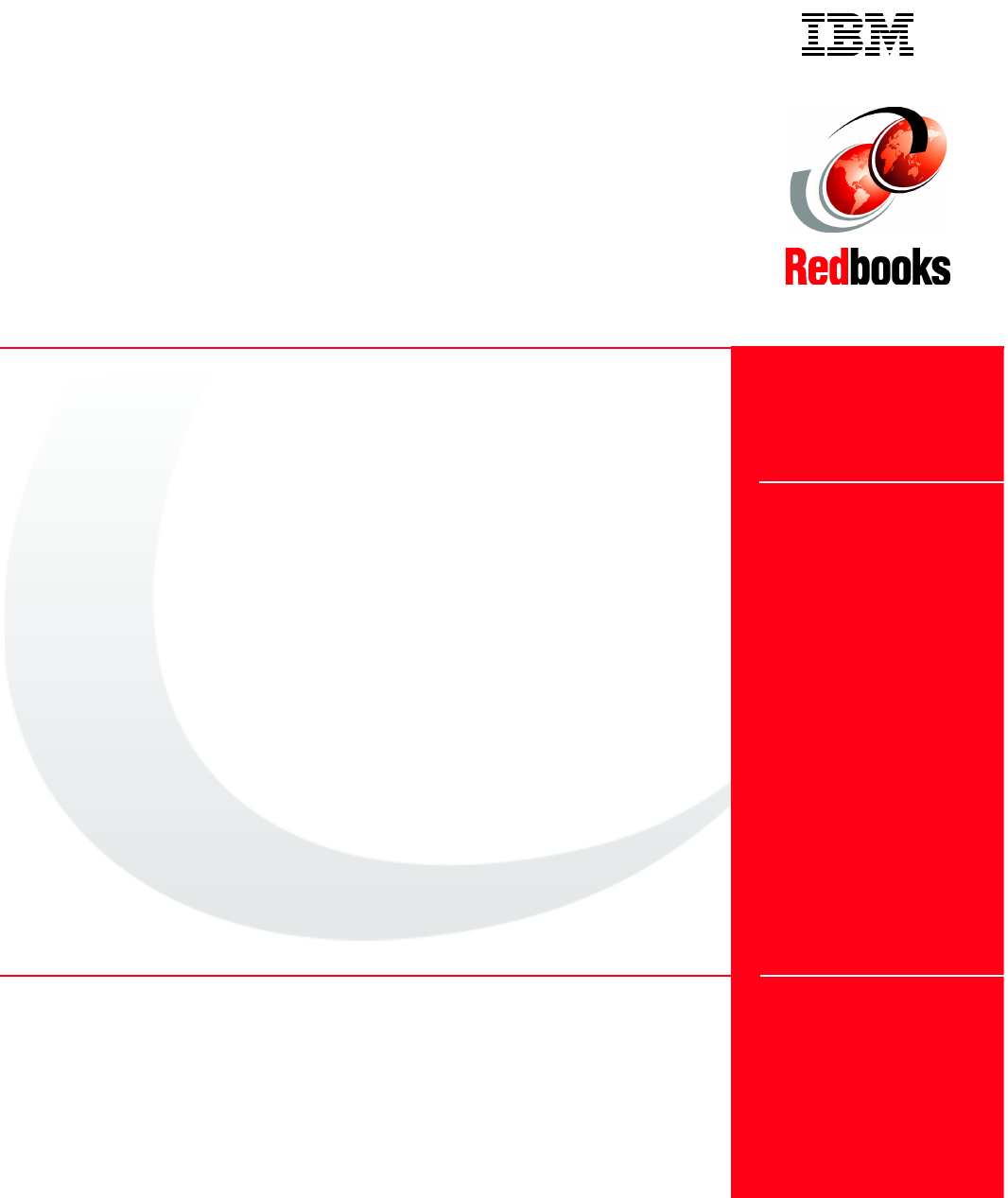
®
new form number ISBN 0738492426
INTERNATIONAL
TECHNICAL
SUPPORT
ORGANIZATION
BUILDING TECHNICAL
INFORMATION BASED ON
PRACTICAL EXPERIENCE
IBM Redbooks are developed by
the IBM International Technical
Support Organization. Experts
from IBM, Customers and
Partners from around the world
create timely technical
information based on realistic
scenarios. Specific
recommendations are provided
to help you implement IT
solutions more effectively in
your environment.
For more information:
ibm.com/redbooks
IBM System i5 Handbook
IBM i5/OS Version 5 Release 4 January 2006
The essential sales
guide to IBMs
integrated business
system
Featuring models
520, 550, 570 and
595, plus i5/OS V5R4
The companion
volume to the i5
System Builder
The latest IBM System i5 Family is here. The new models extend the
IBM Eserver iSeries family. They are the first servers in the
industry based on the leading-edge IBM POWER5 64-bit
microprocessor. Today’s IBM System i5 family gives the flexibility to
move from one generation of technology to another without
disrupting a company’s business. IBM i5/OS Version 5 Release 4, the
next generation of OS/400, features support for multiple operating
systems and application environments on a single, simplified
platform. IBM i5 Systems do more with less.
This first edition of the IBM i5 System Handbook, distributed and
respected worldwide, supports these latest iSeries announcements.
It provides a product and feature overview of the newest i5 Models,
the 520, 550, 570, and 595, as well as describes the newest release
of operating system software, i5/OS V5R4. Information is featured to
present all aspects of today’s IBM System i5 models, from the
architectural foundation to performance considerations.
This Handbook is written for IBM System Specialists, Marketing
Representatives, Business Partners, and Clients to answer first-level
questions. It offers a comprehensive guide to the iSeries models,
associated hardware, and OS/400-related software currently
marketed by IBM representatives.
Back cover

(1.5” spine)
1.5”<-> 1.998”
789 <->1051 pages
May 2004
i5 Handbook
IBM i5/OS Version 5 Release 4
January 2006 January 2006
